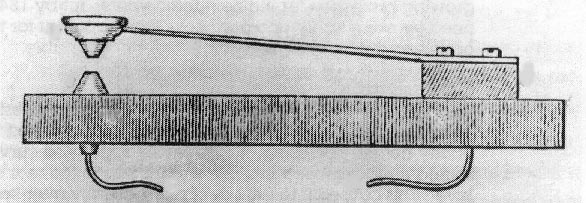
50a THE VAIL 'CORRESPONDENT':(41KB) This simple so- called 'strap key' was used in early tests by Morse and Vail that led up to the 1844 demonstration. It was given the name 'strap key' because it consisted of just a simple strap of spring brass.
Welcome to my museum of telegraph items. I hope you will find it interesting. In the main museum site, you will find a brief history of telegraph instruments and a bibliography as well as items of interest to collectors and links to my illustrated virtual museums of telegraph and scientific instruments, Enigma cipher machines, radios, microphones, and electromedical devices with their downloadable (copyrighted) pictures. The brief descriptions of each telegraph item should be helpful in identifying instruments that you turn up, and you can always e-mail or write to me for more information.
SEARCHING THIS LIST:
This is the entire searchable list of all items in the museum.
If you view this list in your web browser and use the SEARCH or FIND
feature (Usually: EDIT / FIND-ON-THIS-PAGE) to locate items of interest,
you can then read the descriptions and/or click on the
associated photographs to see pictures of each item. You may also download
this list into your computer as an ASCII (Text)
file and use the search feature in your word processor to help you
find items of interest. You can then take the item number and go to
the museum to find a photograph of most telegraph instruments on this list.
(The instruments are in approximate chronological order: Oldest first.)
* = (Items no longer owned.) ** = (Items in other collections.)
PART I
50 THE ORIGINAL MORSE TELEGRAPH KEY was actually a notched piece of metal
called a Portrule. It was pulled along and the parts of the metal that were
not notched made contact with another piece of metal, completed the electrical
circuit, and produced the dots and dashes of the Morse Code.

50a THE VAIL 'CORRESPONDENT':(41KB) This simple so-
called 'strap key' was used in early tests by Morse and Vail that led up to
the 1844 demonstration. It was given the name 'strap key' because it
consisted of just a simple strap of spring brass.
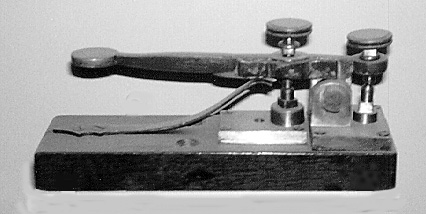
50b THE ORIGINAL MORSE TELEGRAPH KEY CALLED THE 'LEVER
CORRESPONDENT' THAT WAS USED IN THE 1844 BALTIMORE-WASHINGTON
DEMONSTRATION:(36KB) This key is on display in the Smithsonian Institution
in Washington, DC and it is on loan from the Vail Museum in Morristown,
NJ.
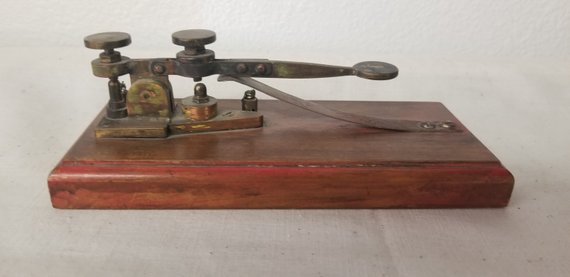
50h A VERY NICELY MADE REPRODUCTION OF
THE VAIL LEVER CORRESPONDENT This key has the same design features
as the original key. It has a very old-looking patina and it takes a few
minutes to be certain that it is a replica. It is about 30% smaller than the
original and looks very much like it. However, the hex nuts on the adjusting
screws and on the lower contact posts are totally different from the square
nuts used in the original. This key was purchased by Jon, WS1K. It came from
an estate in New Mexico but no further information is available.
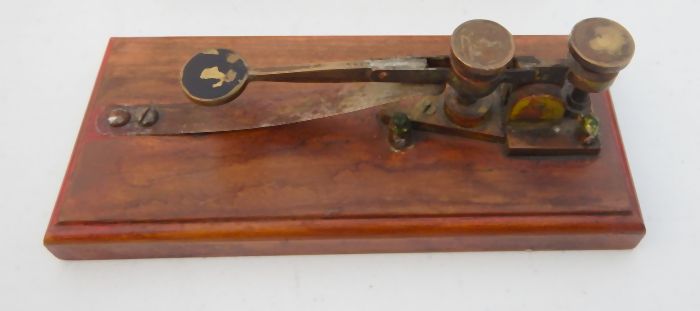
50i A RIGHT side view of the reproduction
Lever Correspondent made by an unknown maker.
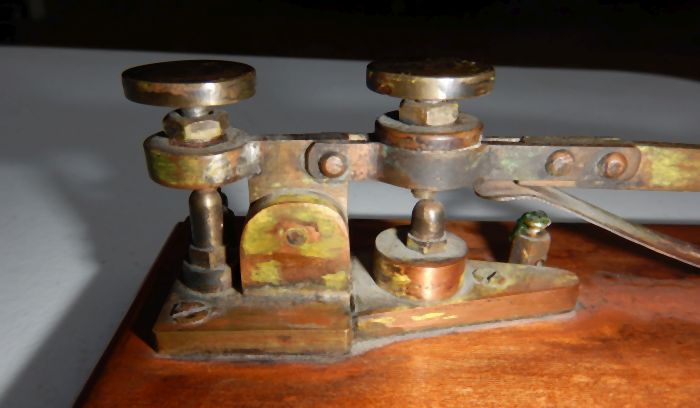
50i A closer view of the right side of
the reproduction Lever Correspondent made by an unknown maker.
Notice the hex nuts on the adjusting knobs and the lower contacts. No hex
nuts were used in the original.
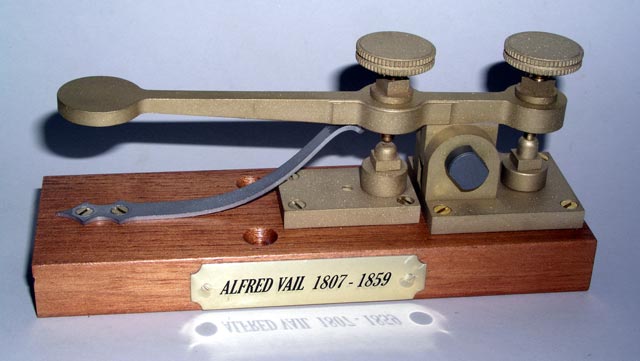
50x A REPRODUCTION OF THE VAIL LEVER
CORRESPONDENT MADE BY KENT IN ENGLAND:(38KB) This key has the same general
design and measurements as the original key but various production versions of
the Kent key have been given sand-blasted and other finishes which make it
look quite different from the polished brass of the original. Many owners have
tried to achieve the weathered and aged patina of the original key in the
Smithsonian Institution. Several techniques for developing an aged patina on
the key have been tried. One that works quite well is to bury it in the ground
for about a year and then gently clean off the dirt.
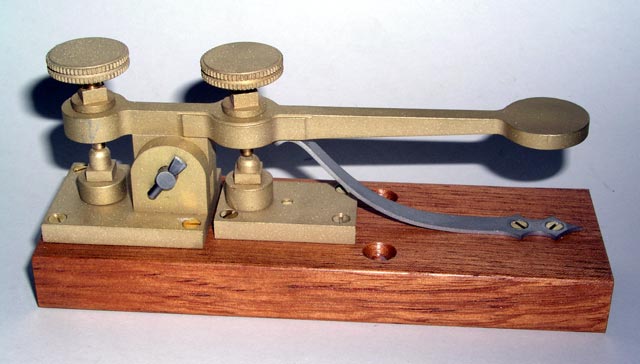
50y A LEFT side view of the Lever Correspondent
Reproduction by Kent:(42KB)
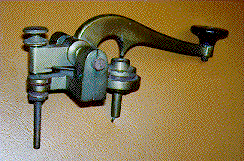
50z ** THE EARLIEST CAMELBACK KEY THAT I HAVE
EVER SEEN:(50KB) Owner anonymous.

51 ** EXTREMELY EARLY PALMER AND HALL BOXED COMBINATION
TELEGRAPH KEY AND RELAY SET:
This extremley rare Palmer and Hall telegraph set is contained in a wooden box
that protects the early camelback key and relay from damage. One end of the
box folds down to allow operation of the set while still in the box. The
relay and the box are labeled: Palmer and Hall and the box label reads: PALMER
& HALL electricians, 158 Washington St. Boston, Mass. The box measures: 8.5 x
6 inches. The owner was kind enough to allow me to include these photographs
in my museum prior to selling it on ebay.
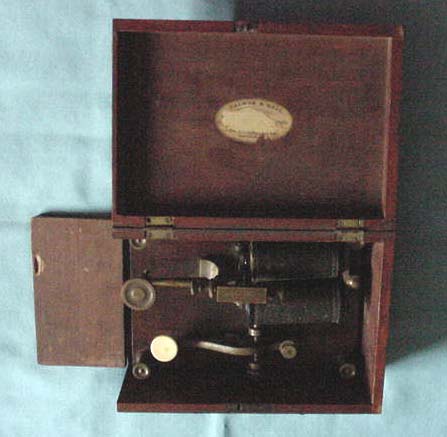
51a ** The Palmer & Hall Telegraph Set in its Original
wooden box.
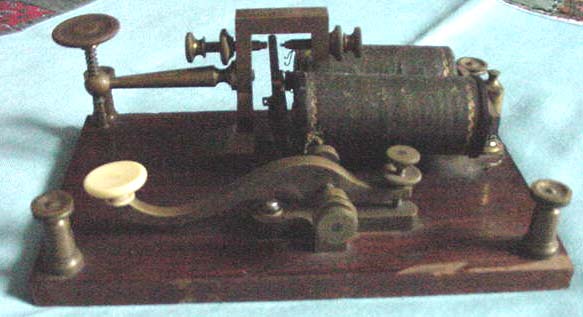
51b ** A different view of the Palmer & Hall Telegraph Set
showing the telegraph key more clearly.
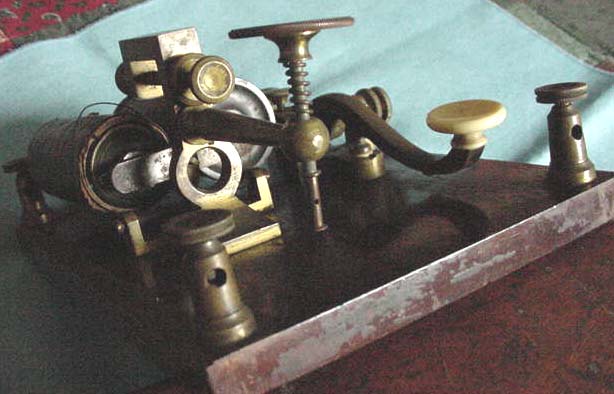
51c ** The operator's end of the Palmer & Hall
Telegraph Set.
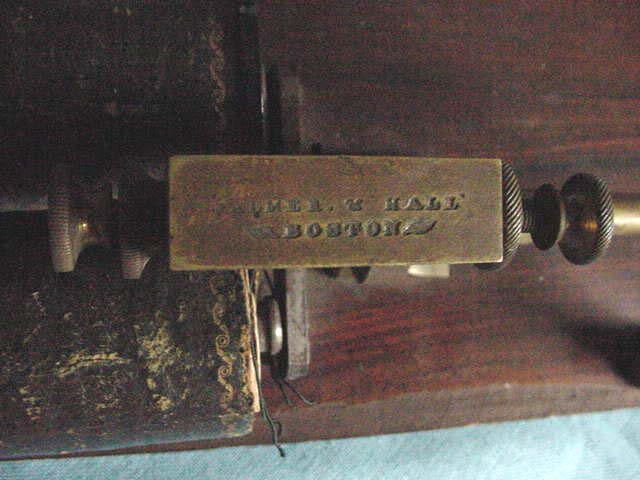
51d ** The Maker's Mark on top of the relay in
the Palmer & Hall Telegraph Set.
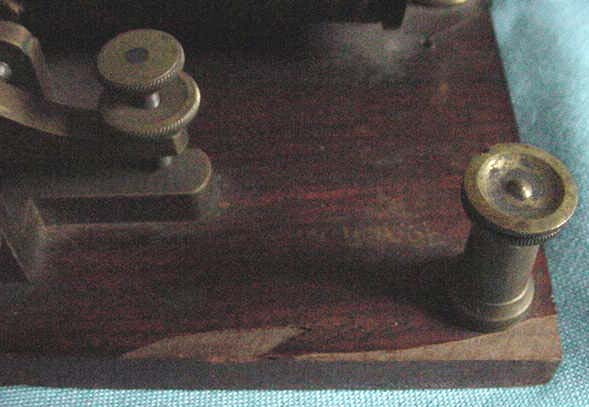
51e ** A close view of the far end of the key and a
terminal in the Palmer & Hall Telegraph Set.
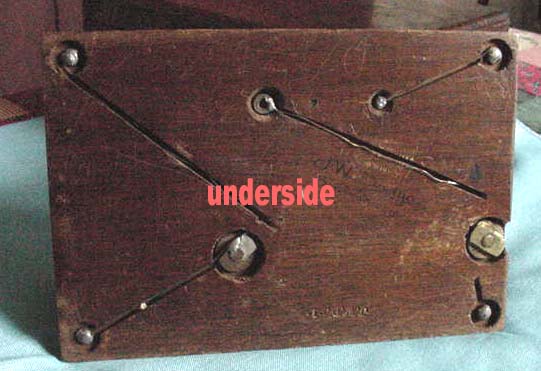
51f ** The underside of the base of the Palmer & Hall
Telegraph Set.
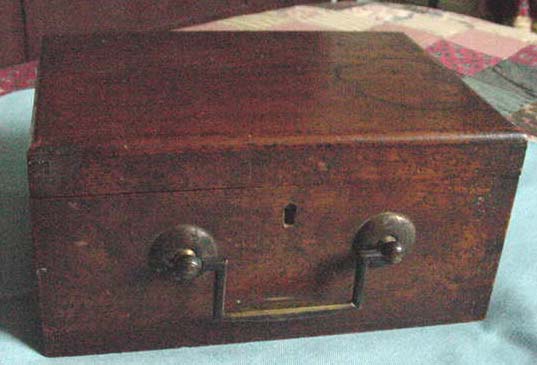
51g ** The front of the box of the Palmer & Hall
Telegraph Set.
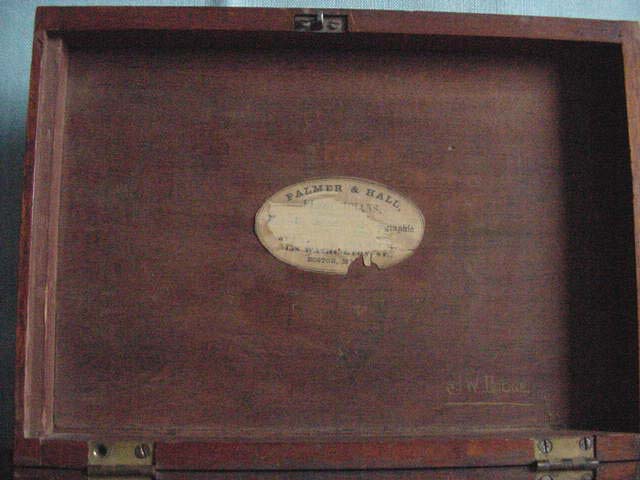
51h ** The inside of the cover of the box of the
Palmer & Hall Telegraph Set showing the Palmer and Hall paper label.
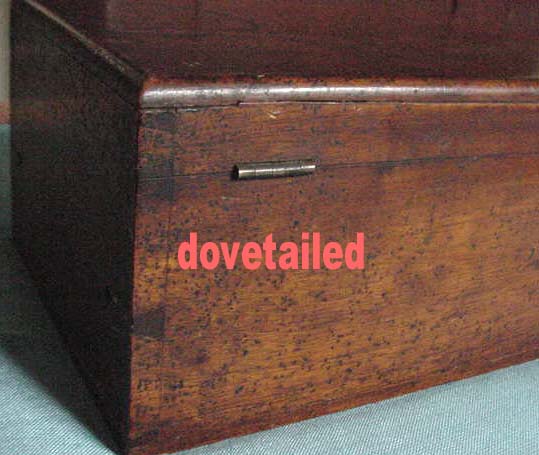
51i ** A close view of the dovetailed corner of the
box of the Palmer & Hall Telegraph Set.

52 ** EXTREMELY EARLY TELEGRAPH AND MINSTREL AMBROTYPE:
(57KB)This extremely early ambrotype is from the Jim Bollman (email:
jim@themusicemporium.com ) collection of very early banjos. It is copyright
(c) Jim Bollman and it is provided courtesy of The Music Emporium
( http://www.themusicemporium.com ).
Ambrotypes were introduced after dagerreotypes and around the middle of the
19th century. They consist of a transparency which is mounted on a black
background. This one shows a grouping of 8 young boys with a banjo and two
telegraph instruments. The grouping and banjo indicate that these boys are
members of one of the popular minstrel groups of the mid 19th century. Three
of the boys are wearing hats and at least two are wearing uniforms which
suggest that they work in a telegraph office. They are holding two extremely
early telegraph instruments and I believe that this is the earliest photograph
of these instruments that has been found.
The left instrument appears to be a Thomas Hall relay similar to the

number 68 ** Palmer & Hall relay shown in my museum:(16KB)
The right instrument appears to be a similar Hall relay mounted on the same
board with a very curved telegraph key which may be an Hall or some other key.
If it is an Hall key, it is much earlier and more elaborate than the
number 67 Hall telegraph key in my
museum:(15KB)
Click here to see an enlarged (but very
slow loading) view of this entire picture:(191KB)
I have selected the
right instrument and enlarged it to allow much closer inspection.
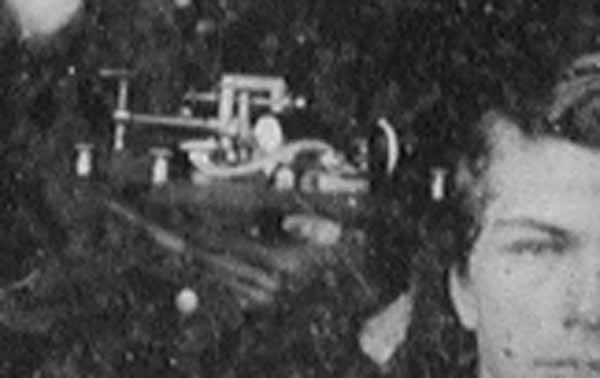
This is an enlarged view
with no sharpening:(17KB) It reveals that the key has a light-colored
probably ivory knob.
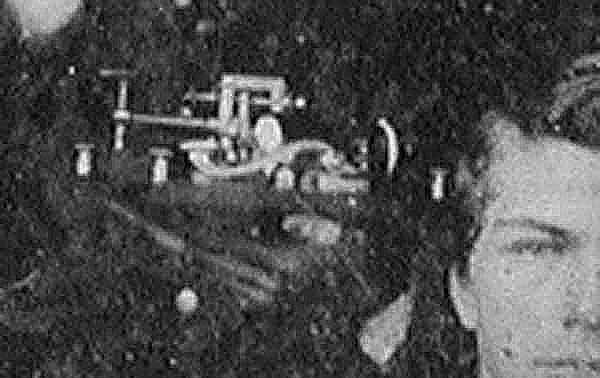
Adding a very high degree of sharpening allows a few more
details to be seen:(26KB)
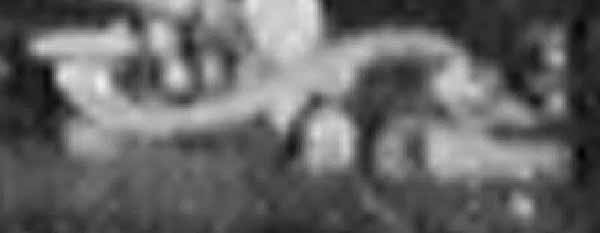
Still more enlargement:(8KB) starts to show more
additional details of the key's design. However, you will probably have
to step quite far back away from your computer screen to view it.
CONCLUSION: I believe that the key is a Palmer and Hall camelback as
shown in
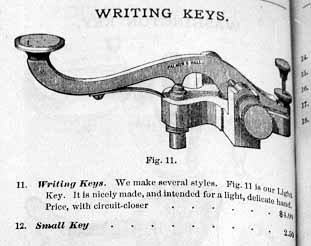
This picture from the Hall
Catalog:(12KB).
Although it is difficult to see all of the details in the ambrotype
because the head of a minstrel gets in the way, most details seem to match
the catalog illustration.
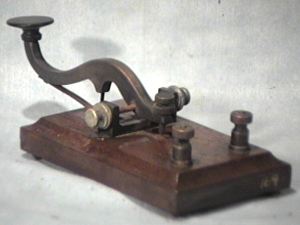
52f ** HOMEMADE MODEL OF THE PALMER & HALL
CAMELBACK:(10KB)This key is in the Tom French W1IMQ collection.
It appears to have been modeled after the above key.
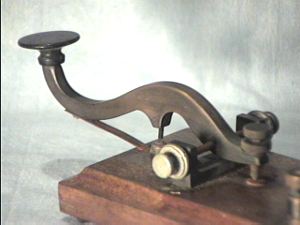
52fa ** Another view of the homemade
camelback:(11KB)
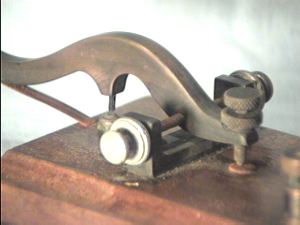
52fb ** Another view of the homemade
camelback:(11KB)
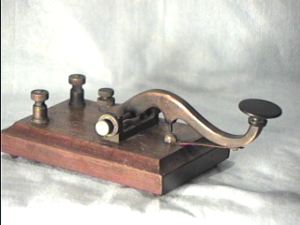
52fc ** Another view of the homemade
camelback:(10KB)
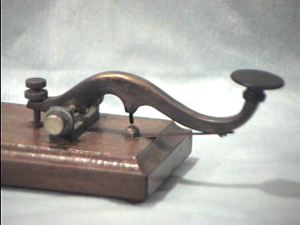
52fd ** Another view of the homemade
camelback:(10KB)
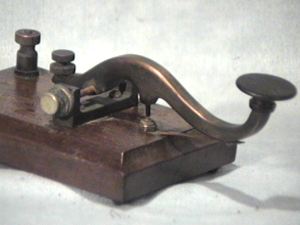
52fe ** Another view of the homemade
camelback:(10KB)
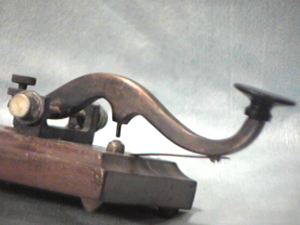
52fg ** Another view of the homemade
camelback:(11KB)
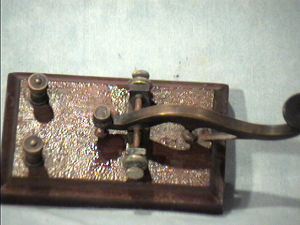
52fh ** Another view of the homemade
camelback:(14KB)

53 VERY EARLY PALMER AND HALL OR HALL BOXED PORTABLE
COMBINATION TELEGRAPH KEY AND RELAY SET:
This extremely rare portable telegraph set is enclosed in a strong wooden box
that protects the tiny miniature straight lever key and miniature relay
from damage. The overall design and the spring adjusting mechanism for the
relay is quite unusual. Although there are no obvious markings on the set,
the knurling on the hardware, the shape of the parts, and the design strongly
suggest that it was made by Palmer and Hall or Hall in Boston, Mass.
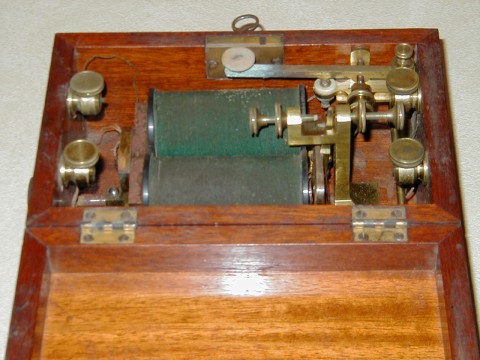
53a Another view of the Palmer and Hall portable
set:
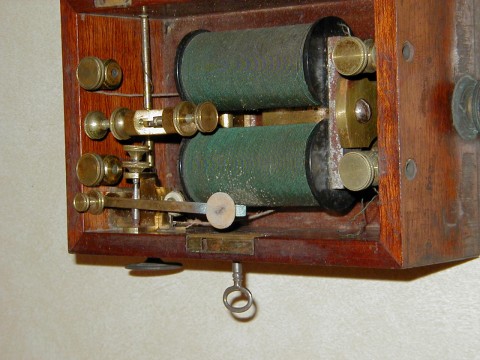
53b Another view of the Palmer and Hall portable
set:
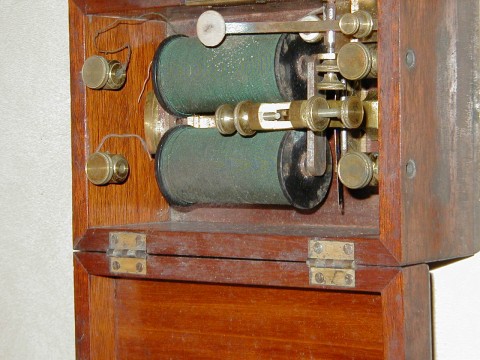
53c Another view of the Palmer and Hall portable
set:
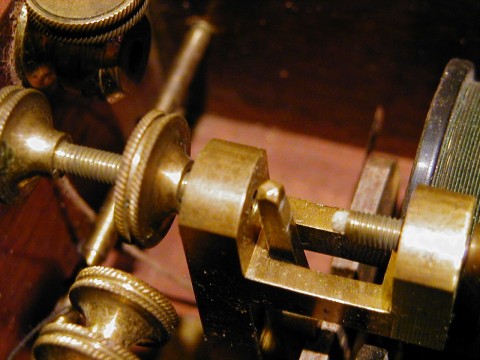
53d A closer view of the mechanism of the
Palmer and Hall portable set:
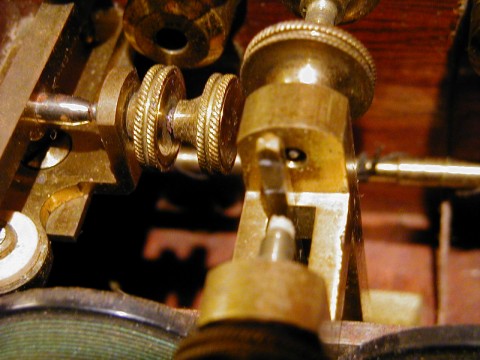
53e A closer view of the mechanism of the
Palmer and Hall portable set:
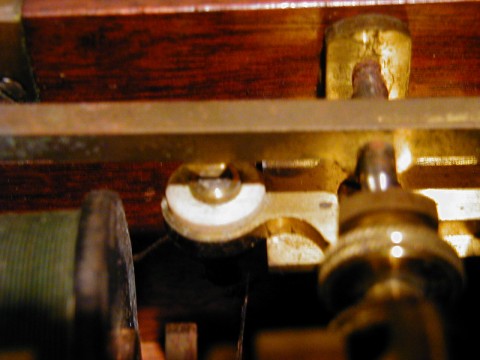
53f A closer view of the key in the
Palmer and Hall portable set:
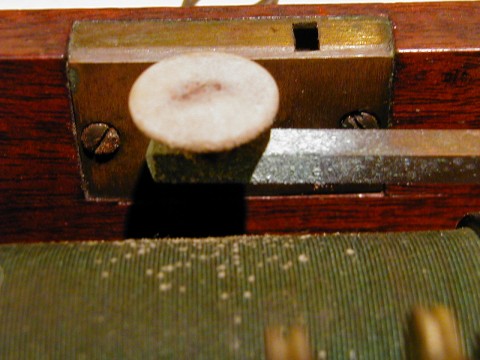
53g A closer view of the key in the
Palmer and Hall portable set:
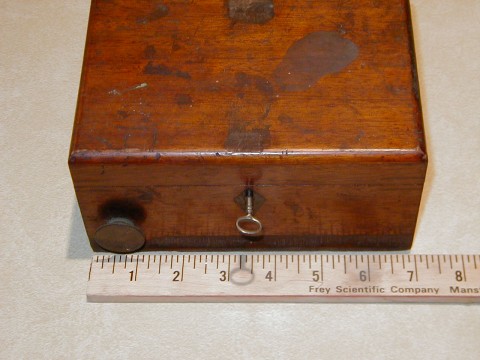
53h The front outside of the box of the
Palmer and Hall portable set:
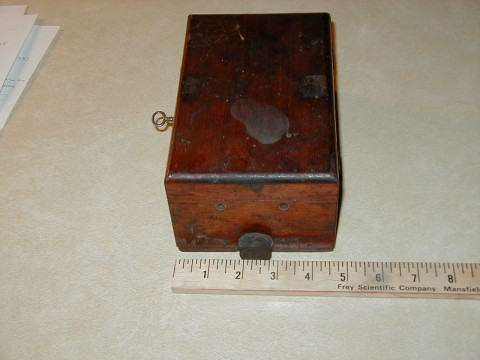
53i The right outside of the box of the
Palmer and Hall portable set:
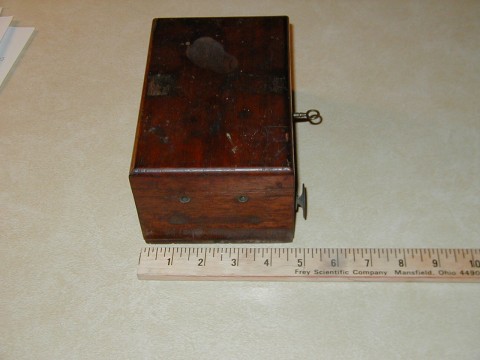
53j The left outside of the box of the
Palmer and Hall portable set:
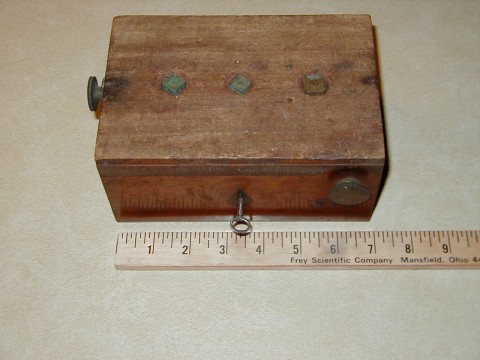
53k The bottom of the box of the
Palmer and Hall portable set:
54 ** POSSIBLY THE EARLIEST TELEGRAPH DAGUERREOTYPES:
These daguerreotypes are exhibited with the permission of Mark Koenigsberg
whose daguerreotype museum at: http://www.geocities.com/~daguerreotype
contains many other early pictures on other subjects. They are
copyright (c) Mark Koenigsberg and are the earliest images of
telegraphers and telegraph instruments that I have found.

55 EXTREMELY EARLY CATON 'MORSE'
WEIGHT-DRIVEN REGISTER:(54KB)
This extremely early Morse Register is a fine example of the first
style of paper-tape recorder to be used on the telegraph lines. It
is powered by a weight and pulls a paper tape past a stylus that
makes indentations in the tape for dots and dashes. It was used
in a railroad depot in Stockton Springs, Maine. It was acquired by
James Coose (W1CBU) of Stockton Springs when the station closed and
given to his son-in-law Robert Littlefield (W1MFU) and transferred
to this museum by Diane Coose Littlefield in 1996. It was made by the
Caton Instrument Co. in the 1850's.
The base is stamped: OTTAWA - ILL 433.
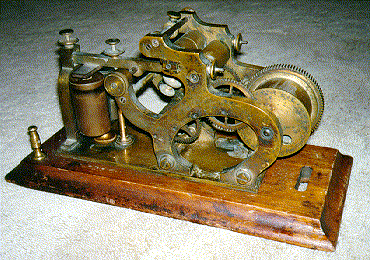
55b ANOTHER VIEW OF THE CATON 'MORSE'
REGISTER:(54KB)
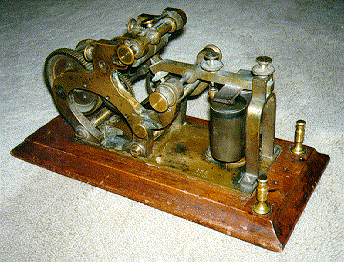
55c ANOTHER VIEW OF THE CATON 'MORSE'
REGISTER:(54KB)

56 CATON TELEGRAPH KEY:(12KB)
This early straight lever key was made by the Caton Instrument Co.,
Ottawa, Ill. The long legs pass through holes in the operating table
and wires are attached to binding posts at the end of each leg.
The lever is stamped CATON, OTTAWA, ILL 7?? (illegible),
and the base is stamped with the number 494. Circa 1860's.

57 ** EARLY CATON 'LINEMAN'S TEST SET OR POCKET
RELAY:(18KB)This magnificent pocket relay or 'lineman's test set'
consists of a sensitive sounder and a very early and tiny strap key.
There is a tiny ivory knob on both the key and the shorting lever.
These sets allowed linemen to tap into telegraph lines with a pocket-sized
instrument and they were also used by the military for intercepting and
sending false messages to the enemy. The set is enclosed in an
oval hard rubber case and in a thick leather protective case.
These pocket sets are very hard to find and this one is owned
by collector Bill Carpenter, AA8EY.
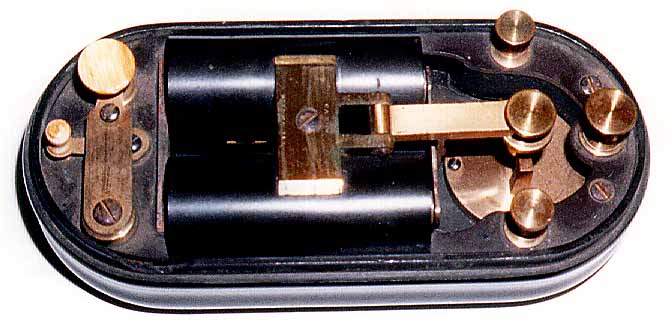
57a High Resolution picture of the Caton Pocket
Relay:(48KB)
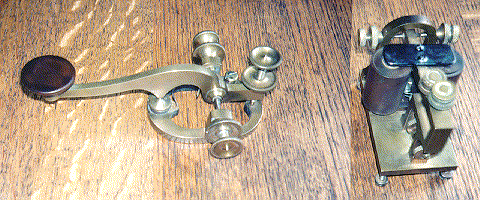
60 VERY EARLY ELABORATE CAMELBACK KEY & SOUNDER:(63KB)
This all brass key with leaf spring has a massive elaborately curved
lever of the earliest "camelback" or "humpbacked" shape which was
adopted soon after Morse's demonstration. These keys were only made
for a short time because the steel shaft, press fit into the lever,
tended to work loose with use. The sounder is also heavy brass but,
although it was mounted on a board along with this key, I believe that
the sounder may be from a later period. The original wooden base is
missing. The two instruments came from a burned railroad
station in Canada. Circa 1848. The lever shape and large dished
adjusting screw heads are very similar to the two keys shown below.
It has been suggested that these keys were all made by the Dominion
Telegraph Company in Canada but unfortunately, we have very little
information about Canadian Telegraph Companies.
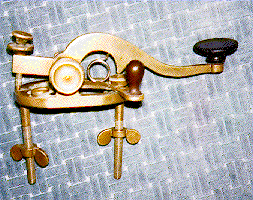
62 VERY EARLY ELABORATE CAMELBACK KEY:(32KB)
This all brass key with early hairpin spring has the same massive
elaborately curved lever as number 210. The hairpin spring suggests
that it is of a slightly later design. It is stamped NWT, the
initials of the early Northwest Telegraph Company of Western Canada.
All underside parts are stamped "2" and it is also stamped 1880., an
inventory date? It came from Canada. Circa 1850.

63 VERY EARLY ELABORATE STRAIGHT LEVER KEY:(32KB)
This extremely early all brass straight lever key is very similar to
the two extremely early camelback keys above. Note that the shorting
lever and adjusting screws are virtually identical to those above.
Like the two camelbacks, it was also located in Canada and it may have
been made by the Dominion Telegraph Company. Circa 1850's. Collector
Pete Malvasi, W2PM owns a sounder which appears to match this key and which is
labeled Dominion Tel Co. and this lends credence to the suggestion that
Dominion made this key although the key below is very similar to this key and
carries the label: FOSTER, Toronto suggesting that this key might have been
made by Foster.
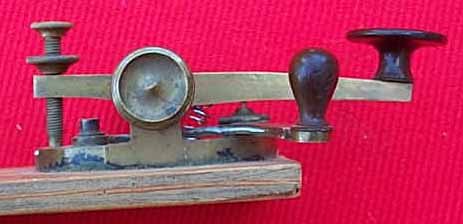
63a Another view of the early straight
lever key:(16KB)
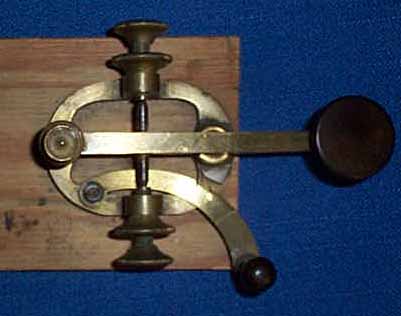
63b A closer view of the early straight
lever key:(16KB)
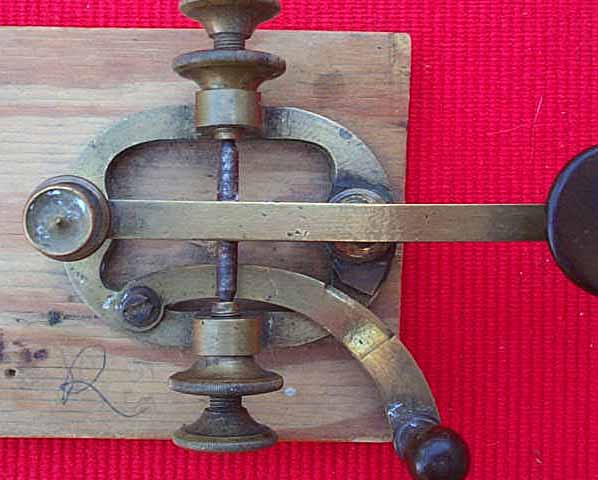
63c A still-closer view of the early
straight lever key:(32KB)

64 VERY EARLY ELABORATE CANADIAN 'FOSTER'
STRAIGHT LEVER KEY {One Mystery Solved!}:(32KB)
This extremely early all brass straight lever key is very similar to the key
above (Number 0063). Note that the shorting lever and adjusting screws are
virtually identical to those above. This key is labeled: FOSTER, TORONTO and
it appears to be a very early key made in the 1850s. Several keys have
turned up in the last 10 years that are similar to this key but none of them
has carried a maker's name. It is apparent that this key solves the mystery
of who made these other keys by showing that it was "FOSTER" of Canada who
made them.
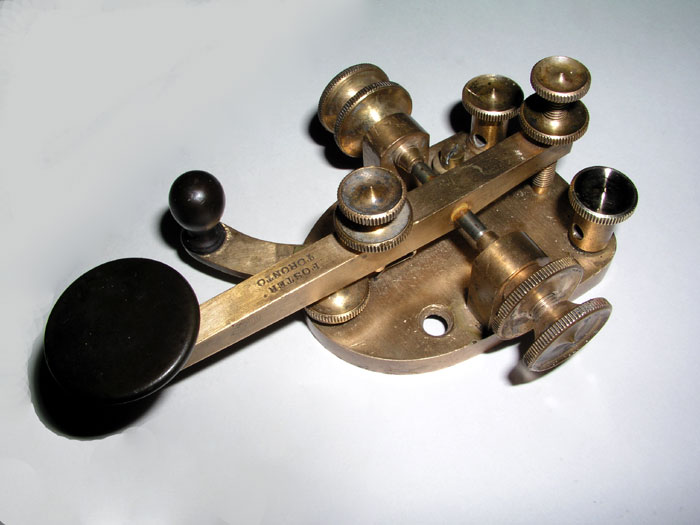
64a Another view of the very early Foster straight
lever key:(16KB)
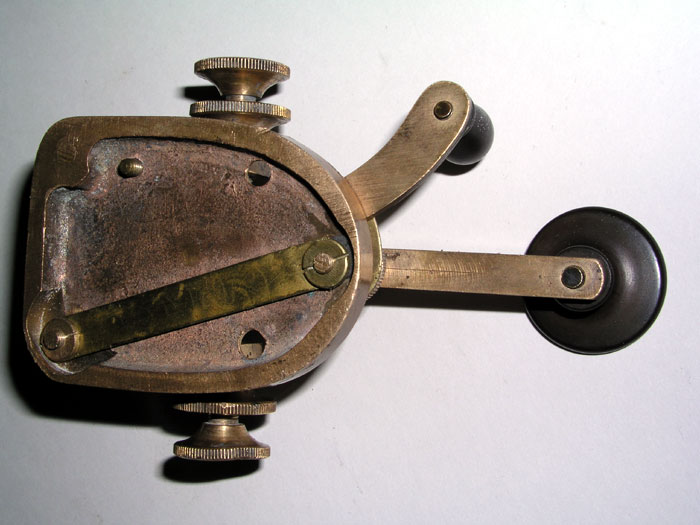
64b A view of the underside of the base of the very
early Foster straight lever key:(16KB)

65 * 1850 TELEGRAM AND TAPE FROM A ''HOUSE PRINTING
TELEGRAPH'':(14KB)
This telegraph message was printed on the paper tape
by a 'House Printing Telegraph' instrument in 1850. The 'House' was
first patented in 1848. The tape was delivered to the addressee
in the envelope which carries the date of receipt of the message.
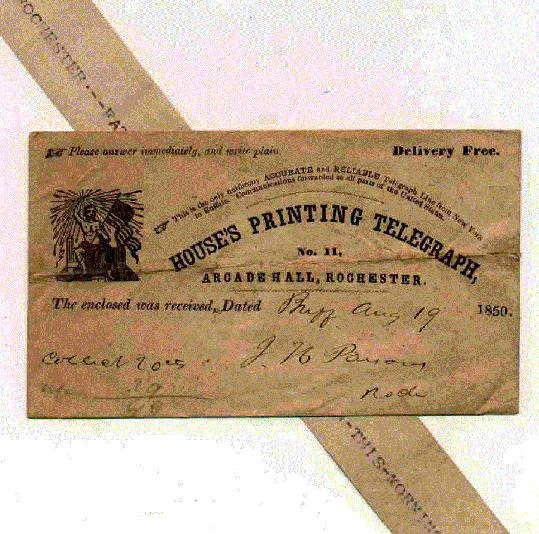
65l Higher Resolution View of the telegram:(70KB)

66 VERY EARLY THOMAS HALL WEIGHT DRIVEN REGISTER:
(24KB) This lovely old register was made by Thomas Hall of
boston in the early 1850's.
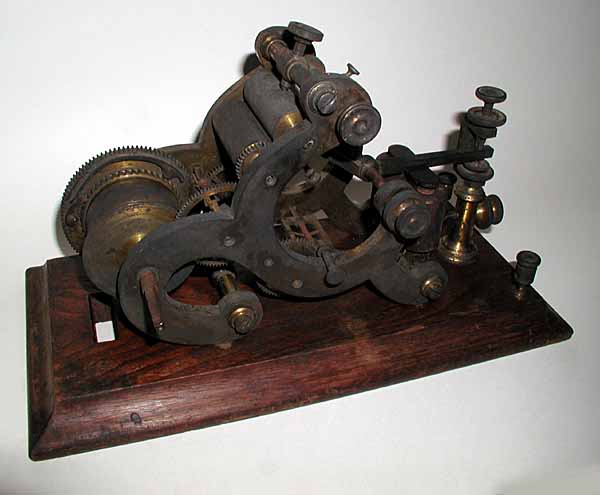
66a Another view of the Hall Register:(28KB)
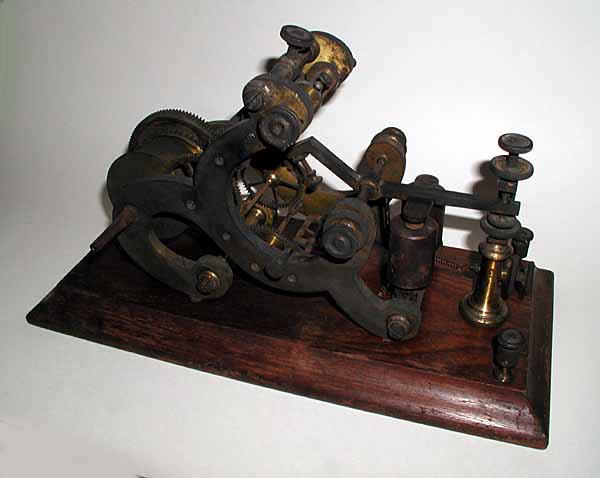
66b Another view of the Hall Register:(26KB)
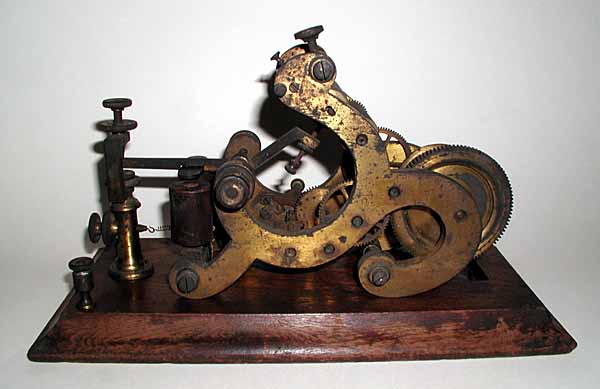
66c Another view of the Hall Register:(28KB)
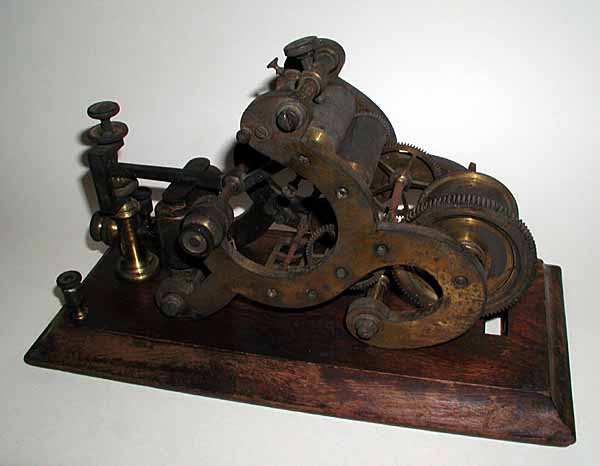
66d Another view of the Hall Register:(26KB)
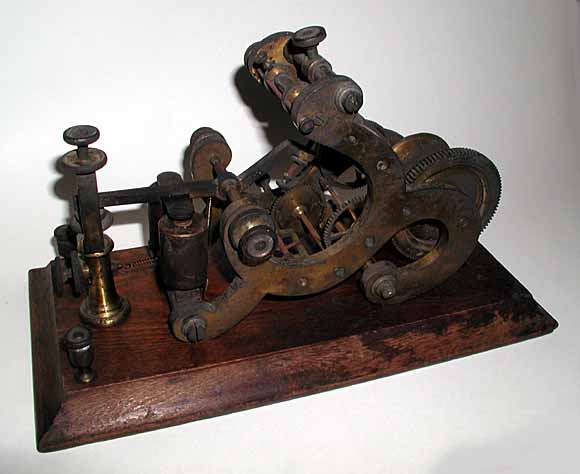
66e Another view of the Hall Register:(27KB)
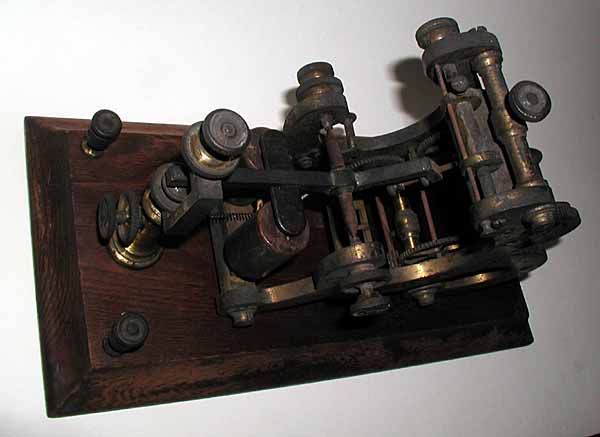
66f Another view of the Hall Register:(25KB)
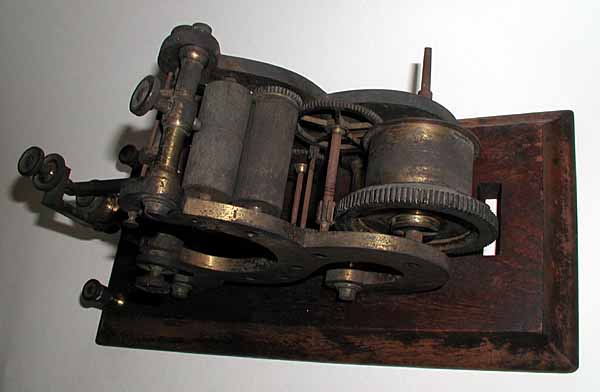
66g Another view of the Hall Register:(23KB)

67 VERY EARLY THOMAS HALL CAMELBACK KEY:(15KB)
This lovely camelback key was made by Thomas Hall of Boston circa
the 1850's.
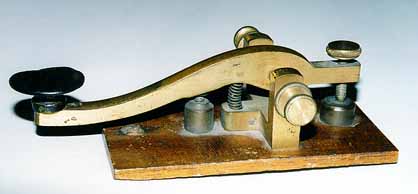
67a The other side of the Hall
camelback:(15KB)

68 * VERY EARLY PALMER & HALL RELAY:(20KB)
This lovely early relay was made by the firm of Palmer & Hall of
Boston sometime between 1847 and 1849. Notice the ivory end caps on
each of the coils and the ivory insulator on the very end of the contact
spacing screw.(Traded to W2PM)
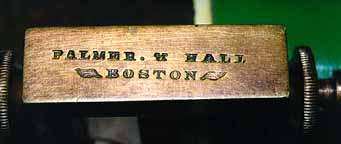
68a *
Closeup of the Name on top of the frame:(11KB)

69 VERY EARLY THOMAS HALL SOUNDER:(26KB)
This lovely early sounder was made by the firm of Thomas Hall of
Boston sometime between 1847 and 1859.
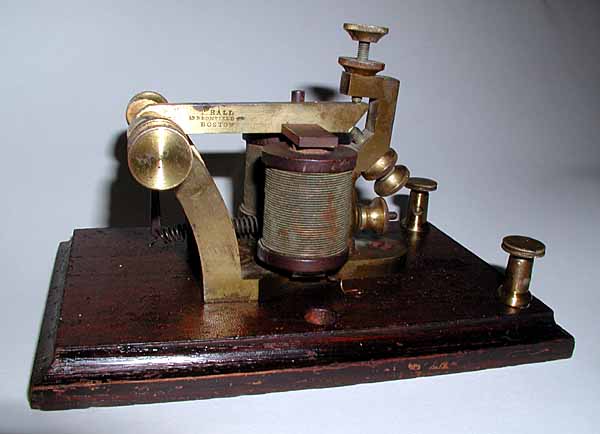
69a Another view of the Thomas Hall Sounder:(28KB)
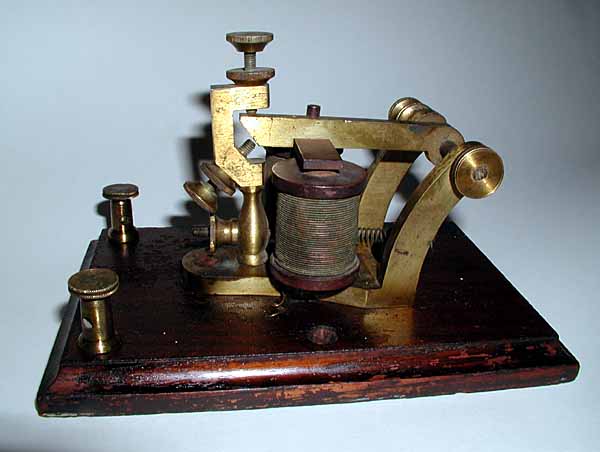
69b Another view of the Thomas Hall Sounder:(30KB)

70 VERY EARLY CHARLES CHESTER WEIGHT-DRIVEN MORSE REGISTER:(18KB)
This very early register was made by Charles T. Chester of New York in
the 1850's. It is an embossing register which means that it marked
dots and dashes by making impressions in the paper tape rather than
by depositing ink on the tape.
A pair of them was originally purchased and one was traded.
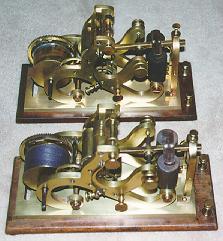
70a The Pair of Chester Registers:(17KB)
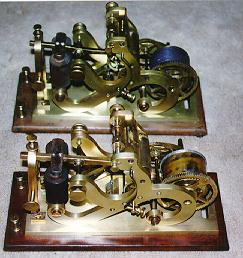
70b The Pair of Chester Registers-(other side):(20KB)

71 VERY EARLY CHARLES CHESTER TELEGRAPH KEY:(12KB)
This lovely straight lever key was manufactured by Charles T. Chester
of New York in the 1850's or 1860's. The lever is 5" long and the base is
3".

72 VERY EARLY MINIATURE CHARLES CHESTER TELEGRAPH KEY:(11KB)
This is a smaller version of number 71. The lever is 4" long and the
base is 2" long.

74 * VERY EARLY TILLOTSON WEIGHT-DRIVEN REGISTER:(45KB)
This lovely and very early register was made by Tillotson & Co of New York in
the 1850's. It's design appears to be identical to the Knox & Shain Registers
made in Philadelphia. It is an embossing register which records dots and
dashes on the paper tape by making indentations in the tape with a pointed
stylus. This picture is displayed with the permission of the
owner/collector.

75 * VERY EARLY CHUBBUCK WEIGHT-DRIVEN REGISTER:(24KB)
This very early register was made by Chubbuck in Utica, NY in the 1850's.
It is an embossing register which records dots and dashes on the
paper tape by making indentations in the tape with a pointed stylus.
(traded to K5VT)
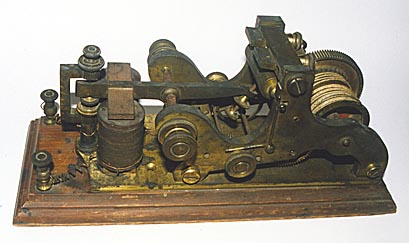
75a ANOTHER VIEW OF THE CHUBBUCK REGISTER:(25KB)

76 VERY EARLY CHUBBUCK WEIGHT-DRIVEN REGISTER:(29KB)
Very similar to number 75 above.
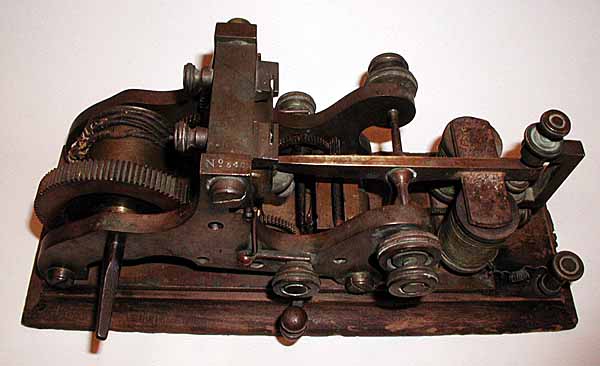
76a ANOTHER VIEW OF THE CHUBBUCK REGISTER:(31KB)
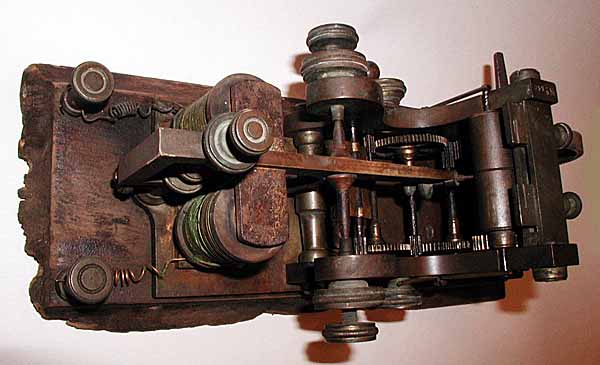
76b ANOTHER VIEW OF THE CHUBBUCK REGISTER:(35KB)
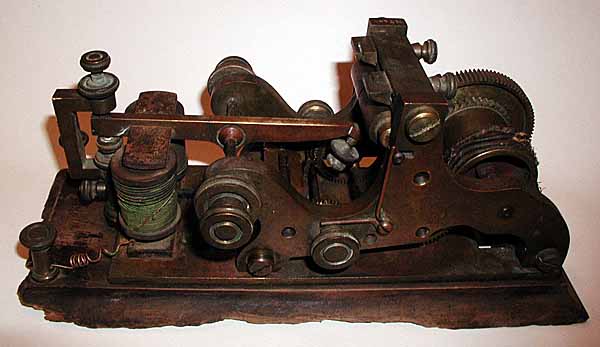
76c ANOTHER VIEW OF THE CHUBBUCK REGISTER:(30KB)
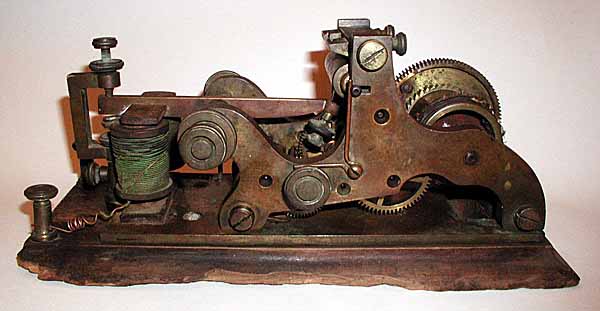
76d ANOTHER VIEW OF THE CHUBBUCK REGISTER:(30KB)

79 EARLY WESTERN UNION WEIGHT-DRIVEN REGISTER:(22KB)
This is an early Western Union Weight-Driven Register. The
solid brass sides of the string reel are very unusual. It is an embossing
register which marks dots and dashes on the paper tape by making
indentations in the tape with a pointed stylus.
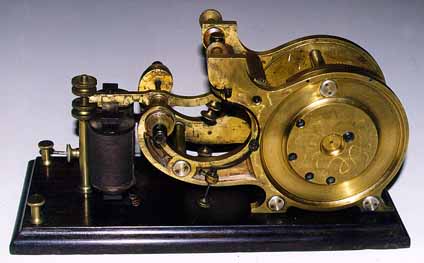
79a ANOTHER VIEW OF THE WESTERN UNION REGISTER:(22KB)
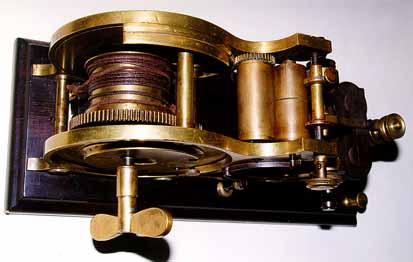
79b TOP VIEW OF THE WESTERN UNION REGISTER:(21KB)
The register was apparently carried from location to location in this box.
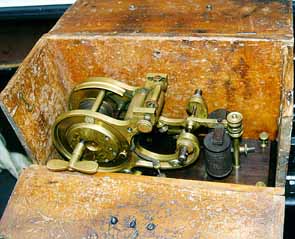
79c WESTERN UNION REGISTER BOX OPEN:(23KB)
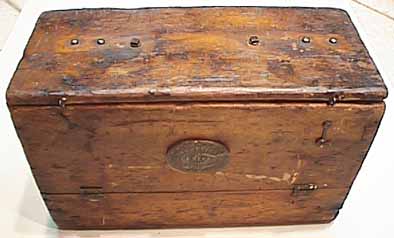
79d WESTERN UNION REGISTER BOX CLOSED:(20KB)
The box has the Western Union Label on the front:
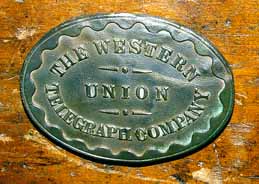
79e WESTERN UNION REGISTER BOX LABEL:(20KB)

80 CIVIL WAR ERA PHELPS CAMELBACK KOB,
Marked G.M.PHELPS-MAKER.:(27KB)
These Phelps Camelback keys were the most widely used of the Civil War keys.
Camelback keys have an upward lump like a camel's hump on the lever
between the knob and the pivot. They were only made for about 12 years
from 1853-1865 because the steel trunnion shaft which was press-fit
into the lever would gradually work loose with prolonged use.
The brass lever would then slide left and right making the key unusable.
This key is all brass except for the steel trunion shaft. The key has a
shorting switch and the revolutionary Phelps-invented spring adjusting
screw which was copied and used on just about every key manufactured
after his invention. This particular Phelps key is mounted on
wooden base with its legs shortened to fit into the base. (a common
but unfortunate modification.) A very early
and primitive Tillotson sounder is also mounted on the base making
it into a portable Key (and sounder) On Base, commonly called a
KOB.(1860's)

81 * CAMELBACK LEG KEY: G.M.PHELPS-MAKER.:(10KB)
As above (no base).circa 1860's.(Traded to John Casale - W2NI.)
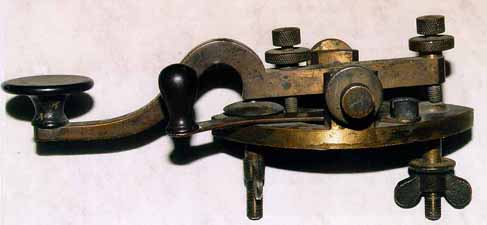
81a Another view of the Phelps key:(16KB)
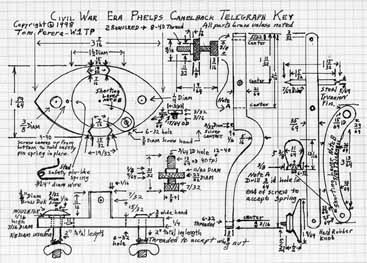
CONSTRUCTION PLANS FOR A PHELPS CAMELBACK
KEY:(LOW RESOLUTION): (35KB)
I have often been asked for drawings of the historic Phelps
Camelback Keys by Civil War Reenactors and others who are
interested in making replicas. I have traced a Phelps key
onto 1/4-inch squares graph paper and added the dimensions as best
my shaky hands would allow and I hope that there is enough information
to allow people to build a key from these plans. I offer these plans
in low, medium, and high levels of resolution. They are
copyrighted but single copies may be made and printed for individual
use by any interested person. I would really appreciate seeing
pictures of your completed or in-progress keys!!
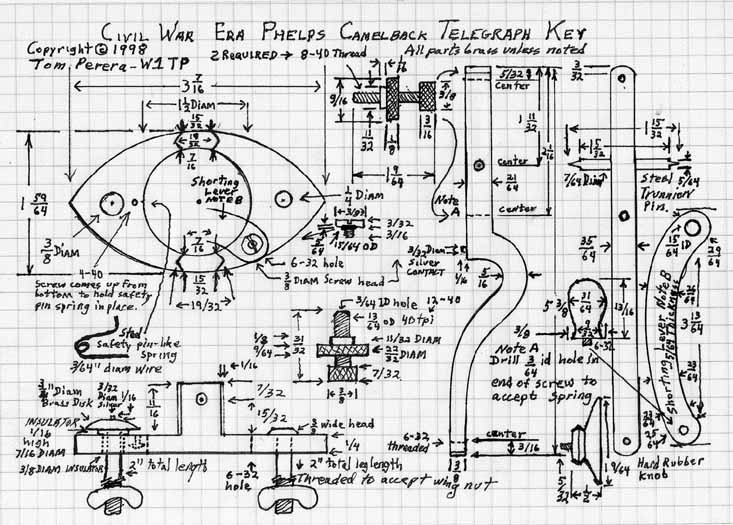
81cm CONSTRUCTION PLANS FOR A PHELPS CAMELBACK KEY:
(MEDIUM RESOLUTION): (96KB)
81cl CONSTRUCTION PLANS FOR A PHELPS
CAMELBACK KEY: (HIGH RESOLUTION): (403KB)
The following photographs show many views of a Phelps Key and may be
useful to those who are trying to reproduce one:

82 PHELPS CAMELBACK KEY (Left Top View mounted on
a base:(21KB)
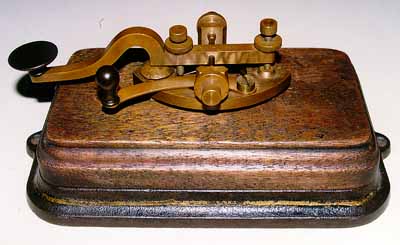
82a PHELPS CAMELBACK KEY (Right Top View mounted on
a base:(22KB)
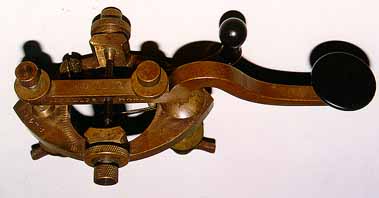
82b PHELPS CAMELBACK KEY (Left Top View
unmounted:(14KB)
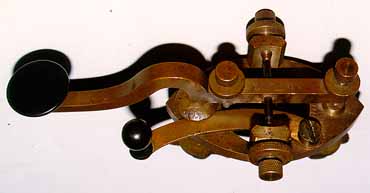
82c PHELPS CAMELBACK KEY (Right Top View
unmounted:(13KB)
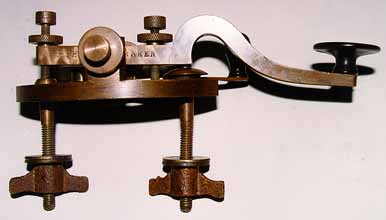
82d PHELPS CAMELBACK KEY (Left Side View
unmounted:(13KB)
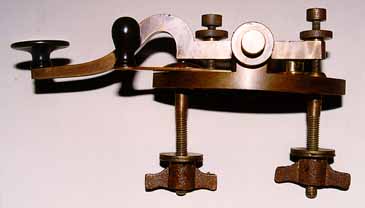
82e PHELPS CAMELBACK KEY (Right Side View
unmounted:(14KB)
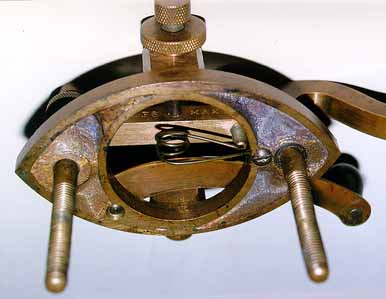
82f PHELPS CAMELBACK KEY (Bottom View
unmounted:(21KB)
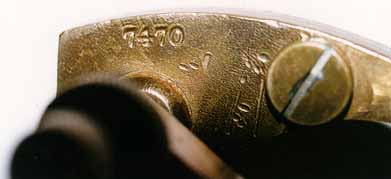
82g PHELPS CAMELBACK KEY (Serial Number on top
of base:(12KB)
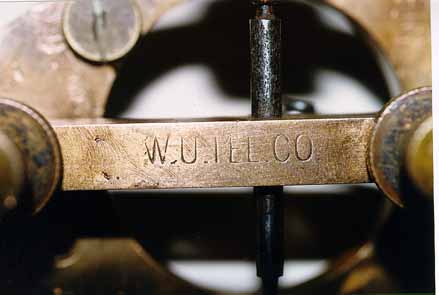
82h PHELPS CAMELBACK KEY (W.U.TEL.CO Stamped on
top of lever:(18KB)
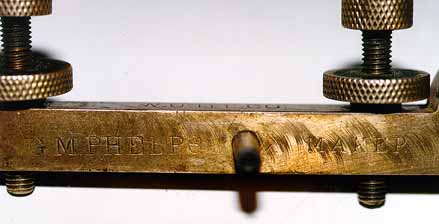
82i PHELPS CAMELBACK KEY (G.M.PHELPS MAKER Stamped
on left side of lever:(18KB)

83 VERY UNUSUAL AMERICAN TELEGRAPH CO. PHELPS
CAMELBACK KEY (G.M.PHELPS MAKER Stamped on left side of lever)
WITH SIDE MOUNTED SHORTING CONTACTS:(14KB)This Phelps
Camelback key is stamped AM. TEL. CO. on top of the lever. It has
an extremely unusual shorting switch with spring-loaded detent
and side mounted contacts. It was found mounted on a wooden board
with an early sounder of unusual design. The following photos show
all of the unusual aspects of the key:
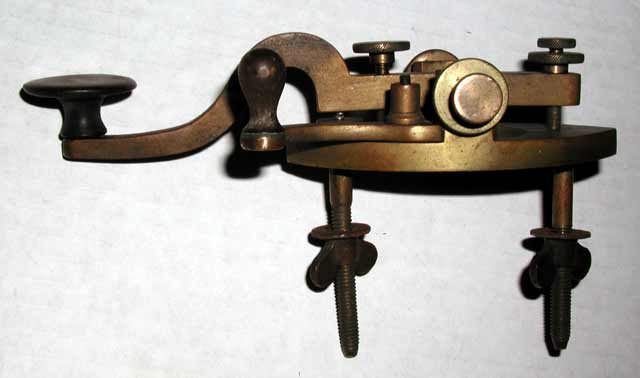
83a A view of the Right side of the key showing
the unusually thick shorting lever:(17KB)
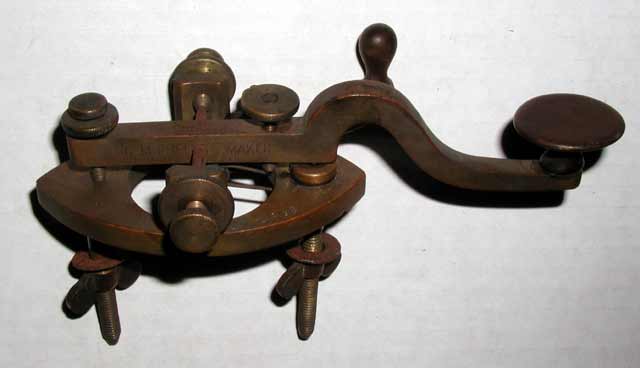
83b A view of the Left side of the key showing
the G.M.PHELPS MAKER Stamped into the lever:(14KB)
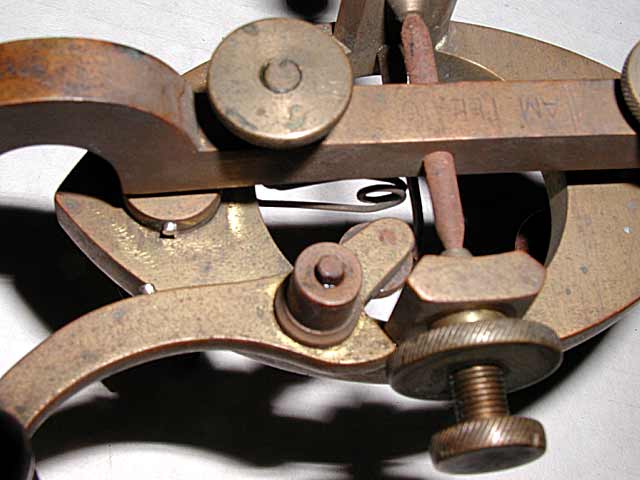
83c A closeup view of the side-mounted shorting
lever contacts in the open position showing the spring and roller
detent:(31KB)
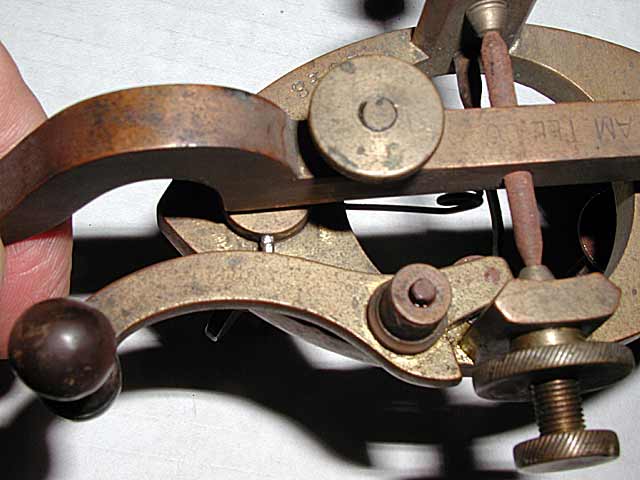
83d A closeup view of the side-mounted shorting
lever contacts in the closed position showing the spring and roller
detent:(34KB)
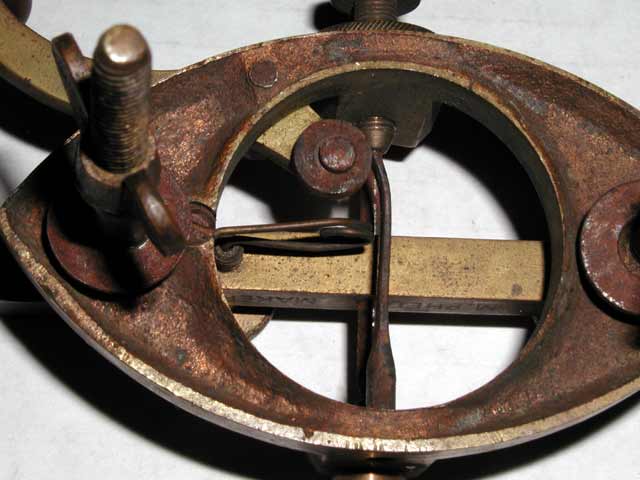
83e A closeup view of the bottom of the key showing
the shorting lever mechanism in the open position:(33KB)
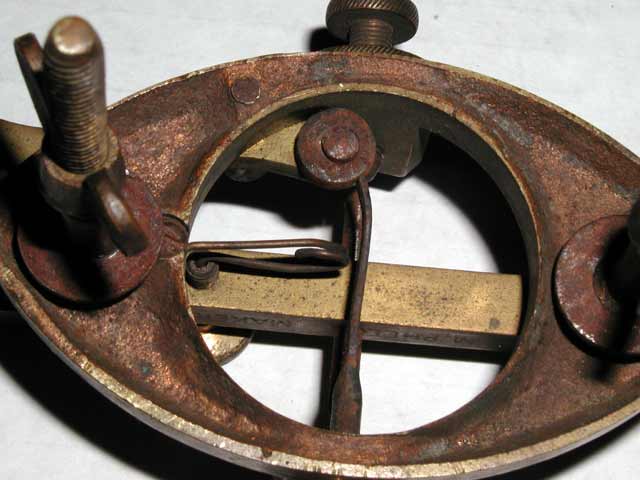
83f A closeup view of the bottom of the key showing
the shorting lever mechanism in the closed position:(33KB)
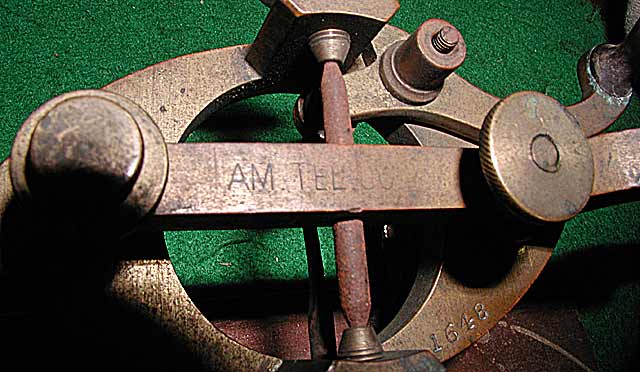
83g A closeup view of top of the lever showing
the AM. TEL. CO. stamp:(43KB)
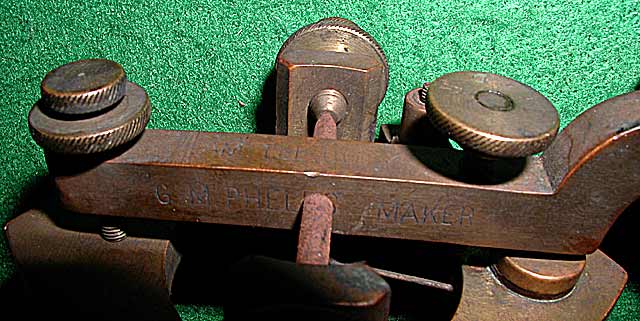
83h A closeup view of left side of the lever showing
the G.M.PHELPS MAKER stamp:(46KB)
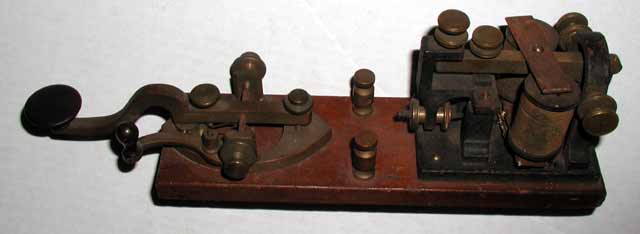
83i Right side of board with key & sounder as
found:(12KB)
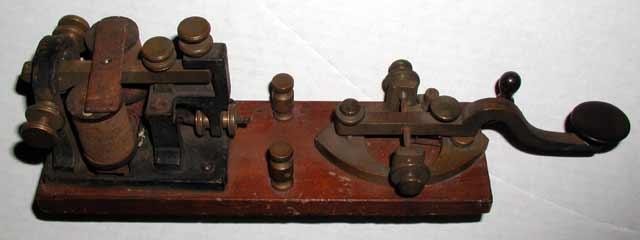
83j Right side of board with key & sounder as
found:(12KB)
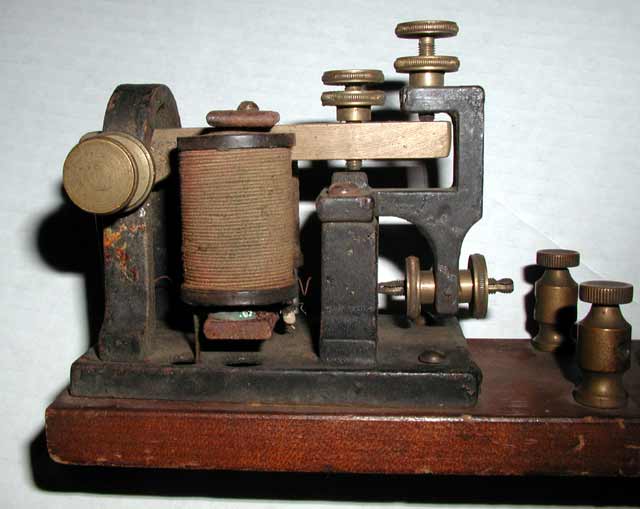
83k Side view of sounder found with key:(30KB)

85 ** PHELPS SOUNDER:(32KB)
This lovely early 1860's Phelps sounder is in the Pete Malvasi - W2PM collection.

86 * PHELPS SOUNDER - RELAY:(26KB)
This Phelps sounder was made as / or converted into a relay.
The upright post is insulated from the base and forms one of
the normally-open relay contacts while a hole in one
trunnion support with a set screw for a piece of wire forms
the other part of the circuit.(Traded to John Casale-W2NI)

87 * EARLY PHELPS/WESTERN UNION PLUG-STYLE TELEGRAPH
SWITCHBOARD:(18KB)
This switchboard allowed one telegraph set to be switched
into one of two incoming telegraph lines. Tapered brass plugs
completed the circuit. A lightning arrestor plate, separated
from the conductors by a small gap, shunted lightning strikes
to ground. The plate reads: W.U.TEL.CO., G.M.PHELPS.(Traded to
John Casale - W2NI.)

90 ** CIVIL WAR TELEGRAPH OPERATOR'S TOMBSTONE WITH
KEY AND TELEGRAPH POLE:(27KB)
This tombstone was erected in honor of James Francis Leonard of
Frankfort, KY. He was a telegraph operator during the Civil
War and is credited with having discovered that the sounds made by
a register as it impressed dot and dash marks on paper tape could
be copied by ear. This led to the widespread use of sounders
for copying the Morse code although many people still insisted
on a permanent paper tape record of the messages because they
did not trust copy-by-ear. In 2004, I was sent a photo of the base of
the tombstone showing the name 'Taylor'. I do not know the significance
of this name.
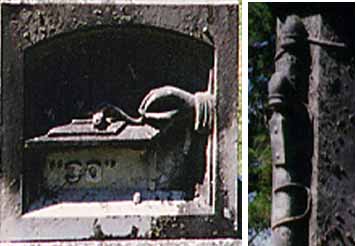
90a Closer view of the telegraph key and the
telegraph line insulator at the top of the pole:(20KB)
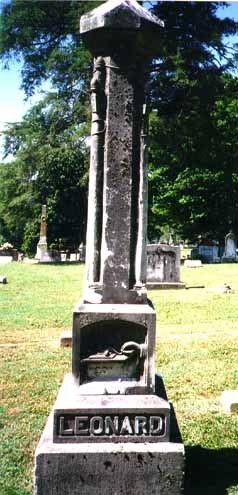
90b Closer view of the front of the tombstone:(32KB)
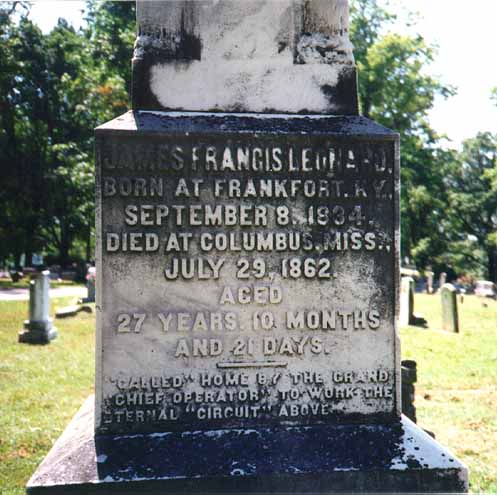
90c Closer view of the inscription:(48KB)
It reads: James Francis Loeonard. Born at Frankfort, KY.,
September 8th, 1934. Died at Columbus, Miss., July 29. 1862
aged 27 years, 10 Months and 21 Days. Called home by the Grand
"Chief Operator" To Work the "Eternal Circuit" Above.
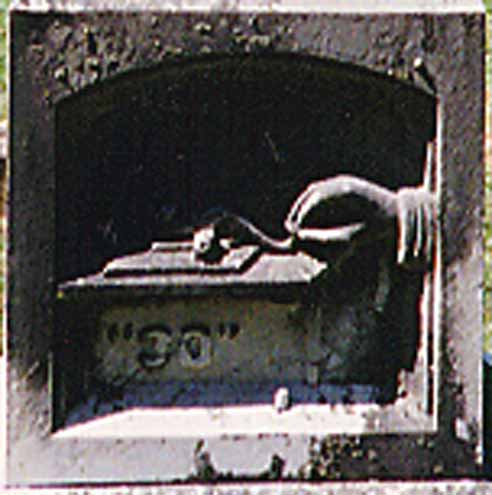
90d Closer view of the telegraph key which is
probably a Hall Camelback:(32KB)
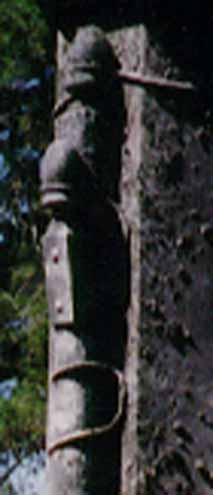
90e Closer view of the telegraph insulator:(14KB)
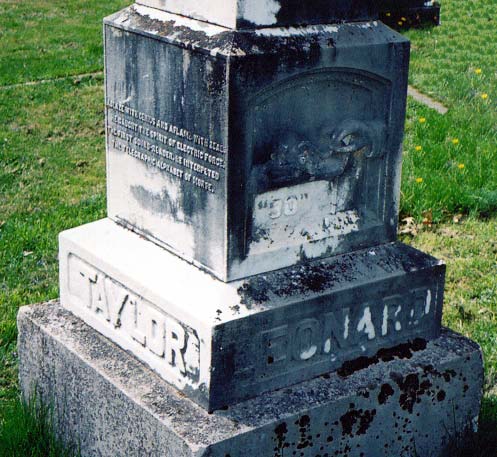
90f A different view of the tombstone showing the name
Taylor on the side of the base.

92 ** Photograph of Civil War Field Telegraph
Station:(39KB)This is one of the very few actual photographs of
a civil war field telegraph setup. You can see the large coils of the
relay quite clearly but the details of the key and other apparatus
are quite hard to make out even in the enlargement below.
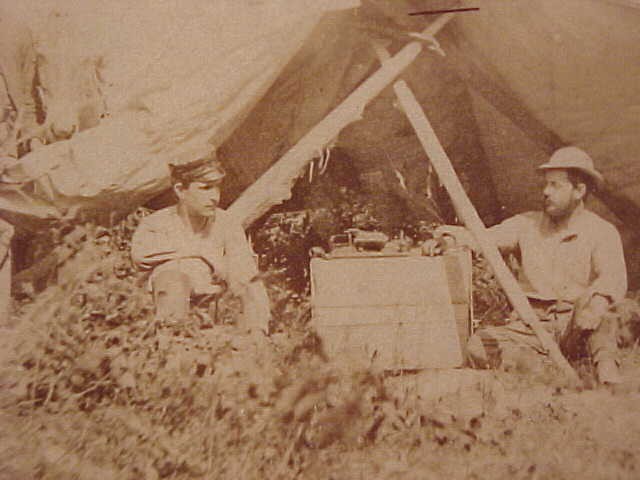
92a ** Enlarged view of the telegraph set in
the Civil War Field Telegraph Station.:(55KB)

94 VISITING CARD PHOTOGRAPH OF A TELEGRAPH OPERATOR AND
TELEGRAPH SETS:
This photograph shows a telegraph operator and what appear to be two box
relay telegraph sets with perhaps Lewis keys.

96 ** OIL PAINTING OF CIVIL WAR ERA INDIANS BURNING
TELEGRAPH POLES:(37KB)This extraordinary oil painting depicts
two indians setting fire to two telegraph poles. This was one of
the reasons that it was difficult to maintain reliable telegraphic
communications across the country at that period in American history.
This painting is the property of collector Bob Fuschetto who
was kind enough to allow me to put this photograph of it in
my museum.

99 ** CIVIL WAR REENACTOR AND TELEGRAPH HISTORIAN ROBERT
FEENEY AND HIS CIVIL WAR TELEGRAPH STATION:
Robert Feeney has been displaying, demonstrating, and explaining Civil War
Telegraph Instruments at various Civil War Reenactments. Many of his
instruments are homemade and they all function perfectly. Notice the
batteries, key & relay set, register, sounder, switch, pocket set and portable
wire dispensing reel in his display. Here are a few more photographs of his
station taken in 2006.
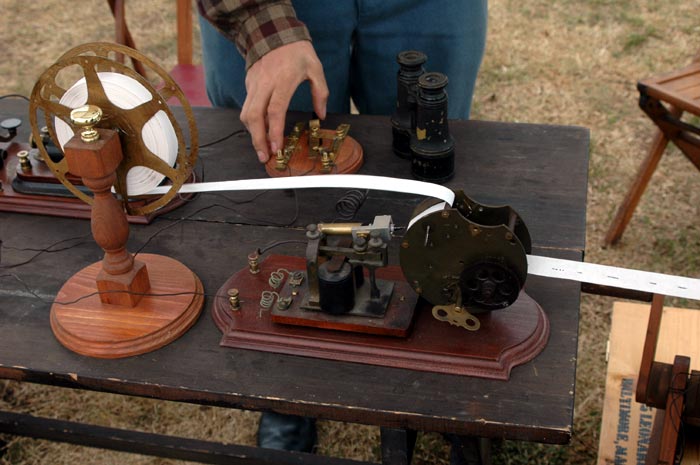
99f ** Telegraph register made by Robert Feeney for his
Civil War Field Telegraph Station:
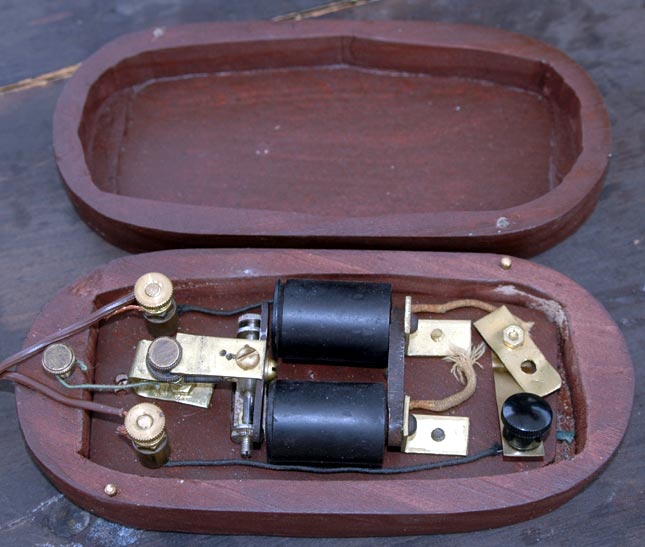
99h ** Telegraph Pocket Set made by Robert Feeney for his
Civil War Field Telegraph Station:
99s ** CIVIL WAR "U.S. MILITARY TELEGRAPH" -
TELEGRAM/MESSAGE FORM From Robert Feeney's display:(260KB)
This is the message form that was used for transcribing and delivering Civil
War Telegraph messages. It is provided courtesy of Robert Feeney. It may be
downloaded and printed on your printer. The original size is: 4-3/4 inches
wide by 7-3/16 inches high.

100 RARE MINIATURE W. HOCHHAUSEN CAMELBACK
KEY:(15KB)This tiny camelback key measures only 3-1/4 inches long.
It was manufactured in the 1870s by W. Hochhausen of New York.
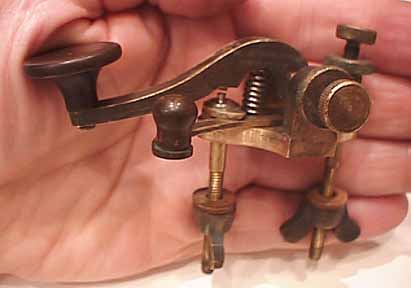
100a Another view of the W. Hochhausen
Camelback key:(14KB)
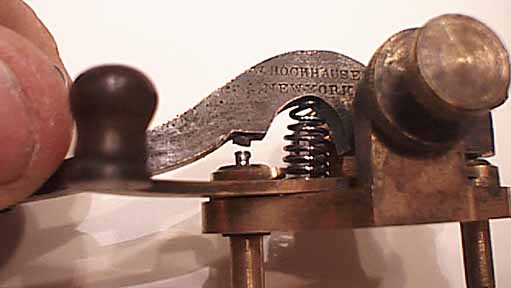
100b A close-up view of the name on the W. Hochhausen
Camelback key:(18KB)

101 RARE MINIATURE W. HOCHHAUSEN CAMELBACK
KEY and MINIATURE S. H. HOGGSON SOUNDER:(23KB)This is the same model
of Hochhausen key shown above. It was found with a miniature sounder made
by S. H. Hoggson of New Haven, Connecticut. Additional pictures are shown
below:
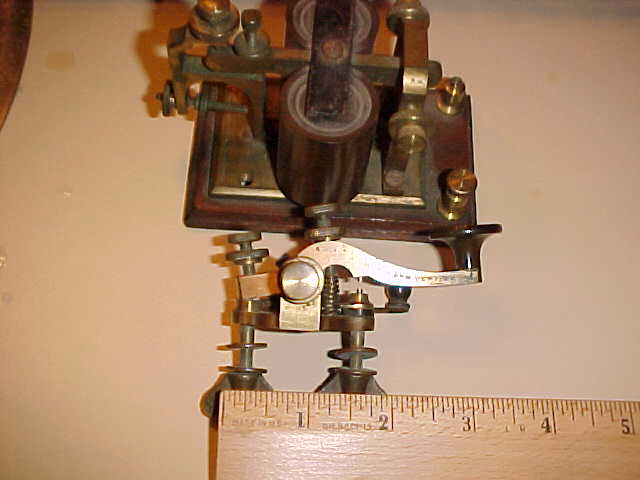
101a Hochhausen Key and Hoggson Sounder with ruler for size
reference:(23KB)
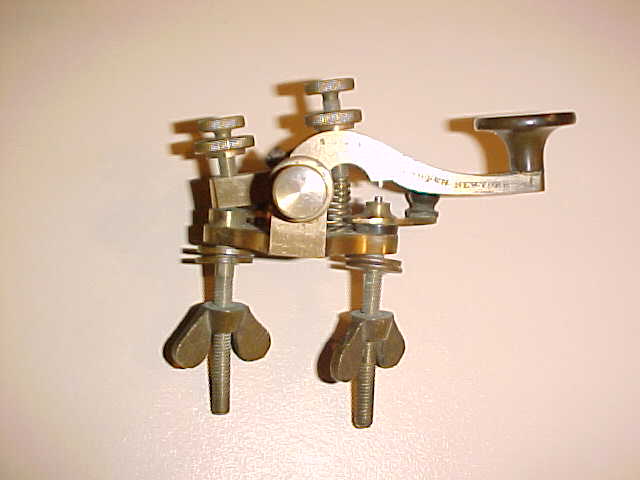
101b Left side view of the key:(25KB)
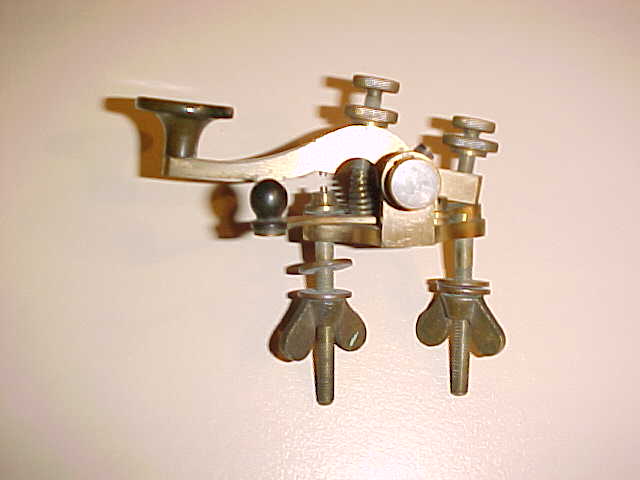
101c Right side view of the key:(20KB)
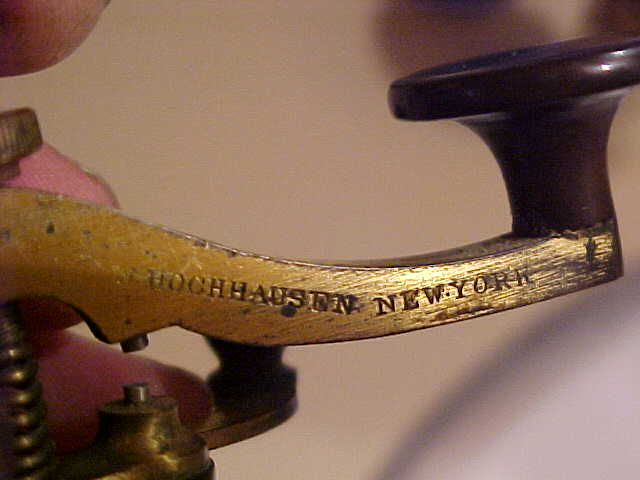
101d Closeup of name on key lever:(24KB)
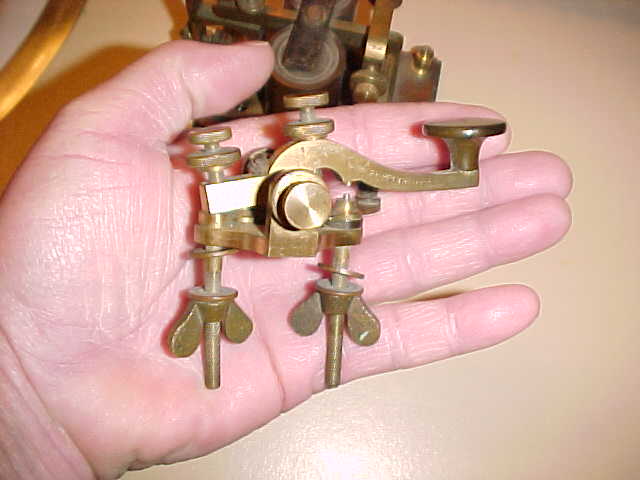
101e Key in hand for size reference:(27KB)
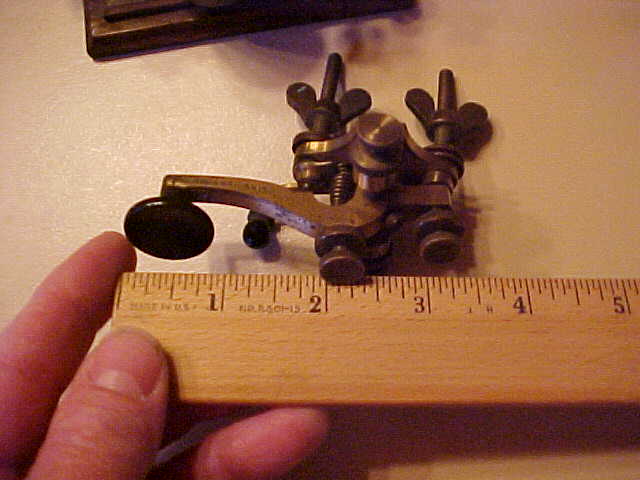
101f Key with ruler for size reference:(31KB)
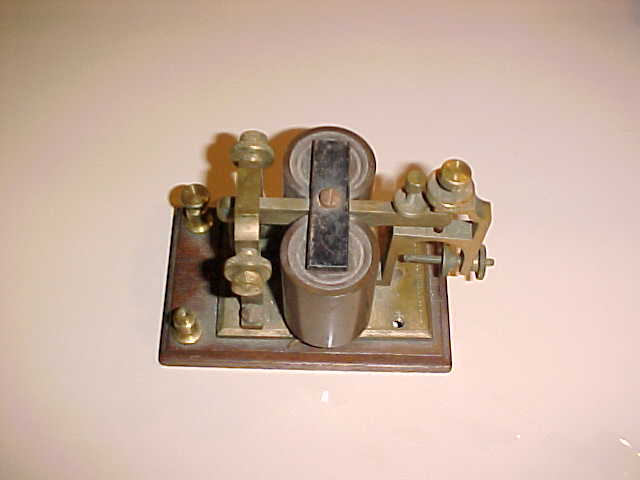
101g Hoggson sounder (top view):(17KB)
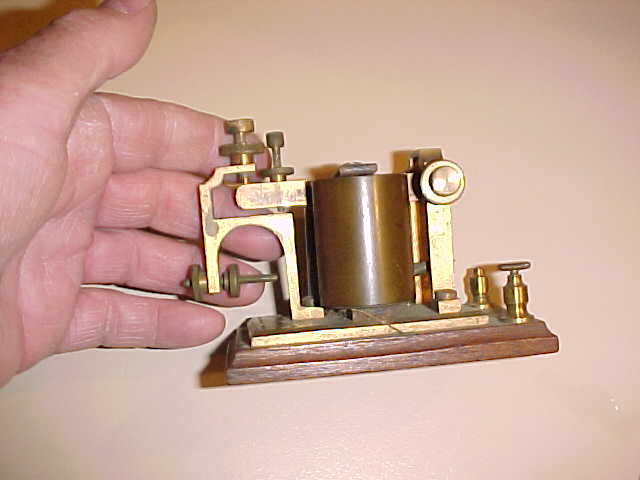
101h Hoggson sounder (side view):(23KB)
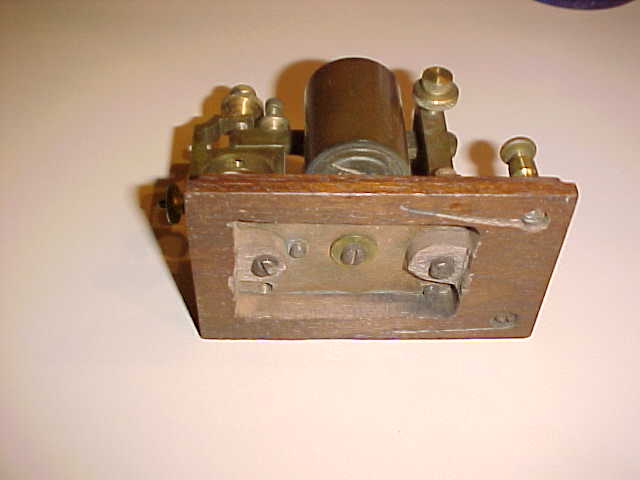
101i Hoggson sounder (bottom view):(19KB)
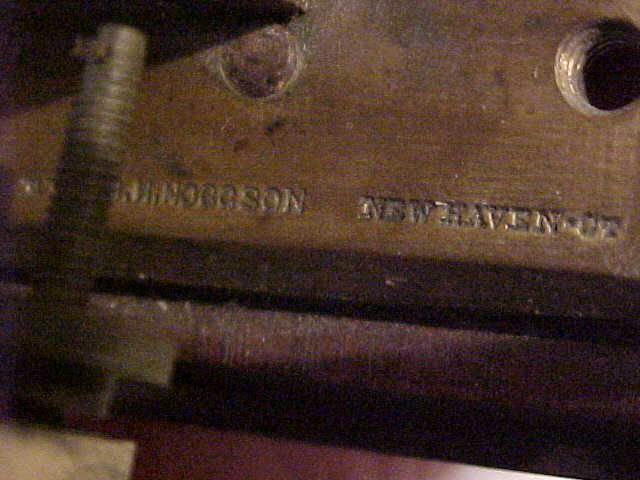
101j Hoggson sounder (maker's label):(35KB)

102 * RARE W. HOCHHAUSEN WEIGHT DRIVEN REGISTER:(25KB)
This magnificent, unusual, and rare round-base Hochhausen register is owned
by collector VE3STN who gave me permission to display it in my museum.
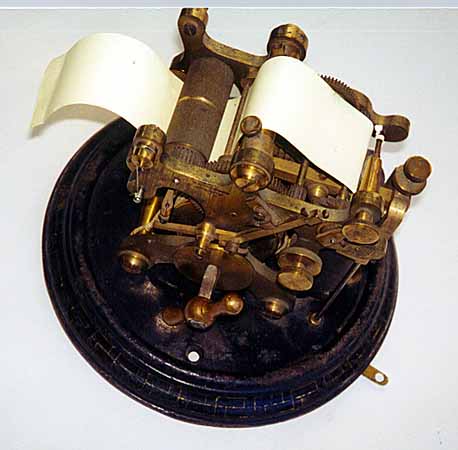
102a * Another view of the HOCHHAUSEN
REGISTER:(31KB)
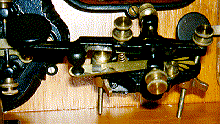
110 PARTRICK & CARTER LEG KEY:(16KB)
Very early step-down cast lever. Black Japanned finish w/gold
trim paint. Shorting switch.Spring adjuster.

111 * PARTRICK & CARTER LEG KEY:(16KB)
Similar to # 110. Very early step-down cast lever.
Black Japanned finish w/gold trim paint.
Shorting switch. Spring adjuster.
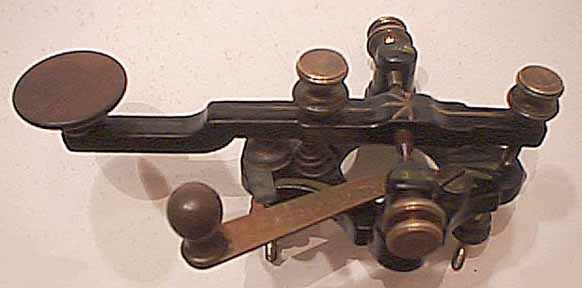
111a Another view of the Partrick & Carter
leg key:(19KB)
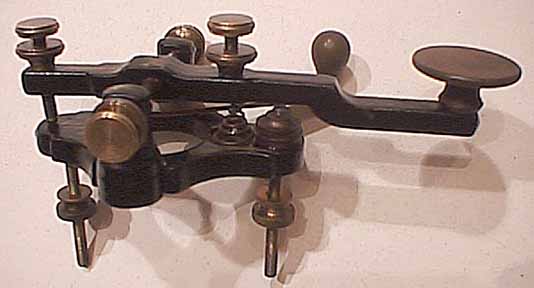
111b Another view of the Partrick & Carter
leg key:(19KB)
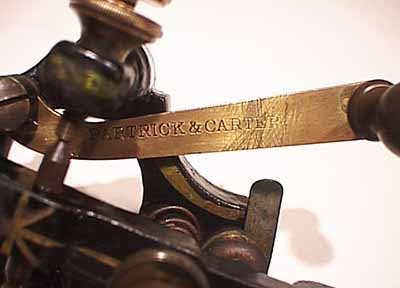
111c Another view of the Partrick & Carter
leg key:(16KB)

120 ** VERY EARLY SWEDISH SORENSEN WEIGHT-DRIVEN
EMBOSSING REGISTER:(60KB)
This is a very early Swedish weight-driven register made by Sorensen in
Stockholm, Sweden. The shape of the frame is very similar to the very
earliest of the German Siemens registers. The picture was provided by
Collector Jan Skoldin, SM5LNE.
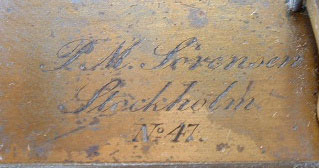
120a ** A closer view of the Sorensen Label:(16KB)

125 VERY EARLY AUSTRIAN EMBOSSING
REGISTER:(25KB)
This is a very early Austrian embossing register. Before dots
and dashes were inscribed on the paper tape in ink, embossing registers
such as this one used a blunt stylus to emboss impressions into
the tape. These long and short impressions were read by eye
and transcribed into letters. The register is signed:
CZEIJA & NISSL, WIEN (Vienna, Austria) Number 769.

130 * EARLY FREDERICK, PEARCE MORSE REGISTER:(12KB)
This lovely and unusual register was made by Frederick, Pearce & Co., of New
York probably in the 1870's. The coils are enclosed within the large,
elaborately decorated 9" x 12" iron base. It uses an ink roller
mechanism to mark the paper tape and has a lever-arm winding mechanism.
Frederick, Pearce of 77 & 79 John Street in New York were successors to
Pearce & Jones of 64-66 John St. who were established in 1872.
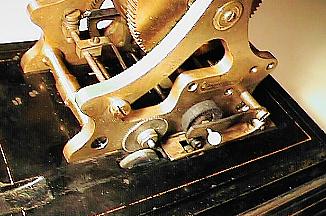
130a A closeup view of the ink-roller mechanism:(26KB)
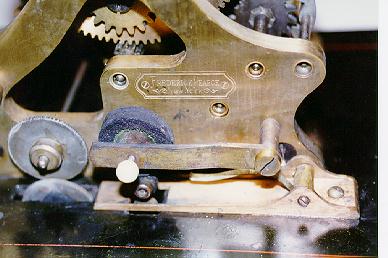
130b A very closeup view of mechanism and label:(35KB)
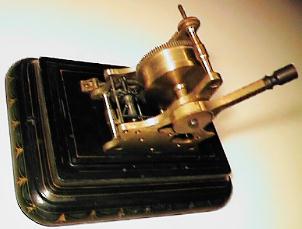
130c A back view showing spring winding lever:(13KB)
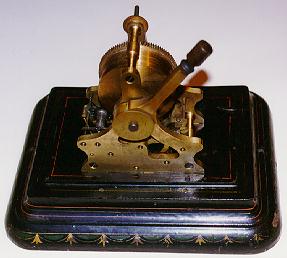
130d Another back view showing spring winding lever:(13KB)
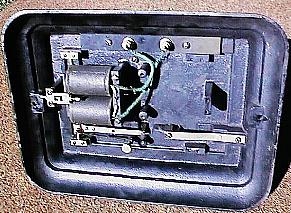
130e View of bottom of base showing the coils:(29KB)
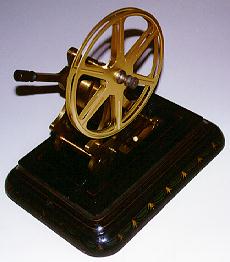
130f Front of register with reproduction supply reel:(19KB)
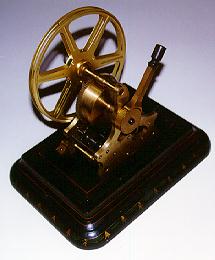
130g Rear of register with reproduction supply
reel:(20KB)
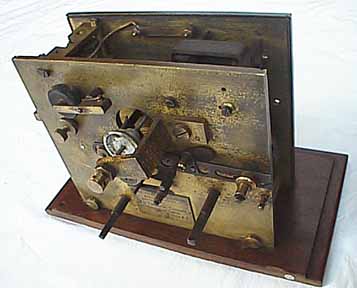
135 EARLY BRITISH STELJES PATENT TYPE-PRINTING TELEGRAPH
REGISTER:(18KB)
This is a very unusual early dual weight-driven type printing telegraph
register. There are two large drums for the cord coming from the
two weights which provide the power to operate the register. It is not
clear how this device functioned but the two solenoid coils apparently
selected the character to be printed on a paper tape by arotating print
wheel.
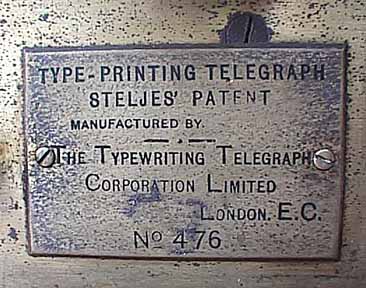
135a A view of the Manufacturer's Label:(35KB)
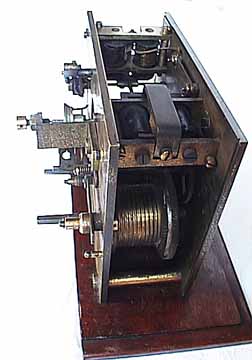
135b A view showing the inner mechanism:(18KB)

140 WATTS CAMELBACK KEY:(30KB)
This interesting camelback key was made by Watts & Co. of Baltimore,
Maryland in the early 1870's. The lever is stamped WATTS & CO.
BALTO MD. The Shorting switch is stamped PAT.AUG 27, 72, and
consists of two strips of brass, lying over each other. Note that
the base is absolutely identical to that of a Phelps camelback.
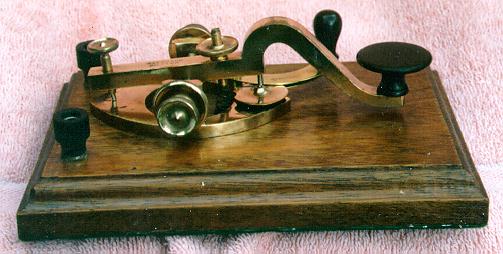
140a The other side view of the Watts
Camelback:(31KB)
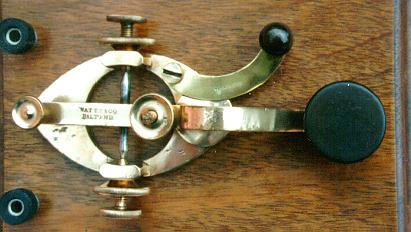
140b Top view of the Watts Camelback:(23KB)
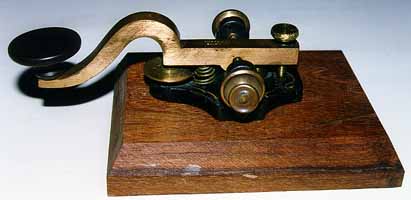
145 WATTS MINIATURE CAMELBACK KEY:(15KB)
This miniature camelback key was made by Watts & Co. of Baltimore, MD
in the 1870's.
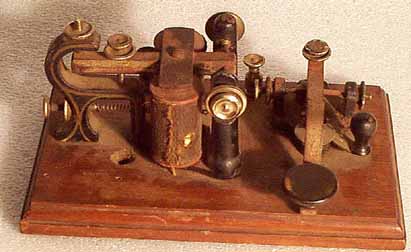
147 * VIADUCT KOB WITH MINIATURE CAMELBACK
KEY:(21KB)
This early KOB has a rather distinctive sounder and a miniature
camelback key which is identical to the Watts Miniature Camelback
Key seen as item 145.(The Derek Cohn WB0TUA Collection)
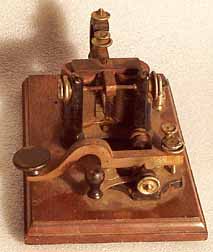
147a A Side view of the Viaduct KOB:(14KB)
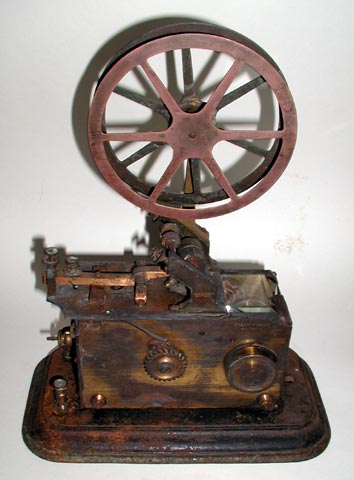
148 * VIADUCT SPRING DRIVEN REGISTER:
This register marked a moving paper tape with the dots and dashes of the Morse
Code. It is labeled: VIADUCT, BOSTON.
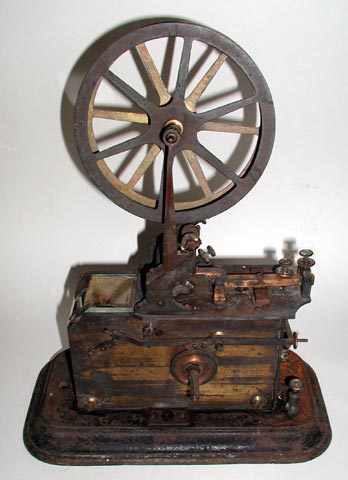
148a * The other side of the Viaduct Register:
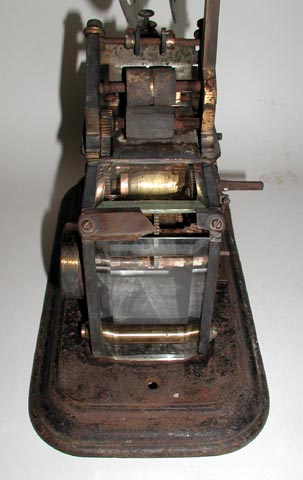
148b * End view of the Viaduct Register:
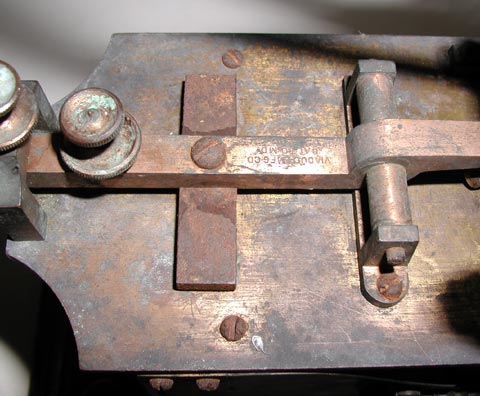
148c * The moving armiture of the Viaduct Register:
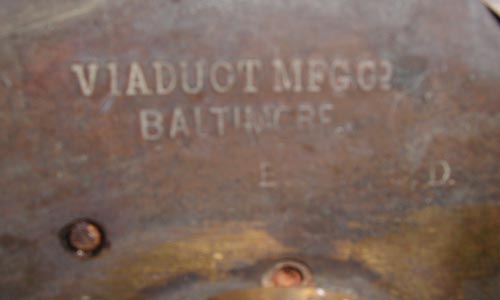
148d * The maker's stamp on the Viaduct Register:
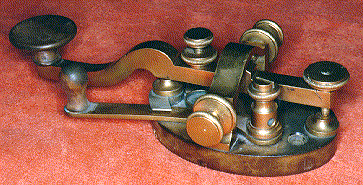
150 EARLY TILLOTSON "ARCHED" CAMELBACK KEY: (40KB)
This Tillotson camelback has an unusual oval hard rubber base. The
brass arch over the trunnion from left to right was probably
designed to stabilize the uprights so they did not work loose in
the base. Label reads: L.G.Tillotson & Co. 8 Dey St., New York.
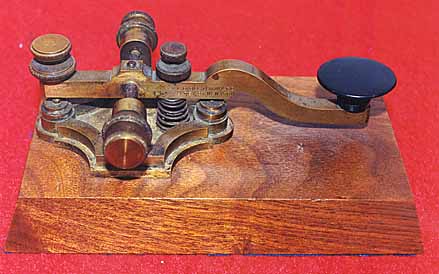
157 * VERY EARLY TILLOTSON CAMELBACK KEY:
(25KB)
This lovely early Tillotson camelback key has a base which is identical to
that on the
Number 56 Caton straight lever
key .. suggesting that there was some connection between Caton and
Tillotson. This great key is owned by Joe Schroeder, W9JUV.
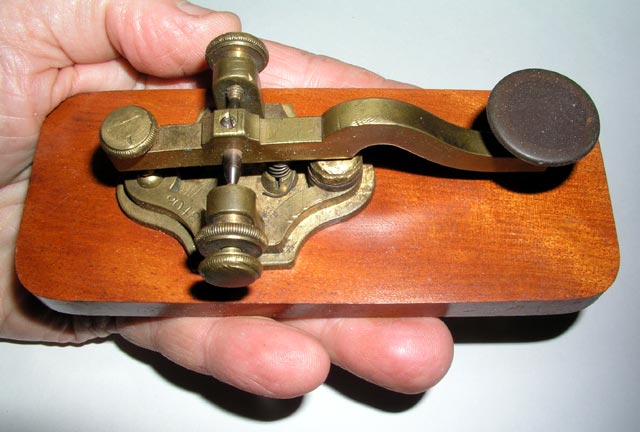
159 MINIATURE TILLOTSON CAMELBACK KEY: (47KB)
Tiny brass-lever camelback key with 3-3/4" lever stamped Tillotson,
6 Dey St.New York, no spring adjusting screw, a lock screw on the steel
trunnion shaft, miniature knob, & brass base stamped 2048.
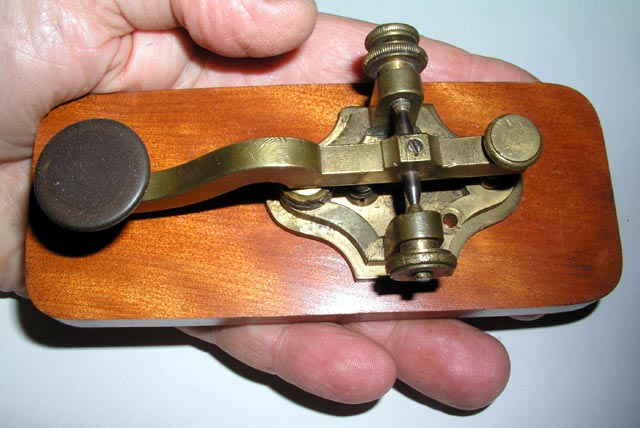
159a Another view of the Miniature Tillotson Cambelback
key: (56KB)
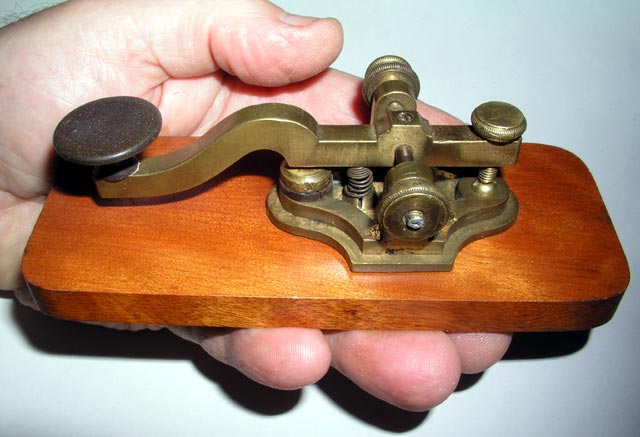
159b Another view of the Miniature Tillotson Cambelback
key: (47KB)
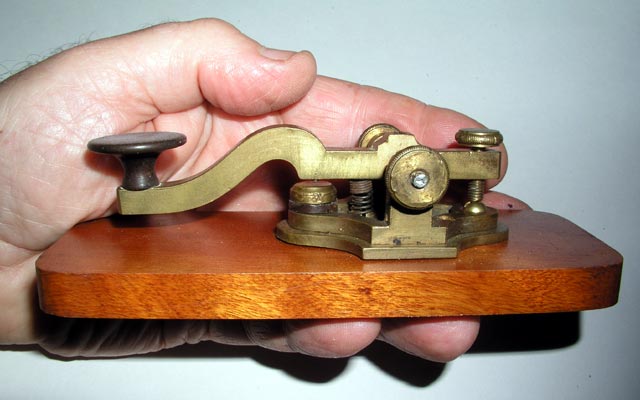
159c Another view of the Miniature Tillotson Cambelback
key: (32KB)
Internet ENIGMA Museum:
https://EnigmaMuseum.com
COPYRIGHT NOTICE: (Copyright (c) 2023: Prof. Tom Perera Ph. D.)
Although all the pictures and text are copyrighted, you may use any of them
for your own personal applications including public lectures and
demonstrations, publications and websites as long as you mention the
w1tp.com Museum. If you plan to offer them for sale to the public
in any form, please email me for permission which I will generally grant as
long as you mention my museum: http://w1tp.com or https://EnigmaMuseum.com My email address is
given at the bottom of this page. Some of the material may require contacting
other copyright owners for commercial use and I will inform you by email.
Please also see the Disclaimer of Warranty.
(The instruments are in approximate chronological order: Oldest first.)
* = (Items no longer owned.) ** = (Items in other collections.)
PART I
50 THE ORIGINAL MORSE TELEGRAPH KEY was actually a notched piece of metal
called a Portrule. It was pulled along and the parts of the metal that were
not notched made contact with another piece of metal, completed the electrical
circuit, and produced the dots and dashes of the Morse Code.

50a THE VAIL 'CORRESPONDENT':(41KB) This simple so-
called 'strap key' was used in early tests by Morse and Vail that led up to
the 1844 demonstration. It was given the name 'strap key' because it
consisted of just a simple strap of spring brass.

50b THE ORIGINAL MORSE TELEGRAPH KEY CALLED THE 'LEVER
CORRESPONDENT' THAT WAS USED IN THE 1844 BALTIMORE-WASHINGTON
DEMONSTRATION:(36KB) This key is on display in the Smithsonian Institution
in Washington, DC and it is on loan from the Vail Museum in Morristown,
NJ.

50h A VERY NICELY MADE REPRODUCTION OF
THE VAIL LEVER CORRESPONDENT This key has the same design features
as the original key. It has a very old-looking patina and it takes a few
minutes to be certain that it is a replica. It is about 30% smaller than the
original and looks very much like it. However, the hex nuts on the adjusting
screws and on the lower contact posts are totally different from the square
nuts used in the original. This key was purchased by Jon, WS1K. It came from
an estate in New Mexico but no further information is available.

50i A RIGHT side view of the reproduction
Lever Correspondent made by an unknown maker.

50i A closer view of the right side of
the reproduction Lever Correspondent made by an unknown maker.
Notice the hex nuts on the adjusting knobs and the lower contacts. No hex
nuts were used in the original.

50x A REPRODUCTION OF THE VAIL LEVER
CORRESPONDENT MADE BY KENT IN ENGLAND:(38KB) This key has the same general
design and measurements as the original key but various production versions of
the Kent key have been given sand-blasted and other finishes which make it
look quite different from the polished brass of the original. Many owners have
tried to achieve the weathered and aged patina of the original key in the
Smithsonian Institution. Several techniques for developing an aged patina on
the key have been tried. One that works quite well is to bury it in the ground
for about a year and then gently clean off the dirt.

50y A LEFT side view of the Lever Correspondent
Reproduction by Kent:(42KB)

50z ** THE EARLIEST CAMELBACK KEY THAT I HAVE
EVER SEEN:(50KB) Owner anonymous.

51 ** EXTREMELY EARLY PALMER AND HALL BOXED COMBINATION
TELEGRAPH KEY AND RELAY SET:
This extremley rare Palmer and Hall telegraph set is contained in a wooden box
that protects the early camelback key and relay from damage. One end of the
box folds down to allow operation of the set while still in the box. The
relay and the box are labeled: Palmer and Hall and the box label reads: PALMER
& HALL electricians, 158 Washington St. Boston, Mass. The box measures: 8.5 x
6 inches. The owner was kind enough to allow me to include these photographs
in my museum prior to selling it on ebay.

51a ** The Palmer & Hall Telegraph Set in its Original
wooden box.

51b ** A different view of the Palmer & Hall Telegraph Set
showing the telegraph key more clearly.

51c ** The operator's end of the Palmer & Hall
Telegraph Set.

51d ** The Maker's Mark on top of the relay in
the Palmer & Hall Telegraph Set.

51e ** A close view of the far end of the key and a
terminal in the Palmer & Hall Telegraph Set.

51f ** The underside of the base of the Palmer & Hall
Telegraph Set.

51g ** The front of the box of the Palmer & Hall
Telegraph Set.

51h ** The inside of the cover of the box of the
Palmer & Hall Telegraph Set showing the Palmer and Hall paper label.

51i ** A close view of the dovetailed corner of the
box of the Palmer & Hall Telegraph Set.

52 ** EXTREMELY EARLY TELEGRAPH AND MINSTREL AMBROTYPE:
(57KB)This extremely early ambrotype is from the Jim Bollman (email:
jim@themusicemporium.com ) collection of very early banjos. It is copyright
(c) Jim Bollman and it is provided courtesy of The Music Emporium
( http://www.themusicemporium.com ).
Ambrotypes were introduced after dagerreotypes and around the middle of the
19th century. They consist of a transparency which is mounted on a black
background. This one shows a grouping of 8 young boys with a banjo and two
telegraph instruments. The grouping and banjo indicate that these boys are
members of one of the popular minstrel groups of the mid 19th century. Three
of the boys are wearing hats and at least two are wearing uniforms which
suggest that they work in a telegraph office. They are holding two extremely
early telegraph instruments and I believe that this is the earliest photograph
of these instruments that has been found.
The left instrument appears to be a Thomas Hall relay similar to the

number 68 ** Palmer & Hall relay shown in my museum:(16KB)
The right instrument appears to be a similar Hall relay mounted on the same
board with a very curved telegraph key which may be an Hall or some other key.
If it is an Hall key, it is much earlier and more elaborate than the
number 67 Hall telegraph key in my
museum:(15KB)
Click here to see an enlarged (but very
slow loading) view of this entire picture:(191KB)
I have selected the
right instrument and enlarged it to allow much closer inspection.

This is an enlarged view
with no sharpening:(17KB) It reveals that the key has a light-colored
probably ivory knob.

Adding a very high degree of sharpening allows a few more
details to be seen:(26KB)

Still more enlargement:(8KB) starts to show more
additional details of the key's design. However, you will probably have
to step quite far back away from your computer screen to view it.
CONCLUSION: I believe that the key is a Palmer and Hall camelback as
shown in

This picture from the Hall
Catalog:(12KB).
Although it is difficult to see all of the details in the ambrotype
because the head of a minstrel gets in the way, most details seem to match
the catalog illustration.

52f ** HOMEMADE MODEL OF THE PALMER & HALL
CAMELBACK:(10KB)This key is in the Tom French W1IMQ collection.
It appears to have been modeled after the above key.

52fa ** Another view of the homemade
camelback:(11KB)

52fb ** Another view of the homemade
camelback:(11KB)

52fc ** Another view of the homemade
camelback:(10KB)

52fd ** Another view of the homemade
camelback:(10KB)

52fe ** Another view of the homemade
camelback:(10KB)

52fg ** Another view of the homemade
camelback:(11KB)

52fh ** Another view of the homemade
camelback:(14KB)

53 VERY EARLY PALMER AND HALL OR HALL BOXED PORTABLE
COMBINATION TELEGRAPH KEY AND RELAY SET:
This extremely rare portable telegraph set is enclosed in a strong wooden box
that protects the tiny miniature straight lever key and miniature relay
from damage. The overall design and the spring adjusting mechanism for the
relay is quite unusual. Although there are no obvious markings on the set,
the knurling on the hardware, the shape of the parts, and the design strongly
suggest that it was made by Palmer and Hall or Hall in Boston, Mass.

53a Another view of the Palmer and Hall portable
set:

53b Another view of the Palmer and Hall portable
set:

53c Another view of the Palmer and Hall portable
set:

53d A closer view of the mechanism of the
Palmer and Hall portable set:

53e A closer view of the mechanism of the
Palmer and Hall portable set:

53f A closer view of the key in the
Palmer and Hall portable set:

53g A closer view of the key in the
Palmer and Hall portable set:

53h The front outside of the box of the
Palmer and Hall portable set:

53i The right outside of the box of the
Palmer and Hall portable set:

53j The left outside of the box of the
Palmer and Hall portable set:

53k The bottom of the box of the
Palmer and Hall portable set:
54 ** POSSIBLY THE EARLIEST TELEGRAPH DAGUERREOTYPES:
These daguerreotypes are exhibited with the permission of Mark Koenigsberg
whose daguerreotype museum at: http://www.geocities.com/~daguerreotype
contains many other early pictures on other subjects. They are
copyright (c) Mark Koenigsberg and are the earliest images of
telegraphers and telegraph instruments that I have found.

55 EXTREMELY EARLY CATON 'MORSE'
WEIGHT-DRIVEN REGISTER:(54KB)
This extremely early Morse Register is a fine example of the first
style of paper-tape recorder to be used on the telegraph lines. It
is powered by a weight and pulls a paper tape past a stylus that
makes indentations in the tape for dots and dashes. It was used
in a railroad depot in Stockton Springs, Maine. It was acquired by
James Coose (W1CBU) of Stockton Springs when the station closed and
given to his son-in-law Robert Littlefield (W1MFU) and transferred
to this museum by Diane Coose Littlefield in 1996. It was made by the
Caton Instrument Co. in the 1850's.
The base is stamped: OTTAWA - ILL 433.

55b ANOTHER VIEW OF THE CATON 'MORSE'
REGISTER:(54KB)

55c ANOTHER VIEW OF THE CATON 'MORSE'
REGISTER:(54KB)

56 CATON TELEGRAPH KEY:(12KB)
This early straight lever key was made by the Caton Instrument Co.,
Ottawa, Ill. The long legs pass through holes in the operating table
and wires are attached to binding posts at the end of each leg.
The lever is stamped CATON, OTTAWA, ILL 7?? (illegible),
and the base is stamped with the number 494. Circa 1860's.

57 ** EARLY CATON 'LINEMAN'S TEST SET OR POCKET
RELAY:(18KB)This magnificent pocket relay or 'lineman's test set'
consists of a sensitive sounder and a very early and tiny strap key.
There is a tiny ivory knob on both the key and the shorting lever.
These sets allowed linemen to tap into telegraph lines with a pocket-sized
instrument and they were also used by the military for intercepting and
sending false messages to the enemy. The set is enclosed in an
oval hard rubber case and in a thick leather protective case.
These pocket sets are very hard to find and this one is owned
by collector Bill Carpenter, AA8EY.

57a High Resolution picture of the Caton Pocket
Relay:(48KB)

60 VERY EARLY ELABORATE CAMELBACK KEY & SOUNDER:(63KB)
This all brass key with leaf spring has a massive elaborately curved
lever of the earliest "camelback" or "humpbacked" shape which was
adopted soon after Morse's demonstration. These keys were only made
for a short time because the steel shaft, press fit into the lever,
tended to work loose with use. The sounder is also heavy brass but,
although it was mounted on a board along with this key, I believe that
the sounder may be from a later period. The original wooden base is
missing. The two instruments came from a burned railroad
station in Canada. Circa 1848. The lever shape and large dished
adjusting screw heads are very similar to the two keys shown below.
It has been suggested that these keys were all made by the Dominion
Telegraph Company in Canada but unfortunately, we have very little
information about Canadian Telegraph Companies.

62 VERY EARLY ELABORATE CAMELBACK KEY:(32KB)
This all brass key with early hairpin spring has the same massive
elaborately curved lever as number 210. The hairpin spring suggests
that it is of a slightly later design. It is stamped NWT, the
initials of the early Northwest Telegraph Company of Western Canada.
All underside parts are stamped "2" and it is also stamped 1880., an
inventory date? It came from Canada. Circa 1850.

63 VERY EARLY ELABORATE STRAIGHT LEVER KEY:(32KB)
This extremely early all brass straight lever key is very similar to
the two extremely early camelback keys above. Note that the shorting
lever and adjusting screws are virtually identical to those above.
Like the two camelbacks, it was also located in Canada and it may have
been made by the Dominion Telegraph Company. Circa 1850's. Collector
Pete Malvasi, W2PM owns a sounder which appears to match this key and which is
labeled Dominion Tel Co. and this lends credence to the suggestion that
Dominion made this key although the key below is very similar to this key and
carries the label: FOSTER, Toronto suggesting that this key might have been
made by Foster.

63a Another view of the early straight
lever key:(16KB)

63b A closer view of the early straight
lever key:(16KB)

63c A still-closer view of the early
straight lever key:(32KB)

64 VERY EARLY ELABORATE CANADIAN 'FOSTER'
STRAIGHT LEVER KEY {One Mystery Solved!}:(32KB)
This extremely early all brass straight lever key is very similar to the key
above (Number 0063). Note that the shorting lever and adjusting screws are
virtually identical to those above. This key is labeled: FOSTER, TORONTO and
it appears to be a very early key made in the 1850s. Several keys have
turned up in the last 10 years that are similar to this key but none of them
has carried a maker's name. It is apparent that this key solves the mystery
of who made these other keys by showing that it was "FOSTER" of Canada who
made them.

64a Another view of the very early Foster straight
lever key:(16KB)

64b A view of the underside of the base of the very
early Foster straight lever key:(16KB)

65 * 1850 TELEGRAM AND TAPE FROM A ''HOUSE PRINTING
TELEGRAPH'':(14KB)
This telegraph message was printed on the paper tape
by a 'House Printing Telegraph' instrument in 1850. The 'House' was
first patented in 1848. The tape was delivered to the addressee
in the envelope which carries the date of receipt of the message.

65l Higher Resolution View of the telegram:(70KB)

66 VERY EARLY THOMAS HALL WEIGHT DRIVEN REGISTER:
(24KB) This lovely old register was made by Thomas Hall of
boston in the early 1850's.

66a Another view of the Hall Register:(28KB)

66b Another view of the Hall Register:(26KB)

66c Another view of the Hall Register:(28KB)

66d Another view of the Hall Register:(26KB)

66e Another view of the Hall Register:(27KB)

66f Another view of the Hall Register:(25KB)

66g Another view of the Hall Register:(23KB)

67 VERY EARLY THOMAS HALL CAMELBACK KEY:(15KB)
This lovely camelback key was made by Thomas Hall of Boston circa
the 1850's.

67a The other side of the Hall
camelback:(15KB)

68 * VERY EARLY PALMER & HALL RELAY:(20KB)
This lovely early relay was made by the firm of Palmer & Hall of
Boston sometime between 1847 and 1849. Notice the ivory end caps on
each of the coils and the ivory insulator on the very end of the contact
spacing screw.(Traded to W2PM)

68a *
Closeup of the Name on top of the frame:(11KB)

69 VERY EARLY THOMAS HALL SOUNDER:(26KB)
This lovely early sounder was made by the firm of Thomas Hall of
Boston sometime between 1847 and 1859.

69a Another view of the Thomas Hall Sounder:(28KB)

69b Another view of the Thomas Hall Sounder:(30KB)

70 VERY EARLY CHARLES CHESTER WEIGHT-DRIVEN MORSE REGISTER:(18KB)
This very early register was made by Charles T. Chester of New York in
the 1850's. It is an embossing register which means that it marked
dots and dashes by making impressions in the paper tape rather than
by depositing ink on the tape.
A pair of them was originally purchased and one was traded.

70a The Pair of Chester Registers:(17KB)

70b The Pair of Chester Registers-(other side):(20KB)

71 VERY EARLY CHARLES CHESTER TELEGRAPH KEY:(12KB)
This lovely straight lever key was manufactured by Charles T. Chester
of New York in the 1850's or 1860's. The lever is 5" long and the base is
3".

72 VERY EARLY MINIATURE CHARLES CHESTER TELEGRAPH KEY:(11KB)
This is a smaller version of number 71. The lever is 4" long and the
base is 2" long.

74 * VERY EARLY TILLOTSON WEIGHT-DRIVEN REGISTER:(45KB)
This lovely and very early register was made by Tillotson & Co of New York in
the 1850's. It's design appears to be identical to the Knox & Shain Registers
made in Philadelphia. It is an embossing register which records dots and
dashes on the paper tape by making indentations in the tape with a pointed
stylus. This picture is displayed with the permission of the
owner/collector.

75 * VERY EARLY CHUBBUCK WEIGHT-DRIVEN REGISTER:(24KB)
This very early register was made by Chubbuck in Utica, NY in the 1850's.
It is an embossing register which records dots and dashes on the
paper tape by making indentations in the tape with a pointed stylus.
(traded to K5VT)

75a ANOTHER VIEW OF THE CHUBBUCK REGISTER:(25KB)

76 VERY EARLY CHUBBUCK WEIGHT-DRIVEN REGISTER:(29KB)
Very similar to number 75 above.

76a ANOTHER VIEW OF THE CHUBBUCK REGISTER:(31KB)

76b ANOTHER VIEW OF THE CHUBBUCK REGISTER:(35KB)

76c ANOTHER VIEW OF THE CHUBBUCK REGISTER:(30KB)

76d ANOTHER VIEW OF THE CHUBBUCK REGISTER:(30KB)

79 EARLY WESTERN UNION WEIGHT-DRIVEN REGISTER:(22KB)
This is an early Western Union Weight-Driven Register. The
solid brass sides of the string reel are very unusual. It is an embossing
register which marks dots and dashes on the paper tape by making
indentations in the tape with a pointed stylus.

79a ANOTHER VIEW OF THE WESTERN UNION REGISTER:(22KB)

79b TOP VIEW OF THE WESTERN UNION REGISTER:(21KB)
The register was apparently carried from location to location in this box.

79c WESTERN UNION REGISTER BOX OPEN:(23KB)

79d WESTERN UNION REGISTER BOX CLOSED:(20KB)
The box has the Western Union Label on the front:

79e WESTERN UNION REGISTER BOX LABEL:(20KB)

80 CIVIL WAR ERA PHELPS CAMELBACK KOB,
Marked G.M.PHELPS-MAKER.:(27KB)
These Phelps Camelback keys were the most widely used of the Civil War keys.
Camelback keys have an upward lump like a camel's hump on the lever
between the knob and the pivot. They were only made for about 12 years
from 1853-1865 because the steel trunnion shaft which was press-fit
into the lever would gradually work loose with prolonged use.
The brass lever would then slide left and right making the key unusable.
This key is all brass except for the steel trunion shaft. The key has a
shorting switch and the revolutionary Phelps-invented spring adjusting
screw which was copied and used on just about every key manufactured
after his invention. This particular Phelps key is mounted on
wooden base with its legs shortened to fit into the base. (a common
but unfortunate modification.) A very early
and primitive Tillotson sounder is also mounted on the base making
it into a portable Key (and sounder) On Base, commonly called a
KOB.(1860's)

81 * CAMELBACK LEG KEY: G.M.PHELPS-MAKER.:(10KB)
As above (no base).circa 1860's.(Traded to John Casale - W2NI.)

81a Another view of the Phelps key:(16KB)

CONSTRUCTION PLANS FOR A PHELPS CAMELBACK
KEY:(LOW RESOLUTION): (35KB)
I have often been asked for drawings of the historic Phelps
Camelback Keys by Civil War Reenactors and others who are
interested in making replicas. I have traced a Phelps key
onto 1/4-inch squares graph paper and added the dimensions as best
my shaky hands would allow and I hope that there is enough information
to allow people to build a key from these plans. I offer these plans
in low, medium, and high levels of resolution. They are
copyrighted but single copies may be made and printed for individual
use by any interested person. I would really appreciate seeing
pictures of your completed or in-progress keys!!

81cm CONSTRUCTION PLANS FOR A PHELPS CAMELBACK KEY:
(MEDIUM RESOLUTION): (96KB)
81cl CONSTRUCTION PLANS FOR A PHELPS
CAMELBACK KEY: (HIGH RESOLUTION): (403KB)
The following photographs show many views of a Phelps Key and may be
useful to those who are trying to reproduce one:

82 PHELPS CAMELBACK KEY (Left Top View mounted on
a base:(21KB)

82a PHELPS CAMELBACK KEY (Right Top View mounted on
a base:(22KB)

82b PHELPS CAMELBACK KEY (Left Top View
unmounted:(14KB)

82c PHELPS CAMELBACK KEY (Right Top View
unmounted:(13KB)

82d PHELPS CAMELBACK KEY (Left Side View
unmounted:(13KB)

82e PHELPS CAMELBACK KEY (Right Side View
unmounted:(14KB)

82f PHELPS CAMELBACK KEY (Bottom View
unmounted:(21KB)

82g PHELPS CAMELBACK KEY (Serial Number on top
of base:(12KB)

82h PHELPS CAMELBACK KEY (W.U.TEL.CO Stamped on
top of lever:(18KB)

82i PHELPS CAMELBACK KEY (G.M.PHELPS MAKER Stamped
on left side of lever:(18KB)

83 VERY UNUSUAL AMERICAN TELEGRAPH CO. PHELPS
CAMELBACK KEY (G.M.PHELPS MAKER Stamped on left side of lever)
WITH SIDE MOUNTED SHORTING CONTACTS:(14KB)This Phelps
Camelback key is stamped AM. TEL. CO. on top of the lever. It has
an extremely unusual shorting switch with spring-loaded detent
and side mounted contacts. It was found mounted on a wooden board
with an early sounder of unusual design. The following photos show
all of the unusual aspects of the key:

83a A view of the Right side of the key showing
the unusually thick shorting lever:(17KB)

83b A view of the Left side of the key showing
the G.M.PHELPS MAKER Stamped into the lever:(14KB)

83c A closeup view of the side-mounted shorting
lever contacts in the open position showing the spring and roller
detent:(31KB)

83d A closeup view of the side-mounted shorting
lever contacts in the closed position showing the spring and roller
detent:(34KB)

83e A closeup view of the bottom of the key showing
the shorting lever mechanism in the open position:(33KB)

83f A closeup view of the bottom of the key showing
the shorting lever mechanism in the closed position:(33KB)

83g A closeup view of top of the lever showing
the AM. TEL. CO. stamp:(43KB)

83h A closeup view of left side of the lever showing
the G.M.PHELPS MAKER stamp:(46KB)

83i Right side of board with key & sounder as
found:(12KB)

83j Right side of board with key & sounder as
found:(12KB)

83k Side view of sounder found with key:(30KB)

85 ** PHELPS SOUNDER:(32KB)
This lovely early 1860's Phelps sounder is in the Pete Malvasi - W2PM collection.

86 * PHELPS SOUNDER - RELAY:(26KB)
This Phelps sounder was made as / or converted into a relay.
The upright post is insulated from the base and forms one of
the normally-open relay contacts while a hole in one
trunnion support with a set screw for a piece of wire forms
the other part of the circuit.(Traded to John Casale-W2NI)

87 * EARLY PHELPS/WESTERN UNION PLUG-STYLE TELEGRAPH
SWITCHBOARD:(18KB)
This switchboard allowed one telegraph set to be switched
into one of two incoming telegraph lines. Tapered brass plugs
completed the circuit. A lightning arrestor plate, separated
from the conductors by a small gap, shunted lightning strikes
to ground. The plate reads: W.U.TEL.CO., G.M.PHELPS.(Traded to
John Casale - W2NI.)

90 ** CIVIL WAR TELEGRAPH OPERATOR'S TOMBSTONE WITH
KEY AND TELEGRAPH POLE:(27KB)
This tombstone was erected in honor of James Francis Leonard of
Frankfort, KY. He was a telegraph operator during the Civil
War and is credited with having discovered that the sounds made by
a register as it impressed dot and dash marks on paper tape could
be copied by ear. This led to the widespread use of sounders
for copying the Morse code although many people still insisted
on a permanent paper tape record of the messages because they
did not trust copy-by-ear. In 2004, I was sent a photo of the base of
the tombstone showing the name 'Taylor'. I do not know the significance
of this name.

90a Closer view of the telegraph key and the
telegraph line insulator at the top of the pole:(20KB)

90b Closer view of the front of the tombstone:(32KB)

90c Closer view of the inscription:(48KB)
It reads: James Francis Loeonard. Born at Frankfort, KY.,
September 8th, 1934. Died at Columbus, Miss., July 29. 1862
aged 27 years, 10 Months and 21 Days. Called home by the Grand
"Chief Operator" To Work the "Eternal Circuit" Above.

90d Closer view of the telegraph key which is
probably a Hall Camelback:(32KB)

90e Closer view of the telegraph insulator:(14KB)

90f A different view of the tombstone showing the name
Taylor on the side of the base.

92 ** Photograph of Civil War Field Telegraph
Station:(39KB)This is one of the very few actual photographs of
a civil war field telegraph setup. You can see the large coils of the
relay quite clearly but the details of the key and other apparatus
are quite hard to make out even in the enlargement below.

92a ** Enlarged view of the telegraph set in
the Civil War Field Telegraph Station.:(55KB)

94 VISITING CARD PHOTOGRAPH OF A TELEGRAPH OPERATOR AND
TELEGRAPH SETS:
This photograph shows a telegraph operator and what appear to be two box
relay telegraph sets with perhaps Lewis keys.

96 ** OIL PAINTING OF CIVIL WAR ERA INDIANS BURNING
TELEGRAPH POLES:(37KB)This extraordinary oil painting depicts
two indians setting fire to two telegraph poles. This was one of
the reasons that it was difficult to maintain reliable telegraphic
communications across the country at that period in American history.
This painting is the property of collector Bob Fuschetto who
was kind enough to allow me to put this photograph of it in
my museum.

99 ** CIVIL WAR REENACTOR AND TELEGRAPH HISTORIAN ROBERT
FEENEY AND HIS CIVIL WAR TELEGRAPH STATION:
Robert Feeney has been displaying, demonstrating, and explaining Civil War
Telegraph Instruments at various Civil War Reenactments. Many of his
instruments are homemade and they all function perfectly. Notice the
batteries, key & relay set, register, sounder, switch, pocket set and portable
wire dispensing reel in his display. Here are a few more photographs of his
station taken in 2006.

99f ** Telegraph register made by Robert Feeney for his
Civil War Field Telegraph Station:

99h ** Telegraph Pocket Set made by Robert Feeney for his
Civil War Field Telegraph Station:
99s ** CIVIL WAR "U.S. MILITARY TELEGRAPH" -
TELEGRAM/MESSAGE FORM From Robert Feeney's display:(260KB)
This is the message form that was used for transcribing and delivering Civil
War Telegraph messages. It is provided courtesy of Robert Feeney. It may be
downloaded and printed on your printer. The original size is: 4-3/4 inches
wide by 7-3/16 inches high.

100 RARE MINIATURE W. HOCHHAUSEN CAMELBACK
KEY:(15KB)This tiny camelback key measures only 3-1/4 inches long.
It was manufactured in the 1870s by W. Hochhausen of New York.

100a Another view of the W. Hochhausen
Camelback key:(14KB)

100b A close-up view of the name on the W. Hochhausen
Camelback key:(18KB)

101 RARE MINIATURE W. HOCHHAUSEN CAMELBACK
KEY and MINIATURE S. H. HOGGSON SOUNDER:(23KB)This is the same model
of Hochhausen key shown above. It was found with a miniature sounder made
by S. H. Hoggson of New Haven, Connecticut. Additional pictures are shown
below:

101a Hochhausen Key and Hoggson Sounder with ruler for size
reference:(23KB)

101b Left side view of the key:(25KB)

101c Right side view of the key:(20KB)

101d Closeup of name on key lever:(24KB)

101e Key in hand for size reference:(27KB)

101f Key with ruler for size reference:(31KB)

101g Hoggson sounder (top view):(17KB)

101h Hoggson sounder (side view):(23KB)

101i Hoggson sounder (bottom view):(19KB)

101j Hoggson sounder (maker's label):(35KB)

102 * RARE W. HOCHHAUSEN WEIGHT DRIVEN REGISTER:(25KB)
This magnificent, unusual, and rare round-base Hochhausen register is owned
by collector VE3STN who gave me permission to display it in my museum.

102a * Another view of the HOCHHAUSEN
REGISTER:(31KB)

110 PARTRICK & CARTER LEG KEY:(16KB)
Very early step-down cast lever. Black Japanned finish w/gold
trim paint. Shorting switch.Spring adjuster.

111 * PARTRICK & CARTER LEG KEY:(16KB)
Similar to # 110. Very early step-down cast lever.
Black Japanned finish w/gold trim paint.
Shorting switch. Spring adjuster.

111a Another view of the Partrick & Carter
leg key:(19KB)

111b Another view of the Partrick & Carter
leg key:(19KB)

111c Another view of the Partrick & Carter
leg key:(16KB)

120 ** VERY EARLY SWEDISH SORENSEN WEIGHT-DRIVEN
EMBOSSING REGISTER:(60KB)
This is a very early Swedish weight-driven register made by Sorensen in
Stockholm, Sweden. The shape of the frame is very similar to the very
earliest of the German Siemens registers. The picture was provided by
Collector Jan Skoldin, SM5LNE.

120a ** A closer view of the Sorensen Label:(16KB)

125 VERY EARLY AUSTRIAN EMBOSSING
REGISTER:(25KB)
This is a very early Austrian embossing register. Before dots
and dashes were inscribed on the paper tape in ink, embossing registers
such as this one used a blunt stylus to emboss impressions into
the tape. These long and short impressions were read by eye
and transcribed into letters. The register is signed:
CZEIJA & NISSL, WIEN (Vienna, Austria) Number 769.

130 * EARLY FREDERICK, PEARCE MORSE REGISTER:(12KB)
This lovely and unusual register was made by Frederick, Pearce & Co., of New
York probably in the 1870's. The coils are enclosed within the large,
elaborately decorated 9" x 12" iron base. It uses an ink roller
mechanism to mark the paper tape and has a lever-arm winding mechanism.
Frederick, Pearce of 77 & 79 John Street in New York were successors to
Pearce & Jones of 64-66 John St. who were established in 1872.

130a A closeup view of the ink-roller mechanism:(26KB)

130b A very closeup view of mechanism and label:(35KB)

130c A back view showing spring winding lever:(13KB)

130d Another back view showing spring winding lever:(13KB)

130e View of bottom of base showing the coils:(29KB)

130f Front of register with reproduction supply reel:(19KB)

130g Rear of register with reproduction supply
reel:(20KB)

135 EARLY BRITISH STELJES PATENT TYPE-PRINTING TELEGRAPH
REGISTER:(18KB)
This is a very unusual early dual weight-driven type printing telegraph
register. There are two large drums for the cord coming from the
two weights which provide the power to operate the register. It is not
clear how this device functioned but the two solenoid coils apparently
selected the character to be printed on a paper tape by arotating print
wheel.

135a A view of the Manufacturer's Label:(35KB)

135b A view showing the inner mechanism:(18KB)

140 WATTS CAMELBACK KEY:(30KB)
This interesting camelback key was made by Watts & Co. of Baltimore,
Maryland in the early 1870's. The lever is stamped WATTS & CO.
BALTO MD. The Shorting switch is stamped PAT.AUG 27, 72, and
consists of two strips of brass, lying over each other. Note that
the base is absolutely identical to that of a Phelps camelback.

140a The other side view of the Watts
Camelback:(31KB)

140b Top view of the Watts Camelback:(23KB)

145 WATTS MINIATURE CAMELBACK KEY:(15KB)
This miniature camelback key was made by Watts & Co. of Baltimore, MD
in the 1870's.

147 * VIADUCT KOB WITH MINIATURE CAMELBACK
KEY:(21KB)
This early KOB has a rather distinctive sounder and a miniature
camelback key which is identical to the Watts Miniature Camelback
Key seen as item 145.(The Derek Cohn WB0TUA Collection)

147a A Side view of the Viaduct KOB:(14KB)

148 * VIADUCT SPRING DRIVEN REGISTER:
This register marked a moving paper tape with the dots and dashes of the Morse
Code. It is labeled: VIADUCT, BOSTON.

148a * The other side of the Viaduct Register:

148b * End view of the Viaduct Register:

148c * The moving armiture of the Viaduct Register:

148d * The maker's stamp on the Viaduct Register:

150 EARLY TILLOTSON "ARCHED" CAMELBACK KEY: (40KB)
This Tillotson camelback has an unusual oval hard rubber base. The
brass arch over the trunnion from left to right was probably
designed to stabilize the uprights so they did not work loose in
the base. Label reads: L.G.Tillotson & Co. 8 Dey St., New York.

157 * VERY EARLY TILLOTSON CAMELBACK KEY:
(25KB)
This lovely early Tillotson camelback key has a base which is identical to
that on the
Number 56 Caton straight lever
key .. suggesting that there was some connection between Caton and
Tillotson. This great key is owned by Joe Schroeder, W9JUV.

159 MINIATURE TILLOTSON CAMELBACK KEY: (47KB)
Tiny brass-lever camelback key with 3-3/4" lever stamped Tillotson,
6 Dey St.New York, no spring adjusting screw, a lock screw on the steel
trunnion shaft, miniature knob, & brass base stamped 2048.

159a Another view of the Miniature Tillotson Cambelback
key: (56KB)

159b Another view of the Miniature Tillotson Cambelback
key: (47KB)

159c Another view of the Miniature Tillotson Cambelback
key: (32KB)
Internet ENIGMA Museum:
https://EnigmaMuseum.com
COPYRIGHT NOTICE: (Copyright (c) 2023: Prof. Tom Perera Ph. D.)
Although all the pictures and text are copyrighted, you may use any of them
for your own personal applications including public lectures and
demonstrations, publications and websites as long as you mention the
w1tp.com Museum. If you plan to offer them for sale to the public
in any form, please email me for permission which I will generally grant as
long as you mention my museum: http://w1tp.com or https://EnigmaMuseum.com My email address is
given at the bottom of this page. Some of the material may require contacting
other copyright owners for commercial use and I will inform you by email.
Please also see the Disclaimer of Warranty.
(The instruments are in approximate chronological order: Oldest first.)
* = (Items no longer owned.) ** = (Items in other collections.)
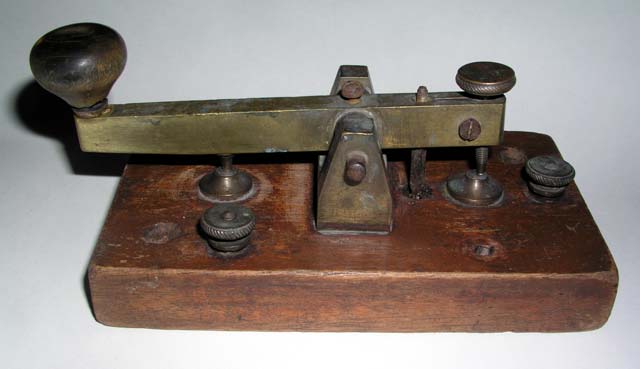
160 EARLY OTTOMAN EMPIRE TURKISH TELEGRAPH
KEY:(23KB)This early Turkish land-line telegraph key was found
in an antique store in Istanbul in 2003. The letters stamped into the bottom
of the base suggest that it was used during the Ottoman Empire.
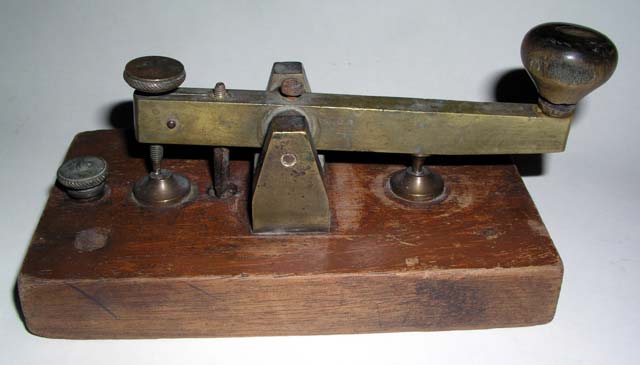
160a Another View of the Ottoman Empire Turkish Key:
(23KB)
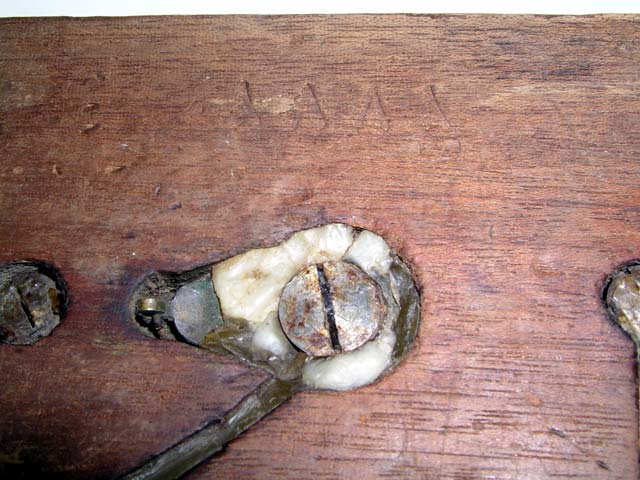
160b A View of the Turkish Key showing the letters on the
bottom of the base:(59KB)

161 * EARLY OTTOMAN EMPIRE TURKISH TELEGRAPH
KEY:(29KB)This early Turkish land-line telegraph key was found
but not purchased in an antique store in Istanbul in 2003. Its basic design
is quite similar to the design of # 160 above.
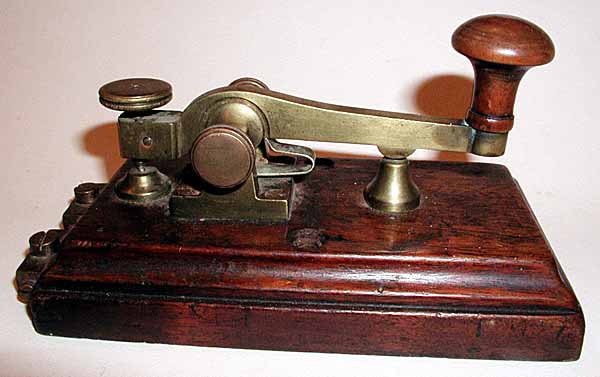
169 EXTREMELY EARLY GERMAN LAND-LINE
CAMELBACK KEY:(31KB) This is a very early German Camelback key although
the next key in the museum, number 170, is clearly much earlier.
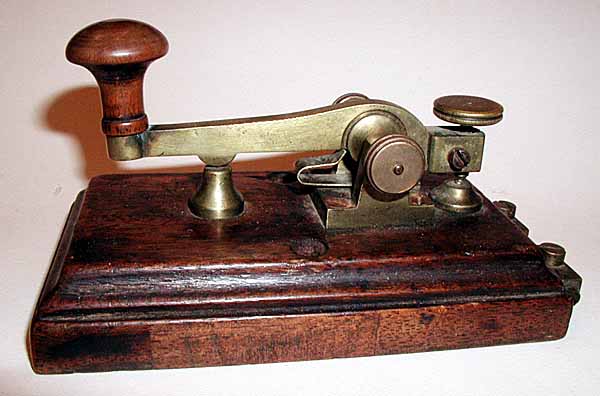
169a Another view of the Camelback
Key:(34KB)
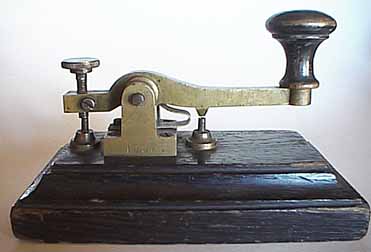
170 EXTREMELY EARLY GERMAN LAND-LINE CAMELBACK
KEY:(14KB) This is one of the very earliest German Camelback keys
that I have ever seen. I believe that it dates to the early 1850's
based on my research in the Siemens and Deutches Museum Archives
in Munich. I believe that the number stamped on the side of the key is
either a part number or the date in which it was placed in service.
I have included several different views of the key.
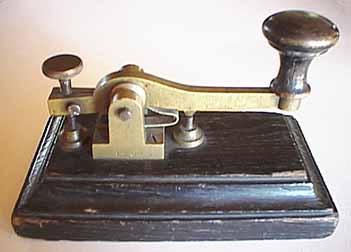
170a Another view of the Camelback Key:(15KB)
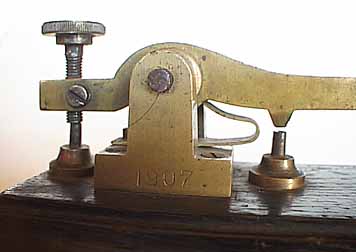
170b Another view of the Camelback Key:(14KB)
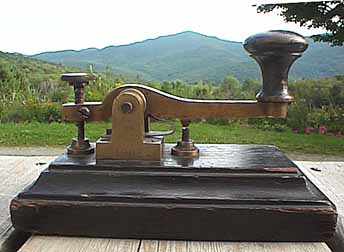
170c Another view of the Camelback Key:(18KB)
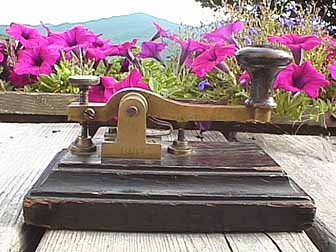
170d Another view of the Camelback Key:(27KB)
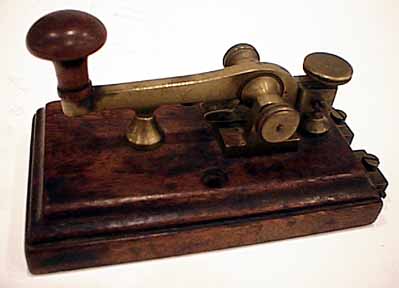
170aa ANOTHER EXTREMELY EARLY GERMAN LAND-LINE CAMELBACK
KEY:(15KB) This is similar to the one above but perhaps slightly
later.
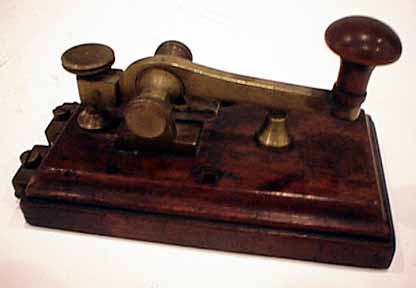
170ab Another view of the extremely early German Camelback
Key:(13KB)
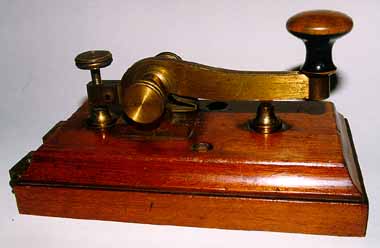
171 * VERY EARLY GERMAN LAND-LINE CAMELBACK KEY:(15KB)
Lovely very early German camelback land-line key with the flat, non-
adjustable spring and the heavy brass camelback lever that was
characteristic of the earliest German telegraph keys.
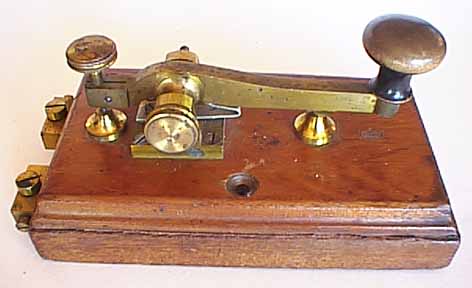
172 * EARLY GERMAN LAND-LINE CAMELBACK KEY:(19KB)
Nice early German camelback land-line key with the flat, non-
adjustable spring and the heavy brass camelback lever that was
characteristic of early German telegraph keys.
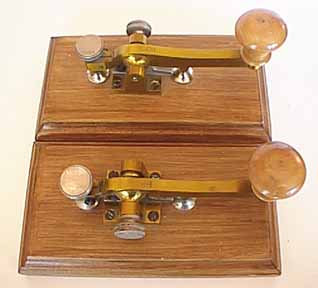
173 * LATER MATCHED GERMAN LAND-LINE
CAMELBACK KEYS:(19KB)
These two keys were mounted side-by-side on a single piece of wood.
The keys are numbered 1 and 2. The heavy camelback levers are
similar to those of early camelback keys but these keys were made
around the turn of the century.
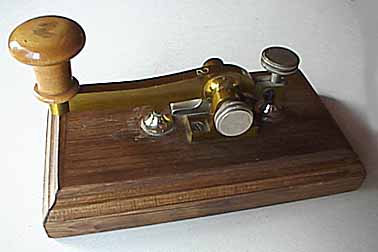
173a A closer view of one of the German
camelback keys:(14KB)
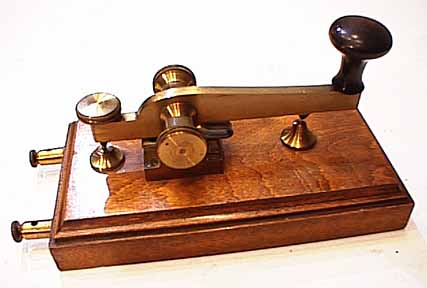
174 EARLY GERMAN LAND-LINE CAMELBACK KEY FROM CZECH
REPUBLIC:(19KB)
Nice early German camelback land-line key with the flat, non-
adjustable spring and the heavy brass camelback lever that was
characteristic of early German telegraph keys. This one was used
in the Czech Republic.
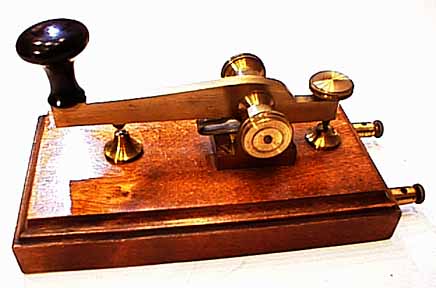
174a Another view of the German/Czech Land line
key:(22KB)
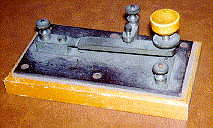
175 VERY EARLY GERMAN LAND-LINE FLAT
SPRING PIVOT KEY:(18KB)
Delicate key with flat spring/pivot (Like a Steiner key) at end of
the 3-3/4" lever. Early Ivory knob and normally open and normally
closed contacts. Books show this to be circa 1840s.
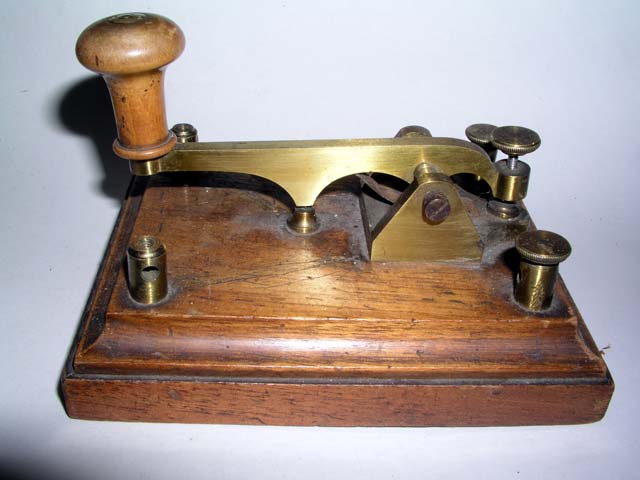
176 VERY EARLY GERMAN LAND-LINE SEMI-CAMELBACK FLAT
SPRING KEY:(34KB)This is an early German land-line key with a very
unusual lever design. It uses the very early flat spring design to hold
the lever up.
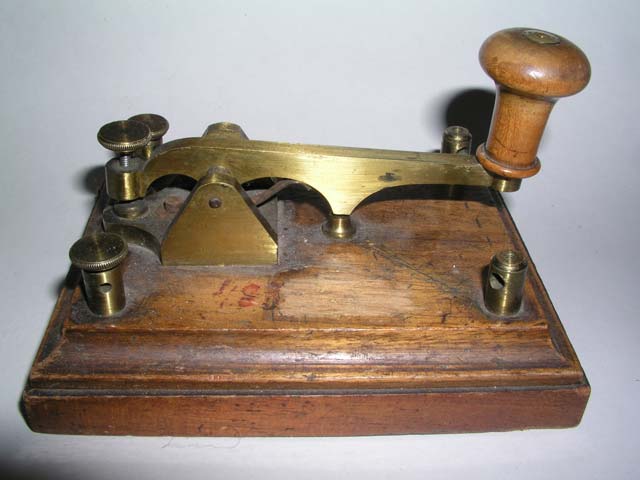
176a Another view of the German key:(36KB)
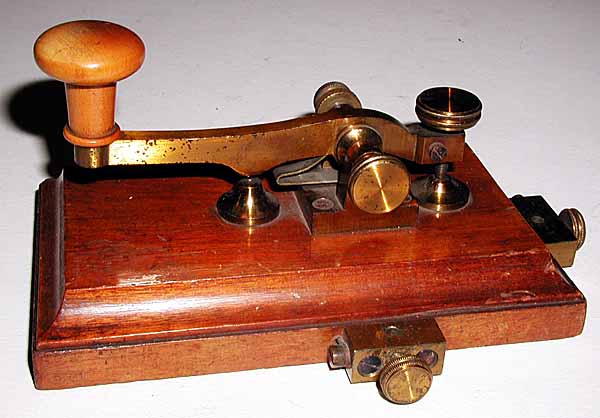
177 EARLY GERMAN LAND-LINE CAMELBACK KEY:
Nice early German camelback land-line key with the flat, non-
adjustable spring and the heavy brass camelback lever that was
characteristic of early German telegraph keys.
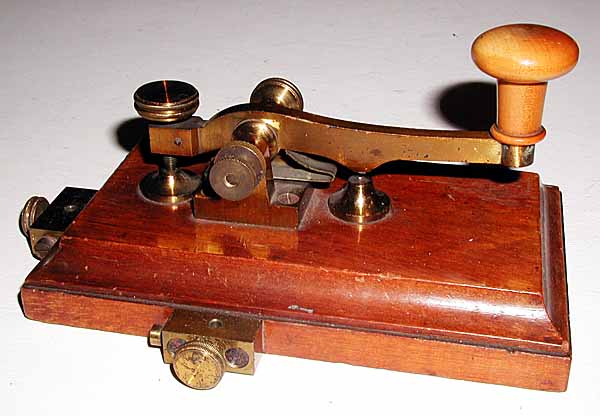
177a Another view of the German Land line
camelback key:
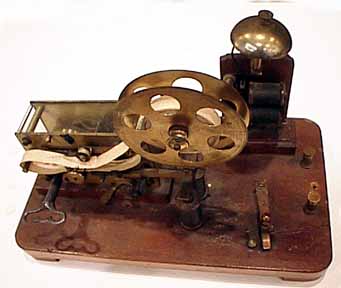
180 * EARLY FRENCH KEY, REGISTER, AND
BELL PRACTICE SET:(17KB)
This is an early French practice set consisting of a small
telegraph key, an electrically operated bell, and a register
which scribed impressions of dots and dashes into a moving
paper tape.
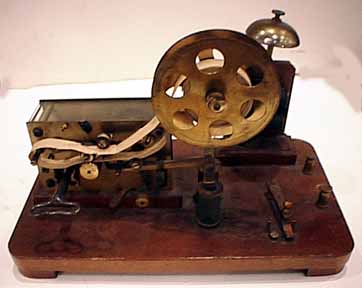
180a Another view of the French practice
set:(16KB)
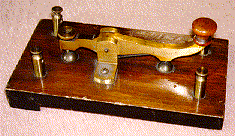
181 EARLY GERMAN BRASS LEVER CAMELBACK
PRACTICE KEY:(18KB)
Small 3-3/4" brass lever with camelback curve and upward pointing
end leading directly into knob. An early flat spring provides
the tension. This design is typical of most of the early Prussian
land-line keys. These keys were used with early German telegraph
practice sets as shown below which are the German equivalent of the
American Bunnell Camelback key and sounder practice sets.
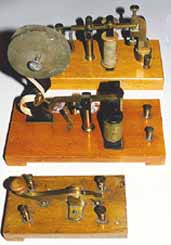
182 * EARLY GERMAN TELEGRAPH SET: KEY, REGISTER,
RELAY:(13KB)
This simple practice set is the German equivalent of the American
Bunnell Camelback key and sounder practice sets. The simply-made key
follows the classic lines of the earliest Prussian Camelback keys.
The register is also of very simple design. The paper tape is simply
pulled through the register by hand. The relay, although simply made,
is patterned after the earliest Prussian relays.
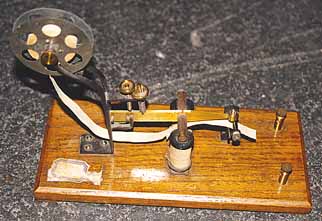
182a * ANOTHER EARLY GERMAN PRACTICE REGISTER:(23KB)
This is another variant of the very simple, hand-operated design.
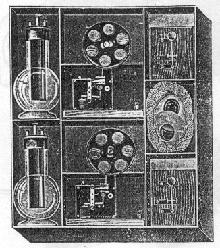
182b CATALOG ILLUSTRATION OF COMPLETE EARLY GERMAN
PRACTICE SET:(22KB)
This illustration shows a box containing a complete German practice
set consisting of 2 glass batteries, 2 keys, 2 registers, and 2
rolls of wire. The catalog was published in 1910/1911 by
Edmund Prandstatter of Munich, Germany. It is interesting to note
that registers were still being produced and sold at this late date
in Germany while Americans had abandonned registers in favor of
copying code by ear from sounders around the 1860's. It is also
interesting to note that there are NO sounders offered for sale
anywhere in the catalog !!
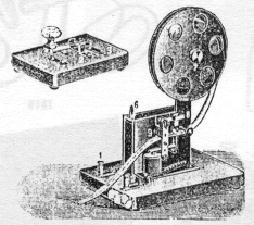
182c CATALOG ILLUSTRATION OF ANOTHER GERMAN
PRACTICE SET:(15KB)
This practice set from the above catalog included a more complex
spring-driven register which pulled the paper tape automatically.
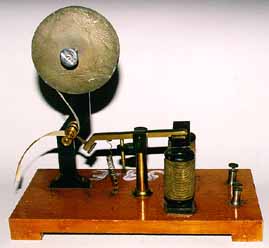
182d * Another GERMAN PRACTICE REGISTER:(15KB)
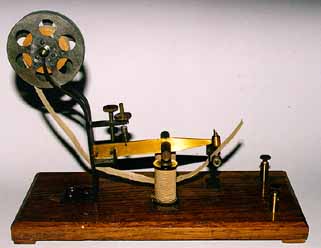
182e * Another GERMAN PRACTICE REGISTER:(15KB)
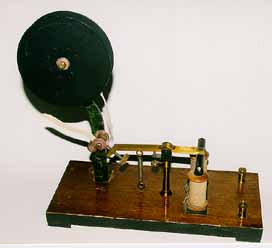
182f * Another GERMAN PRACTICE REGISTER:(15KB)
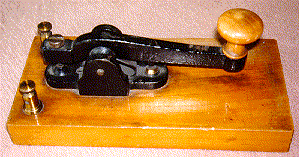
183 VERY EARLY GERMAN CAST LEVER CAMELBACK KEY:(25KB)
Massive 4-3/4" long cast lever with the classical Prussian
camelback shape. An early flat spring provides the tension.
Normally open contacts only.
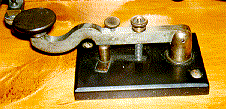
185 UNUSUAL EARLY GERMAN CAMELBACK KEY:(15KB)
Small 4-1/4"Camelback lever with unusual upward pointing end leading
directly into knob. Key is pivoted on far end and has coil spring.
Black 3-1/2x2-1/2 base stamped: E.ZIMMERMAN, LEIPZIG. This key was
sold for use in scientific experiments as well as for telegraph.
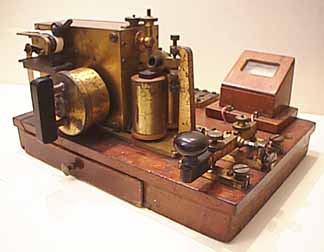
0187 EARLY GERMAN 'SIEMENS' KEY, REGISTER, & GALVANOMETER
(KROB) SET:(16KB)
This set is a typical example of an early European land-line telegraph system
consisting of a straight-lever German key, an ink writing register,
and a galvanometer for measuring the condition of the line. A roll
of paper tape on which the dots and dashes were written (in ink)
is stored in the drawer under the register.
This set was manufactured by Siemens.
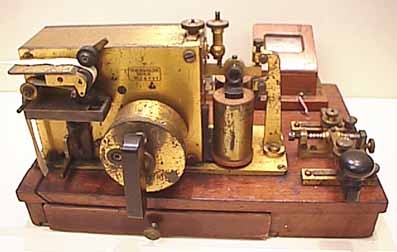
0187a ANOTHER VIEW OF THE SIEMENS SET:(20KB)
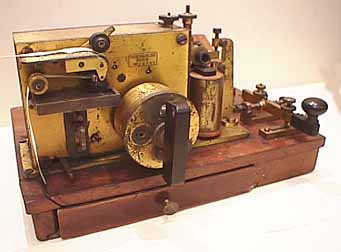
0187b ANOTHER VIEW OF THE SIEMENS SET:(17KB)
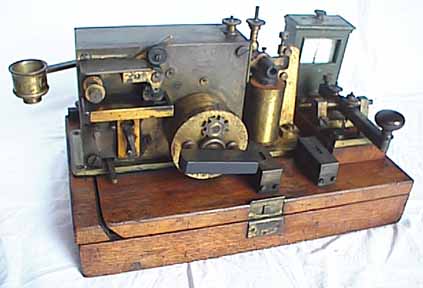
0188 EARLY FRENCH KEY, REGISTER, & GALVANOMETER
(KROB) SET:(21KB)
This set is a typical example of the early European land-line telegraph
systems which consisted of a straight-lever German-design key,
an ink writing register, and a galvanometer for measuring the
condition of the line. It is called a ''KROB'' set which stands for:
Key and Register on Base. A roll of paper tape on which the dots and
dashes were written (in ink) is stored in the drawer under the register.
This set is stamped with the French manufacturer's name but the
design of the key and register are clearly Siemens.
The name stamped on the set reads: Societe Industrielle des Telephones,
25 Rue du 4 Septembre, Paris. I believe that the set was probably
originally manufactured or certaily licensed by Siemens.
NOTE the interesting telegraph key which has the characteristic
German Siemens spring-mounted lower contacts AND surprisingly, it has
two tension springs. One spring is mounted in front of the trunnion
and one spring is mounted in back of the trunnion. It is unclear
why the spring in back of the trunnion was needed.
The only other two-spring key that I have been able to find is
listed in the Spark and Radio keys' and the 'German Military keys'
sections of this museum.
The following views of this set allow you to see all of the
important details.
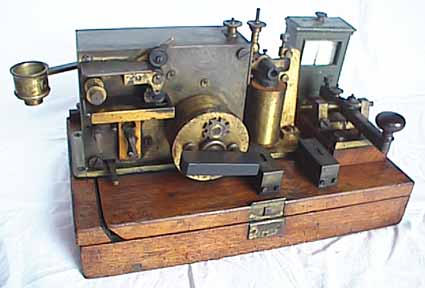
0188a Another angled view of the French set:(21KB)
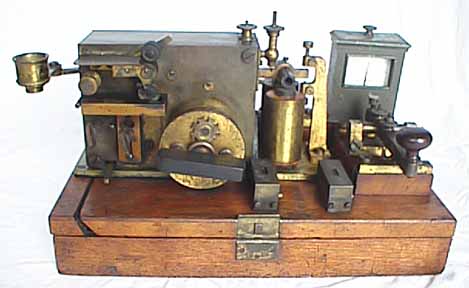
0188b Another angled view of the French set:(22KB)
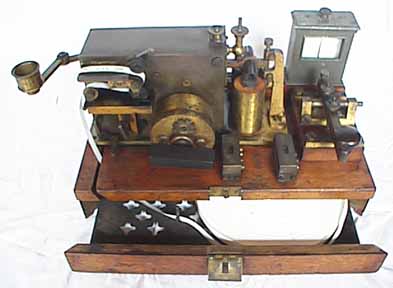
0188c A view of the French set with paper drawer
open:(19KB)
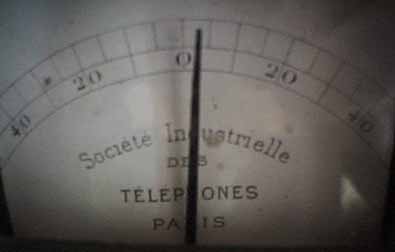
0188d A close up view of the galvanometer on the French
set:(8KB)
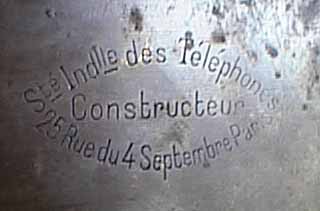
0188e A close up view of the name stamped into the
French set:(12KB)
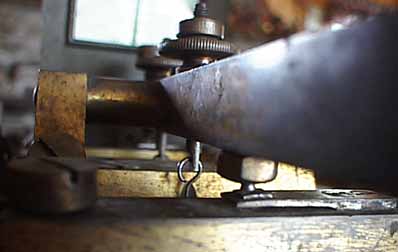
0188f A close up view of contacts and dual springs of
the (German-origin) telegraph key on the French set:(14KB)
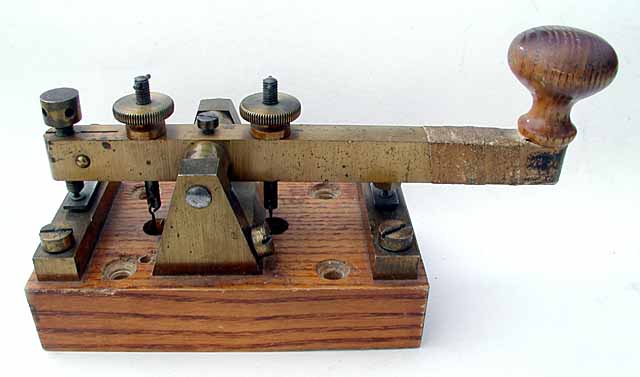
0188g A key that is similar to that
has the same dual springs as those on the above set:(25KB)
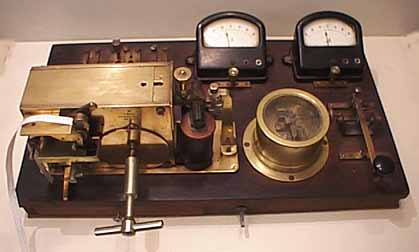
0189 * EARLY GERMAN 'WETZER' KEY, REGISTER, & GALVANOMETER
SET:(17KB)
This set is a typical example of a land-line telegraph system
consisting of a straight-lever German key, an ink writing register,
and a galvanometer for measuring the condition of the line. This
one is somewhat later than number 0187 and the black meters were
probably added later than it's first date of manufacture. It
was manufactured by H. Wetzer, Pfronten Bayern.
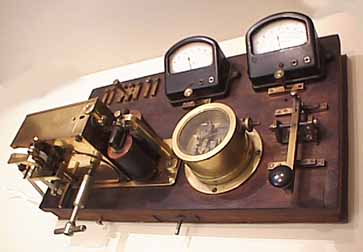
0189a Another view of the wetzer set:(17KB)
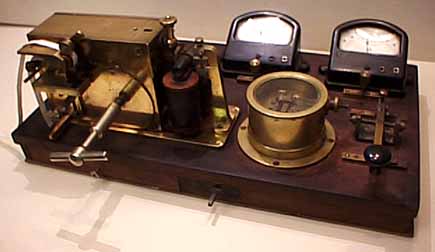
0189b Another view of the wetzer set:(17KB)
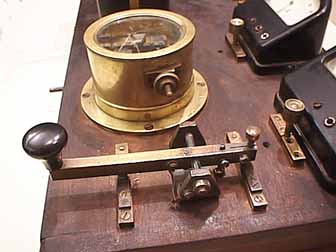
0189c Another view of the wetzer set:(18KB)
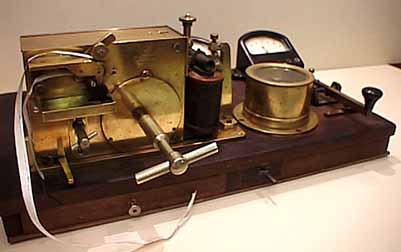
0189d Another view of the wetzer set:(17KB)
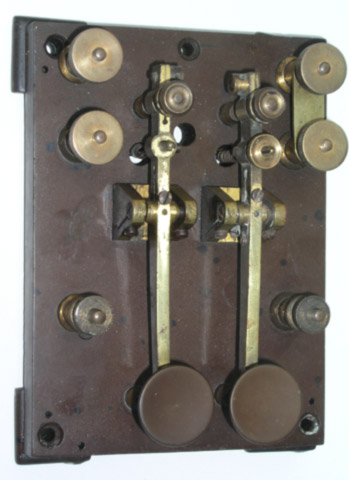
190 LARGE WESTERN UNION TRANSATLANTIC CABLE KEY:(51KB)
Two large old brass levers mounted on a 4-1/2x6" black rubber base.
The left lever was used to send dots. Pressing it drove the cable
voltage positive. The right lever was used to send dashes and drove
the cable negative. Since the cable was thousands of miles long,
it acted as a huge capacitor and the full plus-to-minus voltage was
necessary to help it discharge. The messages were recorded on a
moving paper strip and it took skill to visually tell the difference
between dots & dashes.
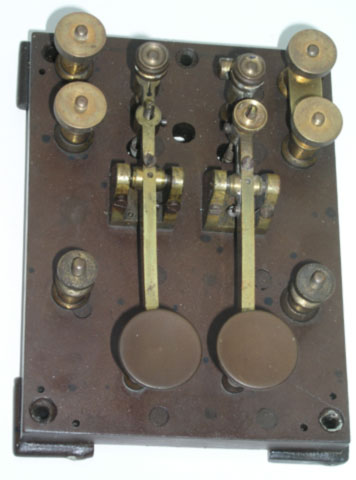
0190a Another view of the WU Cable Key:(37KB)
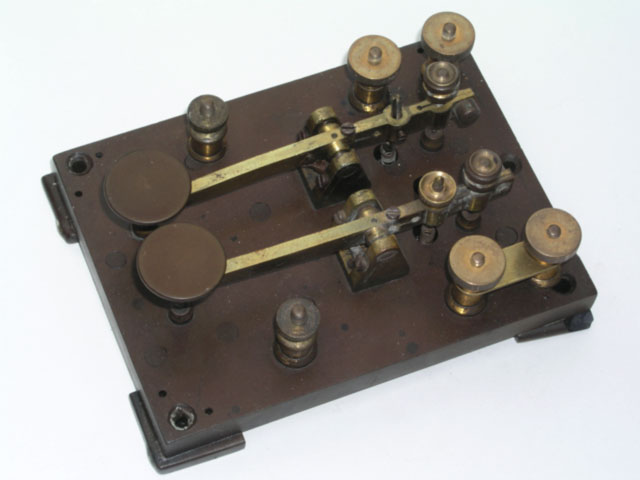
0190b Another view of the WU Cable Key:(37KB)
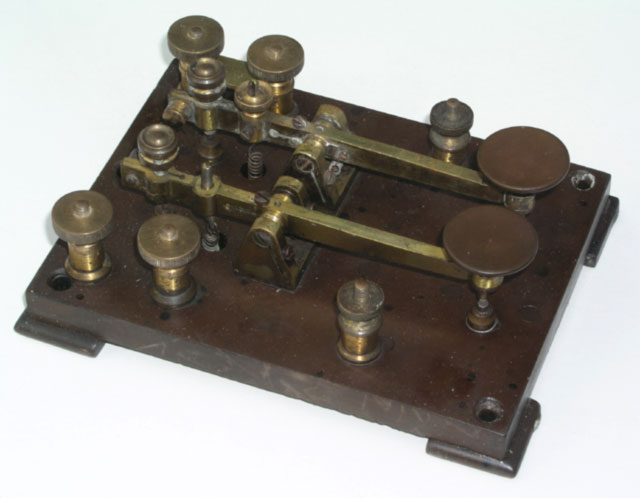
0190c Another view of the WU Cable Key:(37KB)
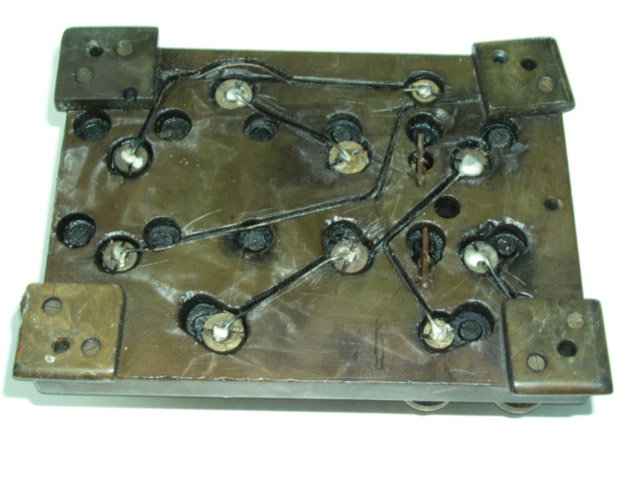
0190d A view of the bottom of the base of the
WU Cable Key:(37KB)
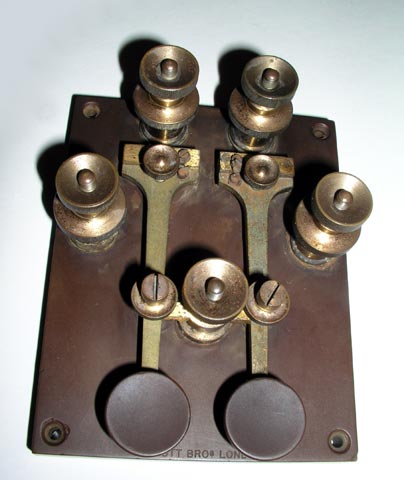
192 LARGE ELLIOTT BROTHERS TRANSATLANTIC CABLE
KEY:(51KB)This is a very fine example of an early submarine cable key. It
has survived in very good condition and shows a plethora of adjustments that
allow it to be set to the exact tension and spacing desired by an operator.
The left lever was used to send dots. Pressing it drove the cable voltage
positive. The right lever was used to send dashes and drove the cable
negative. Since the cable was thousands of miles long, it acted as a huge
capacitor and the full plus-to-minus voltage was necessary to help it
discharge. The cable messages were usually recorded on a moving paper strip
and it took skill to visually tell the difference between dots & dashes.
This key, however, was used with the super-sensitive relay shown below
instead of the typical paper tape recorder.
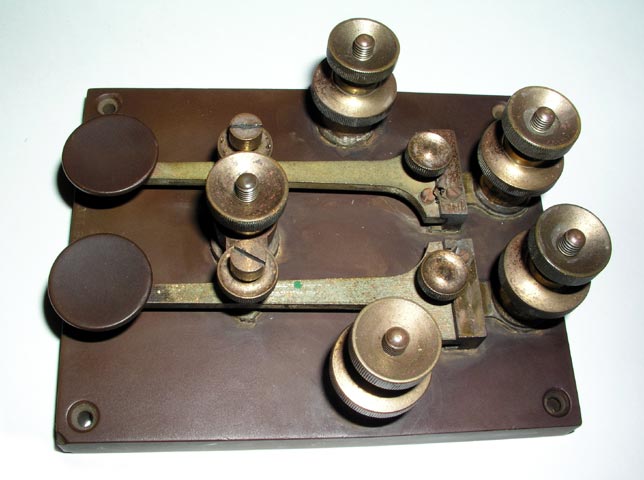
192a Another view of the Elliott Brothers Cable key:
(41KB)
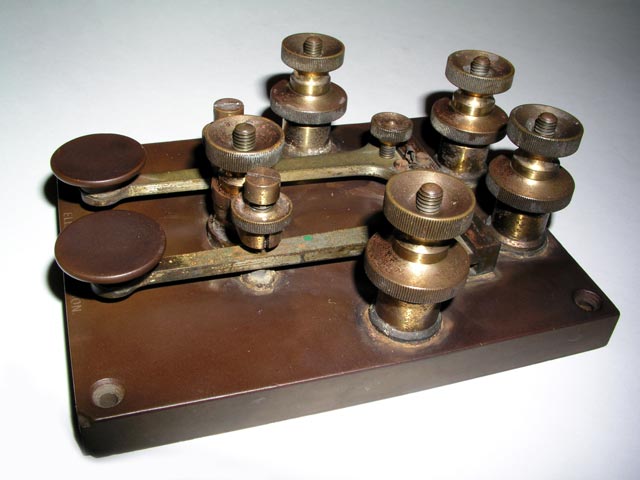
192b Another view of the Elliott Brothers Cable key:
(41KB)
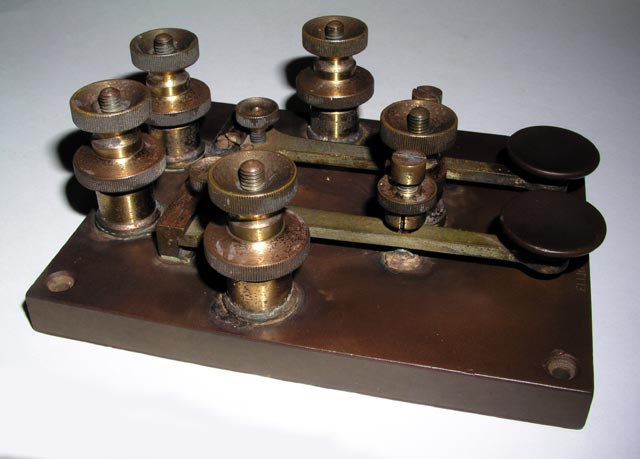
192c Another view of the Elliott Brothers Cable key:
(41KB)
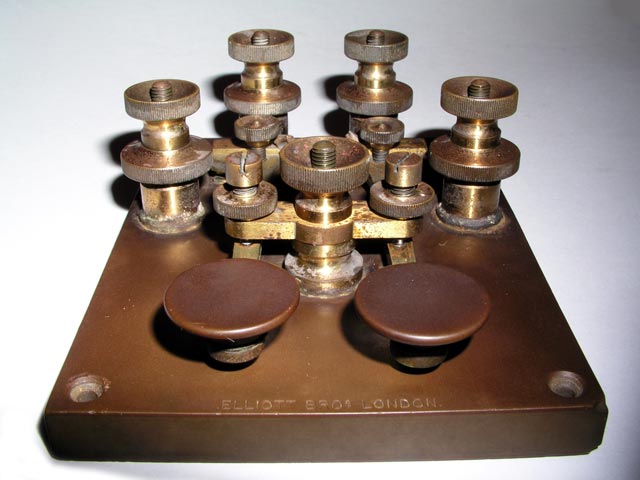
192d Another view of the Elliott Brothers Cable key:
(41KB)
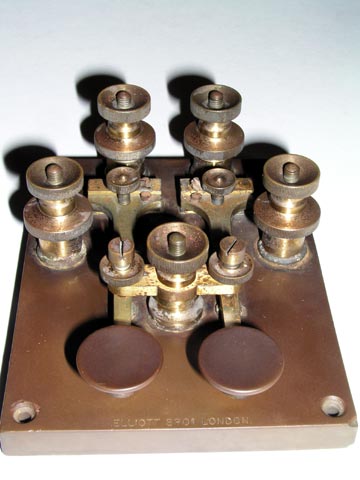
192e Another view of the Elliott Brothers Cable key:
(41KB)
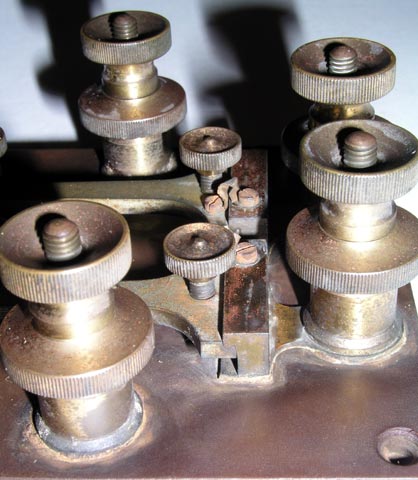
192f A close view of the Victor-Patent-like pivots on
the Elliott Brothers Cable key: (41KB)
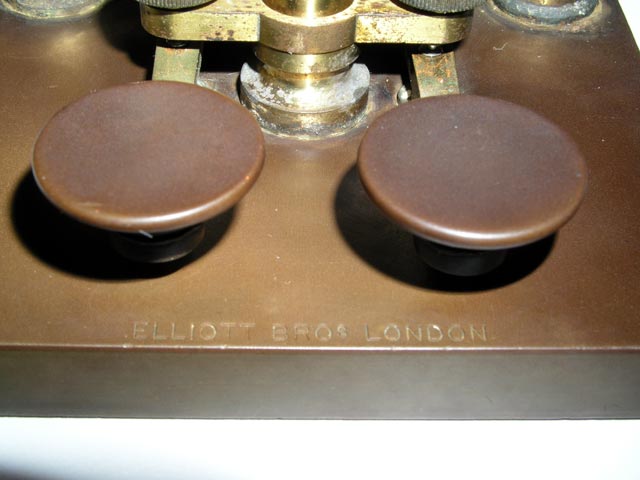
192g A close view of the maker's name on the Elliott
Brothers Cable key: (41KB)
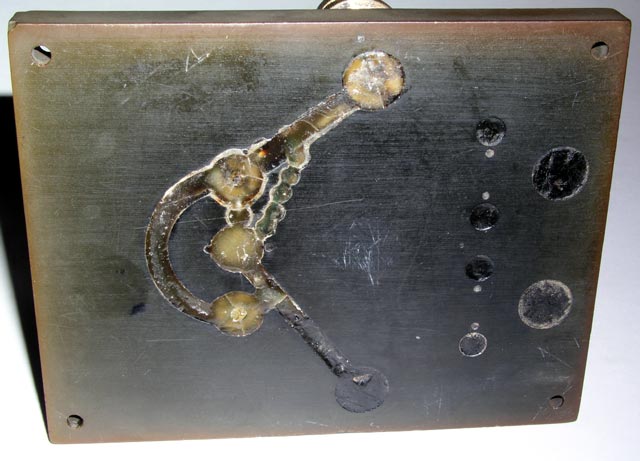
192h The underside of the base of the Elliott Brothers
Cable key: (41KB)
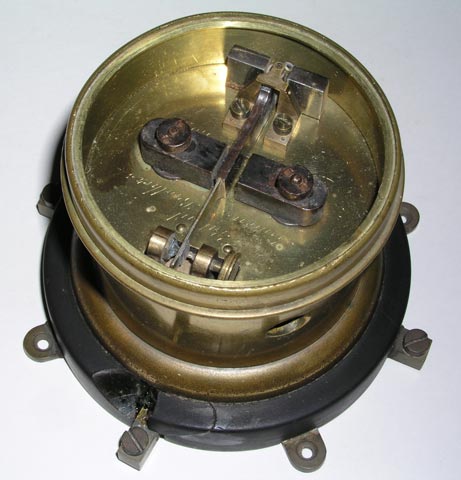
193 SUPER-SENSITIVE POLAR RELAY USED IN SUBMARINE
TELEGRAPH CABLE LINES:(70KB)The electrical signals on a submarine
telegraph cable were usually recorded on a moving paper tape and then
translated into letters by eye. This relay has the extremely high resistance
of 506 Ohms, making it sensitive enough to detect the very small voltage
changes in a submarine cable. In addition, it has numerous very fine
adjustments that allow it to be set to react to very weak signals such as
thouse received over very long cables. There is some engraved writing on the
top of the relay but I have been unable to read it because it is not engraved
deeply enough into the metal. This relay was located along with the
Elliott Brothers Submarine Telegraph Cable Key shown above and was probably
also made by Elliott Brothers.
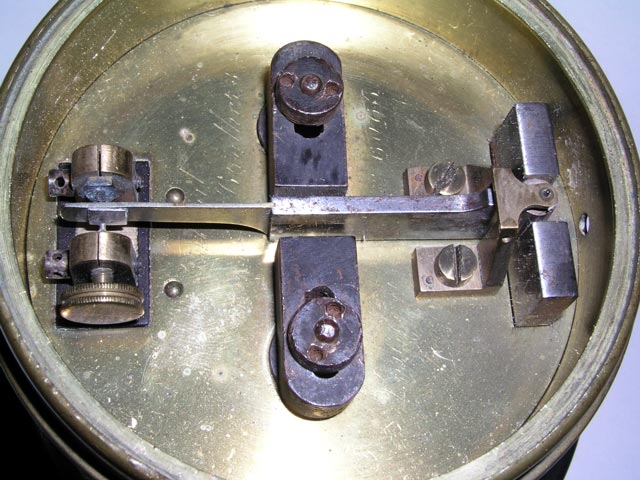
193a A close view of the contacts on the super-sensitive
submarine telegraph cable relay:(50KB)
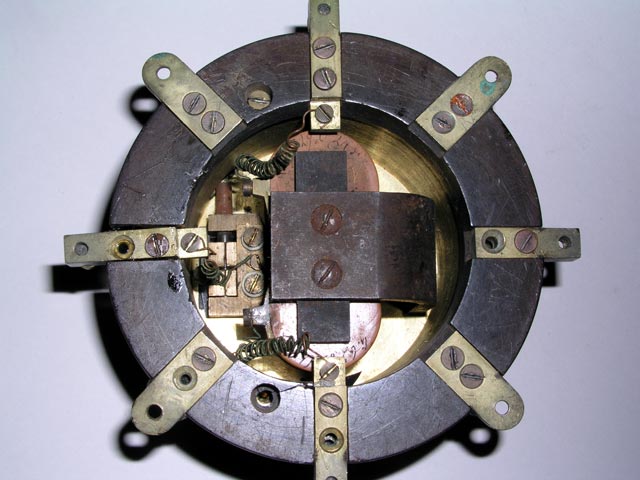
193b A close view of the sensitive magnets underneath the
submarine telegraph cable relay:(50KB)
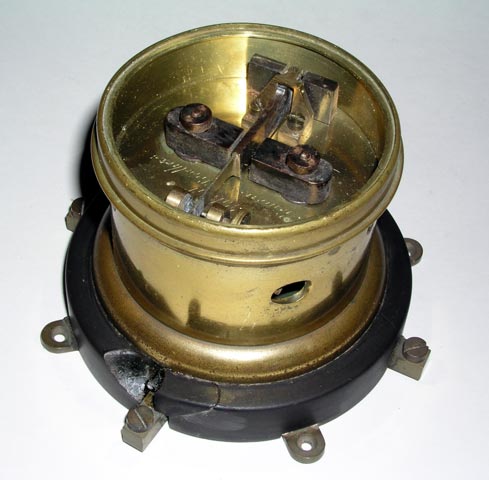
193c Another view of the submarine telegraph cable
relay:(50KB)
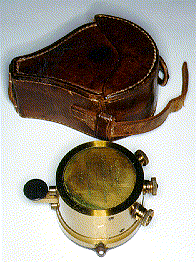
200 UNUSUAL ELLIOTT BROTHERS "UNIGRAPH"
POCKET KEY AND SOUNDER: (20KB)
This tiny set is carried in a small leather case. It consists of a
2 inch diameter brass cylinder 1-1/2 inch high. A tiny key protrudes
from the side.
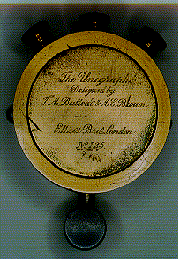
200a The circular disk (24KB) on the
top pivots forward to make a clicking sound when the
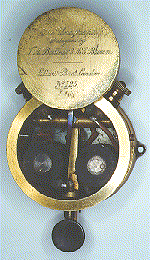
200b coils (22KB) are activated.
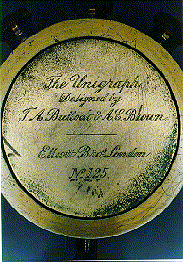
200c The top is engraved (30KB):
The "Unigraph" Designed by
T. A. Bullock and A. C. Brown Elliott Bros., London. No 125.

201 * UNUSUAL MINIATURE BRITISH STRAIGHT LEVER KEY: (13KB)
This miniature key was probably made by Elliott Brothers.
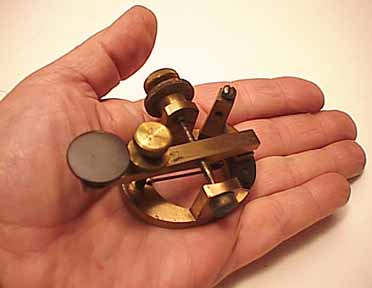
201a Closer view of the miniature British straight key:
(14KB)
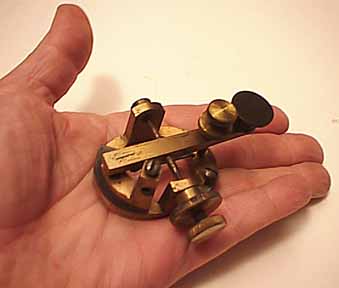
201b Another closer view of the miniature British
straight key: (12KB)

203 WESTERN ELECTRIC LINEMAN'S POCKET TEST SET:(27KB)
Similar to #205 but tiny camelback-style key has lever stamped
Western Electric Co. Chicago.
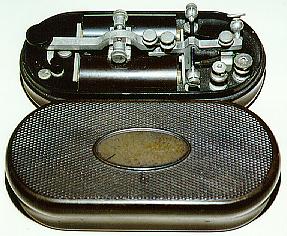
203a Another view of W.E. pocket set:(24KB)

205 TILLOTSON LINEMAN'S POCKET TEST SET:(50KB)
These hard-to-find sets were used by early linesmen and Civil War telegraph
operators and spies to carry to the top of telegraph poles & tap into the
telegraph lines for testing, espionage, and sending/receiving messages.
Consists of a lovely oval hard rubber case with engraved top 4-1/2" long by
2" wide. Inside is a tiny key with 1-1/2" lever and a sounder with sensitive
horizontally mounted coils.
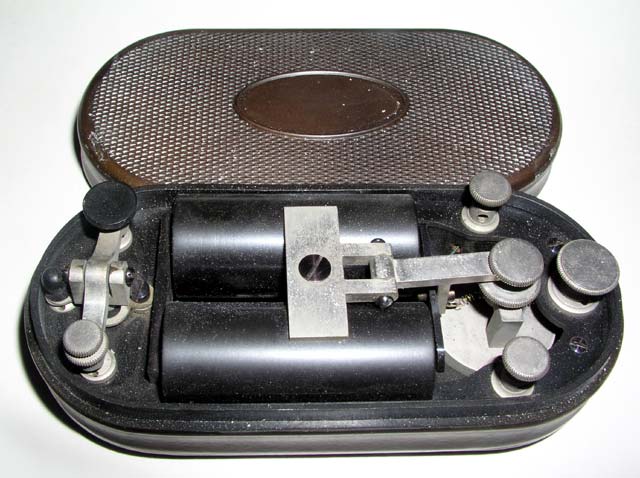
205a Another View of the Pocket Set:(53KB)
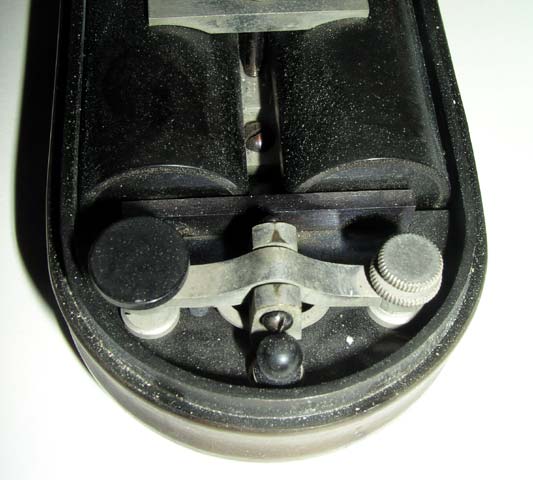
205b Key End View of the Pocket Set:(36KB)
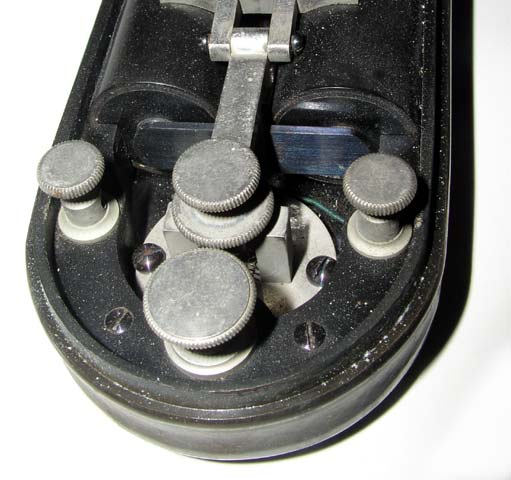
205c Sounder End View of the Pocket Set:(38KB)
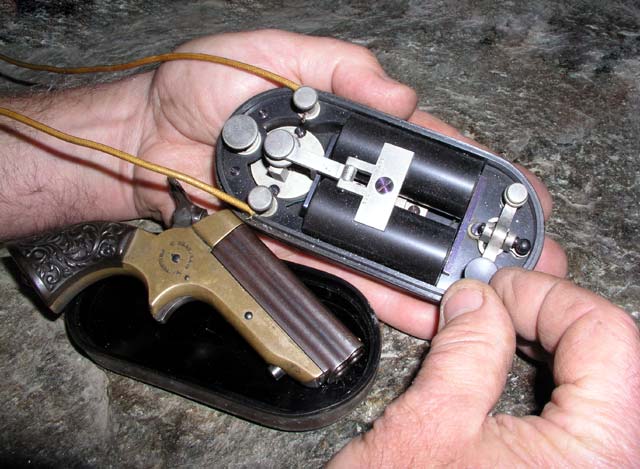
205d Pocket Set and Sharps 4-barrel pistol in Civil War
espionage setting:(56)
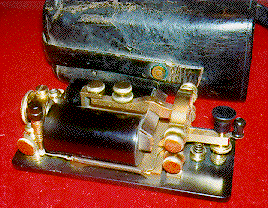
206 BUNNELL LINEMAN'S POCKET TEST SET:(34KB)
Tiny sounder integrated with tiny key on black base.

210 POSTAL TELEGRAPH COMPANY POCKET TEST
SET:(13KB) This very small set was made by The Postal Telegraph
Company and used by the military in the Spanish-American war and others.
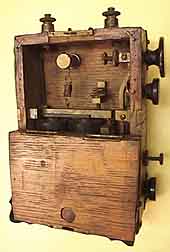
210a Opening the cover reveals the key
mechanism:(13KB) and the sounder armiture.
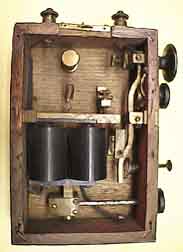
210b The removal of the entire front cover:(12KB)
shows the coils for the sounder and the "Skirrow patented"
rack-and-pinnion device that adjusts the coil-to-armiture distance.

212 COMPLETE PORTABLE WESTERN UNION TELEGRAPH
OFFICE:(17KB) This is a complete portable 1870's Telegraph office.
It is contained in a special box which serves as a desk and which can
be attached to a telegraph pole.
It was carried in a railroad car and used for emergency communications
along the railroad line. This is a very interesting set so I have included
many different views of it and it's components. Several views are
very similar to each other but have slightly different color balance.
As you can see, the set can be attached to any convenient telegraph
pole using a chain attached to the back of the cabinet.
It can be electrically hooked into any telegraph line using the
special connector called a 'Wrecking Clamp'. A blueprint shows the
wiring of many of the telegraph poles along the railroad line so the
telegraph operator can know which line to tap into.
The following views and descriptions should explain the operation
of this unusual set...
Very similar portable telegraph offices were carried in Fire Chiefs'
buggies in major city fire departments to allow communications during major
fires. A pole-mounted tent was often used to protect the equipment and
telegrapher from the elements in bad weather.
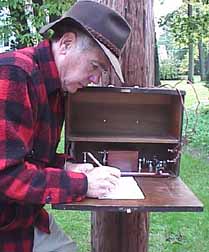
0212a A similar but slightly closer view of the set
with an operator:(18KB)
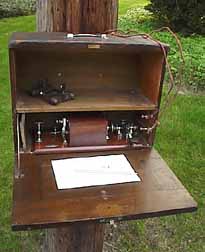
0212b A view of the front of the set without the
operator:(14KB)
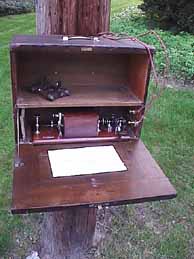
0212c A similar view of the front of the set without
the operator:(15KB)
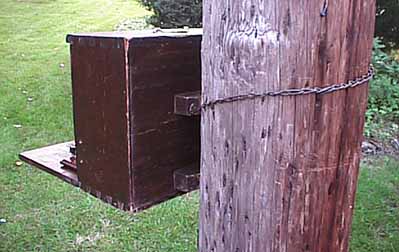
0212d A view of the back of the set showing how
it is chained to the telegraph pole:(23KB)
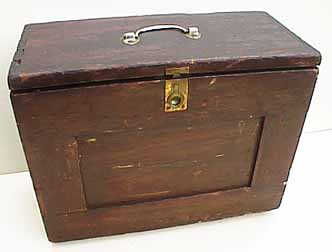
0212e A view of the front of the set with the
cover/desk closed:(11KB)
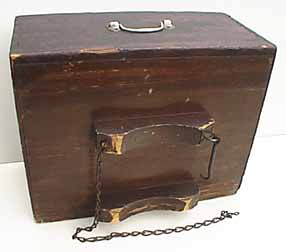
0212f A view of the back of the set showing the
wooden saddles and the chain for mounting the set to the telegraph pole:
(11KB)
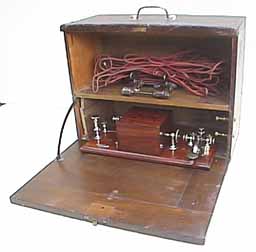
0212g A view of the front of the set with the cover/desk
open:(11KB)
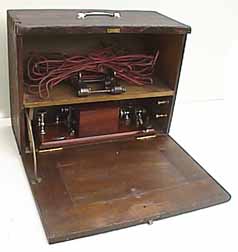
0212h A different view of the front of the set with the cover/desk
open:(11KB)
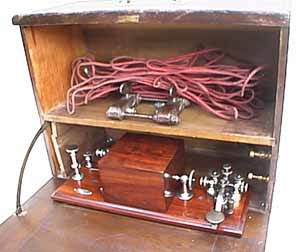
0212i A closer view of the front of the set with
the cover/desk open:(17KB)
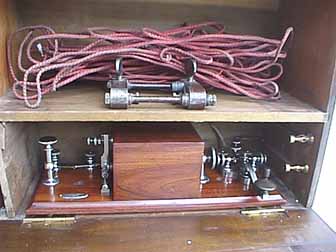
0212j A still closer view of the front of the set with
the cover/desk open:(19KB)
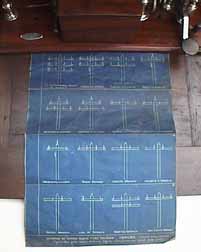
0212k A view of the blueprint showing the wiring of
the different telegraph poles along the various sections of track:
(10KB)
0212kl A MUCH higher resolution view of the blueprint:
NOTE This is a BIG, SLOW-LOADING 135KB file! :(135KB)
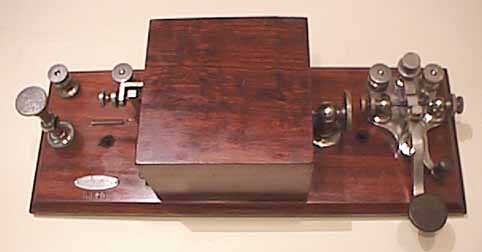
0212l The sensitive Western Union Box Relay
Key and Sounder with the magnificent Lewis key:(14KB)
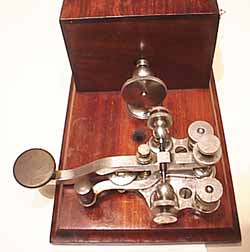
0212m The lovely Lewis telegraph key:(15KB)
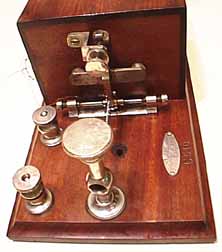
0212n The adjustments for the sensitive sounder
part of the instrument:(14KB)
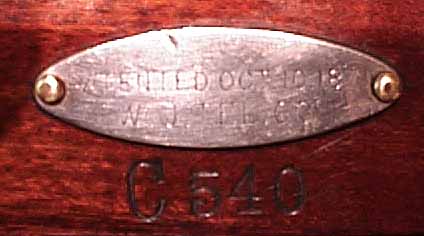
0212o The label on the telegraph set reads:
''PATENTED OCT. 12, 1871, W.U.TEL CO'' and number C540 is stamped
into the wood:(16KB)
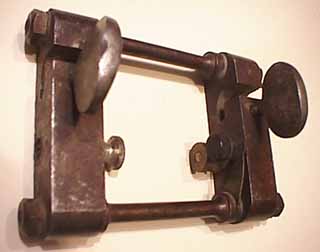
0212p The ''Wrecking Clamp''. This clamp was
tightened over a telegraph wire and then the wire was cut. The
terminals on the clamp allowed electrical connections to be made
to each of the severed ends and the switch on the clamp allowed
the two severed ends to be electrically reconnected:(12KB)
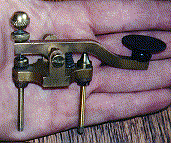
217 * VERY SMALL EARLY BRASS LEG KEY:(15KB)
A tiny brass leg key with heavy lever and pressed-in steel trunnion.

218 VERY SMALL EARLY NICKEL-PLATED BRASS LEG KEY:(43KB)
A tiny nickel-plated brass leg key with a heavy lever and a
pressed-in steel trunnion.
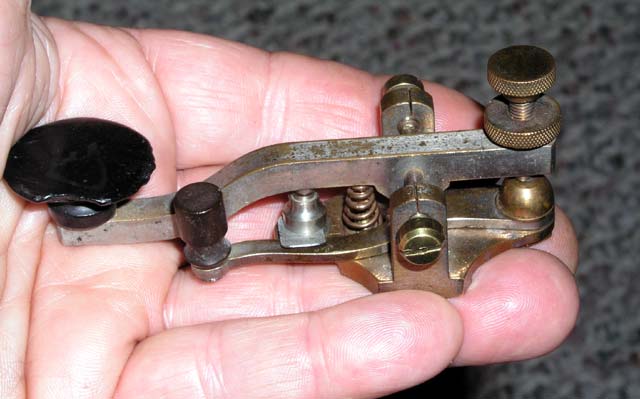
218a Another view of the tiny key:(33KB)
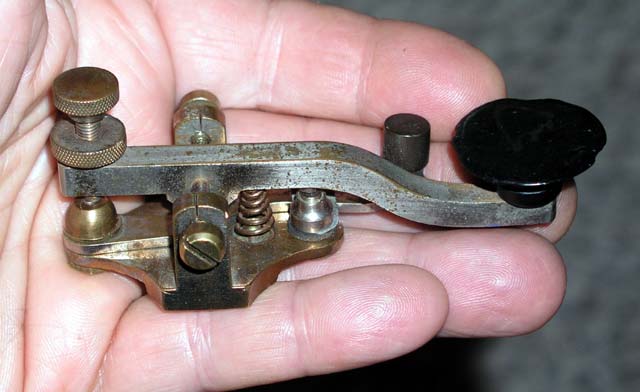
218b Another view of the tiny key:(32KB)
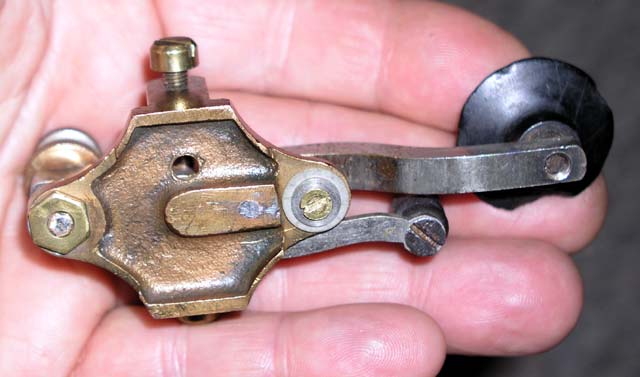
218c A view of bottom of the tiny key:(30KB)

215 Another similar tiny key:(16KB)
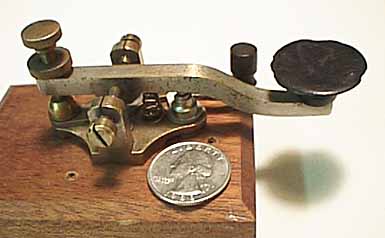
215a Another view of the tiny key:(16KB)

220 GRAY & BARTON LEG KEY:(24KB)
Lovely very early square brass lever bent down slightly toward knob
and stamped "GRAY & BARTON, CHICAGO". Trunnion is nicely machined
steel held in place by a setscrew. Very early design with no spring
adjusting screw (a refinement invented by Phelps in the 1860s). Short
brass shorting lever pivoted under trunnion. Cast brass base stamped
"828". 2 tapered SMOOTH brass legs extend down 2" & end in brass-screw
wire binding posts. ca. 1860s.
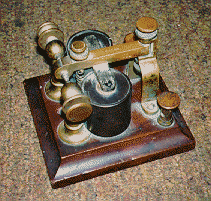
221 R. HENNING "MAKER" SOUNDER:(38KB)
Very early all brass sounder used with 220 above. armiture stamped
R.HENNING, MAKER on side & W.U.TEL.CO on top. Very early design.
221a * R. HENNING "MAKER" SOUNDER: As above. Traded to Roger Reinke.

222 Western Union / Grey & Barton Key:(24KB)
Same as 220 with Nickel-plated lever, unstamped,base stamped"416".
Spring adj screw. ca. 1860s.
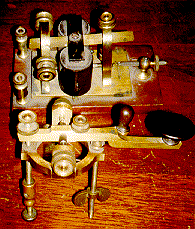
223 * JAMES PARTRICK BRASS KEY AND SOUNDER:(24KB)
Lovely and delicate all brass key similar in design to #110 with
matching sounder >K9WDY
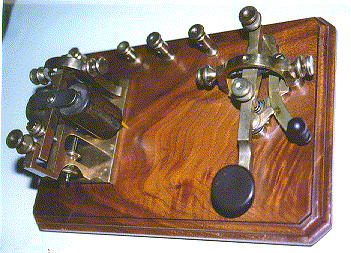
224 PARTRICK & CARTER "ARCH" KEY & SOUNDER:(47KB)
This large set has an extremely unusual
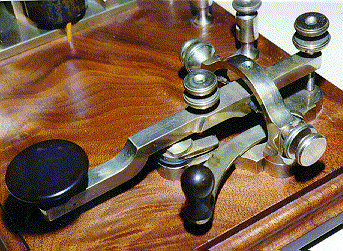
224a Partrick & Carter step-lever
key with a lovely brass arch over the
trunnion:(55KB).
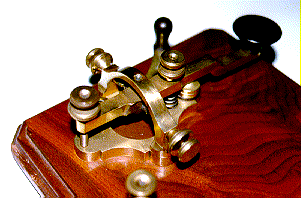
224b This view shows the front of the key:(22KB)
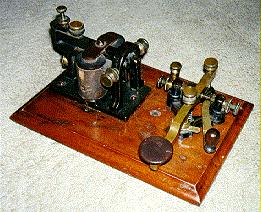
225 BRASS STEP-LEVER KEY & SOUNDER ON WOODEN BASE:(32KB)
Masive brass lever key with steel shaft, japanned base, and early
step-down lever design on wooden base with Black Japanned base sounder
with gold lettering "PATENTED FERY 16,1875".
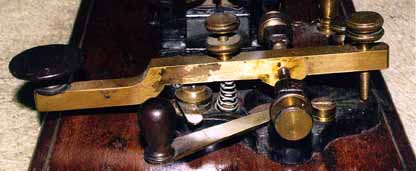
225a CLOSE-UP OF BRASS STEP-LEVER KEY:(16KB)
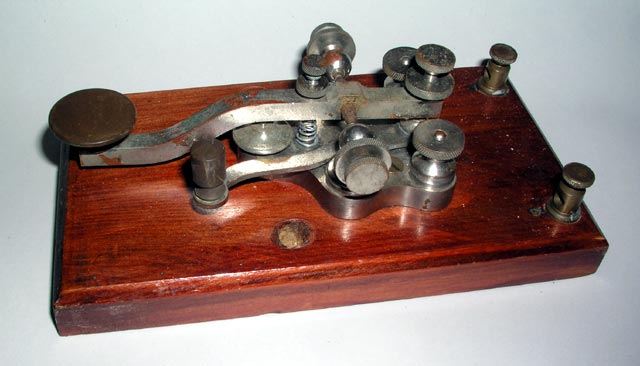
227 CLASSIC LEWIS PATENT KEY: (36KB)
This is one of the more frequently seen versions of the Lewis Key
which is the only key that was granted a patent exclusively based on
the beautiful design of the key rather than any innovative electrical
or mechanical attributes.
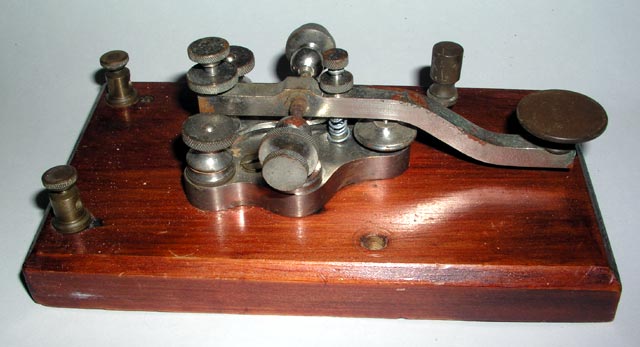
227a Another view of the LEWIS KEY: (36KB)
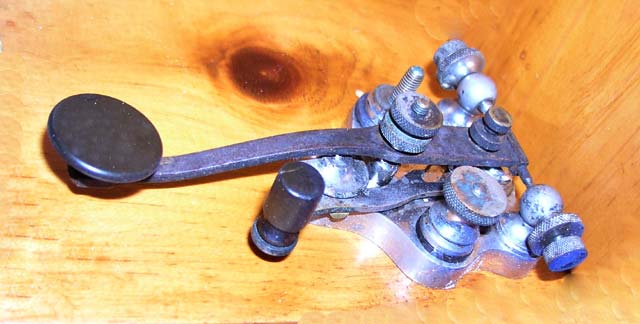
228 VERY UNUSUAL FLAT-LEVER LEWIS PATENT KEY: (33KB)
This is one of the most unusual Lewis keys. It has a flat steel lever
instead of a nickel-plated brass lever and the pivot points are at the
far end of the lever.
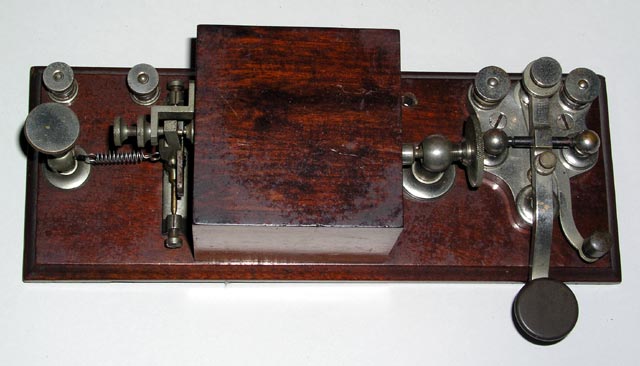
229 MINIATURE LEWIS KEY BOX RELAY/SOUNDER: (38KB)
This is an unusually small so-called box relay with a boxed sounder/relay and a
lewis key on a wooden base. It is not clear why it was made in such a small
size.
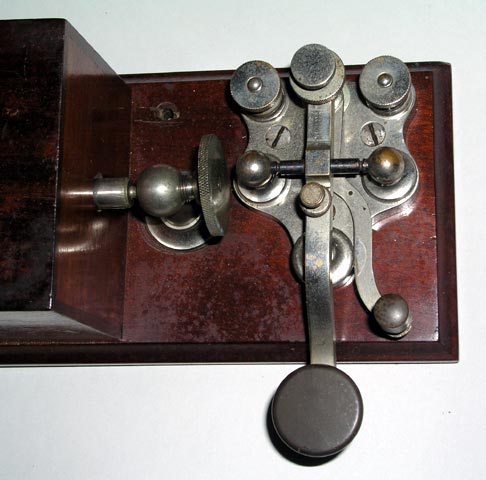
229a A closer view of the key: (37KB)
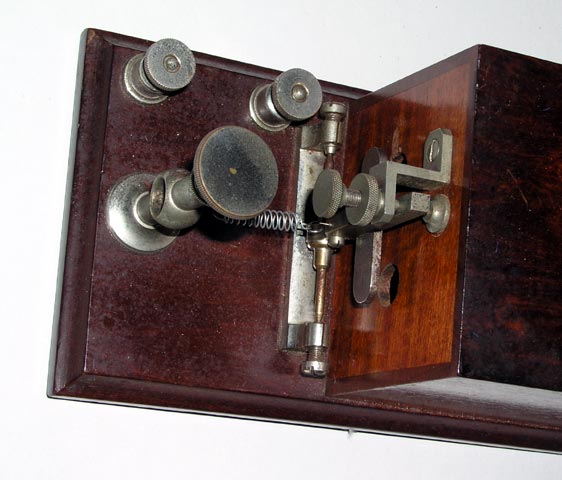
229b A closer view of the relay/sounder: (44KB)

230 LEWIS / WESTERN UNION TELEGRAPH SET:(25KB)
This unusual set consists of a lovely brass LEWIS key mounted
perpendicularly across a 12inch long wooden base which is mounted on a
gold pin striped black cast iron base. To the left of the LEWIS key is
an unusual sounder and to the right of the LEWIS key is a line relay
of unusual design. The adjusting string/spring for the relay passes
over the top of the LEWIS key from right to left to an adjusting knob.
The relay is engraved W.U. TEL. CO. on the brass base and OHMS 153 on
one brown coil cover. The key is engraved "LEWIS PAT May 25, 1875 May
23, 1876 on top of the lever and "W. E. MFG. CO. CHICAGO" on the side
of the lever. Bottom of base signed in ink: J.F. Putnam, July 10/80.
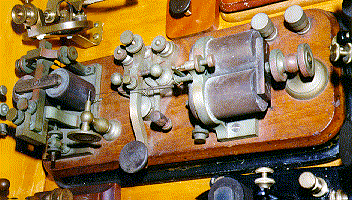
230a Another View of the Lewis/WU Set:(47KB)
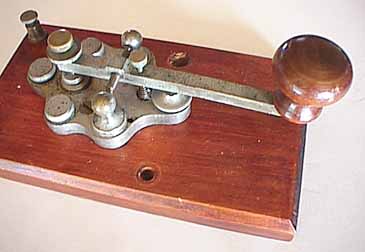
232 EXTREMELY UNUSUAL STRAIGHT LEVER FLAT TERMINAL LEWIS
KEY:(16KB) This is the strangest Lewis Key that I have ever seen.
The lever is nearly straight which is unusual for Lewis keys but
the most unusual aspect of the key is the three flat-topped terminals
which, as you can see from the underside view connect to the
normally open, normally closed, and frame of the key.
There is no way to connect wires to these terminals directly so
I can only assume that the key was slid into some sort of spring
loaded contact assembly. I have included several different views
of the key.
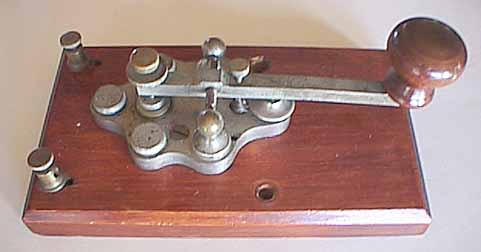
232a Another view of the Flat Terminal Lewis
Key:(15KB)
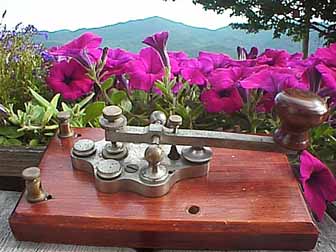
232b Another view of the Flat Terminal Lewis
Key:(25KB)
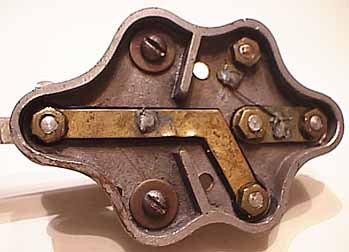
232c A view of the bottom electrical connections
of the Flat Terminal Lewis Key:(18KB)
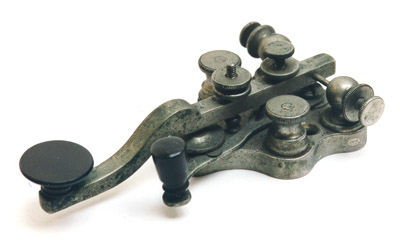
233 ** EXTREMELY UNUSUAL LEWIS CAMELBACK
KEY:(21KB) This is a very unusual Lewis patent key with a
camelback lever. Most Lewis keys have a gently sloping lever
which paved the way for virtually all subsequent key designs.
This key is owned by collector: Gray Marshall KQ6MW..
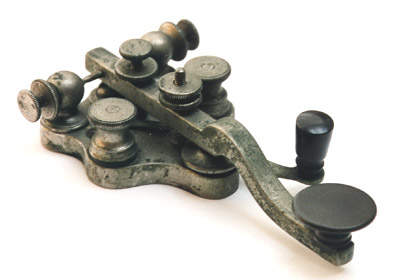
233a * ANOTHER VIEW OF THE CAMELBACK LEWIS
KEY:(21KB)
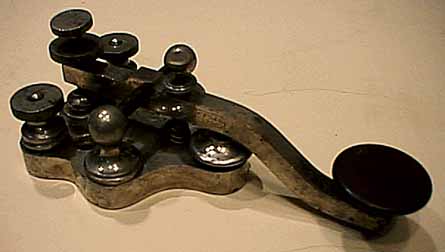
234 LEWIS KEY: (15KB)
This is one of the more frequently seen versions of the Lewis Key.
It is described more fully in the write-up of the key below.
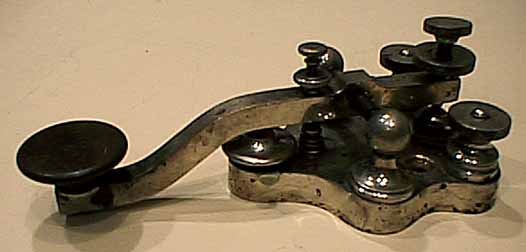
234a Another view of the LEWIS KEY: (16KB)
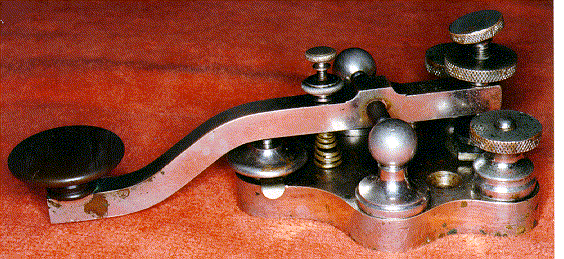
235 LEWIS KEY: (78KB)
This all-plated Lewis key is an example of the early Lewis designs
which did not include adjustments for side-play in the trunnion. The
Lewis key patents referred to the unique and ornate design of the key rather
than any distinguishing mechanical attributes. Stamped: LEWIS PAT.
May 25, 1875, May 23, 1876 on top of lever and W.E.MFG CO. Chicago on
side of lever..
ROTATING VIEW OF #235 LEWIS KEY: (202KB)
This is a VERY LARGE FILE that takes a long time to load but
it results in a view of a rotating Lewis Key. It is an experiment
to see whether it would be a practical way to show many sides
of the same key.
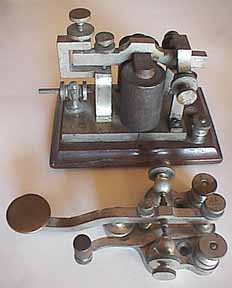
236 RAILROAD LEWIS KEY AND LEWIS CAMELBACK
SOUNDER:(14KB) This is a classic Lewis Key with an unusual
Lewis Camelback Sounder. The Key and Sounder were apparently
used on the railroad because each is marked NPRR. The key is marked
J-165 and the Sounder is marked J-166. I have included several
different views of the set.
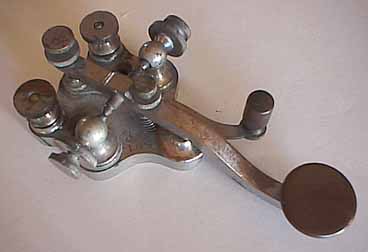
236a A closer view of the Lewis Key:(11KB)
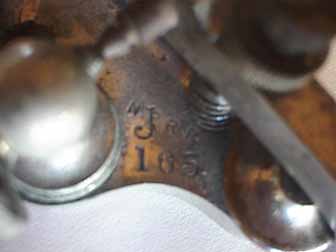
236b A closer view of the markings on the
Lewis Key:(9KB)
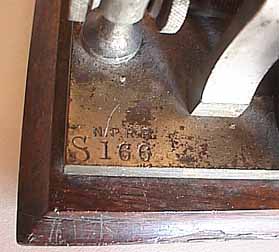
236c A closer view of the markings on the3
Camelback Lewis Sounder:(18KB)
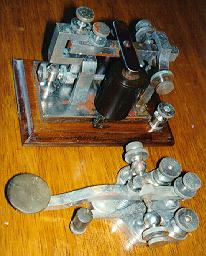
237 LEWIS KEY AND SOUNDER:(16KB)
Lewis key like 0235 with hard-to-find Lewis sounder.
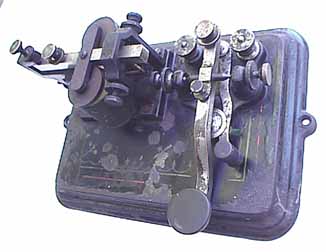
238 * LEWIS KEY AND SOUNDER 'PRIVATE LINE' CAST-BASE KOB
:(16KB) This Lewis Key and Sounder have their bases cast into
the cast iron base of this 'private line set'. Private line sets such
as this were used in private residences and in businesses to
communicate within the bruiding. (Same as item 275.)
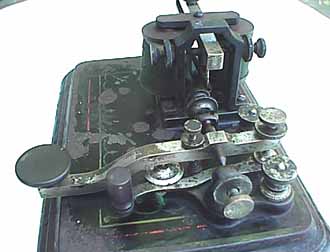
238a Closer view of the cast-base Lewis
Key:(16KB)
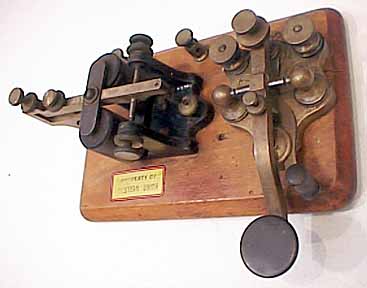
239 LEWIS KEY KOB:(17KB) This is an
all brass Lewis Key mounted on a wooden base with an early
horizontal spring sounder.
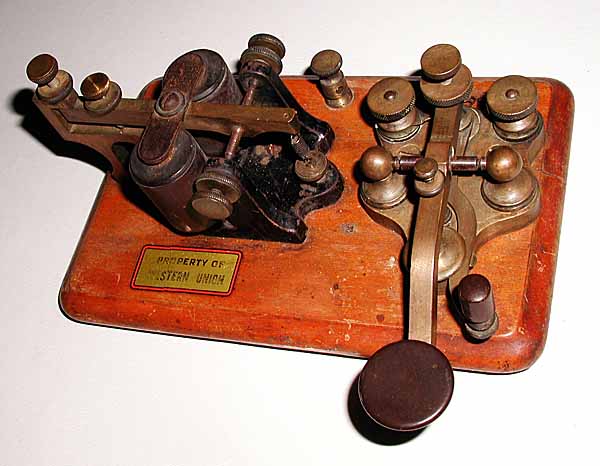
239a Another View of the LEWIS KEY KOB:(41KB)
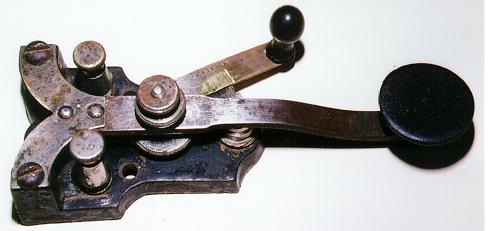
240 EARLY LYMAN PATENT KEY: (19KB)
This key shows the unique Lyman patent design with the lever suspended by a
"y" shaped piece of spring steel.
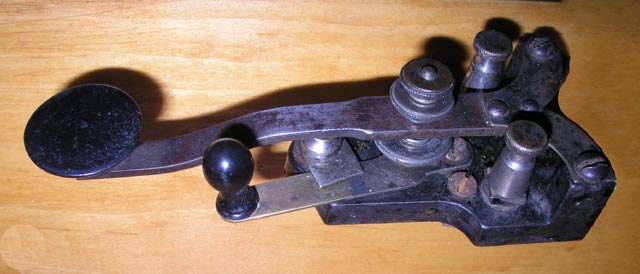
240a Another view of the EARLY LYMAN KEY: (19KB)
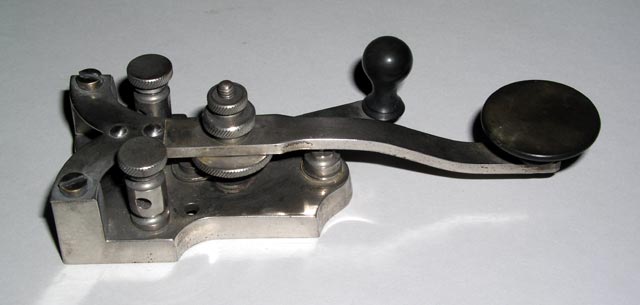
240e UNUSUAL AND EARLY NICKEL PLATED LYMAN PATENT
KEY:(26KB)
This is the first Nickel plated Lyman key that I have seen. It shows the
unique Lyman patent design with the lever suspended by a "y" shaped piece of
spring steel.
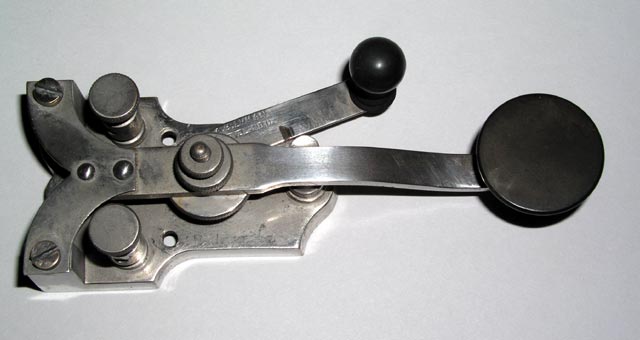
240f Another view of the Nickel Plated Lyman
Key:(28KB)
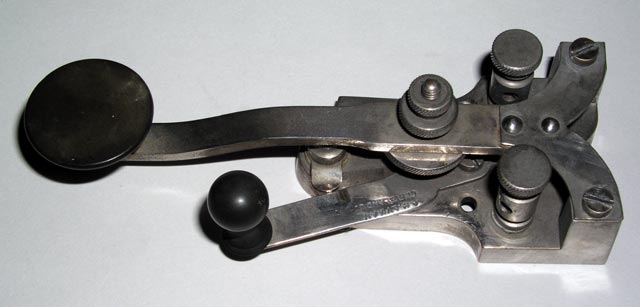
240g Another view of the Nickel Plated Lyman
Key:(30KB)
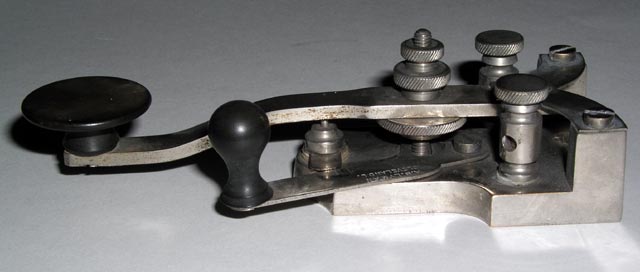
240h Another view of the Nickel Plated Lyman
Key:(25KB)
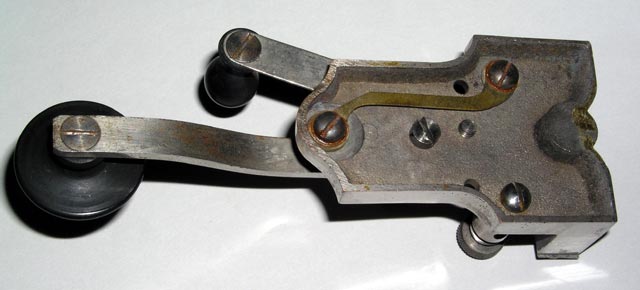
240i A view of the bottom of the Nickel Plated Lyman
Key:(31KB)
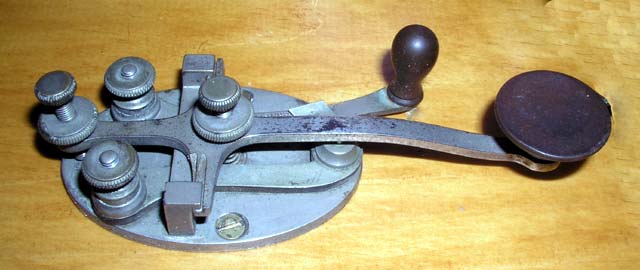
241 EARLY NICKEL-PLATED VICTOR PATENT LEGLESS KEY:(27KB)
This lovely nickel-plated brass key shows the "Victor patent" knife-edge
bearings. Rather than using a pinnion shaft, the key pivots on a knife-
edge.
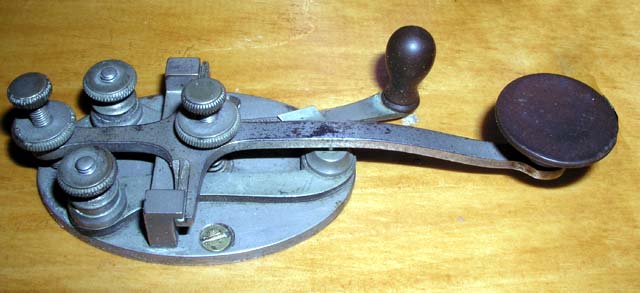
241a A slightly different view of the Victor
Key:(30KB)
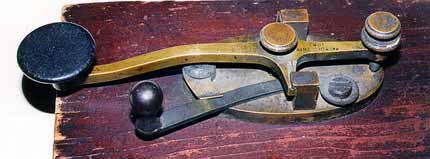
243 * VICTOR PATENT LEG KEY:(17KB)
This lovely brass key shows the "Victor patent" knife-edge bearings.
Rather than a pinnion shaft, the key pivots on a knife-edge.
The legs attach the key to the operating table and also
provide connections for the electrical wires.
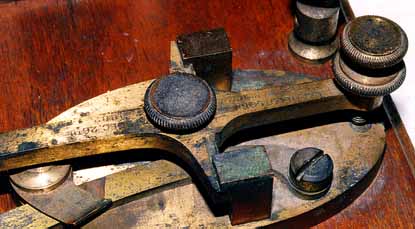
243a Close-up view of Knife-edge pivot:(24KB)
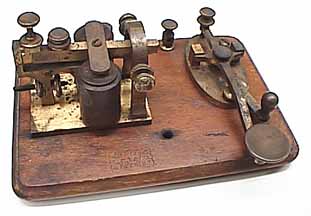
245 * TILLOTSON KOB WITH TILLOTSON-VICTOR KEY:(17KB)
This lovely brass key shows the "Victor patent" knife-edge bearings.
It is stamped: Pats Dec 26, 1882. Both are stamped: L.G.Tillotson,
5 & 7 Dey St. New York. The base is stamped:
20 Ohms, L.C.T. & co. 8 Dey St.,N.Y.
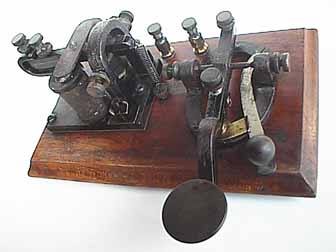
248 * TILLOTSON CAMELBACK KOB:(15KB)
This is a nice example of a Tillotson Camelback KOB.
I have included several different views of the set.
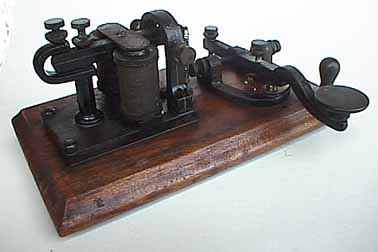
248a Another view of the Tillotson Camelback
KOB:(15KB)
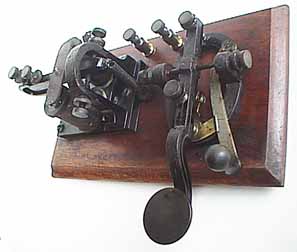
248b Another view of the Tillotson Camelback
KOB:(14KB)
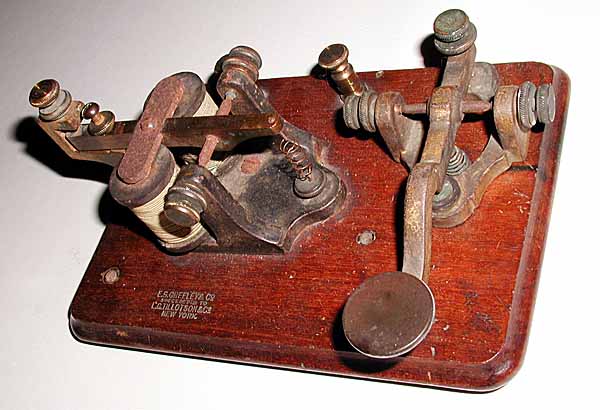
250 GREELEY / TILLOTSON CAST-LEVER CAMELBACK KOB:(43KB)
'KOB' stands for 'Key (and sounder) on base'.
Gold-painted early camelback key with cast iron lever, shorting switch
& matching sounder on wooden base which is engraved E.S.GREELEY & Co.
Successors to L.G.TILLOTSON & Co. New York.
Too early for spring adjusting screws.
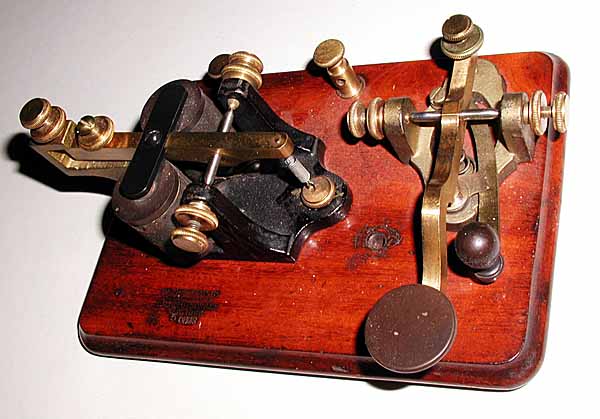
250aa GREELEY / TILLOTSON BRASS-LEVER CAMELBACK
KOB:(41KB)Early camelback key with brass lever, shorting switch
& matching sounder on wooden base which is engraved E.S.GREELEY & Co.
Successors to L.G.TILLOTSON & Co. New York.
Too early for spring adjusting screws.
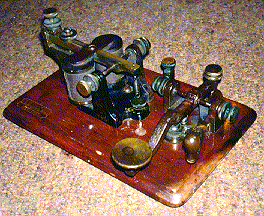
251 * BUNNELL CAST-LEVER CAMELBACK KOB:(40KB)
Made by Bunnell around 1860s. Cast-Iron Lever Camelback Key originally
painted gold to look like brass. Like number 250 above on unmarked base.

252a * BUNNELL CAST-LEVER CAMELBACK KOB:(27KB)
As above on base stamped 20 ohms. J. H. Bunnell.
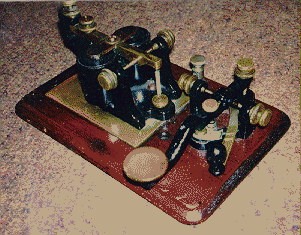
254 BUNNELL CAMELBACK KOB:(42KB)
Made by Bunnell around 1860s. Like 252a above with black-painted
camelback key mounted on unmarked base. The
sounder is mounted on a large thin brass plate. An interesting
spring-adjusting screw was added by a railroad operator in 1945.
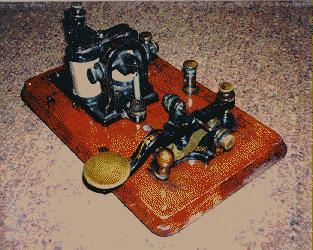
259 * MINIATURE CAMELBACK KOB:(50KB)
About 3/4 size mini cast-iron-lever camelback key & small sounder on
wooden base. No identification but all painted black with fine gold
flower patterns on key & sounder.Too early for spring adj screw.
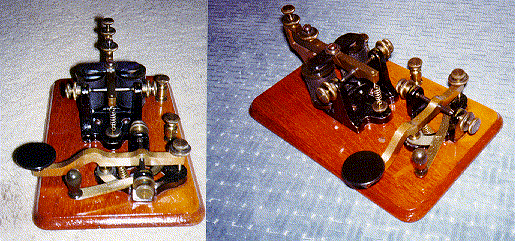
260 BUNNELL BRASS-LEVER CAMELBACK KOB:(73KB)
Early brass lever camelback key with steel trunnion and shorting
switch and black and gold painted sounder on wood base stamped
20 Ohms, J.H.Bunnell & Co., New York.
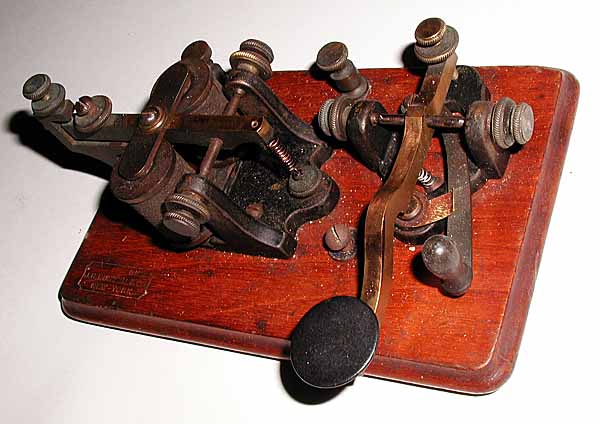
260aa BUNNELL BRASS-LEVER CAMELBACK KOB:(43KB)
Similar to 260 above:
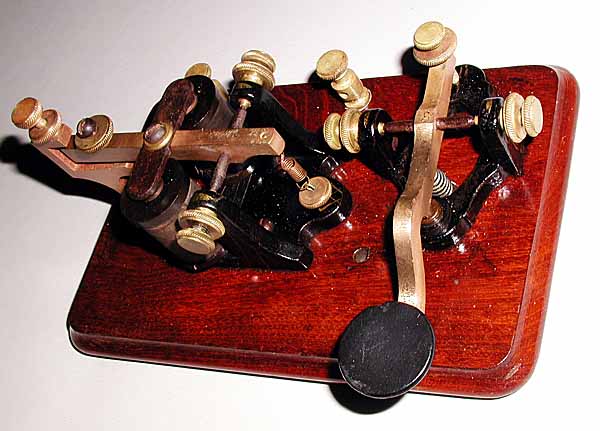
261 BUNNELL BRASS-LEVER CAMELBACK KOB:(44KB)
Early brass lever camelback key with steel trunnion and shorting
switch and black and gold painted sounder on unmarked wood base.
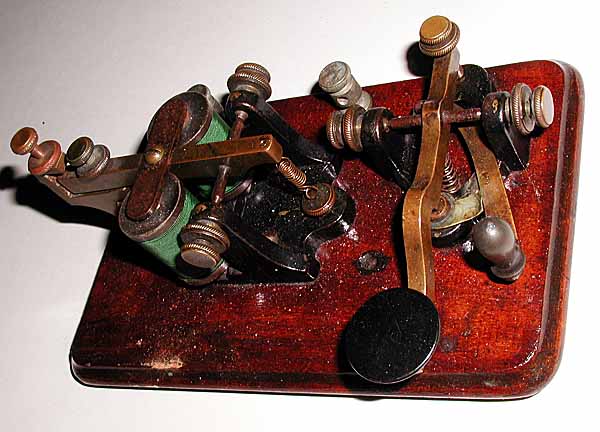
261aa * Another BUNNELL BRASS-LEVER CAMELBACK KOB:(47KB)
Similar to above. This key is now on display in the National Cryptological
Museum of the NSA in Baltimore, MD.:
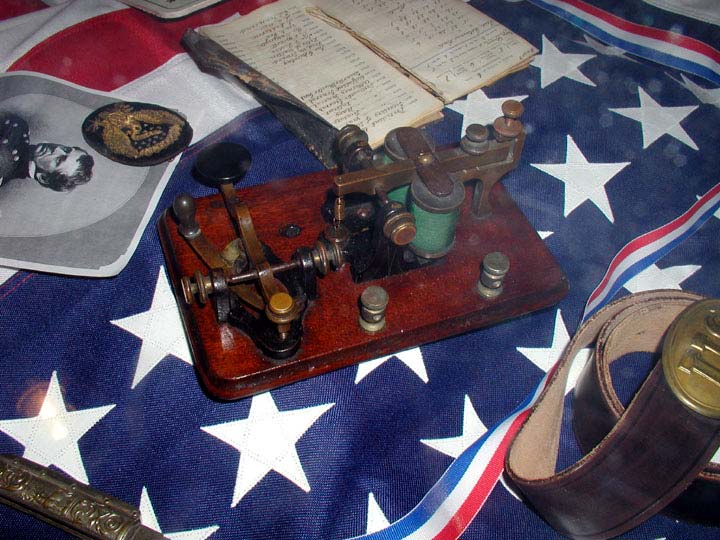
261b * The Bunnell Brass-Lever Camelback KOB as it
appears in the NSA National Cryptological Museum:(80KB)
262 * REDDING BRASS-LEVER CAMELBACK KEY KOB with brass-Lever key, on a
cast iron oval base frame with a shorting switch. Key has spring
adjusting screw. Mounted on wooden base which is engraved
JEROME REDDING & Co BOSTON, MASS - 4 ohms Pat
April 3D '77. Small piece of base back missing.>>W2PM
264 * REDDING BRASS-LEVER CAMELBACK KEY KOB. As above.
No patent date or shorting switch.
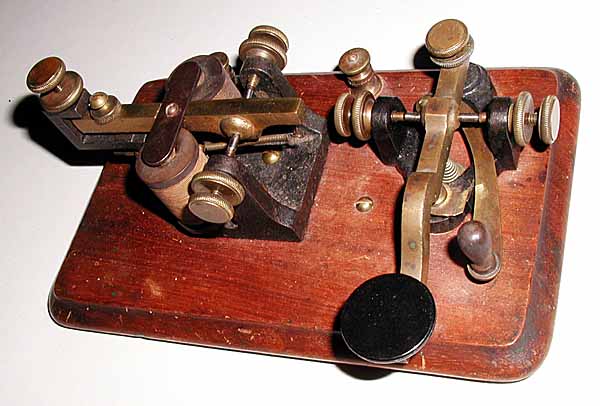
266 EARLY UNKNOWN BRASS-LEVER CAMELBACK-KEY KOB:(41KB)
Brass-lever camelback key with steel trunnion shaft, no spring adjusting screw,
& brass shorting lever. All cast iron sounder. Both key and sounder have
unusual bulges where trunnion shafts pass through. This is probably
a Redding as above.
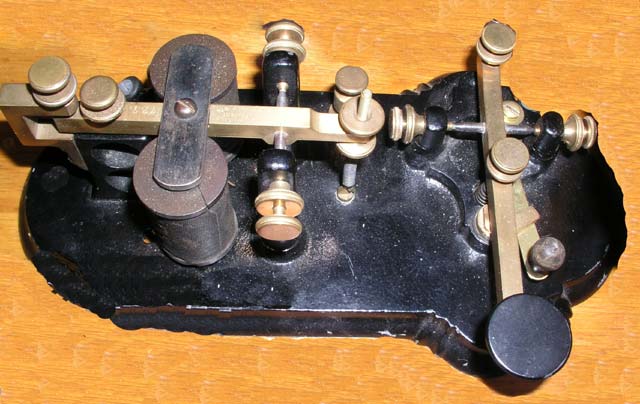
270 EARLY CAST-BASE TILLOTSON STRAIGHT-LEVER KEY
PRIVATE-LINE KOB:(47KB)This private line KOB has a brass Key with
a straight brass lever, steel trunnion shaft, spring adjusting
screw, and brass shorting lever. The base is very heavy cast iron with
a sounder stamped "BUNNELLS PATENT JULY 1874 No737" on the heavy brass
armiture. These sets were often used in private residences in the 1870's.
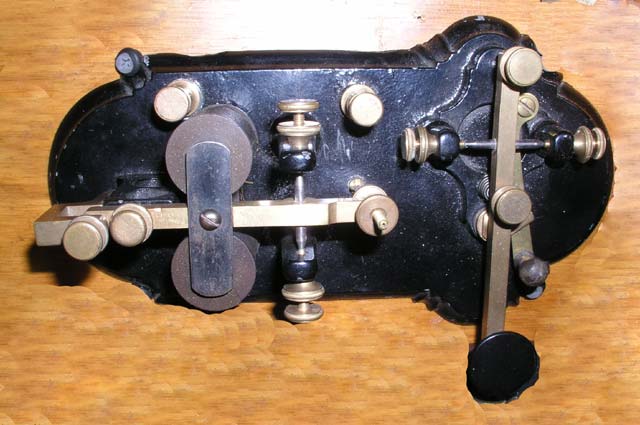
270a Another view of the Private Line KOB:(44KB)
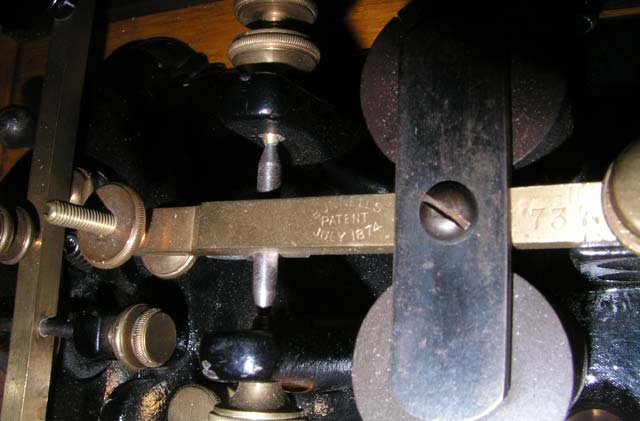
270b A closer view of the Bunnell Patent
notice:(35KB)
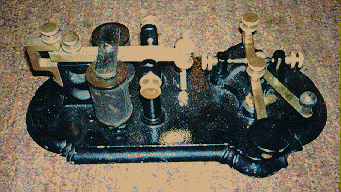
270.gif Another view of the Private Line KOB:(53KB)
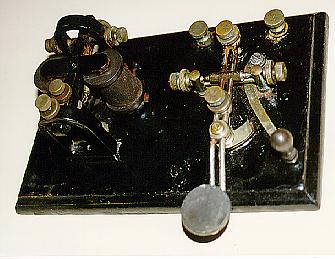
271 * CAST-BASE WESTERN ELECTRIC PRIVATE-LINE KOB:(23KB>
Black cast-iron base with the Western Electric key that has two
parallel rods as its lever.

271#2 CAST-BASE WESTERN ELECTRIC PRIVATE-LINE
KOB:(20KB)Identical to number 271.

272 VERY EARLY L.G.TILLOTSON ALL
BRASS KEY AND "APRIL-FOOL" SOUNDER KOB:(59KB)
The key is a straight brass lever stamped L.G.TILLOTSON, 8 Dey St.,
New York. with no spring adjusting screw and a steel trunnion The
sounder has two coils in line from front to back but the armiture is
pivoted at the top center of one of the coils which can't possibly
make any contribution to the operation of the sounder. (Did they not
know this?) Sounder armiture stamped Patent App'd For. Wooden base
stamped 6 Ohms, L.G.T. & Co. 8 Dey St. N.Y. Patented June 24, 1873.
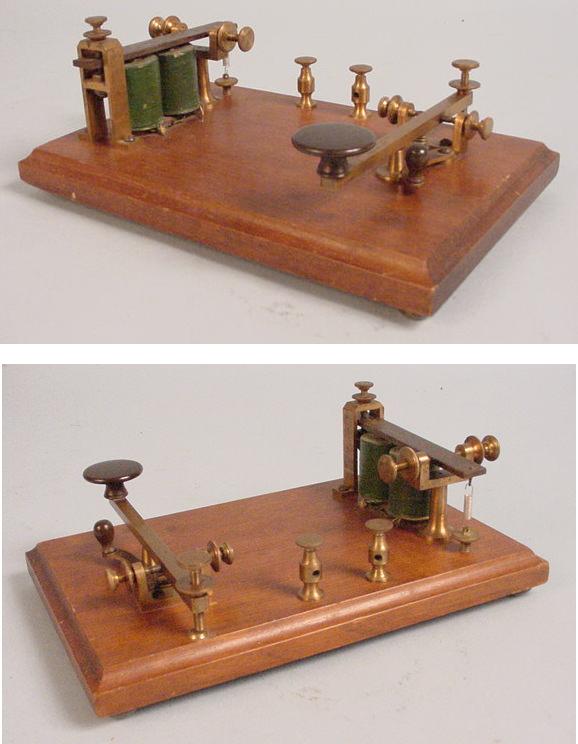
273 ** VERY EARLY L.G.TILLOTSON ALL
BRASS KEY AND REDESIGNED SOUNDER KOB:(46KB)This
set appears to have been designed after Tillotson realized
the error in the design of the ''April-Fool'' sounder shown
above in item 272. The sounder now has both of the magnet coils
pulling on the armiture. This set is labeled BLISS TILLOTSON and
a pencilled-in address on the bottom shows that it was manufactured
at 54 South 4th Street in Philadelphia where the company moved
in 1874 which was the year after the above set was patented.
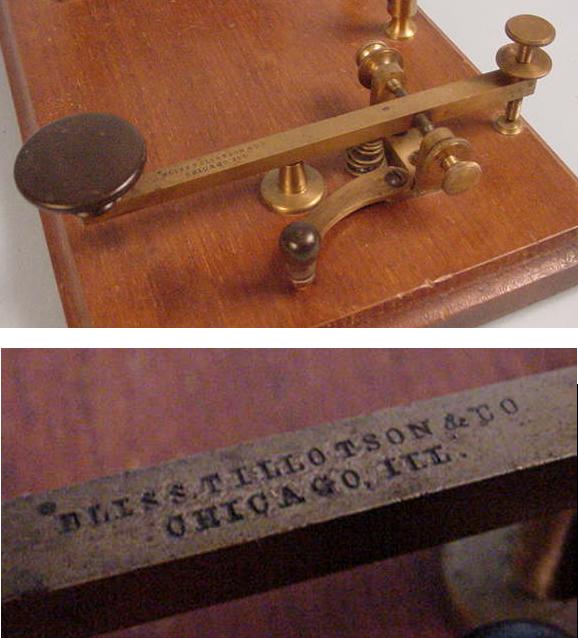
273a ** Closer views of the key and
name:(51KB)
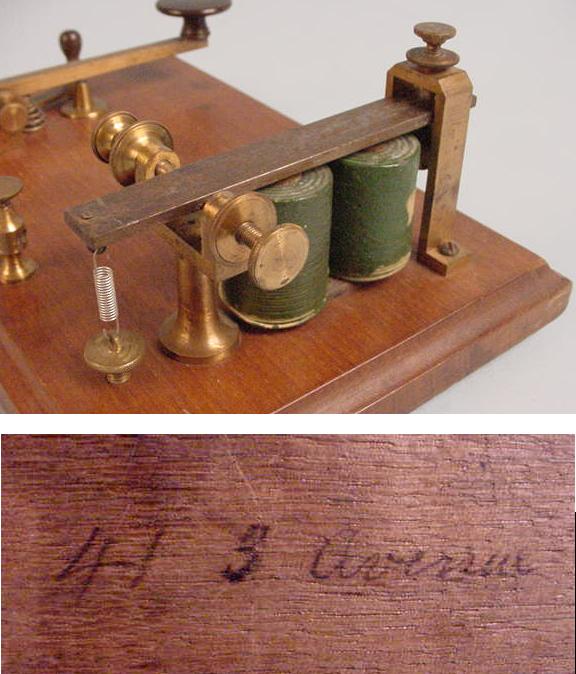
273b ** Closer view of the sounder and
address:(60KB)
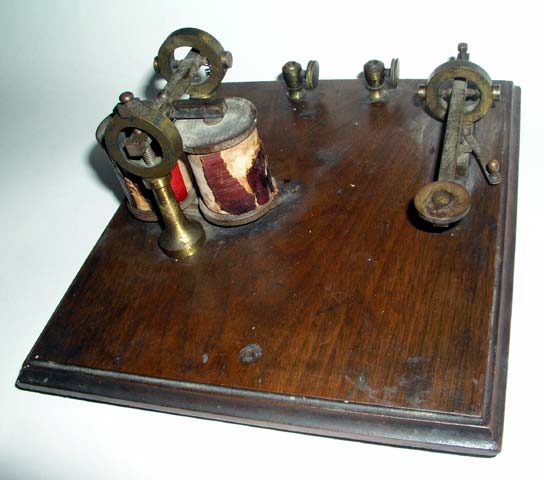
274 UNUSUAL ROUND TRUNNION FRAME KOB:(34KB)
This is a very unusual early KOB with both the sounder and
the key frame designed as circles. The maker is not known.
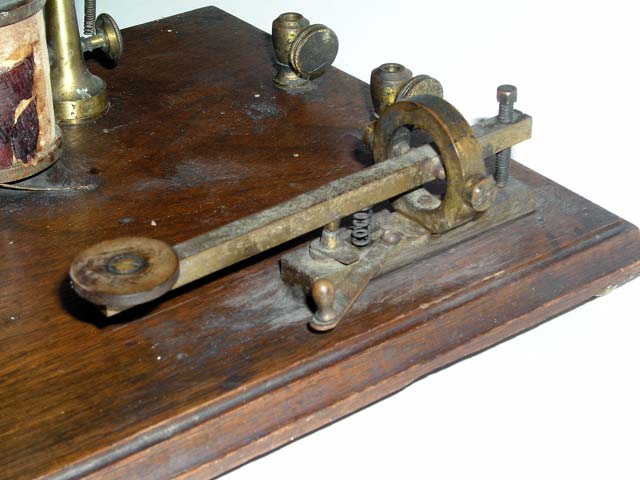
274a A Close view of the tiny key:(44KB)
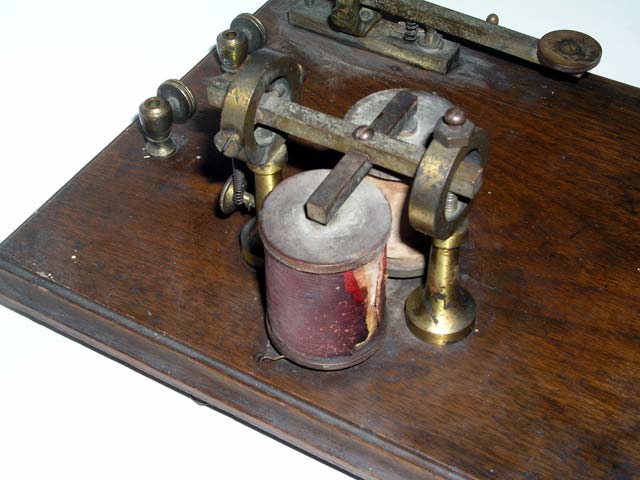
274b A Close view of the sounder:(45KB)
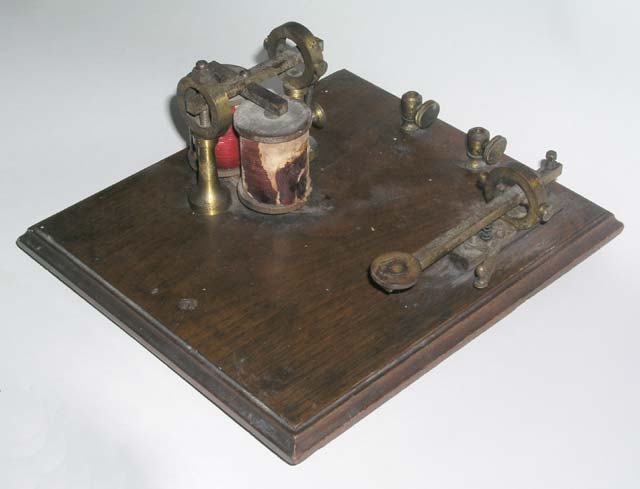
274c Another view of the KOB:(27KB)
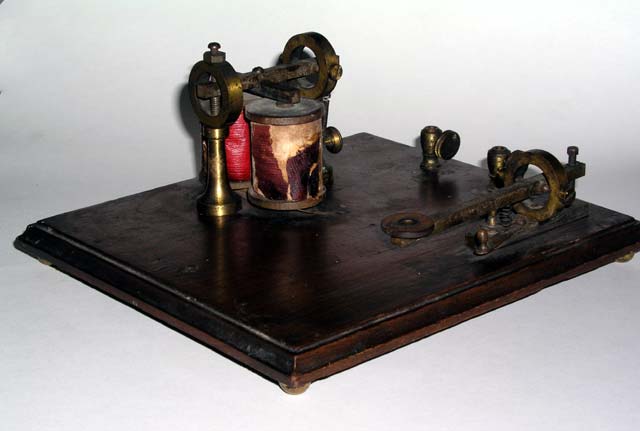
274d Another view of the KOB:(27KB)
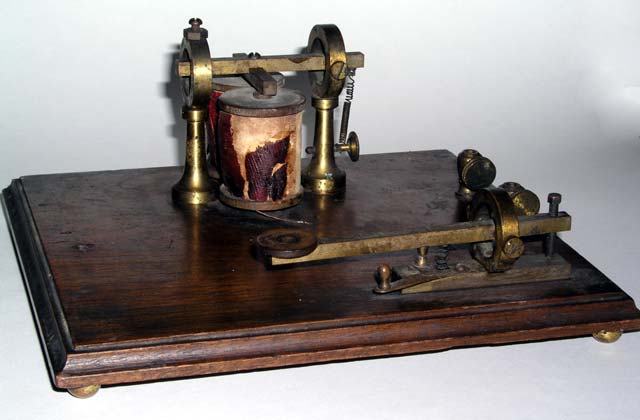
274e Another view of the KOB:(33KB)
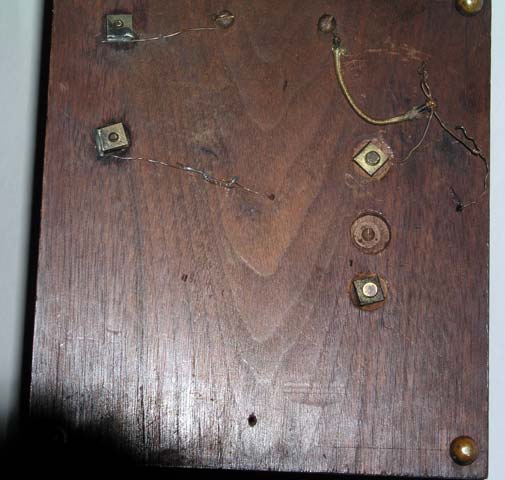
274f A View of the underside of the base:(39KB)
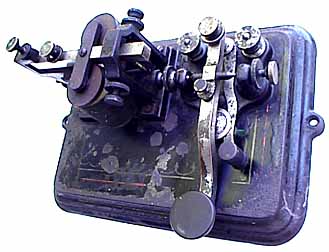
275 * CAST-BASE LEWIS KEY PRIVATE-LINE KOB:(21KB)
This set has a Lewis-patent key and a Lewis sounder with their bases
cast as integral parts of the large cast iron base. The lever of the
key is stamped: Lewis Pat. May 28, 1875, May 26, 1876 on top and
Western Electric Co. Chicago on the side. (Same as item 238.).
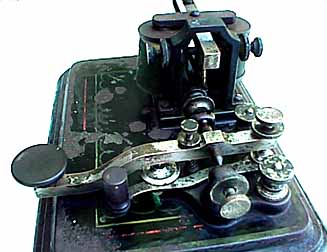
275a Closer view of Lewis Key:(21KB)
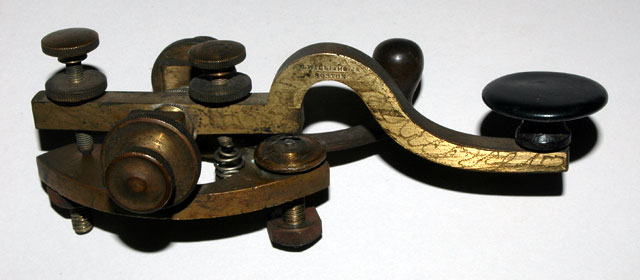
278 * VERY EARLY CHARLES WILLIAMS (Boston)
CAMELBACK KEY: This is a fine example of the camelback keys made
by Charles Williams in Boston. This camelback key was probably made after
the next two Williams keys.
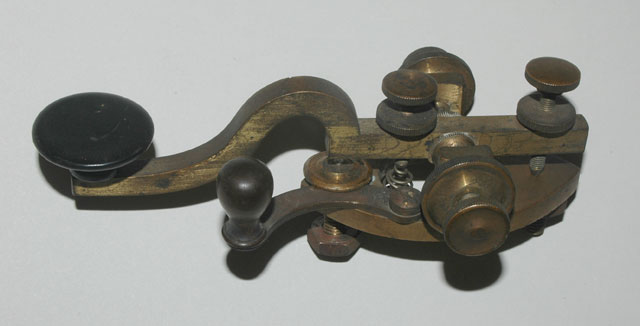
278a * The other side of the Williams key:
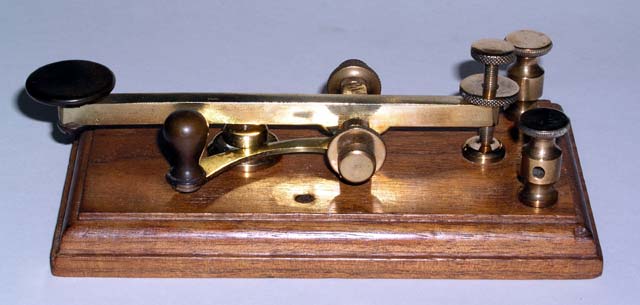
279 VERY EARLY CHARLES WILLIAMS (Boston) KEY:(30KB)
Early brass straight lever key mounted on a wooden base with the Williams
name stamped into the base.
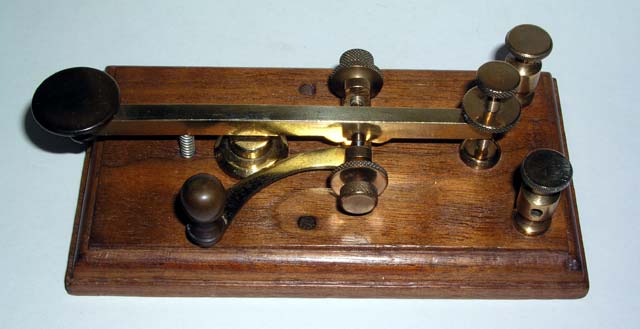
279a Another View of the Williams Key:(29KB)
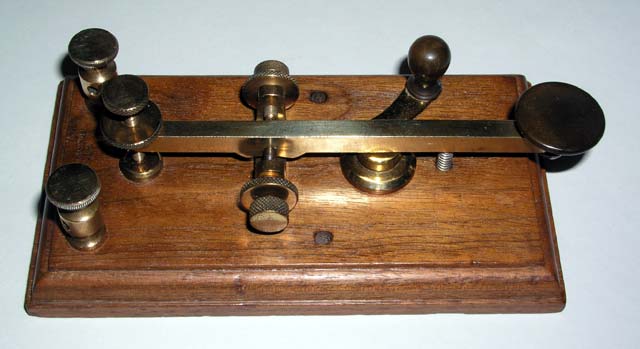
279b Another View of the Williams Key:(32KB)
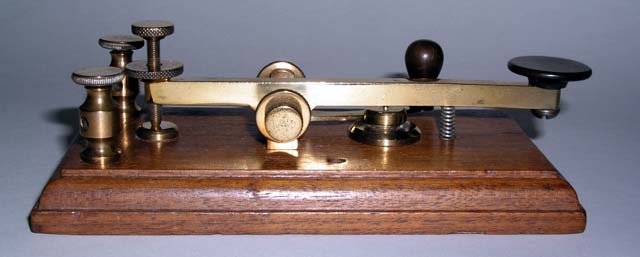
279c Another View of the Williams Key:(23KB)
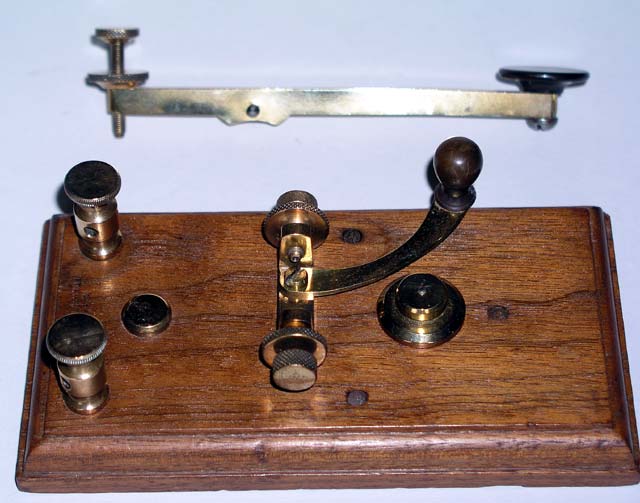
279d Another View of the Williams Key with the lever
removed:(48KB)
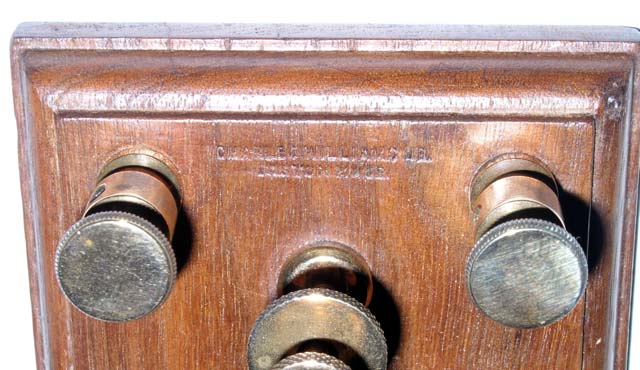
279e A view of the name stamped into the base of the
Williams Key:(51KB)
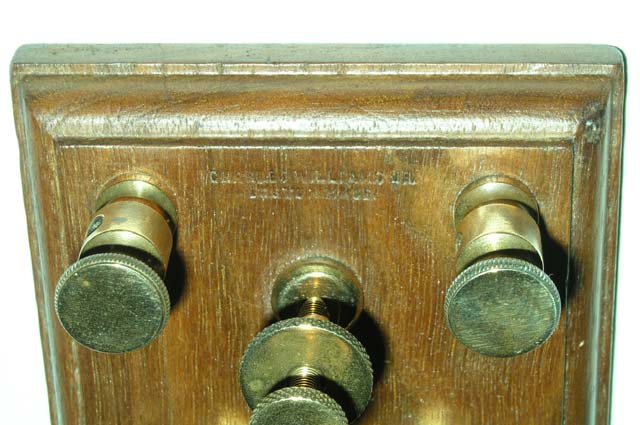
279f A view of the name stamped into the base of the
Williams Key:(50KB)
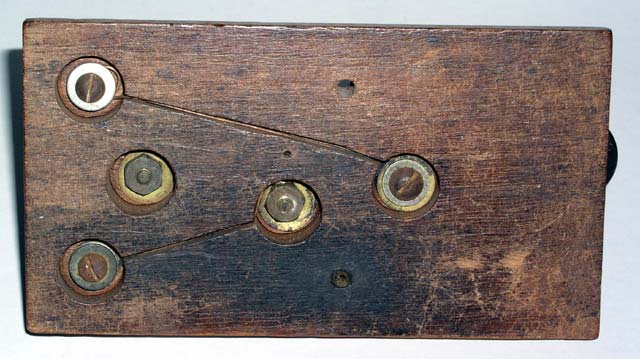
279g A view of the bottom of the base of the
Williams Key:(50KB)
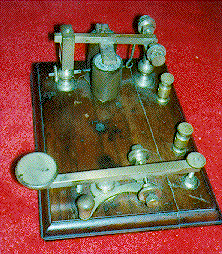
280 * VERY EARLY CHARLES WILLIAMS (Boston)
KEY & SOUNDER:(36KB)
Early brass straight lever key and extremely early sounder mounted on
a wooden base. Sounder design suggests that it is circa 1850's.
Traded to W2PM
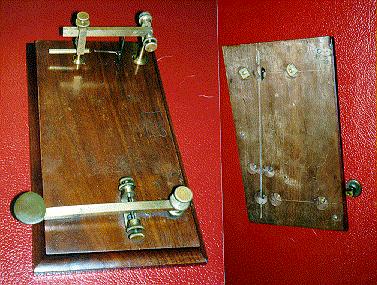
281 VERY EARLY AND UNUSUAL 'PUTT' NON-ELECTRIC
PRACTICE SET:(36KB)This set is very similar to the Charles
Williams Set listed as number 280. It has, however, no electric
mechanism. Pressing down on the key operates a long metal bar hidden
under the base which, in turn, pulls down the sounder. Each time the
key is pressed, therefore, the sounder makes a clicking sound. The
set was used for code practice without the need for batteries.
The wooden base is stamped: PAT'D MAY 31.70 D.W.PUTT & Co.
WELLSVILLE.O
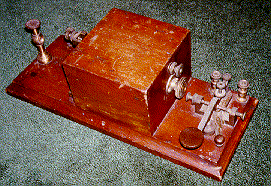
285 VERY EARLY JAMES CLARK (Philadelphia)
CAMELBACK KEY & BOX SOUNDER:(35KB)
Very unusual camelback key with pull-down spring at far end and
Prussian-like upswept lever mounted on wooden base with early
wooden box sounder. Circa 1850s.
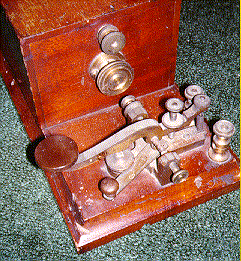
285a Closer view of key:(48KB)
This view shows the shape of the lever and placement of the spring.
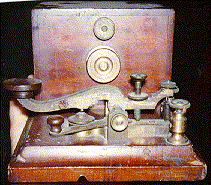
285b Side view of key showing curvature:(25KB)
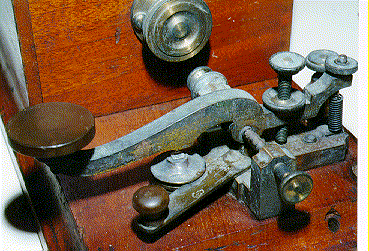
285c Another side view showing curvature:(57KB)
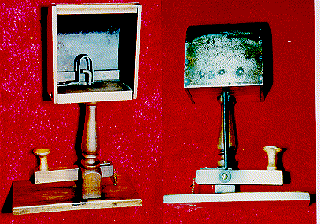
298 SOUNDER D'EXERCICE:(56KB)
Unique old miniature wooden resonator on pedistal with wooden key
pivoted at base. Key mechanically connected to a bar which strikes
an anvil inside the resonator making clicking sounds for practicing
sending & receiving. Marked:SOUNDER D'EXERCICE,Alban La FON,EVEREUX.
Signed R.Guillet,PTT twice.
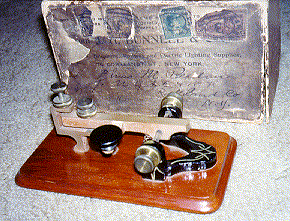
315 BUNNELL NON-ELECTRIC PRACTICE SET:(39KB)
Brass, horizontally-mounted sounder lever with small telegraph key
knob attached directly to it. It was used to provide practice
clicking sounds for people learning the Morse code without the
need for batteries and wiring. Japanned, pinstriped frame on wooden
base. Original box & stamps.

325 BUNNELL ARTICULATED NON-ELECTRIC PRACTICE
SET:(15KB)
Interesting combination of a brass sounder and telegraph key
with a mechanical connection whereby pressing the key causes
the sounder to move downward to make a click. It was used to provide
practice sounds for people learning the Morse code without the need
for batteries and wiring.
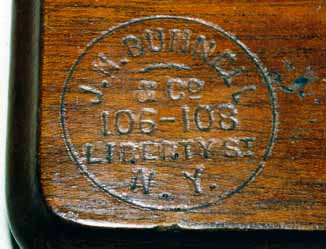
325a EARLY BUNNELL LOGO STAMPED INTO BASE:(22KB)

405 KNUDSEN MORSE REGISTER:(62KB)
Made by Cornelius Knudsen in Denmark. - circa 1850 Before it was
discovered that the Morse code could be copied by ear, "Registers"
were used to print the characters on a paper tape for later
transcription. These spring powered Registers continued to be used
because they were thought to be more reliable than sound copy and
because they made a permanent record. This is a very early brass
register with an unusual armiture which presses the paper tape up
against the (missing) pen to mark dots or dashes on the tape in
ink. It has a key wound mechanism (with key) which runs
constantly.
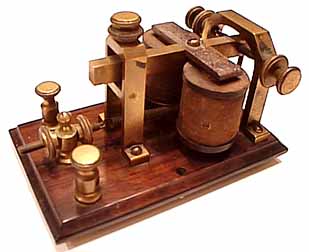
650 * EARLY L.G.TILLOTSON SOUNDER:(17KB)
Early all brass frame with brass armiture stamped
L.G.Tillotson, 8 Dey St. New York with steel trunnion crimped
into brass armiture. Horizontal adjusting spring.
Wooden base. Notice the box-like anvil. It is similar to the
Williams Sounder (Number 280) and the Putt practice set sounder
(Number 281) seen above although those anvils were mounted on
a single upright post.
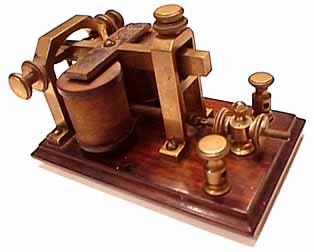
650a A view of the other side of the
sounder:(16KB)
685 * VERY EARLY L.G.TILLOTSON SOUNDER: Very early all brass frame with
brass armiture stamped L.G.Tillotson, 26 Dey St. New York with steel
trunnion crimped into brass armiture. Horizontal adjusting spring.
Wooden base.
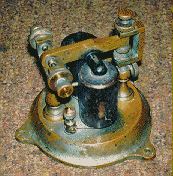
690 UNUSUAL VERY EARLY ROUND
L. G. TILLOTSON SOUNDER:(29KB)
Ornate brass design with brass armiture stamped L.G.Tillotson, 8 Dey
St. New York, with steel trunnion crimped into brass. Horizontal
adjusting spring. All mounted on ROUND plated brass base.
691 * VERY EARLY TILLOTSON SOUNDER: Medium size, all-brass sounder in
excellent condition. Armiture is stamped "L.G.TILLOTSON & Co. 5&7 Dey
St. New York." and "Pat'd Feb 16, 1875". Base is also stamped TILLOTSON
and same address.
692 * VERY EARLY TILLOTSON SOUNDER: Similar to above but smaller. Armiture
patent reads "Patent July 1874. No address on base. >Traded out.
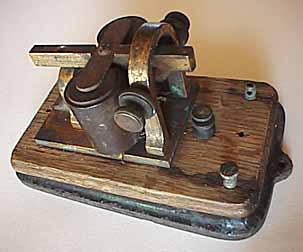
693 * UNUSUAL TRANSITIONAL SOUNDER WITH VERTICAL
AND HORIZONTAL SPRINGS:(17KB) This is an interesting sounder
which has parts for both horizontal and vertical springs. Although
the Anvil is broken off, you can see where the horizontal spring
adjusting screw was mounted. You can also see how the vertical spring
was mounted. The transition from horizontal springs to vertical
springs is generally believed to signal a major shift in
sounder design strategy and this sounder appears to incorporate
both designs.
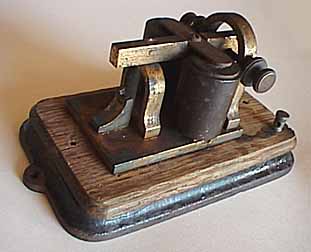
693a Another view of the Transitional Sounder:(16KB)
694 * VERY EARLY GREELEY SOUNDER: All plated. E. S.GREELEY & CO.
5 & 7 Dey St. New York.
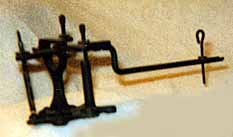
740 VERY UNUSUAL SOUNDER-ACTUATOR?:(8KB)
This extremely unusual sounder/Actuator was found at an abandonned
railroad station in the far west. It is of cast iron
construction and looks very early. The sounder mechanism has
an added long lever which allows it to act as an actuator to
perhaps activate another mechanical mechanism.
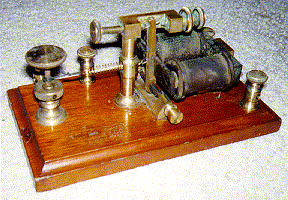
800 * EXTREMELY EARLY TILLOTSON RELAY:(33KB)
This extremely early L.C. Tillotson relay exhibits the early
spring-through-the-post design along with the post-mounted contacts.
These features were abandonned early in the design of relays. It
is stamped L.C.T. & CO. 6 DEY ST. NY. 60 ohms. Circa 1850's. (Traded
to John Casale - W2NI.)
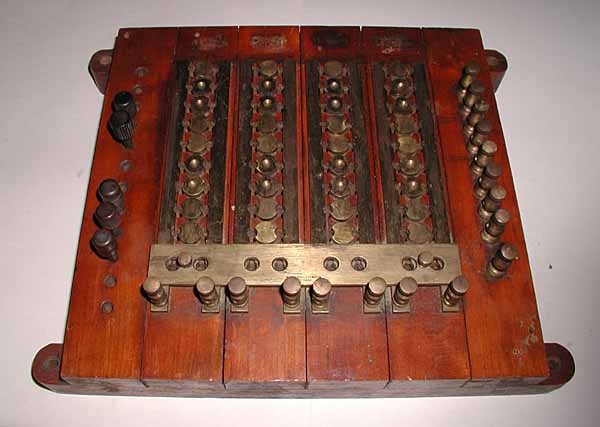
945 VERY EARLY TELEGRAPH PLUG-BOARD:(33KB)
This board was used to connect office telegraph instruments
to 4 telegraph lines. Brass plugs with insulated handles
shorted the blocks together and made the connections.
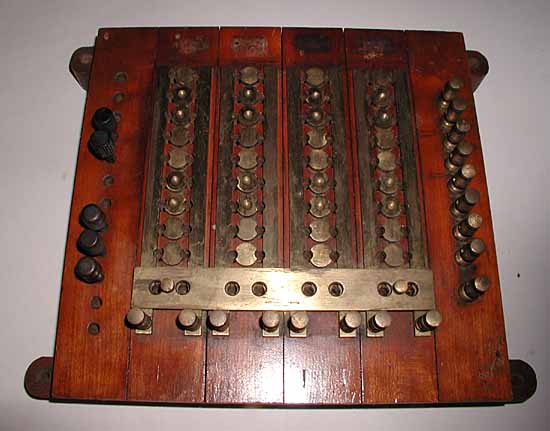
945a Another view of the plug-board:(33KB)
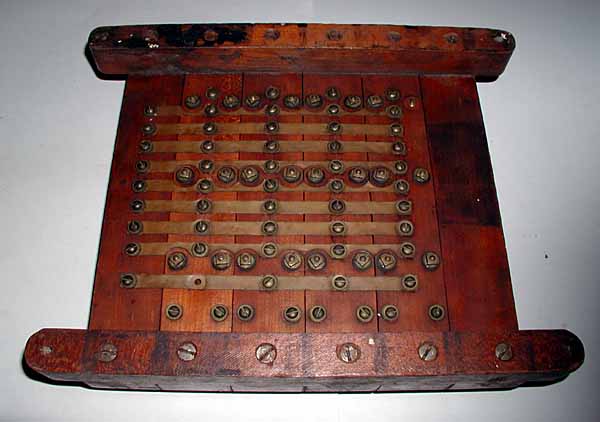
945b The back of the plub-board:(32KB)
Internet ENIGMA Museum:
https://EnigmaMuseum.com
COPYRIGHT NOTICE: (Copyright (c) 2023: Prof. Tom Perera Ph. D.)
Although all the pictures and text are copyrighted, you may use any of them
for your own personal applications including public lectures and
demonstrations, publications and websites as long as you mention the
w1tp.com Museum. If you plan to offer them for sale to the public
in any form, please email me for permission which I will generally grant as
long as you mention my museum: http://w1tp.com or https://EnigmaMuseum.com My email address is
given at the bottom of this page. Some of the material may require contacting
other copyright owners for commercial use and I will inform you by email.
Please also see the Disclaimer of Warranty.
KEYS (1001-1500), KEYS & SOUNDERS (1501-2000), SOUNDERS (2001-2500),
REGISTERS, RELAYS, & OTHER (2501-3000)
(The instruments are in approximate chronological order: Oldest first.)
* = (Items no longer owned.) ** = (Items in other collections.)
PART I:
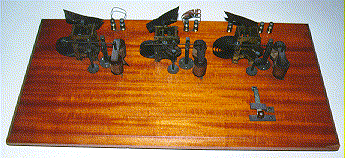
1005 THOMAS A. EDISON DUPLEX TELEGRAPH
MODEL:(30KB) This model, manufactured in Edison's laboratory consists of
a
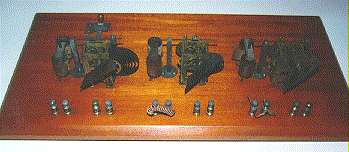
1 X 2 Ft. board (28KB) with
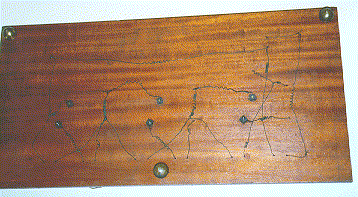
a set of wires on the bottom
(34KB). On this board, 3 wind-up clockwork mechanisms labeled "Terry
Clock Co. Waterbury, CT, Pat'd Dec 1, 1868 are mounted.
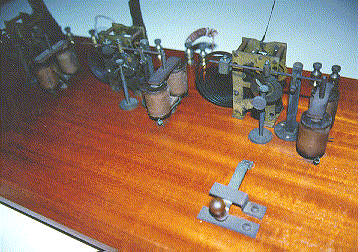
Each clockwork mechanism has had its
escapement removed and replaced with an air-propellor to govern its speed
(47KB). Each clockwork mechanism turns a
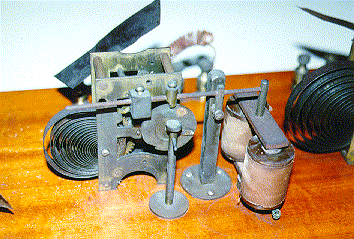
rotating disk that
makes contact with an adjustable wiper contact (46KB).
The disk has an
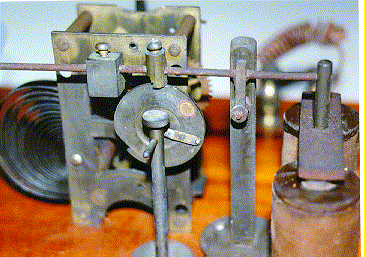
insulated spot that breaks
the contact at an adjustable point in its rotation (54KB).
The device was an early experimental model of a form of mechanical
time-division multiplex designed to allow 3 telegraph messages to be
sent on the same line.

1010 * K1BH's TRANSATLANTIC CABLE KEY:(32KB)
Small double (plated) lever key with ivory knobs on Gutta-Perchia
base stamped: Edouard BOUTY. Constructeur. Traded to K1BH, 1995.

1011 * VERY EARLY EUROPEAN SUBMARINE TELEGRAPH CABLE KEY:
(61KB) This is an unusual and very early cable key. Some of the
insulators are ivory. The maker is not known.
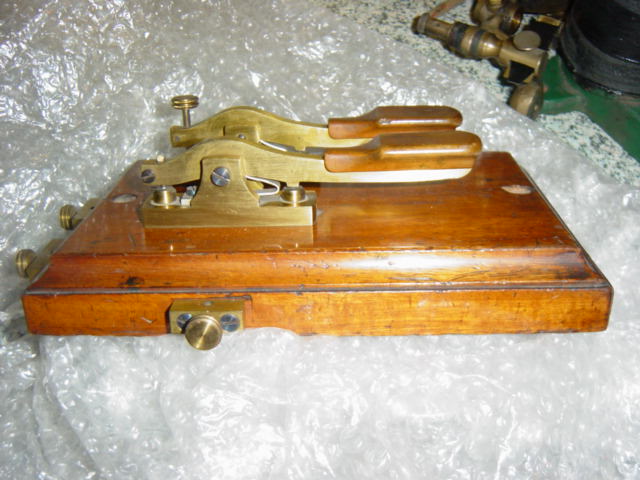
1011a * Another view of the cable key:(60KB)
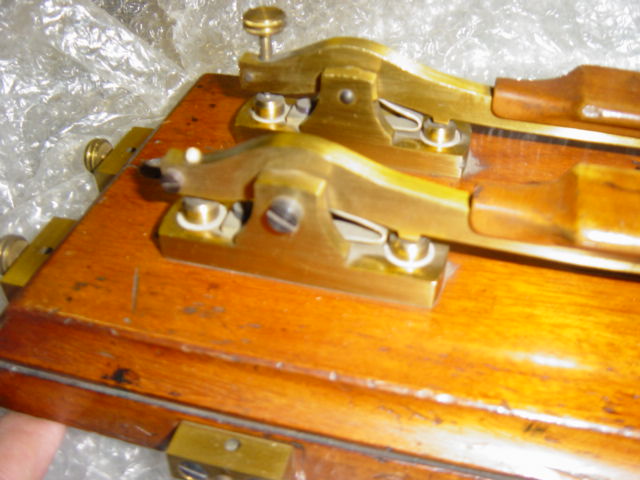
1011b * Another view of the cable key:(60KB)
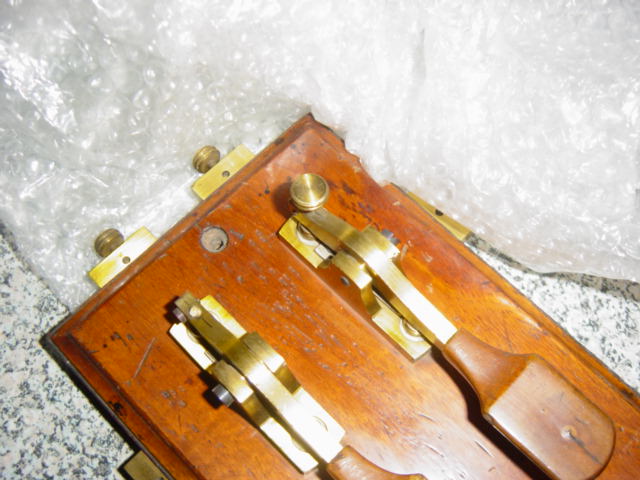
1011c * Another view of the cable key:(60KB)
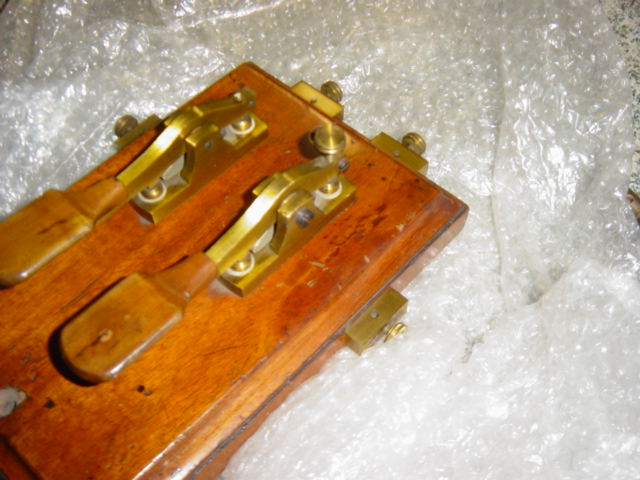
1011d * Another view of the cable key:(60KB)
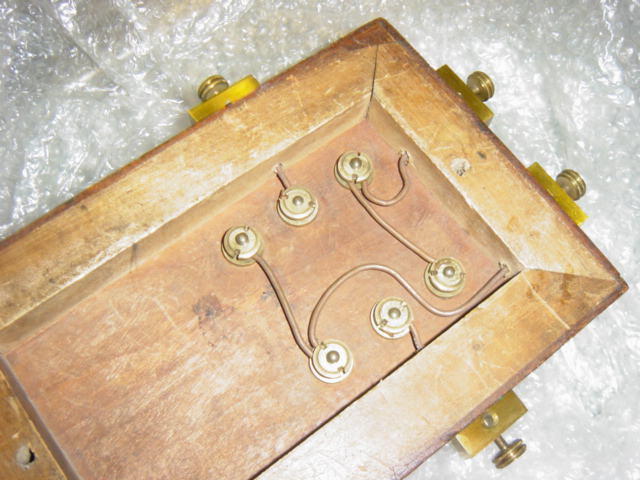
1011e * A view of the wiring under the base of the
cable key:(60KB)
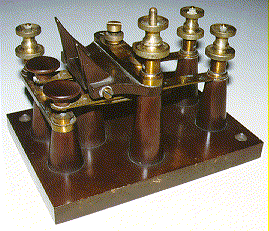
1012 SIEMENS BROTHERS CABLE KEY:(29KB)
This massive cable key has its entire mechanism mounted on high
columns above the base because of the high voltages which
were often necessary in order to transmit messages through
the very long cables. It measures 6-1/4"long by 4-1/2"wide
by 5" high. The base is stamped Siemens Brothers & Co. The
unusual triangular levers are used to hold the contacts in
the closed position.
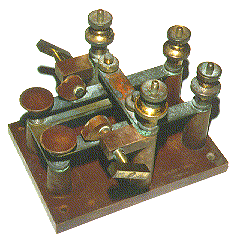
1014 * ELLIOTT BROTHERS CABLE KEY:(20KB)
Large and massive cable key similar to 1012 with the high
voltage columns but labelled Elliott
Brothers and with brass handled shorting cams.>K5VT

1015 UNUSUAL ROCKER-TYPE BRITISH CABLE KEY:
This is a very unusual cable key that uses a rocker-type mechanism.
Pressing the left knob puts a positive voltage on the cable and pushing the
right knob puts a negative voltage on the cable. There is no maker's name on
the key but the hardware strongly suggests that it is British.

1016 * Ted Huston's CABLE DISCHARGE KEY:(14KB)
This large key was used to discharge the capacitances on
the long submarine cables in order to permit measurements.
The high columns isolate the high voltages on the mechanism from
the base. It is in the Ted Huston collection.

1019 * CABLE KEY LITERATURE SHOWING/DESCRIBING
ABOVE KEYS:(80KB)
This page shows some of the keys (shown above) which were used for
submarine telegraph signalling and testing on the Washington
to Alaska Military Cable and Telegraph System.
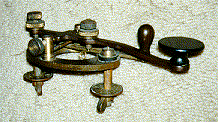
1020 * VERY EARLY AND UNUSUAL STRAIGHT KEY:(15KB)
Heavy long oval brass base with round hole in the middle. steel lever.
Extremely unusual round brass bar under steel lever runs between left
and right upright pivot posts. Shorting lever under this bar is
stamped WESTERN ELECTRIC CO.
1025 * VERY EARLY STRAIGHT KEY: Old all-brass key has a straight 1/4X1/4
inch brass lever bent down for an early-style knob. Wooden base with
cotton-covered wires embedded in channels on the underside. The spring
has a long gentle taper like Clapp-Eastham "Boston" key which it slightly
resembles.
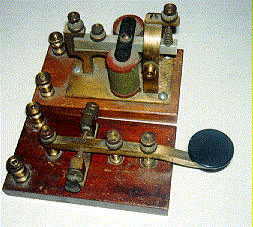
1026 * VERY EARLY STRAIGHT KEY & SOUNDER:(32KB)
Key like #1025 with matching sounder.

1050 BEARINGLESS ''STEINER'' KEY: (20KB)
The Steiner key is a very small key which is characterized by
having no trunnion or bearings. The lever is supported only by a spring
and knife edge. This one has a brass base which is stamped
W.E.Co. New York. Pat'd Dec.21,1880. Mounted on newer wooden base.

1054 ''RESTORED'' STEINER KEY: (17KB)
This is a small Steiner Key which has had its long legs cut off
so it could be mounted on a metal base. The key has been
chrome plated and the insulators have been replaced with white
plastic material. The shorting lever knob has been replaced with
a machined knob. I personally prefer to leave these keys in the
as-found condition with perhaps a light cleaning to remove dirt.
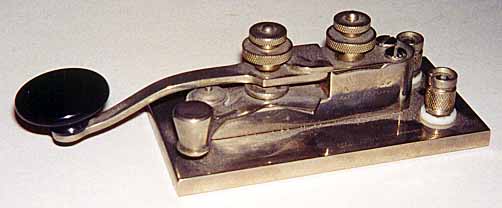
1054a Another
view of the ''RESTORED'' Steiner Key: (17KB)

1055 STEINER KEY: (28KB)
This is a small Steiner Key whose design is characterized
by having no trunnion and the lever supported only by a spring
and knife edge. Brass base stamped W.E.Co. New York.
Pat'd Dec.21,1880. This one has been mounted on a newer marble base.

1057 * STEINER KEY WITH UNUSUAL WESTERN ELECTRIC
SOUNDER:(15KB)
This Steiner Key was used with this very unusual Western Electric
Sounder. The key has a brass base stamped W.E.Co. New York.
Pat'd Dec.21,1880. The sounder has an unusual round anvil. I believe that
this is a transitional design between the Western Electric
rectangular frame sounders and the Western Electric all round
frame sounders.
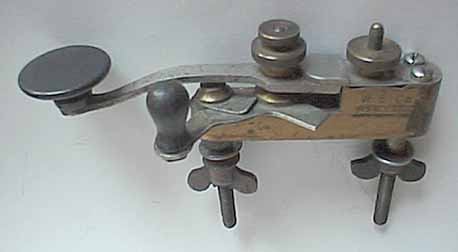
1057a * Closer view of the Steiner Key:(11KB)
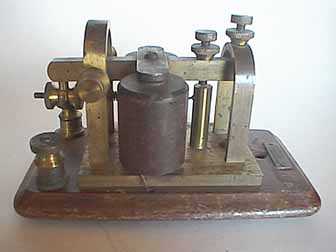
1057b * Closer view of the Round-Anvil Western Electric
Sounder:(12KB)

1062 * PRIVATE-LINE CAST-BASE KOB WITH STEINER
KEY:(35KB) This KOB has a Steiner Key and sounder cast into
it's base. Private-Line KOB's were designed to be used on
''private telegraph lines'' in homes and businesses. They were
made on cast iron bases which were often decorated with flowers
and designs to better integrate into a home or business environment.

1067 EXCEPTIONALLY UNUSUAL STEINER KEY AND STRANGE AND
COMPLEX RELAY ON WOODEN BASE, KOB:(40KB)
This instrument was probably made and used by Western Electric since they
were the most frequent users of Steiner keys. Its base was covered with mud
indicating that it was immersed in a flood at some time. Removal of some mud
revealed that the base and key were painted black while the relay was nickel
plated brass.
The Steiner key is the only one if its kind that I have ever seen. It has a
rectangular frame over the lever. This rectangular frame converts the
normally-open contacts of the Steiner key into normally-closed contacts. All
of the Steiner keys that I have seen are configured like the one on the
Private-Line KOB and other Steiner keys shown above and have normally open
contacts and no rectangular frame. I believe that the closed-circuit feature
of this Steiner key was probably found to be necessary to work with the
complex relay system to produce some sort of duplex operation.
The most unusual feature of this instrument is the extremely complex relay
mounted on its wooden base. It was probably used in some kind of duplex
circuit. Duplex circuits often employed complex relays in an attempt to send
two signals on the same line and this is certainly a very complex relay. It
has a set of single-pole double-throw contacts on top that move back and forth
when BOTH of the coils are energized simultaneously. It has another set of
single-pole double-throw contacts located toward the key that move from side
to side when one OR the other coil is activated or when there is an imbalance
in the pull exerted by the two coils. This is generally called a polar relay
configuration in that the contact remains in its last position untill pulled
over by the other coil. It is also clear that a box, probably made of wood,
was mounted on the four pins that stick up around the relay. The exposed
coils that could be easily damaged also suggest that the box was used to
protect them and perhaps to keep people from trying to adjust the
very delicate mechanism. Close views of the underside of the base show that
the wiring was changed probably several times in what must have been an
attempt to explore different circuit configurations.
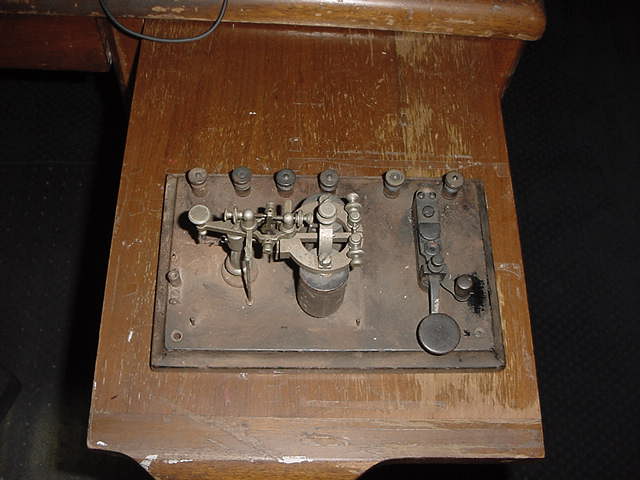
1067a Another perspective view of the
instrument in as-found condition:(38KB)
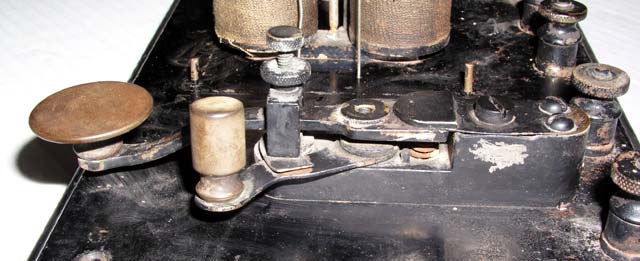
1067i A closer view of the unique Steiner
Key:(36KB)
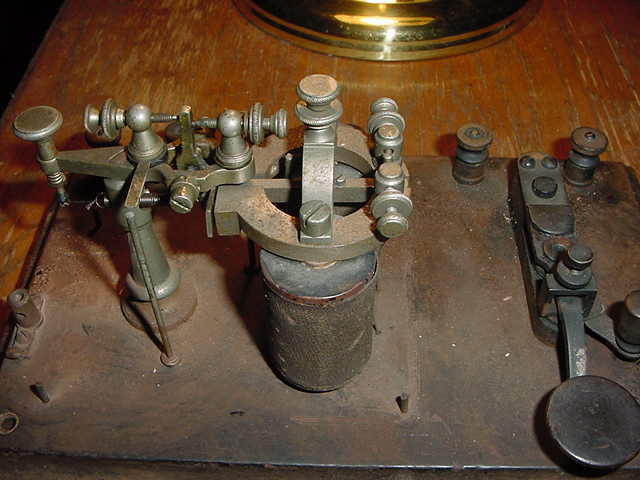
1067b A closer view of the mechanism showing the contacts
that are activated when BOTH of the coils are energized:(37KB)
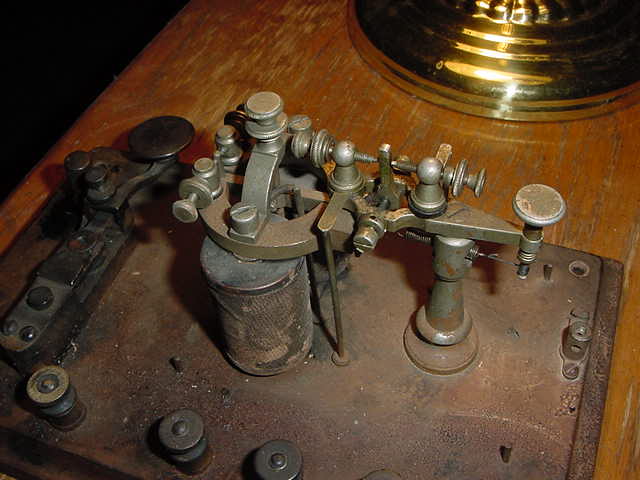
1067c Another close view of the mechanism showing the
contacts that are acrivated when BOTH coils are energized:(37KB)
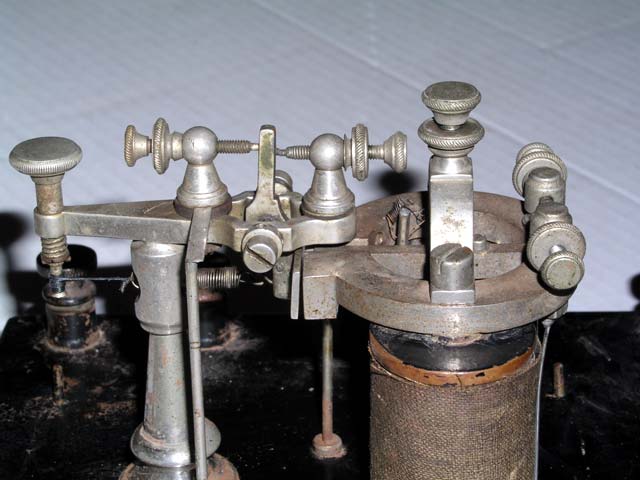
1067j A Close View of the contacts that activate when
BOTH coils are energized:(43KB)
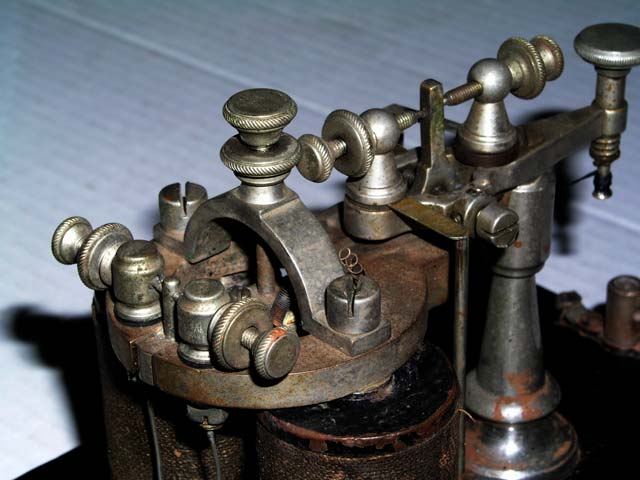
1067k A Close View of the contacts of the Polar Relay that
are activated when One OR the Other coil is energized:(43KB)
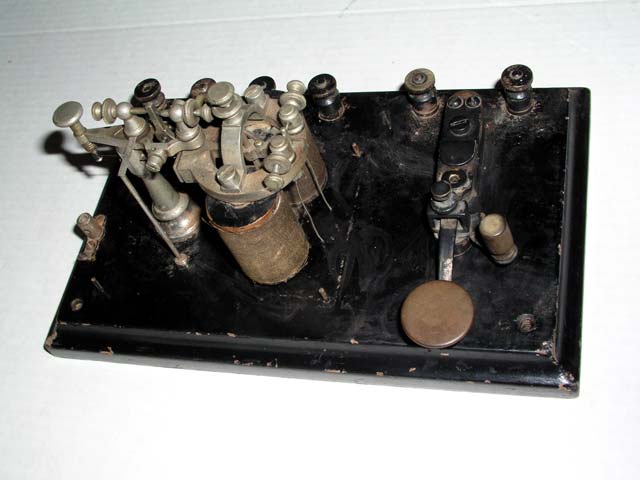
1067g A Right Side View of the KOB after cleaning
the base:(406KB)
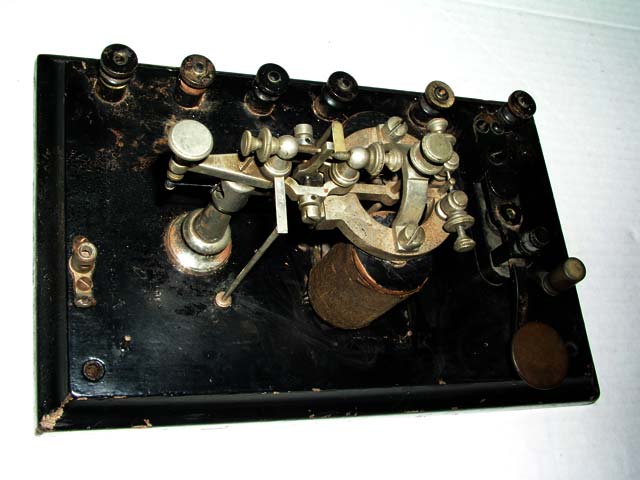
1067h A Left Side View of the KOB after
cleaning:(36KB)
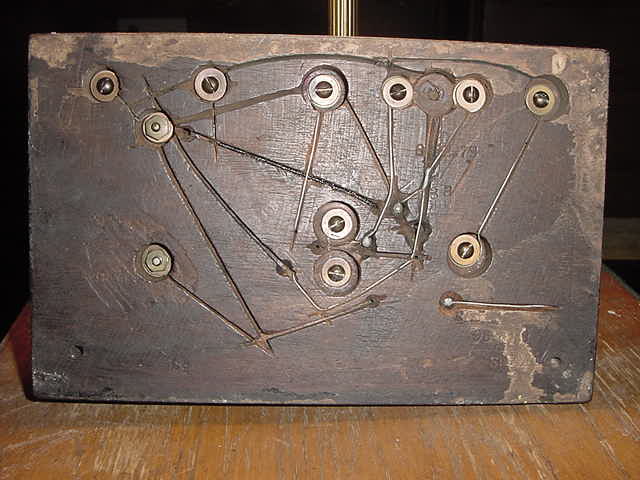
1067d The wiring under the base:(38KB)
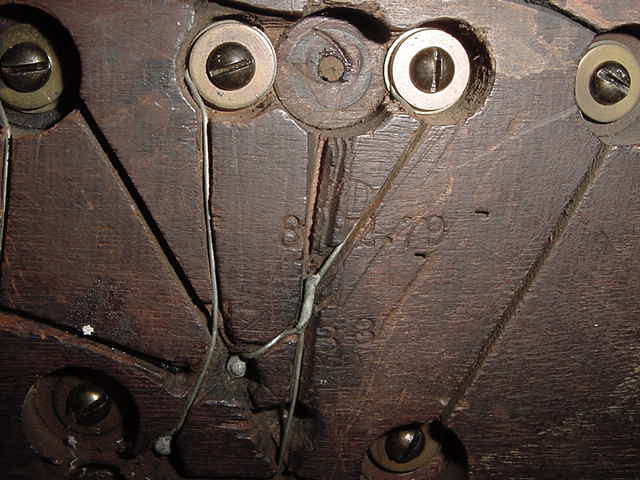
1067e Details of the wiring & markings under the
base:(38KB)
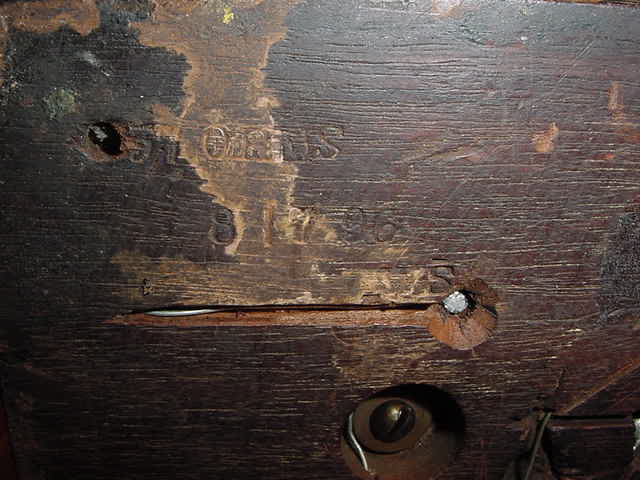
1067f Details of the markings under the
base:(38KB)

1070 * VERY UNUSUAL LEFLEY LEG KEY:(20KB)
This is a very hard to find key with an unusual shorting lever
which moves forward-and-back rather than side-to-side. Traded to K5VT.
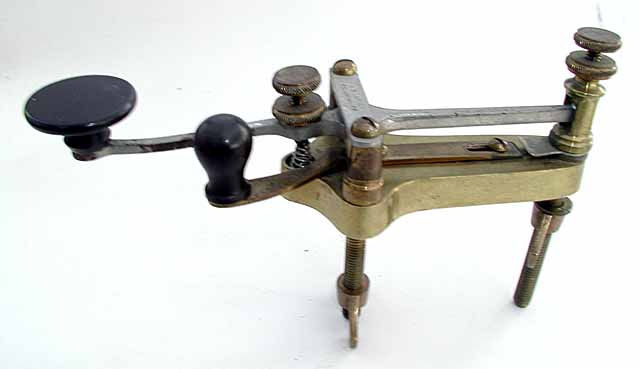
1070a * Another view of the Lefley Key:(18KB)
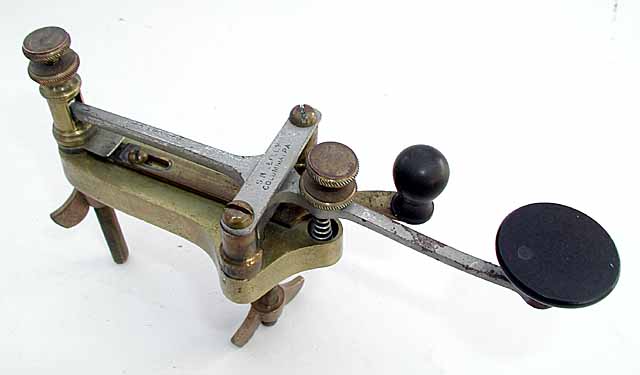
1070b * Another view of the Lefley Key:(21KB)
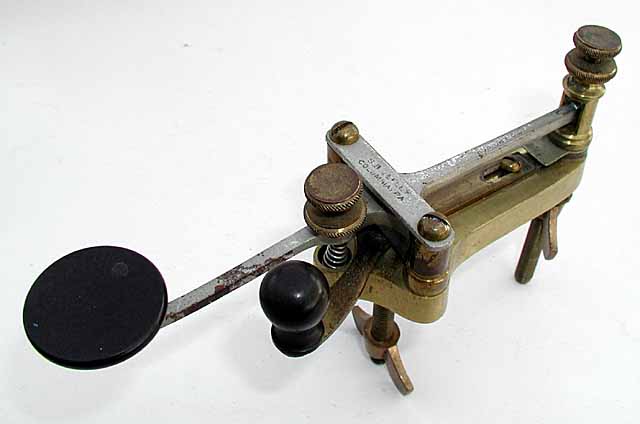
1070c * Another view of the Lefley Key:(22KB)
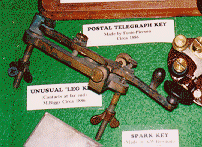
1075 VERY UNUSUAL "M. BIGGS" LEG KEY: (23KB)
Very unusual early all brass design with normally-open contacts out at
far end of key armiture. Brass armiture engraved M. BIGGS. Pat Oct 20,
'86. Standard Electric Co. Louisville, KY. Brass shorting lever and
all brass legs with wing nuts.
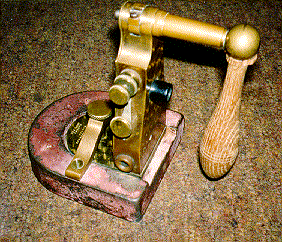
1080 PUMP HANDLE KEY (The "Twentieth
Century Key"):(48KB)
Serial #386. All brass key with hanging wooden lever shaped like
a pump handle, mounted on very heavy cast iron base. Wooden lever is
pushed left to make contact. This key was designed to help overcome
"Telegrapher's Paralysis" which we now call "Carpal Tunnel Syndrome".
A small knob on the front of the key acts as the shorting switch.
Key stamped "Made by Foote Pierson & Co. New York. Pat Applied For."
1082 PUMP HANDLE KEY:1082 ("The Twentieth Century Key").As above.Serial #1067.
(Traded to K5VT).

1125 * MODERN SWEDISH ERICSSON-STYLE KEY:(21KB)
A modern version of the lovely Ericsson keys shown below. (This key
is the same as number 5050.)

1200 LARGE EARLY SWEDISH ERICSSON-STYLE KEY:(15KB)
This is the classic early Swedish land-line key made from the 1870s well
into the 20th Century. The key has a very long lever and a crisp 'feel'.
Operators were trained to sit in front of the operating table with their
upper arm straight down and their lower arm pointing straight ahead. Their
seat height was adjusted so their arms made a right angle with each other.
Their lower arm was thus parallel with the operating table. They were
taught to grasp the key knob firmly with thumb and forefingers and to
use ONLY up and down whole-arm movements to operate the key. You can see
the cuts in the wooden base which were used to allow the wires to come
up to the key connectors from the operating table. This is my
all-time favorite key to own and to operate on the air.
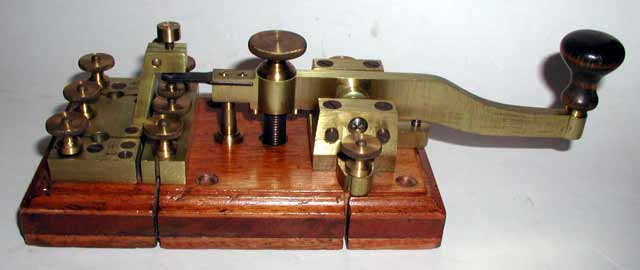
1200a Another View of the Swedish Key:(16KB)
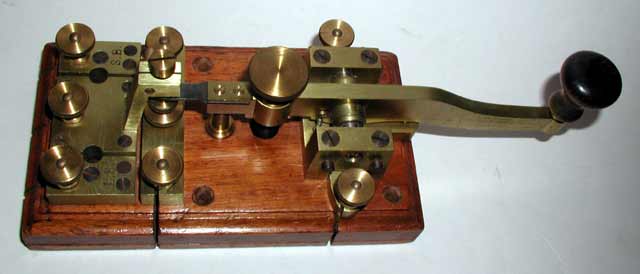
1200b Another View of the Swedish Key:(17KB)
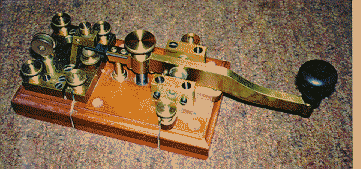
1215 SWEDISH ERICSSON-STYLE KEY: (49KB)
Very large old all-brass key on a wooden base with very long lever and
beautiful brass hardware and switch block. Made in 1880's by ERICSSON
or KUNGLIGA TELEGRAFUERKET (The Royal Telegraph Administration) at
their NYNASHAMN factory S. of Stockholm.
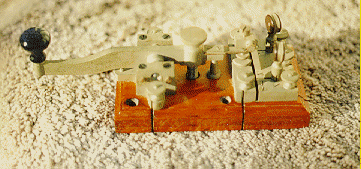
1217 SWEDISH ERICSSON-STYLE KEY: (49KB)
Same as above but plated brass.
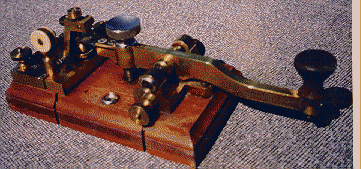
1219 SWEDISH ERICSSON KEY: (45KB)
Like 1215 but smaller and perhaps older.
1221 * SWEDISH ERICSSON KEY: More modern version of above. Circa 1960s.
1222 * SWEDISH/NATO ERICSSON-STYLE KEY: Long 7" lever on
brown base. Circa 1960s.

{1222} 5060 * {Duplicated from Wireless Keys section.}
EARLY DANISH - GREAT NORTHERN TELEGRAPH WORKS KEY:
This Danish key carries a label that reads: Great Northern Telegraph Works,
Copenhagen, Denmark. No. 77773. It is not likely that 77773 of these keys
were made since they do not show up very often. I think it is more likely
that the manufacturer started with a high serial number. The picture was sent
to me by another collector.
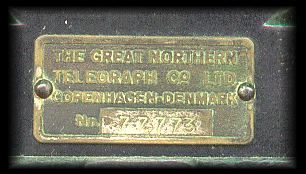
5060a * The Label on the
Early Danish key:

{1223} 5070 * {Duplicated from Wireless Keys section.}
LATER DANISH - GREAT NORTHERN TELEGRAPH WORKS KEY:
This appears to be a later version of the Danish key above. This Danish key
carries a label that reads: Great Northern Telegraph Works, Copenhagen,
Denmark. No. 13779. Since it is not likely that 13779 of these keys were made
it is more likely that the manufacturer started with a high serial number.
Circa 1960s. The picture was sent to me by another collector.
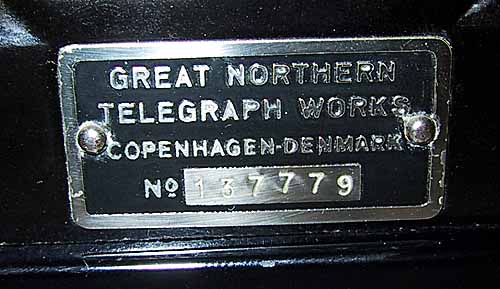
5070a * The Label on the Danish key:
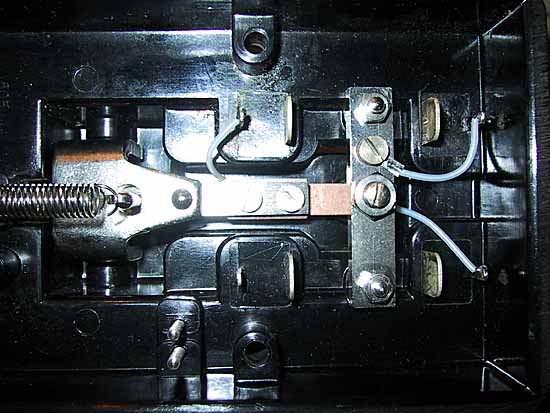
5070b * The Underside of the Danish key:
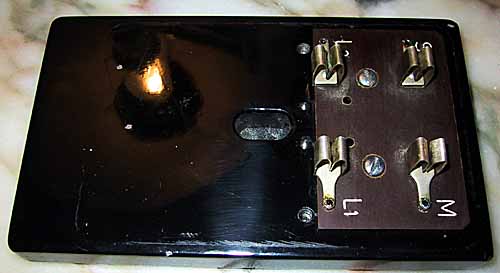
5070c * The Removable Base of the Danish key showing the
modular connectors:
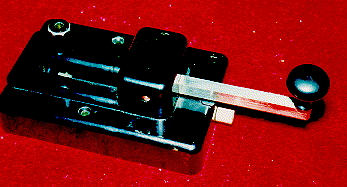
1224 * DANISH ERICSSON-STYLE KEY:(16KB)
Long 7" lever on black plastic base. Circa 1960s.
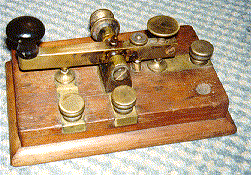
1225 FRENCH PTT KEY:(28KB)
Used in France by the Poste and Telegraph Offices. Massive all-brass
key w/straight lever mounted on well worn wooden base.

1226 FRENCH PTT KEY:(14KB)
Used in France by the Poste and Telegraph Offices. Massive all-brass
key w/straight lever mounted on wooden base.
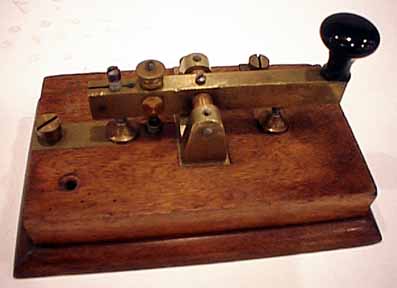
1226a Another view of the FRENCH PTT KEY:(14KB)
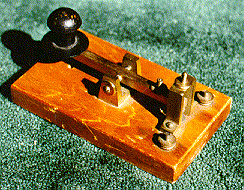
1228 * LARGE WELLS FARGO KEY:(32KB)
Large 5" rectangular brass lever with round, skirted knob mounted
on a 2x5" wooden base. Underside stamped: NATIONAL STATE CAPITAL
BANK, Wells Fargo Agents.
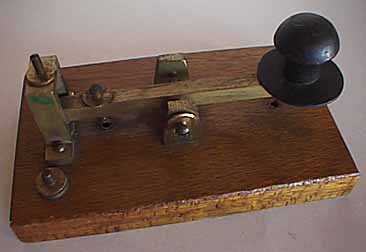
1228a Another view of the WELLS FARGO Key:(12KB)
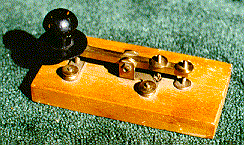
1229 * SMALL WELLS FARGO KEY:(23KB)
As above with 4" lever on 2x4" wooden base.
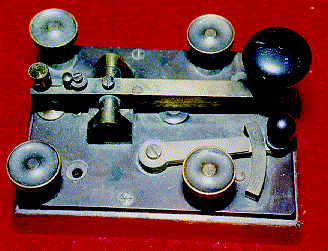
1235 * EARLY BRITISH TELEGRAPH KEY:(34KB)
Very large all brass key on large wooden base with brass
"SEND - RECEIVE" switch.>>W2PM

1237 EARLY BRITISH TELEGRAPH KEY:(13KB)
Classic straight lever brass British land-line telegraph key
on wooden base.
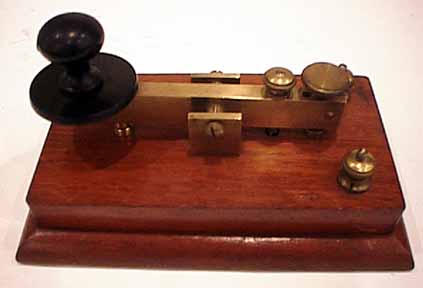
1237a Another view of the British key:(13KB)

1240 EARLY BRITISH "WALTERS" LAND-LINE KEY:(13KB)
The unique and unusual design of this key includes a flat spring
steel strip (Similar to that on a Steiner Key) instead of a
trunnion shaft. The contacts are enclosed in the round brass
cylinder at the middle of the key.

1242 EARLY BRITISH GPO LAND-LINE KEY:(19KB)
This lovely early key is marked PATT 1056A.
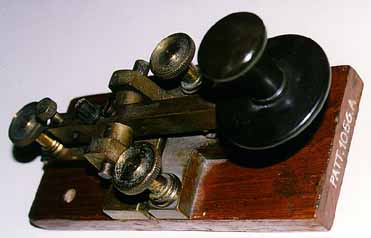
1242a Another view of the BRITISH LAND-LINE
KEY:(16KB)

1245 ** EARLY BRITISH LAND-LINE KEY MADE BY ELLIOTT
BROTHERS:(15KB)
This lovely early brass land-line key is owned by
collector Peter Malvasi - W2PM.
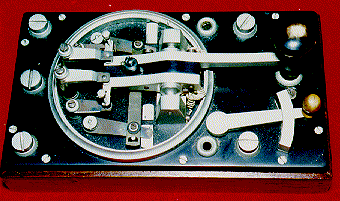
1250 BRITISH DOUBLE CURRENT KEY:(28KB)
Elaborate key with complex mechanism enclosed within a circle.
Sent out a weak negative signal between dots and dashes to
depolarize very long telegraph lines & counteract the capacitance.
I have seen some examples of these keys with the 'Siemens Brothers,
London' label. This one has no label.

1251 BRITISH DOUBLE CURRENT KEY:(38KB)
This is another example of the above key. I have taken pictures
of the complex mechanism to try to clarify its design.
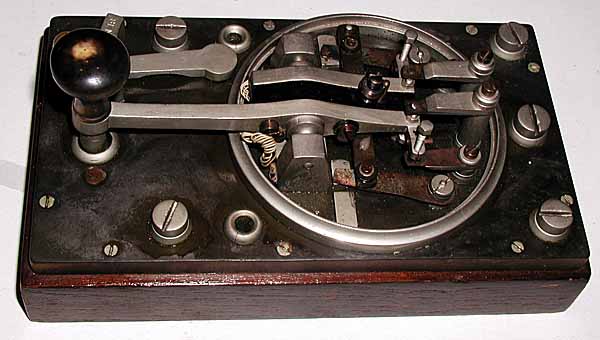
1251a Right-Side top view of the key:(36KB)
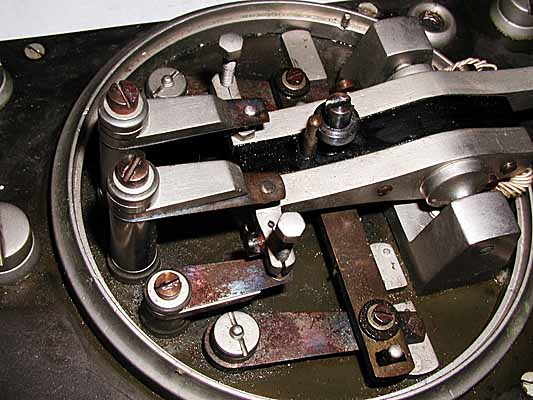
1251b Closer view of the top of the key:(50KB)
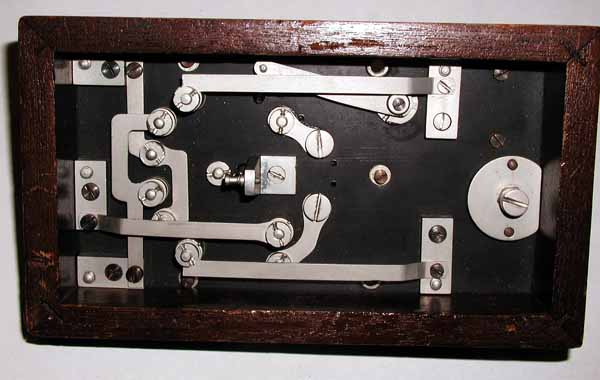
1251c A view of the bottom of the key:(33KB)
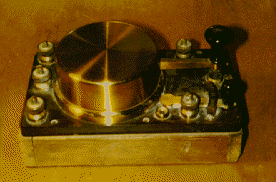
1252 * BRITISH DOUBLE CURRENT KEY: (28KB)
Similar to 1250 but all brass with brass cover over contacts.
Engraved: TYLER & CO., Ltd. 1923 III 1915

1255 * SPECIAL BRITISH RAILROAD TELEGRAPH KEY: (16KB)
This unusual key is built on the same metal base as a solenoid-operated
bell. It was used on the British Railroads as the bottom element of an LNWR
(London & North Western Railway) block instrument that was made ca. 1890-1925.
A few remain in use to this day.
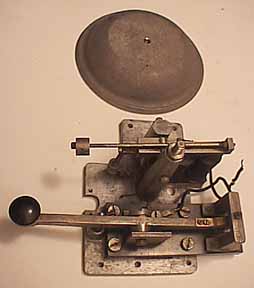
1255a Closer view of the British Railroad
key/bell: (14KB)
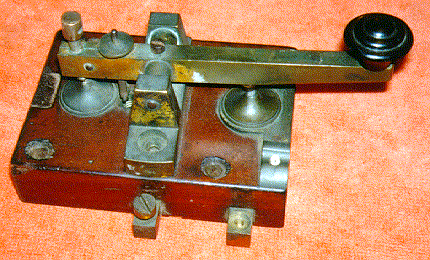
1260 EARLY AUSTRALIAN LAND-LINE KEY:(58KB)
This is the earliest Australian land-line key. Many of the early
features of this key were carried on into later Australian key designs
such as number 1262 and finally into the modern Clipsal keys.
(number 9190).
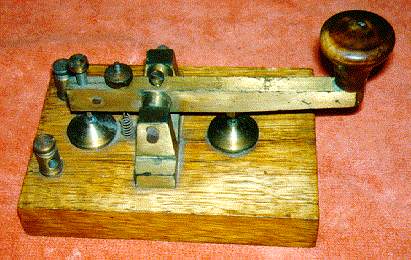
1262 LATER AUSTRALIAN LAND-LINE KEY:(59KB)
This key shows the design influences from the early Australian key
(number 1260) and led the way to the more modern:
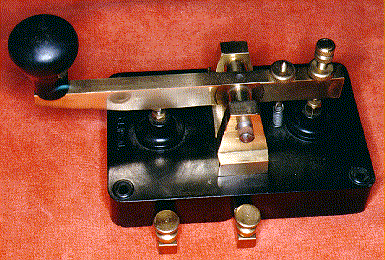
9190 Australian Clipsal key (number 9190):(54KB)

1270 ** INDIAN LAND LINE TELEGRAPH KEYS:
These three keys were purchased in India by collector Jack Klobuchar - W1TEC.
They include one very early and two more recent keys. The oldest key
was made by the India Electric Works Ltd. of Calcutta, India. Keys like these
are still being used on the Indian Railroads. The design appears to have been
patterned after early British keys.
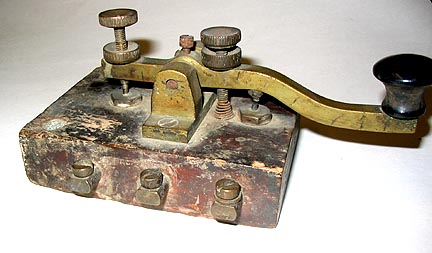
1270a ** A closer view of the oldest Indian Key:
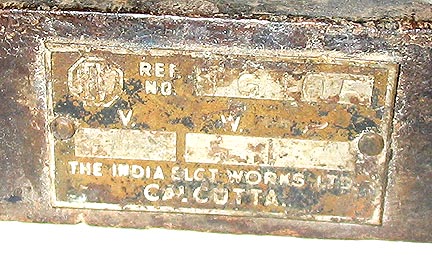
1270b ** A closer view of the label on the
oldest Indian Key:
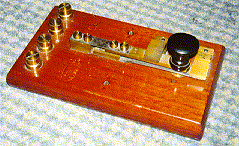
1275 * EARLY FRENCH BRASS STRAP KEY:(22KB)
Unusual old multiple part all brass design marked: SOC DES TELEGRAPHES.
ATELIER C.AL. (Atelier means builder.)

1280 * EARLY BRASS STRAP KEY: (14KB)
This very small early strap key is simply a springy brass
strap with contacts and binding posts mounted on an old
wooden base.
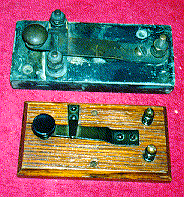
1282 * VERY EARLY HEAVY BRASS STRAP KEY:(28KB)
This medium sized key consists of a heavy springy brass strap with
interesting upper and lower contacts and binding posts mounted on
a heavy black marble-like base.
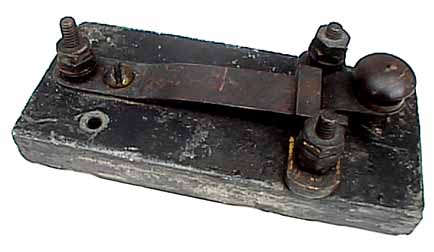
1282a Another closer view of the strap key:(17KB)

1283 * SMALL STRAP KEY:(15KB)
This small key consists of a springy metal strap with
a set of lower contacts and binding posts mounted on
a wooden board.

1284 * SMALL STRAP KEY:(14KB)
This small key is similar to number 1283. It
consists of a springy metal strap with
a set of lower contacts and binding posts mounted on
a wooden board.
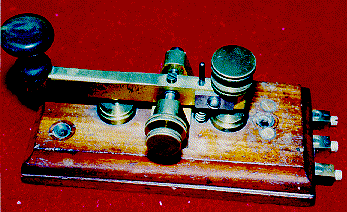
1290 EARLY SWISS / ITALIAN LAND LINE KEY:(31KB)
Heavy brass key with 1/2 X 5/16 X 4-1/2" straight lever. Adjustable
pull-down spring beyond pivot. Doorknob shaped knob. Make & Break
contacts. Huge adjusting screws. All parts and screw heads are
numbered "12". 5-7/8 X 2-13/16" wooden base with recessed wiring.
Greg Ulsamer, DL1BFE, reports that this kind of key was first made
in the 1850's by a Mechanicus by the name of Kaufman in the town of
Solothurn and later by the 'Eidgenoessische Telegraphenwerkstaette' which
was the workshop of the (governmental) Swiss Telegraph Administration.
Since many of these keys are found in Italy, it has previously
been assumed that they were Italian.
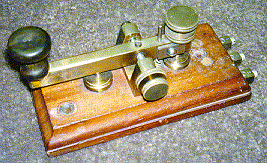
1290a Another view of the Swiss/Italian key:(29KB)

1294 EARLY STYLE SWISS / ITALIAN LAND LINE KEY:(17KB)
This medium sized brass key is typical of the early
straight-lever Swiss/Italian land line keys (See above for an explanation of
the confusion about the key's origin).
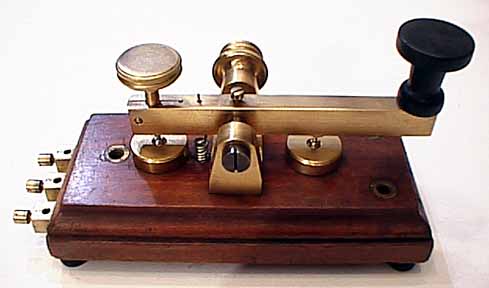
1294a A different view of the Swiss/Italian key:(18KB)

1295 * EARLY STYLE SWISS / ITALIAN LAND LINE KEY:(25KB)
This medium sized brass key has the unique automatic shorting contacts
that are typical of the early Swiss/Italian land line keys. Placing
fingers on the knob pushes a plastic plate forward and unshorts
the key readying it for transmission. Releasing the lever
automatically places it in the receive mode. Greg Ulsamer reports that
this key is called the ''Forchieri-key'' which is a family name from
the Italian portion of Switzerland.
It was first made by the workshops of the Swiss Telegraph
Administration in the 1890s and used on the American type of Closed
Circuit lines in Switzerland.
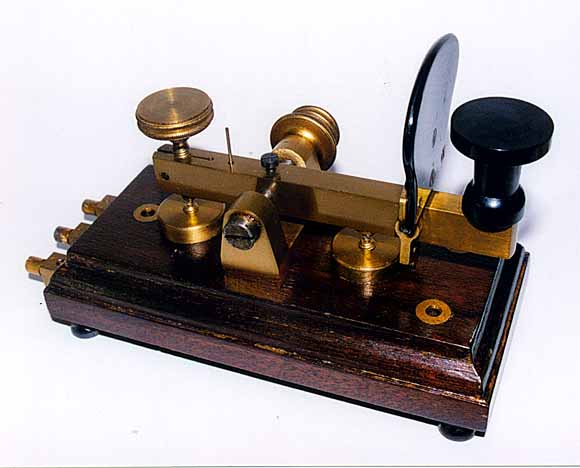
1295a Another view of the Swiss/Italian key:(30KB)
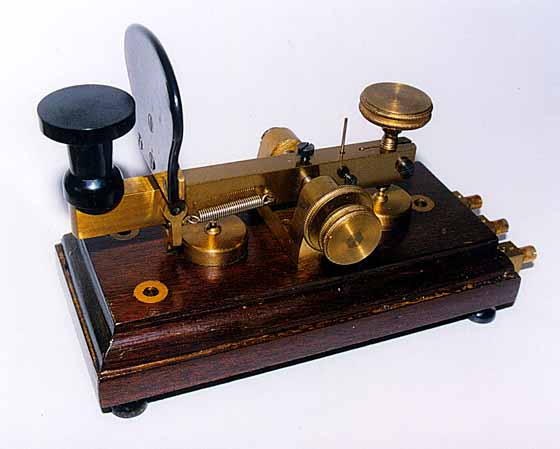
1295b Another view of the Swiss/Italian key:(30KB)
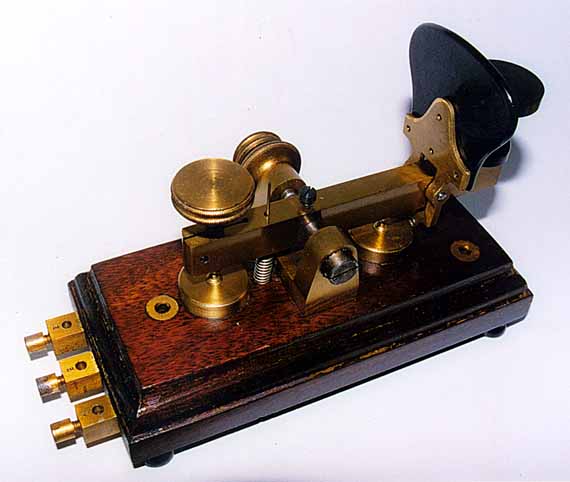
1295c Another view of the Swiss/Italian key:(30KB)
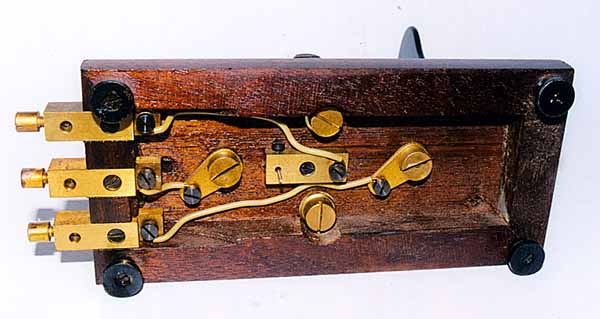
1295d A view of the underside of the base of the
Swiss/Italian key:(30KB)
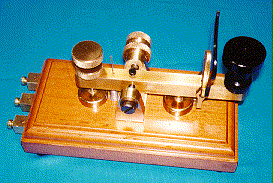
1295r * REPRODUCTION OF THE
EARLY STYLE SWISS / ITALIAN LAND LINE KEY:(25KB)
This key is a recent reproduction made in Italy in the 1990's.

1296 RECENT SWISS PRACTICE LAND LINE KEY:(28KB)
This interesting key has its contacts supported on strips of thin spring
metal. I am told that it was used by the Swiss military for practice...
but the reason for placing the contacts on springs is unclear. The most
likely explanation is that it reduces the noise of the contacts and it is
less likely to annoy or confuse nearby student operators. The maker's
name and location, E. Bischhausen, Bern is stamped on the frame under
the lever.
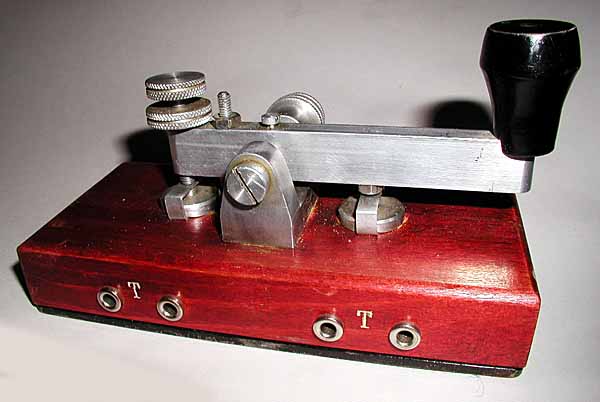
1296a A left side view of the Swiss
Key:(30KB)
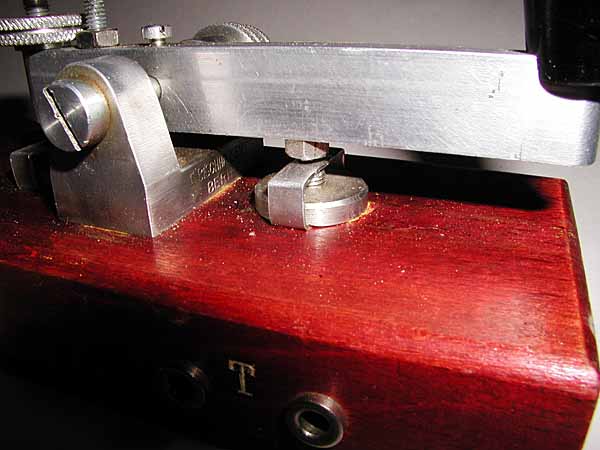
1296b A close-up view of the spring supported contacts
also showing the maker's name and location:(34KB)
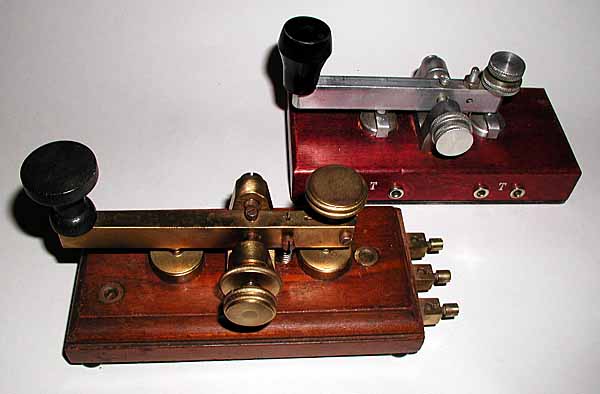
1296c A side-by-side comparison between the Swiss/Italian
key (1294 above) and this Swiss key:(27KB)

1298 * EARLY STYLE GERMAN LAND LINE KEY:(13KB)
This key has the classic straight lever and spring-mounted
normally-open and normally-closed lower contacts that
are uniquely found on virtually all of the early
post-camelback era German keys.
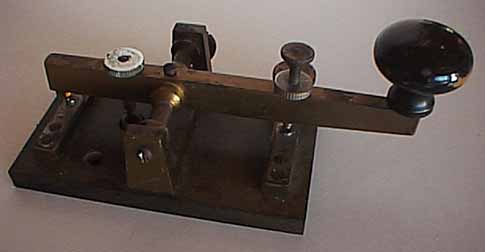
1298a Another view of the German key:(11KB)
1305 LEG KEY, land line, brass with steel lever and brass shorting
switch. Base engraved W.U.Tel.Co. JHBunnell & Co, New York USA. Very
unusual bearings with adjusting screws COUNTERSUNK into cast brass
uprights. Brass wing nuts and washers.

1307 * WESTERN ELECTRIC LEG KEY:(16KB)
Unusual brass key with plated lever consisting of parallel circular
rods. Trunnion reads Pat App'd For. Shorting switch. Quite early.
Circa late 1870s to early 1880s.
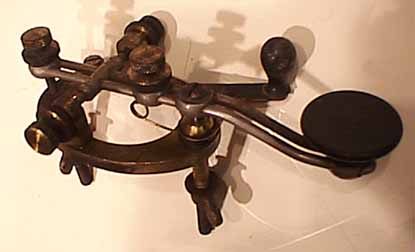
1307a Another view of the Western Electric Leg Key:
(14KB)
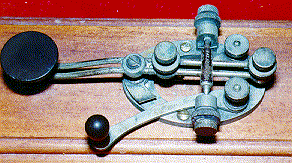
1308 LEGLESS WESTERN ELECTRIC KEY:(29KB)
Parallel rods lever like 1307 above but a legless design
mounted on a wooden base.
1310 MINIATURE BRASS LEG KEY: Unusual small brass key with steel
trunnion press fit into brass lever and normally-closed contacts at far
end of key.

1320 * VICTOR PATENT LEG KEY:(13KB)
Early all brass Victor leg key characterized by knife-edge bearings on
both sides of brass lever which is stamped: Pat Dec 26th,1882.
E.S.Greeley & Co., Successors to L.G.Tillotson & Co. New York.
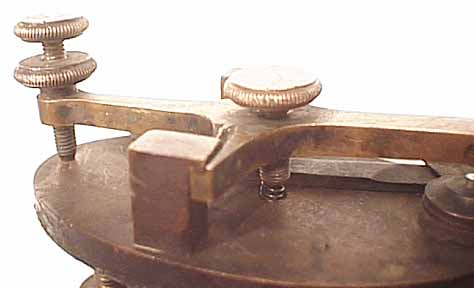
1320a Another closer view of the knife-edge
bearings:(14KB)

1325 VICTOR LEG KEY:(31KB)
This early all-brass Victor leg key is characterized by the unique
Victor patent knife-edge bearings on both sides of the brass lever
which is stamped: Pat Dec 26th,1882.
E.S.Greeley & Co., Successors to L.G.Tillotson & Co. New York.

1325.gif Another view of the VICTOR LEG KEY:(18KB)
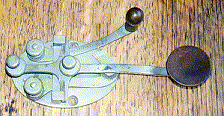
1327 VICTOR LEGLESS KEY:(18KB)
All Nickel plated as above. Stamped: Western Electric.

1335 VERY UNUSUAL WESTERN UNION/BUNNELL LEG KEY:(13KB)
This key stamped "W.U.TEL.CO. and Bunnell has an unique additional
spring plate between the contacts that is adjusted by Phelps style
screws.
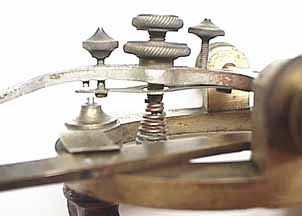
1335a CLOSE-UP VIEW OF SPECIAL SPRING ON ABOVE
KEY:(13KB)
1340 MESCO LEG KEY, land line, brass with steel lever. Thick brass base
engraved "M E S C O" (Manhattan Electric Supply Co.)

1345 SIGNAL ELECTRIC CO. LEG KEY IN ORIGINAL
BOX:(28KB) This is a new Signal Electric Co. Leg Key with the original
box. The markings on the box include a place to list the 'ohms' suggesting
that the same box was used for their sounders and relays.
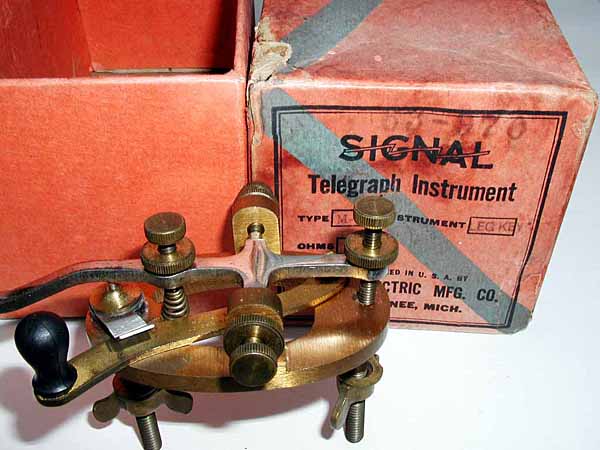
1345a A closer view of the label on the
box:(43KB)
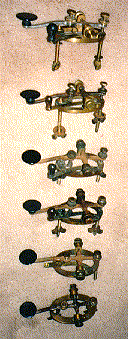
1350 BUNNELL LEG KEYS:(24KB)
Land line, brass with steel lever stamped "Patented Feb 15,1881".
Brass shorting switch. Base stamped JHBunnell & Co,New York
USA. Brass wing nuts.
1351 * LEG KEY, Like 1350 but lever stamped BUNNELL inside rectangular box.
1352, * & 1253 LEG KEY, Same as 1350 but lever not stamped.
1355 * LEG KEY, Same as 1350 but missing one wing nut and the insulated leg.
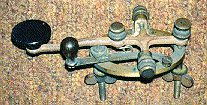
1361 LEG KEY:(17KB)
Land line, brass with unusual thick steel lever with all edges
beveled. Brass base stamped Nat Elec Mfg Co.

1370 * UNUSUAL LEG KEY:(16KB)
This is a brass land line key with an unusual heavy brass base
and with an unususal brass rod running from left to right
under the trunnion.
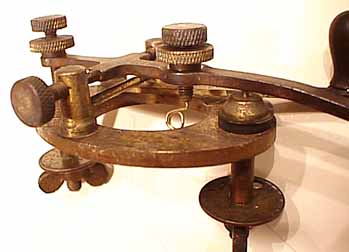
1370a Another view of the unusual leg key:(16KB)
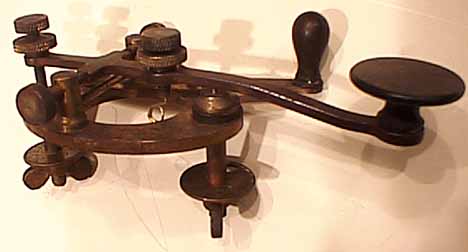
1370b Another view of the unusual leg key:(15KB)

1440 UNUSUAL BUNNELL SIDESWIPER MODEL 'G':(11KB)
Unique early Bunnell design in which the upright support is made of
insulating material. It looks very much like the standard Bunnell model "W"
so-called "double speed key" but has a very different design. Historian John
Casale-W2NI believes that it was named after Geohegan who worked for Bunnell
and probably invented it. Base engraved PATENTED JHBunnell & Co, New York
USA.

1441 BUNNELL "SIDESWIPER":(12KB)
This is the early Bunnell model "W" so-called "double speed key" supposedly
patented in 1888 and designed to overcome "telegrapher's paralysis" (Now known
as Carpal Tunnel Syndrome). Has the old style black insulators and a shorting
switch. Base engraved PATENTED JHBunnell & Co, New York USA. Historian John
Casale-W2NI has presented convincing evidence that this key was actually
patented after 1900.

1442 * BUNNELL SIDESWIPER:(10KB)
Similar to above.

1443 * BUNNELL SIDESWIPER:(17KB)
Similar to above.
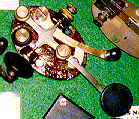
1450 * FOOTE PIERSON LEGLESS LAND LINE KEY:(13KB)
Steel armiture, Brass hardware and reddish painted cast iron base
with raised, cast-in lettering: "Postal Telegraph Company" Brass shorting
bar is engraved "Made By Foote-Pierson & Co. New York."
1451 FOOTE-PIERSON LEGLESS KEY: This looks like the Bunnell Triumph key
but shorting lever stamped FOOTE-PIERSON. Base stamped LEGLESS KEY,2-A,
W.U.TEL. CO.

1452 * LEGLESS TELEPLEX LAND LINE KEY:(6KB)
Cast iron base. No shorting switch. Mounted on bakelite base with
stick-on emblem "Manufactured by TELEPLEX, NewYork,N.Y.

1453 * LEGLESS TELEPLEX LAND LINE KEY:(21KB)
Similar to # 1452.

1454 * LEGLESS LAND LINE KEY:(9KB)
Cast Iron base and no shorting lever mounted on a wooden base. Unique
lever is made of two pieces of brass stock which have been riveted
together at the center where they cross.

1455 VERY UNUSUAL MULTIPLE CONTACT LEGLESS
LAND LINE KEY:(19KB)
This strange key has normally open and normally closed contacts
as well as multiple contacts which can be closed or opened by
moving the sorting switch lever left or right. I am looking for
more information on this key.
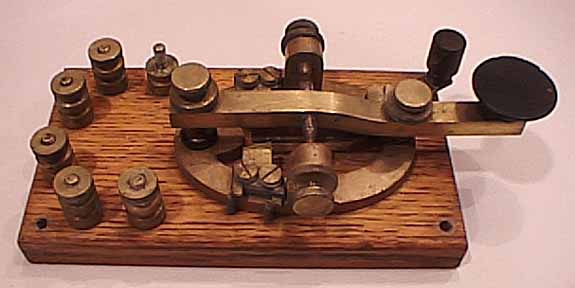
1455a Another view of the multiple contact
key:(21KB)

1456 WESTERN UNION 4B PANEL MOUNT TELEGRAPH KEY:
This key mounted on a panel. The shorting switch lever also extends through
the panel.
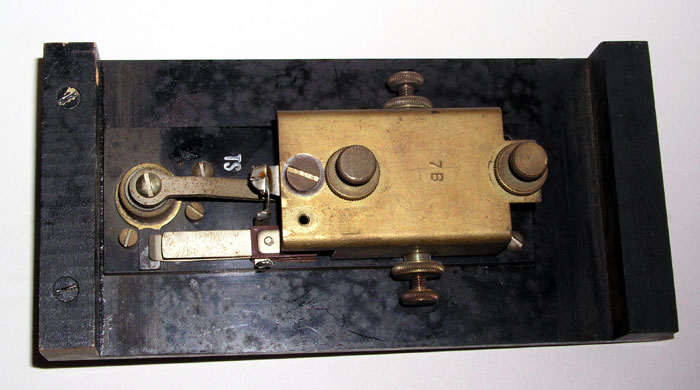
1456a Back view of the Panel Mount Key.
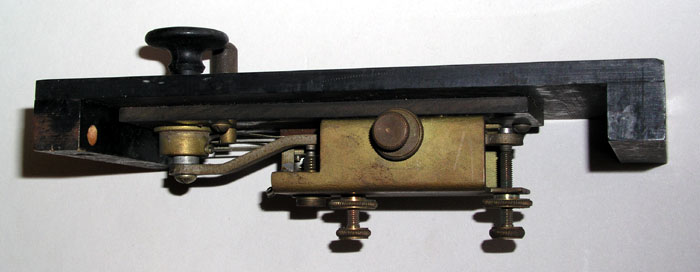
1456b Right side view of the Panel Mount Key.
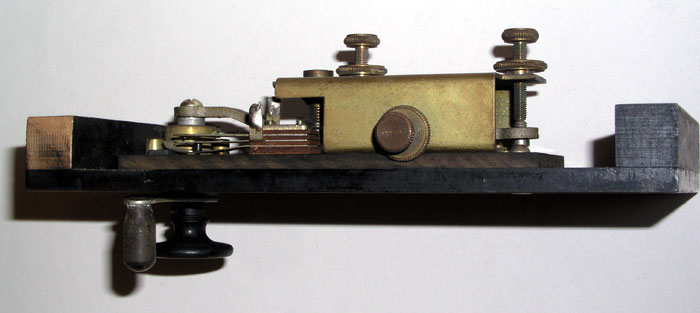
1456c Left side view of the Panel Mount Key.

1457 LEGLESS LAND LINE "POLECHANGER" KEY:(22KB)
With black bakelite base engraved "1-B W.U. Tel. Co. Mfg by Speis
Electric Works, Chicago". Plated brass construction mounted on heavy
black with plated three-pole changer switch.

1458 UNPLATED BRASS POLECHANGER KEY:(20KB)
Same as 1457 but unplated brass.
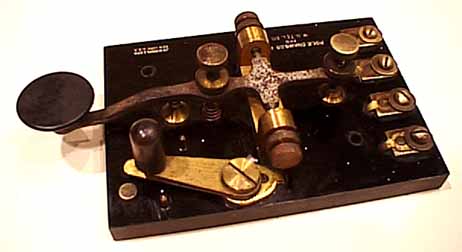
1458a Another View of the unplated polechanger
key:(18KB)

1459 * POLECHANGER KEY WITH OVAL BRASS BASE:(15KB)
Similar to 1458 but key has oval brass base.
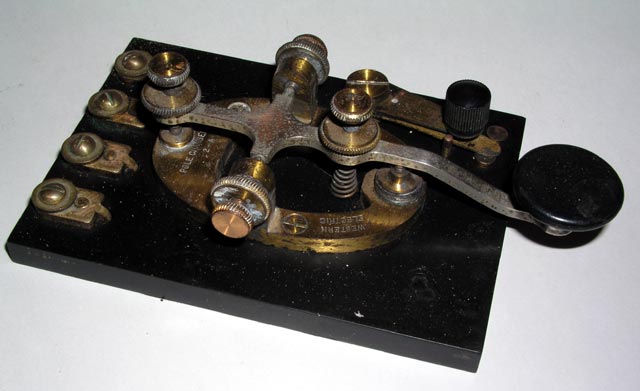
1459a * Another view of the Polechanger Key:

1460 BUNNELL LEGLESS LAND LINE KEY:(24KB)
Brass base engraved: "Mfg by JHBunnell, New York USA." Very early all
brass key with shorting switch and steel lever. The electrical terminals
are unusually well machined and are screwed to the brass base with fine
brass screws. Mounted on a wooden base.
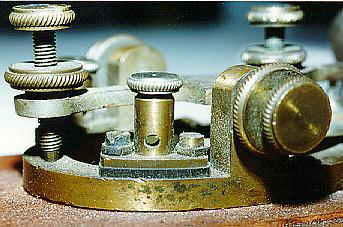
1460 A close-up view of the terminals:(28KB)
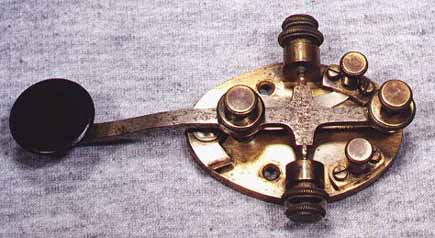
1460b ** HARD-TO-FIND EARLY BUNNELL
LEGLESS TRIUMPH KEY WITH SOLID BASE:(24KB)
This key is similar to number 1460 and has the very early
elevated terminals but it also has a solid brass base.
(In the John Casale - W2NI Collection.)
1461 LEGLESS land line key: Brass base engraved:"Mfg by
JHBunnell,NewYork USA." Also, barely visible under the "hot" terminal is
engraved: "POSTAL TEL CO. This is the very early "Triumph" key design
all brass key with shorting switch, steel lever, and early style
cylindrical electrical terminals.
1462 LEGLESS land line key: Brass base engraved:"Mfg by JHBunnell,
NewYork USA." The early "Triumph" key design all brass key with shorting
switch and cylindrical electrical terminals. The steel lever is
engraved "BUNNELL S".
1463 WESTERN ELECTRIC "LEGLESS" key: This all-brass key with steel
lever looks like a Bunnell "Triumph" key made for Western Electric.
Stamped"TELEGRAPH KEY 1A, AT&T CO." on the brass base & "WESTERN
ELECTRIC" on shorting bar.

1464 WESTERN UNION "LEGLESS" KEY:(8KB)
This all-brass key with steel lever looks like a Bunnell "Triumph" key
made for Western Union. Stamped "LEGLESS KEY,W.U.Co."

1465 CHAS CORY & SON - WESTERN UNION "LEGLESS"
KEY:(20KB)This is the classic Western Union Telegraph key.
The far end is stamped: Legless Key 2A Western Union. The shorting
lever carries the stamp: CHAS CORY & SON, NY which suggests that the
key was used by the Cory Company.
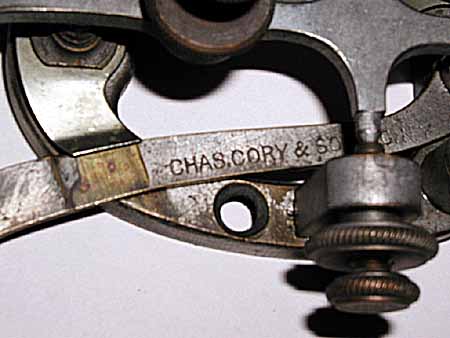
1465a Closeup of the CHAS CORY stamp:(25KB)

1466 * EARLY BUNNELL LEGLESS KEY:(9KB)
This key has black cast oval iron base with brass hardware and a steel
lever engraved "BUNNELL". It is mounted on an old wood base with screw
contacts stamped J.H.Bunnell Co.,NewYork U.S.A.
1468 LEGLESS LAND LINE KEY: Mfg by JHBunnell but labeled Western Electric
on the shorting lever and "A T & T Telegraph Key" on the all brass
base. This is the early "Triumph" key design all brass key with a steel
lever.

1469 LEGLESSS LAND LINE KEY:(7KB)
Same as above on wooden base.
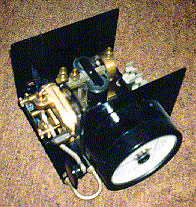
1470 * LEGLESS LAND LINE KEY,
SOUNDER, & TEST SET:(26KB)
Triumph Key as above mounted on a black metal bracket with Western
Electric zero center 10-0-10 milliammeter on front of bracket and brass
Western Electric sounder & other components inside bracket. (Traded to
John Casale - W2NI.)
1473 * LEGLESS land line key Mfg by JHBunnell but labeled Western Electric
on the shorting lever and "(H) A T & T Telegraph Key" on the brass
base. This is the early "Triumph" key design brass key with steel lever,
On a white marble base.

1474 * Same as above:(7KB)
Mounted on black bakelite base.
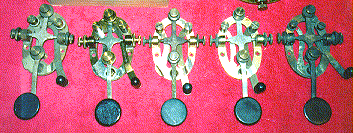
1475 * Same as above:(32KB)
Engraved"(N)AT&T Telegraph Key" on the brass base.Unmounted.
1476 * LEGLESS land line key Mfg by JHBunnell, New York, USA. The early
"Triumph" key design all brass key with cylindrical electrical
terminals.No shorting switch, and no identification on brass base.
Mounted on marble base.
1477 * LEGLESS land line key probably Mfg by JHBunnell, New York, USA. but
marked Manhattan Supply Co., New York on the brass base. This is the
early "Triumph" key design all brass key with tapered electrical
terminals, no shorting switch, and steel lever. This key was probably
manufactured for Manhattan Supply Co by Bunnell before they changed
their name to Manhattan Electric Supply Co.
1479 * LEGLESS land line key with shorting lever which is stamped
"Standard Electric Mfg. Co., Menominee, Mich". This key has a brass
base, shorting lever, and hardware with steel lever and shorting strap.
It is mounted on a marble base.

1480 * LEGLESS SIGNAL ELECTRIC COMPANY LAND LINE
KEY:(25KB)This is a typical steel-lever oval-based land line
key. It is mounted on a wooden base which displays the
Signal Electric Company Decal. Many of these keys were used
for training purposes.
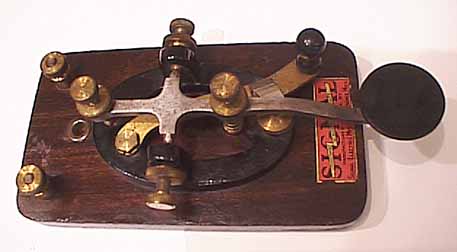
1480a Another view of the key:(16KB)
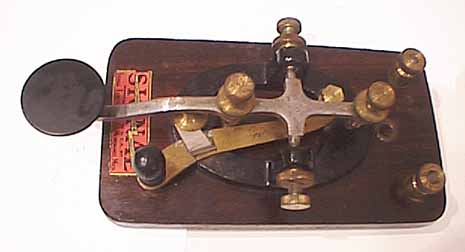
1480b A right side view of the key:(15KB)
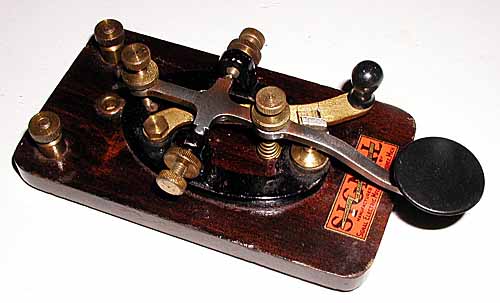
1480c Another similar Signal Electric Key:(27KB)
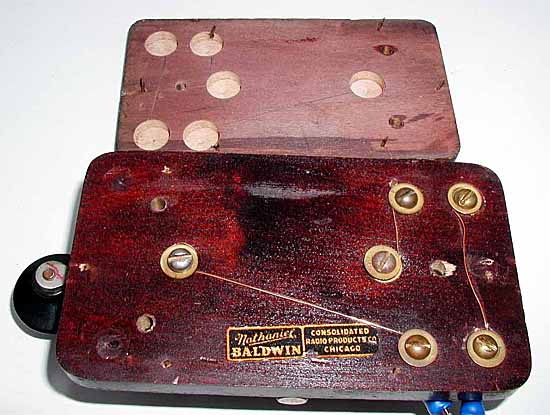
1480e A Signal Electric Key sold by NATHANIEL
BALDWIN:(47KB) This is a very unusual key. It is a typical Signal
Electric Legless Key but it carries the Nathaniel Baldwin-Consolidated Radio
Products Co. Chicago... label under its base and has a special second wooden
base which has been drilled out to make room for the contact screws and then
nailed to the underside of the key. The bindiing posts have been drilled out
to accept the pin jacks of a pair of headphones (presumably the Baldwin
Headphones.) The top of the key also carries the WW-2 US Army Signal Corps
insignia in red.

1481 * EARLY BUNNELL STRAIGHT KEY:(20KB)
Cast iron based key mounted on newer oak base.
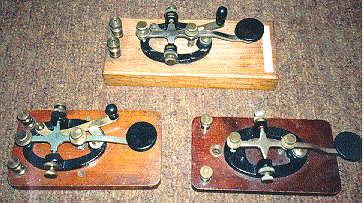
1482 * BRASS "MESCO" KEY:(51KB)
(Manhattan Electric Supply Company.)
1483 Same as above but steel lever stamped with military type number.

1484 * J.H.BUNNELL "TRIUMPH" KEY:8KB)
Brass key with steel lever stamped BUNNELL.
1485 * STRAIGHT KEY: Black cast base with cylindrical Bunnell style
terminals and "Triumph" style steel strap to 1/8" hot contacts. No
shorting lever or ID.
1486 * UNUSUAL LEGLESS KEY: This key has a black cast iron base with
chrome plated hardware and a steel lever. The bearings are screwed into
the bearing supports and locked in place with hex nuts. They have
slotted ends to accept a screwdriver.

1487 * UNUSUAL LEGLESS KEY:(14KB)
This key has a black cast iron base and chromed hardware. The
armiture is an almost straight 3/16" square steel bar with round
steel trunions press-fit through it like the early camelbacks.
The spring rests directly on the wooden base.

1488 * UNUSUAL LEGLESS KEY:(6KB)
This key has a black cast iron base and chromed hardware. The armiture
is an almost straight 1/4" square steel bar with round steel trunions
press-fit through it like the early camelbacks. The spring rests on a
round nubbin cast into the base.

1489 UNUSUAL LEGLESS KEY:(15KB)
This key has a black cast iron base and chromed hardware. The
unusual aspect of the key is that the trunnion supports have no
adjusting screws and the trunnion is simply inserted into each side.
This key is in quite rusty condition and its unusual design
suggests that few were made.
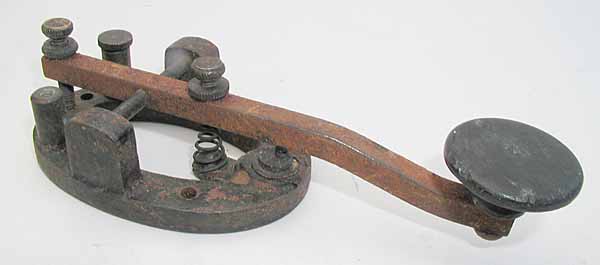
1489a Another view of the UNUSUAL LEGLESS
KEY:(15KB)

1490 VERY UNUSUAL DELANEY PATENT KEY IN ROUND BOX
USED FOR CONVEYING MORSE CODE OVER THE TELEPHONE:(51KB)
This device consists of a J.H.BUNNELL "Triumph" key mounted inside an
extremely well made 6" diam. circular wooden box. The metal label on
the outside reads "DELANY PATENTS 1270398 1274520". There are absolutely NO
electrical connections to the key which is entirely enclosed inside the
box with the exception of the end of the lever and knob which extend out of
the side of the box. The original 1917 patent sent to me by the well-known
telegraph historian and key collector Roger Reinke shows that this key was
placed underneath a candlestick telephone and that pressing the lever made a
mechanical clicking sound against the base of the telephone which could be
heard and read as morse code by the person on the other end of the telephone
line. This seems very funny since there was already voice communication with
the person on the other end of the line. Could it have been an early attempt
at providing secure communications that could not have been listened in upon
unless the eavesdropper knew the morse code? - But then, almost everyone knew
the morse code in those days. ??
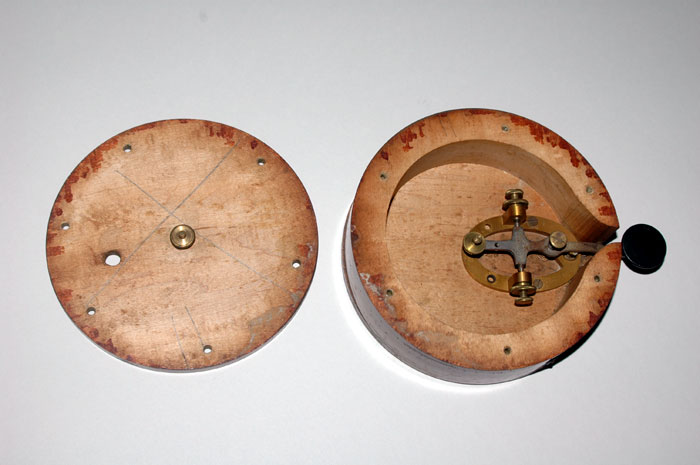
1490a The Telegraph-by-Telephone Key in its box:
(49KB)
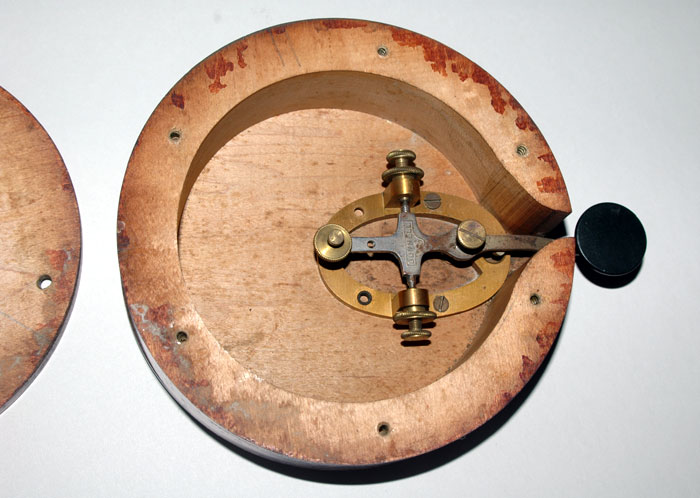
1490b A Closer View of The Telegraph-by-Telephone Key
in its box:(72KB)
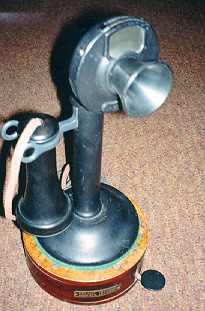
1490c The Telegraph-by-Telephone Key and a
candlestick telephone in operating position:(85KB)

1490d The Original Patent for the Telegraph-by-Telephone
Key:(183KB)

1495 TINY WESTERN ELECTRIC TELEGRAPH KEY:(35KB)
These tiny keys have a nice action and are often used by telegraph
operators who need an extremely small key. The keys have metal shorting
levers and knobs numbered from 1 to 4. Originally, they all came from a
Western Electric Telegraph Line Test Set. (See 1495b below). These
test sets are of no practical use these days and most have
been discarded after the keys were removed.
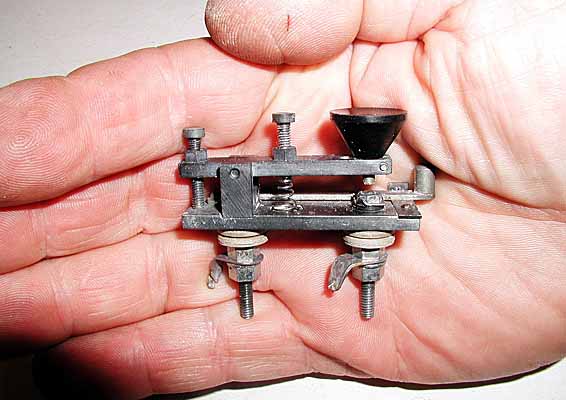
1495a Closeup of Western Electric Mini-Key:(35KB)
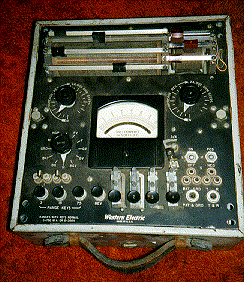
1495b * WESTERN ELECTRIC TEST SET &
TINY KEYS:(40KB)
PLEASE SEE PART II FOR CONTINUATION:
Internet ENIGMA Museum:
https://EnigmaMuseum.com
COPYRIGHT NOTICE: (Copyright (c) 2023: Prof. Tom Perera Ph. D.)
Although all the pictures and text are copyrighted, you may use any of them
for your own personal applications including public lectures and
demonstrations, publications and websites as long as you mention the
w1tp.com Museum. If you plan to offer them for sale to the public
in any form, please email me for permission which I will generally grant as
long as you mention my museum: http://w1tp.com or https://EnigmaMuseum.com My email address is
given at the bottom of this page. Some of the material may require contacting
other copyright owners for commercial use and I will inform you by email.
Please also see the Disclaimer of Warranty.
KEYS (1001-1500), KEYS & SOUNDERS (1501-2000), SOUNDERS (2001-2500),
REGISTERS, RELAYS, & OTHER (2501-3000)
(The instruments are in approximate chronological order: Oldest first.)
* = (Items no longer owned.) ** = (Items in other collections.)
Part II:
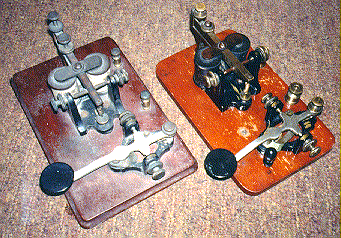
1505 STEEL LEVER KEY KOB:(60KB)
Made just after the camelback era. Has no spring adjusting screw.
Cast iron base key with shorting switch engraved J.H.Bunnell & Co New
York. Arm engraved "Patented Feb 15, 1881". Mounted on wooden base
with J.H.Bunnell & Co, New York USA 20 ohm sounder.

1507 STEEL LEVER KEY KOB:(41KB) As above but
has no stamping on key or sounder.

1508 STEEL LEVER KEY KOB:(45KB) As above but
has no stamping on key or sounder.

1520 UNUSUAL PROTOTYPE/EXPERIMENTAL ALUMINUM-LEVER KEY
KOB:(10KB) This is a classic early Bunnell KOB with an unusual
ALUMINUM KEY LEVER. I believe that this lever was made by the
Bunnell Company in an attempt to study the advisability of
making Aluminum-Lever Keys. They could have thought that the
lighter-weight Aluminum might give a potentially faster action.
There is an old-style steel trunnion pin press fit into the Aluminum lever
which leads me to believe that this is an early experimental key. The
press-fit steel trunnion pin was abandonned when the all steel
lever triumph key was invented in 1881. The steel trunnion pin
was known to come loose with extended use and it would then allow
the key lever to slide left and right making the key useless.

1540 J.H.BUNNELL "COMMEMORATIVE MINIATURE SOUNDER:(12KB)
This unique and fully functional Bunnell Miniature Sounder was
presented to each of the guests at a dinner in honor of Andrew
Carnegie in 1908. The dinner was held to celebrate his "73rd"
birthday and was attended by hundreds of important people including
Thomas Edison and many members of the Civil War Military Telegraph
Corps including four members who had actually received his call for
volunteers over the telegraph lines in 1861. The dinner concluded
with the singing of "Auld Lang Sine" by Samuel Morse's Grandaughter.

A special brass plaque:(9KB)
on the bottom of the sounder reads: TELEGRAPHER'S DINNER in honor of
ANDREW CARNEGIE, Hotel Manhattan, New York, November 27, 1908.
The plaque also has a big "73" engraved on it over the other writing.
It was reported that each guest had one of these sounders at his place
setting and that the host sent messages to his guests' sounders in
code.

1550 J.H.BUNNELL MINIATURE KEY and 1551 SOUNDER:(60KB)
This is the tiny brass Bunnell miniature key with the ring for
attaching it to a watch chain. The steel lever is stamped
J.H.Bunnell, N.Y. Oval brass base measures 1" long. These keys
are fully functional and were sold either plain or with a ring or
pin. It is mounted on a small wooden board with the #1551 sounder.
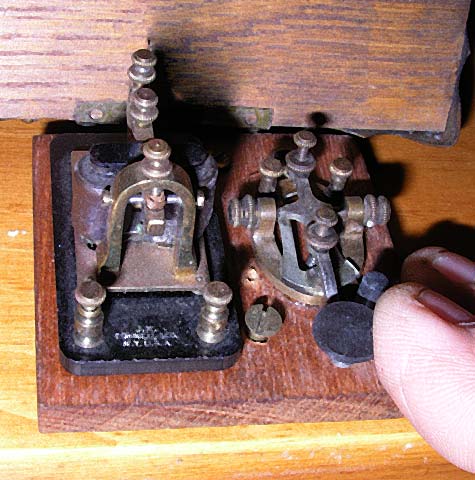
1550a Another view of the J.H.BUNNELL MINIATURE KEY and
SOUNDER:(48KB)
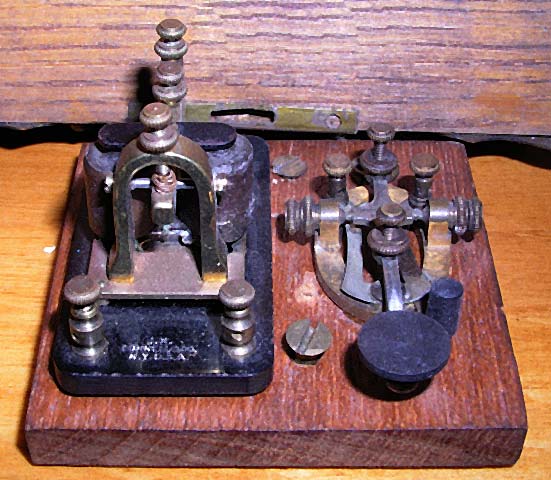
1550b Another view of the J.H.BUNNELL MINIATURE KEY and
SOUNDER:(57KB)
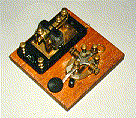
1550.gif J.H.BUNNELL MINIATURE KEY and 1551
SOUNDER:(11KB)

1551 J.H.BUNNELL MINIATURE
KEY:(34KB) This is the tiny Bunnell key with the ring for attaching it to a
watch chain.
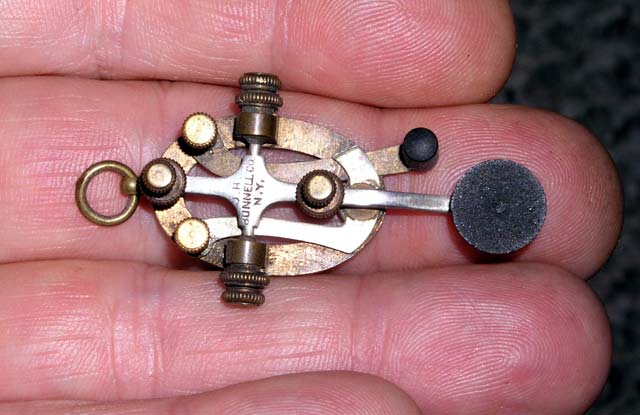
1551a Another view of the Bunnell
Miniature Key:(38KB)

1552 J.H.BUNNELL MINIATURE KEY AND
SOUNDER:(44KB)This is the tiny Bunnell Miniature Key and Miniature
Sounder with 1-1/8 inch long brass base mounted on a black base stamped
J.H.Bunnell & CO. New York, USA. It is fully functional.
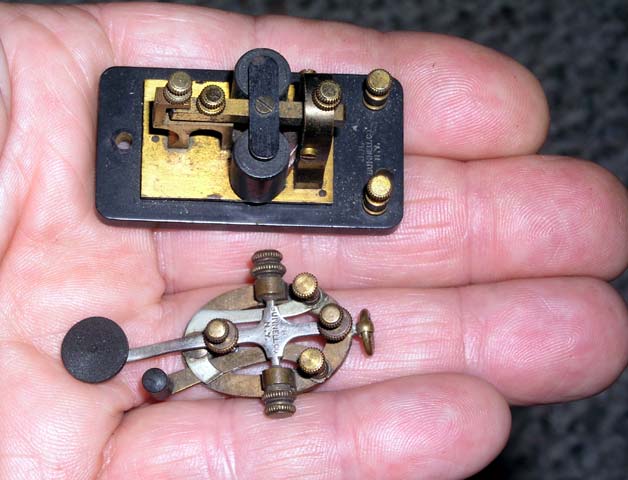
1552a Another view of the Bunnell
Miniature Key and Sounder:(43KB)

1553 J.H.BUNNELL MINIATURE SOUNDER:(34KB) This is the
tiny Bunnell Miniature Sounder. It is fully functional and all adjustments
work.
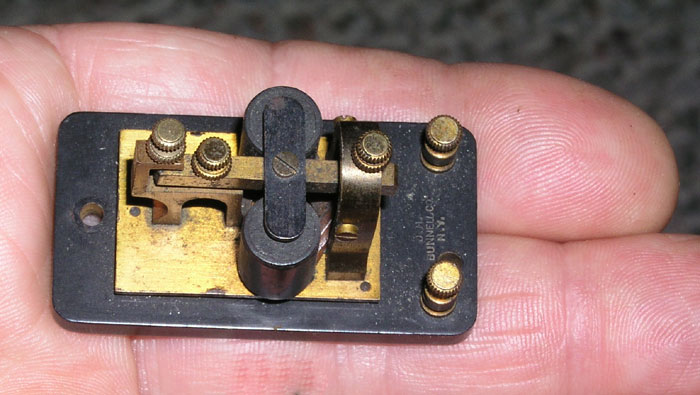
1553a Another view of the Bunnell Miniature
Sounder:(38KB)

1555 ** NEW MANUFACTURE BUNNELL MINIATURE KEY &
SOUNDER:(37KB)This miniature Bunnell KOB is being offered by
Dr. Joe Jacobs who is now the owner of the J.H.Bunnell Co.
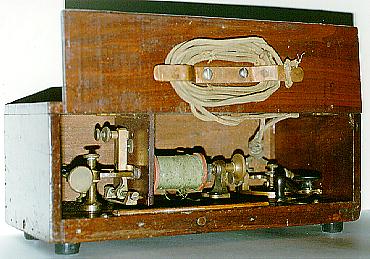
1575 * BUNNELL "Trainmaster" PORTABLE
RESONATOR-BOXED KEY & SOUNDER:(31KB)
This unique portable telegraph set consists of a resonator box with a handle
and a brass "BUNNELL 160 OHMS" label on top, an unboxed box sounder, and
a modified Bunnell steel-lever key.

The closed box looks like this:(31KB)
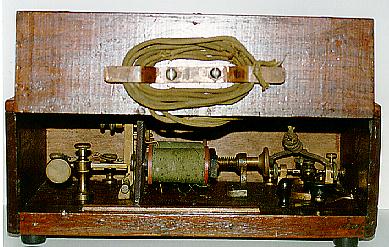
Another view of the inside:(34KB)
showing the steel-lever Bunnell key on the right, and the unboxed
box-sounder on the left as well as a place to coil the wires in the cover.
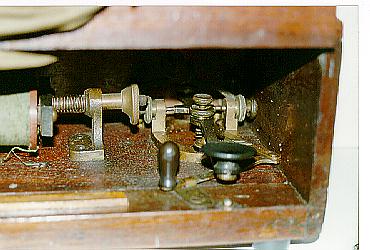
The key has an unique additional bar
riveted to the shorting bar:(25KB)
That allows the shorting bar to be operated from the left side of the key.
This is necessary because of the restricted space inside of the box.
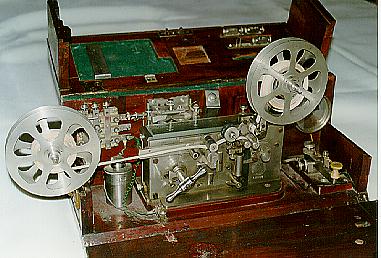
1700 WESTERN ELECTRIC-MILANO PORTABLE BOXED
REGISTER, KEY, SOUNDER, METER, BELL, SWITCHBOARD ETC:(25KB)
This is a complete ink-writing portable telegraph set consisting of
a miniature ink register with folding paper tape reels, an Italian style
telegraph key with Ivory knob, an unique sounder that rings a bell, a
plug-style switchboard, and ink well, an ink applicator, with fitted pliers
and accessories for field use.

The 8" x 7" x 20" brass edged wooden box:(22KB)
has brass reinforcements around all edges. A brass label in the center
reads 284. Another brass tag in the front left reads MATR 92 21-72.
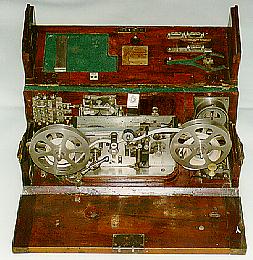
This view shows the register with
its arms folded:(34KB)
The set is obviously designed for field use with all metal parts plated.
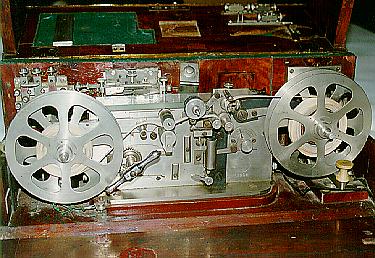
This close-up view shows the ink register:(31KB)
which is stamped WESTERN ELECTRIC ITALIANA-MILANO. Telephonici-telegrafici
Societa anonyma. Number 15998.
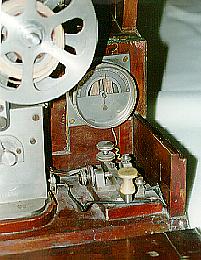
This close-up view shows the early telegraph
key:(19KB)
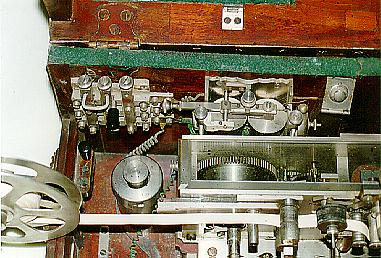
This close-up view shows the sounder/bell
and switchboard:(42KB)

1720 TWO CLASSIC GERMAN SIEMENS KEY-REGISTER
SETS:(28KB)These sets were the most widely used telegraph
stations in Europe. They were found in every town telegraph
office across the continent. They consist of a telegraph key, ink-writing
register, and galvanometer which measured the electrical condition of
the telegraph line. A roll of paper tape is stored in a
special drawer in the wooden base. Ink writing registers were required
because it was illegal to copy Morse Code by ear since that method
was not thought to be reliable.
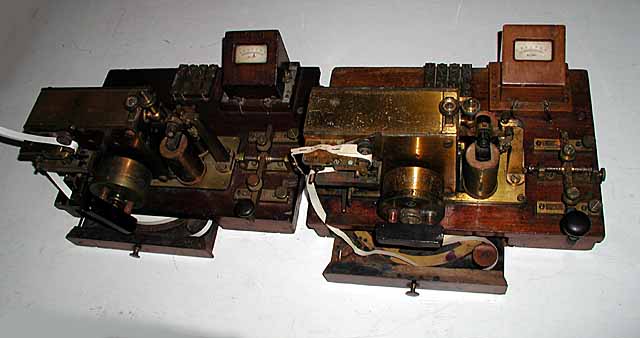
1720a Another view of the two sets:(30KB)

1730 * BRITISH SIEMENS BROTHERS KEY-REGISTER SET
WITH UNIQUE SOUNDER-OPERATED REGISTER:(18KB)
This interesting set is typical of those used throughout Europe where
copy-by-ear using sounders was not trusted. The set is labeled: Siemens
Brothers & Co. London. No. 17022. and there is a tag on the unique
sounder mechanism which reads: A. E. Co. Ltd. A.T.M. Liverpool.
A roll of paper tape is stored in a drawer under the register.
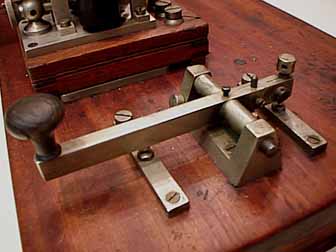
The key:(16KB) is a typical straight-lever
European style key.
The ink-writing register is operated by an
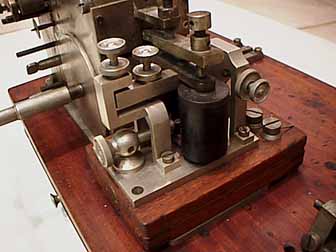
Unique Sounder Mechanism:(19KB) which is directly coupled
to the Register mechanism.

1745 CZECH REGISTER PROBABLY MADE BY SIEMENS:
(26KB) The Siemens company of Germany made most of the registers
used in European telegraph offices.
Some of these registers were labeled with other names.
This one carries CZECH identification marks which read:
FRANTISEK, STEPANEK, & SPOL, V SPOLECNOST S.R.O, v PARDUBICCICH and the
number 195. Pardubice is a town in eastern Bohemia that was part of the
Austrian Monarchy, later a part of Czechoslovakia and now in CZECHIA (the
Czech Republic).
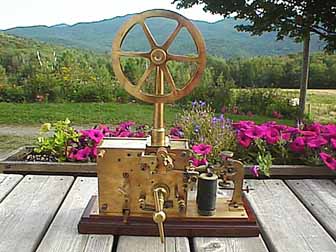
1745a Another view of the Russian Register:
(26KB)
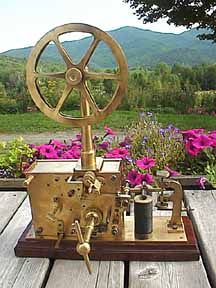
1745b Another view of the Russian Register:
(26KB)
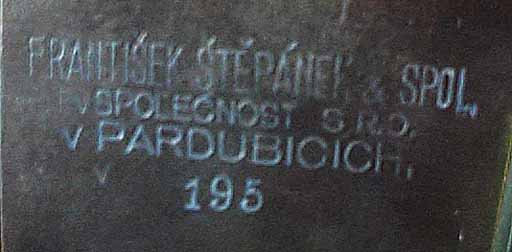
1745c A view of the Russian Register which shows the
makers name:(26KB)

1747 AUSTRIAN EMBOSSING TELEGRAPH
REGISTER: (26KB) This is an early Embossing Telegraph Register made in
Vienna, Austria. It is marked: CZEIJA NISSL, WIEN, 769. Embossing registers
recorded dots and dashes on a moving paper tape by pressing a sharp point into
the tape. The sharp point 'embossed' a depression into the paper tape.
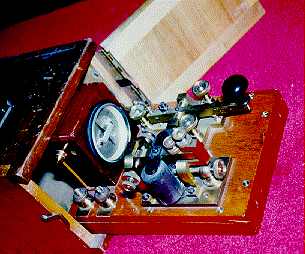
1755 BRITISH GPO KEY-SOUNDER-GALVANOMETER:(40KB)
Huge all brass key Engraved M.W.T.Co. Ltd. 372. 1915, and sounder
engraved G.P.O.16830 and Galvanometer Engraved EDISON & SWAN,
No. 18220. 1917, mounted on wooden base and fitted into wooden
box with brass handle.
Historian and collector Neal McEwen K5RW has researched this unit
and reports that it is properly called a 'direct working
single current intermediate baseboard set.' He traced out the
schematic and found that the sounder is in the circuit only
on receive. The sounder is out of the circuit on send. The
telegraphist apparently watched the galvanometer or listened to
the galvanometer needle ring as the needle hit the stops to
monitor his sending. The galvanometer is in the circuit on
both send and receive so the telegraphist can see the
galvanometer even if the sounder is mal-adjusted.
Neal believes that the galvanometer started out as a traditional
''Q and I'' detector, which is an application of galvanometer
technology for linemen to check bateries, find faults, etc. It
measures relative current, not absolute current. The Q and I
detectors were turned into galvanometers for use on the baseboard sets.
On Neal's galvanometer he can see the original Q and I connections
that have been puttied up.
Neal believes that these sets were made for the British Army
and that the traditional single current galvanometer was too big
to make the set portable. Hence the small galvanometer made from
the Q & I meter.
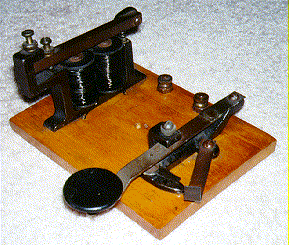
1810 * ADAMS-MORGAN (AMCO) KEY & SOUNDER
ON BASE (KOB):(35KB)
This small and simple practice set was described in a book of
do-it-yourself projects. It is surprising to see one that was
commercially manufactured with the letters AMCO enclosed in a diamond
outline stamped on the base. The key and sounder are very simple but
the unusual sounder has its two coils lined up under the armiture.>>W2PM

1825 * "MOTLEY" TELEGRAPH KEY AND SOUNDER ON BASE
(KOB):(22KB)
This brass KOB carries 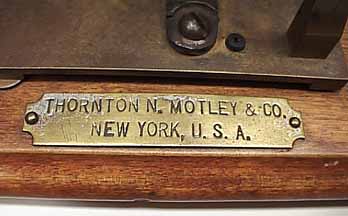
a label:(18KB)that reads:
THORNTON N. MOTLEY & CO., NEW YORK, U.S.A.
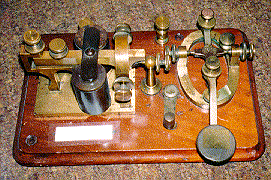
1830 * TELEGRAPH KEY AND SOUNDER ON BASE (KOB):(36KB)
Early brass key and sounder on wooden base Key and sounder stamped
J.H.Bunnell & Co., New York. Key stamped Patented Feb 15, 1881 on steel
lever. Sounder is old horizontal spring design. Has brass switch lever
on base.
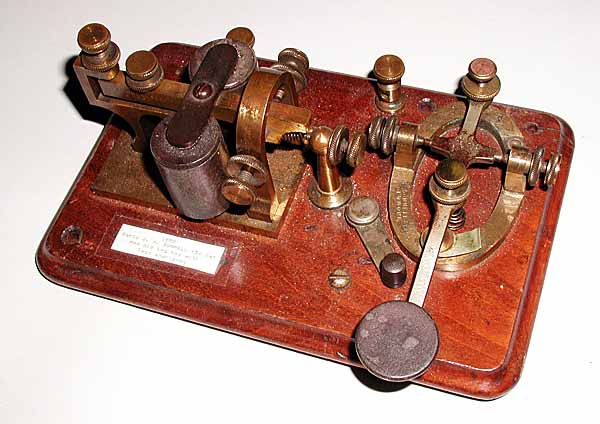
1830a Another view of the KOB:(45KB)
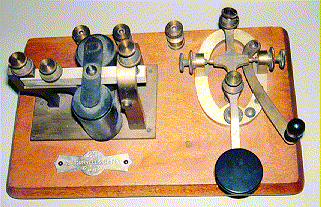
1832 * Same as above:(40KB)
with vertical spring sounder w/aluminum armiture. No switch.
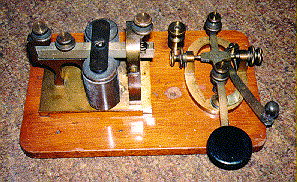
1834 * Similar to above:(39KB)
but key stamped "MESCO". No ID on sounder. Has switch.

1836 VERY PRETTY BUNNELL KEY AND SOUNDER ON BASE
(KOB):(38KB)This is an unusually attractive and clean Bunnell
KOB with 20-ohm sounder.
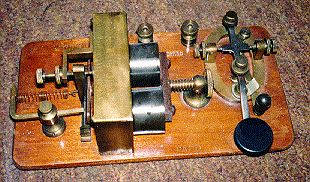
1838 * TELEGRAPH KEY AND ''SNARE-DRUM''
SOUNDER ON BASE (KOB):(42KB)
Early brass hardware key with black cast base, steel lever and shorting
switch on a wooden base. Sounder is early "Snare-Drum" style. Base
stamped J.H.Bunnell Type 220, 35-Ohms.

1839 * TELEGRAPH KEY AND ''SNARE-DRUM''
SOUNDER ON BASE (KOB):(17KB)
Similar to 1838 above.
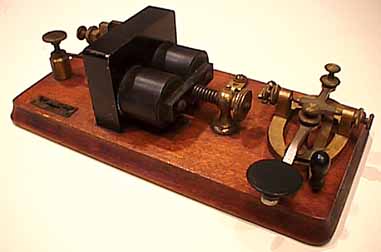
1839a Another view of the Snare-Drum set:(15KB)
1840 * TELEGRAPH KEY AND SOUNDER ON BASE (KOB): Early brass hardware key
with black cast base and steel lever and shorting switch on a wooden base.
Sounder stamped J.H.Bunnell & Co, New York U.S.A.
1842 * Same as 1840 above.
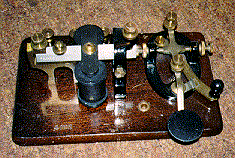
1844 * Same as above:(27KB
but sounder stamped "Manhattan Electric Supply Co.New York".
1846 Same as above but sounder stamped "MESCO".
1848 Same as above but key & sounder stamped"Signal Electric
Co.Menominee,Mich".

1849 Same as above but unmarked:(46KB)
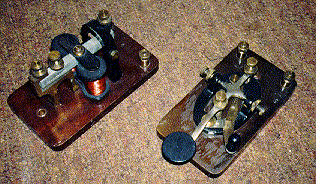
1850 * Same as above:(40KB)
but key and sounder both mounted on individual wooden
bases and stamped "Signal Electric Mfg. Co., Menominee, Mich".
1852 * Same as above but key only on its wooden base and not stamped.
1854 * Same as above but key only on wooden base & not stamped.No shortg
switch.

1860 * SKIRROW-POSTAL TEL CO KEY AND SOUNDER ON
BASE (KOB):(20KB)
Very early steel lever brass key and unique diagonal-frame
magnetic-flux-adjustable sounder on wooden base stamped
"Postal Tel Co. 150 ohm. Number 1428. SKIRROW PAT Dec. 10, 1901.
(Postal Telegraph Company owned the "Skirrow" patent which involved
the use of a rack-and-pinnion mechanism to adjust the coil-to-armiture
distance to allow the sounder to be made more or less sensitive to
the tiny currents on long telegraph lines.
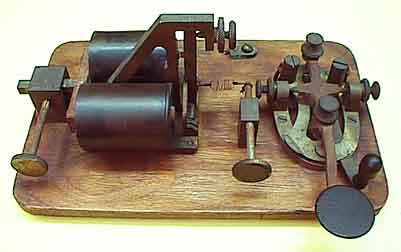
1860A * SKIRROW-POSTAL KOB:(16KB) similar to 1860.
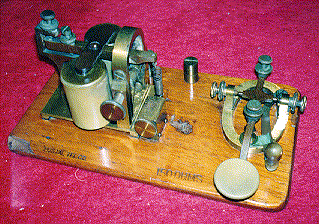
1861 * POSTAL TEL CO KEY AND SOUNDER ON BASE (KOB).(48KB)
Vy early steel-lever brass Bunnell key & Large Bunnell main-line sounder
with the unique cam operated magnetic flux adjustment mechanism.
Base stamped: "POSTAL TEL CO. 150 OHMS.
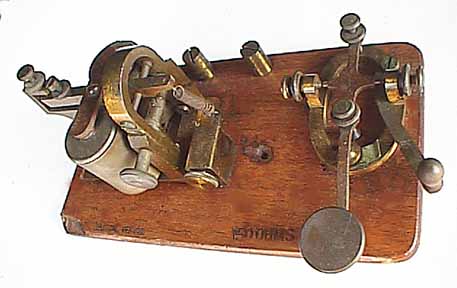
1861a Another view of the Skirrow-Postal KOB:(22KB)
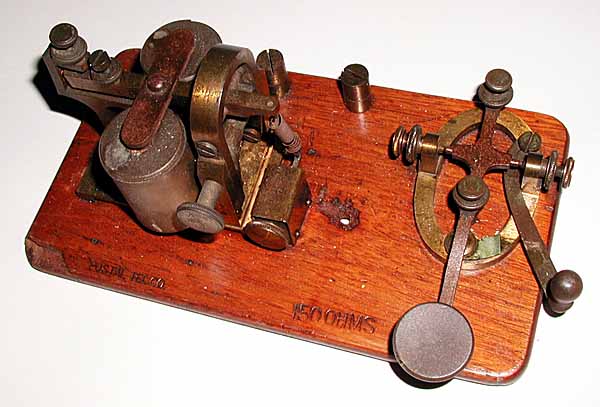
1861b Another view of the Skirrow-Postal KOB:(42KB)
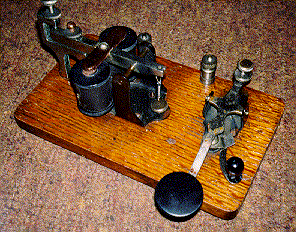
1862 * BEEKO-LIKE LEARNER'S KOB SET:(47KB)
Interesting early set with chromed key lever without spring adjusting
screw held in bent sheet metal base. Has chromed shorting switch that
looks a little like a McElroy design. The sounder has a sheet metal
base but chromed lever and anvil. Oak base.
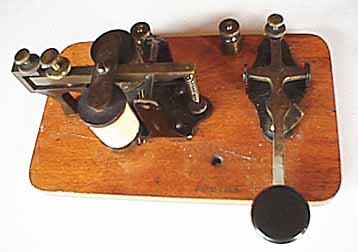
1862a Another view of the Beeko-Like KOB Set:(15KB)

1863 * BEEKO SEPARATE COMPONENT KEY AND SOUNDER
SET:(18KB)
Typical key and sounder set. The key is mounted on a separate wooden
base and has a steel key lever and no spring adjusting screw. The
lever is supported by a bent sheet metal base. The sounder also has
a sheet metal base. Many thousands of these sets were produced butg
they were so toy-like that most were eventually thrown out making
it more difficult for collectors to find them.
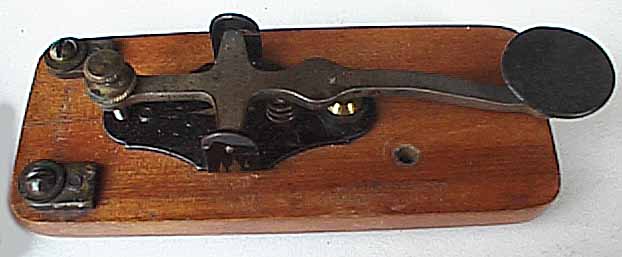
1863a A view of the Beeko key alone:(21KB)
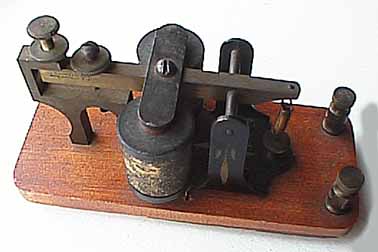
1863b A view of the Beeko sounder alone:(16KB)
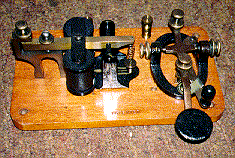
1864 * TELEGRAPH KEY AND BEEKO SOUNDER ON BASE
(KOB):(27KB)
Early brass hardware key with black cast base and steel lever and
shorting switch on a wooden base. Sounder has very simple design with no
bearing adjustments and sheet metal frame. It is stamped J.H.Bunnell &
Co, New York U.S.A.
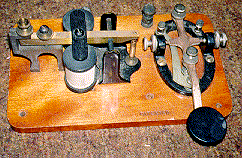
1866 * Same as above:(28KB)

1865 BEEKO TELEGRAPH KEY AND SOUNDER ON BASE
(KOB):(42KB)This is the classic BEEKO practice set made by
Bunnell. Both the key and the sounder have simple sheet metal
frames making this set very inexpensive to produce and sell.
1868 * SIGNAL ELECTRIC CO. KOB SET: All-brass key with steel lever
& Signal Electric Co. style sounder with armiture simply
stamped"MENOMINEE".
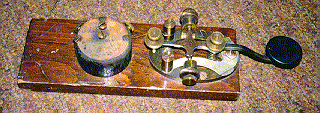
1870 * TELEGRAPH KEY AND BUZZER ON BASE:(27KB)
Very early brass hardware key with steel lever mounted on a wooden base
with a very early wood encased buzzer.
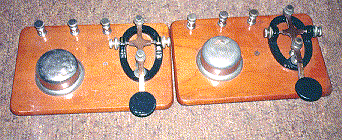
1872 * TELEGRAPH KEY AND BUZZER ON BASE:(32KB)
Brass hardware, steel lever key with black cast iron base mounted on a
wooden base with a round chrome buzzer.
1874 * Same as above.
1875 * TELEGRAPH KEY AND BUZZER ON BASE:(13KB)
Similar to 1872.
1876 * Same as above with unenclosed brass buzzer.

1877 * TELEGRAPH KEY AND POCKET WATCH STYLE
BUZZER ON BASE:(18KB)
This cast iron base key has been mounted on the same base as an
old pocket watch style buzzer.
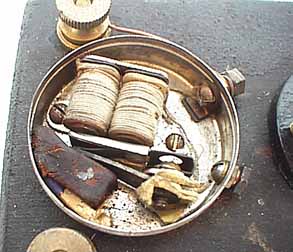
1877a A close view of the pocket watch style
buzzer with cover removed.(23KB)
RESONATORS:
The 'RESONATOR' is a wooden box which channels and
acoustically amplifies the sounds made by a sounder to help
an operator to hear the clicking sounds. The typical resonator is
made of 3/8-inch thick cherry or similar wood.
If you would like to build one, the dimensions are as follows:
The base is 6-7/8 inches wide and 4-7/8 inches deep overall.
The height of both the back wood panel and of the front edge
up to the peak is 7-7/8 inches.
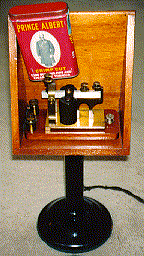
2030 SOUNDER IN CANDLESTICK-BASE RESONATOR:(23KB)
The resonator is mounted on a metal candlestick phone style base.
The sounder is marked MANHATTAN ELEC SUPPLY CO, NEW YORK.
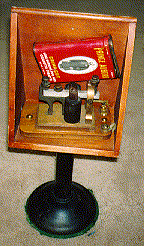
2031 *, 2032 * Same as above:(23KB)
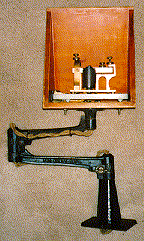
2035 SOUNDER IN SWING-ARM MOUNTED RESONATOR:(20KB)
Resonator is mounted on a two section adjustable cast iron arm with
screw down base. Sounder is Bunnell.
2040 * SOUNDER IN RESONATOR. Resonator is roughly constructed on a wooden
upright base and looks home made. Sounder is Bunnell.

2050 * GEOHEGAN PATENT BUNNELL SOUNDER:(15KB)
This sounder has two special adjustments to allow its sensitivity
to be adjusted so that it could respond to weak incoming signals.
First, there is a cam which is activated by the round brass
wheel on the vertical frame and which adjusts the coil-core to
armiture spacing. Second there is a knob activated adjuster
which allows the spring tension to be adjusted very precisely.
2051 SOUNDER: * Very Large brass sounder on a wooden base. Sounder
engraved "J.H.Bunnell & Co, New York. Patent applied for".
2052 SOUNDER: * Large brass sounder on a wooden base. Sounder engraved
"Patented in U.S.A. March 6, 1917". and "J.H.Bunnell & Co, New York.
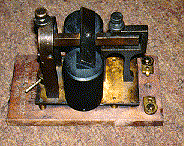
2054 * MAIN LINE SOUNDER:(19KB)
Large brass sounder on a wooden base. Sounder engraved Western
Electric. Base engraved W. U. Tel. Co. Main Line Sounder 3B(?) 20 ohms.
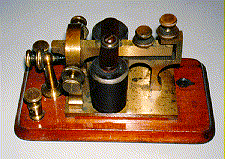
2056 * SOUNDER:(22KB)
This is a very old style medium size brass sounder mounted on a wooden
base stamped 20. The sounder has an interesting horizontal spring and
is engraved J.H.Bunnell & Co, New York.
2058 * SOUNDER: Medium size brass sounder on a black wood base. Base
labeled "Western Electric Company" & stamped "20 ohms" on top &12519(H)
on bottom.
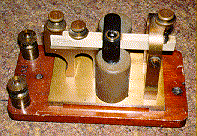
2060 * SOUNDER:(20KB)
Medium size brass sounder on a black wooden base. Sounder engraved
"Western Electric". Base engraved "SOUNDER 3B 20OHMS".
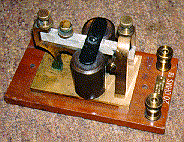
2062 * SOUNDER:(19KB)
Medium size brass sounder. Wooden base.Sounder engraved "Western
Electric".Base labeled "Western Electric Company" and stamped "20
OHMS(H)"
2064 * SOUNDER: Medium size brass sounder on a wooden base. Sounder
engraved "Manhattan Electric Supply Co. New York". Base engraved "20
OHMS".
2066 * SOUNDER: Medium size brass sounder. Wooden base. Sounder engraved
"SIGNAL"

2080 * VERY UNUSUAL SOUNDER:(16KB)
The lever of this sounder is separated from the iron armiture
by an adjustable spring mechanism. The separation distance and
the spring tension can be adjusted by the knob on top
of the sounder.
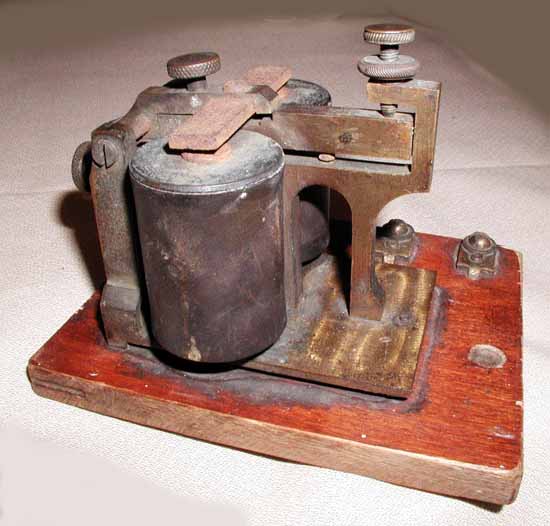
2080a * A closer view of the Unusual
Sounder:(37KB)

2095 * VERY UNUSUAL SOUNDER MECHANISM:(16KB)
This strange sounder looks as though it was made to fit into
some larger wooden structure.

2100 UNFINISHED SOUNDER MECHANISM:(17KB)
This sounder was never assembled nor varnished. It gives us an
idea of what sounders looked like during the assembly process.
2255 * BRITISH GPO SOUNDER: Sounder like the one in the
combination set number 1755. This sounder is mounted
mounted on its own wooden base.
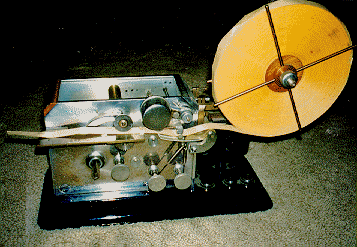
2520 MORSE REGISTER made by FOOTE PIERSON & Co:(45KB)
With chromed case and glass encased brass movement. Spring mechanism
starts when character is received. With roll of original paper tape.
Case stamped FOOTE PIERSON & CO. NEWARK, NJ. F-5570 F-2.
2525 * MORSE REGISTER: as above but with brass case and beveled glass-
encased brass movement. Case stamped FOOTE PIERSON & CO. 160-162 Duane
St., New York. 10243.
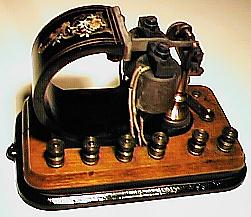
2550 * EARLY BUNNELL CURVED POLAR RELAY:(17KB)
Lovely flowered curved magnet polar relay on large wooden base.
(Traded to John Casale - W2NI.)
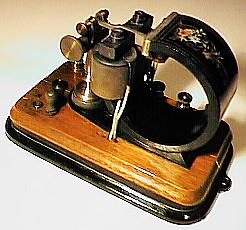
Another view of # 2550(17KB)

2553 * UNUSUAL EARLY BUNNELL RECTANGULAR
POLAR RELAY:(19KB)
This is an unusual rectangular box-shaped polar relay made by
J. H. Bunnell.
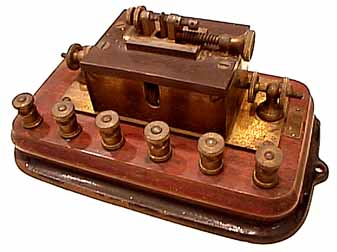
2553a Another view of the Bunnell polar relay:(19KB)
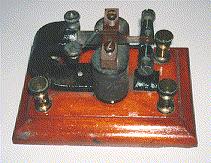
2555 * EARLY CURVED POLAR RELAY:(19KB)
Unique curved frame.Smallish wooden base stamped 60 ohms.>>W2PM

2557 * WESTERN UNION POLAR RELAY:(20KB)
This polar relay was used in duplex and multiplex circuits
which allowed several signals to be carried simultaneously
on the same wires.
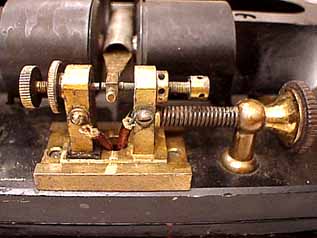
2557a A closer view of the contacts:(19KB)

2558 * JESTER-COOPER REPEATER RELAY:(15KB)
This repeater/relay was used in duplex and multiplex circuits
which allowed several signals to be carried simultaneously
on the same wires. The label reads: J-C Repeater System,
Patent No. 1,116,591. Ohms, 250. Type D. Serial-661. Jester
Cooper Company, Houston, Texas.
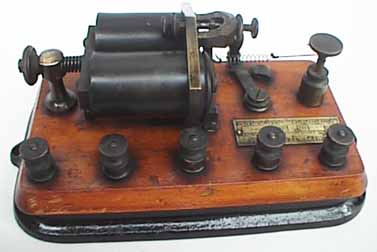
2558a A different view of the repeater:(15KB)
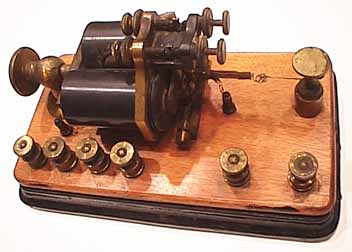
2559 * BUNNELL REPEATER RELAY:(19KB)
This repeater/relay was used in duplex and multiplex circuits
which allowed several signals to be carried simultaneously
on the same wires.
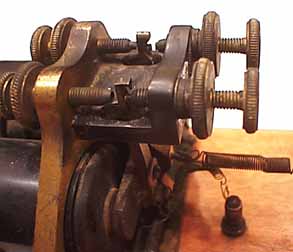
2559a A closer view of the special contacts:(15KB)
2560 * EARLY TELEGRAPH LINE RELAY OF UNUSUAL DESIGN. All brass relay with
unusually large vertical coils with large adjusting screw and odd design
on wooden base on cast iron base.

2562 * UNUSUAL REPEATER RELAY:(16KB)
This small repeater/relay was used in duplex and multiplex circuits
which allowed several signals to be carried simultaneously
on the same wires.
2565 * EARLY TELEGRAPH LINE RELAY OF UNUSUAL DESIGN. Medium size all brass
relay with curved iron armiture and string-spring tensioning. (50 Ohms).
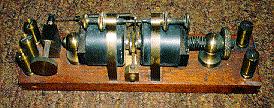
2570 * SMALL POLAR-LIKE TELEGRAPH LINE RELAY:(23KB)
Very unusual small relay with two coils pulling on a shared armiture which
is adjustably tensioned by a spring/string. One coil can be moved toward
and away from the armiture. The wires in the wooden base are sealed in
beeswax. Old cylindrical terminals. * TRADED OUT: 1995.
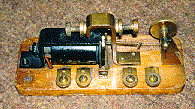
2575 * TELEGRAPH RELAY:(17KB)
Unusual small brass relay on wooden base stamped "MFD by L.F.C., SIGNAL
RELAY 3-D on top and N.Y.R.S.4-29 on bottom.
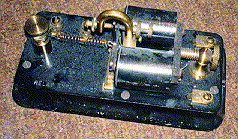
2580 * TELEGRAPH RELAY:(24KB)
Large Brass relay on black bakelite and metal base which is inscribed
"RELAY TYPE SW-37".

2581 * WESTERN UNION 4-D TELEGRAPH RELAY:(18KB)
Large plated relay on black bakelite and metal base which is inscribed
''WU TEL CO. MORSE RELAY 4-D. 100 OHM.''

2582 * WESTERN UNION 22-A TELEGRAPH RELAY:(18KB)
Large plated relay on black bakelite and metal base which is inscribed
''WU 22A''
2585 * TELEGRAPH RELAY: Large Brass relay on wood and metal base which is
inscribed "Signal Electric Co. Menominee, Mich 150 ohms".

2588 LARGE BUNNELL TELEGRAPH RELAY:
Large Brass relay with very large coils mounted on wood and metal base. The
shape of the frame has led people to also refer to this as a 'spectacle relay'
since the coil supports resemble a pair of spectacles. Labeled: J.H.Bunnell
& Co. N.Y. 250 ohms.
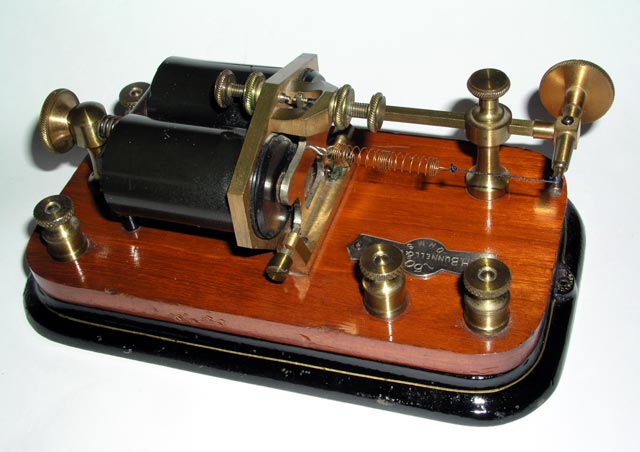
2588a Another view of the Bunnell Telegraph Relay:
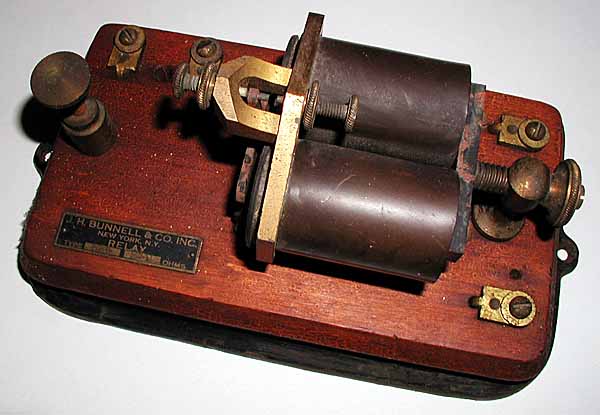
2590 LARGE BUNNELL TELEGRAPH RELAY:(33KB)Large Brass
relay with very large coils mounted on wood and metal base. The shape
of the frame has led people to also refer to this as a 'spectacle
relay' since the coil supports resemble a pair of spectacles.
Labeled: J.H.Bunnell & Co. N.Y. 250 ohms.

2591 LARGE BUNNELL TELEGRAPH RELAY:(35KB)Similar
to above.

2592 MEDIUM SIZE BUNNELL TELEGRAPH RELAY:(33KB)
Medium-size brass relay on wood and metal base with
metal ''bowtie-shaped'' Bunnell label.

2593 SMALL BUNNELL TELEGRAPH RELAY:(19KB)
Small plated brass relay on wood and metal base with
metal ''bowtie-shaped'' Bunnell label.
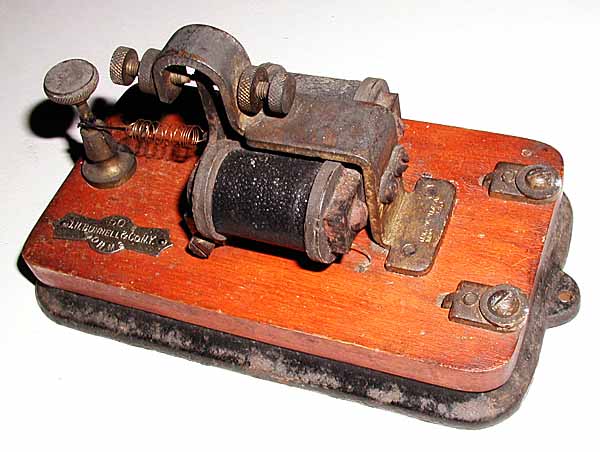
2593a Another view of the
Small Bunnell Telegraph Relay:(46KB)

2594 SMALL BUNNELL TELEGRAPH RELAY: Small plated brass
relay on wood and metal base with metal ''bowtie-shaped'' Bunnell label.
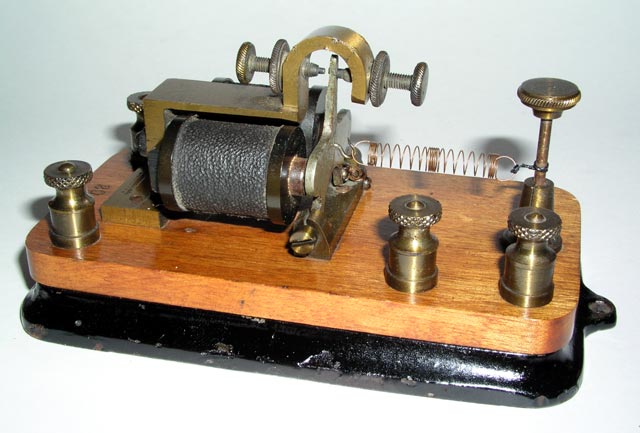
2594a Another view of the Small Bunnell Telegraph
Relay:(46KB)
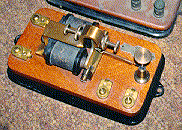
2595 * SMALL BUNNELL TELEGRAPH RELAY:(19KB)
Small Brass relay on wood and metal base which is inscribed "J H Bunnell
& Co. N.Y. 100 ohm".
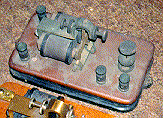
2597 * Same as above but 4 ohm:(15KB)
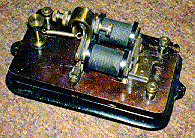
2598 * Same as above but just stamped 20 ohms:(21KB)
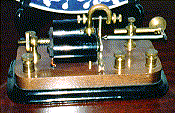
2599 * Same as above but just stamped 20 ohms:(14KB)

2600 * SKIRROW-PATENT POSTAL TELEGRAPH CO.
RELAY:(18KB) An unusual relay with the "Skirrow" patented
rack-and-pinnion adjustment for the coil-to-armiture distance.
Postal Telegraph Co. owned this patent.
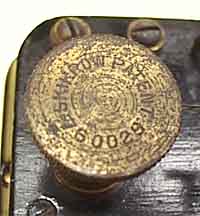
A close-up of the Patent on the tension adjustment
knob:16KB)
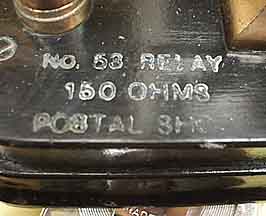
A close-up of the label:(15KB)
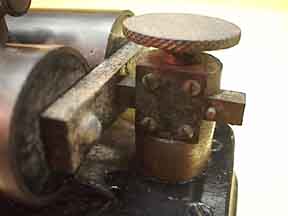
A close-up of the Skirrow mechanism:(10KB)

2605 SMALL PLATED MESCO TELEGRAPH RELAY:(15KB)
This is a small plated brass telegraph relay which was
made by the Manhattan Electric Supply Company (MESCO) It
is labeled under the armiture.
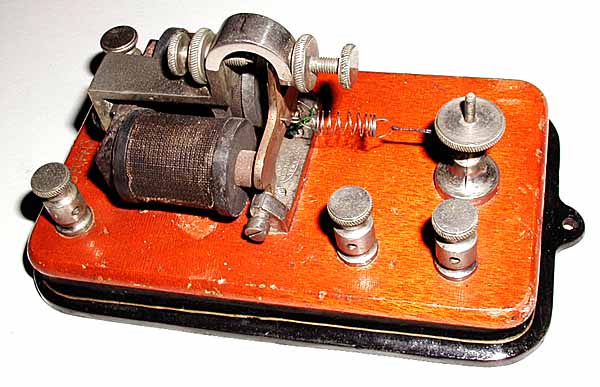
2605a Another view of the
SMALL PLATED MESCO TELEGRAPH RELAY:(47KB)
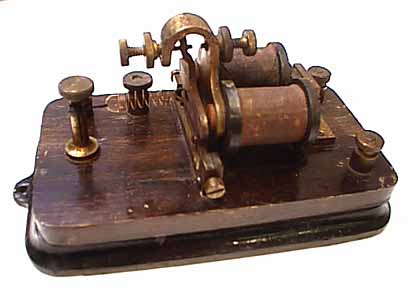
2607 * SMALL SIGNAL ELECTRIC COMPANY
TELEGRAPH RELAY:(15KB)
This is a small relay which was made by Signal Electric
Company. Many thousands of these relays were made and
used and they are very common.

2610 * ASSOCIATED PRESS WHEATSTONE POLAR
TELEGRAPH RELAY:(11KB)This polar relay is housed in
a cylindrical casing with a beveled glass top cover.
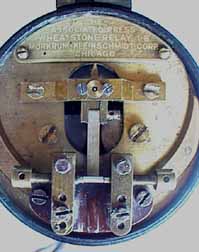
2610a A closer view of the label and
contacts:(15KB)

2630 * VERY SMALL TELEGRAPH RELAY:(15KB)
Very small mostly brass relay on grey marble base.
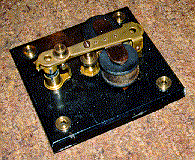
2640 * "SPARK"? TELEGRAPH RELAY:(22KB)
Unusual small brass relay on grey marble base with vertically mounted
coils and 3/8 inch carbon contacts. May have keyed spark transmitter.

2805 WESTERN ELECTRIC BOX SOUNDER / ROD-LEVER
KEY:(31KB)
The key on this early Western Electric combination box sounder and key has
the uniquely Western Electric designed lever made of two parallel
steel rods.
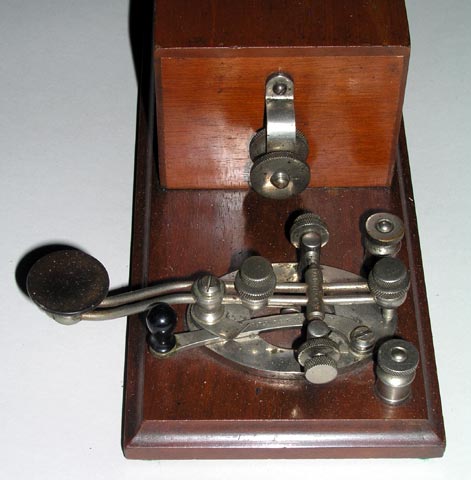
2805a A closer view of the key on the Box Sounder
/ Rod-Lever Key:(34KB)
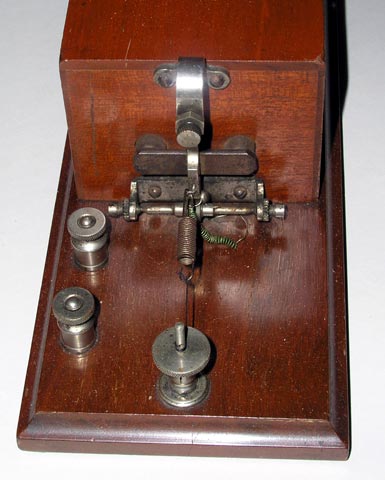
2805b A closer view of the box sounder on the Box
Sounder / Rod-Lever Key:(34KB)
2810 * OLD BUNNELL BOX RELAY/KEY. Key is steel lever style with "patent
applied for" on shorting switch and extremely narrow lever area under
knob. This may be the first model "Triumph Key" made just before the 1881
patent was issued.
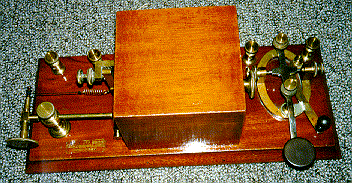
2815 * TELEGRAPH BOX RELAY/SOUNDER AND KEY:(45KB)
Old brass JH Bunnell key with steel lever and brass shorting switch
mounted on wooden base with an all wooden boxed brass combination relay
and sounder. The base has a metal label reading: 150 Ohm.J.H.Bunnell &
Co., N.Y.
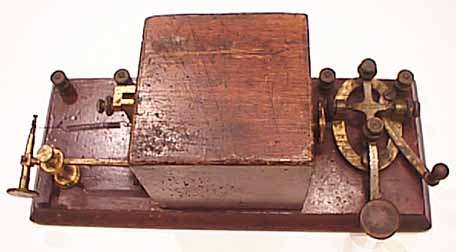
2816 * TELEGRAPH BOX RELAY/SOUNDER AND KEY:(18KB)
Old brass JH Bunnell key with steel lever and brass shorting switch
mounted on wooden base with an all wooden boxed brass combination relay
and sounder. The base has a metal label reading: 150 Ohm.J.H.Bunnell &
Co., N.Y.
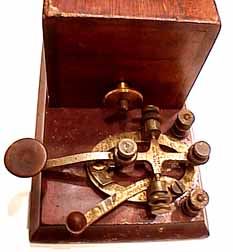
2816a A closer view of the telegraph key:(15KB)
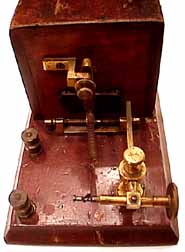
2816b A closer view of the relay/sounder:(13KB)
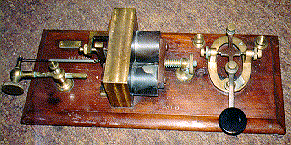
2820 * TELEGRAPH RELAY/SOUNDER AND KEY:(31KB)
Old brass key with steel lever mounted on wooden base with a brass
combination relay and sounder. Labeled: "J.H.Bunnell New York,N.Y.
RELAY, Type 405, 150 ohms.

2822 * TELEGRAPH RELAY/SOUNDER AND KEY:(15KB)
Similar to above.
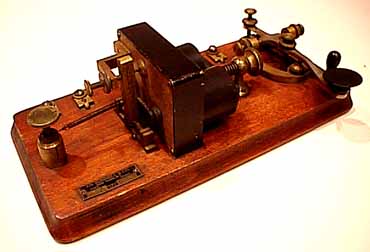
2822a * Another view of # 2822:(17KB)
2824 * Same as above but labeled "Western Electric Company, Pat'd".
2826 * Same as above but labeled "W. U. Tel. Co., Pat'd", 35 ohms.

2825 * UNUSUAL RIGHT-ANGLE KEY AND RELAY SET:(16KB)
This is a very unusual combination of a right-angle telegraph key
and a sensitive relay mounted on a thick bakelite base with
contact pins sticking down to make contact with some kind of sub-base.
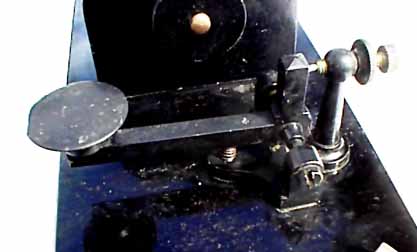
2825a A closer view of the telegraph key:(15KB)
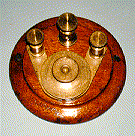
2930 * TELEGRAPH LINE LIGHTNING ARRESTOR:(12KB)
Lovely brass mechanism on round wooden base. Lightning spark gap can be
adjusted by turning large brass wheel.
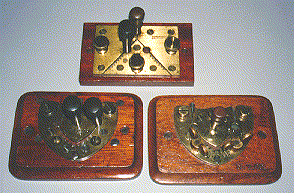
2932 * TELEGRAPH LINE LIGHTNING ARRESTOR:(32KB)
Lovely brass mechanism on rectangular wooden base. Lightning spark gap
is the double sawtooth design. Brass pins can be inserted to ground
various lines.Engraved J.H.Bunnell & Co.NewYork.
2934 Similar to above engraved L.G.TILLOTSON, 8 Dey St. New York.
2936 * TELEGRAPH LINE LIGHTNING ARRESTOR. Lovely brass mechanism on
rectangular wooden base. Lightning spark gap is the double sawtooth
design and a brass pin can be inserted to ground various lines. Brass
wing nuts are used to connect to the lines. The wood base is engraved
N.T. CO. Which probably stands for National Telephone Company the competitor
to the British Post Office until nationalized in 1912.

2940 * SWISS TELEGRAPH TEST SET:(17KB)
This is an unusual Swiss Telegraph Test Set.

2950 * WESTERN UNION - BUNNELL 18-A TELEGRAPH
RHEOSTAT NETWORK:(19KB)
This is a network of switchable resistors which can be switched into
a circuit to help balance it.

2950a A closer view of the label of the
rheostat:(22KB)
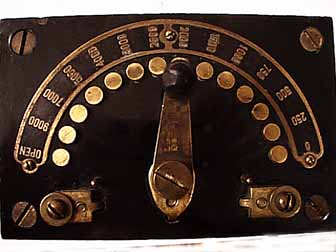
2950b A closer view of the dial of the
rheostat:(22KB)
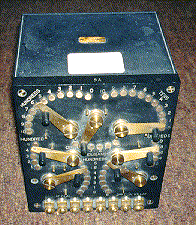
2960 TELEGRAPH LINE IMPEDANCE MATCHING NETWORK:(29KB)
Black box marked Western Electric with many brass switches for selecting
combinations of capacitors and resistors to simulate a second line for
duplex setups and to balance line impedance over very long distance
lines.

2968 BRITISH GPO TELEGRAPH TEST METER SET:(18KB)
This set consists of a multimeter with many voltage ranges which
is marked GPO and accompanied by numerous shunts to increase
the ranges.
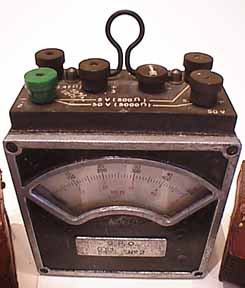
2968a A closer view of the meter:(16KB)
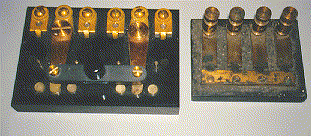
2970 * TELEGRAPH LINE SWITCH:(23KB)
2-pole,3 position sliding line switch mfg by Bunnell.
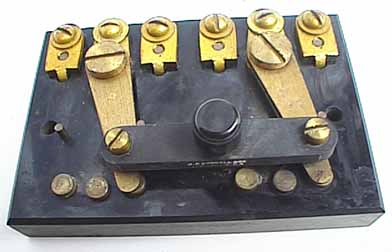
2970a Another view of the switch:(18KB)
2972, 2974 * Similar to above but use brass pins (missing) to make the
contacts.

2972 * TELEGRAPH LINE SWITCH:(23KB)
This is a 4-pole, 2 position telegraph line switch.
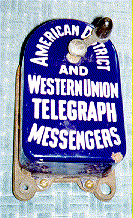
2980 * WESTERN UNION TELEGRAPH CALL BOX:(17KB)
When you turned the handle of this box it sent out a coded call and
dispatch a messenger to your location to pick up a telegram.
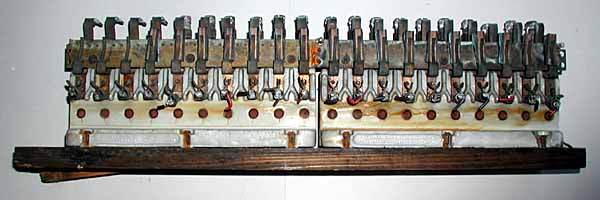
2985 20-LINE TELEGRAPH OFFICE INPUT PANEL:(26KB)
This is the input panel for 20 telegraph lines coming into a
telegraph office. It has a separate fuse for each line and a jack
for connecting the office instruments to each line. It is labeled:
Western Union Telegraph Company.
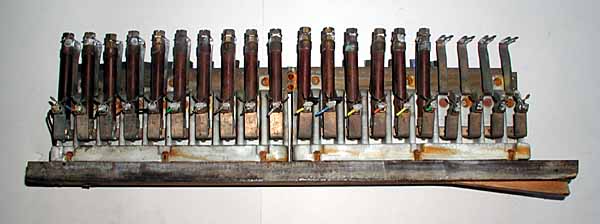
2985a The other side of the
panel:(29KB)
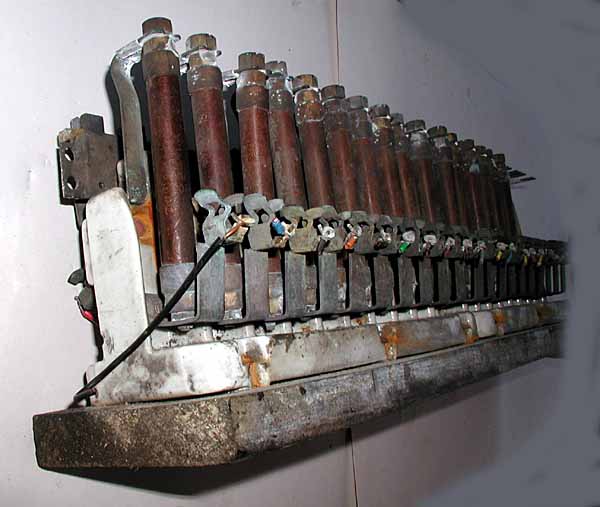
2985b Another view of the
panel:(35KB)
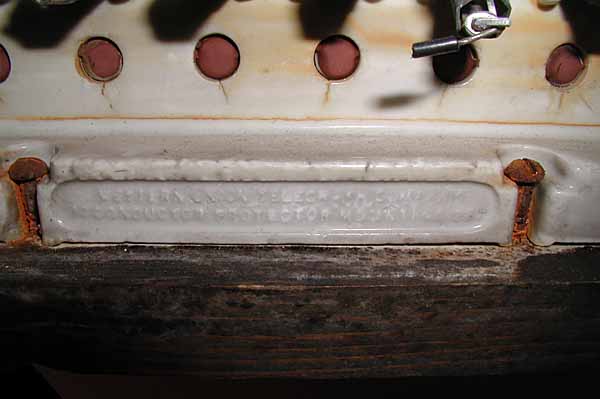
2985c A close-up view of the
label:(24KB)
2990 * FIRE ALARM KEY & LIGHTNING ARRESTOR:(15KB)
Many interesting and early keys were used in early fire-alarm systems in which
the location of the fire was transmitted as a series of short electrical
pulses and long or short spaces. The signals were received as a series of
bell rings in every fire house in the city. Fire alarm keys such as this one
are often mistaken for telegraph keys. In trying to determine whether a key
is from a fire-alarm or telegraph system, it is helpful to remember that
Gamewell and Roland made exclusively fire alarm apparatus. In addition, the
keys do not usually have fine adjustments and are designed for rather large
movements of the knob. Many, such as this one do not even have any adjustment
for knob-travel or spring tension.
2995 UNUSUAL ANGLED FIRE ALARM KEY:(15KB)
This unusual upward-angled key was mounted vertically on a Fire Alarm Bureau
test panel. Keys like this were used in test circuits in the Fire Alarm
Bureaus of major city Fire Departments like that in Boston. In the early days
before telephone and radio, these keys were sometimes also used to send Morse
Code messages between the Alarm Bureau Staff and the Linemen that were working
to maintain the circuits.
In rare emergencies involving the breakdown of the Chief Dispatcher's desk
equipment, these test board keys were used to send actual fire alarm signals
on local and city-wide fire alarm circuits.
The Chief Dispatcher's key was referred to as a "tapper". The coded
location of the fire was sent by the "tapper" and received in the form of bell
signals at the remote stations. Every 'tap' on the key would ring alarm bells
in all the fire statgions in the city to identify the location of the
fire.
These keys were widely used in fire stations as early as the 1860's (This key
is much more recent).
2995a A view of the contacts of the Fire Alarm
Key:(15KB)
2998 CAMELBACK STYLE FIRE ALARM KEY:(33KB)
This Chrome-plated camelback key was probably used by a Chief Dispatcher
because it is horizontally-oriented. Chief Dispatcherts used this type of key
to send fire alarm signals on local and city-wide fire alarm circuits. Often
mistaken for land-line telegraph keys, these fire alarm keys (sometimes called
'tappers') were widely used in fire stations as early as the 1860's (This key
is much more recent). The coded location of the fire was sent by the key and
received in the form of bell signals at the remote fire stations.
Internet ENIGMA Museum:
https://EnigmaMuseum.com
COPYRIGHT NOTICE: (Copyright (c) 2023: Prof. Tom Perera Ph. D.)
Although all the pictures and text are copyrighted, you may use any of them
for your own personal applications including public lectures and
demonstrations, publications and websites as long as you mention the
w1tp.com Museum. If you plan to offer them for sale to the public
in any form, please email me for permission which I will generally grant as
long as you mention my museum: http://w1tp.com or https://EnigmaMuseum.com My email address is
given at the bottom of this page. Some of the material may require contacting
other copyright owners for commercial use and I will inform you by email.
Please also see the Disclaimer of Warranty.
(The instruments are in approximate chronological order: Oldest first.)
* = (Items no longer owned.) ** = (Items in other collections.)
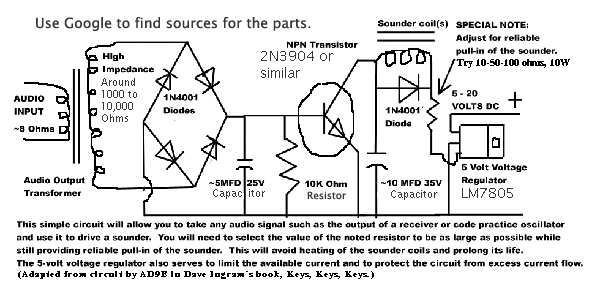
3010 ''SPECIAL CIRCUIT'' TO ALLOW ANY SOUNDER TO
BE OPERATED BY AUDIO TONES:(20KB) This circuit is easy to
build and uses standard components available at any Radio Shack
store. It accepts the audio tone output of a code practice
oscillator or short wave receiver and converts those tones into
the DC voltage necessary to operate an old-time telegraph sounder.
It is adapted from a circuit designed by AD9E which was printed in
Dave Ingram's book: Keys, Keys, Keys.
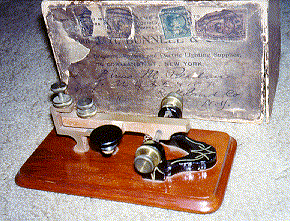
3050 * BUNNELL SIMPLE NON-ELECTRIC PRACTICE SET
AND ORIGINAL BOX: (39KB)
This lovely set with original shipping box was used for practice only.
A small key knob is mounted directly on the sounder arm and produces a
resounding "click whenever it is depressed. (Same as number 315.)

3051 * BUNNELL SIMPLE NON-ELECTRIC PRACTICE SET: (12KB)
This interesting set was used for practice only. A small key knob is
mounted directly on the sounder arm and produces a
resounding "click whenever it is depressed.

3053 * BUNNELL ARTICULATED NON-ELECTRIC PRACTICE
SET:(15KB)
Interesting combination of a brass sounder and telegraph key
with a mechanical connection whereby pressing the key causes
the sounder to move downward to make a click. It was used to provide
practice sounds for people learning the Morse code without the need
for batteries and wiring. (Same as item 325.)
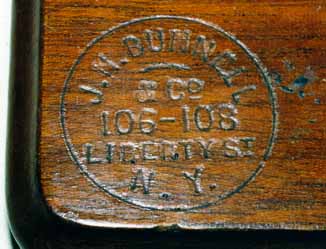
3053a
The early Bunnell logo stamped into the base:(22KB)

3055 ** "AUDIO ALPHABET" MANUAL
CODE PRACTICE SENDER:(22KB)
This set consisted of a manually operated device which pulled a paper
tape past a set of contacts which sensed holes in the tape and sent
dots and dashes for code practice purposes. (This unit is in the
John Casale - W2NI collection.)
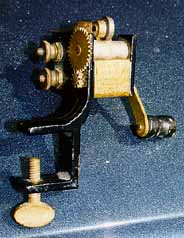
3055a ANOTHER SIMILAR MANUAL CODE PRACTICE
SENDER:(22KB)
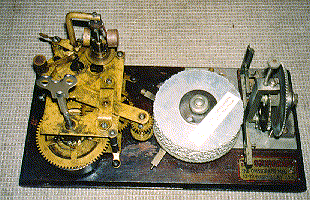
3060 "OMNIGRAPH" AUTOMATIC CODE PRACTICE SENDER:(41KB)
This mainspring-driven Omnigraph was used to key a sounder to
provide random morse code characters for practice. It has fifteen
code wheels which are notched with dots and dashes and can be
shuffled or replaced to provide an unlimited number of combinations
of characters.A mechanical speed governor adjusts sending speed. It
shifts from wheel to wheel according to settings of "Kicker strips".
Key-wound drive mechanism, code wheel turntable, and contact
assembly are mounted on a wooden board labeled "THE OMNIGRAPH, The
Omnigraph mfg. Co. 13-19 Hudson St. N.Y. U.S.A."
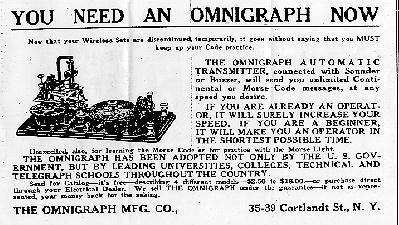
3060a Early advertisement for the Omnigraph:(41KB)
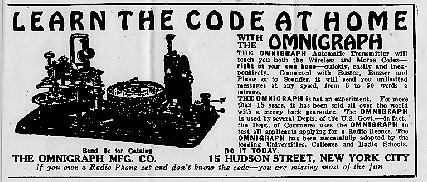
3060b Another early advertisement for the
Omnigraph:(36KB)
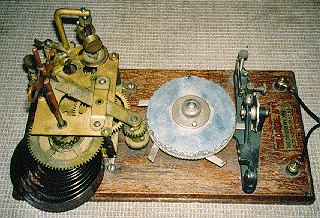
3062 SMALLER OMNIGRAPH: (47KB)
Same as above but has five code wheels and labeled 16-22 Hudson St.
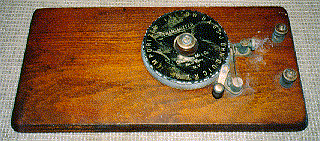
3064 * MANUALLY OPERATED "OMNIGRAPH": (30KB)
Very early model with 3 thin code wheels and a tiny hand crank on
old style wooden base stamped only PAT Aug 25, 1883. Top wheel reads
TRANSMITTER, Omnigraph Mfg. Co. New York, N.Y., & around the outside
it says: JOHN QUICKLY EXTEMPORIZED FIVETOW BAGS corresponding to the
notches.>>W2PM
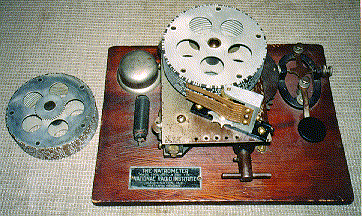
3066 * "NATROMETER" AUTOMATIC CODE PRACTICE SET: (51KB)
This set consists of an automatic spring-wound morse code sender, a
nickel cased enclosed buzzer, an inductor, and a nickel plated,
black metal based telegraph key on a wooden base labeled:"THE
NATROMETER, Made Exclusively For: NATIONAL RADIO INSTITUTE,
Washington, D.C. Patents Pending. The speed-governed code wheel has
9 levels and consists of alternating metal and insulating areas
which are contacted by 9 brass strips which are automatically
selected by programmable wooden pins. Has 2 wheels.

3070 * INSTRUCTOGRAPH CODE PRACTICE MACHINE:
(41KB)
The Instructograph was produced from the 1920s until at least
1983! Instructographs were used by many thousands of would-be telegraph
operators to learn and increase their code-copying ability.
The original versions used a hand-wound spring driven motor with a
centrifugal governor and were supplied with American Morse Code
paper tapes with short holes for dots and long holes for
dashes. They were sometimes also supplied with KOB sets as
shown. Later models used electric motor drives and included
a battery powered and later AC line powered oscillator to
produce tones for training radio operators. There are a
great many of these around so their value has remained low.

3075 * AMECO CODE PRACTICE RECORD SET:
(42KB)Many tens of thousands of radiotelegraph operators
learned the code by listening to this 78-rpm record set.
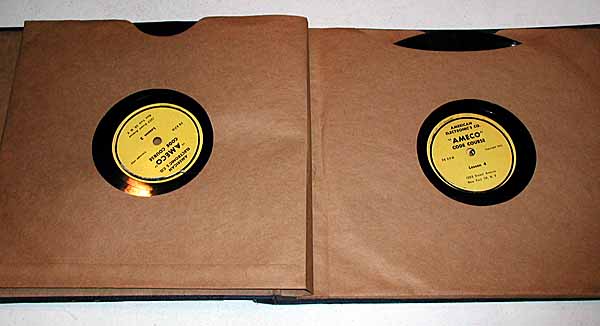
3075a * A view of the AMECO CODE PRACTICE RECORDS:
(22KB)

3080 BRITISH H.W.SULLIVAN MANUAL CODE TAPE
MAKING AND HIGH SPEED SENDING SYSTEM WITH HISTORIC TAPES:(15kb)
This complete system was used to manually punch holes in paper tape
and then transmit the International Morse Coded messages at high speed
over wireless transmitters.
The tape reader is powered by an electric motor and speed is changed
by installing one of the 9 pulleys.
The tape punch is labeled H.W.SULLIVAN - LONDON, E.C. The three key
knobs were used to punch either dots, dashes, or spaces into the tape.
These tape punches are also known as "mallet punches".
The 7 rolls of tape include messages which were actually transmitted
in the 1930's. Station WCG at 1:42AM on 11/12/1936, Station WIY at
10:33PM on 11/2/1936, Station WKJ at 9:50PM on 10/31/1936, Station
WEG at 9:28PM on 11/11/1936, and others. The tapes are contained in
a box from RCA Victor Division of Radio Corporation of America,
415 S. Fifth St., Harrison, NJ addressed to: Lester C. Barlow, R.E.
USNR. Class 11-43A, Radio Materiel School, Naval Research Labs,
Washington, D.C. It is postmarked August 27, 1943.
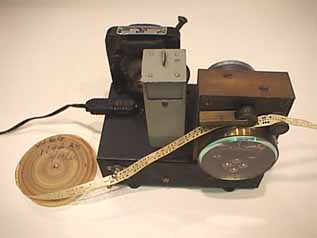
3080a The electric motor driven tape transmitter
and a tape:(12KB)
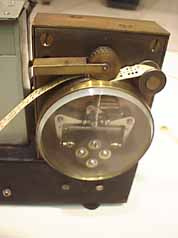
3080b Closeup of the tape reader
head:(11KB)
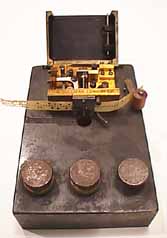
3080c The Three-button manual tape
punch:(11KB)
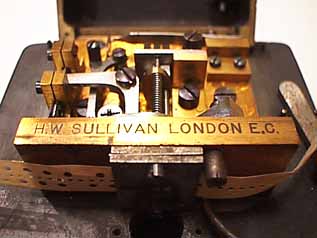
3080d Closeup of the brass tape punching
mechanism:(11KB)
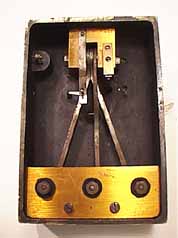
3080e Photo of the underside of the tape
punch:(12KB)
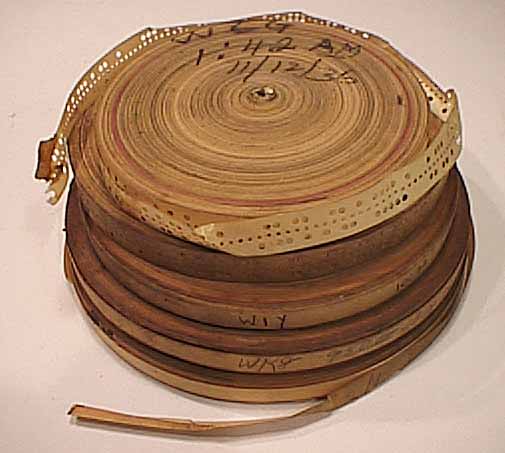
3080f The rolls of punched tape with the times
and dates of transmission:(32KB)

3100 * SIGNAL ELECTRIC CO. LEARNING SET:(20KB)
This is the basic key and sounder practice telegraph set used
by individuals and schools to help learn the code. It consists
of a nice key and sounder mounted on a wooden base. The sounder
and key are connected to the end two binding posts and the
common wire to both sounder and key is connected to the center
binding post. The sounder works on about 3-volts DC and can
be operated by two flashlight batteries.

3110 SIGNAL ELECTRIC CO. PRACTICE TELEGRAPH KEY:(25KB)
This is the basic Signal Electric Company telegraph key which was used
by many thousands of people to help them learn the Morse code. It is
a nicely made key mounted on a wooden base with the Signal Electric
Company decal.

3120 * RCA INSTITUTES LEARNING SET:(23KB)
This set consists of a key with brass
screws, a steel lever, and a black cast base mounted on a wooden board
with a buzzer enclosed in a cover stamped "SIGNAL". This probably
indicates that it was made for RCA by Signal Electric Co. The label on the
base is marked R.C.A. INSTITUTES INC, 75 Varick St.New York, N.Y. RCA
Institutes trained thousands of "hams", soldiers, & civilians to be radio
operators for war and peacetime service.

3121 * Similar to above with no cover over
buzzer:(21KB)
3122 Same as above.

3130 * RADIO INSTITUTE OF AMERICA LEARNING SET:(24KB)
Like 3120 but The label on the base is marked RADIO INSTITUTES OF AMERICA,
NEW YORK, N.Y.

3132 Same as above.
Signal Electric but no school label:(24KB)
3140 * EARLY E. F. JOHNSON LEARNER SET: This set consists of an early
style all brass key with brass armiture and shorting bar mounted on a
reddish stained wood base. The sounder is brass and black painted steel
and is engraved E.F.Johnson Co., Waseca, MINN. Johnson catalog number is
114-110. With instruction book/ catalog & saggy box. Johnson label
covered by CAMBOSCO Scientific Co.Boston label.
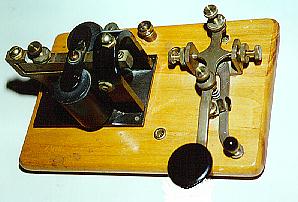
3140a * EARLY E.F.JOHNSON LEARNER SET:(17KB)
Just like # 3140 but with a light wooden base.

3142 * E. F. JOHNSON LEARNER SET:(14KB)
This set consists of a key with brass screws and shorting bar and
black steel lever integrated onto a black plastic base engraved E F
Johnson Co. Waseca, Minn. A 4 ohm mostly brass sounder is also mounted
on the base. Johnson catalog number is 114-110.
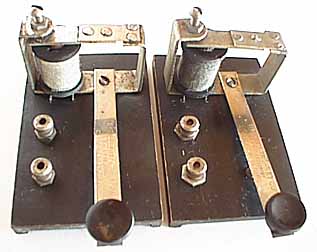
3150 * ELECTRO-SET COMPANY TOY TIN KEY &
SOUNDER PRACTICE SET:(18KB)
This is a very simple but effective practice set consisting of a
strap key and a very simple sounder mounted on a bakelite base.
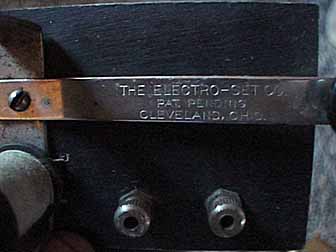
3150a A closer view of the manufacturer's
name:(13KB)

3155 * SIMPLE TOY TIN KEY & BUZZER PRACTICE SET:(17KB)
This is a very simple key and buzzer practice set with a code
chart on top and room for batteries inside. The key has an
unusually wide lever.
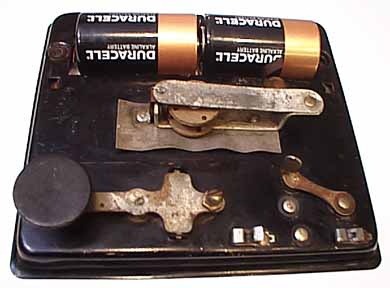
3157 * SIMPLE TOY TIN KEY & BUZZER PRACTICE SET:(21KB)
This is a very simple key and buzzer practice set.

3160 * TOY TWO-PIECE TIN KEY & SOUNDER
PRACTICE SET:(14KB)
This key and sounder are typical of the toy practice sets of the 1930s.

3170 VERY UNUSUAL GERMAN TOY SLIDING TELEGRAPH
KEY:(9KB)This unusual toy key has a sliding lever which can be
moved in (toward the pivot shaft) or out (away from the pivot shaft).
When the lever is forward toward the shaft, one set of contacts is
placed in position to be closed by pushing the knob downward and the
toy set lighted a light bulb. When the lever is back toward the operator,
a different set of contacts is enabled and the set operated a buzzer.

3268 * CANADIAN WILSON PRACTICE SET:(20KB)
Labeled BUZZER, PRACTICE, CADET TYPE, Model A, Made in Canada by WILSON
MFG CO, Toronto, Ontario. Consists of nickel plated key lever and hardware
integrated onto black plastic base with a buzzer and 2 "D" cell case.

3280 * UNUSUAL BRITISH PRACTICE TELEGRAPH KEY WITH TWO
KNOBS: This little practice key has two knobs perhaps to allow different
styles of sending. The Morse Code is imprinted on top.
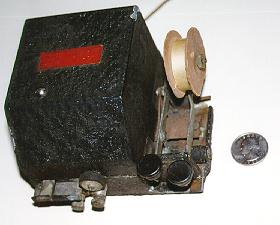
3300 * GARDINER-LEVERING AUTOMATIC ROBOT KEY:(13KB)
This tiny unit measuring 3"x4"x4" punches holes in a paper tape using
two telegraph-key-like levers. One moves the tape forward and the
other punches the holes. The tape may then be sent at a later time.
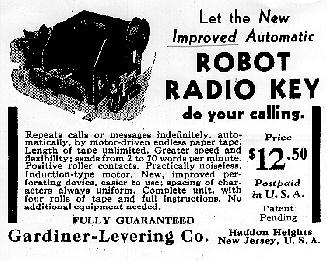
3300a EARLY 1936 ADVERTISEMENT FOR THE
ROBOT KEY:(35KB)
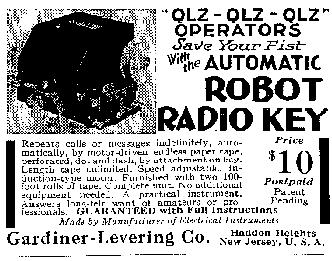
3300b ANOTHER 1936 ADVERTISEMENT FOR THE ROBOT
KEY:(40KB)

3308 * ATCO AUTOMATIC MORSE CODE SENDER:
This tiny unit was used to automatically send morse code by reading the holes
punched into a paper tape. It was used primarily for code practice and
appears to be a more modern version of the number 3070 Instructograph. The
photograph was sent to me by another collector.

3310 * BUD SIDESWIPER & RADIO-ENERGIZED CODE PRACTICE
SET:(30KB)This exceptionally unusual code practice set was made
and sold by BUD Radio of Chicago in the 1930's. This example is the
first I have seen and it came with the original box and instruction
sheet.
The set consists of a very tiny sideswiper key made from
a knife switch and mounted on an AC Outlet cover plate which is in
turn mounted on a bakelite AC junction box. The instructions discuss
the design of the key and how it can be used in two ways (see below).
The set comes with a set of 4 very interesting under-tube connection
taps which are put under the tubes of a radio. When the key is closed,
an internal .015MFD-400V condenser is switched into the circuit causing
the radio to go into oscillation and producing a code practice tone from
the loudspeaker of the radio. The instructions read as follows:
BUD CODE PRACTICE SET With Double Action Key that attaches to Radio Set.
Number 223. Price: $ 1.50. Since the latest receivers incorporate both
long and short waves, the BUD CODE PRACTICE SET will help you decipher
the many interesting and mysterious code messages which are being
transmitted on short waves and is an entirely new field of entertainment.
OPERATING INSTRUCTIONS: Remove Power Tubes from set, and insert Adapters,
which are extended from Code Practice Set, underneath each of the Power
Tubes. If power tubes have four (4) prongs, use four prong Adapters.
If Power Tubes have five (5) prongs, use five prong Adapters. Be sure the
white lettering is UP. If your radio does not have two Power Tubes, then
place either a four or five prong adapter underneath the one (1) Power
Tube and place the other four or five prong Adapter under the Detector
Tube or First Audio Tube. Try both to see which gives the best
results. Then, press key, and if properly installed, a loud clear note
will come from the radio speaker.
The double-action key makes possible the operation of BUD CODE PRACTICE
SET same as used by up to date amateurs in transmitting, and if Code
Practice Key is turned to the side, it can be used as a straight key.
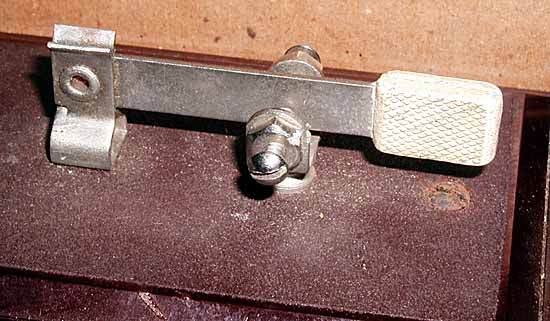
3310a Closeup of the BUD Sideswiper key:(40KB)
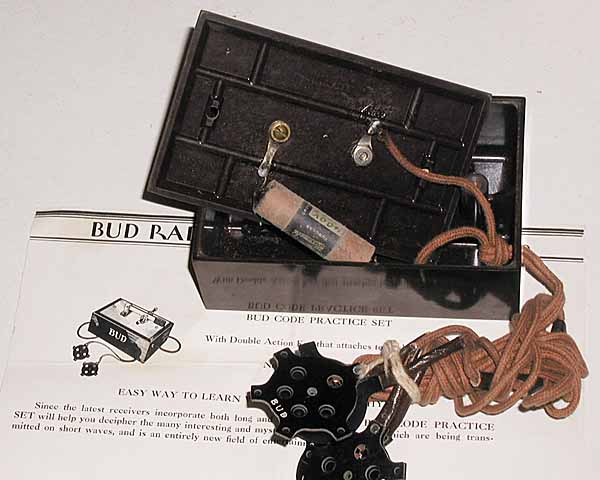
3310b A view of the inside of the set:(41KB)
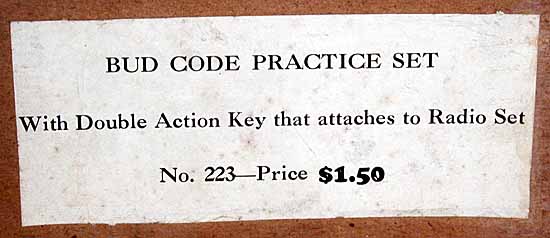
3310c Closeup of the label on the box:(24KB)
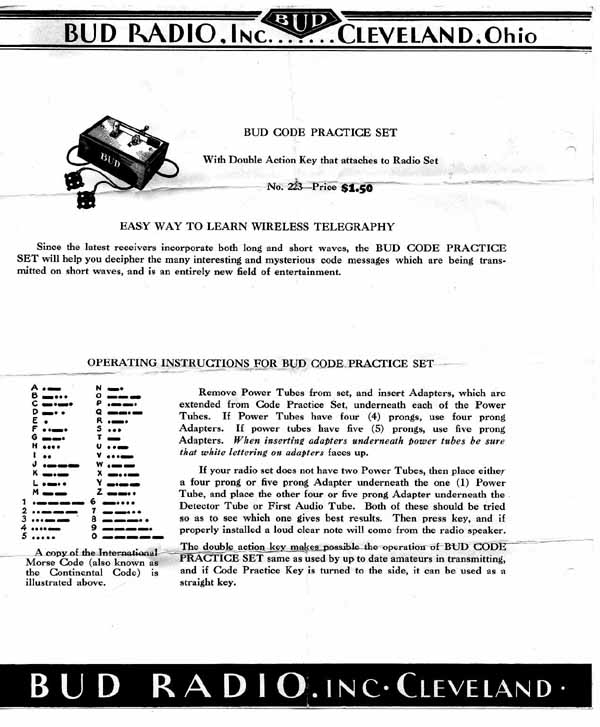
3310d The instruction sheet page 1:(76KB)
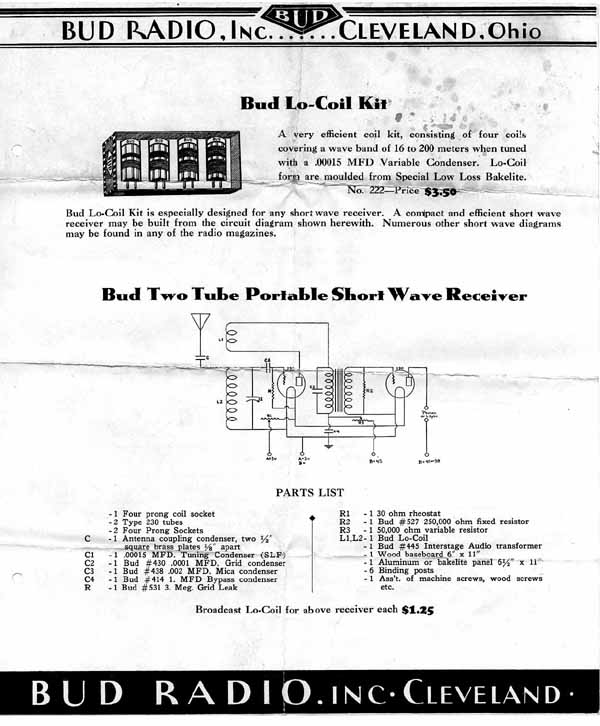
3310e The instruction sheet page 2:(64KB)
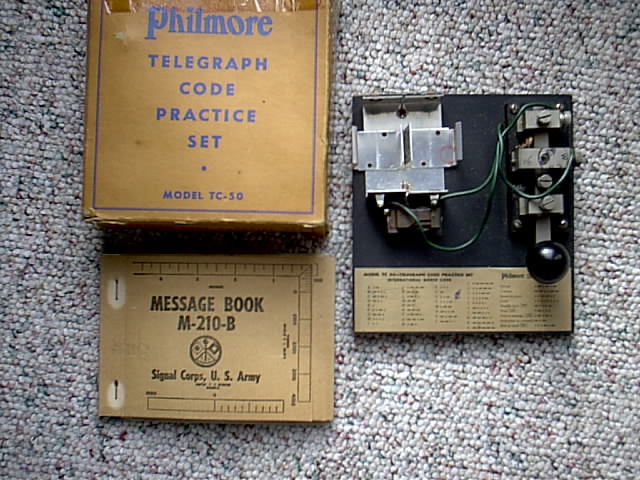
3315 * PHILMORE EARLY METAL TELEGRAPH PRACTICE
SET Model TC-50:
This Philmore Practice Set is shown with its official looking military message
book and original box. It was widely used for self-practice in the time
shortly after WW-2 as indicated by the surplus WW-2 British WT-8A key that was
supplied with the set.
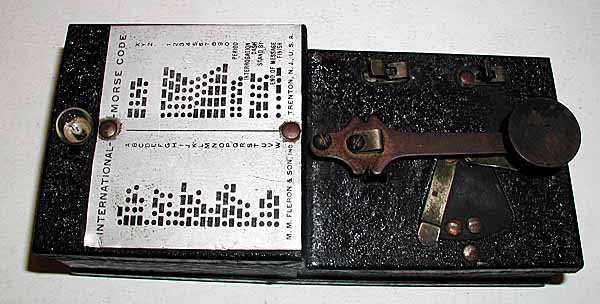
3320 * EARLY METAL TOY "FLERON" TELEGRAPH PRACTICE
SET:(43KB)This is the hard-to-find early metal version of the popular
plastic Fleron telegraph practice sets which were widely distributed
for help in learning the Morse code and which are shown in
number 3322 below. The key lever shape and
spring on this device are quite unique. The spring is the
small flat strap on top of the lever and the spring tension
is adjusted by changing the tension on the strap by turning the screw
which passes through it. The label carries the International
Morse Code and indicates that it was manufactured by:
M. M. Fleron and Son, Inc. of Trenton, NJ. USA.

3322 * PLASTIC TOY BOXED "FLERON SIGNALER":(19KB)
These code practice sets were widely used by many groups teaching
the morse code including the ''Boy Scouts''. They were also sold as
toys. This one is new in its original box. It is made of brown
plastic and includes a simple strap key, buzzer, light, and listing
of the International Morse Code. It uses 2 "D" cells. The original
instruction booklet was also found in the box.

3332 * TOY "WESTERN UNION STANDARD RADIO
TELEGRAPH SIGNAL SET":(19KB) This blue painted toy set has the
International Morse Code printed on the front and a simple strap key, light,
and internal buzzer. It uses 2 standard "D" batteries.

3335 * ANOTHER TOY "WESTERN UNION STANDARD RADIO
TELEGRAPH SIGNAL SET":(19KB) This blue painted toy set has
the International Morse Code printed on the front and a simple strap key,
light, and internal buzzer. It uses 2 standard "D" batteries.
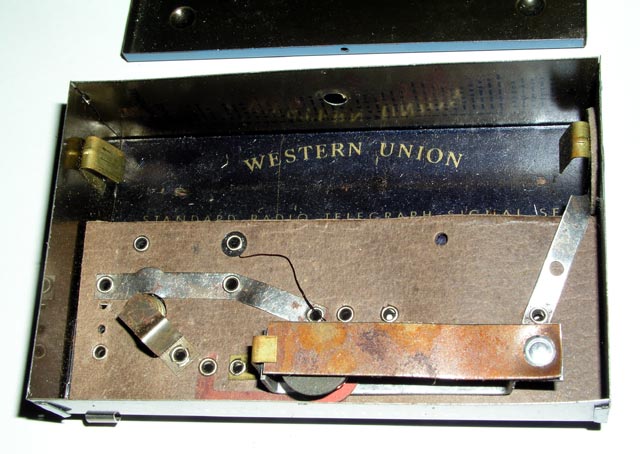
3335a * The Inside of the TOY "Western
Union Telegraph Set":
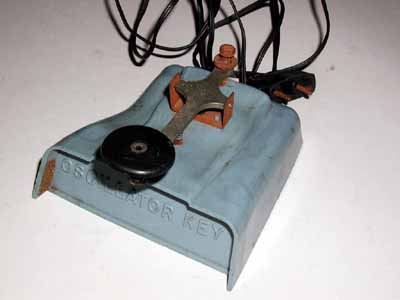
3360 * TOY PLASTIC RADIO TELEGRAPH SIGNAL KEY:(13KB)
This gray plastic toy telegraph key was part of a toy communication
set manufactured by Remco.

3380 TOY WOODEN TELEGRAPH KEY:(27KB)
This is a very simple but effective toy telegraph key and
its bright red color makes it quite attractive.
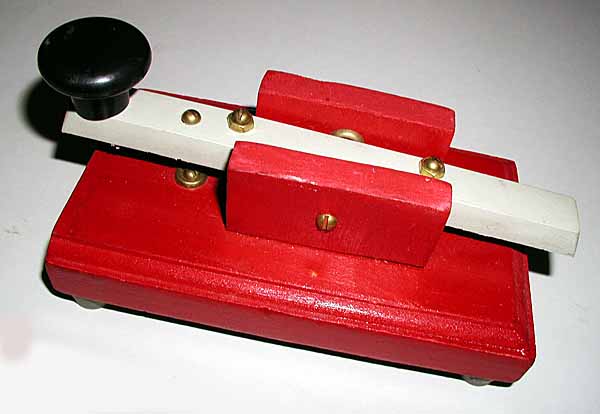
3380a Another view of the TOY KEY:(27KB)
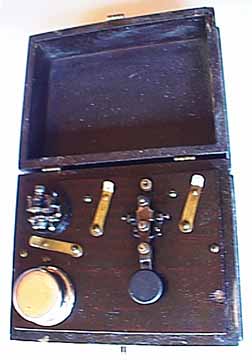
3410 * UNUSUAL BOXED KEY AND BUZZER PRACTICE SET:(17KB)
This set has one of the most unusual telegraph keys that I have
ever seen. There are no identification marks so it is not possible
to determine who manufactured it.->K5VT
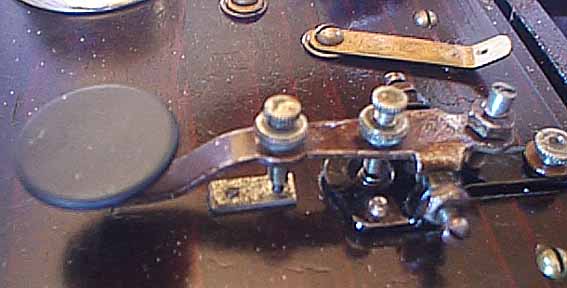
3410a A view of the unusual telegraph key:(24KB)
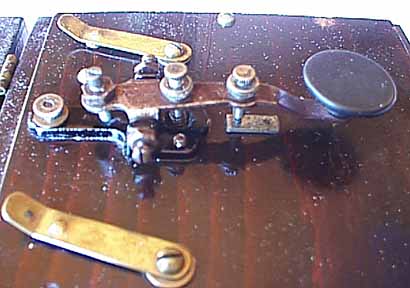
3410b A different view of the unusual key:(23KB)
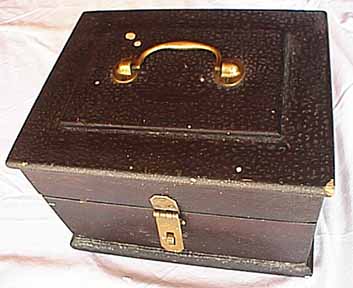
3410c A view of the box with the cover
closed:(20KB)

3475 * TOY "TWIN NAVY BLINKER CODE LITE":(28KB)
Two signal lights are included in this original-boxed set made by Hasbro.
Each lite is a plastic "gun" which has a compass in its handle and accepts
one "D" cell to flash its 1-1/2 volt bulb. When the trigger is pressed
triple shutters in front of the bulb open at the same time that the bulb
goes on. Traded to Wyn Davies.
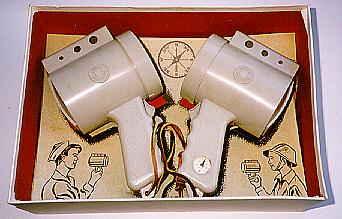
3475b A view inside the original box:(24KB)
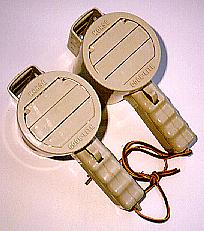
3475b A view of the two signal lights:(15KB)
Internet ENIGMA Museum:
https://EnigmaMuseum.com
COPYRIGHT NOTICE: (Copyright (c) 2023: Prof. Tom Perera Ph. D.)
Although all the pictures and text are copyrighted, you may use any of them
for your own personal applications including public lectures and
demonstrations, publications and websites as long as you mention the
w1tp.com Museum. If you plan to offer them for sale to the public
in any form, please email me for permission which I will generally grant as
long as you mention my museum: http://w1tp.com or https://EnigmaMuseum.com My email address is
given at the bottom of this page. Some of the material may require contacting
other copyright owners for commercial use and I will inform you by email.
Please also see the Disclaimer of Warranty.
(The instruments are in approximate chronological order: Oldest first.)
* = (Items no longer owned.) ** = (Items in other collections.)

4005 MARCONI SPARK KEY AS USED ON THE TITANIC:
(52KB)
After many years of searching, I have finally found one of the very few
existing examples of this rare key.
This is the exact model of Marconi key used on the Titanic.
It has an auxilliary set of contacts which are moved when the key is depressed
and which deactivate the receiver when the transmitter is in operation.
It also has an emergency switch on the left side which was used to break the
circuit if the contacts should become welded together by the high currents.
This switch would disconnect the keying line from the transmitter if it was
pulled upward. A rope hanging down from the ceiling was usually attached to
the eyebolt on the side of the switch lever. The rope could be easily found
in an emergency and pulling it would disconnect the circuit to the
transmitter.
As you can see from the pictures below, disassembly of the base of the key
reveals that the key carries serial number 24.
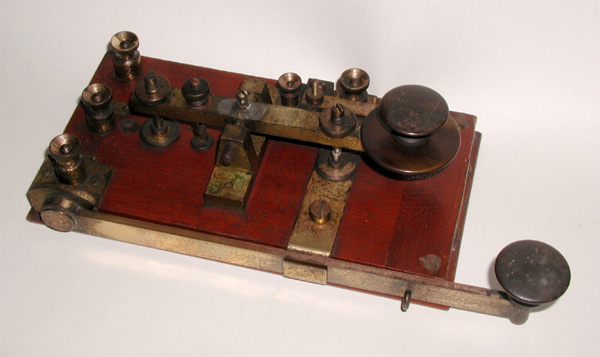
4005a Another left side view of the Marconi Spark
Key:(62KB)
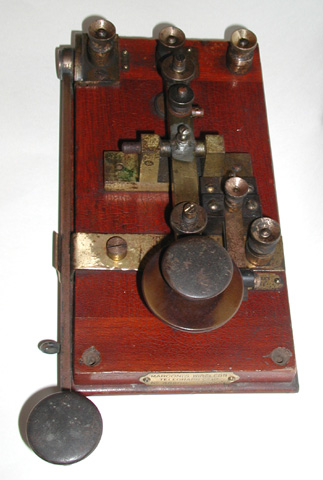
4005b A top front view of the Marconi Spark
Key:(54KB)
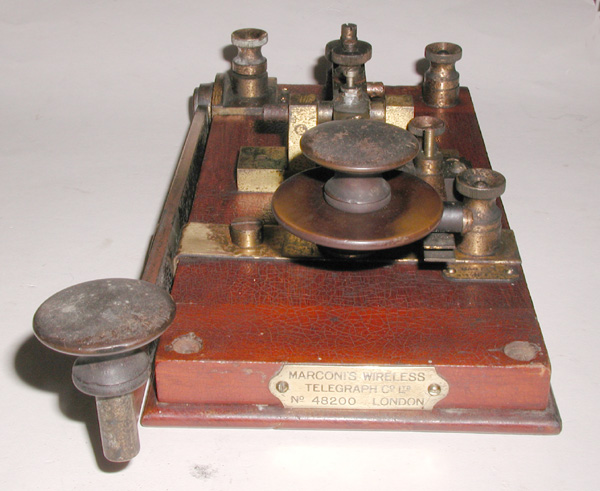
4005c A top front view of the Marconi Spark
Key showing the label:(99KB)
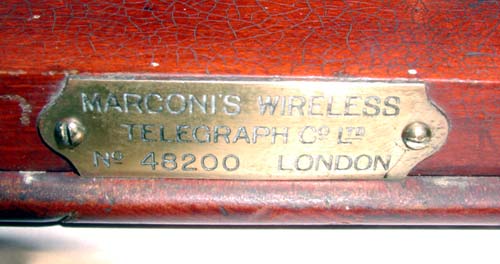
4005d A closeup view of the label on the Marconi Spark
Key:(22KB)
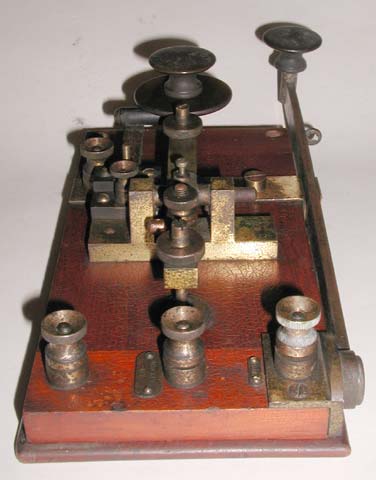
4005e A back end view of the Marconi Spark
Key:(22KB)
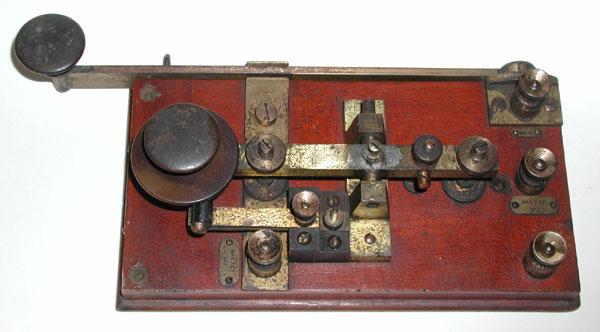
4005f A right side top view of the Marconi Spark
Key:(43KB)
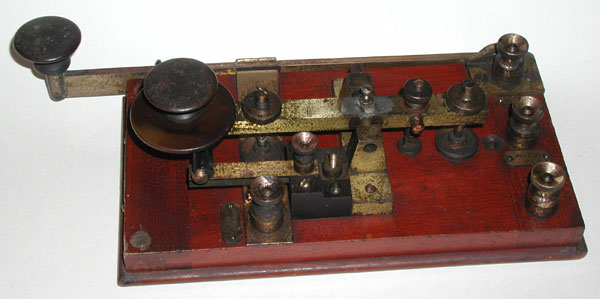
4005g Another right side top view of the Marconi Spark
Key:(36KB)
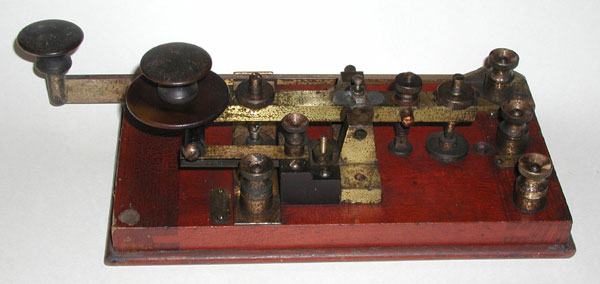
4005h Another right side view of the Marconi Spark
Key:(33KB)
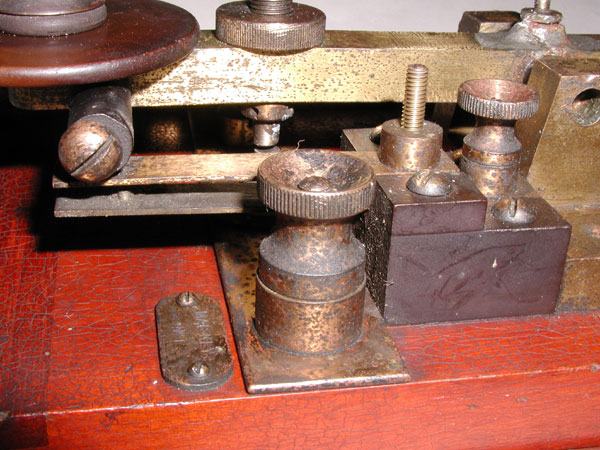
4005i A view of the auxilliary receiver control
contacts:(90KB)
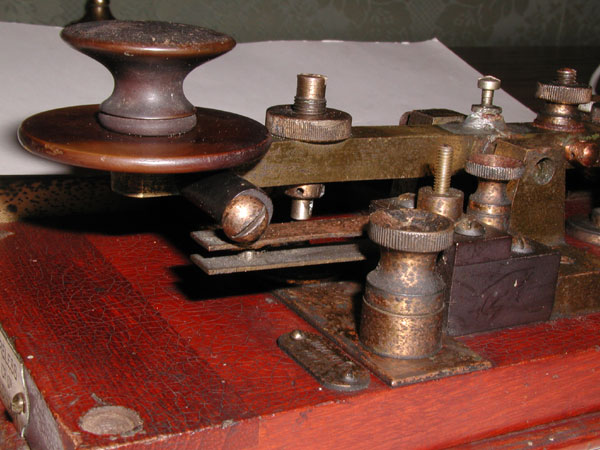
4005j Another view of the auxilliary receiver control
contacts:(70KB)
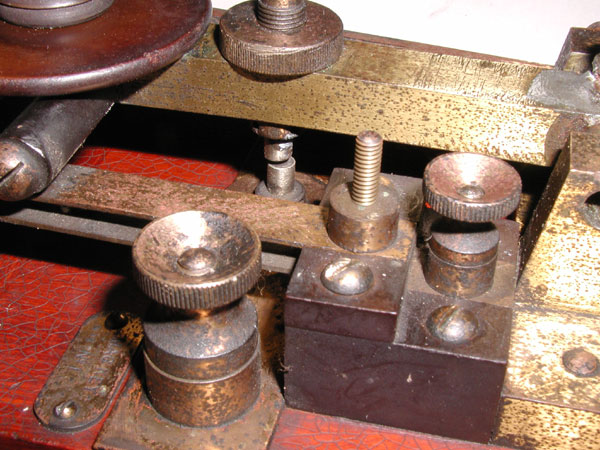
4005k Another view of the auxilliary receiver control
contacts:(89KB)
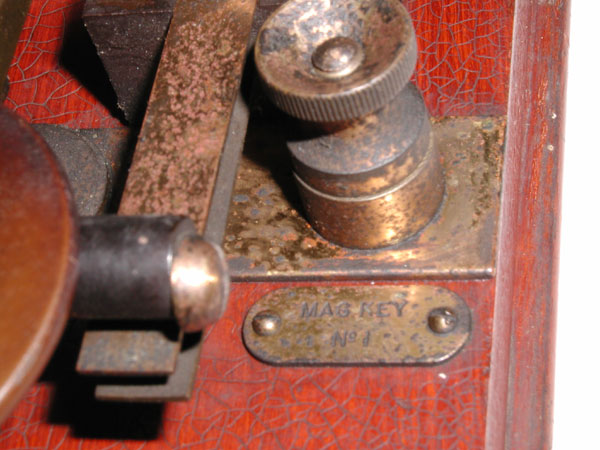
4005m A closeup view of the Mag Key No. 1
Terminal:(68KB)
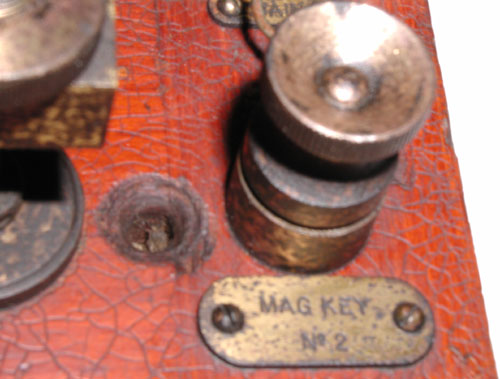
4005n A closeup view of the Mag Key No. 2
Terminal:(41KB)
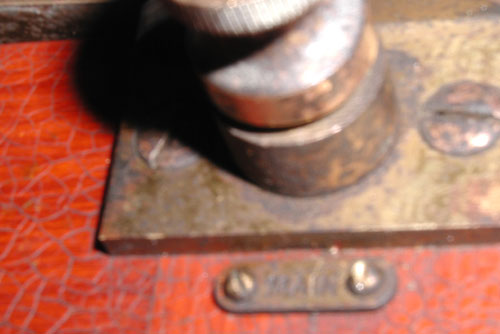
4005o A closeup view of the Main Terminal:(29KB)
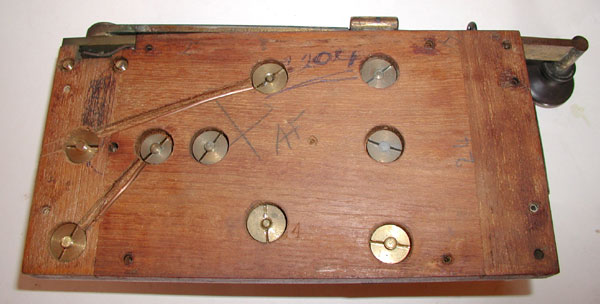
4005p A view of the bottom side of the key with the base
cover removed showing some of the pencilled-in manufacturing numbers and the
serial number 24 written in pencil.:(42KB)
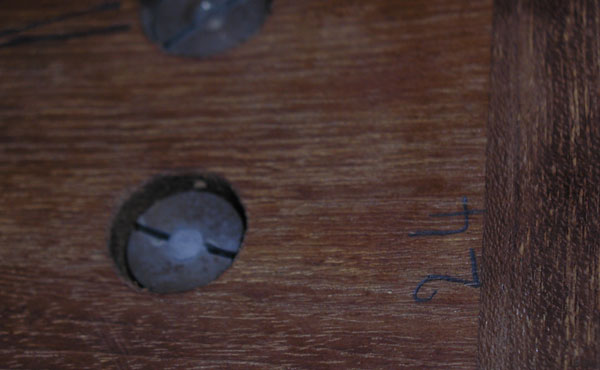
4005q A view of the bottom side of the key with the base
cover removed showing the serial number 24 pencilled on the wood.:(35KB)
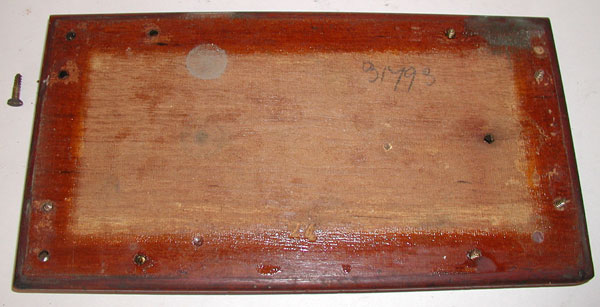
4005r A view of the base of the key after it was
unscrewed from the bottom of the key. If you look very carefully at the
very center of the lower part of the base where the painted wood changes to
unpainted, you will see the number 24 stamped into the wood.
:(46KB)
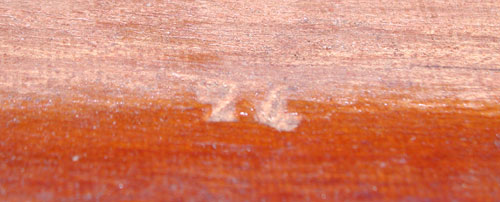
4005s A closeup view of the number 24 stamped into the
wooden base of the key.:(29KB)
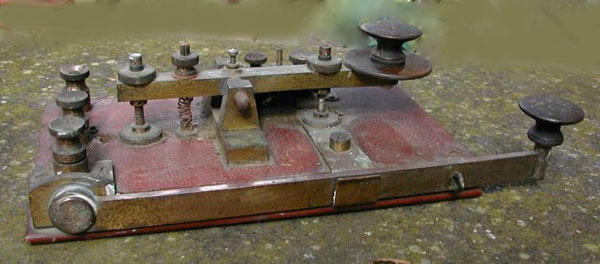
4005t A view of the Marconi Spark Key as-found in the
house in England where it was located.:(40KB)
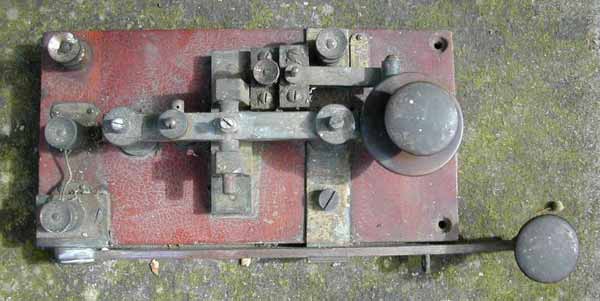
4005u Another view of the Marconi Spark Key in
as-found condition.:(26KB)
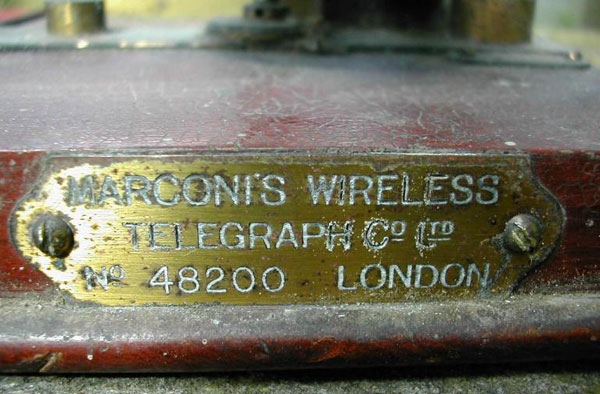
4005v A closeup view of the label on the Marconi Spark
Key in as-found condition.:(66KB)

4015 * MARCONI SPARK KEY SIMILAR TO THE ONE USED ON THE
TITANIC:(18KB)
This lovely spark key is similar to the one used on the Titanic but it does
not have the emergency switch on the side of the key.
It is owned by collector Pete Malvasi - W2PM.

4016 REPRODUCTION OF THE MARCONI SPARK KEY USED
ON THE TITANIC: (44KB)
This beautiful key was constructed to closely duplicate the key used
on the Titanic by taking measurements from a key used on
the Titanic's sister ship. The maker's call letters - W2CUV, are
stamped under the base.
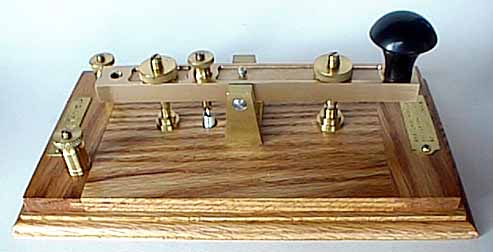
4016a Another view of the reproduction Marconi
key:(20KB)
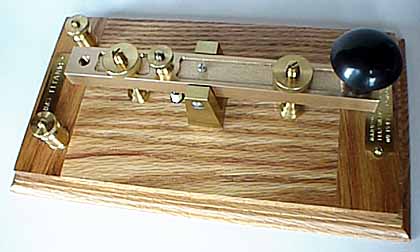
4016b Another view of the reproduction Marconi
key:(21KB)

4017 CURRENT REPRODUCTION OF THE MARCONI KEY MADE BY
"KENT":(28KB)This key is made and sold by the Kent Company in
England. It looks somewhat like the original Marconi Key and
carries a
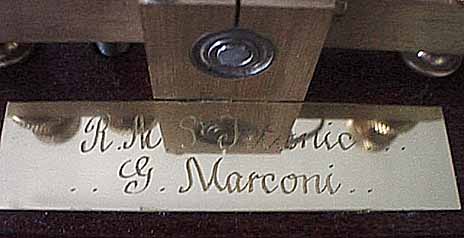
LABEL which reads: "R.M.S.Titanic.
G.Marconi":(20KB)

4018 EXCEPTIONALLY UNUSUAL ARTICULATED LEVER OIL BREAK
SPARK KEY:(51KB)This is a very unusual oil-break spark key with an open
oil cup, an articulated lever, and a rather unusual round skirted knob. The
oil lies in an open cup and surrounds the contacts. Oil kept oxygen from
reaching the contacts while they were making and breaking the circuit and this
reduced contact disintegration due to sparking. The lever is split in the
middle to allow the knob end of the key to be raised high above its normal
position. It is thought that this was done to allow extra movement and thus
make it easier for the contacts to be broken apart if they had become welded
together by the high current spark. In this way, the split lever functions in
a manner similar to the side-lever of the Marconi Titanic key shown above
which could break the circuit if the contacts had become welded together.
Look closely at the following photographs and you will see the key in the
normal open position as well as in a position with the knob end of the lever
raised upward to enlarge the contact gap.

4018a Another Left Side view with the lever in the
extended UP position:(39KB)
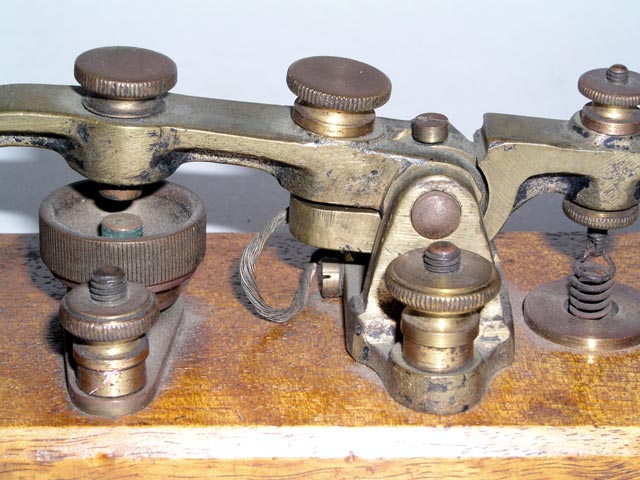
4018b A Close-up view of the open oil cup and the
contacts in the extended OPEN position:(71KB)
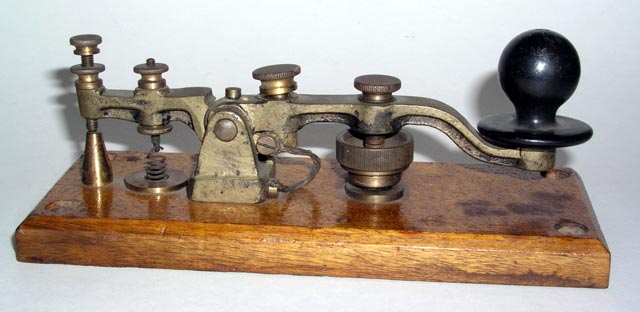
4018c A Right Side view with the lever in the
lowered (normal) position:(38KB)
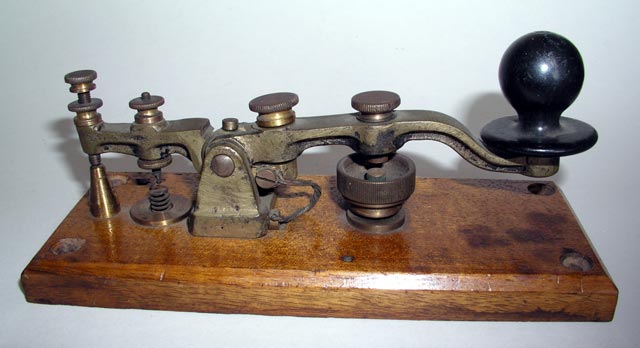
4018d A Right Side view with the lever in the
extended UP position:(39KB)
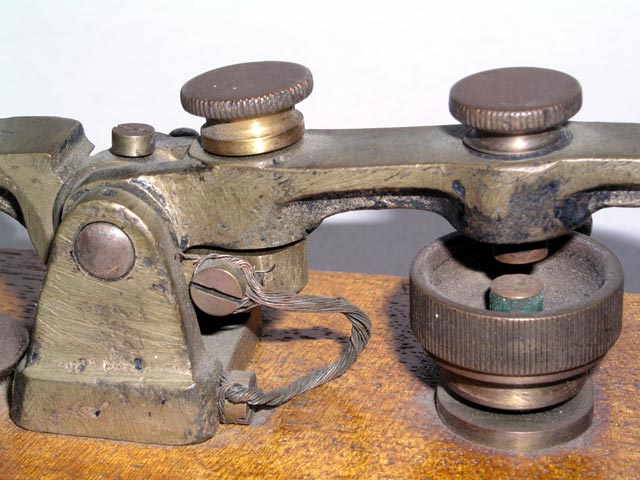
4018e A Right Side Close-up view of the open oil cup and
the contacts in the extended OPEN position:(66KB)
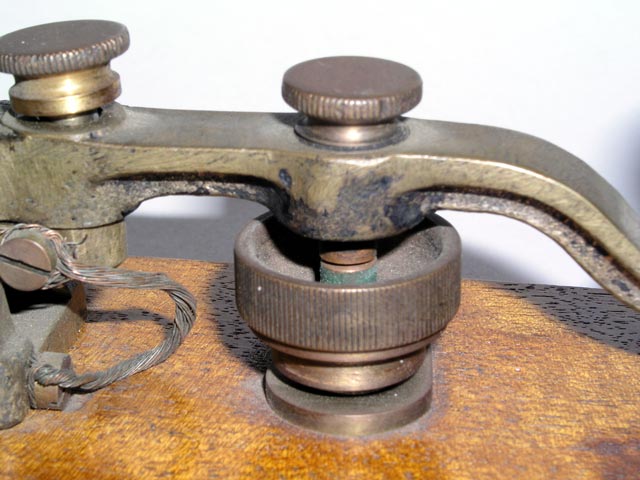
4018f A Right Side Extreme Close-up view of the open oil
cup and the contacts in the NORMAL position:(59KB)
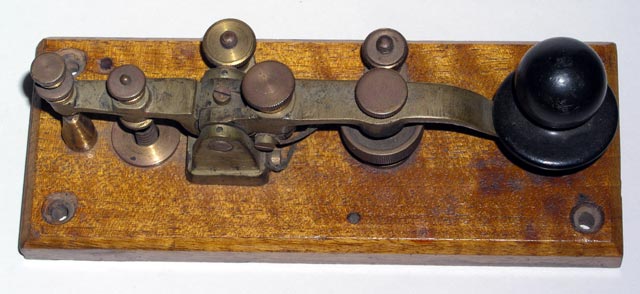
4018g A Top view of the key showing the construction of
the articulated lever:(43KB)
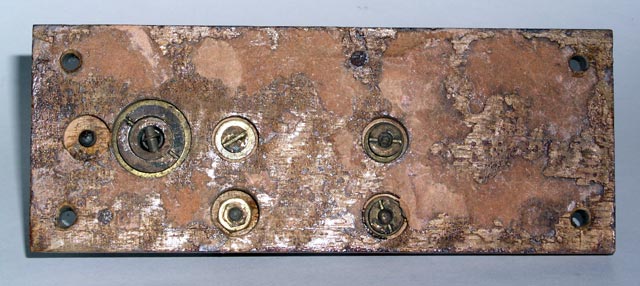
4018h A view of the bottom of the base of the key showing
the construction and glue residue indicating that it may have been glued to
another larger base or to the operating table:(59KB)

4019 EXCEPTIONALLY UNUSUAL MINIATURE GERMAN WW-I AIRCRAFT
HIGH-KNOB SEALED-CAN OIL BREAK SPARK KEY:(45KB)
This is a very unusual oil-break spark key that was used in German WW-I
aircraft. It has a sealed oil container that kept the oil in place even during
inverted flight maneuvers. It has a very high and thick knob that was easy to
use by aircraft radio operators wearing thick gloves for the cold temperatures
at high altitudes in open-cockpit aircraft. It also has a mechanism whereby
the lever can be swung up to a vertical position to allow refilling the oil
can, inspection of the contacts, and replacement of the contacts if
necessary... all without changing the adjustments for contact spacing. Look
carefully at the end of the key away from the knob and you will see a
horizontal piece of metal that can be pivoted up and out of the way. When it
is raised, the entire lever of the spark key can pivot up to a vertical
position. The key is very small and can be removed from the wireless
transmiter by simply pulling it upward.
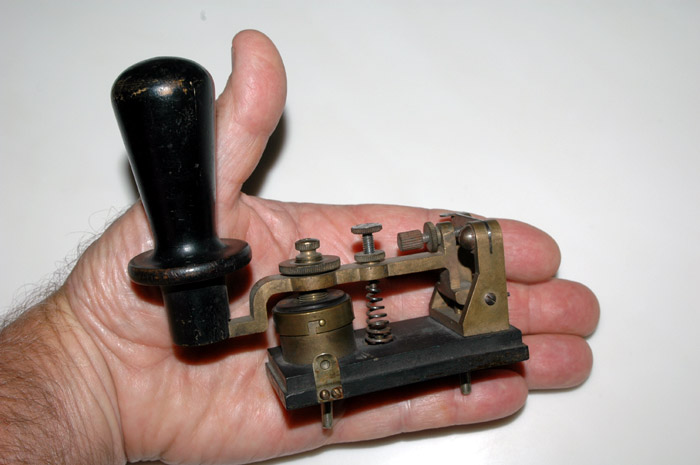
4019a Another view of the oil break spark
key in the palm of my hand showing its small size:
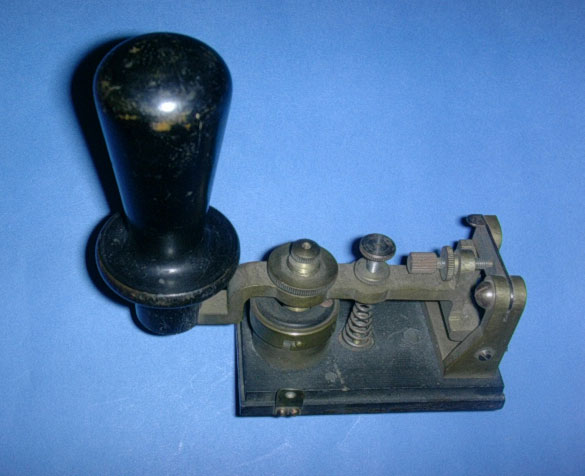
4019b Another view of the oil break spark
key showing the small metal bar that pivots upwards to allow the lever to be
lifted to add oil or change the contacts:
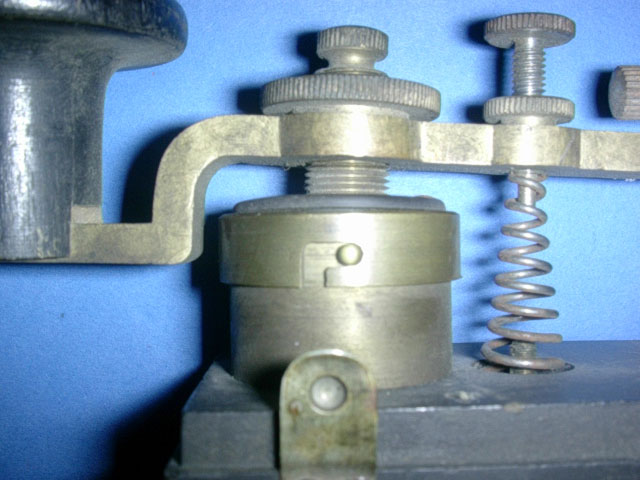
4019c A close view of the oil cup of the oil break spark
key:
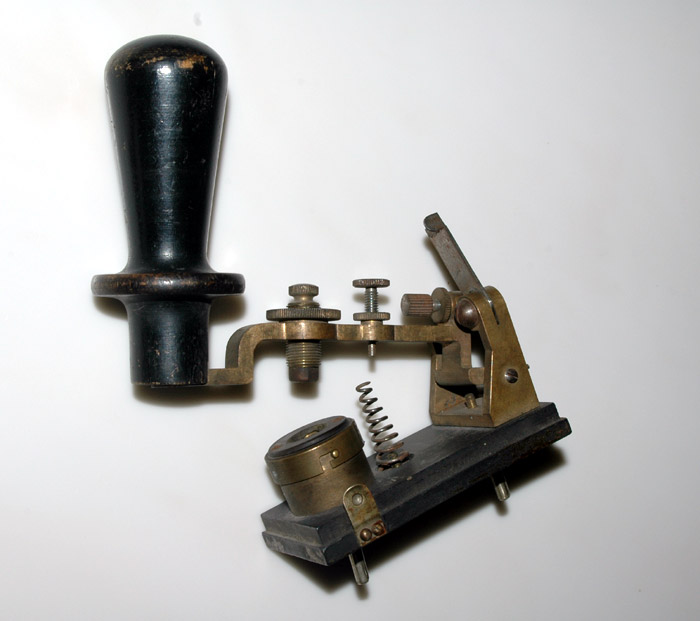
4019d Another view of the oil break spark
key showing how the lever is raised to allow filling of the oil cup or
changing of the contacts:
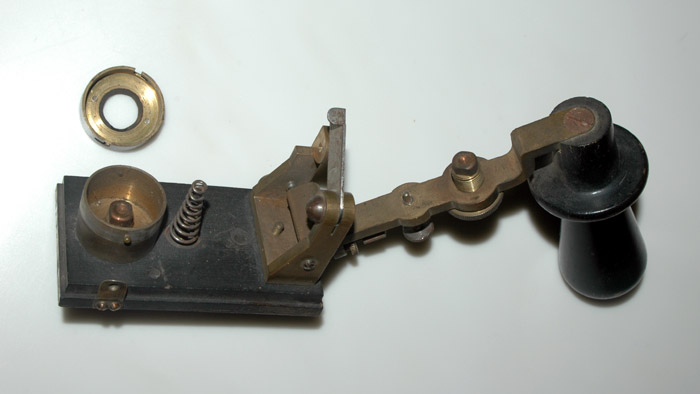
4019e Another view of the oil break spark key with the
cover removed from the oil cylinder and showing the upper and lower
contacts:
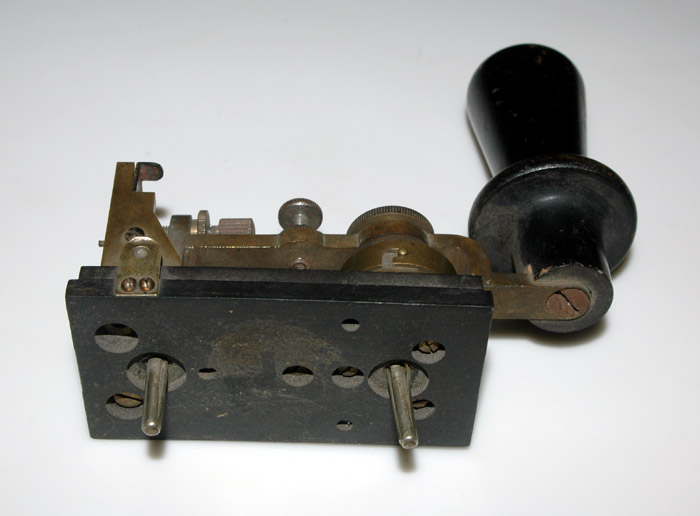
4019f Another view of the oil break spark
key showing the contacts that are pushed into the transmitter:

4021 FRENCH LAGIER OIL-BREAK SPARK KEY:(31KB)
This is a French Oil-Break Spark key made by Lagier.
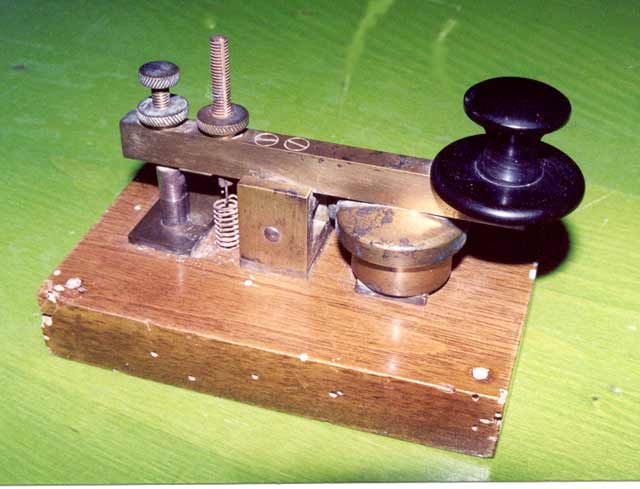
4021a Left side view of the Lagier key:(32KB)
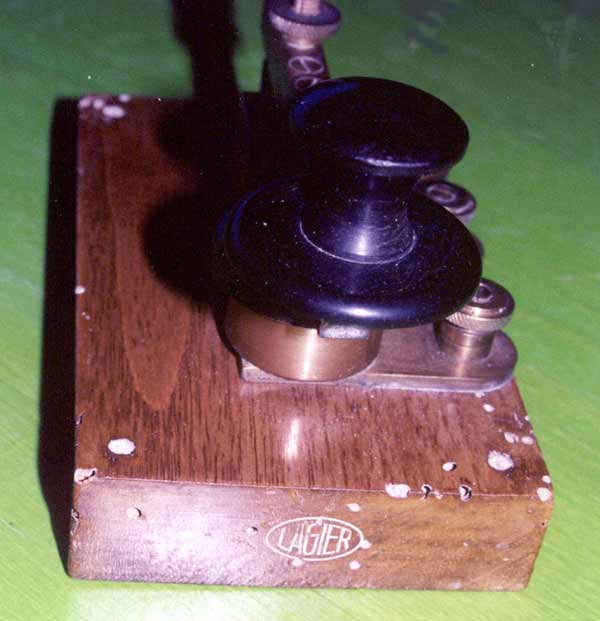
4021b Closeup view of the maker's label:(30KB)
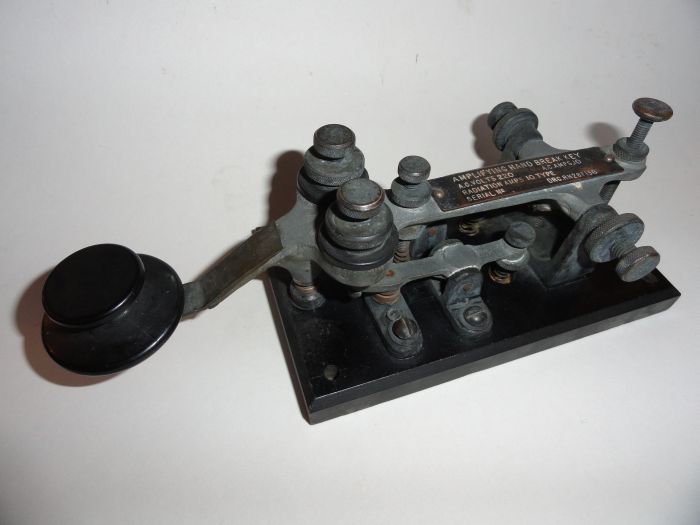 4023 ABSOLUTELY UNIQUE AND UNUSUAL
"AMPLIFYING HAND BREAK SPARK KEY":
This is a very unique spark key. Its most unusual design
characteristics are the multiple spring-loaded mechanisms that allow three
heavy spark contacts to be closed and opened in a specific temporal
sequence.
4023 ABSOLUTELY UNIQUE AND UNUSUAL
"AMPLIFYING HAND BREAK SPARK KEY":
This is a very unique spark key. Its most unusual design
characteristics are the multiple spring-loaded mechanisms that allow three
heavy spark contacts to be closed and opened in a specific temporal
sequence.
Although nothing is currently known about where or how it was used, a careful
examination reveals some clues. The label clearly reads: AMPLIFYING HAND
BREAK KEY, A.C. VOLTS 220, A.C. AMPS 10, RADIATION AMPS 10, TYPE {blank}, The
serial number is blank and the Number is DRG RN 26F216.
The label is in English suggesting that it was made and used in England or
America. A check of the threads on the screws shows that they are
American.
Russ Kleinman, WA5Y is probably the world's most thorough researcher of spark
keys. His Website is at:
http://www.zianet.com/sparks/
He has deciphered the "DRG RN 26F216" for me. It identifies the Drawing (DRG)
number for the key. He writes that nearly all of the US Navy drawings or
books from 1918-1923 started with an "R". The "N" means that it was designed
by the Norfolk Navy Yard. The "26" refers to transmitting keys of any kind.
The "F" refers to the size of the drawing and the "216" is the exact drawing
in the series."
Russ suggested that I examine the National Archives either in person or by
hiring one of their researchers to track down the specific drawing number 216
and find out from it exactly what the key was used for. Since this will take a
good deal of time, I will have to report on the results when I can obtain
them.
Russ included the following list of drawing numbers and corresponding keys:
RB 26F 107 SE 86
RB 26F 111 SE 144
RB 26A 104 SE 144
RB 26F 113 SE 653
RB 26F 117 SE 923
RW 26F 153 SE 1865
RB 26F 102 SE 68
RB 26F 102 & 18RE 26A 1089 SE 68A
RB 26F 112 SE 137 2&5 KW Relay Key
RB 26F 119 SE 137B
RM 26F 103 SE 976 20KW morse hand sending key for Morse set
RM 26F 103 Morse hand sending key for 20 KW arc set SE 993
RM 26F 105 Unit type radio relay key for 20 KW arc set SE993
RM 26F 107 Relay condenser for SE 993
RM 26F 108 Relay key resistance for use with 20KW arc set SE993
RN 24F 121 Selector Switch for subterranean antenna
RN 25F 106 2 KW Radio Transformer
RN 25F 121 5 KW 500 cycle transformer
RN 25F 105 Reactance for 5KW transformer
RN 25F 144 1 KW Navy standard transformer
RN 21F 110 5 KW Motor Generator
Additional contacts on a spark key are not unusual but they are usually small
and clearly designed to carry only small currents. The multiple sequenced
high-current contacts on this key were probably used to switch on and key a
very large and powerful transmitter either directly or through an "Amplifying"
Spark Relay.
Poulsen Arc transmitters are known to use multiple-contact keys.
Here, for example is a multiple-contact
key recovered from the Poulsen Arc transmitter of a German warship that had
been sunk in Scappa Flow:
Poulsen Arc transmitters were used by British, German, and eventually American
stations from 1906 into the 1920s. Poulsen arc transmitters oscillate and
generate RF continuously. Keying involves shifting the frequency of this
continuous wave to the desired operating frequency during key-down and off to
a remote frequency during key-up. This is typically achieved by shorting out
a few turns of a resonant tuning inductor with high current key contacts.
Later uniwave keying designs switched the continuous RF energy into a non-
inductive resistor during key-up periods. The critical operational parameter
was that the transmitter needed to always see a load so it was necessary to
switch in the dummy load before disconnecting the transmitter from the
antenna. With its multiple sequentially-closing contacts, it seems possible
that this key was used with a Poulsen arc transmitter especially since several
arc keys are included in the list that Russ sent.
Neil McEwen, K5RW discusses Arc keying in a
fascinating article at:
http://www.telegraph-office.com/pages/Federal_Telegraph_Relay.html
He mentions sequential contact operation and the keying of a chopper circuit.
Careful examination of the action of the key reveals that the lifting force
applied to the main lever by the main spring is counteracted by the downward
force applied to the two large main adjusting screws by the two auxilliary
contacts with the help of their individual springs. This means that the key
was designed to be easy to push down since downward pressure is aided by the
downward pull of the two auxilliary levers. In practice, however, it results
in a rather "mushy" feeling.
Note also that the two large main adjusting screws on the right and left are
insulated from the main lever by large insulating washers. The sole purpose of
these screws is to exert sequential upward force on the two auxilliary keys as
indicated by the fact that if you push up on the big adjusting screws they and
their washers simply slide upwards freely in the lever.
Below you will find a number of detailed photographs showing the complex
parts of this unusual key.
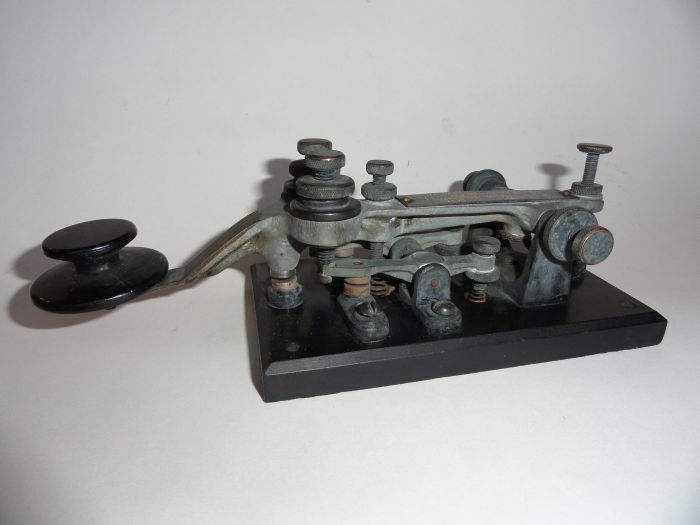
4023c Another view of the right side of the Amplifying Key showing the
two complex additional contact keys:
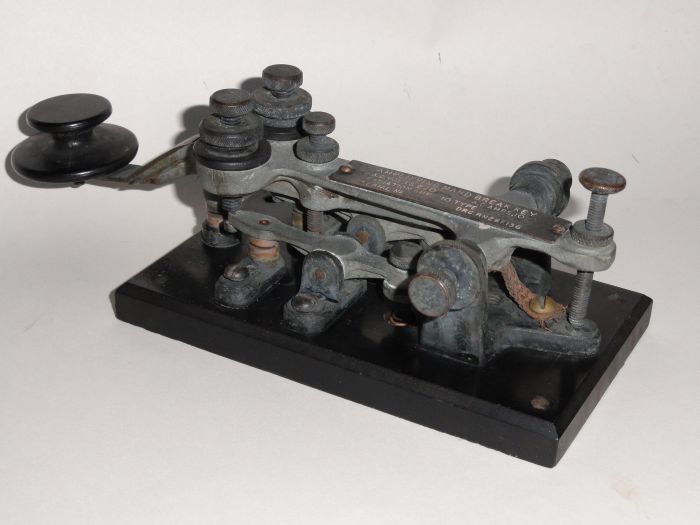
4023d Another view of the right side of the Amplifying Key showing closer
views of the complex additional contact keys:
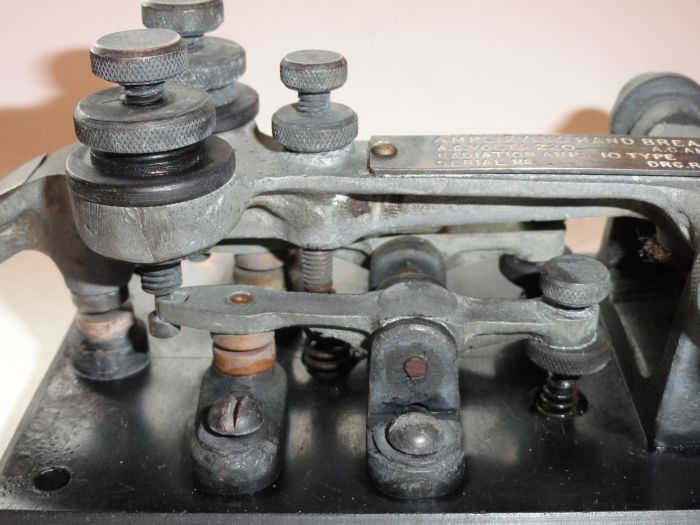
4023g A closer view of the right side of the Amplifying Key showing the two
additional contact keys:
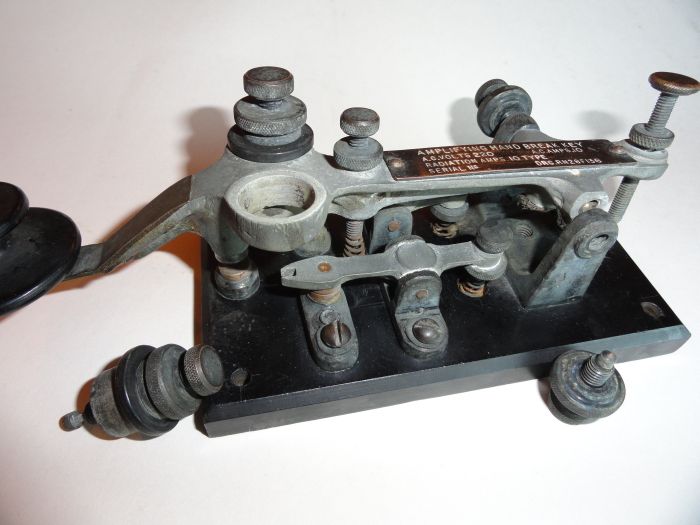
4023i A view of the right side of the partially disassembled Amplifying Key
showing the large contact sequencing screw assembly with its insulating
washer that has been lifted out of its hole in the lever. This picture also
shows one of the trunnion screws and the hole in the lever that accepts it:
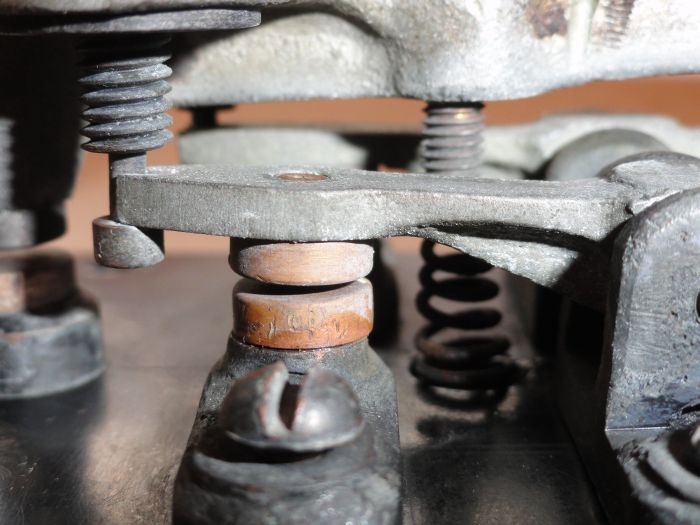
4023k A much closer view of the right side of the Amplifying Key showing the
heavy contacts on one of the two additional contact keys:
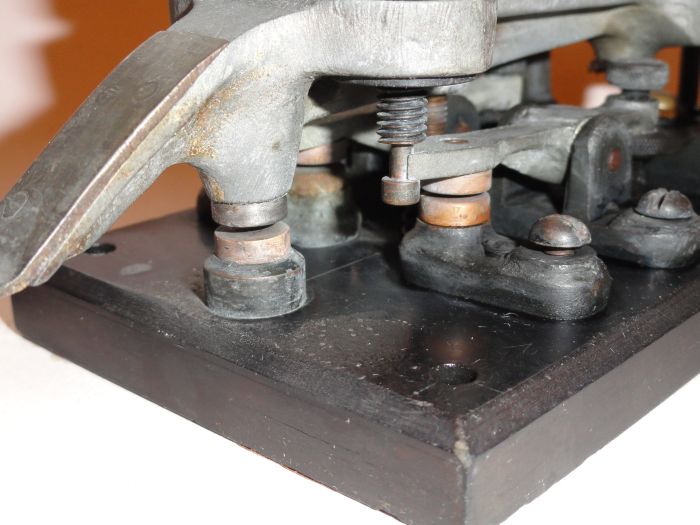
4023m A view of the right side of the Amplifying Key showing the main spark
contact and one of the two heavy contacts on the two additional contact keys:
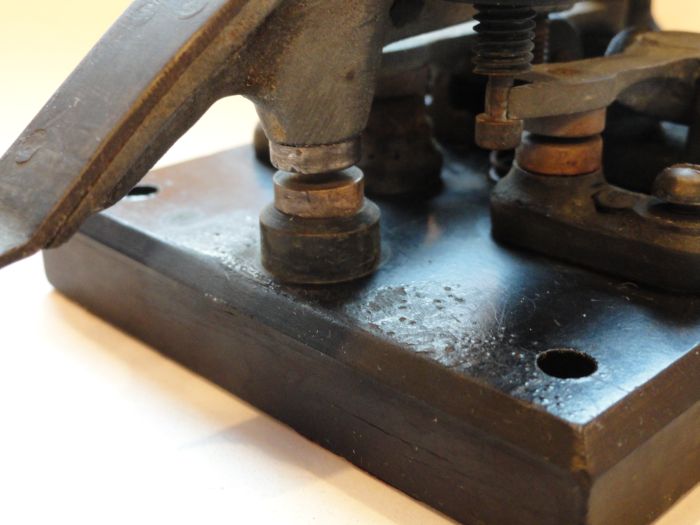
4023n A very close view of the main spark contact showing the burn marks in
the base made by the high voltage sparks:
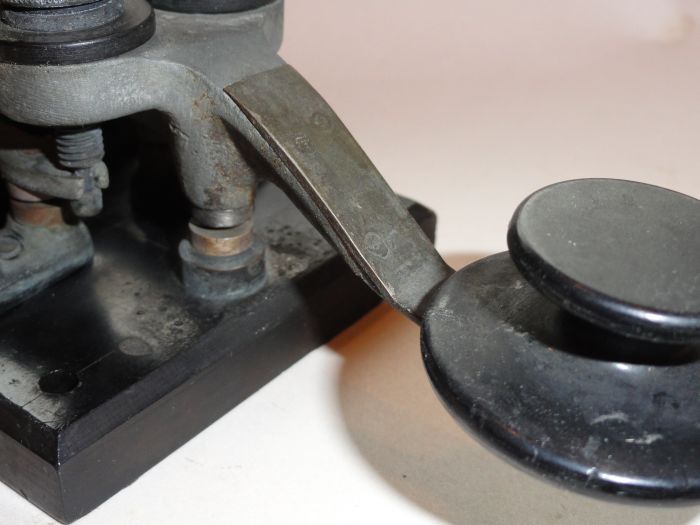
4023p A view of the brass strap that mounts the knob of the key showing how
it is riveted to the main metal casting of the key's lever:
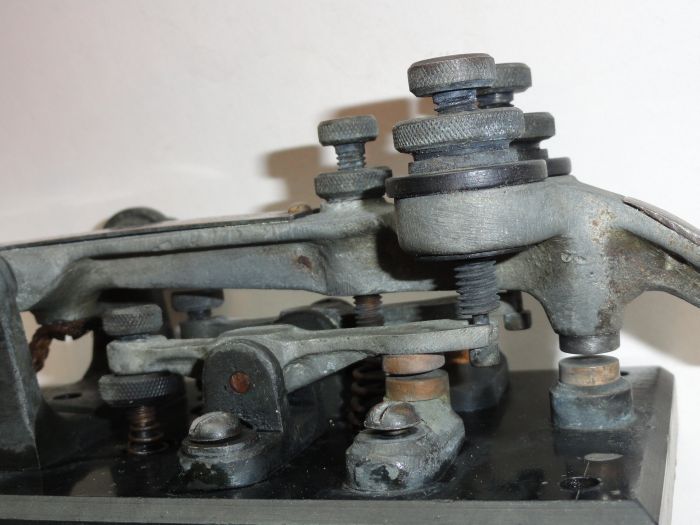
4023s A close view of the left side of the Amplifying Key showing the two
additional contact keys:
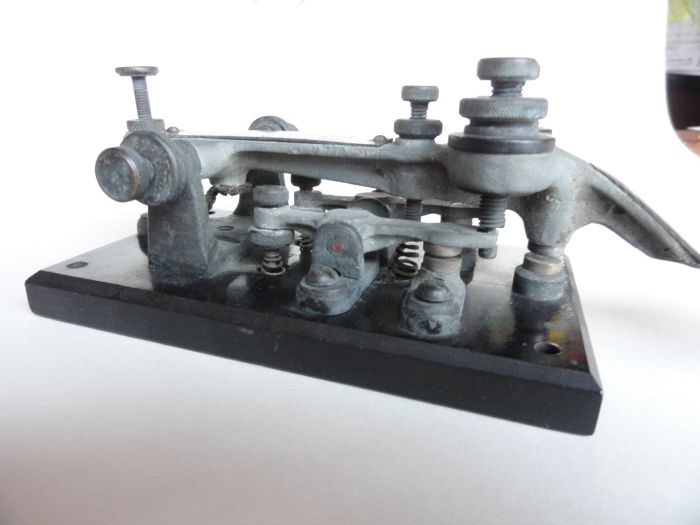
4023t A general view of the left side of the Amplifying Key showing the two
additional contact keys:
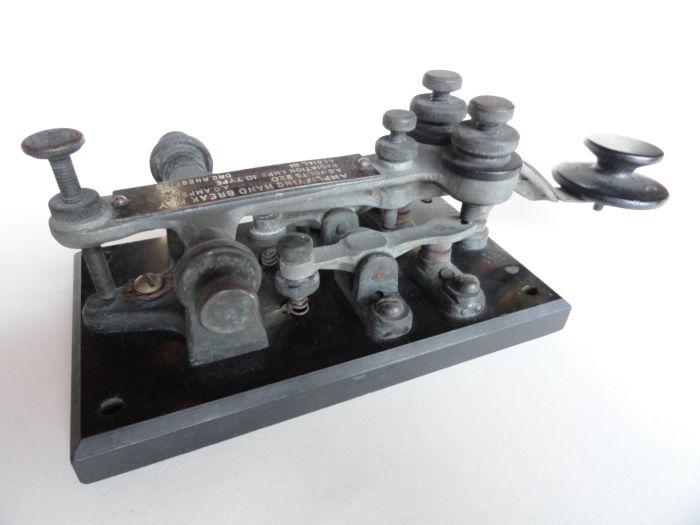
4023v An overall view of the left side of the Amplifying Key showing the two
additional contact keys:
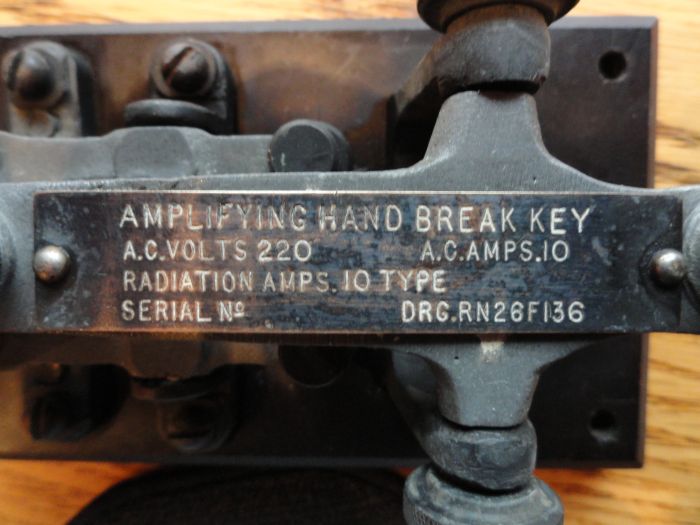
4023w A close view of the label on top of the Amplifying Key:
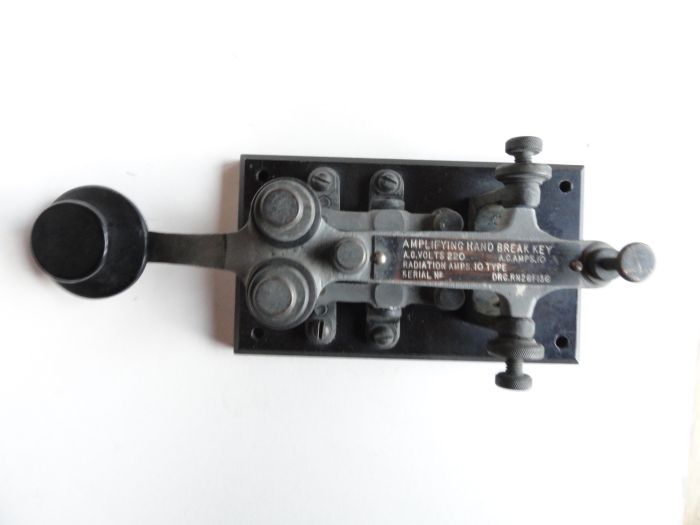
4023y An overall top view of the Amplifying Key:
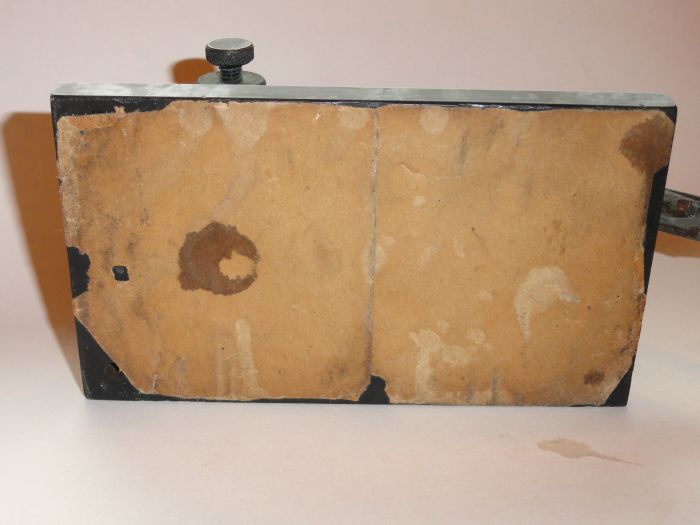
4023z A view of the bottom of the base of the Amplifying Key:

4022 LEMKUHL NORWEGIAN SPARK KEY
WITH FINNED CONTACTS:(14KB)
This early Norwegian spark key was made in Oslo by
Ingenior J. Lemkuhl. The lower contact has a set
of metal fins which help to dissipate the heat generated
by switching the high currents of a spark transmitter.
The serial number is 962.
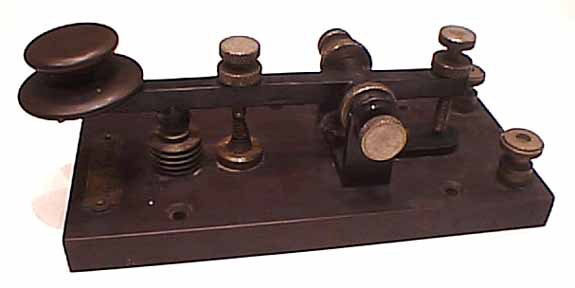
4022a Another view of the Lemkuhl spark key:(14KB)
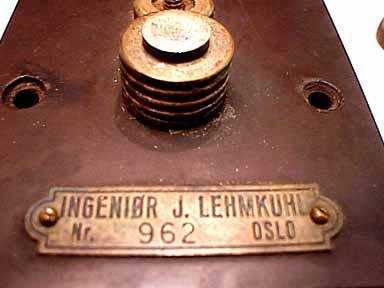
4022b A close view of the label on the key:(16KB)

4024 * UNUSUAL LOWENSTEIN SPARK KEY:(18KB)
This unusual little spark key was made by Lowenstein. The
design is quite unique. -> WA5Y.
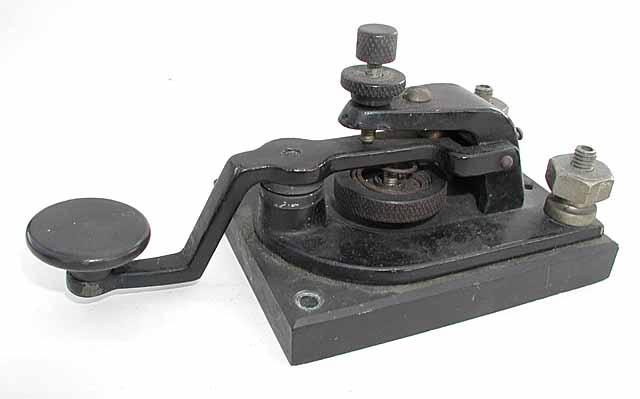
4024a Another view of the Lowenstein Spark
Key:(20KB)
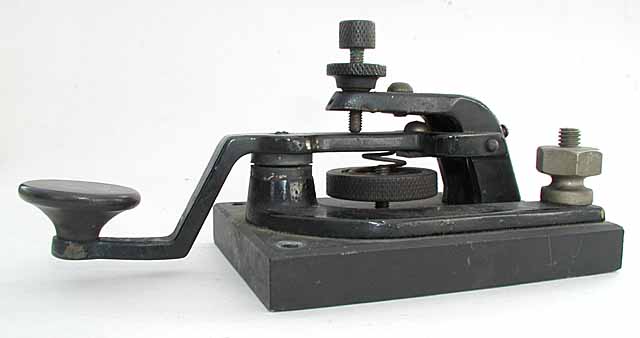
4024b Another view of the Lowenstein Spark
Key:(19KB)
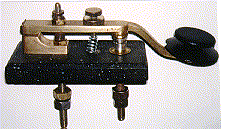
4025 MINIATURE MARCONI SPARK KEY: (15KB)
This miniature spark key made by Marconi has a 5" lever on a 2x4"
slate base which is stamped B116.

4027 * MARCONI BALL-CONTACT SPARK KEY: (22KB)
This large Marconi Spark Key is particularly unusual because it
uses a captive round ball to complete the contact. The ball is
self-centering and centers itself with every depression of the key.
The key is stamped: T.S.N197 Nr. 548.
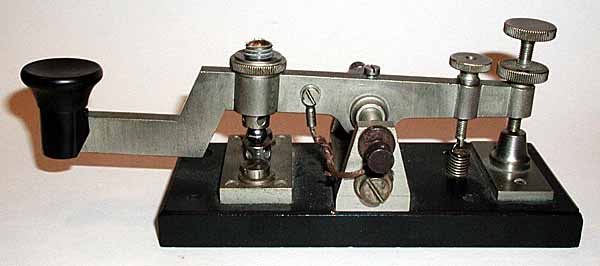
4027a * A view of the right side of the key:(22KB)
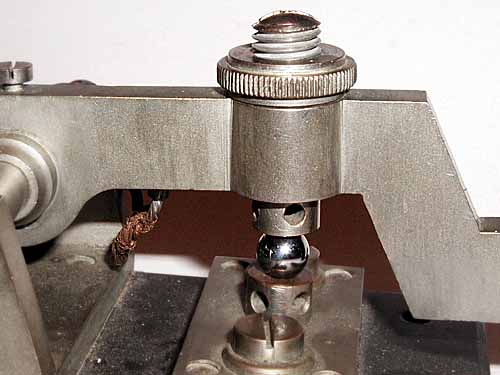
4027b * A view of the ball-contact:(27KB)
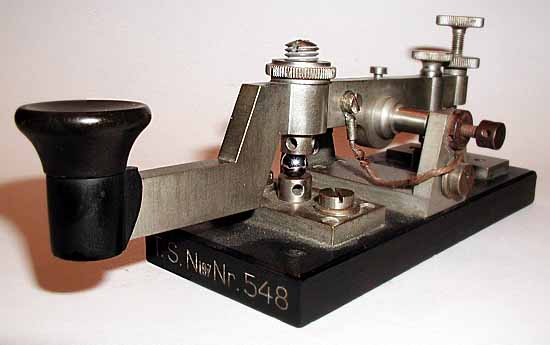
4027c * A view of the labeling on the key:(23KB)

4028 * MARCONI BALL-CONTACT SPARK KEY: (18KB)
This is very similar to number 4027 above. This large Marconi Spark Key is
particularly unusual because it uses a captive round ball to complete the
contact. The ball is self-centering and centers itself with every depression
of the key. The key is stamped: H.T.395 Nr. 18109.
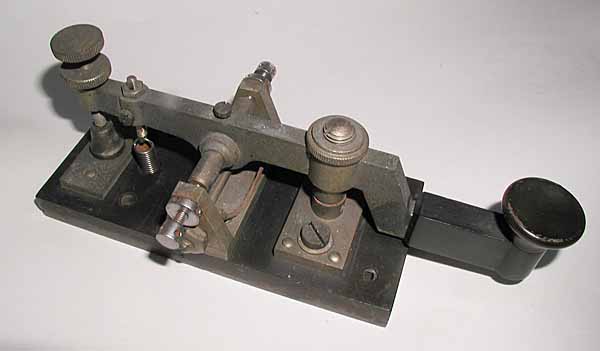
4028a * A Left Top view of the key:(18KB)
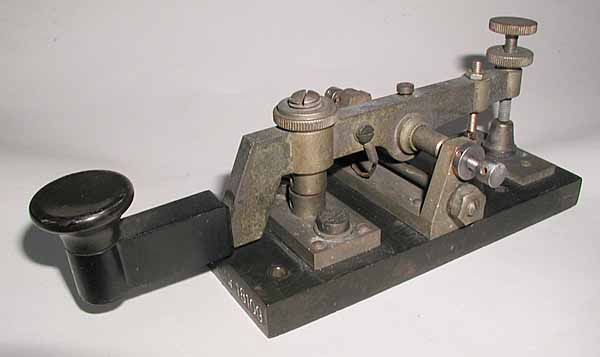
4028b * A Right Side view of the key:(19KB)
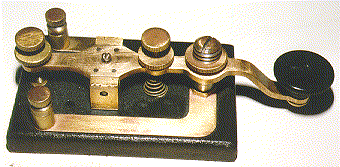
4030 MARCONI "ROAD MAP" SPARK KEY:(26KB)
This spark key was nicknamed the "roadmap" because of the conductors
traced out on its base like a map.
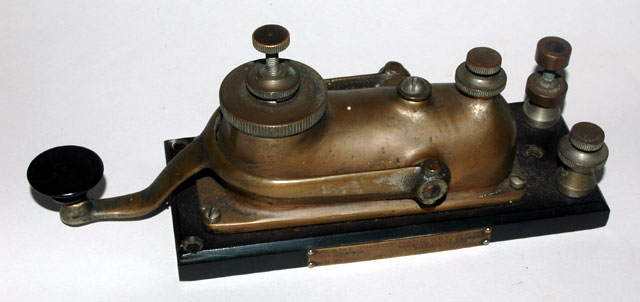
4032 * MARCONI MODEL SE-86 WW-I SUBMARINE SPARK KEY:
This Marconi 1/2 KW spark key was designed for use in American Submarines.
The contacts are enclosed to prevent open sparks.
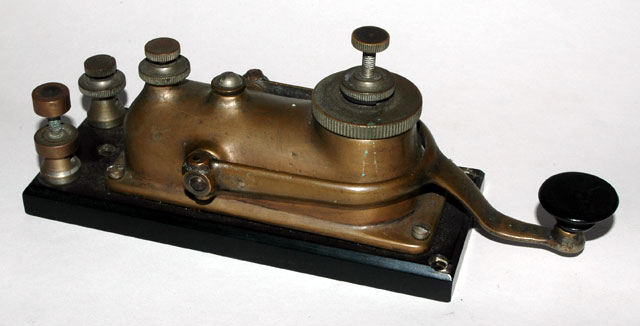
4032a * The other side of the Marconi SE-86:
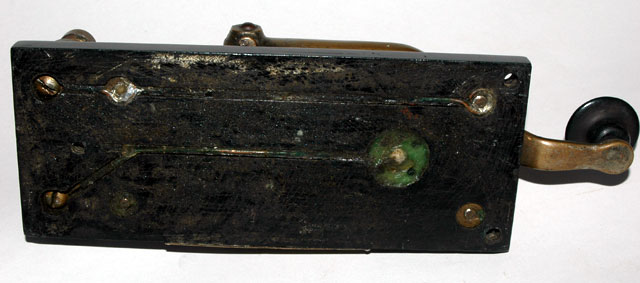
4032b * The underside of the base of the Marconi
SE-86:
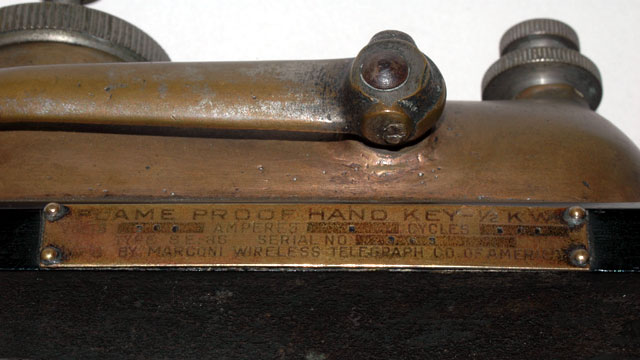
4032c * Closeup of the label of the Marconi
SE-86:
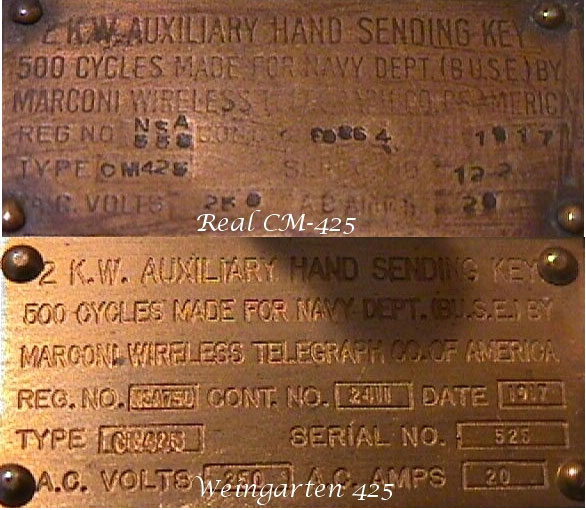
4034 MARCONI MODEL CM-425 SPARK KEY LABEL AND COUNTERFEIT
VERSIONS OF THIS KEY'S LABEL:(35KB)
The Marconi 425 spark key was a popular and well-made key which is considered
to be a very nice find for a collector. Unfortunately, Phil Weingarten made
quite a few reproductions of this key which he offered as being original
Marconi Keys. He did such a good job of copying the key that it is difficult
to tell the original from Phil's copies. This picture of the original label
and the Weingarten label should help collectors to identify the copies.
Chuck Brydges, W4WXZ has put together this list of differences between
original and counterfeit Marconi 425 keys that should help in determining the
authenticity of a key:
1. BEVELING AROUND TOP EDGE OF BASE: Original: Wide beveling. Repro: Narrow
Width Bevel.
2. ID TAG ORIENTATION: Original: To read the label hold key knob-end to LEFT.
Repro: To read label hold key knob-end to RIGHT.
3. KNOB CONSTRUCTION: Original: 1-piece single button knob. Repro: 1-piece
skirted knob.
4. ID TAG LETTERING: Original: Lettering is larger and all letters and numbers
are NOT the same size. Repro: Lettering is smaller and all letters and numbers
are the same size.
5. PLATING: Original: Nickel plating originally on lever, lever hardware,
trunnion adjustment hardware and binding post nuts (May be very worn). Nickel
plated or silver ground strap. Repro: Never had any nickel plating. Shiney
copper ground strap from lever to base.
6. CONTACTS: Original: 5/8" silver contacts marked '507' in numbers
considerably smaller than the thickness of the contacts. Repro: numbers '507'
almost the thickness of the contacts.
7. COMPRESSION SPRING: Original: Wider-spaced COPPER spring. Repro:
Closer-spaced STEEL spring.
8. BASE HARDWARE: Original: Thinner and smoother 'roadmap' hardware. Repro:
Thicker and more bumpy 'roadmap' hardware.

4035 MASSEY SPARK KEY (Phil Weingarten Reproduction):
(16KB)
This huge key was designed to key the Massey Spark Transmitters used around
1915. This key was made by Phil Weingarten and it is an accurate reproduction
of the actual key with a few notable exceptions such as the label and internal
screw as noted below. Collectors can use these details to help identify
counterfeit versions of this key.
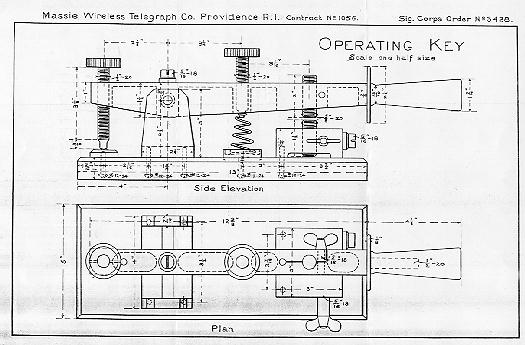
4035a This is the actual DESIGN DRAWING for a
Massey key:(45KB)
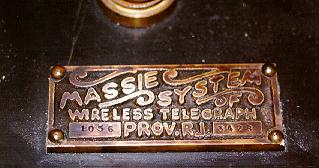
4035b ENLARGED VIEW OF LABEL OF THE 'REPRODUCTION'
MASSEY KEY:(16KB)
This label appears to have been made from a sand casting of an original label.
It is much rougher than the original and is perhaps the easiest way of
identifying a reproduction.
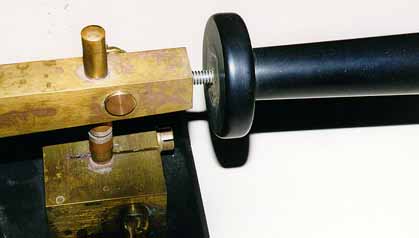
4035c Close-up view of the cadmium 1/4-20 bolt holding the
knob to the key:(14KB)This bolt is one of the things that give away the
fact that it is a reproduction key. In the actual Massey Key, the bolt is
brass.

4037 ** MASSEY SPARK KEY:(10KB)
This unusually long Massey spark key is in the collection
of Pete Malvasi - W2PM.

4038 ** MASSEY SPARK KEY:(25KB)
This unusually long Massey spark key is in the collection
of George Rancourt, K1ANX.
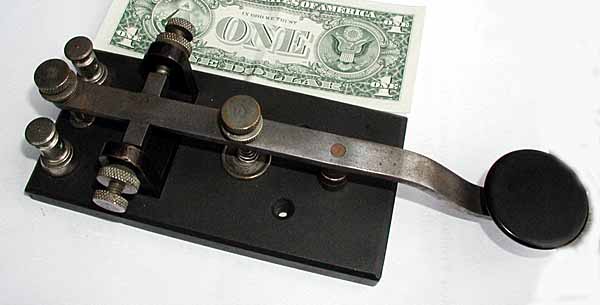
4038a Another view of the Massey Spark Key:(24KB)
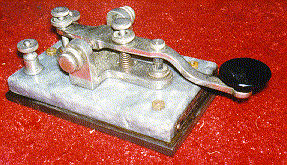
4040 * MURDOCH SPARK KEY:(28KB)
Lovely all plated key mounted on a grey marble base.
The label reads: Wm. J. Murdoch, Co. Chelsea, Mass, Chicago,
San Francisco. The lever is somewhat sculptured and flat and
the 1/4 inch contacts are removable and replaceable.

4041 MURDOCH SPARK KEY ON WOODEN BASE:(16KB)
Lovely all plated key mounted on a wooden base which might
be a replacement. The lever is somewhat sculptured and flat and
the 1/4 inch contacts are removable and replaceable.
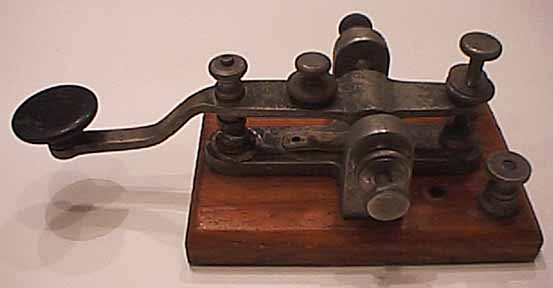
4041a Another view of the Murdoch Spark Key:(15KB)

4042 * MURDOCH SPARK KEY ON WOODEN BASE:(24KB)
Similar to Number 4041 above. This key is in the George Rancourt,
K1ANX collection.
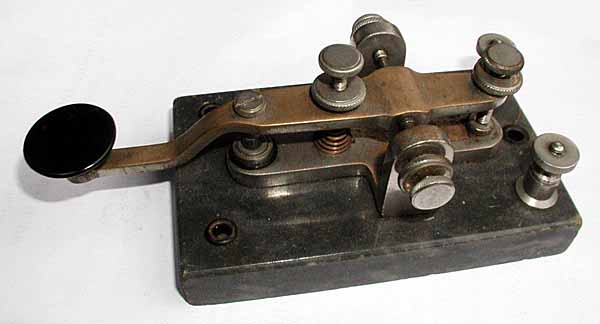
4042a * Another view of the Murdoch Spark
Key:(21KB)

4045 * EASTERN PRECISION SPARK KEY ON MARBLE BASE:(17KB)
Lovely all plated key mounted on a marble base which has been chipped
and then repaired. This key is very easy to mistake for a
Bowman (See number 4150 below.) key because of its wide flat lever.
It is also easy to mistake for a Clapp-Eastham Boston key
(See number 4110 below.) because the mechanism is similar.
This is a very hard-to-find key. -> Tony Rogozinski.
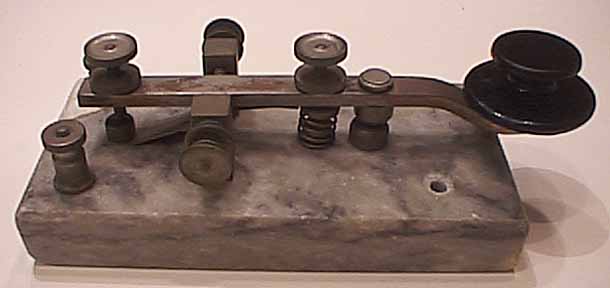
4045a Another view of the Eastern Precision
Spark Key:(17KB)

4047 * UNKNOWN SPARK KEY:(17KB)
This is a well made spark key mounted on a black base.
The manufacturer is not known. It is in the George Rancourt,
K1ANX collection.
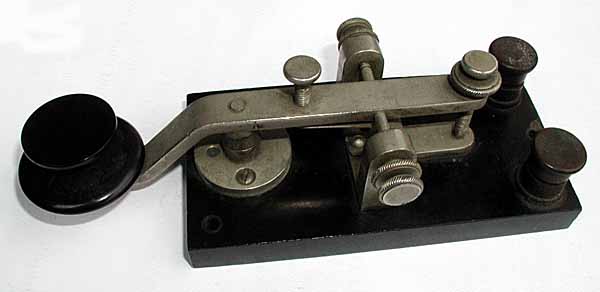
4047a * Another view of the Unknown Spark
Key:(18KB)

4048 * UNKNOWN SPARK KEY (Similar to above):(25KB)
This is also a very well made spark key mounted on a brown base and
showing many similarities to number 4047 above. The manufacturer is not
known. It is in the Jim Jarvis, N2EA collection and he has kindly
provided these pictures and allowed me to include them in the museum.
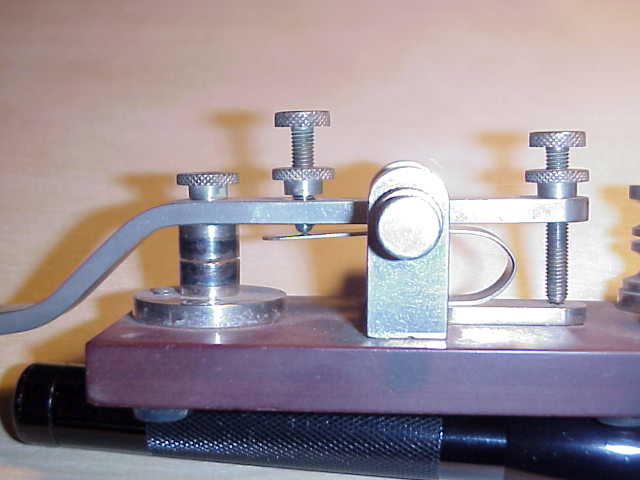
4048a * A closer view of the UNKNOWN SPARK KEY:(25KB)
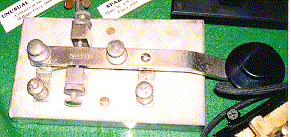
4050 A.W.BOWMAN SPARK KEY: (22KB)
All plated spark key integrated with a marble base. Large 5/16th inch
diameter silver contacts. Lever stamped "A.W.B.&CO." Made by
A.W.Bowman Co. Circa 1915. Many of these keys were made by
Bowman without their name stamped into the lever and offered
for sale by Sears and Montgomery Ward.

4052 * UNUSUAL A. W. BOWMAN KEY: (19KB)
This key is stamped A. W. Bowman and is the only example of
this style key that I have seen with the Bowman label. All of
the other Bowman keys that I have seen are like number 4050 above.
This key was shown to me by a collector at the Dayton 2000 hamfest
and he allowed me to take this picture and display it in my museum.
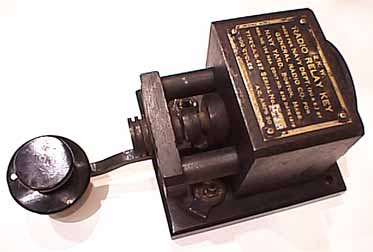
4055 GENERAL RADIO 2KW SPARK RELAY KEY:(18KB)This
unique key combines a horizontal-action spark key with a spark relay.
It can be operated by pressing the key knob or by activating the
relay coil which is enclosed in the black box.
Pressing the down the key lever closes the
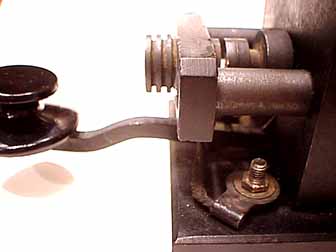
4055a large 5/8-inch silver contacts with cooling
fins visible on the left:(13KB)
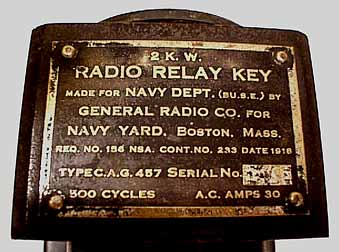
4055b The label reads:(27KB)
'2 K. W. RADIO RELAY KEY. Made for NAVY DEPT. (Bu. S. E.) by
General Radio Co. for NAVY YARD, Boston, Mass. Reg. No. 156 NSA. Cont. No.
233. Date 1918. Type C.A.G. 457 Serial Number __ 500 cycles, A. C. AMPS
30.'

4058 SE68 NAVY SPARK KEY FROM WW1 SUB CHASER:(20KB)
1918 U. S. Navy 20 ampere key. All cast brass construction mounted
on a black bakelite base. Very large 5/8 inch diameter replaceable
silver contacts. Legs end flush with base. Label reads: AUXILIARY
HAND SENDING KEY. 500 Cycles. Made for Navy Department BU SE by
Lowenstein Radio Incoporated, Brooklyn New York. KW: 2, Reg No.
1689 NSA, Cont. No. 38279, Date 1918, Type No. SE-68, Serial No. 193L,
A.C.Volts: 250, A.C. Amps: 20.
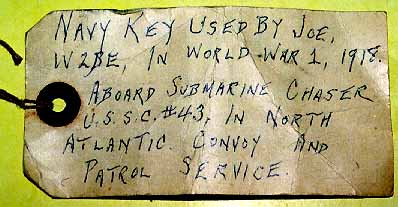
4058a This photo shows the tag:(27KB)
Which reads: :NAVY KEY USED BY JOE, W2BE, IN WORLD WAR 1, 1918. ABOARD
SUBMARINE CHASER U.S.S.C. #43. IN NORTH ATLANTIC CONVOY AND PATROL
SERVICE.
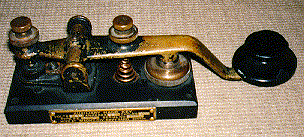
4060 * SE68A NAVY SPARK KEY:(26KB)
1918 U. S. Navy 50 ampere key. All cast brass construction mounted
on a black bakelite base. Very large 5/8 inch diameter replaceable
silver contacts. Legs end flush with base. Label reads: AUXILIARY
HAND KEY. Volts 250, Amperes, 50, Cycles 500, Type S.E.68A Serial
No. B1067. Mfg'd by MACH'Y DIV, NAVY YARD, BOSTON.
TRADED TO: WB2BYQ 1995.
4061 Same as 4060 but with long legs.(4061* -> traded
4061A Same as 4060 but with very long legs and S/N 1297
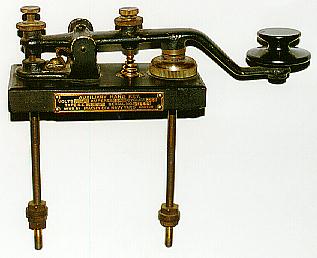
4061B Same as 4060 with very long legs and s/n
B1282:(14KB)
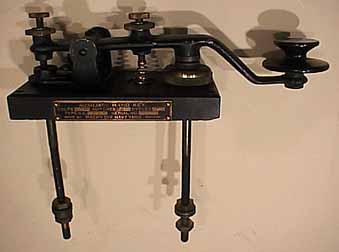
4061Ba Another view of 4061B:(12KB)
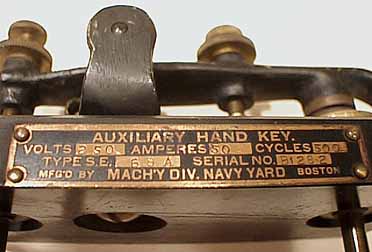
4061Bb A close view of the label of 4061B:(20KB)
4062 SE68A NAVY SPARK KEY: Similar to 4060 but with repro label.
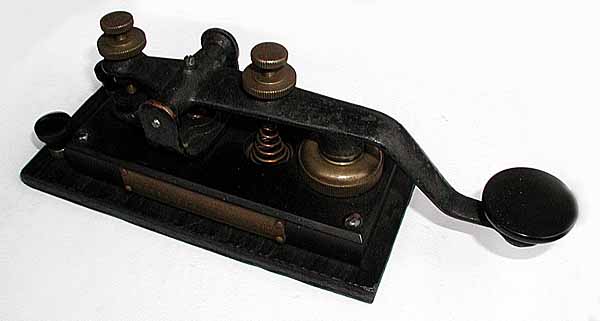
4063 * U.S. NAVY SPARK KEY: (19KB)
This example of the above key is in the George Rancourt, K1ANX collection.
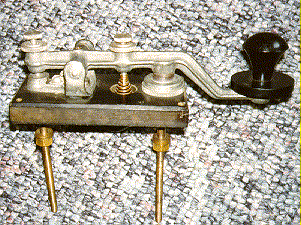
4070 U.S. NAVY SPARK KEY: (46KB)
Unusual variant of 1918 U. S. Navy 50 ampere key. All silver?
plated cast brass construction with ribbed lever mounted on a black
bakelite base with long legs, washers, and nuts. Very large 5/8
inch diameter replacable silver contacts stamped "504". Found new
in original box which has since been lost.

4078 ** WIRELESS SPECIALTIES SE-653 FLAMEPROOF
SPARK KEY:(11KB)This unusual key is similar to the larger
Marconi SE-86 Spark Key. It's contacts were enclosed within
a metal cover to allow it to be used in explosive environments.
(This key in in the collection of Pete Malvasi - W2PM.)
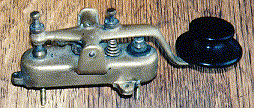
4080 MINIATURE WIRELESS SPECIALTIES SPARK KEY: (20KB)
Massive lever similar to 4060 and 4078 but much smaller overall
dimensions with an oval all-brass base with legs for mounting
and making electrical connections.
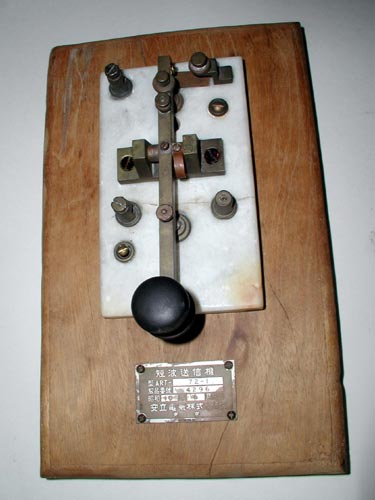
4085 LARGE JAPANESE WW-1 NAVY SPARK KEY ON MARBLE
BASE:(20KB)
This large Japanese Navy spark key uses the classic Japanese heavy
straight lever. It has large, easily replaced main contacts and a
receiver-shorting contact to protect the receiver circuitry when the
transmitter is keyed on. It also has the typical large connectors
found on Japanese keys through WW-2 but it has screw slots instead
of the horizontal pins found on the later versions. The key also
has a skirt to protect the operator's fingers from the hot spark.
I was told that the key was removed from a Japanese ship at the end
of WW-1. I suspect that the wooden base is not original.
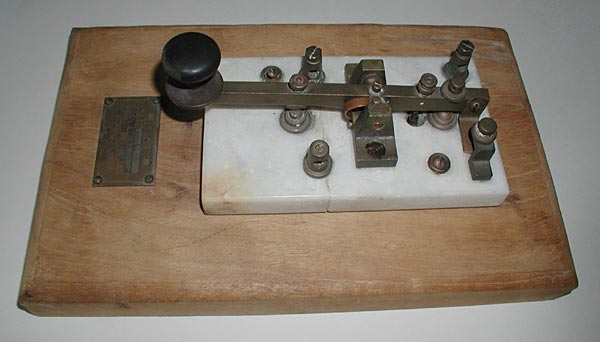
4085a Another view of the Japanese Spark
Key:(20KB)
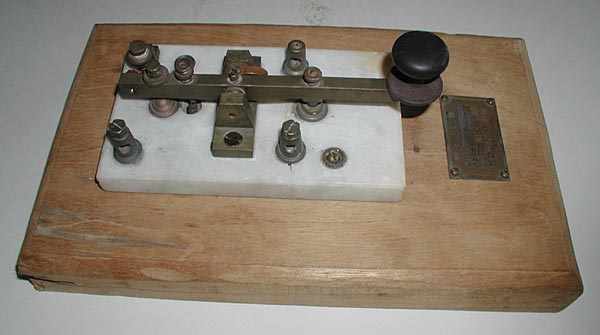
4085b Another view of the Japanese Spark
Key:(20KB)
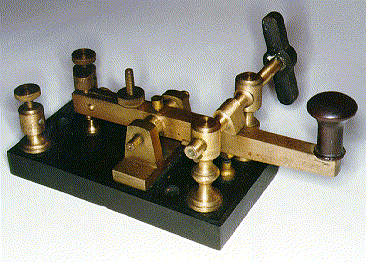
4090 LARGE BRITISH WIRELESS & LIGHT KEY: (44KB)
This key was used for blinking the lights on Navy vessels and
frequently as a wireless key. It has heavy brass parts and an
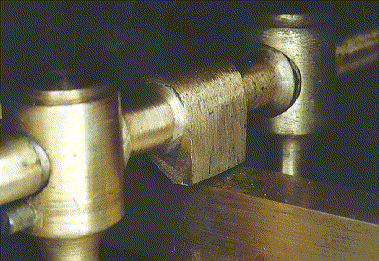
4090a the unusual cam operated shorting
switch.(45KB)
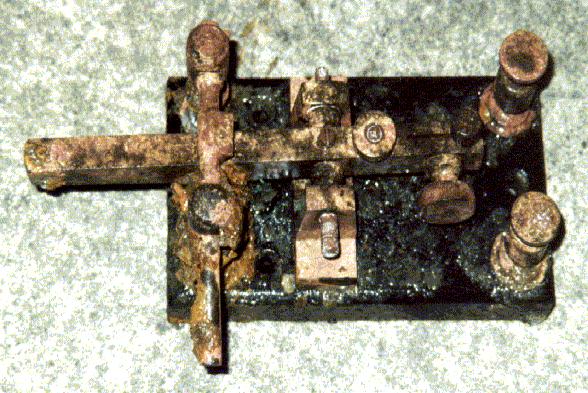
4090b * The same type and model of key as it was recovered
from a SHIPWRECK. Picture sent to me by another collector.

4095 LARGE CANADIAN MARCONI SPARK KEY: (18KB)
This massive spark key was made by the Canadian Marconi Company. The
only marking on the key is an XXIII carved into the base. The key was found
at the 2001 Dayton Hamfest and the seller had found it in an antique shop
about 20-miles from Dayton.
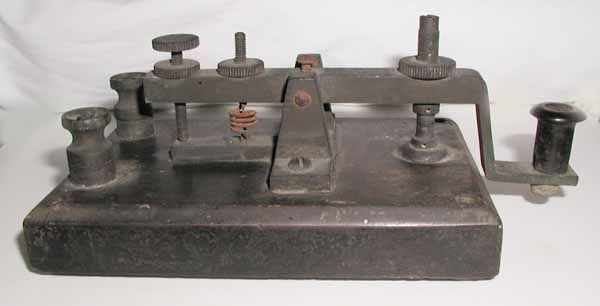
4095a A left-side view of the Canadian Marconi Spark Key:
(16KB)
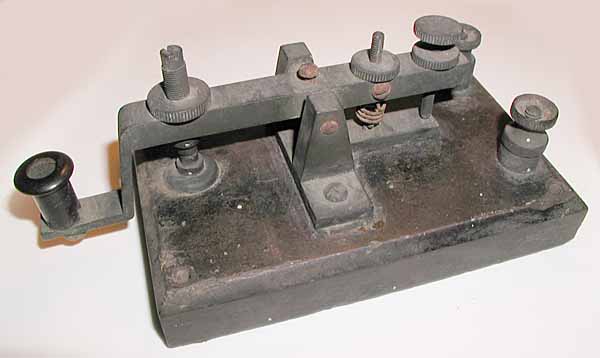
4095b A different right-side view of the Canadian Marconi
Spark Key: (22KB)
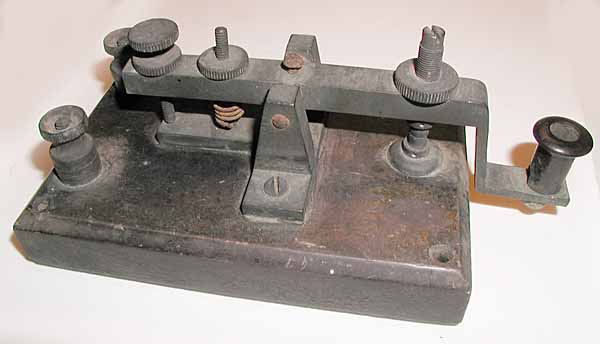
4095c A different left-side view of the Canadian Marconi
Spark Key: (22KB)
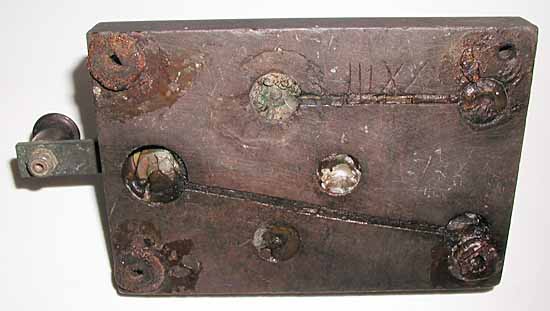
4095e A view of the bottom of the base of the Canadian
Marconi Spark Key: (25KB)

4097 VERY EARLY FRENCH SPARK KEY:(30KB)
This is a very early French spark key.
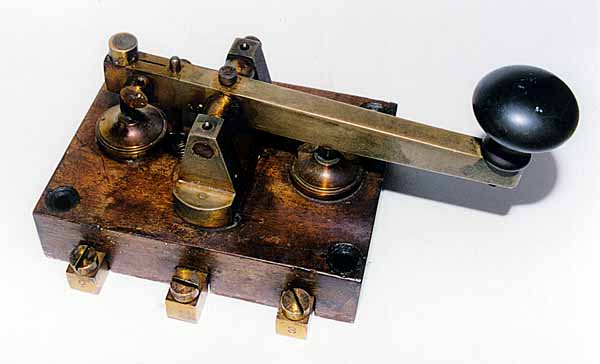
4097a Another view of the Early French
Spark Key:(26KB)
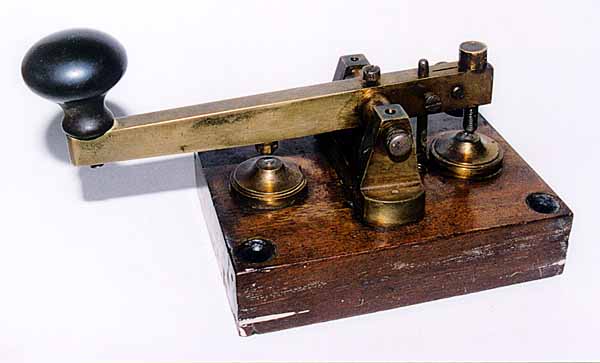
4097b Another view of the Early French
Spark Key:(26KB)
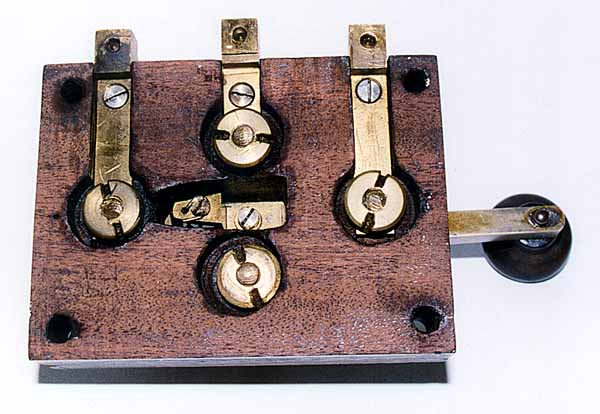
4097c A view of the very heavy conductors
under the base of the Early French Spark Key:(45KB)

4098 EARLY FRENCH SPARK KEY:
This is a early French spark key.
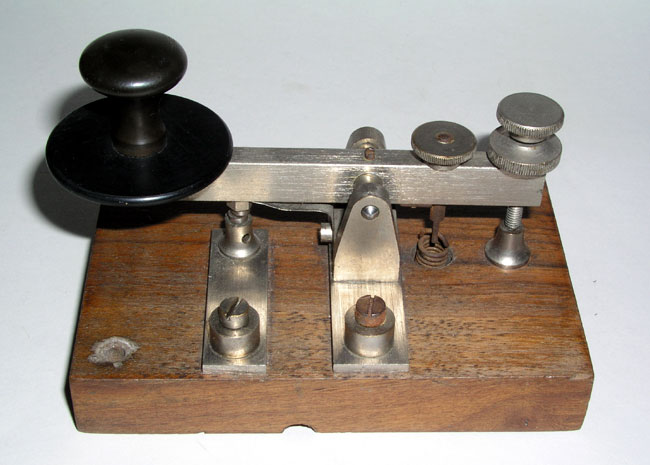
4098a Another view of the Early French
Spark Key:(26KB)

4099 FRENCH RADIO KEY MADE BY MANITONE:
This French key was made in rather large quantities by Manitone and used for
radiotelegraph transmissions and practice.
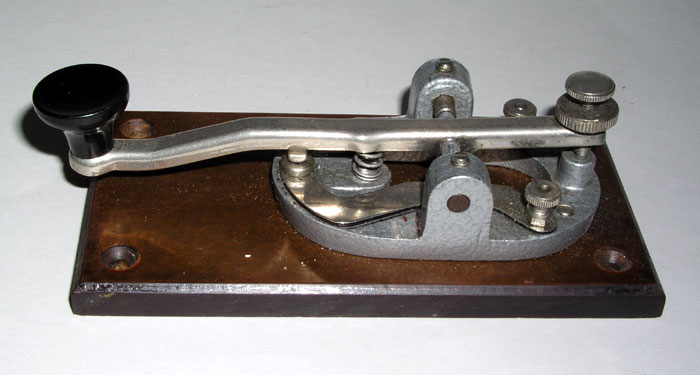
4099a Another view of the French Manitone Key:
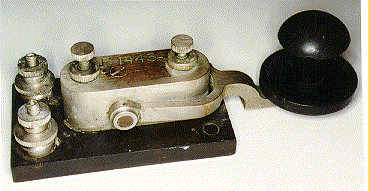
4100 * WWI NAVY SE-1443A WIRELESS KEY: (33KB)
The contacts are enclosed in a heavy, plated-brass flameproof box.-> W2PM

4101 * WWI NAVY SE-1443A WIRELESS KEY: (21KB)
This example is in the George Rancourt, K1ANX collection.
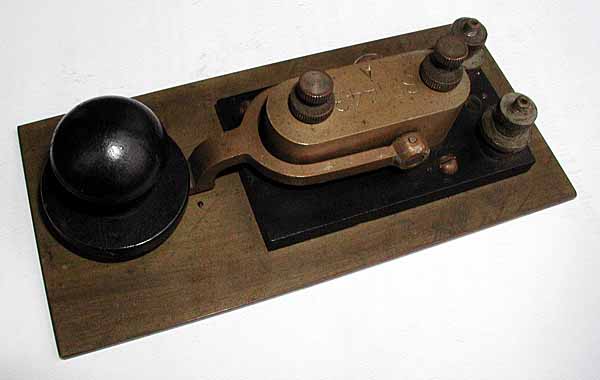
4101a * Another view of the Navy SE-1443A Wireless
Key: (21KB)

4102 ** UNUSUAL GERMAN SPARK KEY:(11KB)
This massive high-current key is marked: H.T. 3 No. 3362.
(It is in the collection of Pete Malvasi - W2PM.)

4103 UNUSUAL GERMAN WW-1 LUFTWAFFE
AIRCRAFT SPARK KEY:(13KB)
This interesting key was used by the German Luftwaffe during
WW-1. Notice the interesting similarity of the lever of this key
to the lever of the preceding German Spark Key (Number 4102).
The reason for the high wooden knob is not known. They appear
on several German keys. One possibility is that the high
knob allowed the operator to use the key while wearing the
heavy gloves required during high altitude flight in open
cockpit aircraft.

4104 ** FEDERAL TELEGRAPH COMPANY NAVY KEY:(9KB)
This key has an unusual knob which can be moved up and down on a
central cylinder presumably to allow it to be adjusted to suit
the preference of different operators. (It is in the collection of
Pete Malvasi - W2PM.)
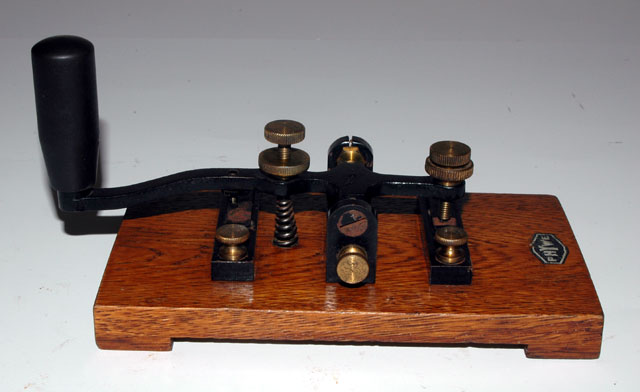
4106 SIMPLE GERMAN PHYWE AIRCRAFT SPARK KEY WITH HIGH
WOODEN KNOB:
This is another German key as indicated by the unique spring-supported
contacts. It has the same kind of high knob seen in number 4103 above
suggesting that it was designed for use in aircraft. The label suggests that
it was made by PHYWE.
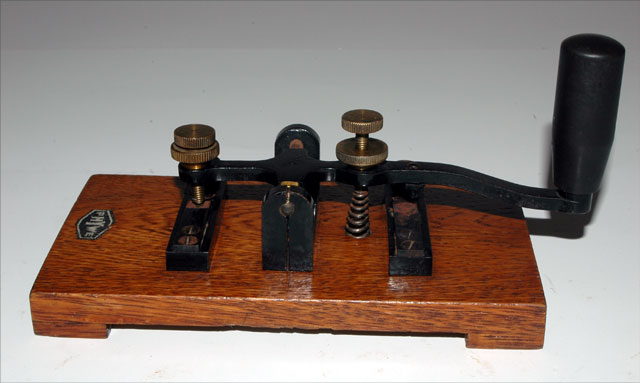
4106a A left side view of the simple German Aircraft
key:
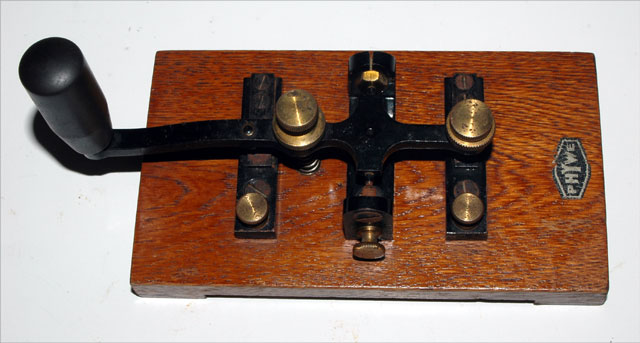
4106b A top view of the simple German Aircraft
key:

4108 LARGE AND UNUSUAL EMILIO CIAMI ITALIAN WIRELESS
KEY:(16KB) This huge key weighs almost 10-pounds and measures almost
12-inches long. As you can see from the label, the Tipo or type is
''pesante'' which translates into the word ''heavy''.
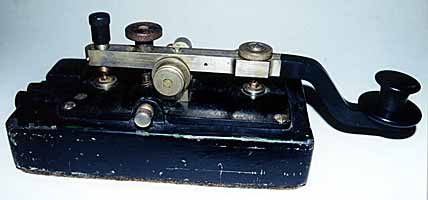
4108a A view of the other side of the
key:(15KB)
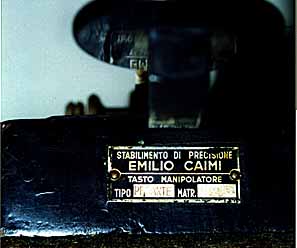
4108b A view of the label on the front of
the key:(15KB)
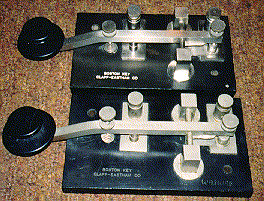
4110 CLAPP-EASTHAM "BOSTON" SPARK KEY:(35KB)
The classical nickel plated Clapp-Eastham mechanism on a black base
stamped: BOSTON KEY, CLAPP EASTHAM CO. The company also made these
keys on a brown base and on a marble base (See below).
4112 * CLAPP-EASTHAM "BOSTON" SPARK KEY: Same as above. -> W2PM
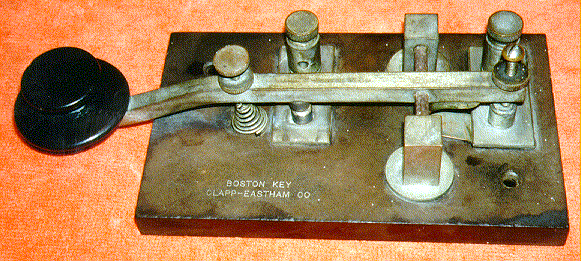
4114 * BROWN BASED CLAPP-EASTHAM "BOSTON" SPARK KEY: (85KB)
Same as 4110 but with an unusual brown base.

4116 CLAPP-EASTHAM "BOSTON" SPARK KEY WITH MARBLE
BASE:(20KB)This key is in the collection of George Rancourt, K1ANF.
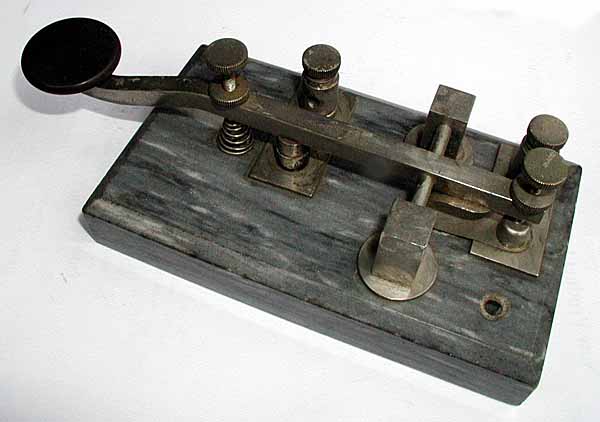
4116a Another view of the Marble-Based
Clapp-Eastham "Boston" Spark Key:(28KB)
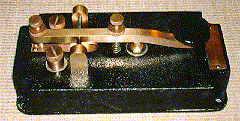
4120 * RUSSELL & STOLL WIRELESS / SPARK KEY:(18KB)
Very early all brass mechanism with brass lever mounted on a thick
black wrinkle finished cast base which contains the original mica
insulating strips and insulators and a condenser labeled Stromberg
Carlson Quality Condenser, Code No 21. Electro Static Capacity 1MFD.
Inspected.Brass label on top of base reads RUSSELL & STOLL CO.New York.

4122 * WW-I SPARK KEY RECOVERED FROM THE SUNKEN USS SAN
DIEGO:(17KB)This key was recovered by diver Mark Silverstein
from the radio room in the wreck of the USS San Diego which lies off
the coast of Long Island, NY. He was unable to recover the entire
base but plans to make another attempt shortly. It is one of the
prized artifacts in his collection. The key looks somewhat similar
to the "Overland" spark key number 4125.
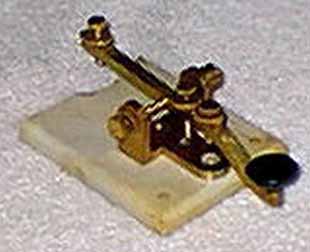
4122a Another view of the recovered key:(16KB)
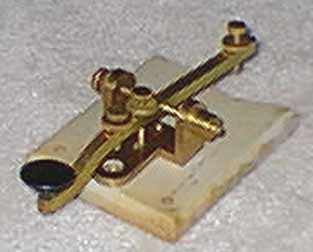
4122b Another view of the recovered key:(14KB)
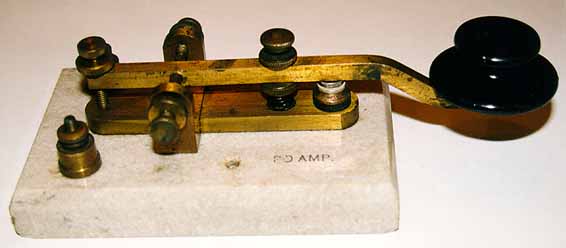
4125 * "Overland" Spark Key:(14KB)
The "Overland" spark key was sold by W. B. Duck Co. of Toledo, Ohio.
It was probably made for them by RECo. or WSA?
This key belonged to David Meirowitz who used it before the start of
WW-I as station "1EG". His son Richard recalls that it was used with
a spark transmitter built on a marble base. When the war began, he was
forced to dismantle his equipment and, at the end of the war, he was issued
the call "W1TOA". He reapplied for his original call and was issued W1EG.
The key is mounted on a marble base which is inscribed "20A".

4126 * "Overland" Spark Key:(28KB)
Similar to Number 4125 above. This key is in the George
Rancourt, K1ANX collection.
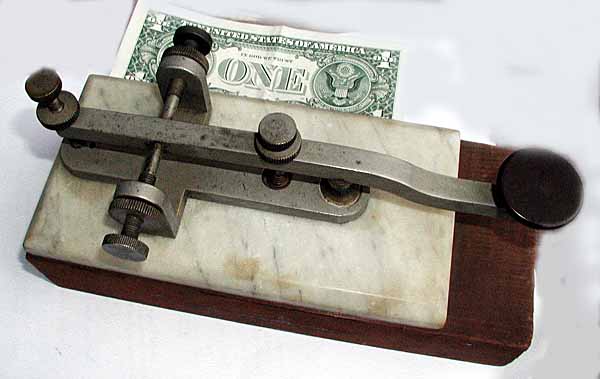
4126a * Another view of the "Overland" Spark
Key:(28KB)

4127 * McINTOSH ELECTRIC SPARK KEY WITH TWO SHORTING SWITCHES:(17KB)
This small spark key has two shorting switches. The bottom of the
base is marked: 2250 - L - 4. It looks as though it may have been
mounted on a spark transmitter.
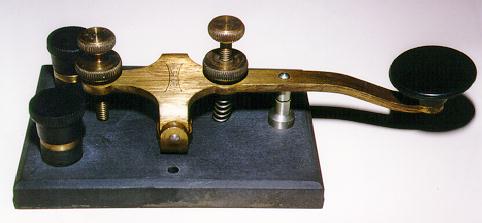
4130 MIGNON SYSTEM WIRELESS KEY:(17KB)
This simple key is
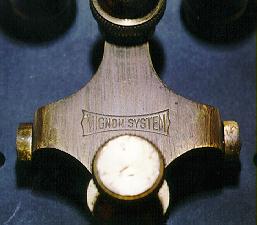
4130a stamped: "MIGNON SYSTEM":(12KB)
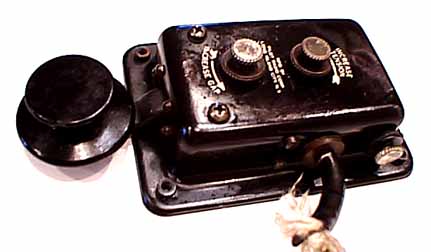
4134 PILOT RADIO COMPANY RADIO KEY:(20KB)
This interesting little flameproof key has
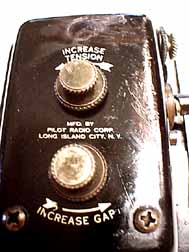
4134a both gap spacing and spring tension
adjustments:(20KB)
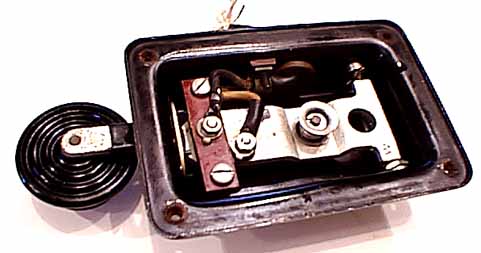
4134b Underside view of the Pilot Radio Key:(20KB)

4140 BUNNELL SPARK KEY:
Heavy all brass key with rectangular base with corners cut inwards
and stamped JHBunnell & Co. New York, USA. Mica insulators and 1/8
inch silver contacts. circa 1915.
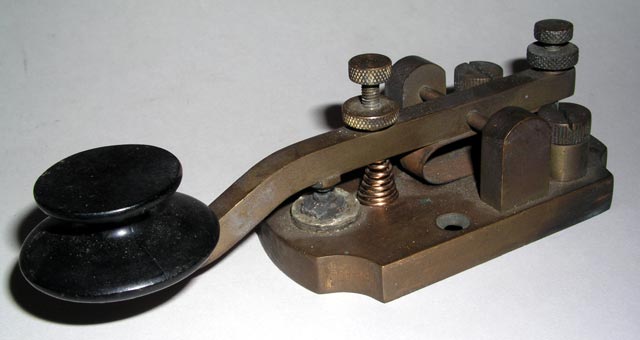
4140a BUNNELL SPARK KEY:
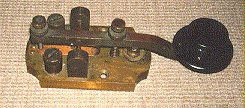
4140.gif Another BUNNELL SPARK KEY:(16KB)
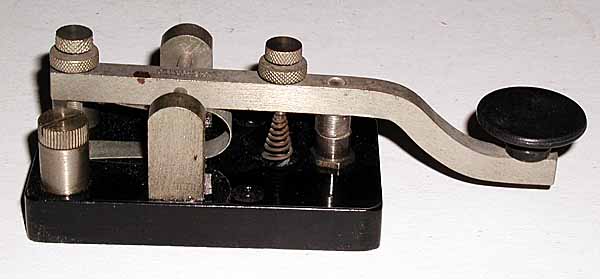
4142 BUNNELL SPARK KEY IN ORIGINAL BOX:(22KB)
All plated brass key mounted on a black bakelite base. Lever
is stamped J.H.Bunnell & Co. New York, USA. 1/4 inch silver
contacts which can be replaced easily by unscrewing them.
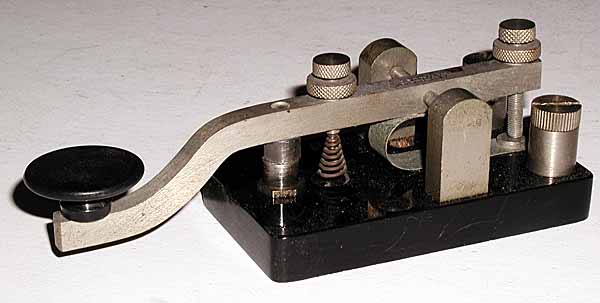
4142a Right side view of Bunnell Spark Key:(24KB)
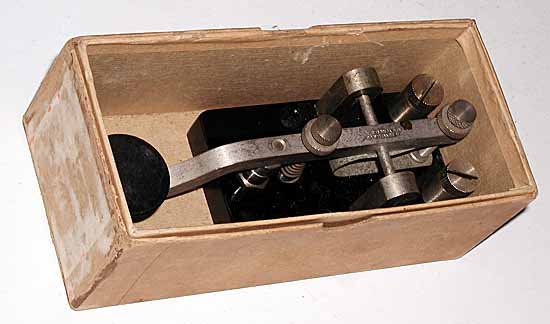
4142b View of Bunnell Spark Key in its box:(25KB)
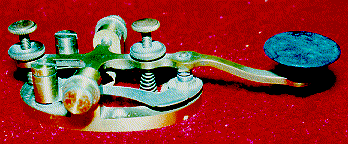
4144 BUNNELL SPARK KEY:(22KB)
All brass key stamped JHBunnell & Co. New York, USA. This is the
"Triumph" key designed for spark use. It has no shorting switch
and has an all brass lever. The silver contacts measure
1/4 inch in diameter. Key is screwed to a wooden base. circa 1915.
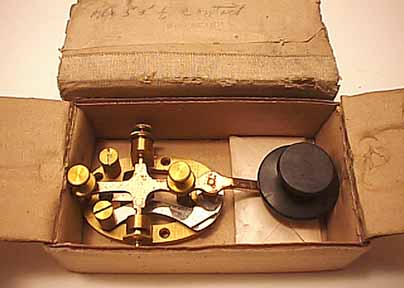
4145 * BUNNELL SPARK KEY IN ORIGINAL BOX:(19KB)
All brass key stamped JHBunnell & Co. New York, USA. This is the
"Triumph" key designed for spark use. It has no shorting switch
and has an all brass lever. The silver contacts measure
1/4 inch in diameter. The key is in the origianl Bunnell box.
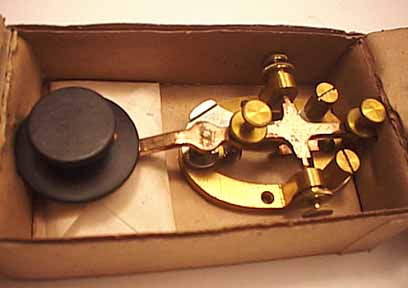
4145a Another view of the boxed key:(16KB)

4148 "DIME KEY" SPARK-MODIFIED KEY:(13KB)
Many hundreds of ham radio operators who could not afford the
price of the commercial spark keys soldered dimes to the upper
and lower contacts of inexpensive land-line keys. The dimes
were made of silver at that time and could stand up to the
high currents of spark transmitters.
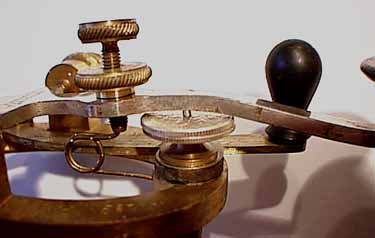
4148a Close-up view of "dime" contacts:(15KB)
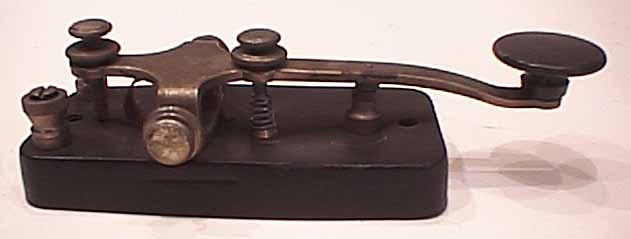
4160 UNKNOWN SPARK KEY:(13KB)
Unusual all plated brass key with stamped lever integrated onto
a black bakelite base. 1/4 inch silver contacts.
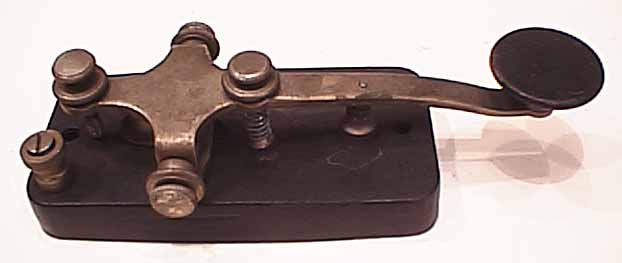
4160a Another view of the unknown spark key:(14KB)
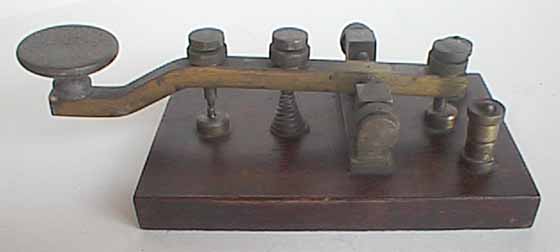
4165 UNKNOWN SPARK KEY:(16KB)
Unusual all brass key with Clapp-Eastham 'Boston' key-like
long tapered spring mounted on a wooden base.
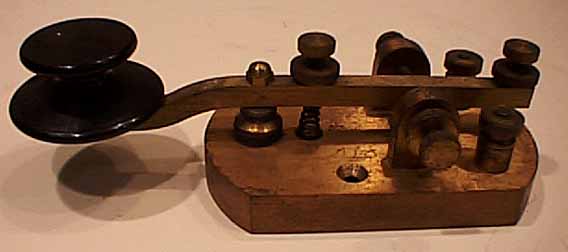
4167 SIGNAL ELECTRIC SPARK KEY:(15KB)
All brass key with solid oval brass base engraved SIGNAL ELECTRIC
MFG. CO. MENOMINEE, MICH: Mica insulators and 3/8 inch silver
contacts. Bottom of base engraved 19 with a trade mark.
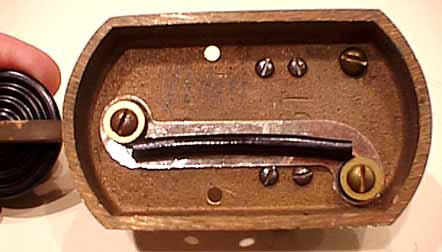
4167a A view of the bottom showing the mica
insulation:(20KB)

4170 * SIGNAL ELECTRIC SPARK KEY:(15KB)
All brass key with solid oval brass base engraved SIGNAL ELECTRIC
MFG. CO. MENOMINEE, MICH: Mica insulators and 3/8 inch silver
contacts. Bottom of base engraved 19 with a trade mark.
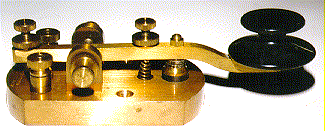
4170a Another view of the Signal Electric
Spark key:(20KB)
4172 * Same as above mounted on a wooden base with 1/4 inch diam. contacts.
4176 * Same as 4170 above but has no name on brass base and not mounted.
Keys like this were often manufactured for Sears without mfgr name on the
key.
4178 * SIGNAL ELECTRIC COMPANY SPARK KEY. All chromed base.
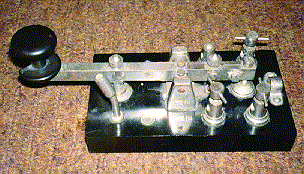
4220 * VERY EARLY JAPANESE SPARK KEY: (36KB)
Plated mechanism with replacable contacts on a black base which is
stamped with Japanese symbols. An extremely unusual key with a post
sticking way up, Multiple polarity switching contacts, and binding
posts with horizontal bars through them. >W2PM
4221 * Similar to above but of more recent manufacture.W/O Japanese
symbols.
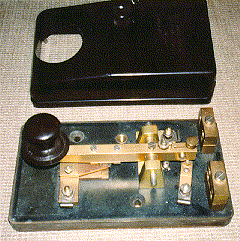
4230 BRITISH AIR MINISTRY WIRELESS/SPARK KEY:(33KB)
Large British Air Ministry all brass key integrated with a black
bakelite base with 3/8 inch square spring-loaded silver contacts.
Knob engraved "ref no 10A/7790". Removable brown cover encloses
entire key and is marked "KEY.MORSE. TYPE D. Ref No. 10F/7373
A M Serial Number (blank). This key is also called the 7373 key
and one old-time operator who was trained to use the key suggests
squeezing an English penny under the rear contact plate to
suppress bounce.

4232 * BRITISH ADMIRALTY (NAVY) KEY:(20KB)
This massive key was usually enclosed in a sheet metal cover
through-which the high knob protruded. (This key is in the
Pete Malvasi - W2PM collection.)
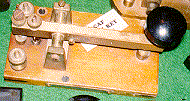
4240 RCAF AIRCRAFT SPARK KEY:(14KB)
All brass key with straight lever and doorknob style knob integrated
onto wooden base which is labeled RCAF Ref No 10A/556. 1/8 inch
diameter silver contacts. circa 1917.
4242 * Same as above. -> W2PM

4243 BRITISH AIRCRAFT SPARK KEY WITH BLINKER LIGHT:(27KB)
This interesting key is similar to the RCAF Aircraft Spark Key above
but the lower contact is mounted on a metal strap, there is a heavy
wire between the lever and the support piece and there is a socket
for a signal light.
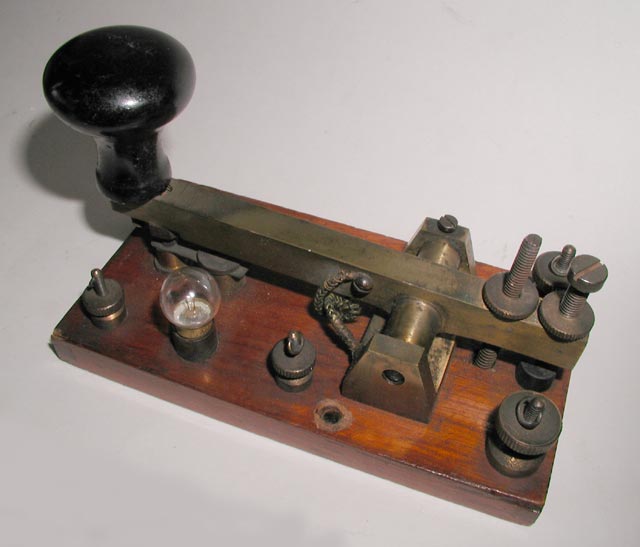
4243a Another right side view of the spark key:(33KB)
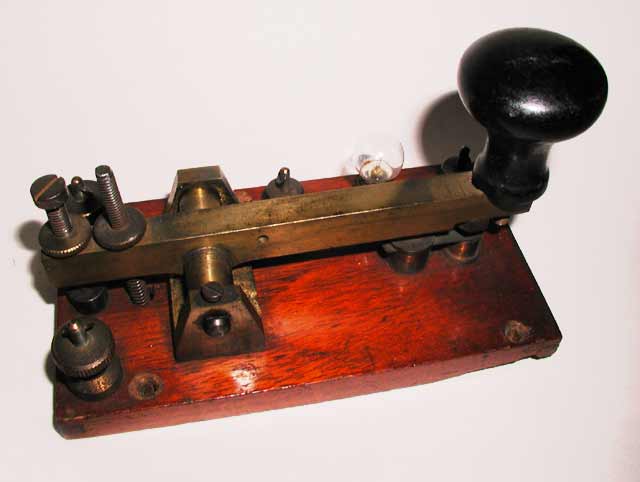
4243b A left side view of the spark key:(27KB)
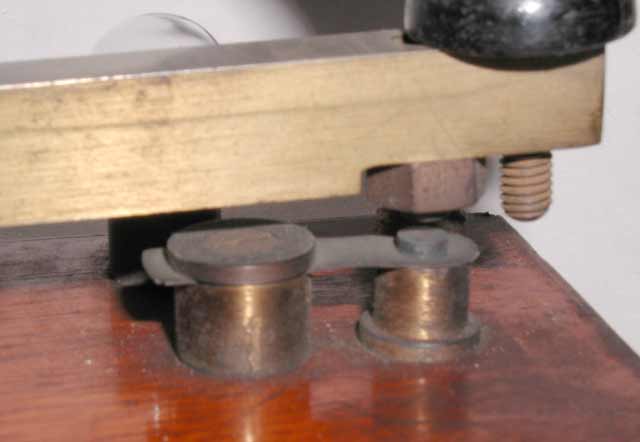
4243c A closeup view of the lower contact:(14KB)
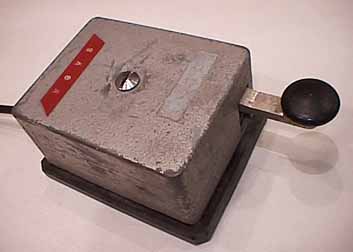
4250 UNUSUAL EDDYSTONE / MARCONI TYPE 365EZ WIRELESS KEY:(14KB)
Until this key appeared, I had thought that the only key that
carried the Eddystone name was their bug-shaped bug. This key
appears to be patterned after the well known Marconi Model
365 series keys. It is enclosed in a metal cover and has
a spark suppression inductance/capacitance network mounted
alongside the key mechanism. The lever is supported by
ball bearings as is the lever in the Marconi 365. It has been suggested
that the box is the ONLY part of the key which was manufactured
by Eddystone and that, since Marconi was and is located in Chelmsford,
they made the key under the M.I.M. name which stands for: Marconi
International Marine Communications Company Limited. Marconi
purchased Eddystone in 1965 and the 2743P inscribed inside the
box was probably the Eddystone box part number.
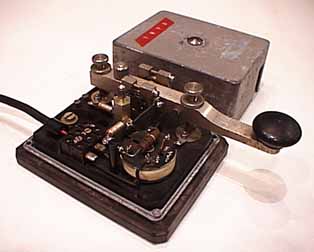
4250a A view of the key with cover removed:(15KB)
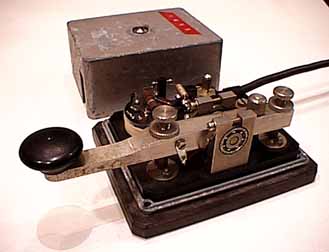
4250b Another view of the key with cover removed:(15KB)
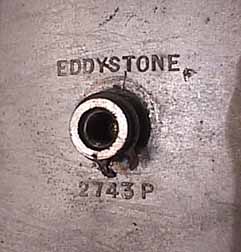
4250c A view of Eddystone name inside the cover:(16KB)
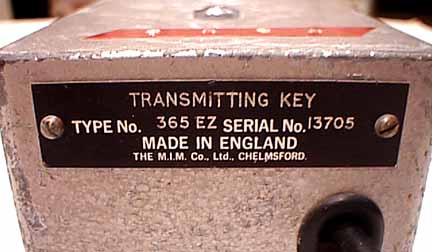
4250d A view of the label:(21KB)
which reads: TRANSMITTING KEY. Type No. 365EZ. Serial No. 13705.
Made in England. The M. I. M. Co., Ltd., Chelmsford.

4255 ** CLASSIC MARCONI 365 WIRELESS KEY:(26KB)
Collector Tim Heasman, G4LMH has given me permission to display
these pictures of his classic Marconi 365 key. This smooth sending
and hefty key was very popular and widely used on many ships.
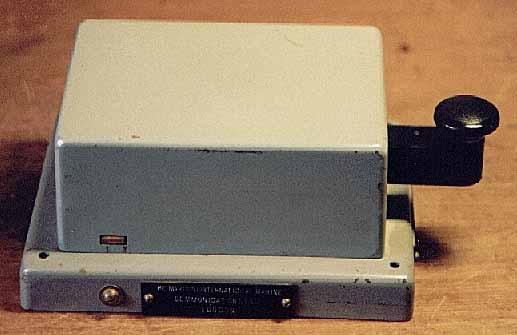
4255a ** A view of the Marconi 365 key with
the metal cover in place:(21KB)

4260 GERMAN WIRELESS KEY WITH TWO SPRINGS:(14KB)
This is a very unusual German telegraph key which has two tension
springs. The spring-mounted lower contacts identify it as being a
German key but the two two tension springs are absolutely unique.
It is unclear why a key would need a spring in front of the trunnion
and a spring in back of the trunnion.
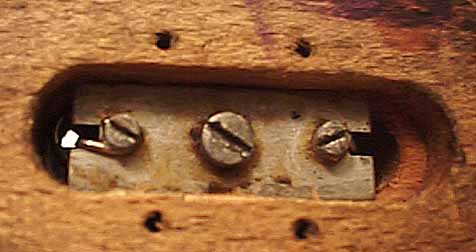
4260a A bottom view of the 2-spring key showing the
two spring mounting screws:(19KB)
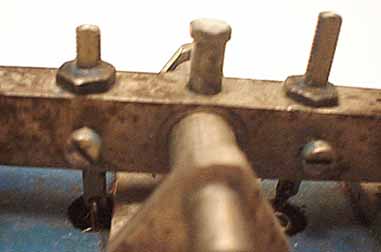
4260b A close-up view of the two tension
springs:(12KB)

4262 GERMAN WIRELESS KEY WITH TWO SPRINGS:(14KB)
This is a very unusual German telegraph key which has two tension
springs. The spring-mounted lower contacts identify it as being a
German key but the two two tension springs are absolutely unique.
It is unclear why a key would need a spring in front of the trunnion
and a spring in back of the trunnion. In this key the usual plastic
enclosure for the end of the lever has apparently been broken or lost and the
lever has been wrapped in tape instead. It is thought that the plastic
enclosure was meant to protect an operator from electric shocks.

4270 EARLY GERMAN LUFTWAFFE WIRELESS KEY: (17KB)
This key has a most unusual knob. It is thought that it may have
been notched in this way to make it easier for the wireless operator
to hold it as the aircraft bounced in turbulence. It is clearly
marked on both the top and bottom with the BAL Bau Amt Luftwaffe
symbol. It has the spring-mounted lower contacts which are characteristic
of most of the German keys. The right side of the keys is stamped:
CHARLOTTENBG, MOEGES.
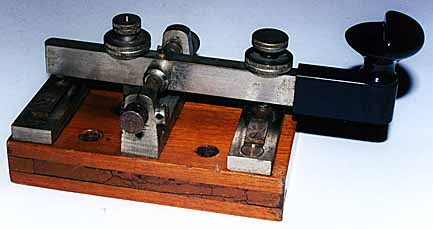
4270a Another view of the Luftwaffe key: (17KB)
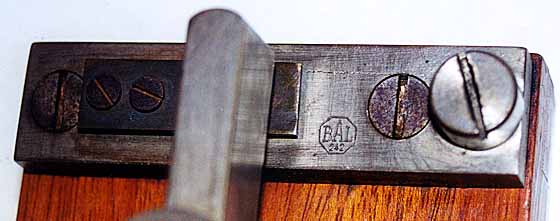
4270b A view showing the BAL marking on the top of the
key: (22KB)

4270b A view showing the BAL marking on the bottom
of the key: (19KB)
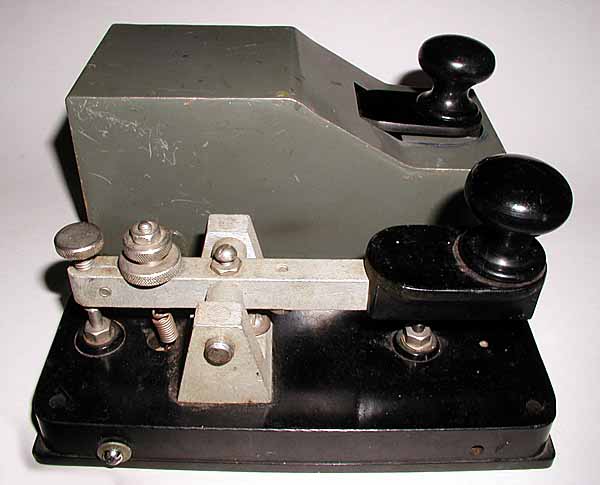
4290 RUSSIAN WIRELESS KEY: (32KB)
This is a heavy duty military key designed to key a
high-current transmitter. It is enclosed within a metal cover.
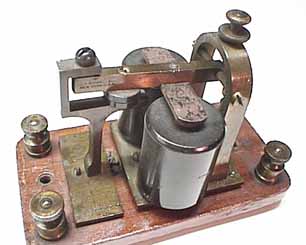
4480 BUNNELL SPARK RELAY:(17KB)
This very unusual item consists of a classic
Bunnell sounder with two 5/8 inch silver contacts attached to the
armiture and anvil. Very heavy wires run from these contacts to a set of
binding posts that match the sounder binding posts. This relay was used
to allow land-line keys and bugs with small contacts to switch the very
high currents of a spark transmitter.
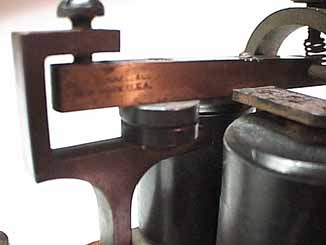
4480s Close-up of the contacts:(13KB)

4490 * LEACH SPARK RELAY:(21KB)
This spark relay was used to switch the high currents of a spark
transmitter when keying with a small key. It is stamped:
Leach Relay Co. CA. PR-9, 6 Volts, DC.
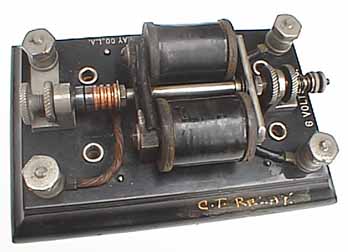
4491 Another view of the LEACH SPARK RELAY:(17KB)
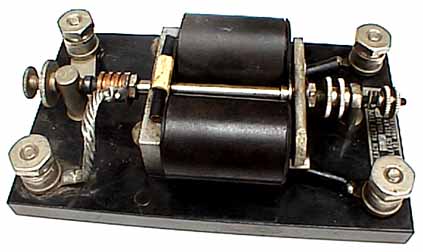
4492 * LEACH SPARK RELAY:(20KB)
This relay is slightly different from number 4490.
This spark relay was used to switch the high currents of a spark
transmitter when keying with a small key.
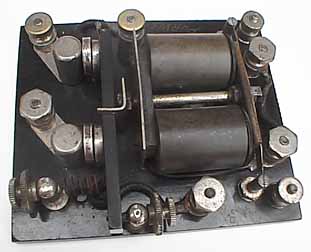
4494 DUAL SILVER CONTACT SPARK RELAY:(20KB)
This spark relay has two separate sets of silver contacts
for switching the high currents of a spark transmitter when
keying with a small key.
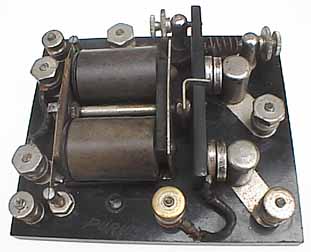
4494a Another view of the dual
contact spark relay:(17KB)
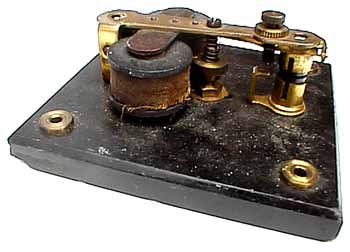
4496 SPARK RELAY:(18KB)
This spark relay was used for switching the
high currents of a spark transmitter when
keying with a small key.
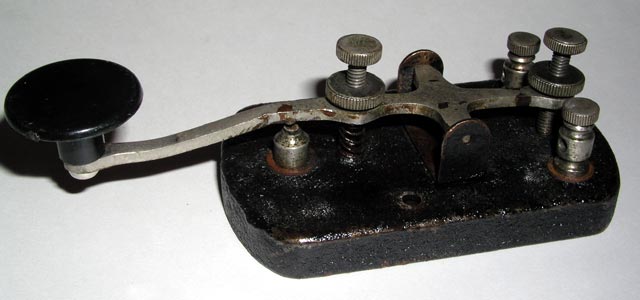
4540 * VERY SIMPLE SPEED-X RADIO KEY:
This key is extremely simple in design and construction.

4550 * SPEED-X RADIO KEY:(19KB)
This key is very similar
to the Signal Electric Co. Spark and wireless keys (See 4170.)
It is all chrome plated with "SPEED-X"stamped on lever top and
H-15.681 inside the base. Silver 3/16" contacts.
4551 Same as above but no engraving on lever or inside base.
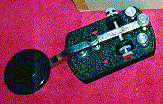
4552 * Same as above:(12KB)The
Base is black wrinkle finish cast metal.
4553 Same as above but inside of black base is marked "H15-621 WM. M. NYE
CO. INC. Bellevue, WA, MADE IN USA". All the rest of the key is brass.
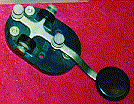
4554 * Similar to 4550:(10KB)
But oblong plastic base also stamped "SPEED-X".
4555 * TRIUMPH STYLE SPEED-X RADIO KEY: All plated copy of Bunnell
Triumph key with "SPEED-X" stamped on top of lever and & H15.682
under base. Lower contact mfgd on "U" to elevate it.
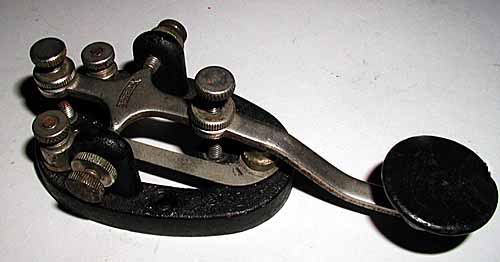
4555a * TRIUMPH STYLE SPEED-X RADIO KEY:(20KB)
This is a copy of the Bunnell Triumph Key. It is similar to the
above number 4555 key. The lever is stamped:
Speed-X and the base is painted with black wrinkle-finish paint.
4556 * SIGNAL ELECTRIC CO. STYLE KEY: All chromed key looks like the
standard Signal Electric design with solid oval chromed base & 1/4"silver
contacts, but the base has a black wrinkle finish in its recessed center
& bearing posts. Quite unusual.
4557 * SIGNAL ELECTRIC CO. STYLE KEY:
Similar to above but much less well made with smaller 3/32 inch
diameter contacts. Lever held in place by metal bracket with no lateral
adjustment. Similar to 1940s E.F.Johnson114-300 but.. black wrinkle
finish metal base.

4558 T.R.McELROY (FIRST MODEL) STREAM KEY:(16KB)
The first Stream Key had a chromed teardrop-shaped base with a label
which reads: Stream Key. Mfg. by T.r.McElroy. World's Champion
Telegrapher, Boston, USA.
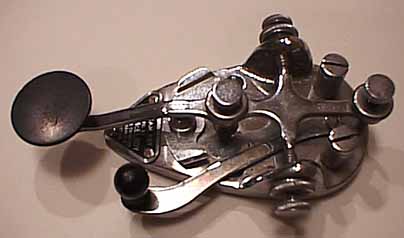
4558a Another view of this First Model Stream
Key:(16KB)
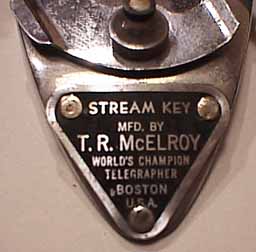
4558b A Close-up view of the label:(16KB)

4559 * T.R.McELROY (SECOND MODEL) STREAM KEY:(15KB)
The second models of the Stream Keys all had much more rounded teardrop
shaped bases with no labels. The levers were chrome plated and the bases
were black wrinkle-finish.
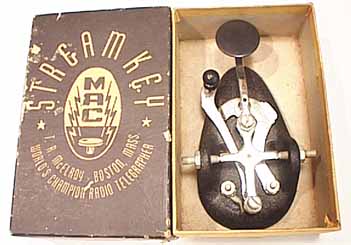
4559a * T.R.McELROY "AMATEUR" MODEL 100 STREAM KEY IN ORIGINAL BOX:(20KB)
This key had a chromed lever and black wrinkle-finished base.
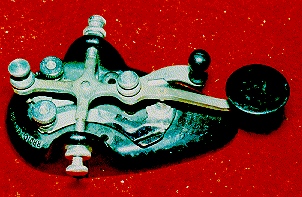
4560 * T.R.McELROY LATER PLASTIC "AMATEUR" MODEL 100 STREAM KEY:(21KB)
All plated key integrated onto a black plastic base which is
engraved: Stream key. Manufactured by T.R.McElroy. Boston, Mass. USA
(Traded to W2PM).
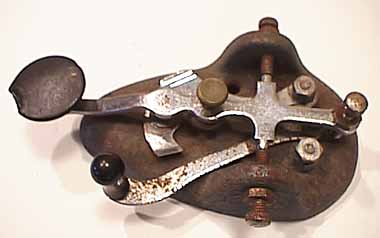
4562 * McELROY GREY BASED STREAM KEY:(16KB)
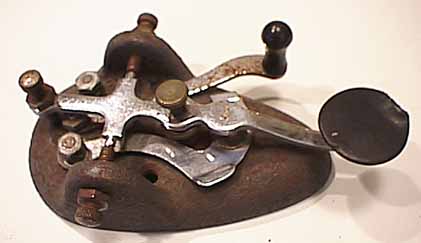
4562a Another view of the Grey Base Stream
Key:(16KB)

4565 * McELROY / TELEGRAPH APPARATUS CO. CODE PRACTICE
OSCILLATOR "INTERNAL" KEY:(14KB)This key is a McElroy Model 100
Metal-based Stream Key which has had its base cut off to allow it to fit
inside a Telegraph Apparatus Co. (A McElroy Company.) "Oscillatone"
code practice oscillator.
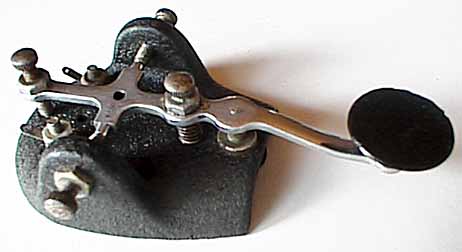
4565a Another view of the special cut-off
key:16KB)
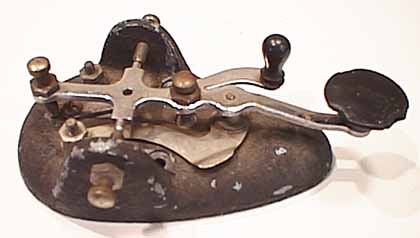
4567 * "FAKE" MCELROY KEYS:(16KB)
Someone made many thousands of copies of the popular McElroy
Stream Keys. These copies were made with very cheap "pot metal"
base castings and cracks often develop around the upright portions of
the base.
The only reliable way to tell a copy from the real keys is to see whether
the base is attracted by a magnet. The real McElroy keys are attracted
by a magnet.
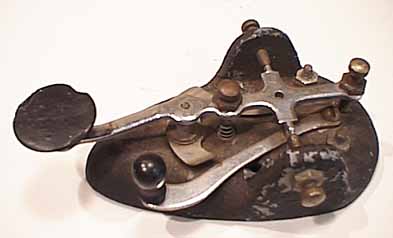
4567a Another view of the "FAKE" McElroy:(15KB)
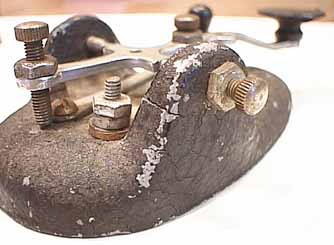
4567b Close-up view of the cracks in the base
casting:(18KB)
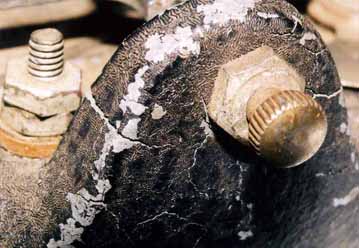
4567c Extreme Close-up view of the cracks in the base
casting:(25KB)

4568 * McELROY DELUXE MODEL 300 STREAM KEY:(17KB)
All Chrome-plated key with 5/16inch contacts. There were several
very minor variations in the bases.
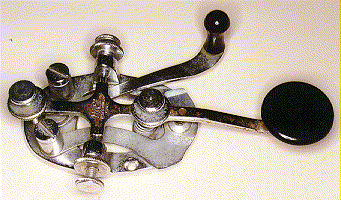
4570 McELROY COMMEMORATIVE ALL CHROME STRAIGHT KEY:(17KB)
Very unusual key is exactly like the Bunnell 1888 Triumph key with
oval base. It has typical McElroy design shorting lever and hardware
and the chromed lever is stamped "McELROY Electronics Corp". Special
memorial key made to commemorate McElroy. Only 100 of these
beautiful and hard to find keys were made.
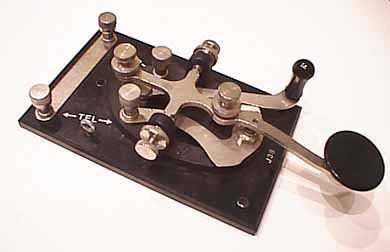
4574 RARE McELROY MILITARY J-38 STRAIGHT KEY:(16KB)
This is the key that McElroy Electronics Co. built for the
U.S. Military. The only known example was in the McElroy collection
until a small number of them showed up at the 1999 Dayton hamfest.
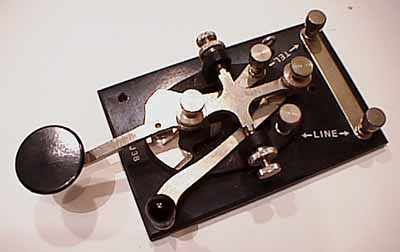
This is another view of the key:(16KB)
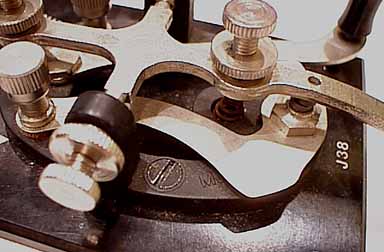
This is a close-up view of the M in the work
McElroy as it appears under the hot contact strip:(23KB)
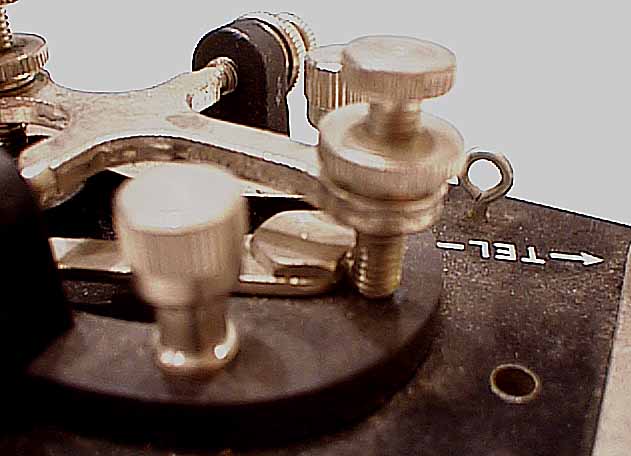
This is a close-up view of the narrow clearance
between the shorting lever screw and the gap adjusting screw:(35KB)
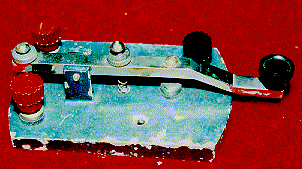
4576 * RADIO KEY:(21KB)
Very unusual design. Has cast aluminum base made of aluminum & painted
green. Lever is chrome plated. The knob and terminal tightening knobs
look like 1950s binding post knobs. It is an exceptionally UGLY key.

4582 TINY "SPY" RADIO KEYS:(15KB)
These tiny keys were thought to have been integrated into field
sets and clandestine portable radios. The keys have metal shorting
levers and knobs numbered from 1 to 4. Actually, they came from a
Western Electric Telegraph Line Test Set. (See 4582a below).
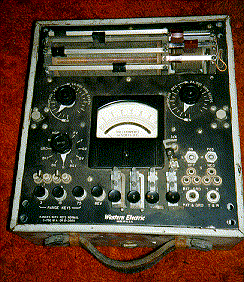
4582a * WESTERN ELECTRIC TEST SET &
TINY KEYS:(41KB)
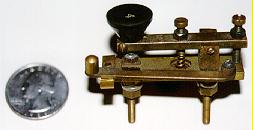
4582b Closeup of Western Electric Mini-Key:(8KB)
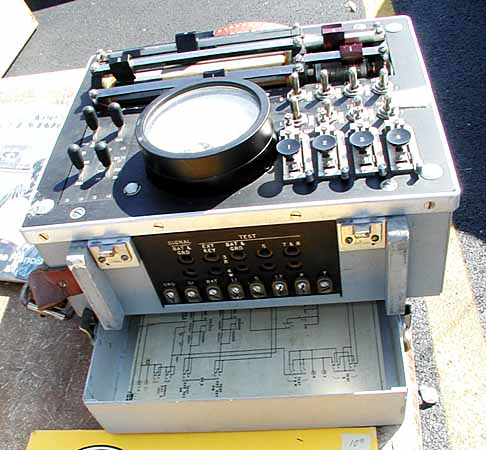
4582c * A LATER VERSION OF THE WESTERN ELECTRIC TEST SET
SHOWING ALL 4 OF THE TINY KEYS:(46KB)
4583 * Same as above.

4585 * TINY "SPY" RADIO KEY:(9KB)
Slightly larger than 4582, this tiny key was thought to be a spy key
but actually from a military field telephone and telegraph set.
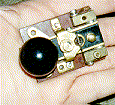
4586 * TINY "SPY" RADIO KEY:(8KB)
Tiny key thought to be a spy key but actually from a military field
telephone and telegraph set. (See 4586a).
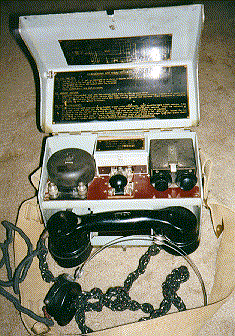
4586a * MILITARY FIELD SET AND KEY:(48KB)
Similar to above but slightly larger with no shorting lever.
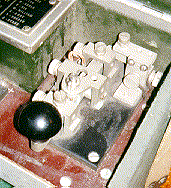
4588 * TINY COMPLEX "SPY" RADIO KEY:(22KB)
These unusual and fairly complex keys were thought to be spy keys but
actually came from military field telephone/telegraph sets. (See 4588a)
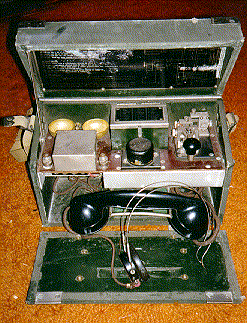
4588a * MILITARY FIELD SET AND KEY:(51KB)
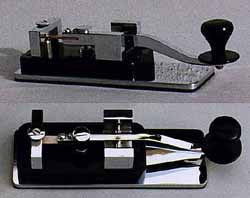
X4700 ** Norwegian Radio Key:(13KB)
This 1960's vintage key is owned by collector Einar Hogseth. email:
einar.hogseth@kj.uib.no.

4710 UPSIDE DOWN SPY RADIO KEY:(9KB)
This tiny key with 3-1/4" metal lever and brown 2-3/4" x 1-1/2"
bakelite base is constructed so that the mechanism is on the bottom
of the base and the knob extends upwards and out of the radio set.
It was manufactured in 1935 for the Italian Allocchio Bacchini set.
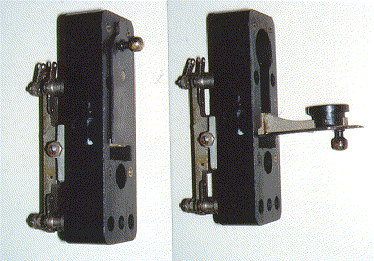
4720 TRAP-DOOR SPY RADIO KEY:(39KB)
This tiny key has a 3-3/4" x 1-1/4" base that is mounted vertically
on the side of the radio set. Pulling on a small knob allows a
trap-door to swing down and exposes a tiny knob and key lever that
operates normally open and normally closed contacts. It was
manufactured in 1935 for the Italian Radio-Marelli sets.
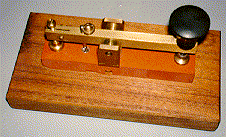
4730 BRITISH SPY RADIO KEY:(17KB)
Large British all brass key with straight lever, doorknob style knob,
and 1/8 inch contacts integrated onto reddish bakelite base which has
been removed from original radio transmitter and mounted on a wooden
base.
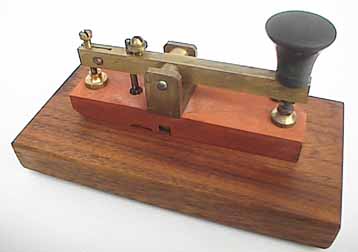
4730a Another view of the British Spy Radio
Key:(11KB)
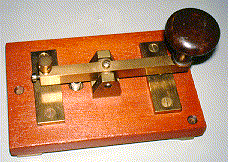
4740 PRACTICE RADIO KEY:(22KB)
British all brass key with straight lever, doorknob style knob,
and NO electrical contacts at all. Key is integrated onto a wooden
base and makes a clicking sound when it is depressed.
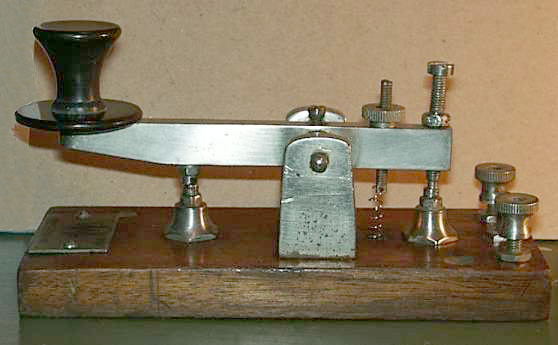
4850a * AWA TELEGRAPH KEY MADE BY
AMALGAMATED WIRELESS of AUSTRALASIA:
This wireless / radiotelegraph key is labeled ''AWA TYPE R655A MANIPULATING
KEY''. It was made by Amalgamated Wireless of Australasia in the 1930s.
I donated this key to the AWA (Antique Wireless Association:
http://www.antiquewireless.org ) Museum where it may be seen.
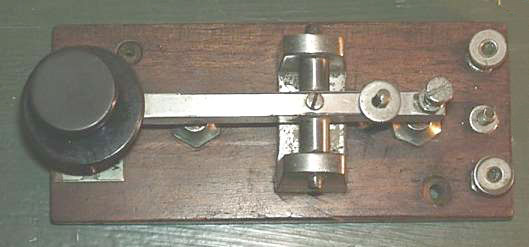
4850b * Another view of the AWA Telegraph Key:
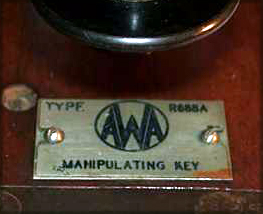
4850c * The Label on the AWA Telegraph Key:
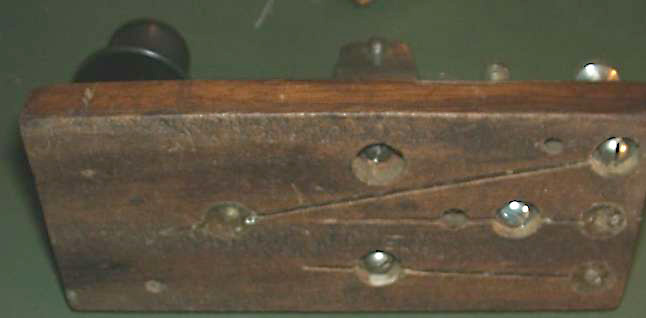
4850d * The underside of the base of the AWA Telegraph
Key:
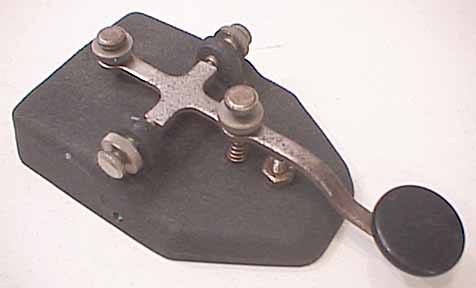
4900 DOW PRACTICE RADIO KEY:(22KB)
This key was manufactured by the Dow Key company in Canada
and used for practice and as a radio key.

4901 ANOTHER DOW PRACTICE RADIO KEY
(In better condition):(32KB)
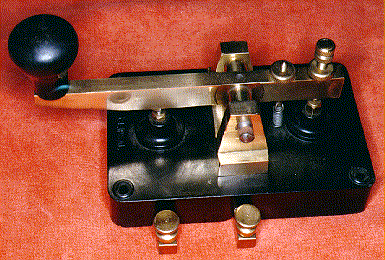
5000 * AUSTRALIAN CLIPSAL KEY:(55KB)
This key was manufactured during and after WW-II by Gerard Industries.
Collector John Kaesehagen of Adelaide, Australia was kind enough to
send me this
description of the company and
some of its activities:(125KB) It is a LARGE file but interesting
to read. John says that the name "Clipsal" was derived from:
"Clips-all" which was a term used to describe the range of
adjustable fittings for conduits that were manufactured by the company.
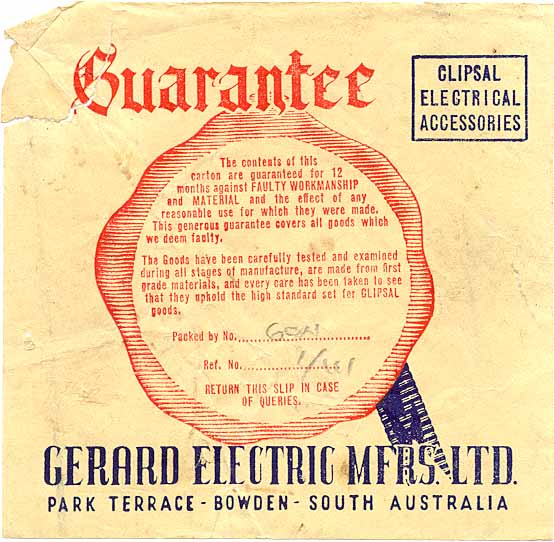
5000b The original Guarantee that accompanied the clipsal
key:(65KB)

5001 * AUSTRALIAN CLIPSAL KEY WITH ORIGINAL BOX:(13KB)
This key is the same as number 5000 above but has the original box.
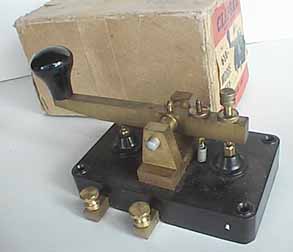
5001a Another view of the Clipsal key and
box:(11KB)

5010 * BRITISH "KENT" KIT KEY:(14KB) This key
is sold in kit form and was mounted on a plastic base by its owner.

5020 * CURRENT JRC (JAPANESE RADIO CORP.) RADIO
KEY:(15KB)This currently produced radio key is very similar to the
earliest Japanese spark and wireless keys. (Same as number 9689.)
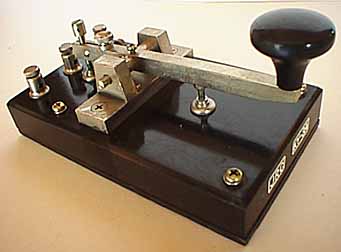
5020a Another view of the JRC radio Key:(15KB)

5045 SWEDISH RADIO KEY:
This is a fairly large Swedish Radio Key with the classic long Swedish-style
lever.

5050 * CURRENT SWEDISH RADIO KEY:(16KB)
This currently produced Swedish radio key was patterned after
the very early Swedish land-line telegraph keys with their long
levers. It has no trunnion bearings but instead supports the
lever on a flexible leaf spring. It is supplied in its own
wooden box. (This key is the same as number 1125.)

5060 * EARLY DANISH - GREAT NORTHERN TELEGRAPH WORKS KEY:
This Danish key carries a label that reads: Great Northern Telegraph Works,
Copenhagen, Denmark. No. 77773. It is not likely that 77773 of these keys
were made since they do not show up very often. I think it is more likely
that the manufacturer started with a high serial number. The picture
was sent to me by another collector.

5060a * The Label on the Early Danish key:

5070 * LATER DANISH - GREAT NORTHERN TELEGRAPH WORKS KEY:
This appears to be a later version of the Danish key above.
This Danish key carries a label that reads: Great Northern Telegraph Works,
Copenhagen, Denmark. No. 13779. Since it is not likely that 13779 of these
keys were made it is more likely that the manufacturer started with a high
serial number. The picture was sent to me by another collector.

5070a * The Label on the Danish key:

5070b * The Underside of the Danish key:

5070c * The Removable Base of the Danish key showing
the modular connectors:

5110 GERMAN "LEYBOLD" KEY:(19KB) This simple
key was made in Germany. The company still exists in 2005 but manufactures
mainly apparatus for the chemical industry.

5200 * HAM-KEY RADIO KEY WITH BLACK BASE:(20KB)
This is a common key with nice feel. It is in current production.

5201 * HAM-KEY RADIO KEY WITH GRAY BASE:(20KB)
This is a common key with nice feel. It is in current production.

5460 * EXTREMELY COMMON JAPANESE COPY OF BUNNELL TRIUMPH
KEY:(17KB)This key has been in production for at least 20 years and
hundreds of thousands of them have been sold. It is a convincing copy of the
Bunnell Triumph Key but can be identified by the ball-bearings at the end of
the trunnion shaft, the hollow brass-look base and the word Japan on the
underside of the base casting. The contacts are steel and constantly become
dirty making for very poor keying performance.
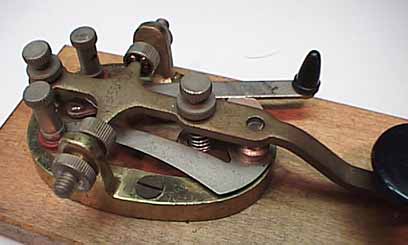
5460a Another view of the Japanese Copy:(18KB)
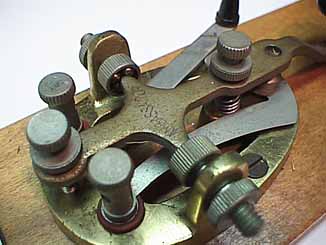
5460b A closer view of the ball-bearings:(20KB)
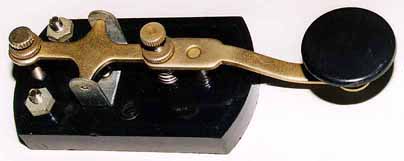
5480 * EXTREMELY COMMON JAPANESE COPY OF SIGNAL ELECTRIC
KEY:(12KB)This key has been in production for at least 20 years and
hundreds of thousands of them have been sold. It is a plastic based copy of
the metal-based Signal Electric Radio Keys. The trunnion shaft is held in
place by the springiness of the trunnion shaft supports. The contacts are
steel and constantly become dirty making for VERY poor keying performance.
Internet ENIGMA Museum:
https://EnigmaMuseum.com
COPYRIGHT NOTICE: (Copyright (c) 2023: Prof. Tom Perera Ph. D.)
Although all the pictures and text are copyrighted, you may use any of them
for your own personal applications including public lectures and
demonstrations, publications and websites as long as you mention the
w1tp.com Museum. If you plan to offer them for sale to the public
in any form, please email me for permission which I will generally grant as
long as you mention my museum: http://w1tp.com or https://EnigmaMuseum.com My email address is
given at the bottom of this page. Some of the material may require contacting
other copyright owners for commercial use and I will inform you by email.
Please also see the Disclaimer of Warranty.
(The instruments are in approximate chronological order: Oldest first.)
* = (Items no longer owned.) ** = (Items in other collections.)
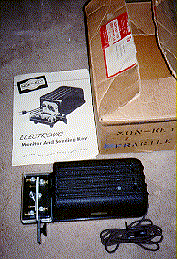
5510 MON-KEY ELECTRONIC KEYER: (28KB)
The first Electronic Key. Mfg by Electric Eye Equipment Co. Danville,
Ill. New-in-the-original-box with manual and unusual detailed papers
describing all company business matters, sales, inventory, plans..
Complete set - as sent to a prospective buyer of the company!!
(This model was my first electronic key and the raw 110VAC from
the resistive line cord appeared on the key mechanism and gave
VERY nasty shocks if you got careless in the middle of a QSO.)
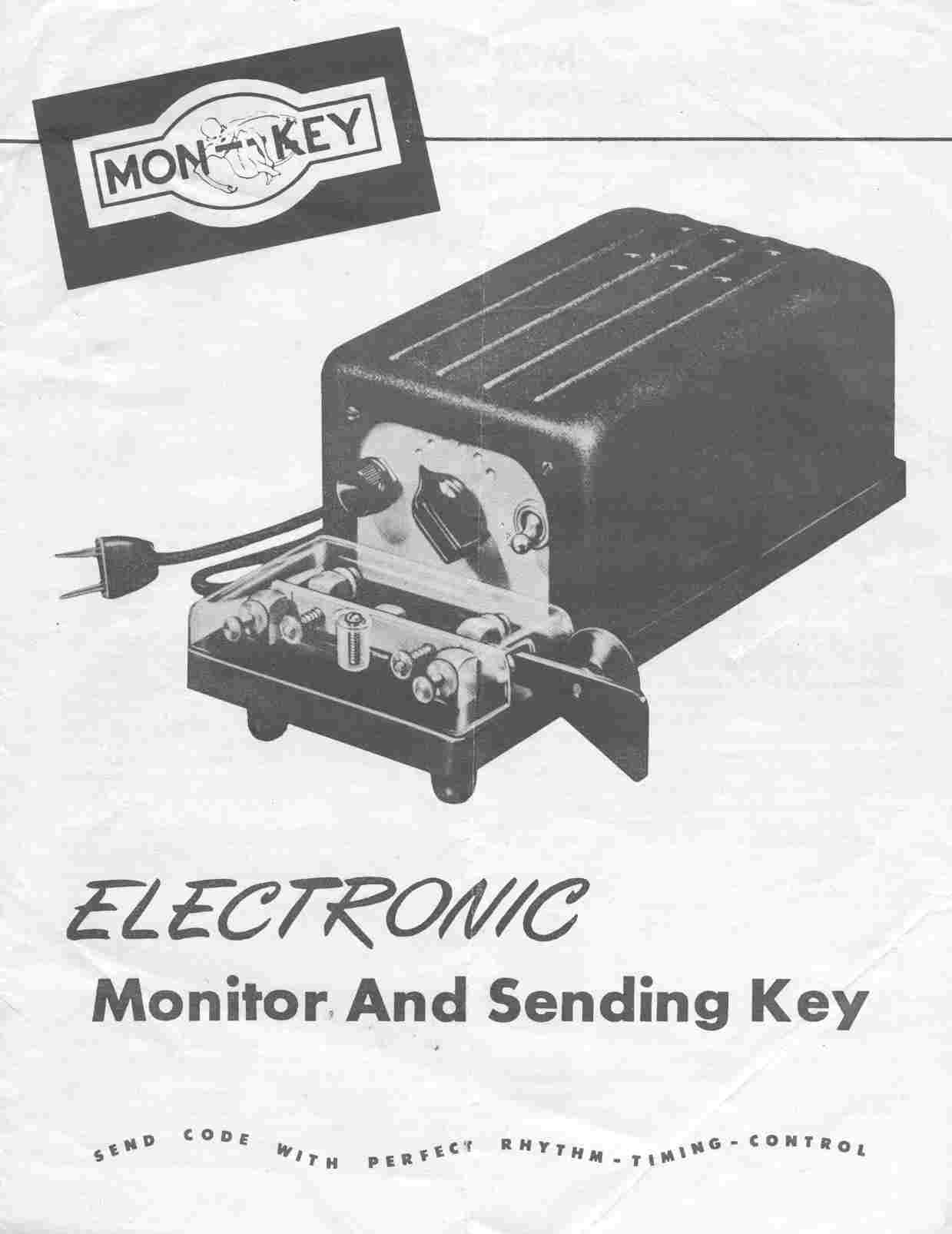
5510a Page 1 of the MON-KEY instruction manual:
(50KB)
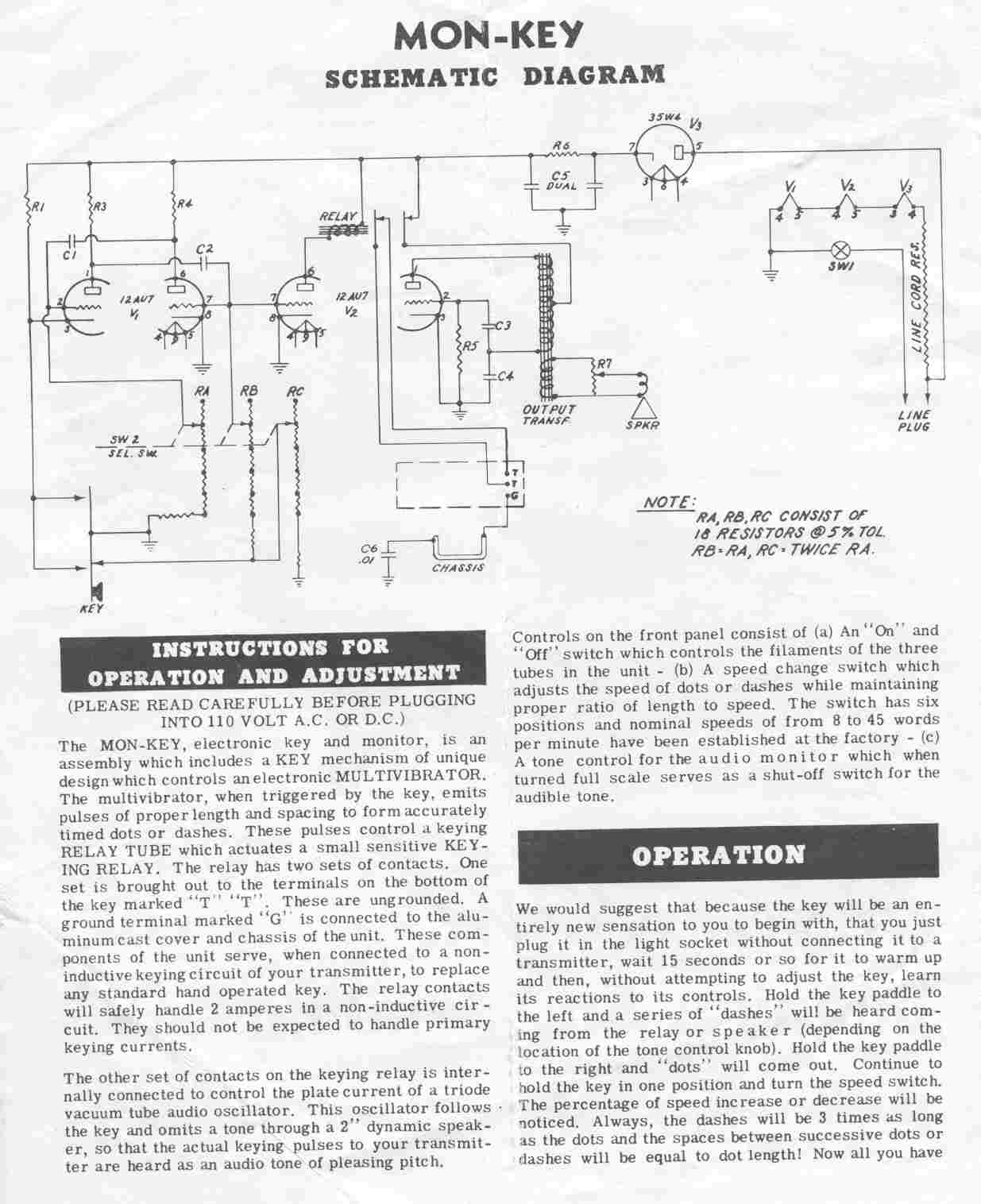
5510b Page 2 of the MON-KEY instruction manual
showing schematic diagram):(96KB)
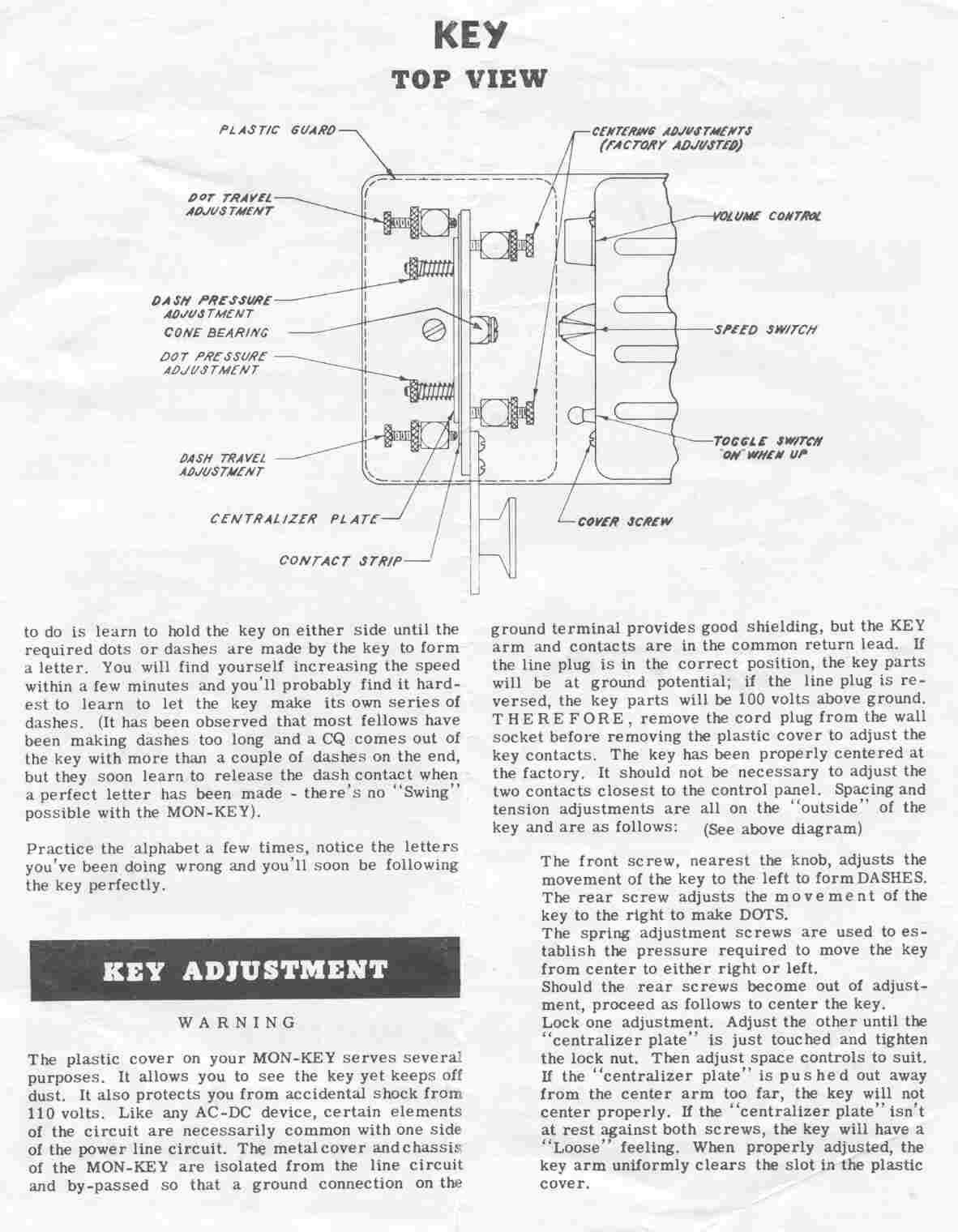
5510c Page 3 of the MON-KEY instruction manual:
(89KB)
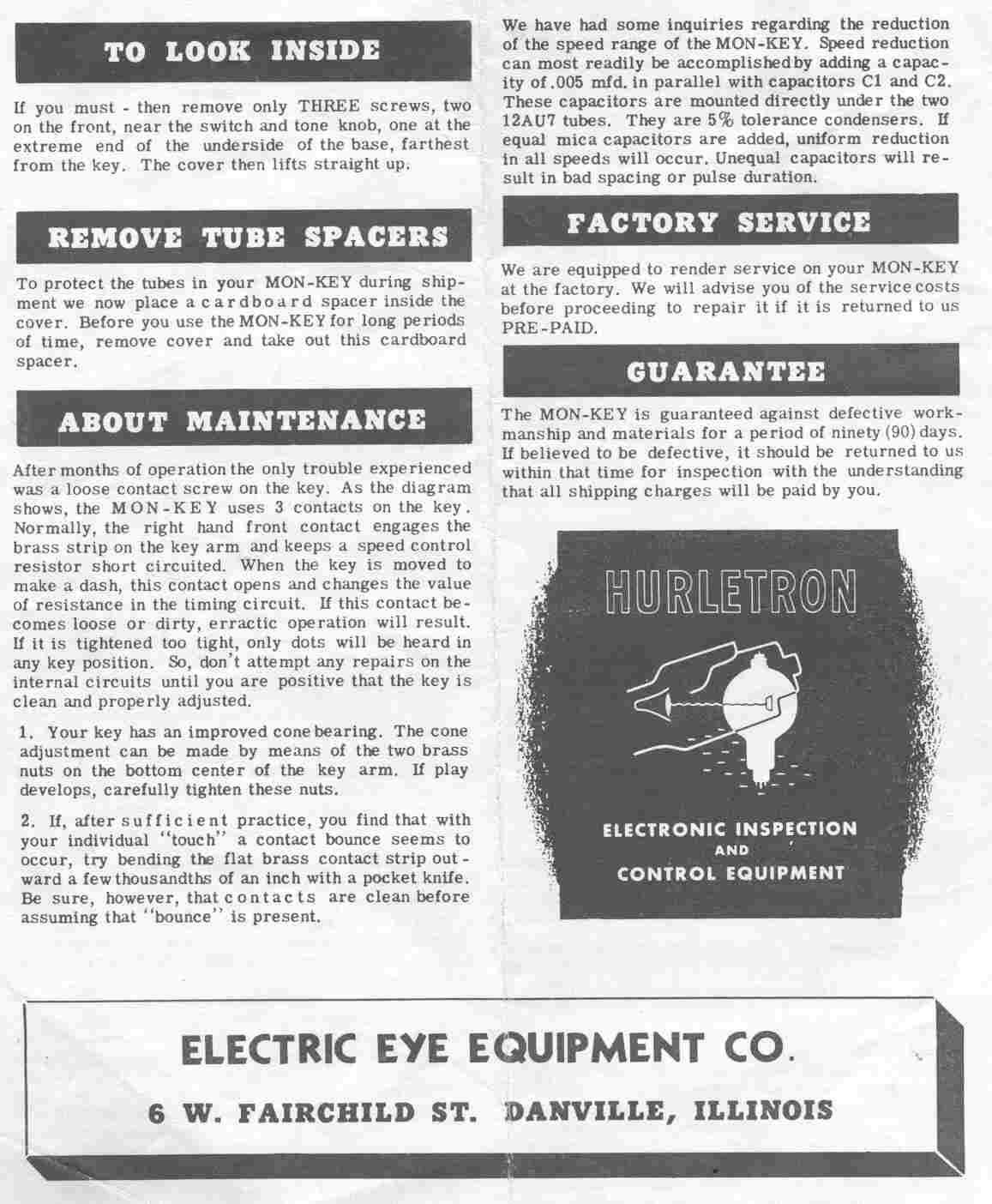
5510d Page 4 of the MON-KEY instruction manual:
(91KB)
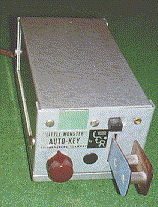
5520 LITTLE MONSTER AUTO-KEY (MADE IN VERMONT):(17KB)
This small electronic key with very unique 4-ball bearning pivot
mechanism was manufactured by Alex Trembley (W1GQJ) who was an
engineer for the power company in St. Johnsbury, Vermont. The
label reads: "Little Monster Auto-Key, St. Johnsbury, Vermont. Pats
Pending by LCR." There is an internal inscription: K1CUX 4-24-66 fm
W1GQJ -73-
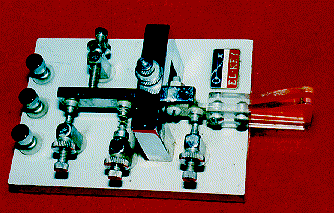
5550 * GREY-BASED EL-KEY PADDLE:(26KB)
This is an all chrome plated mechanism mounted on a grey painted
base. The label reads: POUCEL ELECTRONICS, EL-KEY. It was
manufactured by W2AYJ, Robert E. Poucel of Babylon, Long Island, NY.
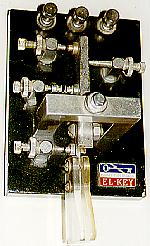
5551 * BLACK-BASED EL-KEY PADDLE:(14KB)
Same as 5550 but with black base.
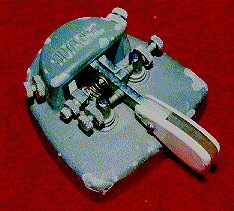
5564 EARLY AUTRONIC PADDLE:(19KB)
This paddle has an all chrome mechanism integrated with a cast base
which is painted in grey wrinkle finish. The finish has numerous
chips. The word "AUTRONIC" is cast in raised letters on the top
and "ELECTROPHYSICS CORPORATION", Newport Beach, Calif is cast into the
underside of the base.
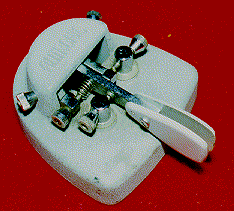
5566 * MORE MODERN AUTRONIC PADDLE:(17KB)
Same as #5564 except lighter grey & more modern hardware.
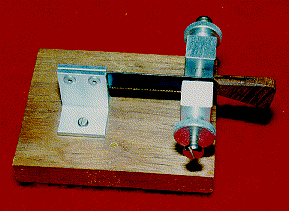
5570 KUNGSBACKA - FIRMA KUNGSIMPORT PADDLE:(20KB)
Aluminum mechanism on wood base with hacksaw blade armiture & wooden knob.
3 Suction cups on bottom of base. Label reads: FIRMA KUNGSIMPORT, Box 257,
434 00, KUNGSBACKA, Postgiro 9 10 99 Sweden. About 200 of these keys were
made in the late 1970s by Hank Svard a Swedish Radio Operator at the SAG
Goteburg Sweden shore station and his friend, Bengt-Arne Jockert / SM6CKU.
About 50 of them were sold to Americans. He writes that his key business did
not thrive so he had to keep on working at SAG. He said "it was a thrill at
the beginning of every watch to caress the wooden handle. The ability to
switch between sending very very slowly or very very fast made you feel
totally in command. You created your own style and therefore you were greeted
by name by the other ships calling in". The suction cups were notorious for
losing their suction causing the key to suddenly and surprisingly drift
across the operating table.
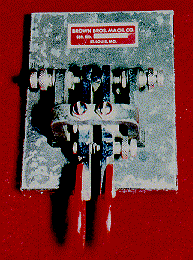
5580 * BROWN BROTHERS "UTL" PADDLE:(21KB)
Chrome iambic mechanism on beat-up grey base. The UTL or:
Unbiased Two-lever mechanism has a crisp light 'feel' and
is considered very desirable by collectors.
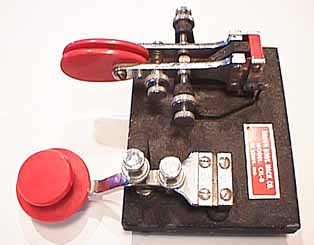
5585,5585A * BROWN BROTHERS "CTL"
PADDLE & STRAIGHT KEY:(17KB)
This straight key & paddle is mounted on a grey base.
The CTL Two-Lever' mechanism is considered to
be a bit less crisp than the UTL mechanism because of the
flat springs which are used instead of bearings. The key
is also supported by a flat spring and has no bearings.
Compare this mechanism with number 5590 below.
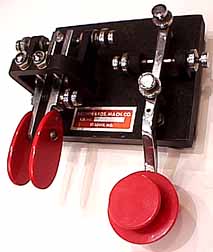
5590 * BROWN BROTHERS "UTL" PADDLE &
STRAIGHT KEY:(15KB)
This straight key & paddle is mounted on a grey base. The UTL or:
Unbiased Two-lever mechanism has a crisp light 'feel' and
is considered very desirable by collectors. Its mechanism
is supported by adjustable bearings. The telegraph key also
has adjustable bearings supporting its lever.
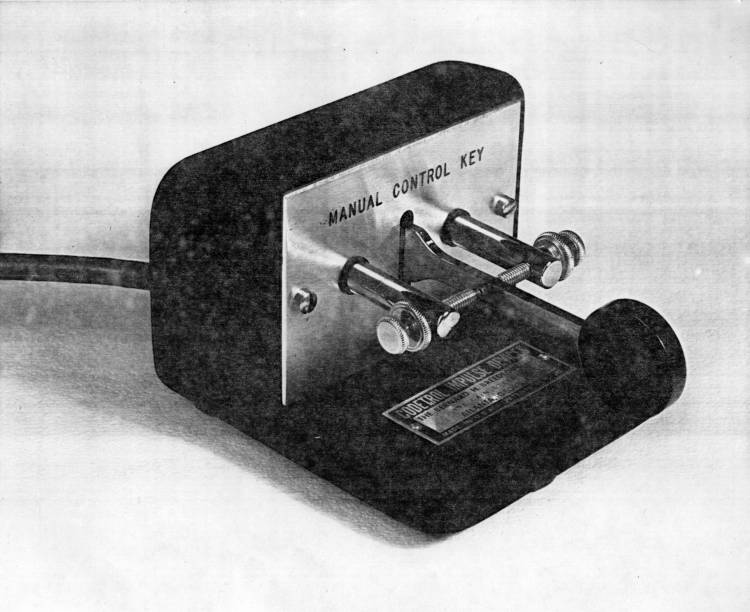
5600 * RARE CODETROL PADDLE:
This rare paddle was made by Breedlove who also made the exceptionally rare
right-angled Codetrol bug. The photograph was sent to me by another
collector.
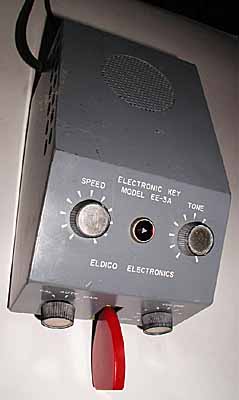
5640 * ELDICO EE-3A EARLY ELECTRONIC KEY (14KB)
This is one of the very early electronic telegraph keys capable
of making both self-completing dots and dashes automatically.
This key was sold as a kit as well as factory wired. This one carries
serial number 0414.
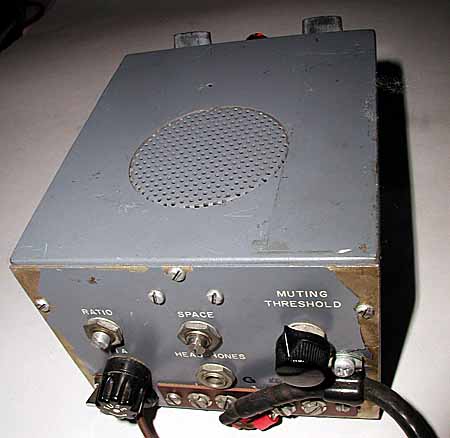
5640a * A Rear View of the ELDICO EE-3A (26KB)
5645 * DUOMATIC AUTO-KEY. Early electronic key manufactured by
Electronic Signal Devices.(Traded to Tom French, W1IMQ.)
5680 * HEATHKIT ELECTRONIC KEYER/PADDLE: Heath Model HO-10 fully automatic
keyer.
5682 * Same as above.
5690 * TenTec KR40 Iambic memory keyer.

5700 ** PADDLE MADE FROM A McELROY BUG:
The maker of this paddle cut off a McElroy bug to convert it into a
paddle:
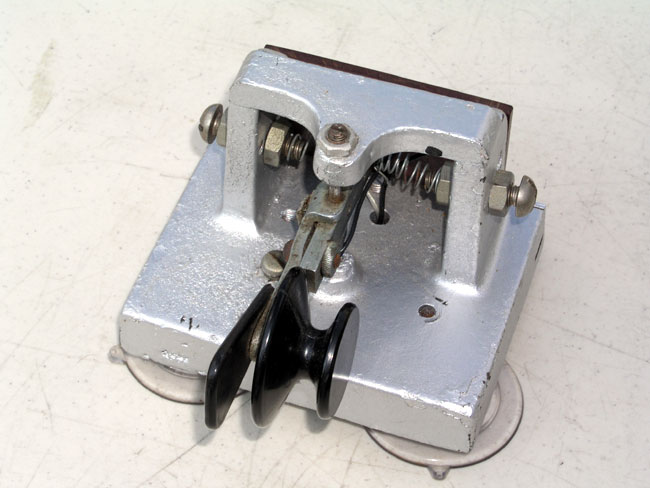
5700a ** Another view of the Paddle made from a McElroy
Bug:
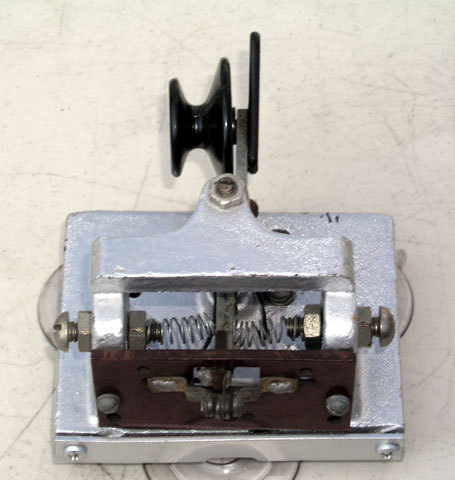
5700b ** Another view of the Paddle made from a McElroy
Bug:
5800 * VIBROPLEX BRASS RACER - Iambic Keyer s/n 02216
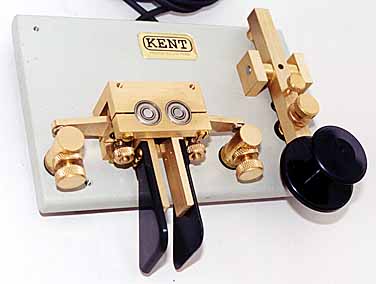
5880 SPECIAL MANUFACTURE KENT COMBINATION IAMBIC
PADDLE AND STRAIGHT KEY: The Kent Company in Great Britain was
commissioned to make a small lot of these interesting keys.
I was able to photograph this example at the Dayton 2000 hamfest where
they were on sale.
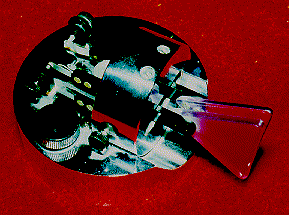
5910 * NOVOSIBIRISK MODEL ARE80 RUSSIAN PADDLE:(18KB)
Impressive heavy chrome plated 4" round base with built-in keyer.
Triangular pruple paddles. KLOJ-8-N painted on bottom. (Traded to
K9WDY.)
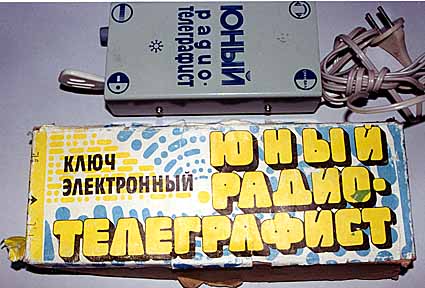
5912 * RUSSIAN ELECTRONIC KEYER / PADDLE:(37KB)
This interesting Russian Keyer was found at the 2000 Dayton Hamfest.
It came with the original box and a very complete set of instructions
with full schematics. Here are some more views of the paddle. Darrell,
ZL/W6HPM tells me that the design, based on a hacksaw blade, may have been
suggested by the use of a hacksaw blade by Russian marine operators to make a
sideswiper, the Russian name for which was 'pila' (pee-LA) or saw.
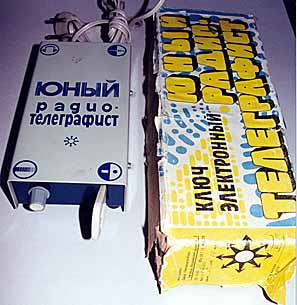
5912a Another view of the paddle and box:(30KB)
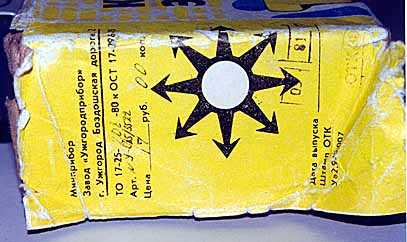
5912b An end view of the box:(29KB)
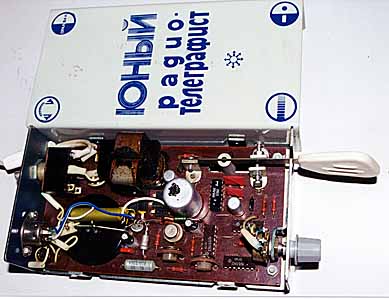
5912c A view with the cover removed:(30KB)
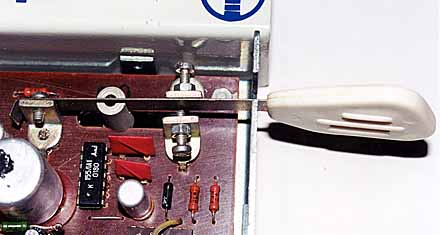
5912d A close-up view of the paddle which looks
as though it was made out of a hacksaw blade:(29KB)
Traded to
K9WDY.

5920 GERMAN HANNES BAUER PADDLE:(20KB)
This unusual paddle has three rings of ball bearings separating the
three moving parts. It was found in Germany at the Friedrichshafen
hamfest and it was manufactured in the mid 1960's by Hannes
Bauer of Bamberg, Germany. This paddle has two brothers. One is
much smaller with a solid plastic base. It is designed
to be attached to the operating
table by screws or directly to the keyed transmitter. The other
is a bug of the same color which was sold under the name 'Edelmann'.
Apparently only a small number of these bugs were manufactured
and they were succeeded by this paddle.
(NOTE: Please also see the magnificent Hannes Bauer BUG which is
number 7860 in the Bugs section of the museum.)

5925 ** GERMAN HANNES BAUER PADDLE:(13KB)
This is another variation of the paddle shown above. It is
owned by collector Cortland Richmond, KA5S, who bought it in
Weisbaden Germany in the 1970's. See also the Hannes Bauer Paddle
and Bug mentioned above.
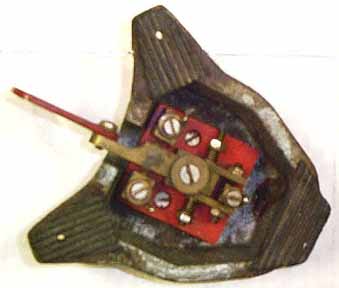
5925a Bottom view of the German Hannes Bauer Paddle:
(14KB)
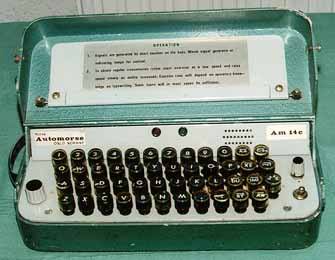
5955 ** NORWEGIAN NORSK AUTOMORSE MODEL AM-14C
KEYBOARD KEYER:(22KB) This small keyboard style keyer was
designed by Leif Patrick Evensen, who had a company in
Gothenburg/Sweden, at least from 1956 to 1974, named Telespeed,
later Aksieselskapet Automorse. He made three versions, the last
one (on the photo) around 1969.The first one operated with 14
mechanical relays, the second one was more stable, based on a
diode matrix with only two relays and the last one was completely
transistorized. After the first, the US Militairy authorities
claimed promptly: Too many moving parts. The unit was than
withdrawn from the market. 45 of them were released by the Norwegian
Militairy Forces and sold for nothing which urged Evensen to publish a
warning so the units would not be taken to sea. The second one was not
waterproof and the Norwegian authorities really never accepted the
Automorse. Because of Norwegian reluctance the third version also
never entered the market to any extent. It measures 9 X 21 X 33 cm.
It is in the collection of Anton Klok - PA3AQV in Holland who was
kind enough to supply this information about it.
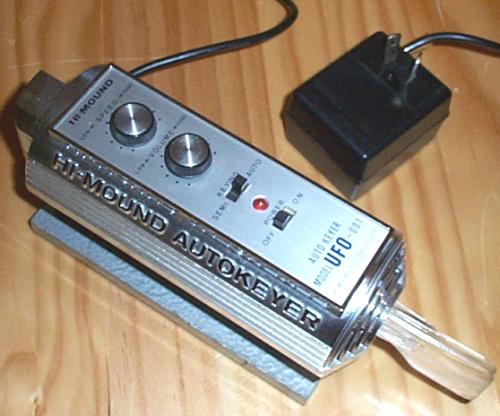
5980 * HI-MOUND "AUTOKEYER" ELECTRONIC KEYER:
This is a very interesting looking keyer made by Hi-Mound.

5987 THE J. M. MARCH PADDLES:
These paddles were made by J. M. March in the 2000s.
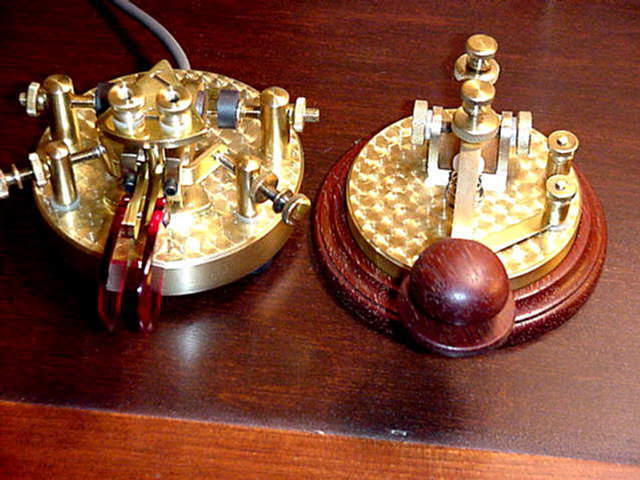
5987a Another J. M. March Paddle:
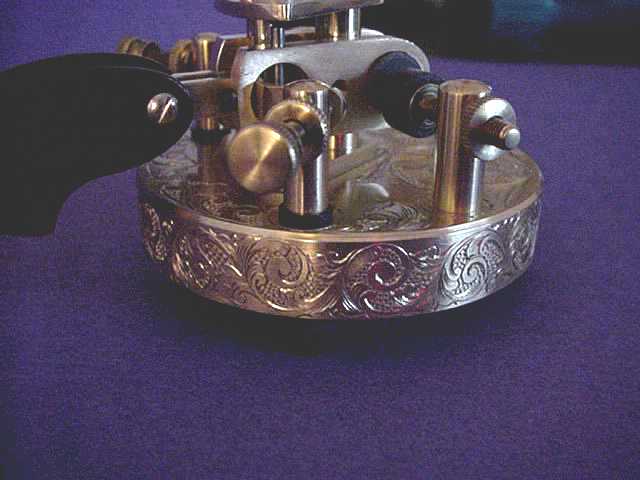
5987b Another J. M. March Paddle:
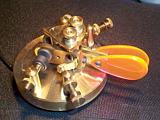
5987c Another J. M. March Paddle:

5990 THE FAMOUS QST J-38 PADDLE:(15KB)
Many hundreds of these iambic paddles were made by hams after
an article in the July, 1952 issue of
QST described the basic design. The paddle is made
by simply screwing together two J-38 straight keys and mounting
the resulting mechanism vertically. This ugly paddle has
a surprisingly good, crisp, light, ''feel'' and compares
very favorably to a well adjusted Bencher paddle.

Another view of the J-38 Paddle:(15KB)
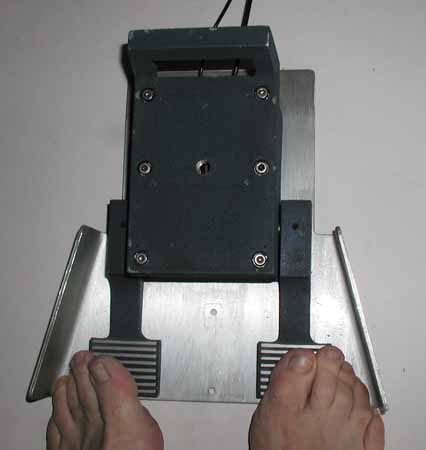
5995 THE FOOT PADDLE:(15KB)
This is a very well made paddle designed for the digitally-challenged
operator who must make both dots and dashes with other limbs. The
dot contacts are on the right side and the dash contacts are on the
left side. As you can see below, the instructions suggest different
methods of manipulating the paddle depending on the operator's preferences.
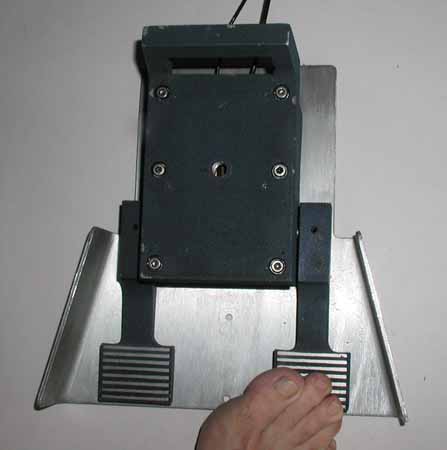
5995a The Foot Paddle Making Dots:(15KB)
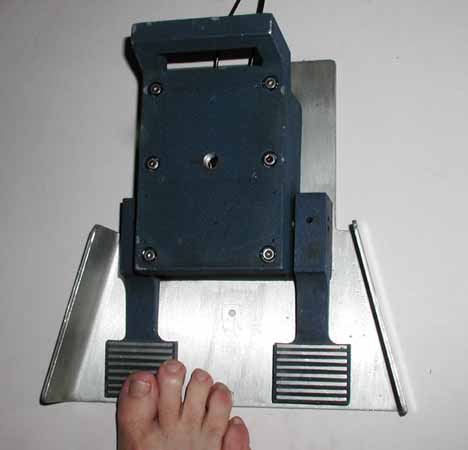
5995b The Foot Paddle Making Dashes:(15KB)
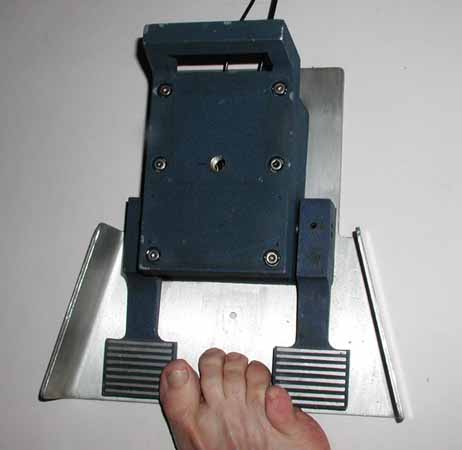
5995c The Foot Paddle in High Speed Operation:(15KB)
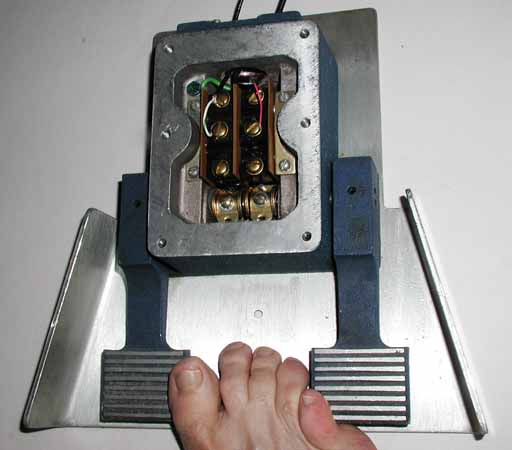
5995d The Mechanism of the Foot Paddle exposed:(15KB)
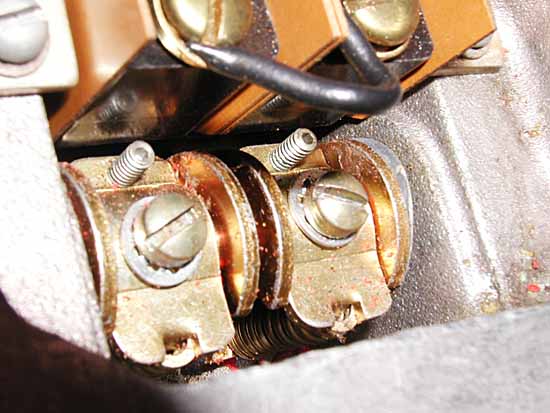
5995e A closeup of the precision mechanism showing
the hex-head capscrew fine adjustments:(15KB)
Internet ENIGMA Museum:
https://EnigmaMuseum.com
COPYRIGHT NOTICE: (Copyright (c) 2023: Prof. Tom Perera Ph. D.)
Although all the pictures and text are copyrighted, you may use any of them
for your own personal applications including public lectures and
demonstrations, publications and websites as long as you mention the
w1tp.com Museum. If you plan to offer them for sale to the public
in any form, please email me for permission which I will generally grant as
long as you mention my museum: http://w1tp.com or https://EnigmaMuseum.com My email address is
given at the bottom of this page. Some of the material may require contacting
other copyright owners for commercial use and I will inform you by email.
Please also see the Disclaimer of Warranty.
(The instruments are in approximate chronological order: Oldest first.)
* = (Items no longer owned.) ** = (Items in other collections.)
VIBROPLEX KEYS (6001 - 7000), OTHER BUGS (7000 - 8000)
NOTE ON THE DATING OF VIBROPLEX BUGS:
John Elwood, WW7P has been gathering information about Vibroplex keys
for many years. He has been able to reconstruct many of the dates of
manufacture of the various models of Vibroplex keys which had been lost
in the Vibroplex fire. His complete list of dates is published in the
Vibroplex Collector's Guide by Tom French W1IMQ which is listed in the
bibliography section of this website. You may also find John Elwood's
complete list by going to the website of Randy Cole KN6W at:
http://www.la.ca.us/frandy/dating.html
The following information briefly summarizes these published findings.
To use this summary, first find the serial number on your Vibroplex.
It will be stamped into the label on later models and into the damper
or other parts on early models. Then use this table to find the
approximate date of manufacture:
Serial # Date Serial # Date Serial # Date 001,000 - 1905 150,000 - 1946 040,000 - 1980 (Portland ME) 010,000 - 1911 200,000 - 1957 060,000 - 1988 050,000 - 1914 250,000 - 1967 080,000 - 1995 (Mobile, AL) 100.000 - 1920 300,000 - 1974
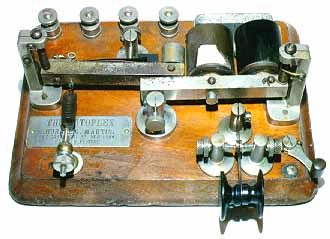

6007 ** MARTIN AUTOPLEX: (19KB)
This is another version of the first Martin Semi-automatic key.
It used a DC voltage to activate the mechanism which made automatic dots.
(This key is in the Gil Schlehman - K9WDY collection.)
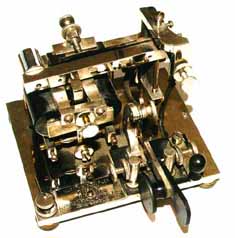
6010 * MARTIN AUTOPLEX: (19KB)
This is the second Martin Semi-automatic key. It used a DC voltage
to activate the mechanism which made automatic dots. --> WA5Y
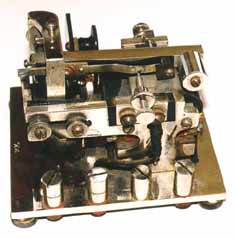
6010a A photo of the back of the Autoplex:
(17KB)
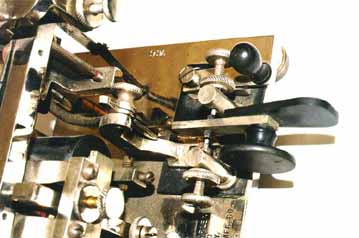
6010b A Close-up of the lever mechanism: (21KB)
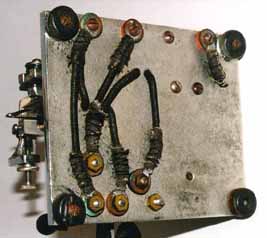
6010c A view of the underside wiring of the Autoplex:
(17KB)

6012 ** MARTIN AUTOPLEX: (17KB)
This lovely Martin Autoplex carries serial number 630.
The photograph of it is used with the permission of it's
owner, Telegraph collector Steve Wilson - K0JW. Email:
sdouglasw{at symbol here}aol.com"
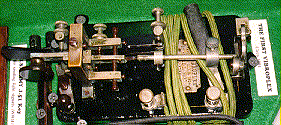
6020 VIBROPLEX ORIGINAL: (26KB)
The first model Vibroplex. S/N 483. Labeled: "THE VIBROPLEX,
Patented Aug. 9,1904 By Horace G. Martin, NewYork". Circa 1905.
6022 * VIBROPLEX ORIGINAL: Serial number 740. Same as 6020.Circa 1905.
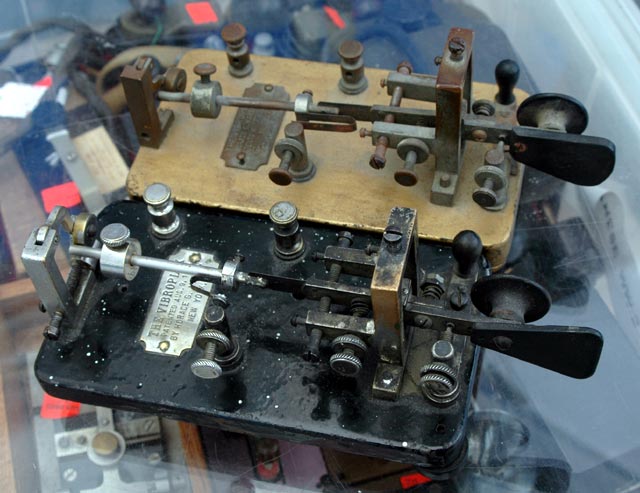
6025 * TWO VERY EARLY VIBROPLEX ORIGINALS WITHOUT
SERIAL NUMBERS: These two keys appeared at the 2005 Antique Wireless
Association conference. They have no serial numbers but the hardware
indicates that they are very early models.
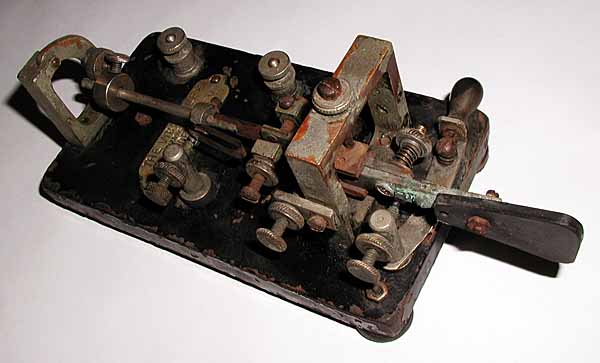
6030 DAMAGED VIBROPLEX DOUBLE LEVER MODEL: (28KB)
This is a Vibroplex double lever key that has been stripped of many parts to
make it into a typical Vibroplex single lever key. The very early nametag
simply says: 'THE VIBROPLEX, Manufactured by Horace G. Martin.
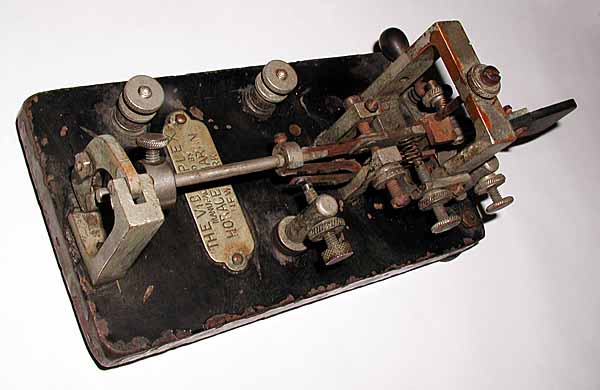
6030a Another view of the damaged double lever Vibroplex:
(33KB)
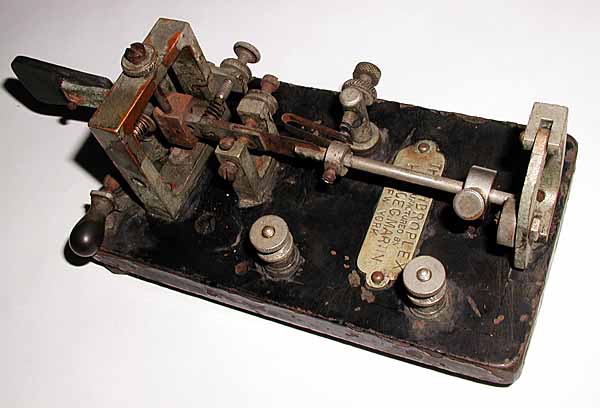
6030b Another view of the damaged double lever Vibroplex:
(34KB)
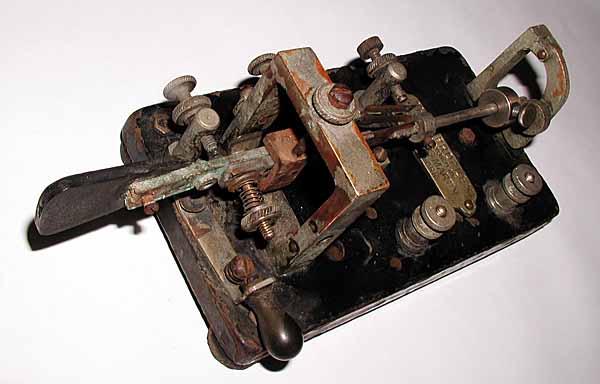
6030c Another view of the damaged double lever Vibroplex:
(31KB)
6040 * VIBROPLEX ORIGINAL: Serial number 1775. Labeled THE VIBROPLEX,
HORACE G. MARTIN'S PATENTS NO. 732648, 767303. Others Pending. Circa 1906.
6050 * VIBROPLEX ORIGINAL: Serial Number 2697. Like # 6040.
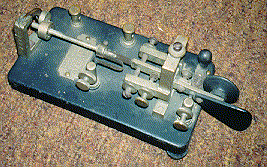
6060 * VIBROPLEX ORIGINAL:(31KB)
Serial number 2856. Labeled THE VIBROPLEX, HORACE G. MARTIN'S
PATENTS NO. 732648, 767303, 842154. Others Pending. Circa 1907.
Traded to: ->KB2SWI.
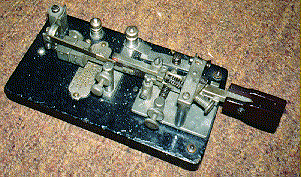
6120 VIBROPLEX "X"-MODEL: (38KB)
Serial number 11124. Labeled: "Trade THE VIBROPLEX Mark, Pat June
30.03, Aug.9.04.Jan.22.07 OTHERS PENDING Horace G. Martin, New
York,U.S.A. Circa 1912. This model is also called the
'single point key' because it uses a single set of contacts
for both dots and dashes.
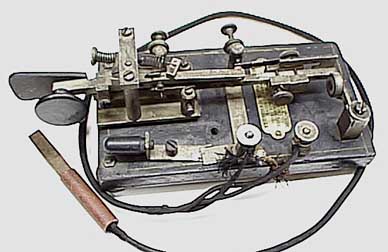
6123 * VIBROPLEX "X" MODEL:(26KB)
Serial Number 12277. Labeled: "Trade THE VIBROPLEX Mark" 84356
Nov 28, 1911, Pat Aug 9, 1904, Jan 22, 1907, Oct 29, 1912 Nov 5,
1912.Others pending. Horace G. Martin,New York,USA. Circa 1912
With connecting wedge contact stamped: J.E.ALBRIGHT, 253 B'way, N.Y.
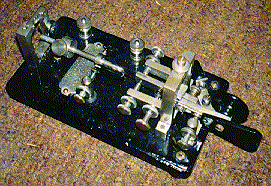
6140 * VIBROPLEX ORIGINAL:(36KB)
Serial number 20694. Labeled "Trade THE VIBROPLEX Mark" 84356
Nov 28, 1911, Pat Aug 9, 1904, Jan 22, 1907, Oct 29, 1912 Nov 5,
1912.Others pending. Horace G. Martin,New York,USA. Circa 1913.
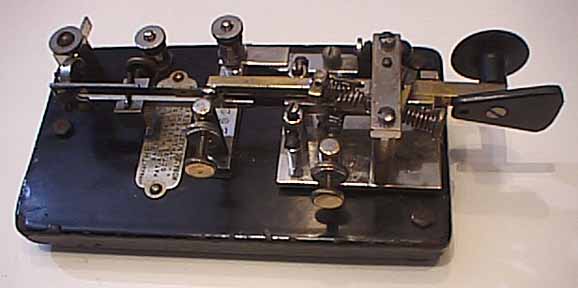
6145 * VIBROPLEX "X" MODEL:(20KB)
Serial Number 25,258. Labeled: "Trade THE VIBROPLEX Mark" 84356
Nov 28, 1911, Pat Aug 9, 1904, Jan 22, 1907, Oct 29, 1912 Nov 5,
1912.Others pending. Horace G. Martin,New York,USA. Circa 1913.
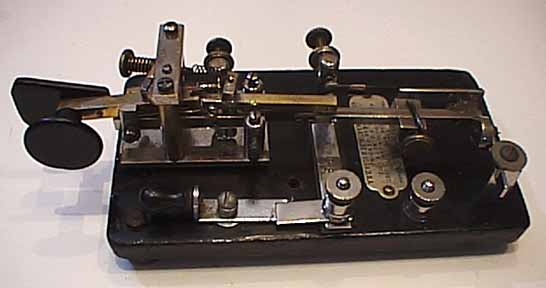
6145a Another view of the model 'x':(19KB)
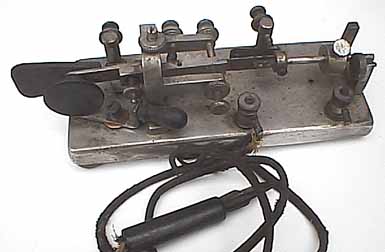
6150 * VIBROPLEX MODEL 4 DELUXE:(18KB)
(Early "Blue Racer"). Number B-566. Labeled:
"Trade THE VIBROPLEX mark" 84356
Nov 28, 1911, Pat Aug 9, 1904, Jan
22,1907, Oct 29, 1912, Nov 5, 1912.Others pending. Horace G. Martin, New
York, USA. Unusual All Nickel-plated base. Circa 1914.
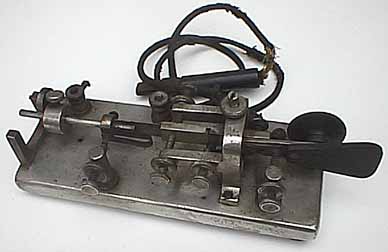
6150a Another view of the model 4:(17KB)
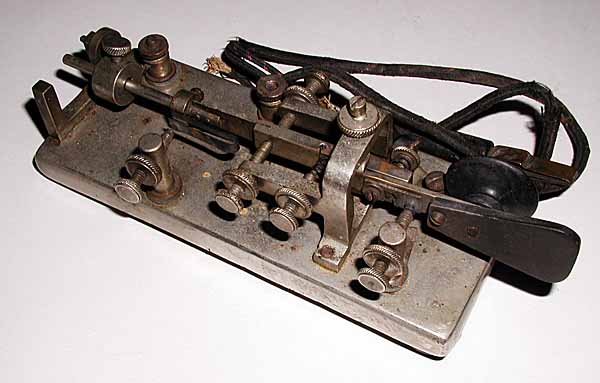
6150b Another view of the model 4:(35KB)
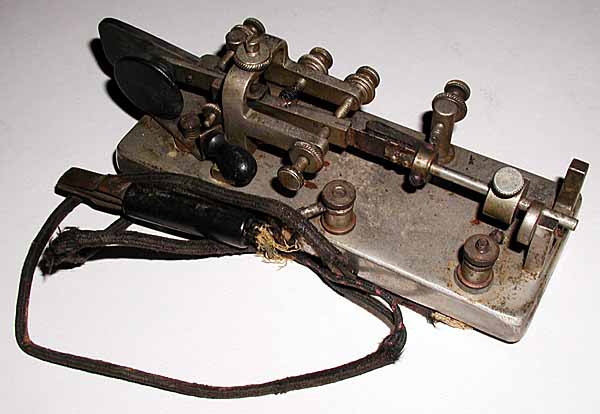
6150c Another view of the model 4:(35KB)
6157 VIBROPLEX MODEL 4 (Early "Blue racer"). Number B-933. As above.
BLUE Base. Barely Visible Albright decal. Circa 1914.
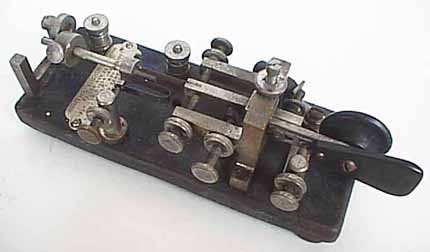
6160 VIBROPLEX MODEL 4:(15KB)
Serial Number B-998. As above. This key also has a
decal on the base.
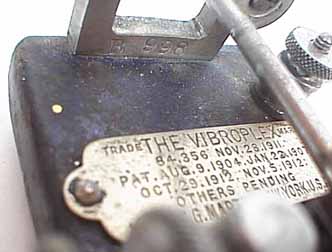
6160a A view of the label on the key:(17KB)
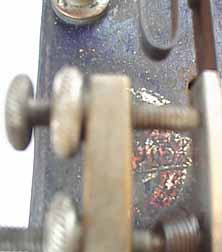
6160b A view of he decal on he base:(11KB)
6178 VIBROPLEX ORIGINAL: Number 50671. Parts key. No label. As below.1913.
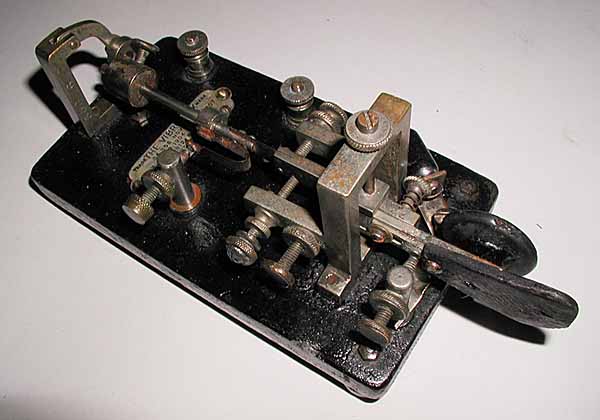
6180 VIBROPLEX ORIGINAL:(35KB)
Serial Number 50686. Label reads: "Trade THE
VIBROPLEX mark" 84356 Nov 28, 1911, Pat Aug 9, 1904, Jan 22, 1907, Oct
29, 1912 Nov 5, 1912. Others pending. Horace G. Martin, New York,USA.
Circa 1913.
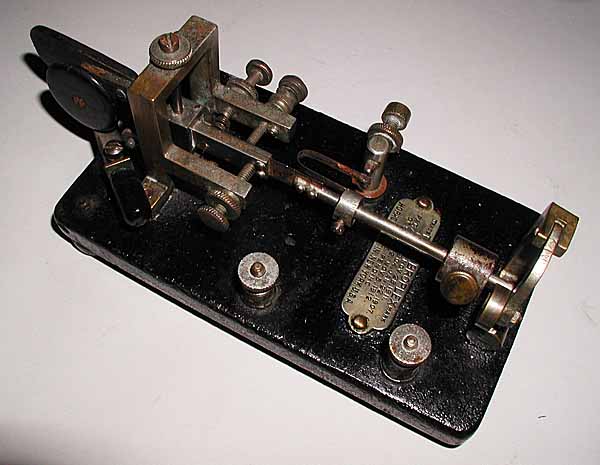
6180a Another view of the Vibroplex
Original:(39KB)
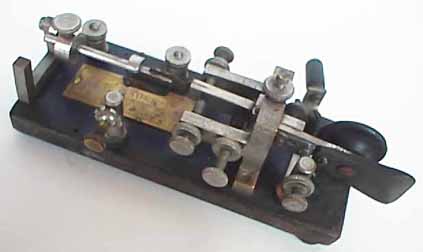
6220 * VIBROPLEX MODEL 4 ''BLUE RACER'':(13KB)
Serial Number 55088. Labeled: Trade "VIBROPLEX"
Mark, No 58702, US PATENTS NO.767,303 NO.812183 NO. 842154
NO.1,042,457 NO.1,043,449 THE VIBROPLEX COMPANY INC. 253
Broadway,NewYork. Circa 1916.
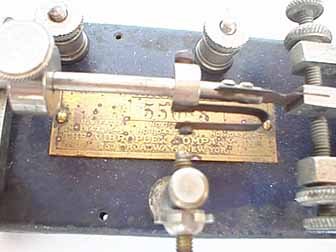
6220a Another view of the Blue Racer:(16KB)
6230 * VIBROPLEX MODEL 4 "Blue Racer": Number 57218. As above. Typical BLUE
Base. Circa 1916. (Traded to W9AC).
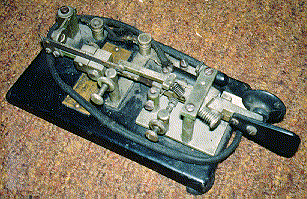
6240 * VIBROPLEX "X"-MODEL: (44KB)
Labeled: Trade "VIBROPLEX" Mark, No 58702, US PATENTS NO.767,303
NO.812,183 NO. 842154 NO.1,042,457 NO.1,043,449 THE VIBROPLEX
COMPANY INC. 253 Broadway,New York. From the Delaware and Hudson
Railroad office in Whitehall,NewYork.Shows wear from heavy
use.Circa 1917.
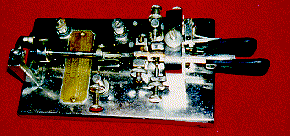
6260 * VIBROPLEX DELUXE DUAL-LEVER MODEL:(17KB)
Number 61867. Cloverleaf Frame. Last Patent No 1,178,291 THE VIBROPLEX
COMPANY INC 253 Broadway, New York. Circa 1918. (Traded to W9AC).

6265 VIBROPLEX VERTICAL "LINE CHIEF'S KEY:(10KB)
Labeled: Trade VIBROPLEX Mark, No. 63440 U.S.Patents 767,303, 812,183,
842,154, 1,042,457, 1,043,449, 1,074,831, 1,109,818, 1,110,373, 1,170,796
1,178,291. THE VIBROPLEX COMPANY INC. 253 Broadway, New York.Circa 1918.
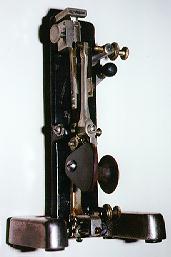
6265a Another front view of # 6265:(9KB)
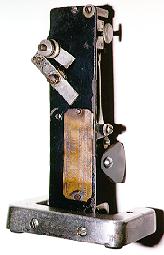
6265b A rear view of # 6265:(10KB)
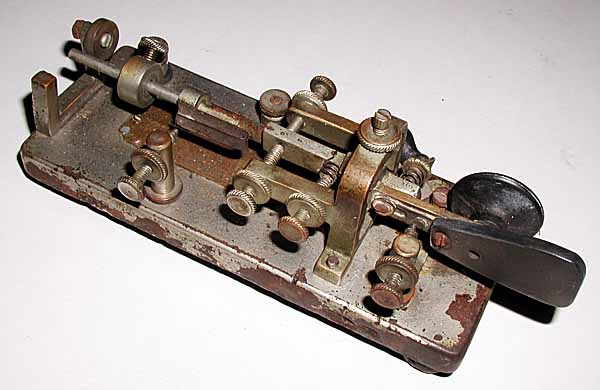
6270 VIBROPLEX DELUXE MODEL 4 'Blue Racer':(36KB)
All plated. Labeled: Trade
VIBROPLEX Mark, No. 63,838 U.S.Patents 763,303, 812,183, 842,154,
1,042,457, 1,043,449, 1,260,008, THE VIBROPLEX COMPANY INC. 253
Broadway, New York. Cloverleaf Frame. Circa 1918.
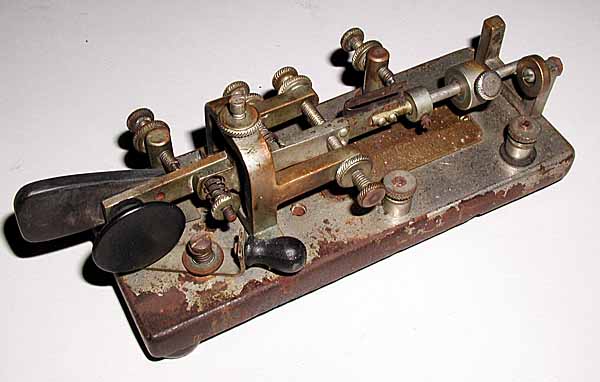
6270a Another view of the
VIBROPLEX DELUXE MODEL 4 'Blue Racer':(36KB)
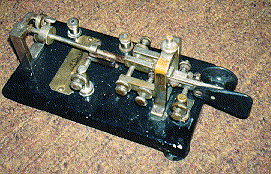
6320 * VIBROPLEX ORIGINAL:(33KB)
Labeled: Trade "VIBROPLEX" Mark, No. 64681 U.S.Patents 767,303,
812,183,1,042,457, 1,043,449, 1,074,831, 1,109,818,
1,110,373, 1, 170,796, 1,178,291 THE VIBROPLEX COMPANY INC 253
Broadway,NewYork.Circa 1919.
6330 * VIBROPLEX MODEL 4 "Blue Racer": S/N 65,406. Standard.
like 6270. Circa 1919.
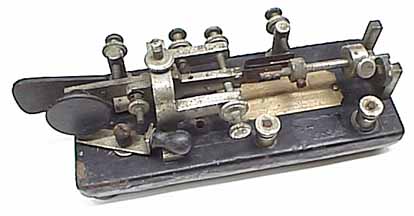
6331 VIBROPLEX MODEL 4 "Blue Racer":(18KB)
S/N 65,845. Standard. like 6270. Circa 1919.
6332 VIBROPLEX MODEL 4 "Blue Racer": S/N 67,099. Standard.
Black base. Circa 1919.
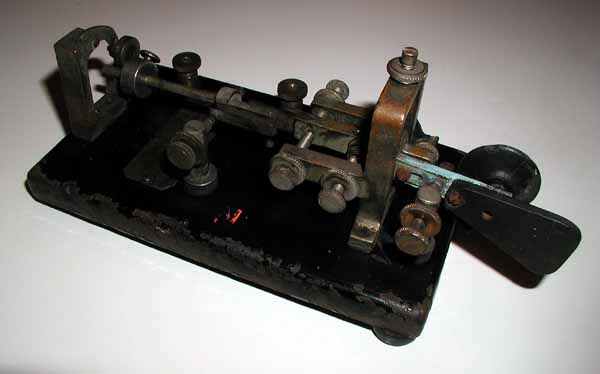
6333 VIBROPLEX ORIGINAL:(19KB)
Labeled: Trade "VIBROPLEX" Mark, No. 66985 U.S.Patents 767,303,
812,183,1,042,457, 1,043,449, 1,074,831, 1,109,818,
1,110,373, 1, 170,796, 1,178,291 THE VIBROPLEX COMPANY INC 253
Broadway,NewYork.Circa 1919.
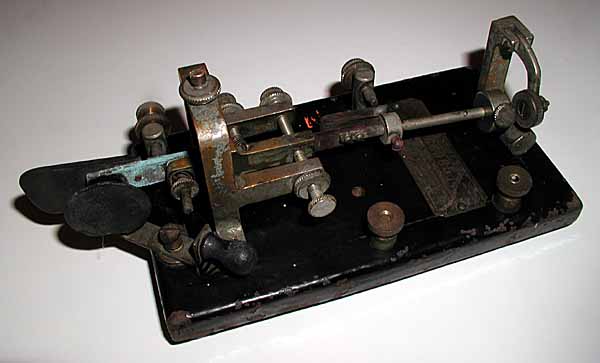
6333a Another view of the VIBROPLEX
ORIGINAL:(24KB)
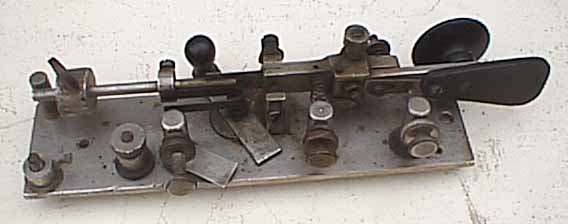
6338 * RARE VIBROPLEX 'MIDGET':(17KB)
This key carries serial number 69,685. It is by far the rarest
of the Vibroplex models. I was able to buy it at the Dayton
hamfest in 1999. It is one of the 6 Midgets known to exist.
It is missing the articulated leg. --> Randy Cole, KN6W.
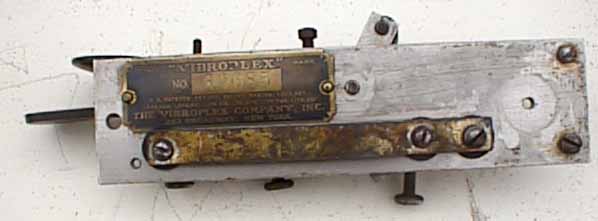
6338a A bottom view of the Midget:(15KB)
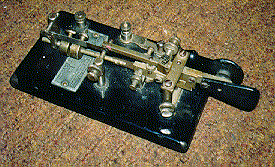
6340 * VIBROPLEX "X" MODEL:(32KB)
Round shaft. Labeled: Trade VIBROPLEX Mark, No. 70053 U.S.Patents
No 767,303, 812,183, 842,154, 1,042,457, 1,043,449,
1,260,008 THE VIBROPLEX COMPANY INC. 253 Broadway, New York. Circa 1919.
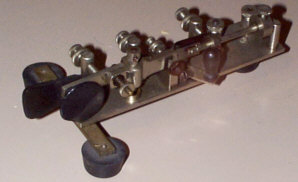
6345 ** K8DV's RARE VIBROPLEX 'MIDGET':(12KB)
This key carries serial number 70,235. It is by far the rarest
of the Vibroplex models. David Vest, K8DV has given me
permission to include several pictures of his key in my museum.
It is one of the 6 Midgets known to exist.
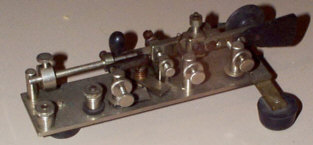
6345a Another view of the Midget:(12KB)
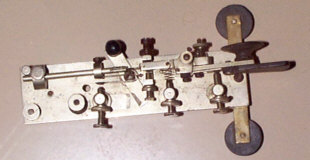
6345b A top view of the Midget:(14KB)
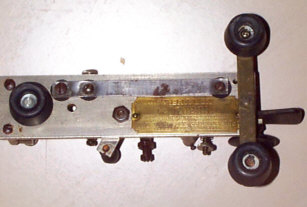
6345c A bottom view of the Midget:(16KB)
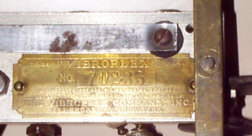
6345d A view of the label on the Midget:(12KB)
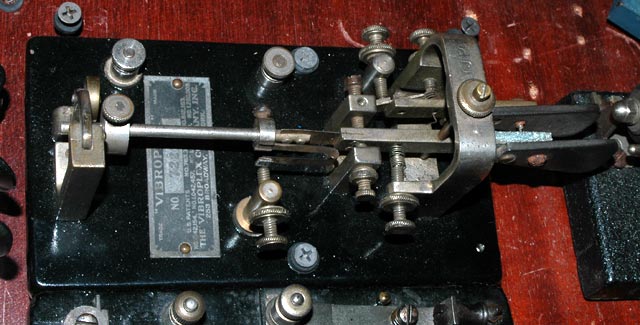
6349 VIBROPLEX DUAL-LEVER MODEL: Cloverleaf frame.
Labeled: Trade VIBROPLEX Mark, No. 72210 U.S.Patents No 767,303, 812,183,
842,154, 1,042,457, 1,043,449, 1,260,008 THE VIBROPLEX COMPANY INC. 253
Broadway, New York. Circa 1919.
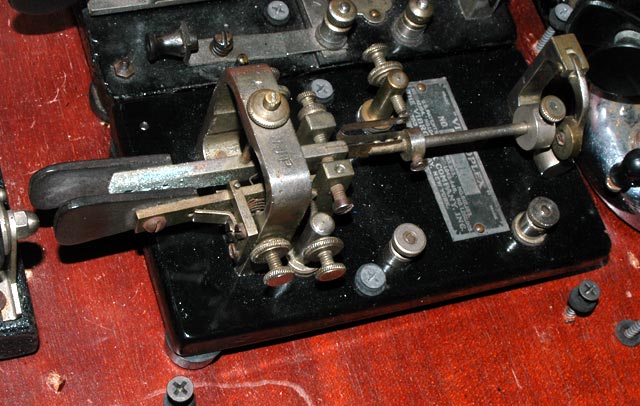
6349a Another view of the Vibroplex Dual-Lever
key:
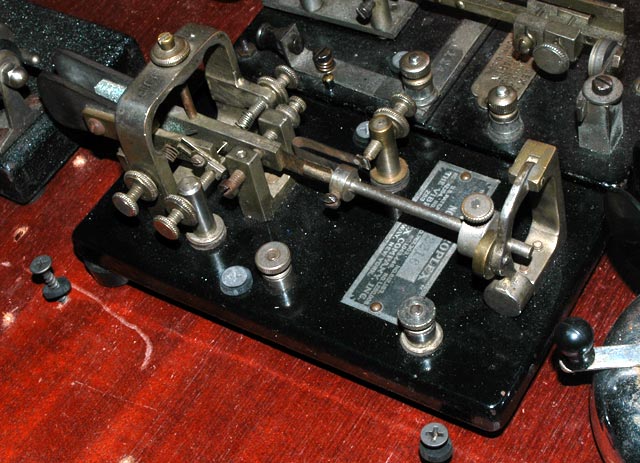
6349b Another view of the Vibroplex Dual-Lever
key:
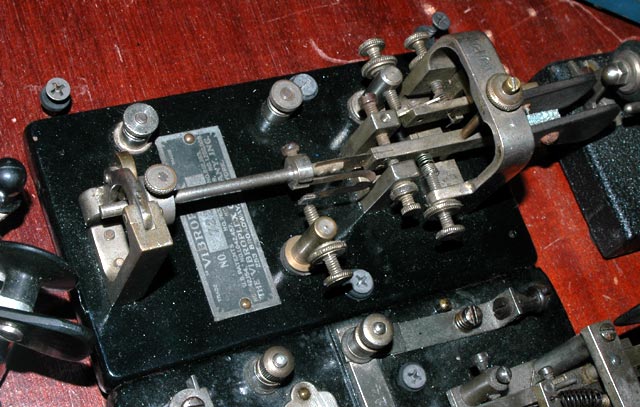
6349c Another view of the Vibroplex Dual-Lever
key:
6350 VIBROPLEX DUAL-LEVER MODEL: Cloverleaf frame. Labeled: Trade
VIBROPLEX Mark, No. 72216 U.S.Patents No 767,303, 812,183, 842,154,
1,042,457, 1,043,449, 1,260,008 THE VIBROPLEX COMPANY INC.
253 Broadway, New York. Circa 1919.
6370 * VIBROPLEX "X" MODEL-X: Round shaft. No. 72977.
Same as 6340. Circa 1920.
6400 * VIBROPLEX "PSEUDO-X" ORIGINAL / MODEL "X"
HYBRID: Labeled: Trade VIBROPLEX
Mark, No. 73847 U.S.Patents No 767,303, 812,183, 842,154, 1,042,457,
1,043,449, 1,260,008 THE VIBROPLEX COMPANY INC. 253 Broadway, New York.
Circa 1920. This extremely unusual key has the ORIGINAL style base,
upright frame, lever, and dash mechanism but it also has a round-shaft
MODEL X style damper, and MODEL X elevated dot spring and high dot
contact post.>K5VT.

6401 ** LEFT-HANDED "PSEUDO-X":(16KB)
Similar to 6400 but left-handed. (Owned by collector Ed Biter-NS3E)
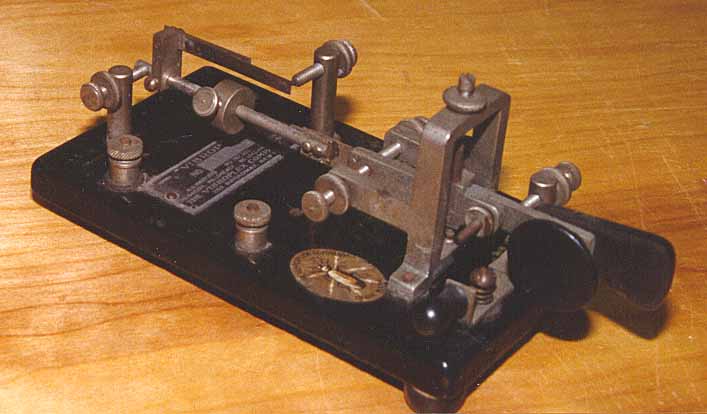
6401a LEFT-HANDED "PSEUDO-X" ENLARGED VIEW:(34KB)
6410 * VIBROPLEX ORIGINAL: Black Japanned Base. No Label. Circa 1920.
6420 * VIBROPLEX "X" MODEL: Round shaft. Number 74896.
Like 6340. Circa 1920.
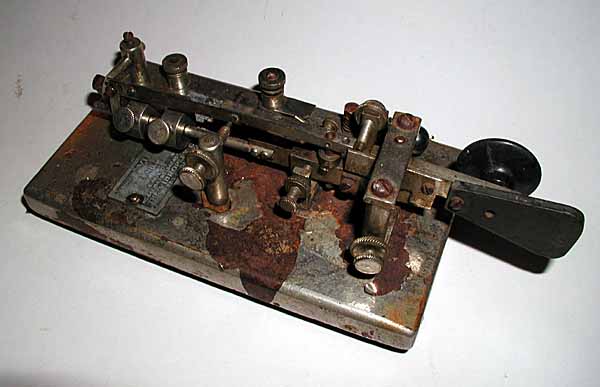
6430 VIBROPLEX DELUXE ROUND SHAFT MODEL X:(26KB)
Labeled: Trade VIBROPLEX Mark, No. 75839
U.S.Patents No 767,303, 812,183, 842,154, 1,042,457, 1,043,449,
1,260,008 THE VIBROPLEX COMPANY INC. 253 Broadway, New York. This
is the first Nickel-Plated Round Shaft Vibroplex Model X that I have
come across. Circa 1920.
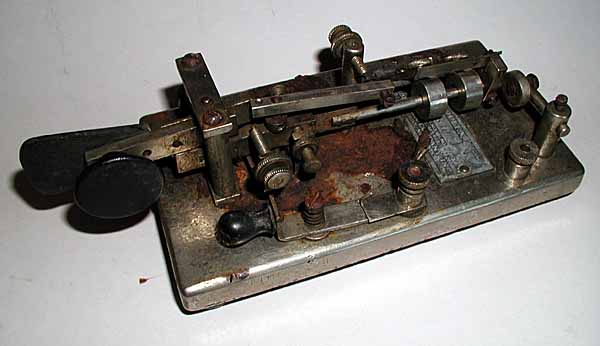
6430a A Right-Side view of the
VIBROPLEX DELUXE ROUND SHAFT MODEL X:(28KB)
6440 * VIBROPLEX MODEL 4 "Blue Racer" Labeled:
Trade VIBROPLEX Mark, No.
76722 U.S.Patents No 767,303, 812,183, 842,154, 1,042,457, 1,043,449,
1,260,008 THE VIBROPLEX COMPANY INC. 253 Broadway, New York. Unusual
wheel damper. BLACK Japanned base. Cloverleaf frame. Circa 1920.
6450 * VIBROPLEX ORIGINAL: Serial Number 78857.
Label same as 6440.Circa 1920.
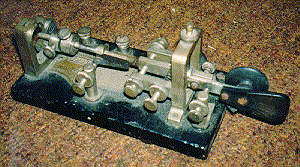
6460 VIBROPLEX "JUNIOR":(35KB)
Labeled: Trade VIBROPLEX Mark, No. 81905 U.S.Patents No 767303,
812183,842154,1042457,1043449,1260008 THE VIBROPLEX
COMPANY INC. 825 Broadway,NewYork.Circa 1920.Pencilled"March 15 1927
WATKINS"on bottom.
6480 VIBROPLEX "JUNIOR-MODEL4": Very rare Junior base with model 4
mechanism. Labeled: Trade VIBROPLEX Mark, No. 82332 U.S.Patents No
767303, 812183, 842154,1042457,1043449,1260008 THE VIBROPLEX COMPANY INC.
825 Broadway, New York. Cloverleaf Frame. Circa 1921. (Base 6" X 3".)
Only 1 other one known to exist.
6505 * VIBROPLEX ORIGINAL: Serial Number 84903. Label like #6480.
Circa 1922.
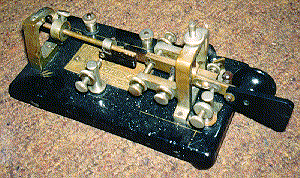
6540 * VIBROPLEX ORIGINAL:(38KB)
Labeled: Trade VIBROPLEX Mark, No. 86654 U.S.Patents 763,303,
812,183, 842,154, 1,042,457, 1,043,449, 1,260,008,
THE VIBROPLEX COMPANY INC. 825 Broadway, New York. Circa 1922.
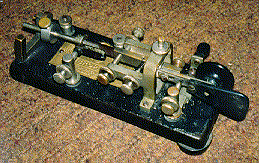
6550 * VIBROPLEX MODEL 4 "Blue Racer": (29KB)
Labeled: Trade VIBROPLEX Mark, No. 87181 U.S.Patents 763,303,
812,183, 842,154, 1,042,457, 1,043,449, 1,260,008, 1,445,226 THE
VIBROPLEX COMPANY INC. 825 Broadway, New York. Cloverleaf Frame.
Circa 1922.
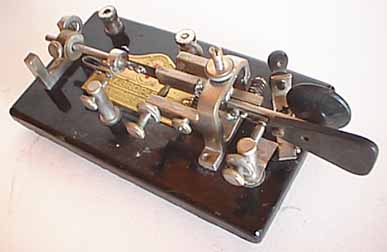
6555 * HYBRID VIBROPLEX ORIGINAL / BLUE RACER:(15KB)
This unusual key has a blue racer mechanism with cloverleaf
frame mounted on a Vibroplex Original base.
It is labeled: Trade VIBROPLEX Mark, No. 96,337 U.S.Patents 763,303,
812,183, 842,154, 1,042,457, 1,043,449, 1,260,008, 1,445,226 THE
VIBROPLEX COMPANY INC. 796 Fulton St. New York. Cloverleaf Frame.
Circa 1926.
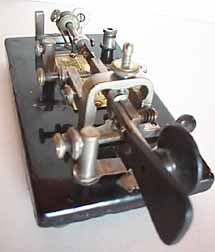
6555a Another view of the hybrid key:(12KB)
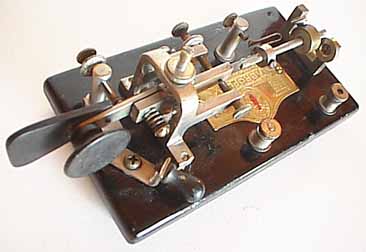
6555b Another view of the hybrid key:(17KB)
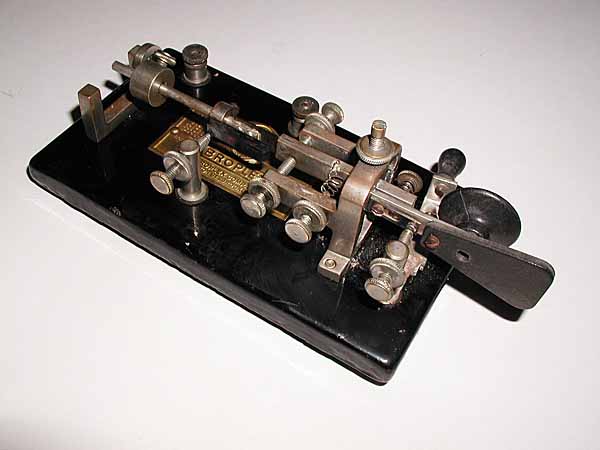
6555c Another view of the hybrid key:(29KB)
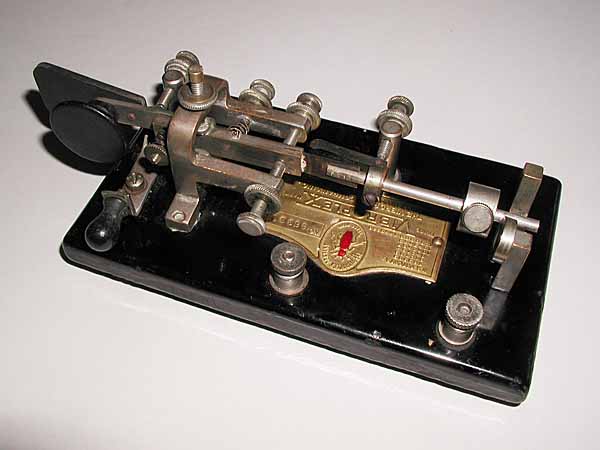
6555d Another view of the hybrid key:(31KB)
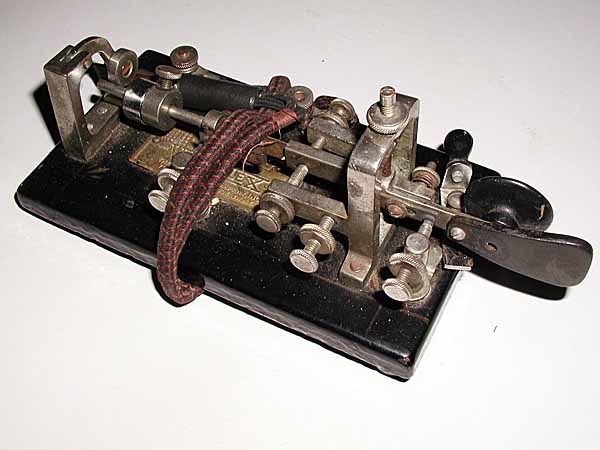
6558 VIBROPLEX ORIGINAL:(36KB) Labeled:
Trade VIBROPLEX Mark, No. 96,844
U.S.Patents No 763,303, 812,183, 842,154, 1,042,457, 1,043,449, 1,260,008,
1,445,226 THE VIBROPLEX COMPANY INC. 796 Fulton St. New York. Circa 1926.
6560 * VIBROPLEX ORIGINAL: Labeled: Trade VIBROPLEX Mark, No. 96944
U.S.Patents No 763,303, 812,183, 842,154, 1,042,457, 1,043,449, 1,260,008,
1,445,226 THE VIBROPLEX COMPANY INC. 796 Fulton St. New York. Circa 1926.
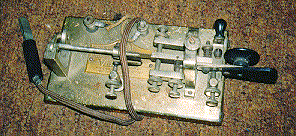
6580 * VIBROPLEX ORIGINAL DELUXE:(29KB)
Early all chrome plated. Labeled:Trade VIBROPLEX Mark,No. 98947
U.S.Patents 763,303, 812,183, 842,154, 1,042,457,
1,043,449, 1,260,008, 1,445,226 THE VIBROPLEX COMPANY INC. 796 Fulton St.
New York. Circa 1926.
6605 * VIBROPLEX LIGHTNING BUG: Number 103421. Japanned base.
Label same as 6580. Circa 1929.>K2PTS.
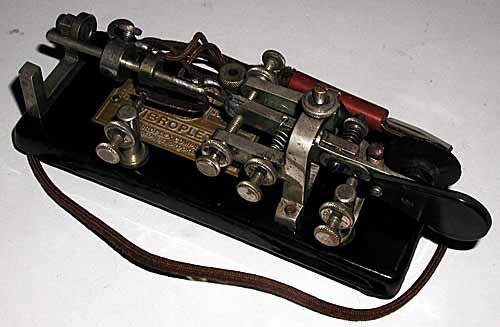
6607 * VIBROPLEX BLUE RACER:(28KB)
Serial Number 107,029 which indicates that it was built
in 1933.
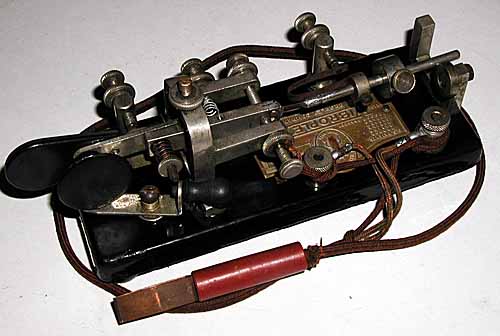
6607a * Another view of the BLUE RACER:(30KB)
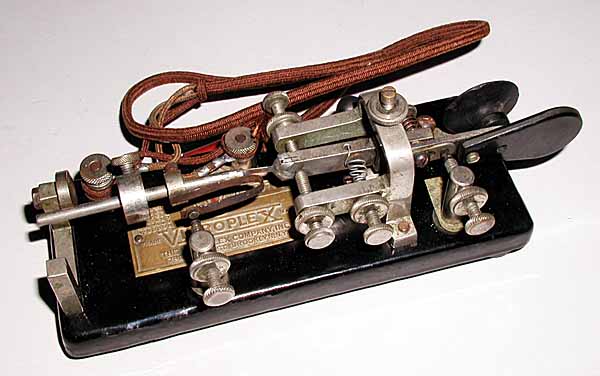
6607b * Another view of the BLUE RACER:(37KB)
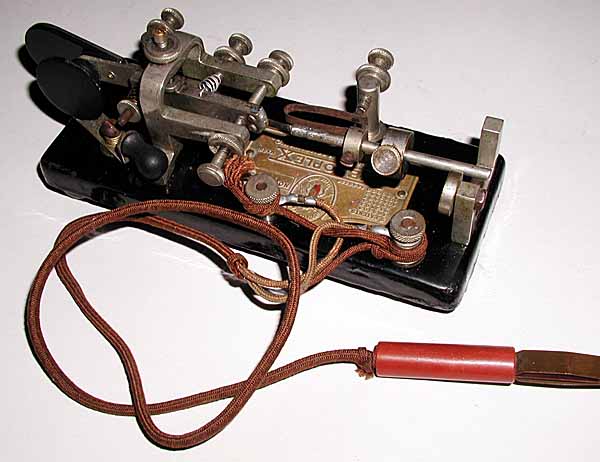
6607c * Another view of the BLUE RACER:(43KB)
6610 * VIBROPLEX ORIGINAL: Number 111309. Wrinkle-finish base.
label same as 6580. Circa 1938.
6611 * VIBROPLEX ORIGINAL: Serial No. 113803 in Carrying case marked
NORTHWEST AIRLINES INC. U.S. Airmail. Circa 1939.>K2PTS.

6621 1943 VIBROPLEX HYBRID BLUE RACER /
ORIGINAL:(46KB)Serial Number 125,892 which indicates that it
was built in 1943. The Blue Racer Mechanism is mounted on a
Black Wrinkle-Finish Original-Size base.
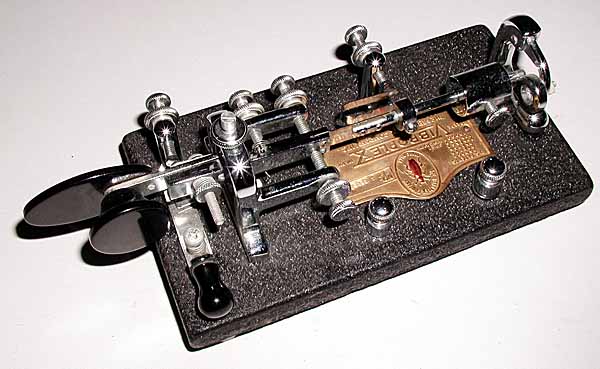
6621a Another view of the 1943 VIBROPLEX HYBRID
BLUE RACER /ORIGINAL:(47KB)
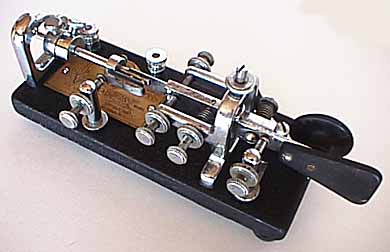
6630 * VIBROPLEX BLACK BASED BLUE RACER:(19KB)
Serial Number 146,955 which indicates that it was built
in 1945 when the Vibroplex company was located at
833 Broadway, New York.
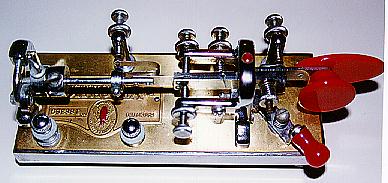
6700 LEFT-HANDED VIBROPLEX BLUE RACER PRESENTATION MODEL:(24KB)
Serial Number 188.359. 833 Broadway, New York.
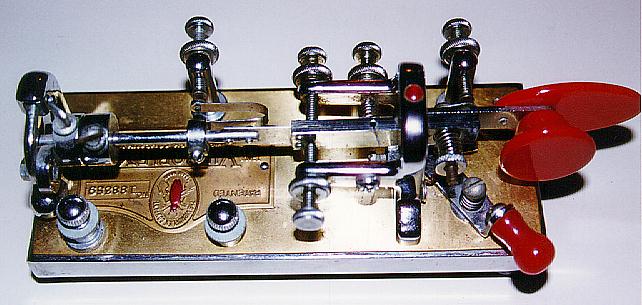
6700h Higher resolution photo of
6700:(52KB)
6700h3 MUCH Higher resolution photo of
6700:(292KB)
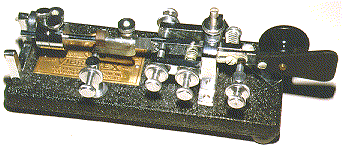
6820 * VIBROPLEX BLUE RACER:(22KB)
Serial Number 189,322. 833 Broadway, New York.
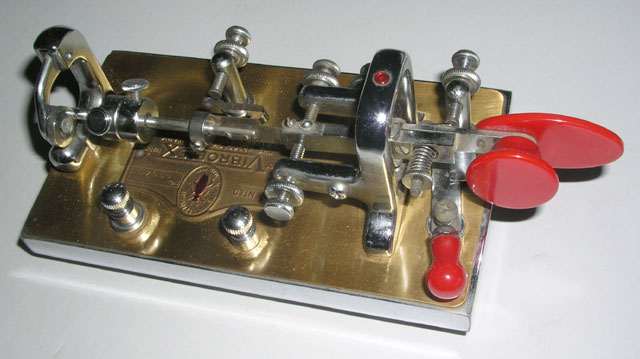
6827 LEFT HANDED VIBROPLEX PRESENTATION
DELUXE ORIGINAL:(22KB)
Serial Number 199,400. 833 Broadway, New York. This is a very unusual
Left Handed Presentation Model. Vibroplex typically made these keys only on
special order and they made very few of them.
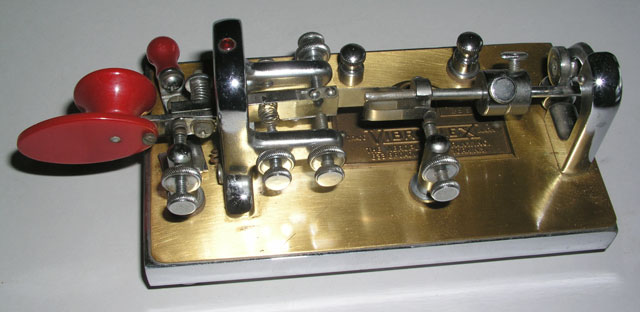
6827a Right Side View of the Left Handed Vibroplex
Presentation.(35KB)

6830 * VIBROPLEX GREY BASED BLUE RACER:(14KB)
Serial Number 200,107 which indicates that it was manufactured
in 1957.

6840 * VIBROPLEX BLUE RACER DELUXE:(20KB)
Number 208,374.All Chromed.833 Broadway. Circa 1955.
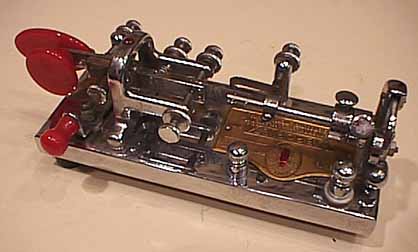
6840a Another view of the 1955 Blue Racer:(20KB)
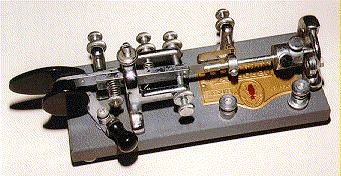
6860 * VIBROPLEX BLUE RACER:(32KB)
Serial Number 222,914. 833 Broadway,New York. Circa 1961.
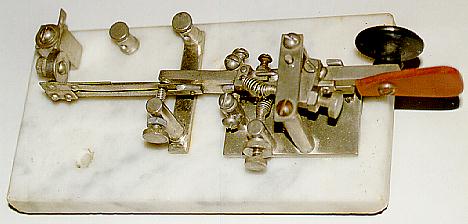
6900 MARBLE-BASED MODEL "X" BUG:(22KB)
This bug has the same design features as the Vibroplex model "X"
and is mounted on a white marble base. It may be a copy of a
Vibroplex key made by perhaps ATOZ.
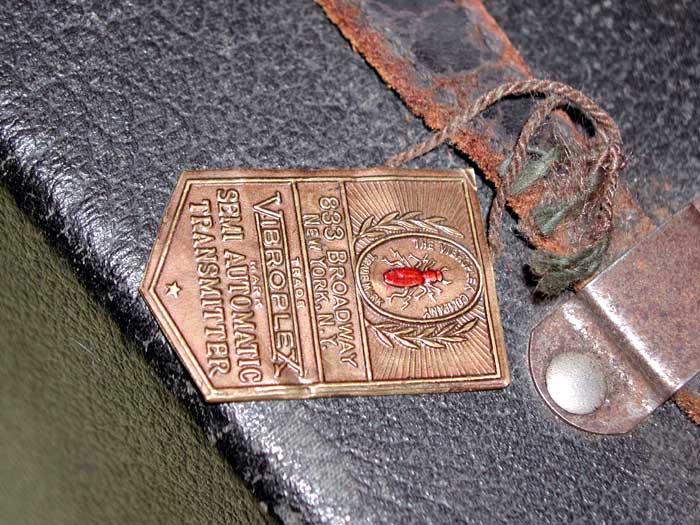
6925 * UNUSUAL VIBROPLEX NAMETAG:
I had not seen one of these Vibroplex Nametags before someone brought one
to my table at the Dayton Hamfest. It is obviously designed to
be attached to a Vibroplex carrying case as shown in the photo:

6950 UNUSUAL VIBROPLEX DECAL:(48KB)
This decal is obviously designed to be pasted to the inside of a window...
perhaps on a car. Other collectors tell me that this decal is fairly
common.
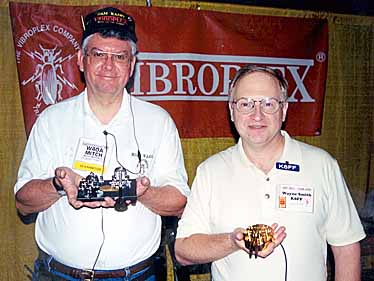
6990 MITCH, W4OA, THE OWNER OF THE VIBROPLEX
COMPANY AT THE 2000 DAYTON HAMVENTION:(27KB) Mitch was
kind enough to take a moment to pose for this picture holding
the new Vibroplex paddle / straight key combination at the
Vibroplex booth at the Dayton Hamvention. He is at the left
in this picture alongside Wayne Smith, K8FF. The Vibroplex
exhibit booth was constantly busy and sold a lot of
keys and parts. The square weights for the Lightning/Champion
bugs were particularly popular.
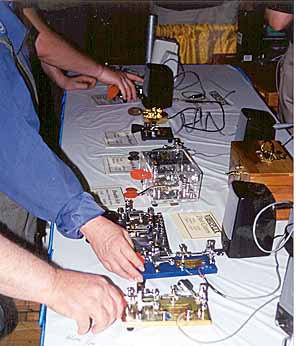
6990a PEOPLE TRYING OUT THE KEYS AT
THE VIBROPLEX BOOTH:(26KB) There were always a lot of
eager hands reaching out to try the keys on display at the
Vibroplex booth.
Internet ENIGMA Museum:
https://EnigmaMuseum.com
COPYRIGHT NOTICE: (Copyright (c) 2023: Prof. Tom Perera Ph. D.)
Although all the pictures and text are copyrighted, you may use any of them
for your own personal applications including public lectures and
demonstrations, publications and websites as long as you mention the
w1tp.com Museum. If you plan to offer them for sale to the public
in any form, please email me for permission which I will generally grant as
long as you mention my museum: http://w1tp.com or https://EnigmaMuseum.com My email address is
given at the bottom of this page. Some of the material may require contacting
other copyright owners for commercial use and I will inform you by email.
Please also see the Disclaimer of Warranty.
(The instruments are in approximate chronological order: Oldest first.)
* = (Items no longer owned.) ** = (Items in other collections.)
BUGS (NOT VIBROPLEX) (7001 - 8000),
VIBROPLEX BUGS (6001 - 7000)
NOTE ON THE DATING OF VIBROPLEX BUGS:
John Elwood, WW7P has been gathering information about Vibroplex keys
for many years. He has been able to reconstruct many of the dates of
manufacture of the various models of Vibroplex keys which had been lost
in the Vibroplex fire. His complete list of dates is published in the
Vibroplex Collector's Guide by Tom French W1IMQ which is listed in the
bibliography section of this website. You may also find John Elwood's
complete list by going to the website of Randy Cole KN6W at:
http://www.la.ca.us/frandy/dating.html
The following information briefly summarizes these published findings.
To use this summary, first find the serial number on your Vibroplex.
It will be stamped into the label on later models and into the damper
or other parts on early models. Then use this table to find the
approximate date of manufacture:
Serial # Date Serial # Date Serial # Date 001,000 - 1905 150,000 - 1946 040,000 - 1980 (Portland ME) 010,000 - 1911 200,000 - 1957 060,000 - 1988 050,000 - 1914 250,000 - 1967 080,000 - 1995 (Mobile, AL) 100.000 - 1920 300,000 - 1974
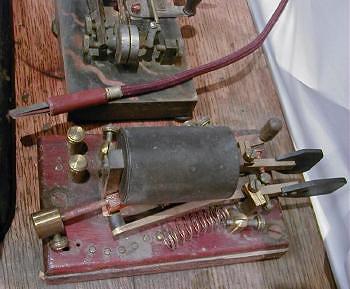
7030 * GIL SCHLEHMAN'S EXCEPTIONALLY RARE CONKLING
BUG:(25KB)
This exceptionally rare bug was found in Canada, mounted on
a large wooden base along with a number of other early and rare keys.
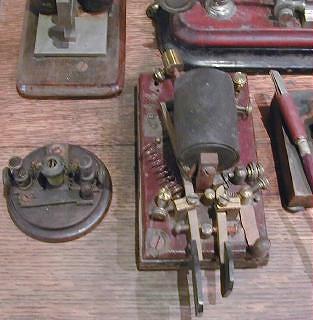
7030a * Another view of the CONKLING BUG:(24KB)
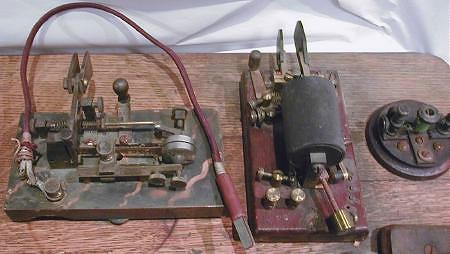
7030b * Another view of the CONKLING BUG:(26KB)
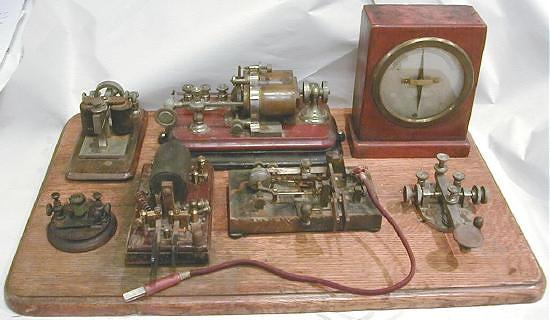
7030c * A view of the board with all the keys
mounted on it:(35KB)

7040 * GIL SCHLEHMAN'S EXCEPTIONALLY
UNUSUAL VERTICAL SEMI-AUTOMATIC KEY:(68KB)
Very Early nickel-plated mechanism with straight key mounted on a
cast iron base and pivoted at the bottom of the vertical mechanism.
Automatic dots are made by pressing down on the knob somewhat like
a VAILOGRAPH. Shorting switch on the right side. 4''long by 5'' high.
(Traded to K9WDY).
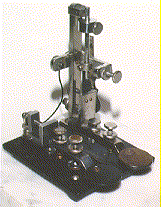
7040a Matching dash-making key shown with
the above semi-automatic key:(15KB) This picture of the pair
shows a very unique and unusual semi-automatic key combination.
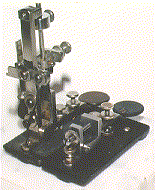
7040b This is a second picture of the vertical
dot maker and the dash maker: (13KB)
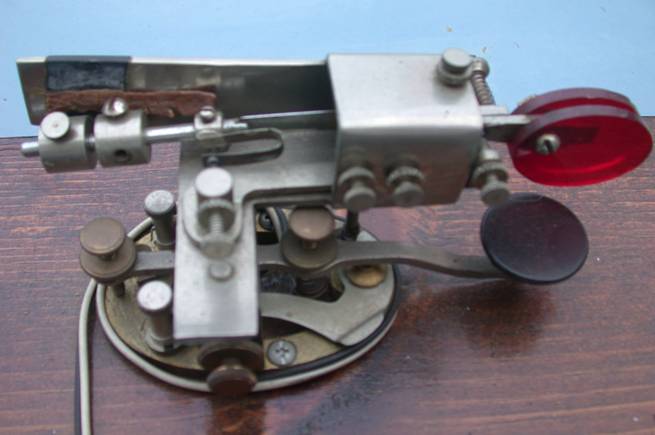
7044 EXCEPTIONALLY UNUSUAL "Little Giant" SEMI-AUTOMATIC KEY Add-On for Straight KEY:
This is the only known example of this unusual key. It was designed to clip onto a standard straight key. It has on it a small Gold Sticker that Says Little Giant Manufacturing Company, Gilroy, CA and a Patent Number that is not possible to read. It was purchased by Clem, W0MEC who lives in Westminster, CA. He bought it in 1958 from a railroad telegrapher who did not like it. Clem needed a bug that was light weight and very portable. It had to work with ANY straight key, not take up much space and be capable of being quickly disconnected to allow other operators to use the straight key.
As he tells it: "I bounced around the Extra Board there on the GNRR Kalispell Division for a few years before entering the Relay Service where they needed Hot Shot telegraphers of which I was NOT. But I got my feet wet and you might say I was a Boomer as they called those Telegraphers that moved around and took on the HOT telegraph wire jobs. I learned to Telegraph, but it was not an easy step up. When I finally got it I could copy and send with any of those wishing to try and snow me under with their FIST or their Bug or their combinations.."
"I use This Bug for both American Morse and International Morse as it is really easy to move from One "Brass Pounder" to another. I will be demonstrating This Bug that I just showed you and my Vibroplex President From 1956 with what they called the Gold Plated Base with my name Engraved on it at this years Field Day here in Buena Park at the Walter Knott School where they will set up about 15 to 20 antennas and Stations for the FD event. The Orange County Amateur Radio Club W6ZE
Will be sponsoring this event. Check out our Web Page at www.w6ze.org. I have several resonators (Sounders)(Clackers) and main line Relays that I will be Using to show Railroad communications as I know it from experience."
More pictures of the Little Giant bug: (Although the pictures are not very sharp, the key is so unusual that I have chosen to show them all here.)
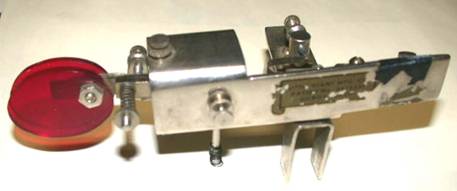
7044b * Another View of the Little Giant Bug:
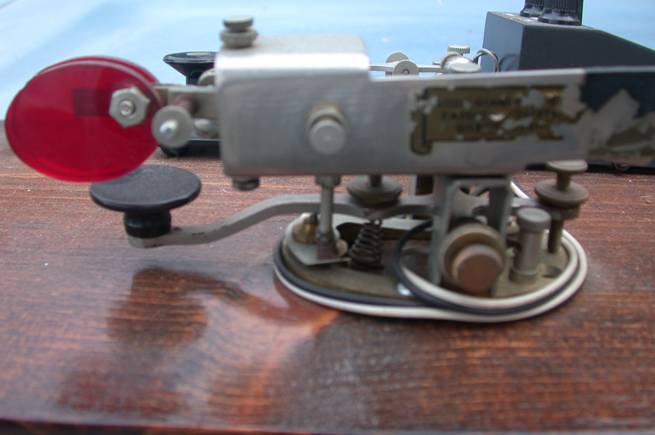
7044c * Another View of the Little Giant Bug:
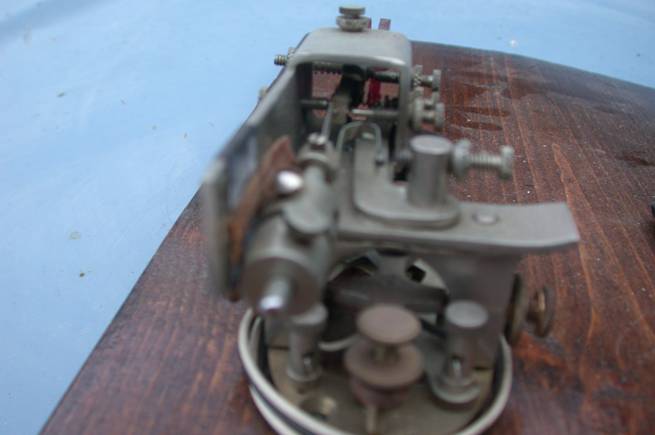
7044d * Another View of the Little Giant Bug:
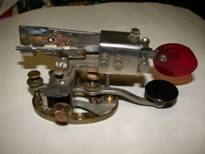
7044e * Another View of the Little Giant Bug:
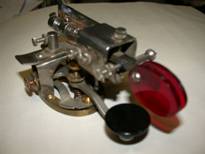
7044f * Another View of the Little Giant Bug:
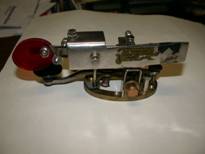
7044g * Another View of the Little Giant Bug:
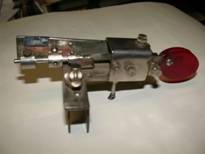
7044h * Another View of the Little Giant Bug:
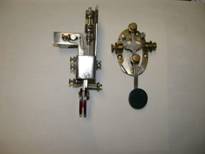
7044i * Another View of the Little Giant Bug:
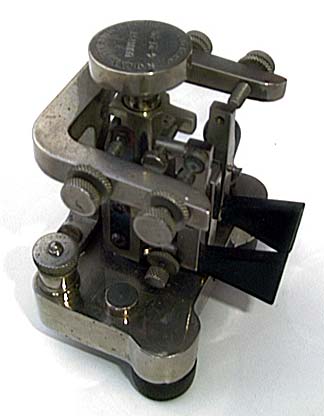
7050 * GIL SCHLEHMAN'S NATIONAL TRANSMITTER COMPANY
VERTICAL BUG:(21KB) This is an exceptionally rare National Transmitter Company
Vertical Bug. It carries the DUNN Patent date of 4-27-20.
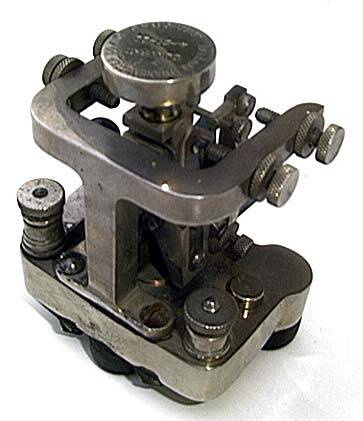
7050a * Another View of Gil Schleman's National
Transmitter Co. Bug:(25KB)
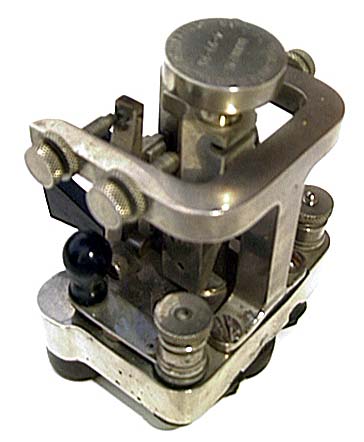
7050b * Another View of Gil Schleman's National
Transmitter Co. Bug:(24KB)
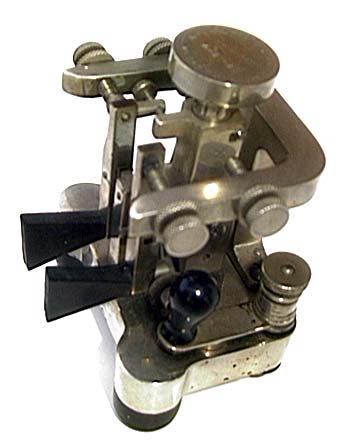
7050c * Another View of Gil Schleman's National
Transmitter Co. Bug:(22KB)
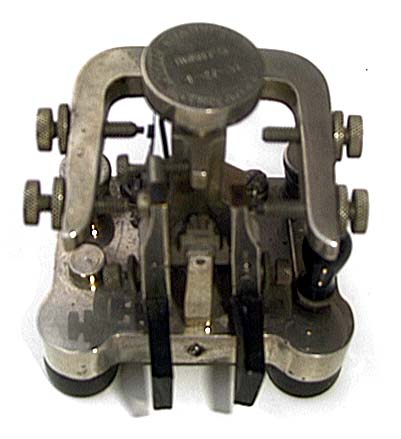
7050d * Another View of Gil Schleman's National
Transmitter Co. Bug:(25KB)
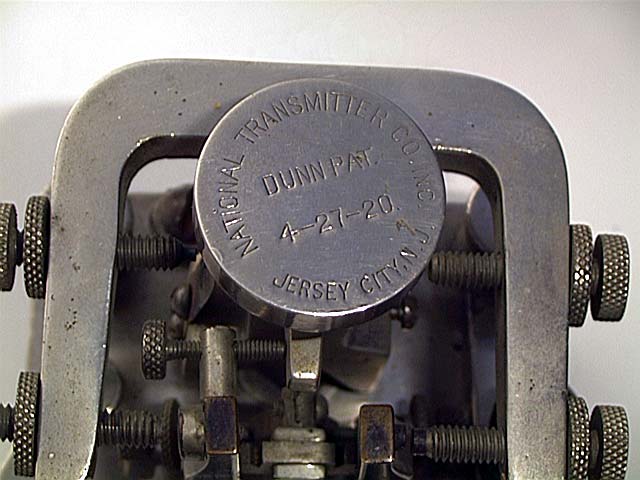
7050e * A Close view of the Name and Patent information
stamped on the top of Gil Schleman's National
Transmitter Co. Bug:(49KB)
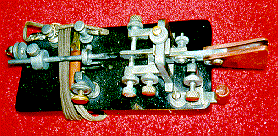
7060 * XOGRAPH:(24KB)
Mfg in Rolf Brown's basement factory-Toronto. Circa 1920.
No label or numbers.
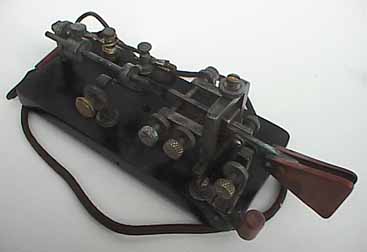
7060a Another view of the XOGRAPH:(12KB)
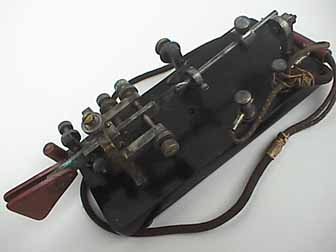
7060b Another view of the XOGRAPH:(13KB)

7075 DOUBLE-LEVER DUNDUPLEX BUG WITH RARE ORIGINAL METAL
CARRYING CASE:(36KB)
This is a double lever Dunduplex bug with the rare metal Dunduplex carrying
case. The action is quite complex and operates on the 'release of tension on
the lever' principle to circumvent the Martin-Vibroplex patent. Pressing the
left lever or pushing down on the left top cylinder pulls a diagonal metal rod
away from the vibrating lever allowing it to vibrate. Releasing the lever
returns the diagnonal rod to its original postion thus damping the ocsillating
lever. Pressing the right knob or pushing down on the right top cylinder
pushes the dash contact down to make contact. The two cylinders usually have
round knobs press-fit into the holes in the top. They are missing in this
key. Moving the shorting lever to the left locks the dash contact in the
closed position. The key is stamped: THOS. J. DUNN & CO., New York. PAT'D 1909
and it carries serial number: 1062. Since it was common to start numbering
keys at 1000, this suggests that it may actually be the 62nd Dunduplex
manufactured. You can see some of these details in the following
pictures:
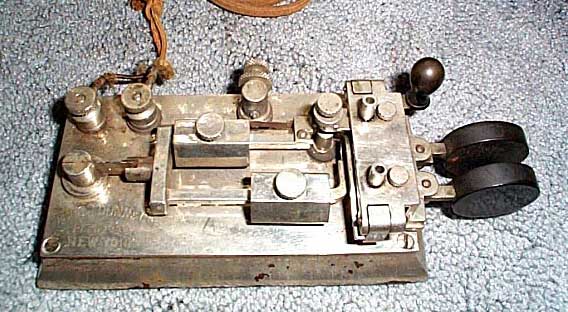
7075a Another view of the 2 lever Dunduplex:(46KB)
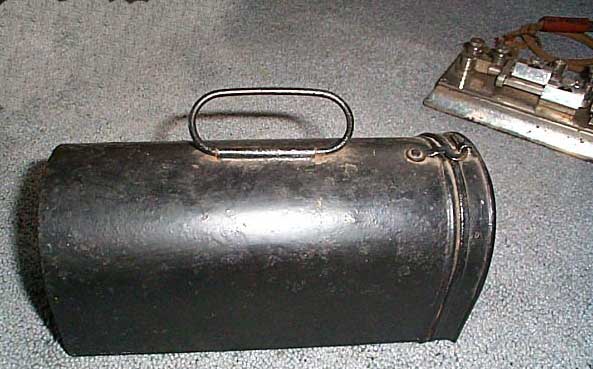
7075a The original metal carrying case for the
Dunduplex:(38KB)
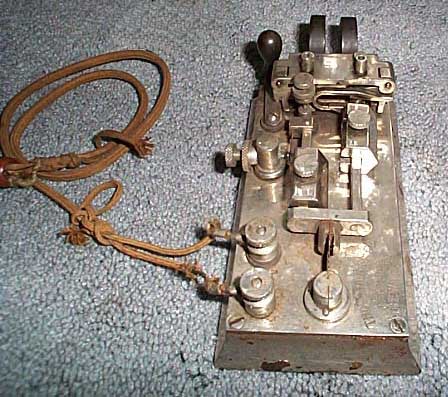
7075c Another view of the 2 lever Dunduplex:(43KB)
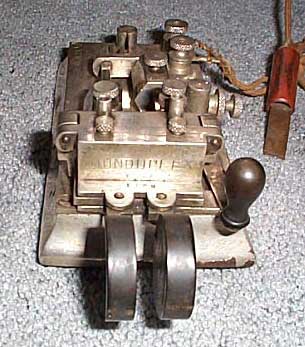
7075d Another view of the 2 lever Dunduplex:(25KB)
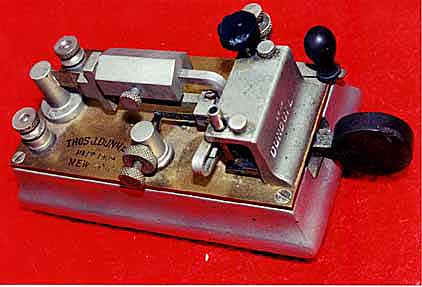
7080 * RARE SINGLE-LEVER DUNDUPLEX BUG:(23KB)
This is a very hard to find version of the Dunduplex bug.
It has excellent high speed ''feel''. The small knob on the right
may be used as a straight key. This key is owned by
Lloyd Price, N2KPC who was kind enough to allow me to photograph it.
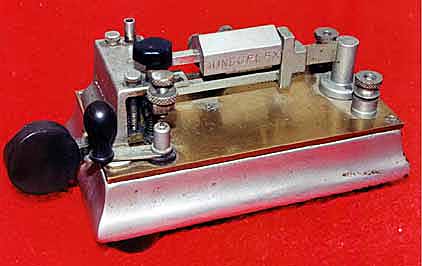
7080a Another view of Lloyd Price's
DUNDUPLEX:(19KB)
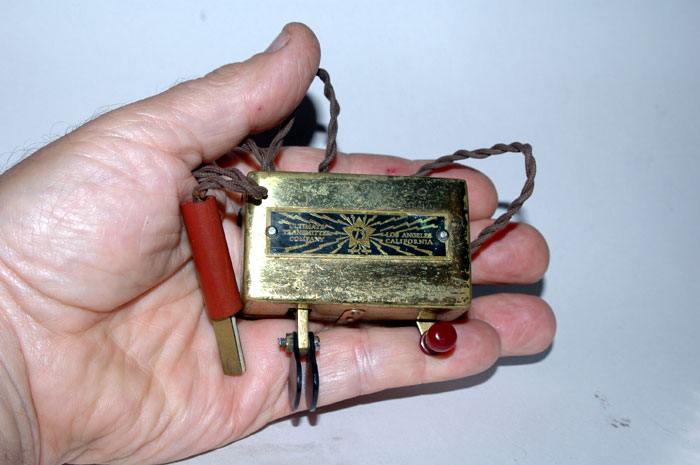
7110 SUB-MINIATURE VERSION OF THE "ULTIMATE"
POCKET PORTABLE BUG in it's ORIGINAL WOODEN CARRYING BOX:(59KB)
This is an unique sub-miniature version of the "Ultimate" miniature
right-angle bug. It came in its own original carrying case that also has the
Ultimate label on top. The bug measures only 2.3 inches wide as compared with
the 3.5 inches of the classical "Ultimate" bug. It's cover is inscribed: The
Ultimate Transmitter Company, Los Angeles, California and there is a star with
the number '73' in the middle between the manufacturer's name and the place of
manufacture. Trade Mark Registered. Patd 6-23-25.
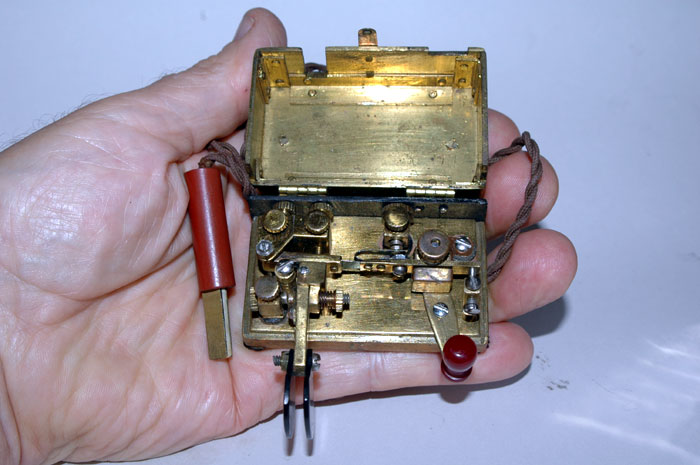
7110a The inner mechanism of the sub-miniature
"Ultimate" pocket bug:(66KB)
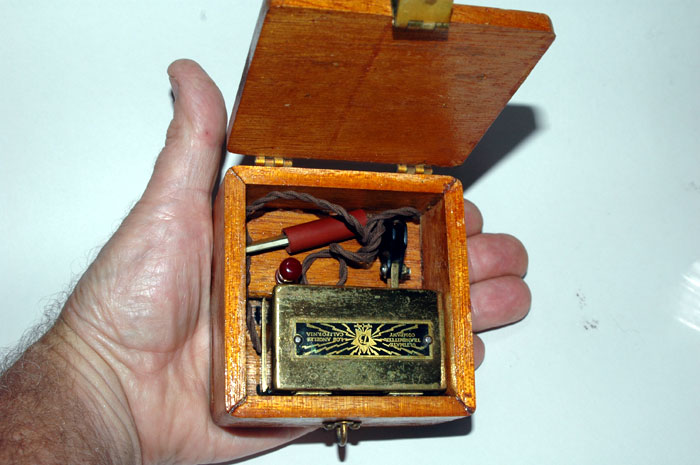
7110b A view of the sub-Miniature "Ultimate" pocket bug in its box:(69KB)
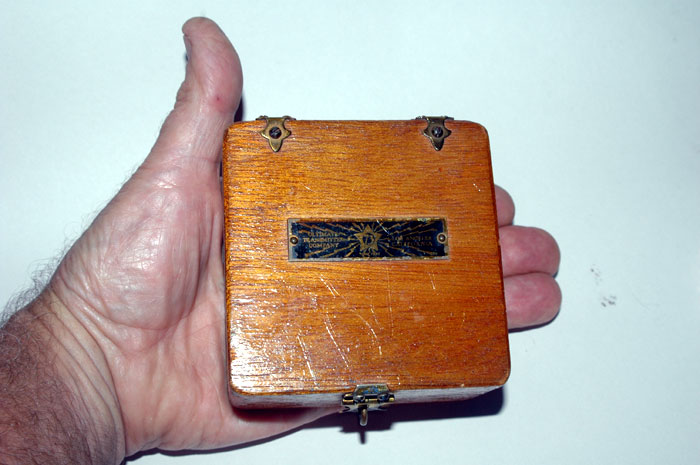
7110c A top view of the miniature box for the sub-miniature "Ultimate" pocket bug:(65KB)
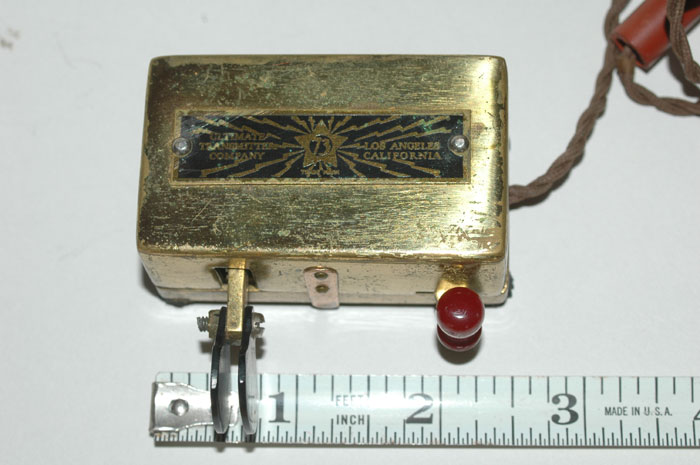
7110d The sub-miniature "Ultimate" pocket bug
with ruler to show its width:(60KB)
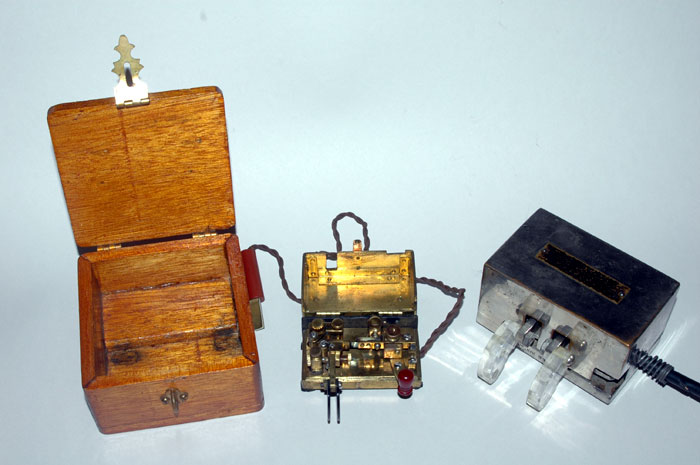
7110e A comparison of the sub-miniature "Ultimate" pocket bug and it's box with a classic "Ultimate" pocket bug:(57KB)
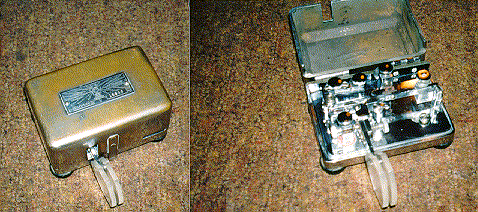
7120 THE "ULTIMATE" POCKET PORTABLE BUG:(70KB)
All chromed miniature right-angle bug with cover label inscribed:
The Ultimate Transmitter Company, Los Angeles, California and there is a star
with the number '73' in the middle between the manufacturer's name and the
place of manufacture. Trade Mark Registered. Patd 6-23-25. Number 15943.
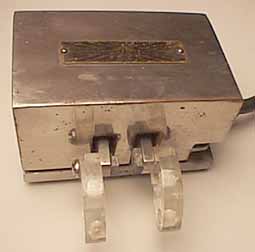
7125 DOUBLE-LEVER 'ULTIMATE' POCKET PORTABLE BUG:(10KB)
This is an unusual version of the ULTIMATE all-chromed miniature
right-angle bug. Its cover label is inscribed:
The Ultimate Transmitter Company, Los Angeles, California and there is a star
with the number '73' in the middle between the manufacturer's name and the
place of manufacture.
Pressing the left lever to the right makes
automatic dots. Pressing it to the left makes manual dashes. Pressing the
right lever to the left also makes manual dashes and pressing it to the right
does nothing. It is unclear why the right lever was designed into this key
since it does the same thing as the left lever with respect to dashes.
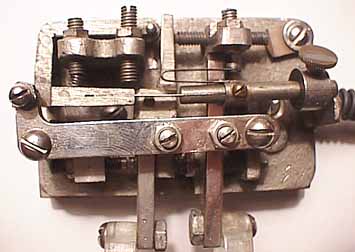
7125a View of the inside mechanism of the key with the
cover opened:(19KB)
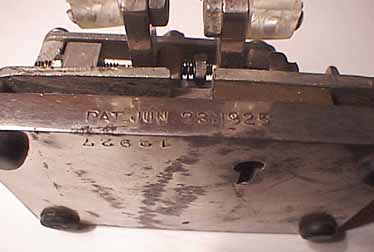
7125b View of the patent date: June 23, 1925 and the
serial number: 12927:(15KB)
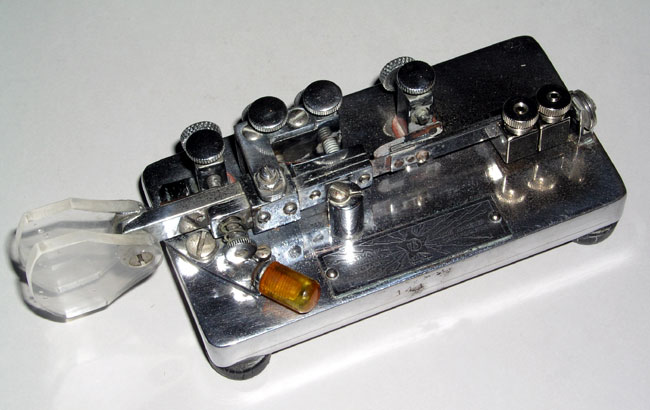
7130 UNUSUAL STRAIGHT 'ULTIMATE' MINIATURE POCKET PORTABLE
BUG:(30KB)
This is an unusual version of the ULTIMATE all-chromed miniature bug.
Most Ultimate bugs are of right-angle design and have a cover.
This key is simply a straight-line bug with a few unusual design features.
The damper consists of two washers, the lever travel is limited by an unusual
vertical shaft with an offset screw holding it up. The bug carries serial
number 141 or 144. Slight damage to the plating makes the last digit
uncertain. Its label is inscribed: The Ultimate Transmitter Company,
Los Angeles, California., and there is a star with the number '73' in the
middle between the manufacturer's name and the place of manufacture.
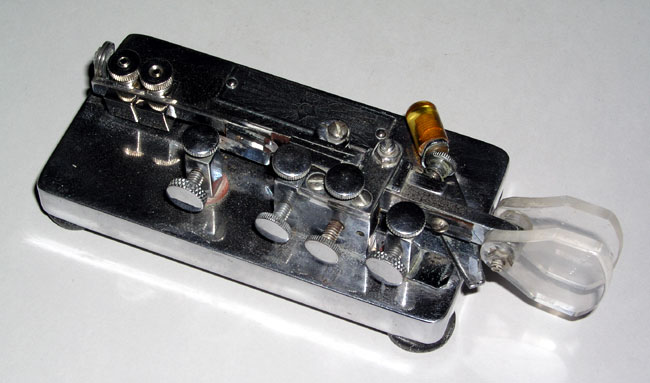
7130a Another view of the unusual straight 'ultimate'
miniature pocket portable bug:(30kb)
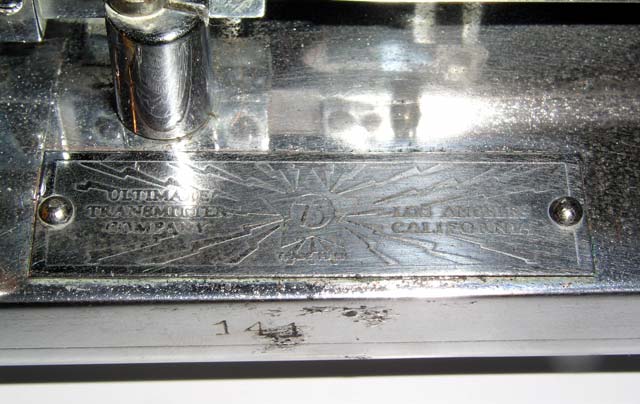
7130b A view of the label and the serial number on the
unusual straight 'ultimate' miniature pocket portable bug:(30kb)
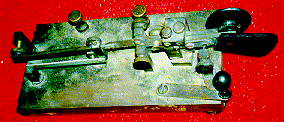
7140 * MECOGRAPH BUG:(19KB)
Unusual old, formerly all plated straight action bug with base
engraved:The Mecograph Co.Cleveland, O.This key was made in1913
after Vibroplex bought Mecograph so it does not infringe on Martin's
patents.>WA5Y.
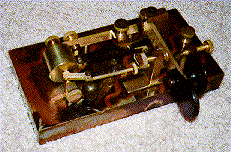
7141 MECOGRAPH MODEL 3 RIGHT-ANGLE BUG:(22KB)
The Mecograph model 3 with the so-called ''tiger striped''
etched patterned base and the "release
of tension" action that circumvented Martin's patents.
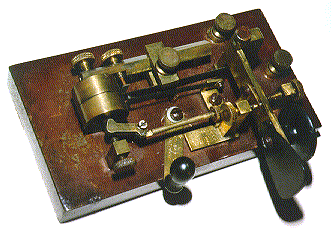
7141a * MECOGRAPH MODEL 3 RIGHT-ANGLE BUG:(30KB)
Similar to 7141 but with plain base.
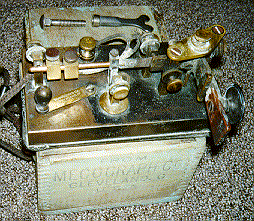
7142 * MECOGRAPH RIGHT-ANGLE, 1908 BUG: (41KB)
Rare right-angle bug with round shaft and square weights.
Vibrating pendulum like Vibroplex. Circuit closer marked
MECOGRAPH,Cleveland O.With original box, wedge, and hold down clamp
screw. (traded).
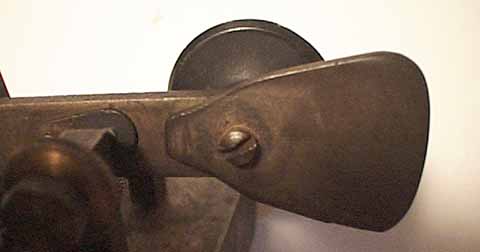
7143 ORIGINAL MECOGRAPH PADDLE: (11KB)
This is an original Mecograph Paddle. Many of the
paddles which are found on Mecographs have been broken
off and replaced with paddles from other keys. This is
the way the original paddle looks.
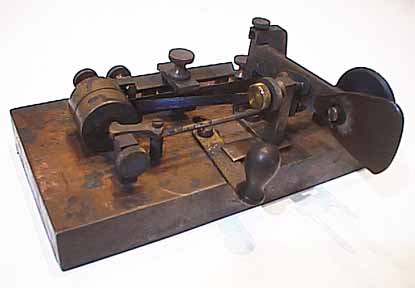
7144 * MECOGRAPH RIGHT-ANGLE MODEL 3 BUG:(14KB)
This is another version of the Mecograph right-angle bug that
circumvented Martin's patents.
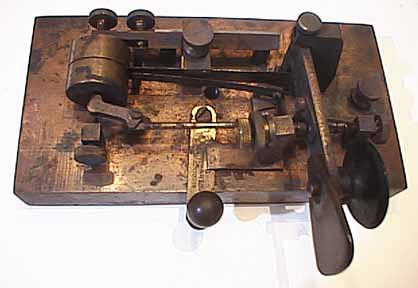
7144a Another view of the Mecograph Model 3:(18KB)
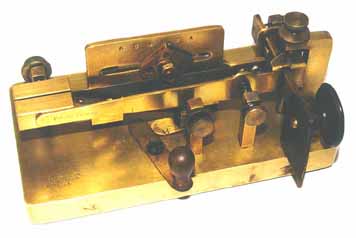
7145 * MECOGRAPH RIGHT-ANGLE MODEL 3 BUG: (14KB)
This is another version of the Mecograph right-angle bug that
circumvented Martin's patents. -> WA5Y.
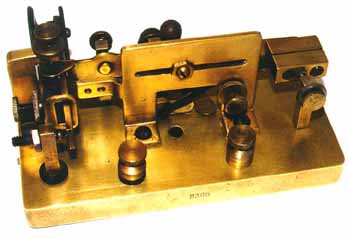
7145a Back view of the Mecograph Model 3: (16KB)
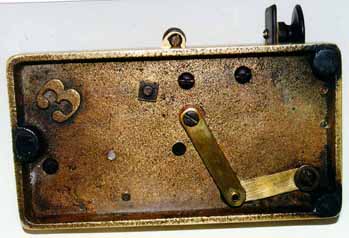
7145b View of the bottom of the Meocgraph Model 3
showing the large number "3": (20KB)
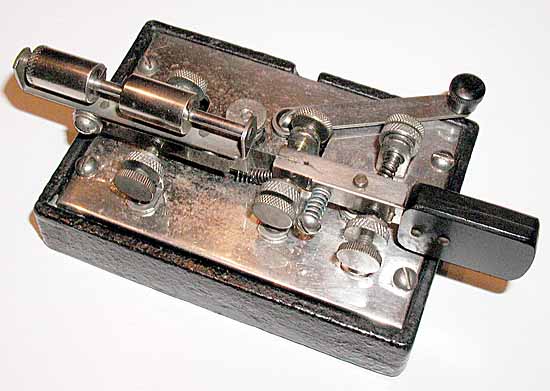
7150 PEERLESS BUG:(40KB)
This is a particularly hard to find bug made by the Peerless
Manufacturing Company in Fordson, Michigan. Some models had a
small permanent magnet instead of a damper.
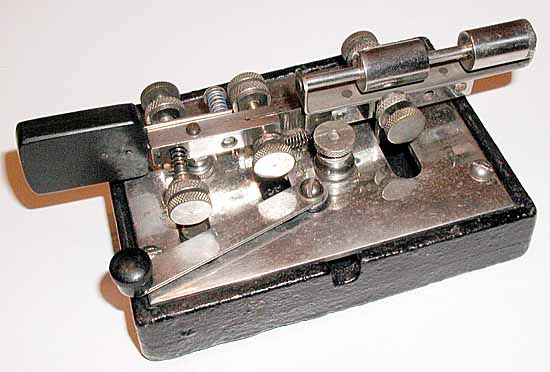
7150a Right side view of the Peerless Bug:(37KB)
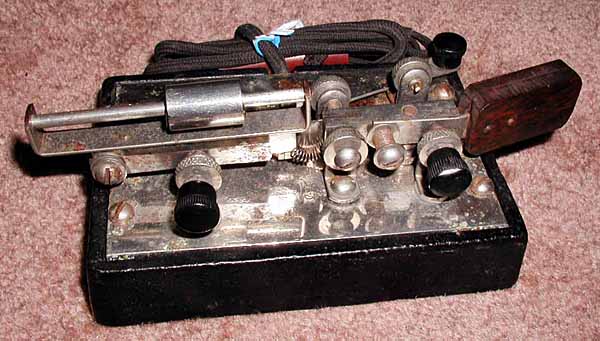
7151 PEERLESS BUG:(45KB) This is another Peerless Bug
similar to the one described above.
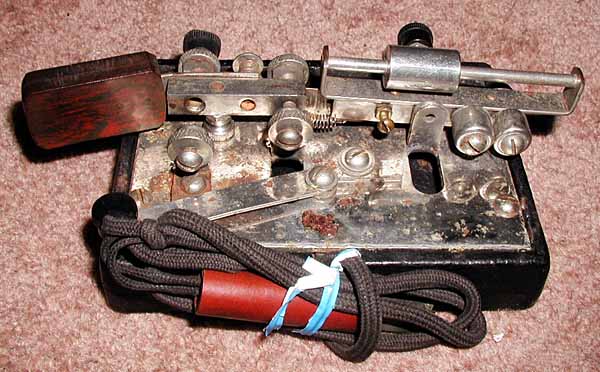
7151a Right side view of the PEERLESS BUG:(53KB)
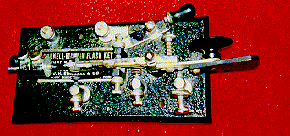
7160 * BUNNELL-MARTIN FLASH KEY Model 5-46:(18KB)
Unusual vertical post pivot design thought by Bill Holly to be the
possible precursor to the Rotoplex design. Circa 1940. (Traded to
K5VT).
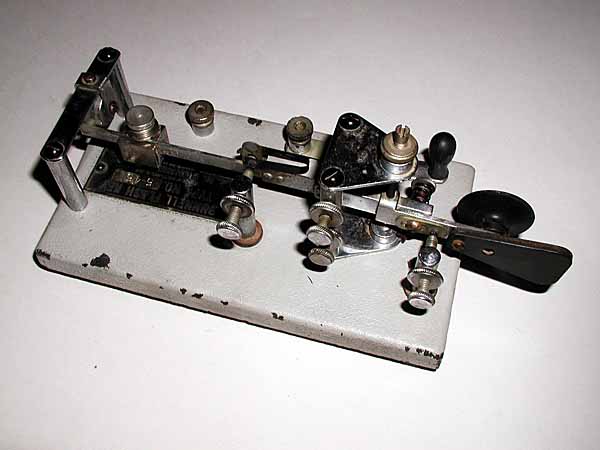
7166 GRAY-BASED BUNNELL FLASH KEY MODEL 5-45:(29KB)
In 1939, Bunnell bought the patents for the Bunnell-Martin Flash Keys
and apparently dropped the -Martin name from the labels. This is an
unusual gray-based model of the Bunnell Flash Key. The label reads:
BUNNELL FLASH KEY. TYPE NO. 5-45. Manufactured by J. H. Bunnell & Co.,
New York. Made in U.S.A. New York.
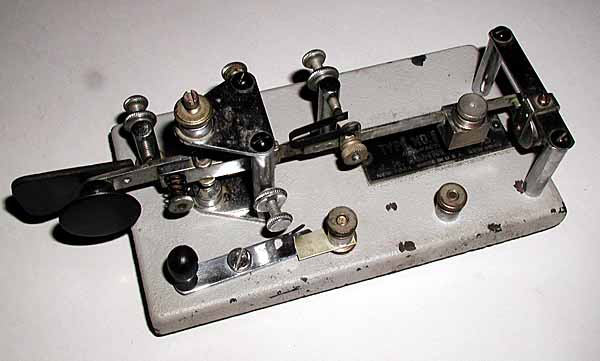
7166a Another view of the Bunnell Flash Key:(30KB)
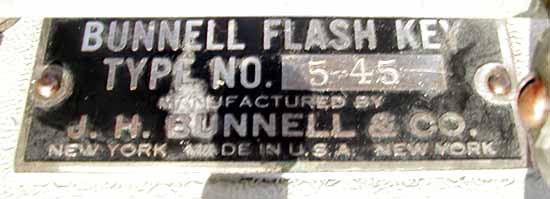
7166b A close-up of the label of the Bunnell
Flash Key:(20KB)
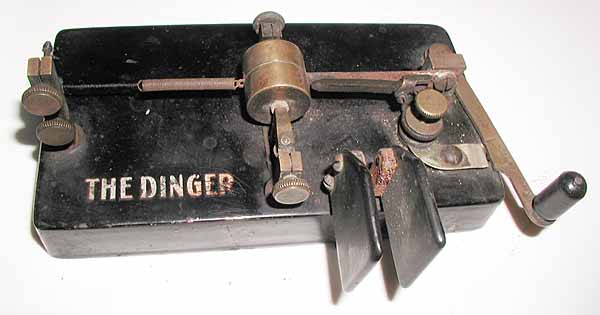
7170 D & K DINGER RIGHT-ANGLE BUG:(24KB) This bug has
an amazing action designed to circumvent Martin's patent by producing dots
through 'releasing' tension on a spring rather than creating it. The release
of tension allows the weight to ding back and forth on the spring and string
and it makes a contact every time it moves toward the lever. The mechanism
and operation of this bug is quite interesting and unique. The shorting lever
is stamped: D & K Manufacturing Co. Cleveland, O, and Pat Apr 27, 06.
The D & K Company was owned by Paul Dinger and August Krastin which
explains the unusual name of this bug. The
frame post is stamped pat appl for. It carries serial number 2482 stamped
into a metal plate cast into the underside of the base. This bug is quite
similar to the Mecograph right-angle bugs also made in Cleveland, Ohio.
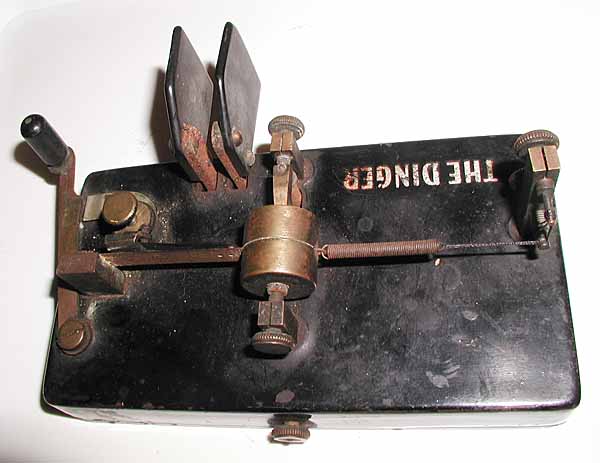
7170a Back view of the Dinger Bug:(33KB)
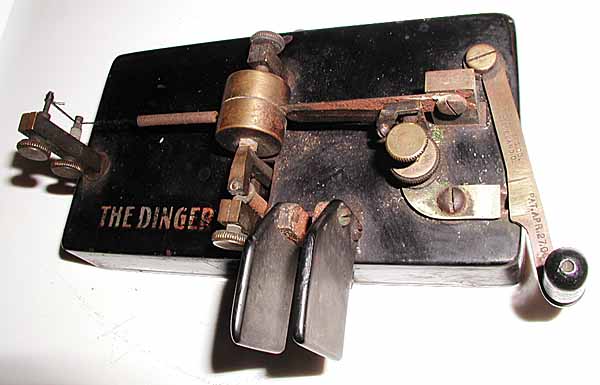
7170b Right side view of the Dinger Bug:(33KB)
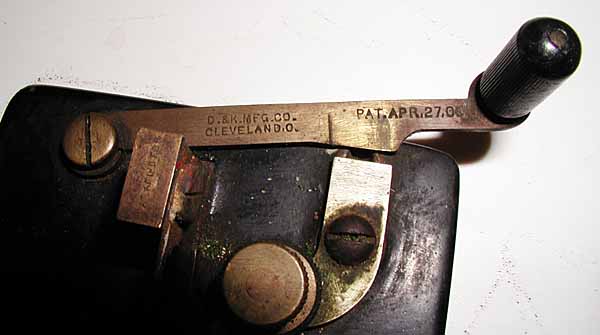
7170c View of shorting lever showing the manufacturer's
name and patent and the patent applied for stamp on the frame:(23KB)
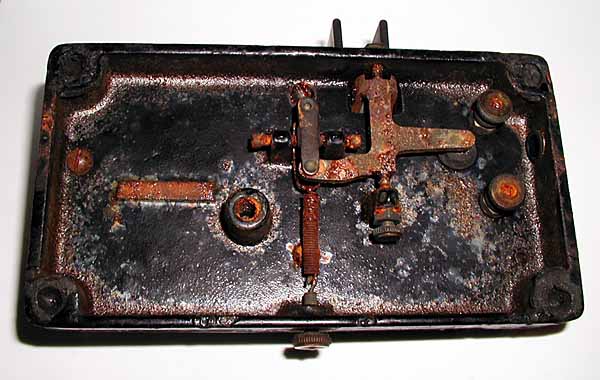
7170d View of underside of the key showing rust from a
damp basement storage area:(48KB)The rusty serial number plate is on the
left.
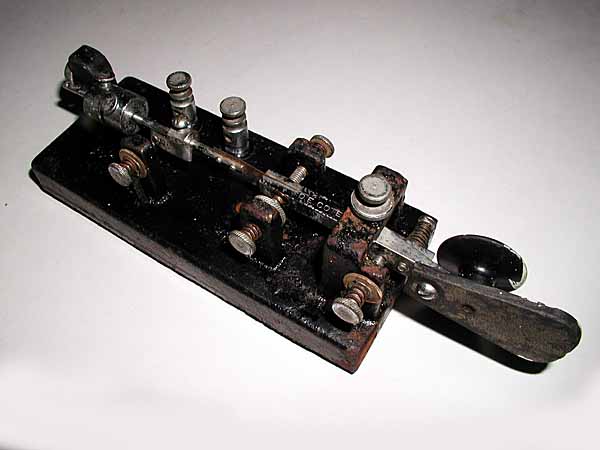
7180 RARE O. E. COTE BUG:(28KB)
This is a very hard-to-find bug made by O. E. COTE.
The name is stamped into the top of the lever as shown below.
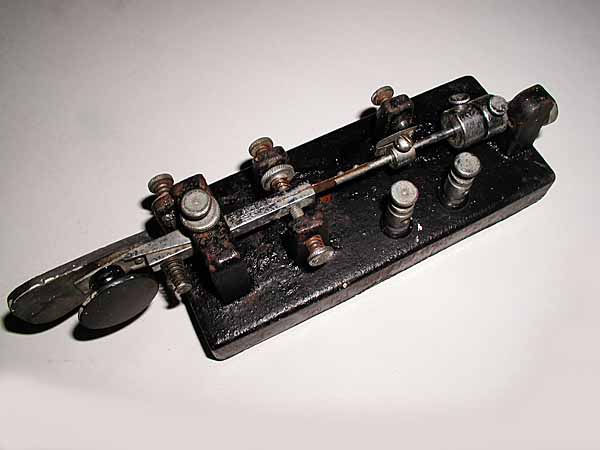
7180a Another view of the COTE bug:(29KB)
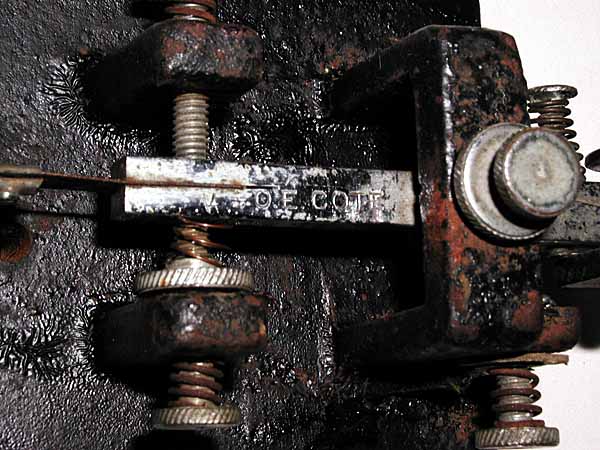
7180b A close-up of the name on top of the
lever:(64KB)
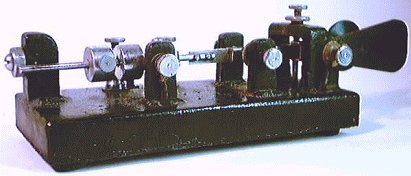
7181 Another RARE O. E. COTE BUG:(19KB)
Similar to above:
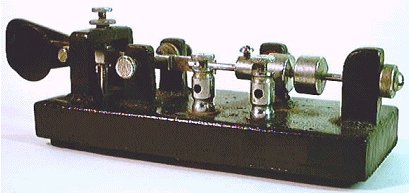
7181a A Right Side view of the Cote Bug:(20KB)
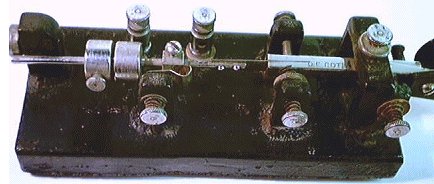
7181b A Top view of the Cote Bug:(23KB)
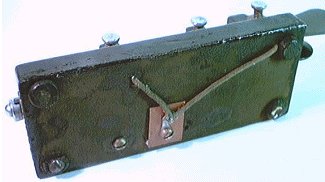
7181c A Bottom view of the Cote Bug:(14KB)
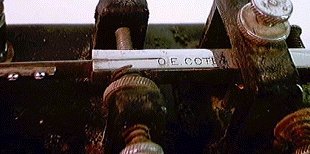
7181d A Closeup view of the name on the
Cote Bug:(15KB)

7185 * VERY RARE COPE BUG:(53KB)
This is a very unusual bug that most collectors have not even heard about. It
is owned by Matt Kurzdorfer who allowed me to display it here.
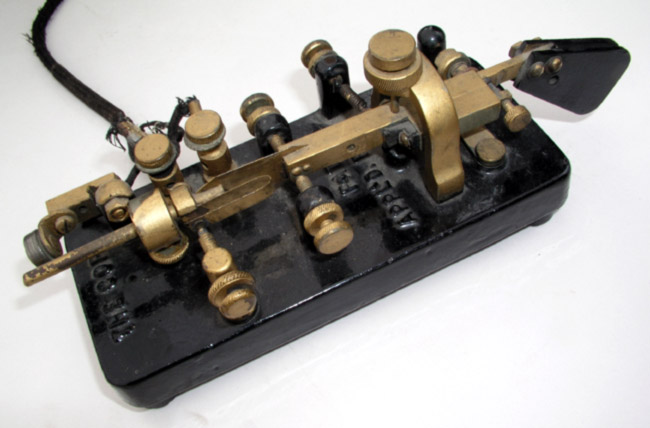
7185a A Right Side view of the Cope Bug:(58KB)
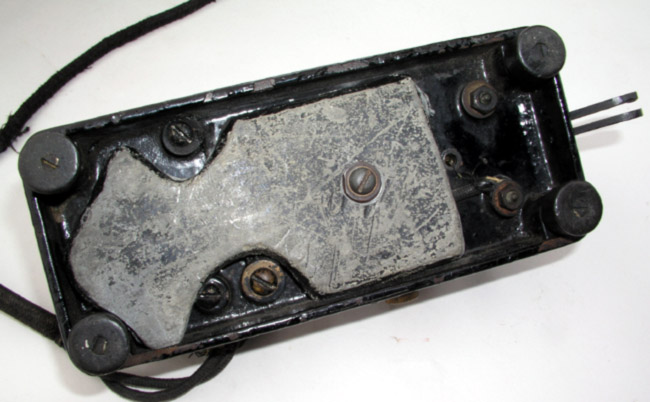
7185b A Bottom view of the Cope Bug:(67KB)
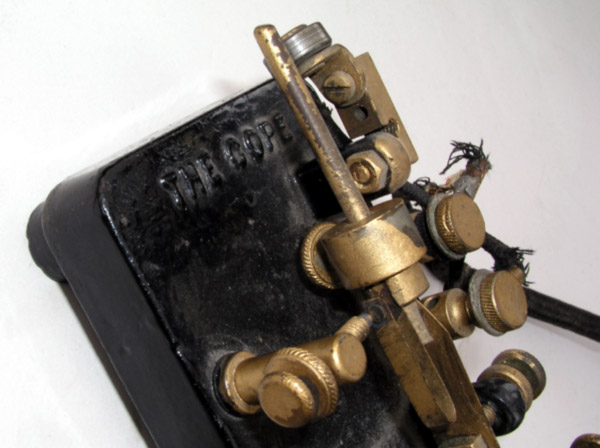
7185c A close view of the manufacturer's name on the Cope
bug:(60KB)
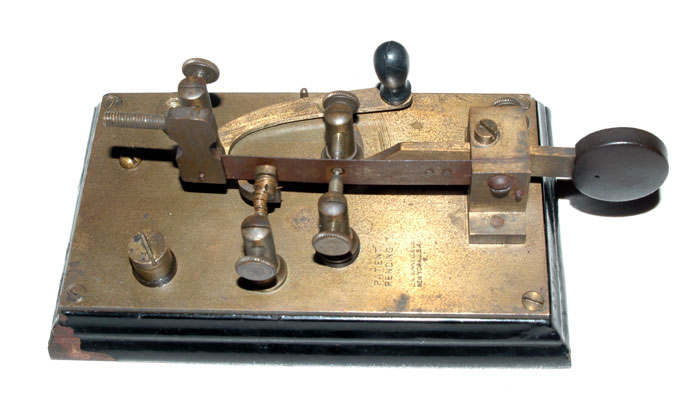
7188a BUNNELL '' ORIGINAL BUG '' number "I":
This is the 'father' of the Bunnell Gold Bug and the rarest of the Bunnell
Bugs. It carries the number "I" scratched into the bottom of the brass
base.
This key was designed to avoid conflict with the Martin patent that covered
semi-automatic keys that TENSIONED a main spring to produce a string of dots.
Several manufacturers including Mecograph and D & K designed keys that
RELEASED tension on a spring to produce a string of dots. This Bunnell bug is
very complex. It also RELEASES the tension on its main spring to produce
dots. The main spring is held against the damper by a long tension releasing
lever that dips down to pass under the dash contact, curls around under the
main spring, and ends in a screw pressing on a coil spring. When the knob is
pressed to the Right, the tension releasing lever moves to the left and
releases the tension in the main spring allowing it to swing to the left and
make a string of dots by bouncing against the dot contact on the left.
When the knob is pressed to the Left, the tension releasing lever moves to
the right and pushes harder against the main spring, bending it just enough to
make contact with the dash contact on the right.
The key has a rather mushy 'feel' due to the 'bending' of the main spring to
make dashes and Bunnell may have abandoned this design after making this first
key. However, since this key was used on a mine railroad in New Hampshire, at
least this one 'Original' model Bunnell key was sold commercially. The base
is stamped J. H. Bunnell & Co. New York, USA and ''patent pending''.
Bunnell appears to have used some features of this 'original' bug in his 'Gold
Bug'. The 'Gold Bug' also has a mushy 'feel'. It was not very popular. The
Bunnell 'Gold Bug' was made after the Martin Patent had expired so it did not
need to RELEASE tension on the main spring. Historian John Casale, W2NI,
discovered that the original patent for this key was issued to John Gehegan.
The patent in the Gil Schlehman, K9WDY Telegraph Patent Collection may be
viewed in a link below:
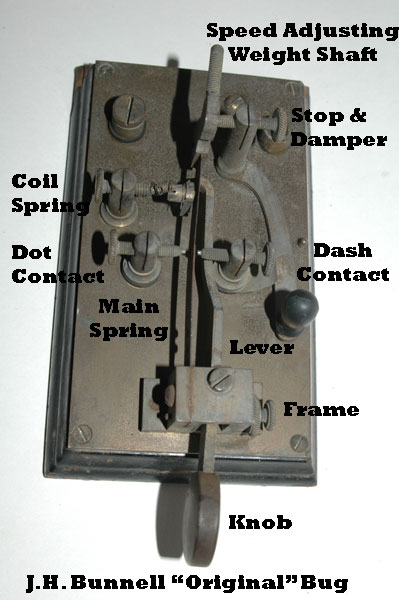
7188blss A top view of the Bunnell 'Original'
bug showing the tension releasing lever and other parts.
(The important parts have been labeled to help explain their function):
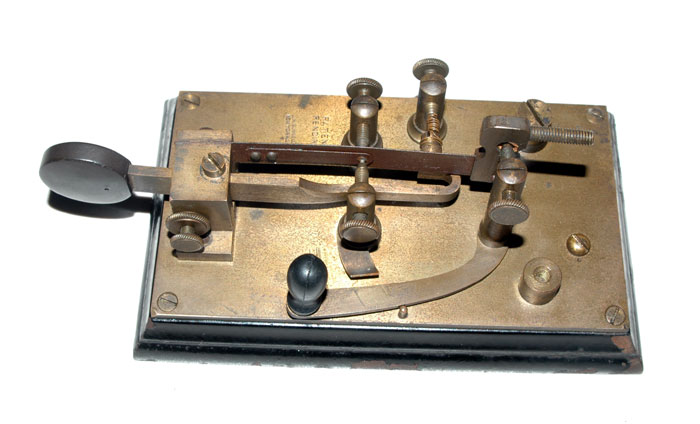
7188c A Right side view of the Bunnell 'Original'
bug showing the tension releasing lever as it passes under the
dash contact:
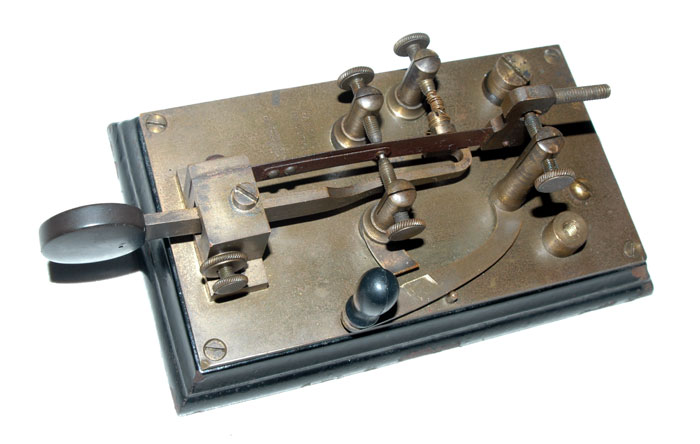
7188d Another Right side view of the Bunnell
'Original' bug:
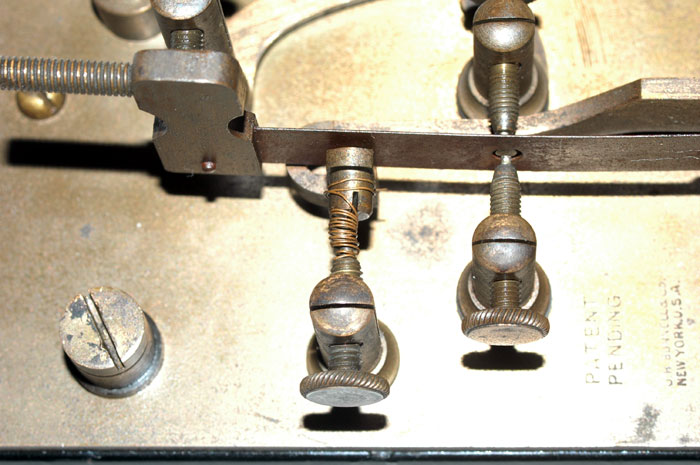
7188e A close view of the dot contact with the bug
in the uncleaned, as-found condition:
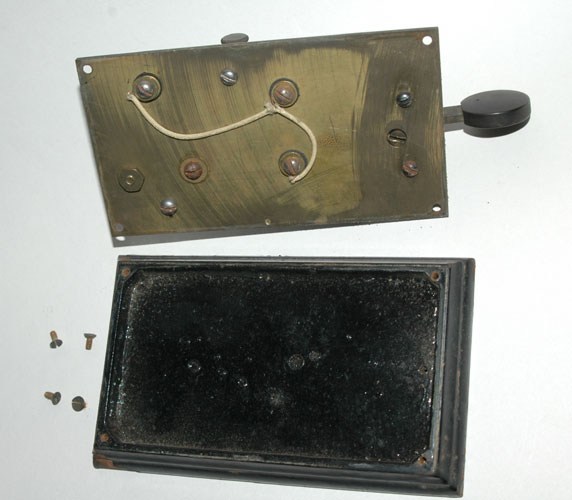
7188f The mechanism of the Bunnell 'Original' bug has
been unscrewed from the heavy cast iron base:
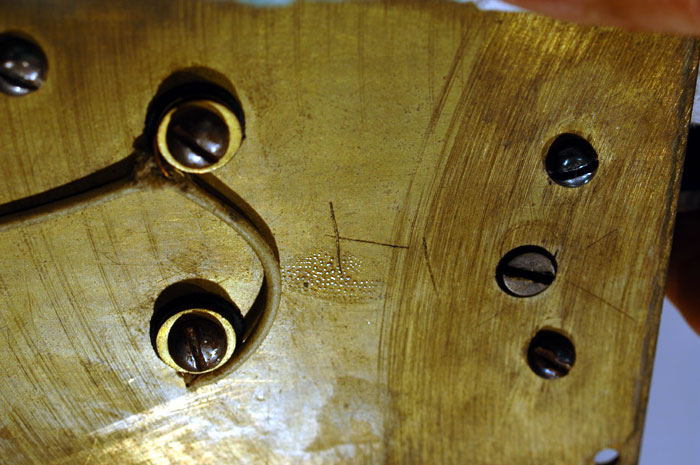
7188g A close view of the base of the Bunnell
'Original' bug showing the number ' I ' scratched into the brass:
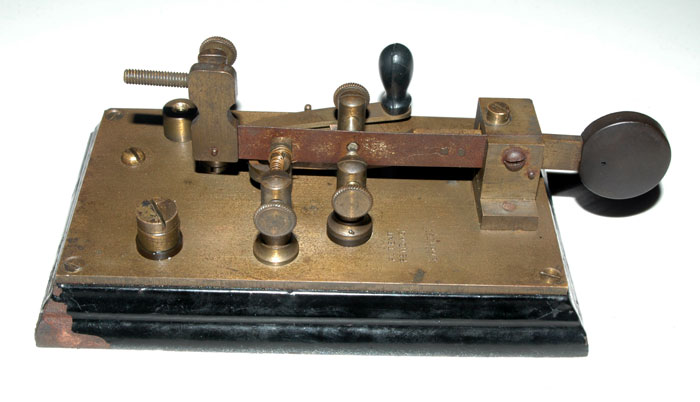
7188i A Left side view of the Bunnell
'Original' bug in uncleaned, as-found condition:
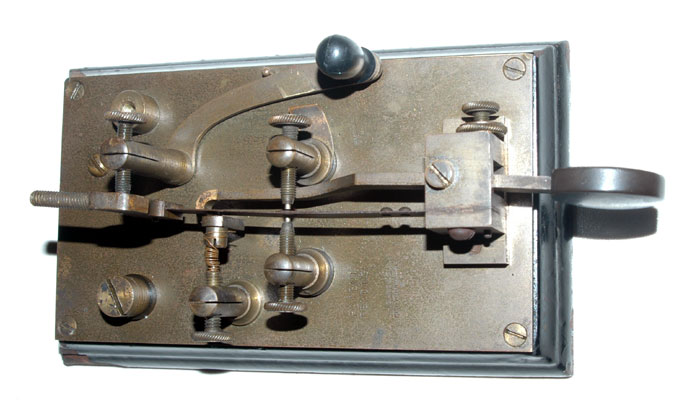
7188j A top view of the Bunnell
'Original' bug in uncleaned, as-found condition:
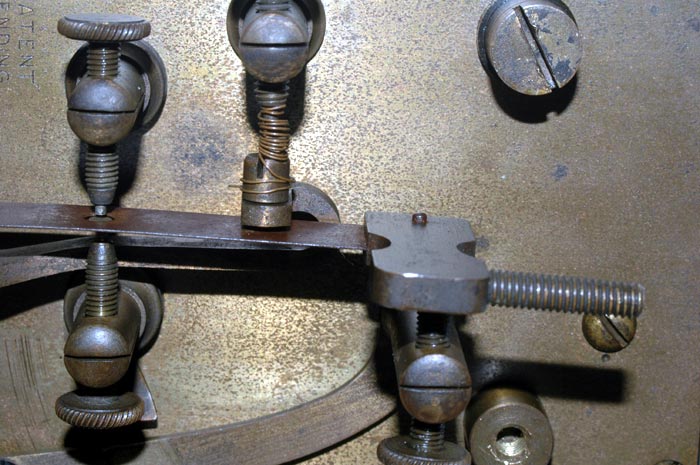
7188k A closer top view of the Bunnell
'Original' bug in uncleaned, as-found condition showing the mechanism:
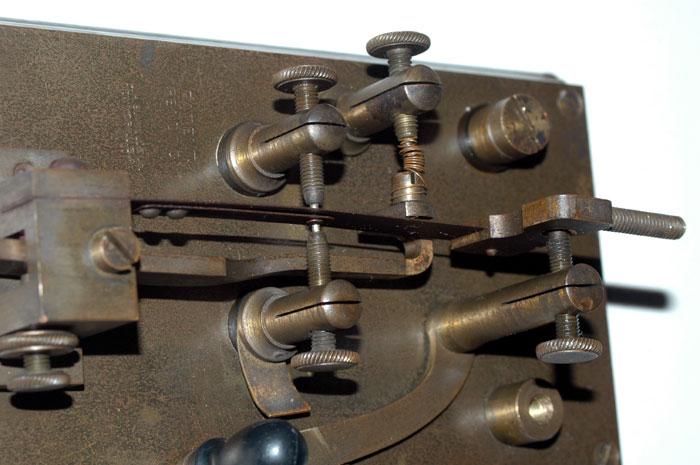
7188n A Right side view of the Bunnell
'Original' bug in uncleaned, as-found condition:
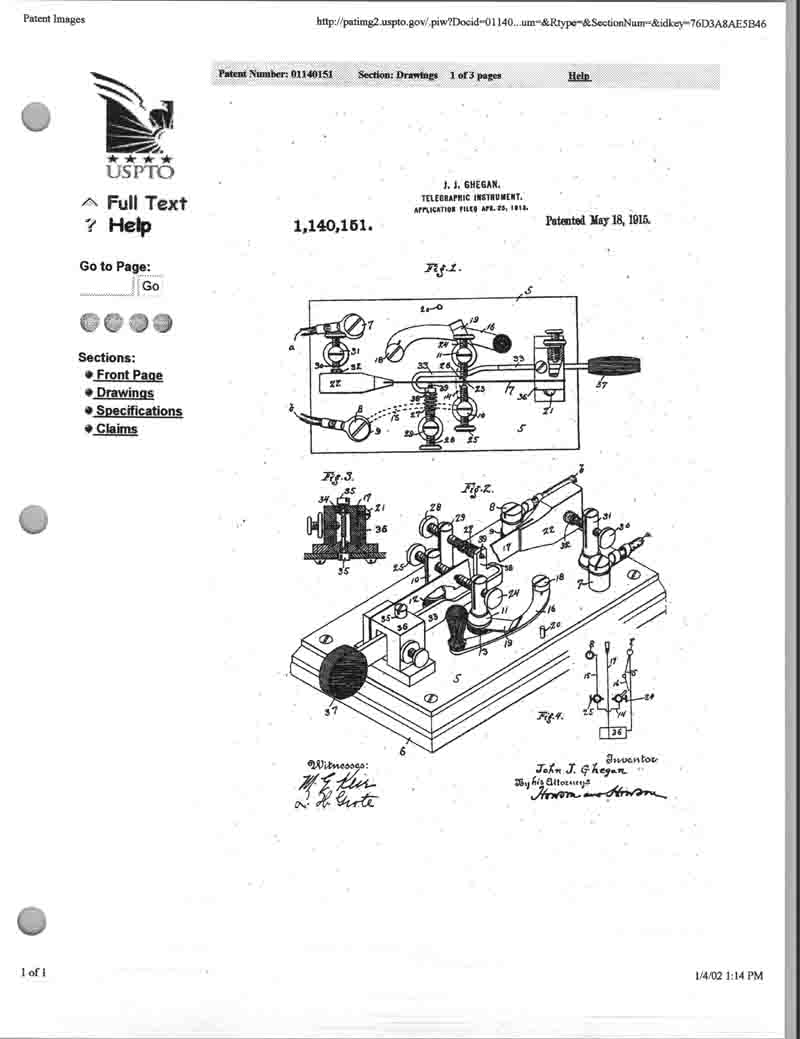
7188p The original John Gehegan patent for the
design of this key:
7190 * BUNNELL "GOLD BUG": Like 7200 but earlier straight paddle. S/N 252.
(Traded).
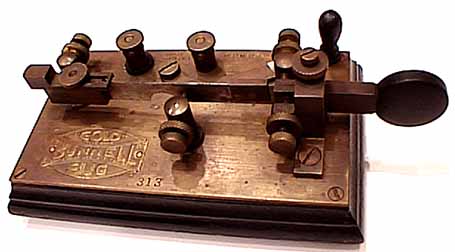
7192 BUNNELL '' GOLD BUG '':(20KB)
Similar to 7190 with serial number 313. The base is stamped
''patented'' and ''patent pending''.
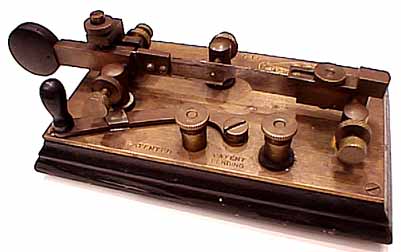
7192a Another view of the Gold Bug:(19KB)
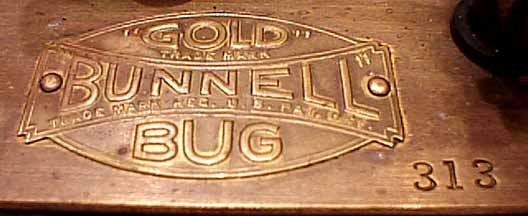
7192b A close view of the label:(21KB)

7192c A close view of the patent label:(15KB)
7195 * BUNNELL "GOLD BUG": Similar to 7190. S/N 473.(Traded to K5VT).
7196 * BUNNELL "GOLD BUG": Similar to 7190. S/N 619.
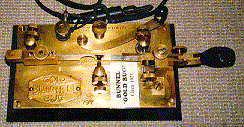
7200 BUNNELL "GOLD BUG": (21KB)
The famous Jesse Bunnell "Gold Bug" manufactured around 1920. This
unusual example has a pivoted paddle which can be swiveled up and
down. Its a rare transition model between straight paddle & paddle
with thumb knob.#797.
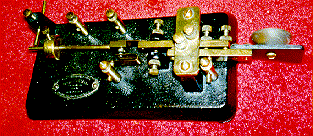
7220 FIRST MODEL ''GO-DEVIL'' BUG:(25KB)
The key which was manufactured in the basement of A. H. Emery.
Label on cast black wrinkle finished base reads:The Transmitting
GO-DEVIL, Pat. applied for. Mfg by A.H.Emery. 263 Mill St. Poughkeepsie,
N.Y.
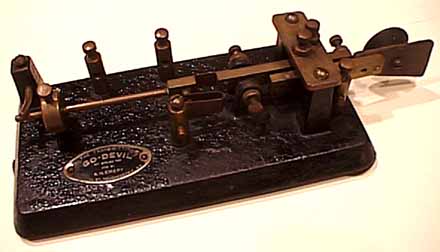
7220a Another view of the ''GO-DEVIL'':(18KB)
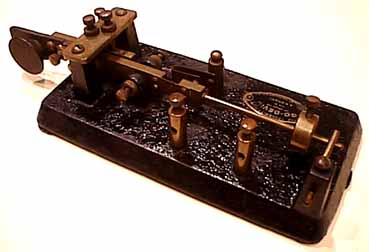
7220b Another view of the ''GO-DEVIL'':(17KB)

7225 NEW MODEL ''GO-DEVIL'' BUG:(25KB)
The key which was manufactured in the basement of A. H. Emery.
in Poughkeepsie, New York. The label on the black base reads:
GO-DEVIL, Box 1364, Poughkeepsie, N.Y.
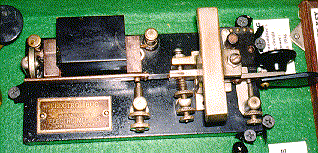
7240 ELECTRO BUG: (35KB)
This unusual key has a large magnetic coil which was powered by
electricity from the transmitter keying circuit. Label reads
"ELECTRO-BUG. Patents pending. Manufactured by ELECTRO MFG. CO.
San Francisco, Calif." Due to the "T" design this key can be
turned on its side and used as a straight key.
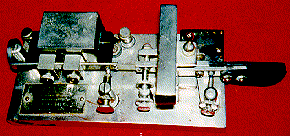
7244 * ELECTRO BUG-DELUXE MODEL:(19KB)
As above. All Nickel plated. Number 10205 under base. > K5VT.
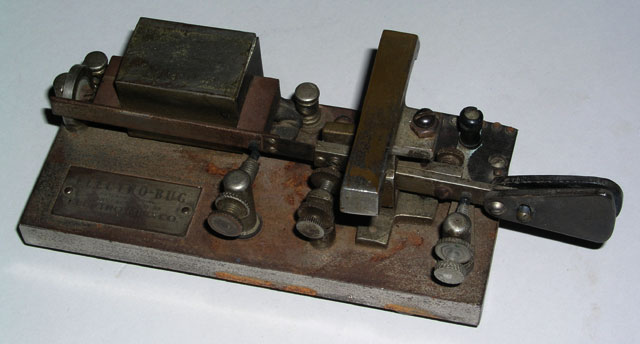
7245 ELECTRO BUG-DELUXE MODEL:(26KB)
Nickel plated and very similar to the above but much more heavily used.
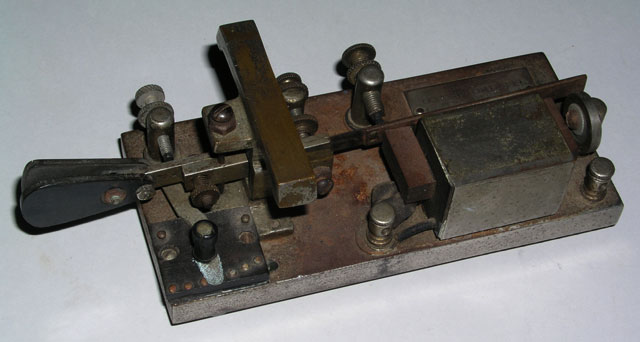
7245a Right Side View of the ELECTRO BUG-DELUXE
MODEL:(36KB)
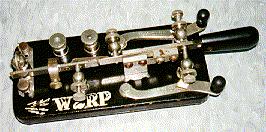
7265 ** SEMATIC BUG:(15KB)
The Sematic bug could be used as a sideswiper by appropriately
setting the dual shorting levers. (This key is in the
Pete Malvasi - W2PM collection.

7270 REL RADIO ELECTRONICS LABORATORIES BUG:(65KB)
This is a bug that I have never seen or heard of before. It is a fairly small
bug with the base measuring 6 x 3 inches but the multi-tapered paddle adds to
the overall length. It has an unusually large and heavy damper wheel and an
unusual holdback bar/damper for the dot contact spring. The maker, Radio
Electronics Laboratories, was established in Long Island, New York in the
1930s. They made and sold a wide variety of radio transmitting and receiving
parts. The company continued well into the 1960s. The bug was probably made
in the 1940s. Here are some additional photographs of this bug:
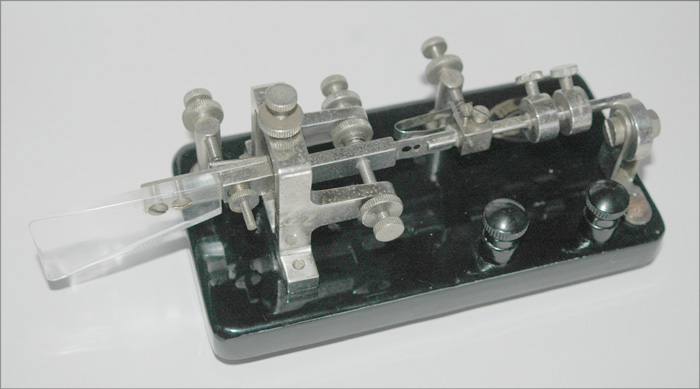
7270a A right side view of the REL Bug:(62KB)
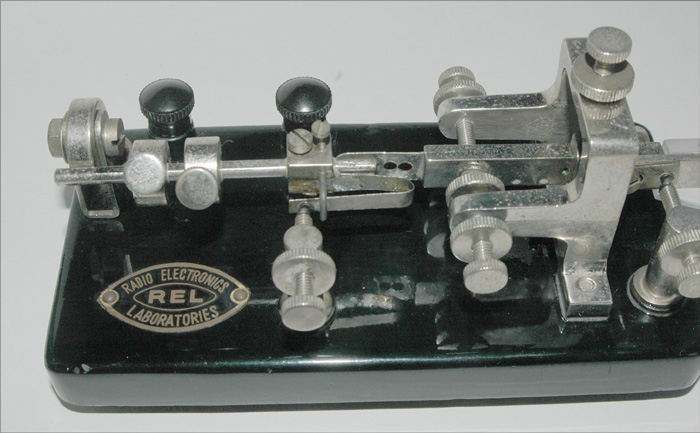
7270b A closer view of the label and the
mechanism:(97KB)
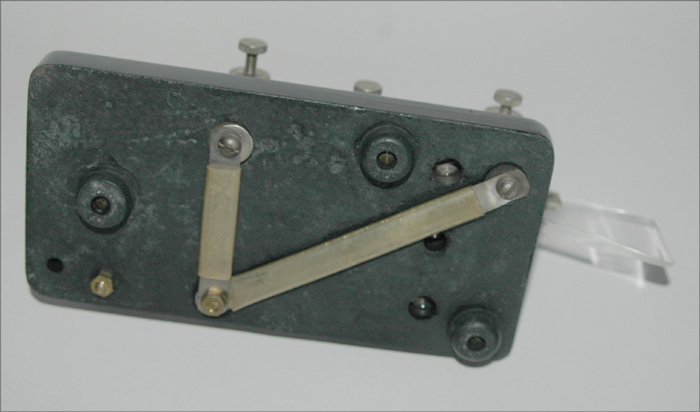
7270c The underside of the base of the REL
Bug:(58KB)
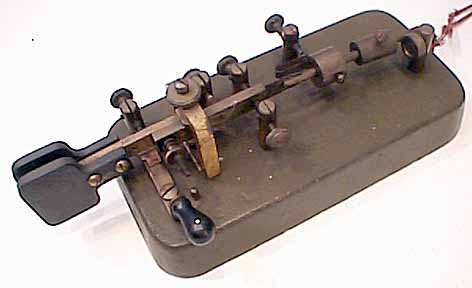
7280 POSTAL TELEGRAPH BUG:(17KB)
These heavy-based Postal bugs are very hard to find since most of them were
destroyed by the company.
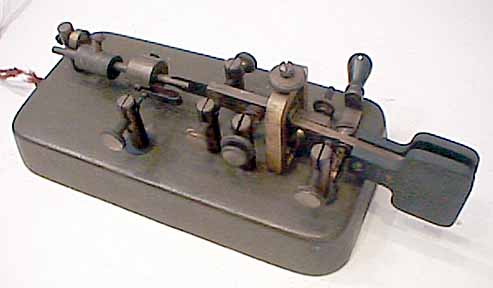
7280a Another view of the POSTAL TELEGRAPH
BUG:(17KB)
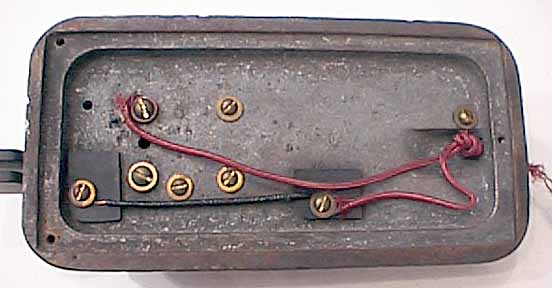
7280b A view of the very heavy base of the
POSTAL TELEGRAPH BUG:(25KB) (to Tony Rogozinski, June 2000)
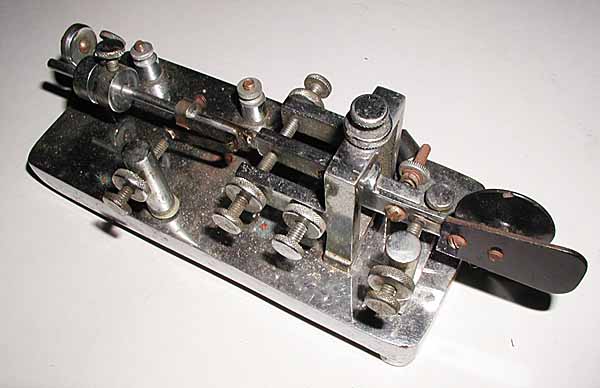
7310 EARLY SPEED-X:(34KB)
This all plated key with nicely cast 2-1/2"wide base is just a
bit larger than "Blue Racer".
It was early version of the Speed-X bug.
7312 * EARLY SPEED-X: Same as above. (Traded to W9AC).
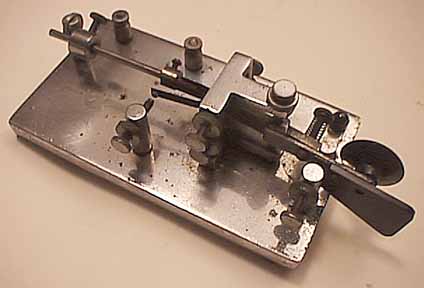
7314 * EARLY SPEED-X BUG:(18KB)
Similar to above but with 3-1/2'' wide base.
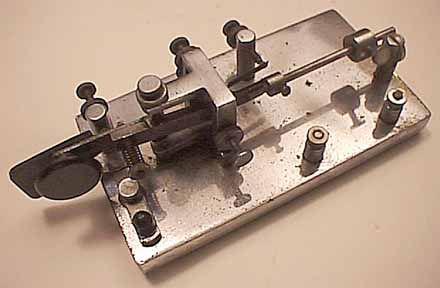
7314a Another view of the EARLY SPEED-X:(19KB)
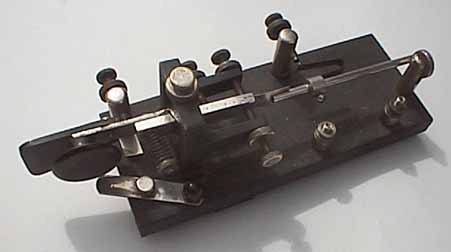
7318 * EARLY SPEED-X WITH UNUSUAL NARROW BLACK BASE:(13KB)
This was the precursor of the narrow base Speed-X model 510.
These early Speed-X keys did not have any labels.
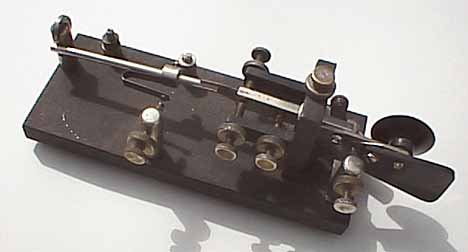
7318a Another view of the early black Speed-X:(14KB)
7320 * EARLY BROWN SPEED-X BUG: Similar to 7310 but ALL BROWN wrinkle finish.
Traded to ->K9WDY.
7325 * SPEED-X MODEL 501 ''LES LOGAN'' BUG: Like 7330 but all chrome plated.
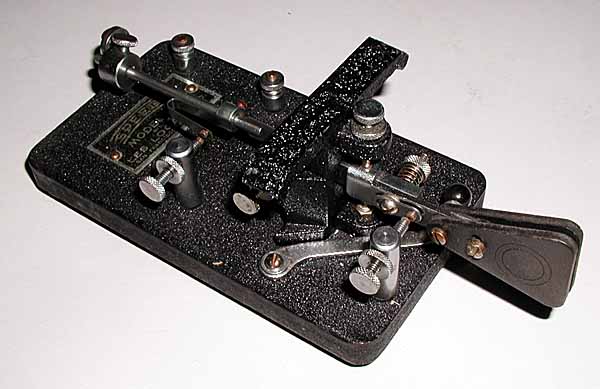
7330 SPEED-X MODEL 500 ''LES LOGAN'' BUG:(40KB)
Black wrinkle finished base and frame with chrome plated parts.
Labeled "SPEED-X" Model 500. Mfd by Les Logan Co.
San Francisco, Calif, USA.
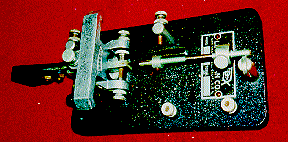
7335 * SPEED-X MODEL 500 BUG:(17KB)
Similar to above with chrome-plated "T" and label reads: "SPEED-X"
Model 500.Mfd by Les Logan Co.San Francisco,Calif,USA. MODEL 500,
SERIAL(Blank).
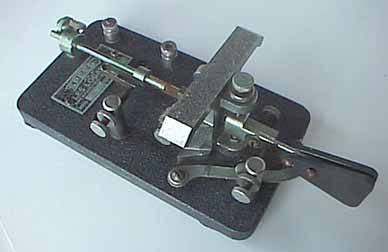
7335a Another view of the SPEED-X MODEL 500 BUG:(14KB)
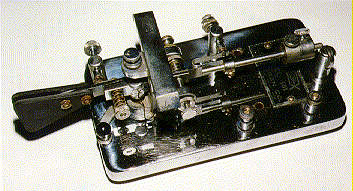
7337 * SPEED-X MODEL 501 ''LES LOGAN'' BUG:(35KB)
All chrome plated bug similar in design to the model 500.
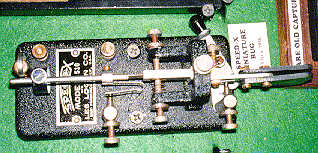
7340 SPEED-X MODEL 510 ''LES LOGAN'' BUG: (36KB)
This unusual very small bug is chrome plated on a black wrinkle
finished base and has a label which reads: SPEED-X Model 510, Mfg
by Les Logan Co. San Francisco, Calif. U.S.A.
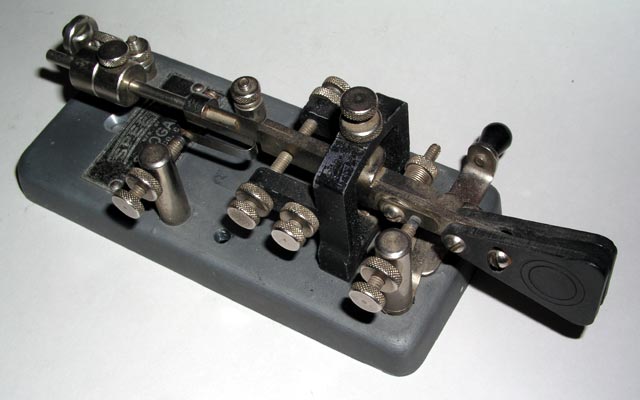
7343 UNUSUAL SPEED-X MODEL 510 ''LES LOGAN''
BUG: This is an unusual early version of the
Model 510 pocket-size bug. It carries an ''x'' serial number.
The base is gray but the frame is black. Both of these factors
suggest that it is an early experimental pre-production model.
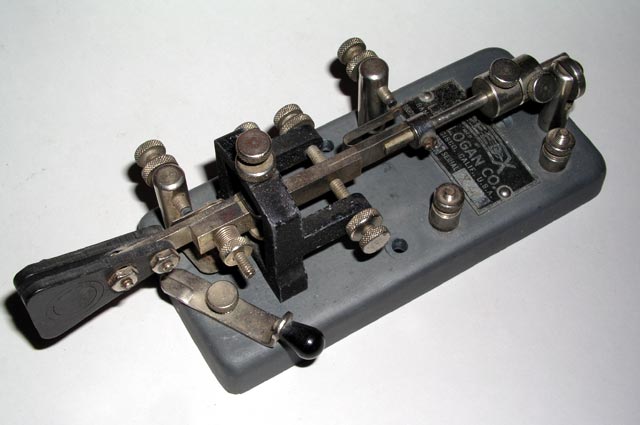
7343a Another view of the Model 510:(22KB)
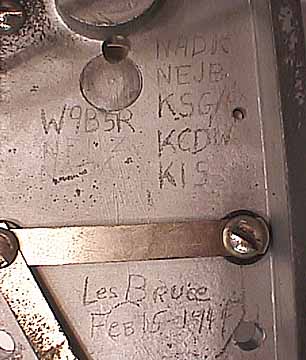
7343b A view of the writing under the base of the
model 510 key:(27KB) The call letters scratched into the base
of the key identify the stations where it was used in the 1940's.
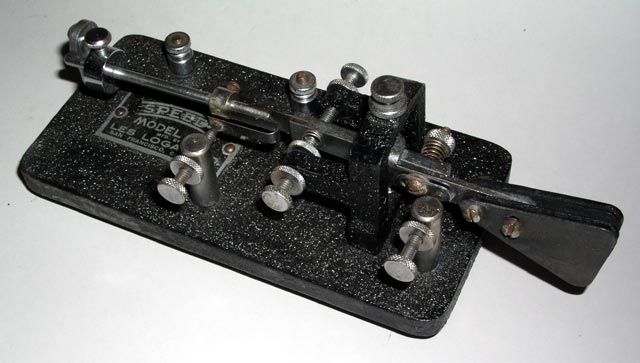
7350 SPEED-X MODEL 515 ''LES LOGAN'' BUG:
This nice bug is chrome plated on a black wrinkle finished base
and has a label which reads: SPEED-X Model 515, Mfg by Les Logan Co.
San Francisco, Calif. U.S.A.
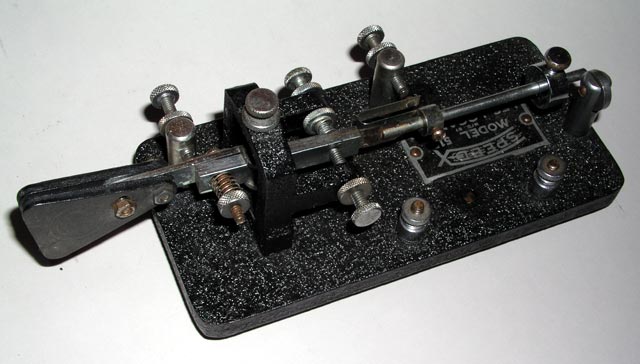
7350a Another view of the SPEED-X MODEL 515
''LES LOGAN'' BUG:
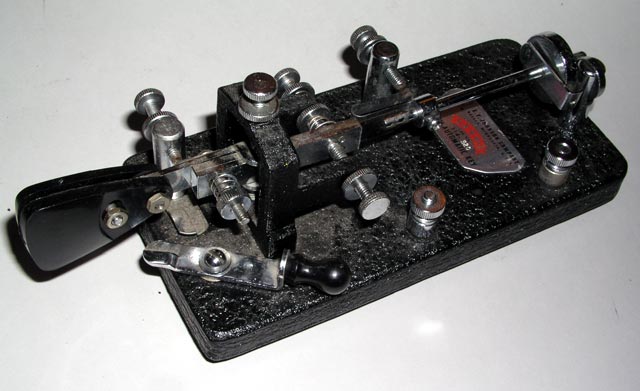
7370 * E.F. JOHNSON SPEED-X BUG:
This is a Speed-X bug like those shown above but carrying the E.F. Johnson
label.
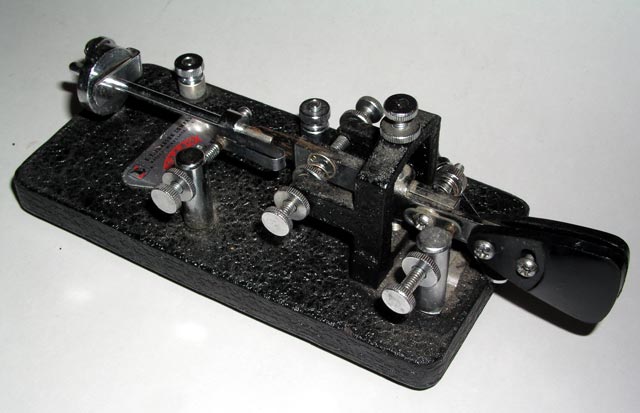
7370a * Another view of the Johnson/Speed-X bug:
7420 * UNKNOWN ALL BRASS BUG. Similar to the Xograph and the Vibroplex
Original. This key was used in the Baltimore & Ohio Railroad Office from
1915-1951. (Traded out)
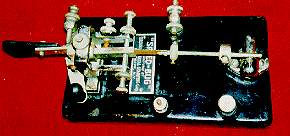
7440 * ''SPEED BUG'':(15KB)
Mfgd by Brooklyn Metal Stamping Corp, Brooklyn, New York. Similar to
Vibroplex Original but vertical dot spring & unusual ball damper.
->K5VT.
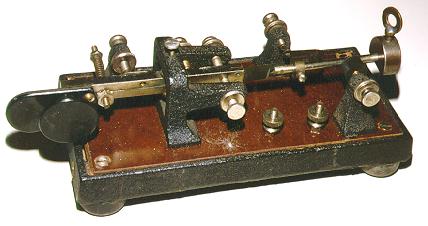
7460 KENCO BUG:(19KB)
This unusual bug was made by the Kenmore Co. of Boston and sold
by Radio Shack in the 1930's. It has a nifty split lever mechanism.
The lower half of the lever swings to left for dashes while the upper
half remains in position. It is mounted in/on an unusual cast base.
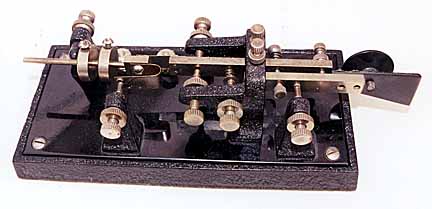
7462 * KENCO BUG:(19KB)
A collector was kind enough to allow me to photograph this key
at the 2000 Dayton hamfest. Unfortunately, in the confusion of
the hamfest, I did not make note of the collector's name and
hopefully he will remind me so I can credit him as the
owner of this key. It is a variation on the number
7460 Kenco bug shown above. Instead of a split-lever, it has
two levers.
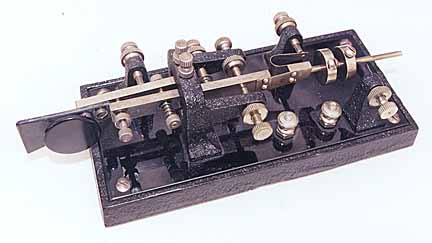
7462a * another view of the KENCO BUG:(19KB)
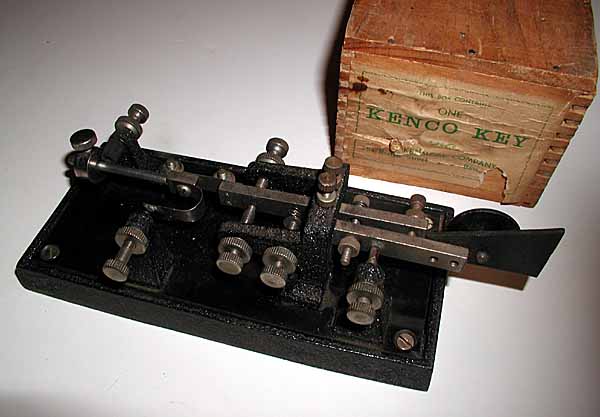
7463 KENCO 2-LEVER BUG IN ORIGINAL BOX:(32KB)
It is unusual to be able to find one of these relatively rare
Kenco bugs in the original box. This is the same model as
that shown above.
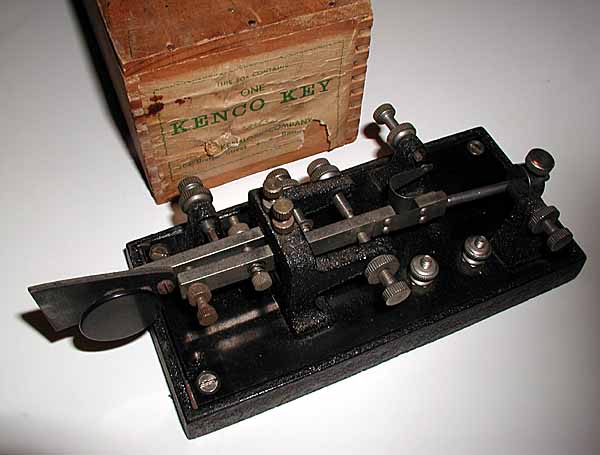
7463a A Right Side View of the KENCO BUG &
Box:(26KB)
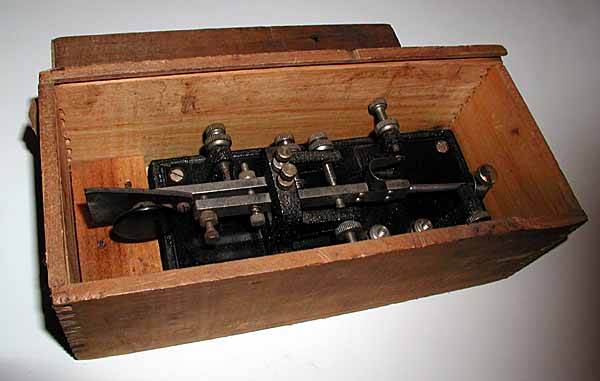
7463b A Right Side View of the KENCO BUG in the
Box:(28KB)
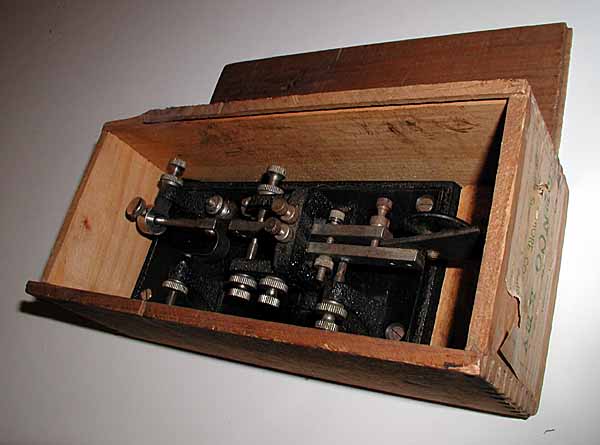
7463c A Left Side View of the KENCO BUG in the
box:(31KB)
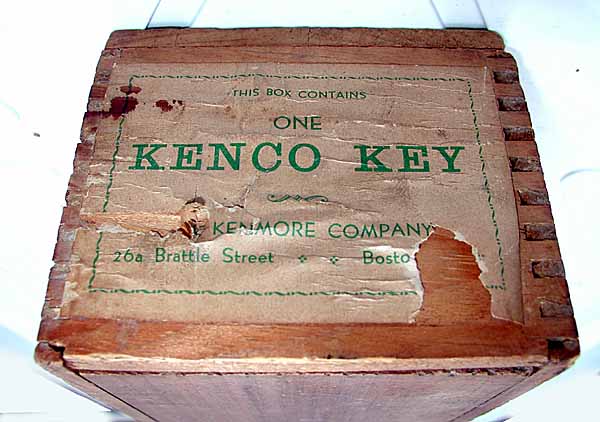
7463d A View of the Label on the Kenco Bug
Box:(44KB)
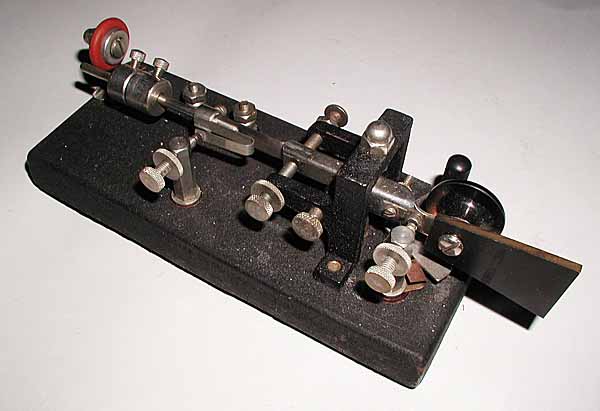
7480 ELECTRIC SPECIALTY CO. 'KIT' BUG
('THE CEDAR RAPIDS BUG'):(30KB)
This is the only bug which was manufactured in kit form. Its base
is stamped on the bottom: Electric Specialty Manufacturing Co.
Cedar Rapids, Iowa. It is sometimes also referred-to as the
"Cedar Rapids Bug". The company has been sold several times and
still exists in 1998.
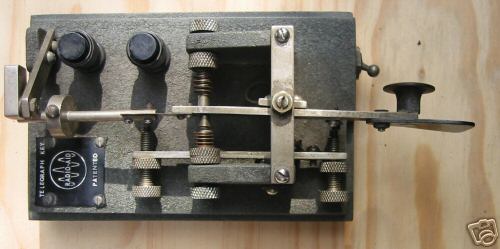
7500 RARE "RADIO-AID" BUG:
This is an exceptionally rare bug that was found in England in 2007. The
label reads: TELEGRAPH KEY / RADIO-AID / PATENTED. The hardware and wiring
suggest that it was made somewhere between 1940 and 1960.
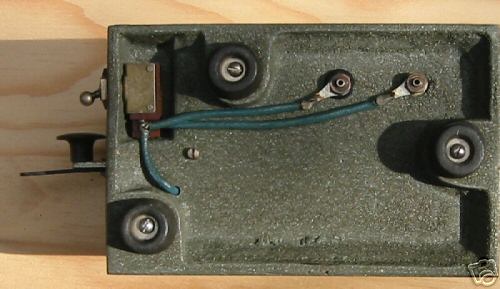
7500a Bottom View of the RADIO-AID Bug:
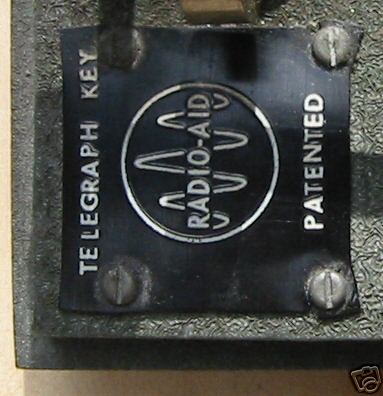
7500b Close view of the label on the
RADIO-AID Bug:
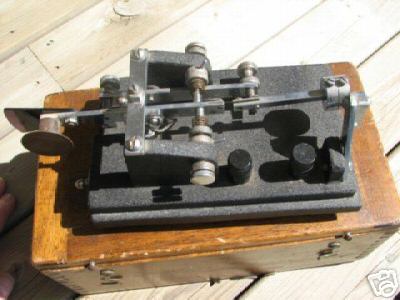
7511 RARE "RADIO-AID" BUG:
This is another exceptionally rare bug. The original drawing of the bug is
shown and it appears to indicate that the bug was made in 1946.
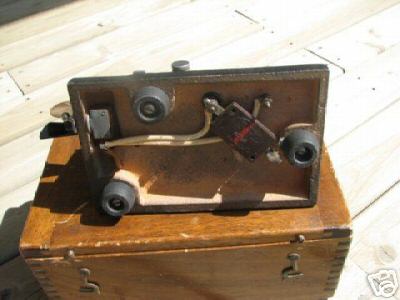
7511b Bottom View of the RADIO-AID Bug:
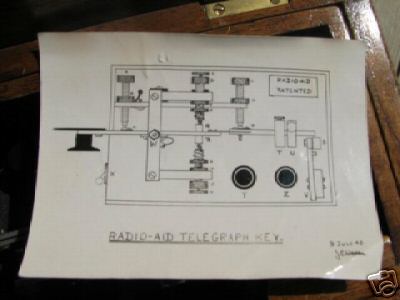
7511c The original engineering drawing of the Radio Aid
Bug:
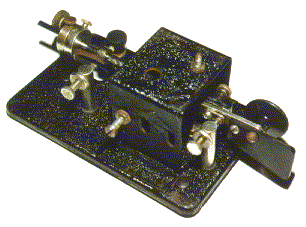
7600 * RARE McELROY ''JUNIOR'' BUG:(27KB)
The '' McElroy Junior '' is a simple key made of stamped metal parts but it
is an exceptionally rare key since so few were made. ->Traded.
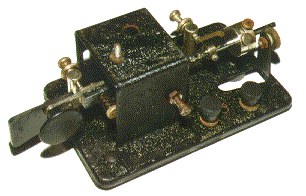
7600a This is a right-side view:(19KB)
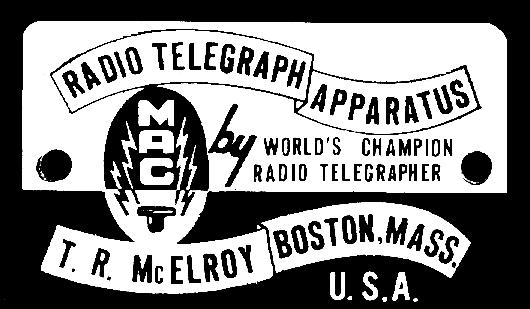
7605 GENERIC McELROY LABEL SUITABLE FOR
REPRODUCTION:(41KB)
This label is the one used on the later McElroy bugs.
I am providing it in three formats. All are suitable
for downloading, printing, and mounting on the bug. Since
the labels were originally made by printing in black on an
aluminum rectangle, you may want to print them on transparent
plastic and then lay that over a piece of aluminum. The exact
outside dimensions of the label are: 1-inch high by 1.75-inches
wide.
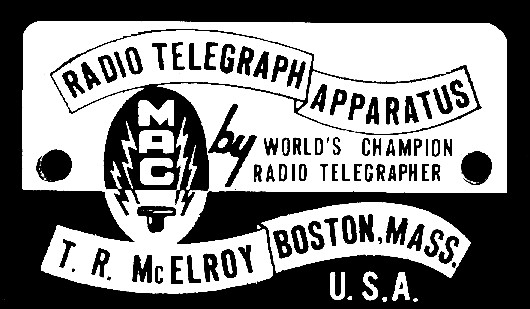
7605.gif This is a 300 dpi .GIF format
image:(79KB)
7605.pcx This is a 300 dpi .PCX format
image:(194KB)
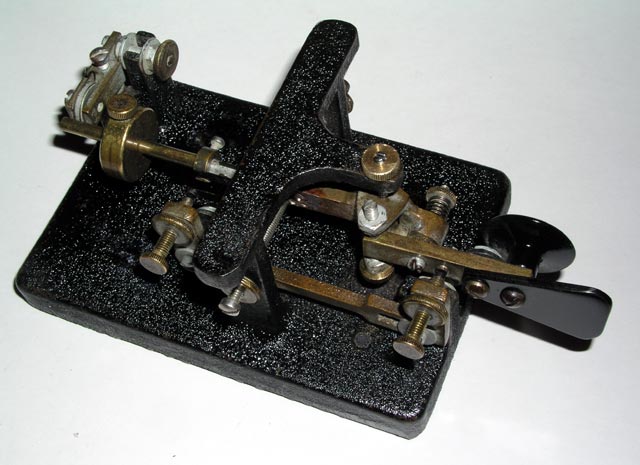
7610 McELROY MODEL 1936B BUG:
This chrome plated key mechanism with black wrinkle-finished
cast base was manufactured by Ted McElroy around 1936. Base
engraved with usual Worlds' Greatest Telegrapher logo. No label.
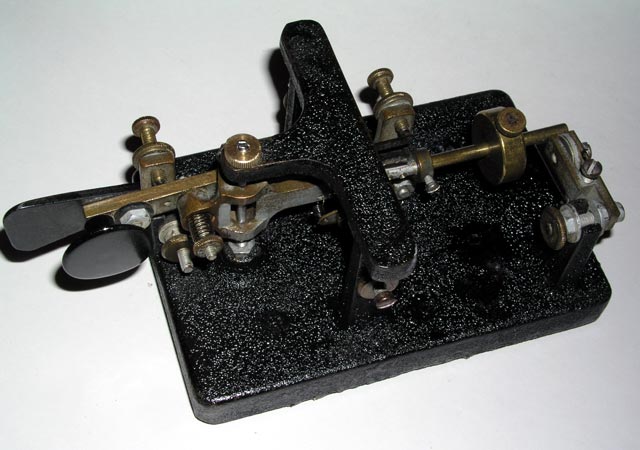
7610a Right side view of the McELROY
BUG:
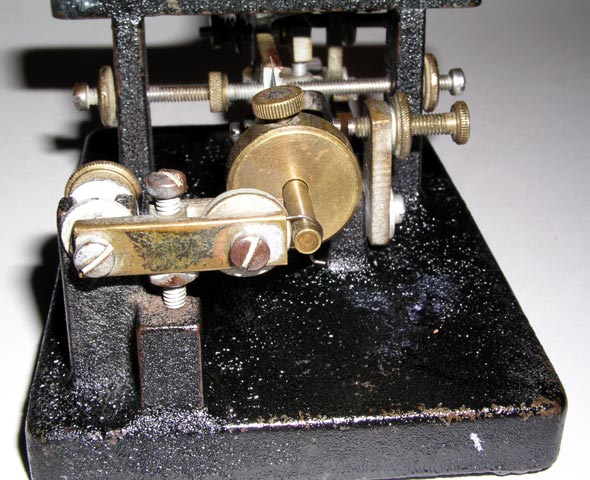
7610b The damper mechanism on the McELROY
BUG:
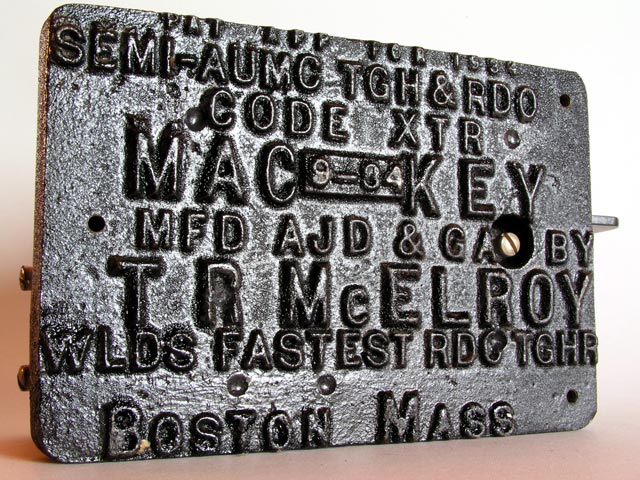
7610c The writing on the base of the
McELROY BUG:
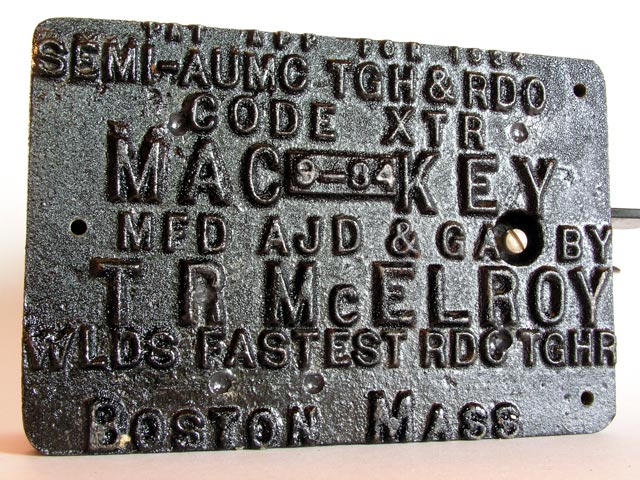
7610d Another view of the writing on the
base of the McELROY BUG:
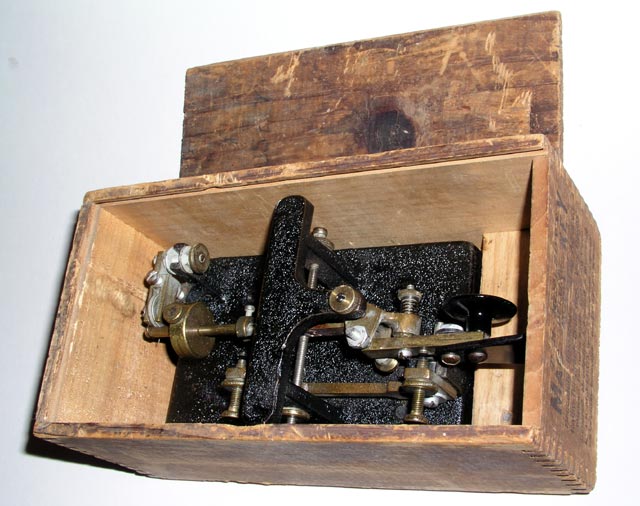
7610e The McELROY BUG in its original
box:
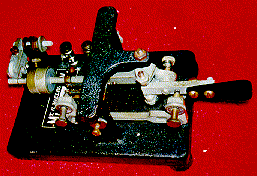
7620 * McELROY MODEL 1936B BUG:(16KB)
This chrome plated key mechanism with black wrinkle-finished
cast base was manufactured by Ted McElroy around 1936. Base
engraved with usual Worlds' Greatest Telegrapher logo. No label.(Traded).
7624 * McELROY MODEL 1936 BUG: Similar to 7620 but with a
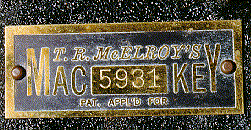
7624 Brass name plate. Number 5931.(26KB)
7625 * McELROY MODEL 1936B BUG: Like 7624. S/N 6534.
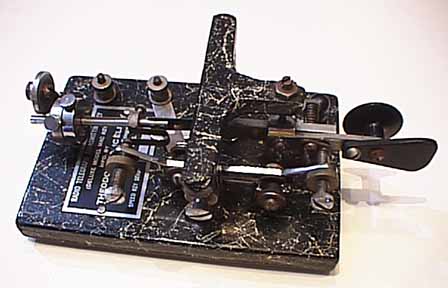
7627 * McELROY MODEL 1938 DELUXE
MARBELITE FINISH BUG:(23KB)
This is the lovely 1938 Deluxe buy manufactured by Ted
McElroy. It has the Marbelite finish and is considered to
be one of the nicest looking bugs ever made. The serial number is 2124.
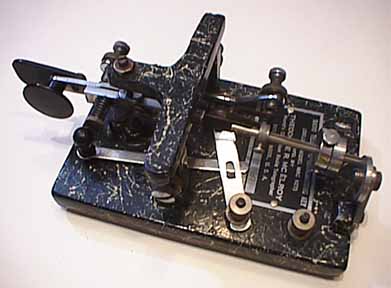
7627a Another view of the McElroy
1938 Deluxe Bug:(20KB)
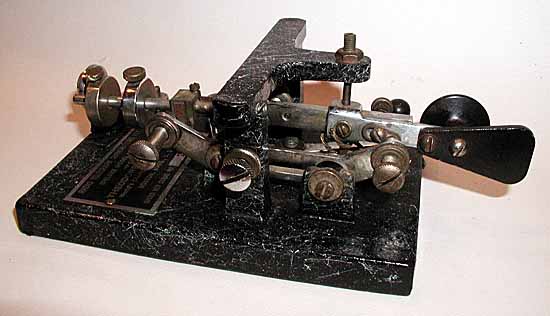
7628 McELROY MODEL 1938 DELUXE
MARBELITE FINISH BUG:(29KB)
This key is similar to number 7627 but it carries serial number 731.
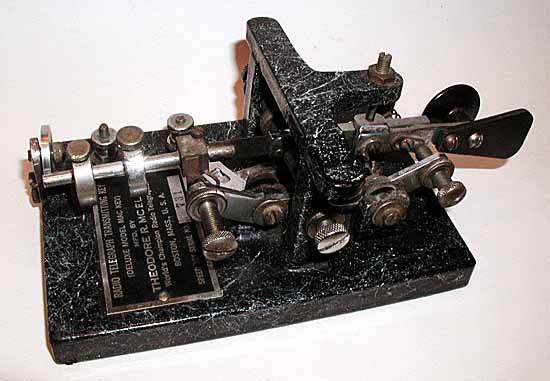
7628a Another view of the McElroy
1938 Deluxe Bug:(38KB)
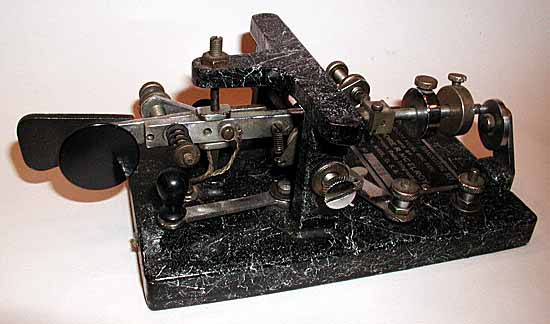
7628b Another view of the McElroy
1938 Deluxe Bug:(33KB)
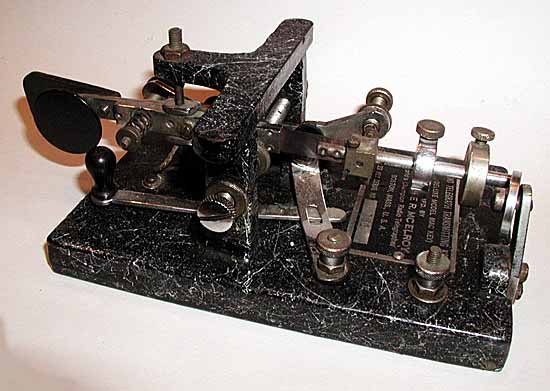
7628c Another view of the McElroy
1938 Deluxe Bug:(41KB)
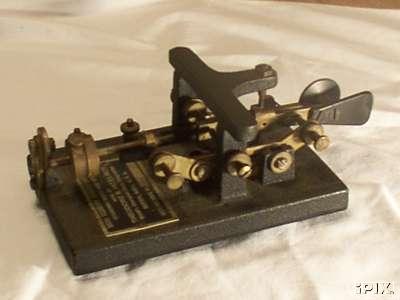
7629 ** McELROY STANDARD MODEL 1938B:(17KB)
Black wrinkle finish base with no writing on bottom. Label reads:
Radio Telegraph Transmitting Key (Standard Model Mac Key) Theodore
R. McElroy. World's Champion Radio Telegrapher. Boston, Mass, USA.
Speed Key. (Photo used with the permission of the owner.)
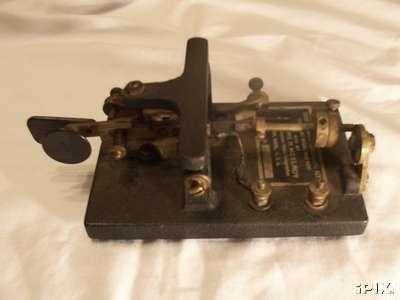
7629a ** Right Side View of the
McELROY STANDARD MODEL 1938B:(17KB)
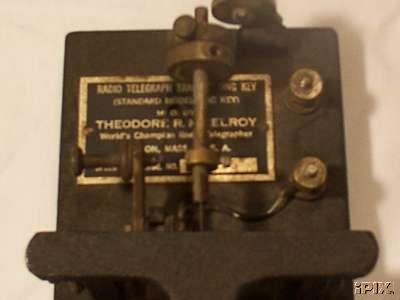
7629b ** Top View of the
McELROY STANDARD MODEL 1938B:(17KB)
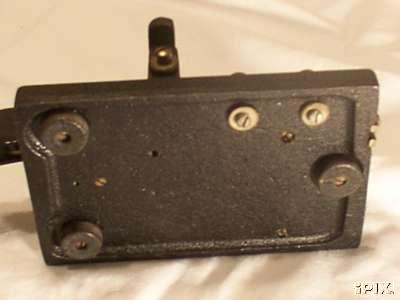
7629c ** Bottom view of the
McELROY STANDARD MODEL 1938B:(17KB)
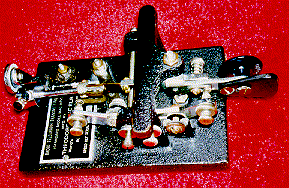
7630 * McELROY STANDARD MODEL 1938B:(26KB)
Black wrinkle finish base with no writing on bottom. Label reads:
Radio Telegraph Transmitting Key (Standard Model Mac Key) Theodore
R. McElroy. World's Champion Radio Telegrapher. Boston, Mass, USA.
Speed key serial number 6045. (Traded to John Casale - W2NI.)
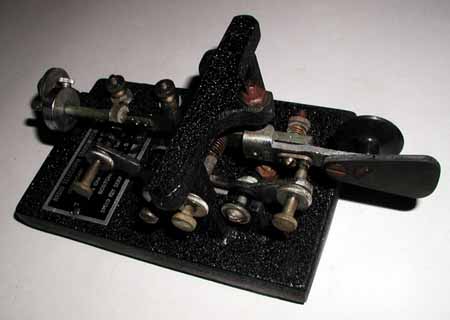
7631 McELROY STANDARD MODEL 1939:(18KB)
Black wrinkle finish base with no writing on bottom. Label reads:
Radio Telegraph Transmitting Key (Standard Model Mac Key) Theodore
R. McElroy. World's Champion Radio Telegrapher. Boston, Mass, USA.
Speed key serial number 6538.
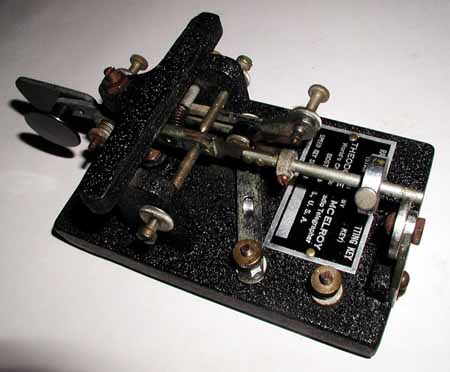
7631a McELROY STANDARD MODEL 1939:(27KB)
7632 * McELROY STANDARD MODEL 1939: As above. Serial number 6618.
7638 * McELROY DELUXE MODEL 1939 BUG: This is the deluxe model with
the marbelite painted casting.
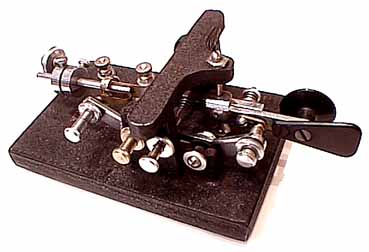
7640 * McELROY STANDARD MODEL 500 BUG WITH
ORIGINAL BOX:(18KB)
This chrome plated key mechanism with black wrinkle finished cast
base was manufactured by Ted McElroy around 1940. The key can
be turned on its side and used as a straight key.
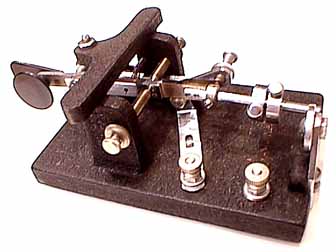
7640a Another view of the
McELROY STANDARD MODEL 500 BUG:(17KB)
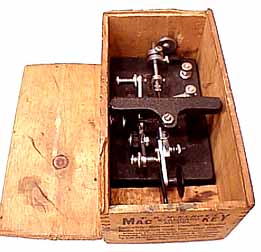
7640a A view of the McELROY STANDARD
MODEL 500 BUG in its original box:(18KB)

7640a A view of the label on the end
of the Model 500 box:(23KB)
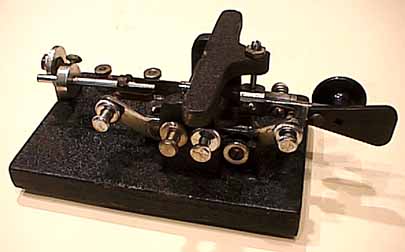
7642 * McELROY STANDARD MODEL 500 BUG:(17KB)
Similar to number 7640 above.
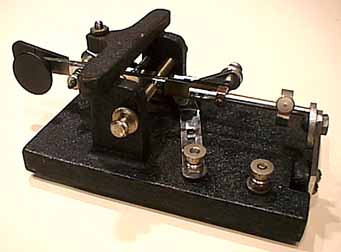
7642a Another view of the McELROY
STANDARD MODEL 500 BUG:(16KB)
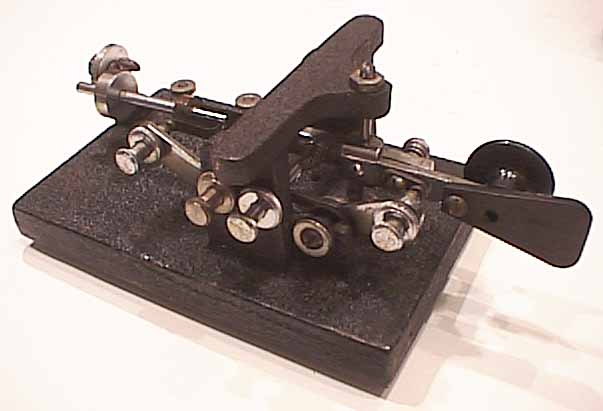
7644 * McELROY STANDARD MODEL 500 BUG:(24KB)
Similar to number 7640 above.
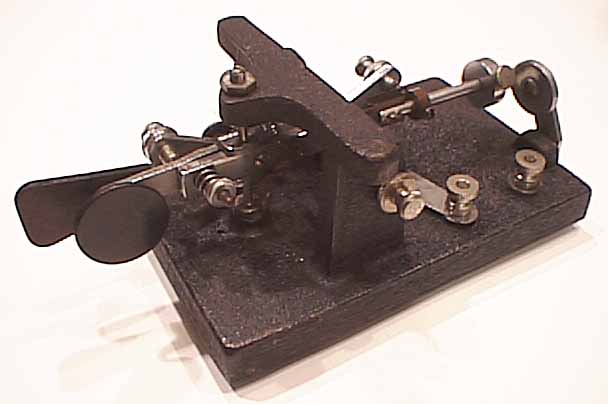
7644a Another view of the McELROY
STANDARD MODEL 500 BUG:(23KB)
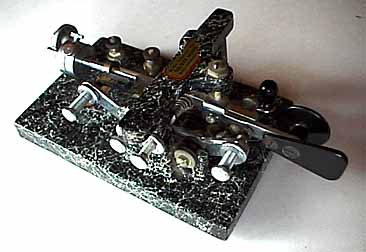
7650 * McELROY DELUXE MARBELITE FINISH MODEL 600 BUG IN
ORIGINAL BOX:(17KB)
The Marbelite finish defines this as the Deluxe version of the model
500 bug. It was manufactured in 1940 and has the original box.
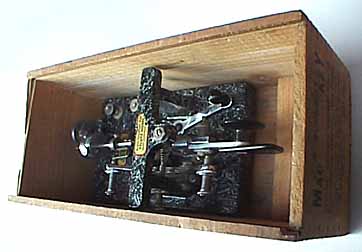
7650a Another view of the Deluxe Model 600 in its
box:(17KB)
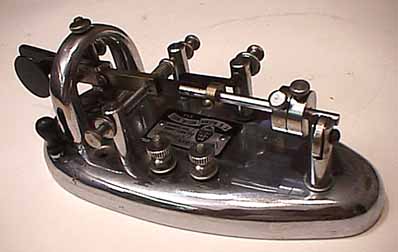
7680 McELROY MODEL S600 SUPER STREAM-SPEED BUG:(18KB)
This is the beautiful S600 Super Stream-Speed Bug. It is a completely
chrome plated key with the famous tear drop base.
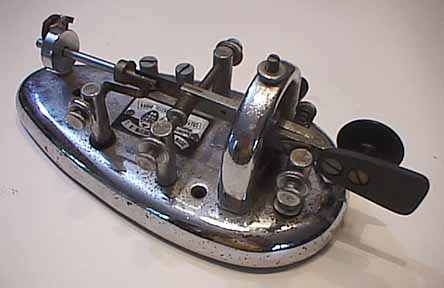
7680a Another view of the Model 600 bug:(19KB)
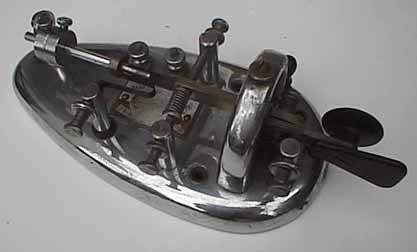
7681 McELROY MODEL S600 SUPER STREAM-SPEED BUG:(13KB)
This is the beautiful S600 Super Stream-Speed Bug. It is a completely
chrome plated key with the famous tear drop base. The label on this
example shows a lot of wear from too much polishing.
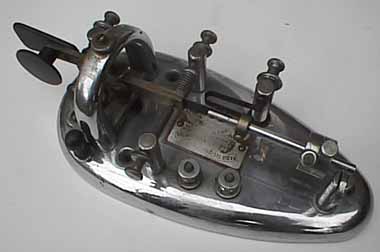
7681a Another view of the Model 600 bug:(14KB)
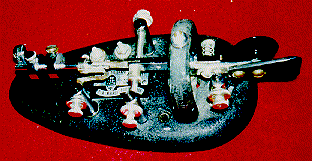
7682 * McELROY STANDARD MODEL S600 SUPER STREAM SPEED KEY:(18KB)
Unusual BLACK WRINKLE FINISH base version. The only one known to exist.
(Traded to K5VT).
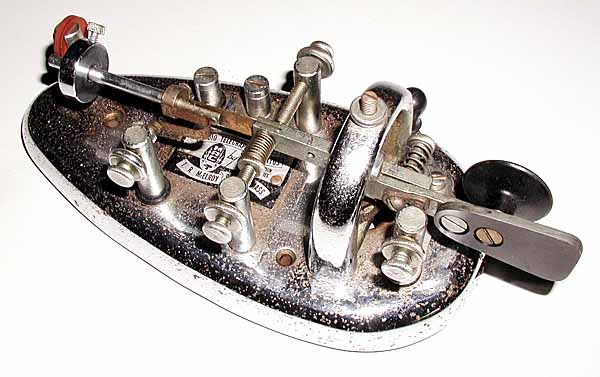
7683 McELROY MODEL S600 SUPER STREAM-SPEED BUG:(45KB)
This is another example of the beautiful S600 Super Stream-Speed Bug.
It is a completely chrome plated key with the famous tear drop base.
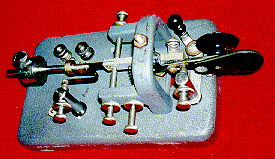
7720 * McELROY MODEL P-500 BUG:(21KB)
Chrome plated key mechanism with an unusual grey wrinkle finished
base. Label missing. Circa 1941.
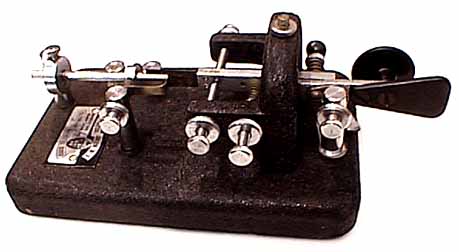
7722 * McELROY STANDARD MODEL P-500 BUG
IN ORIGINAL BOX:(19KB)
As above with black wrinkle-finished base and original box.
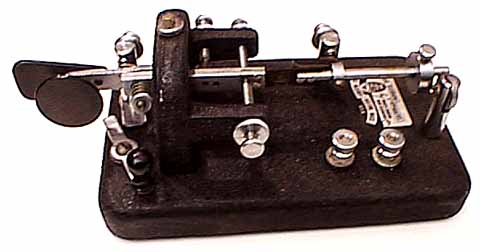
7722a Another view of the
McELROY STANDARD MODEL P-500 BUG:(19KB)
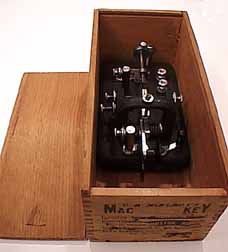
7722b Another view of the
McELROY STANDARD MODEL P-500 BUG in its box:(12KB)
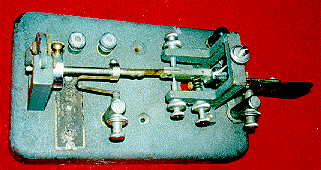
7740 * McELROY MODEL CP-500 BUG:(28KB)
Chrome plated key mechanism that is an EXACT copy of Vibroplex
original. Frame & damper mechanism & base are all
grey wrinkle finish. Bottom of base stamped CP-500. The label
reads:Telegraph Apparatus Co. Not Inc. Chicago, Ill. (This was
one of Ted McElroy's companies)
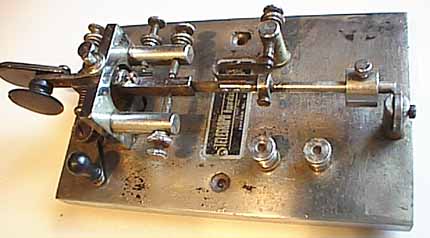
7750 * TELEGRAPH APPARATUS CO. BUG:(27KB)
This key was manufactured by one of Ted McElroy's companies.
It is a chrome plated key with chrome plated, square cornered
rectangular base. There is an unique round hole in frame for the
lever. Label reads: TELEGRAPH APPARATUS CO. NOT INC. CHICAGO,ILL.USA.
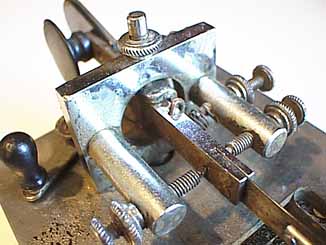
7750a CLOSE-UP VIEW OF THE HOLE IN THE
FRAME:(22KB)
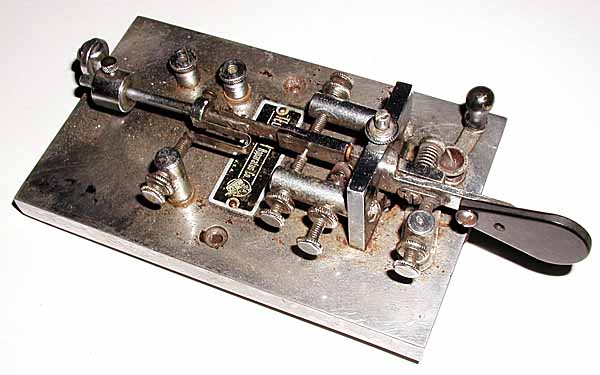
7751 TELEGRAPH APPARATUS CO. BUG:(38KB)
7752 * TELEGRAPH APPARATUS CO. BUG: Same as above.
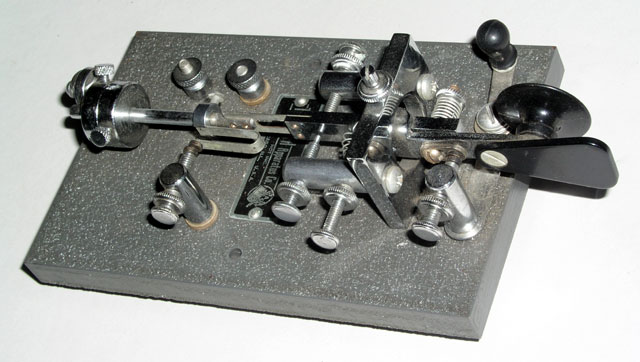
7754 GRAY BASED TELEGRAPH APPARATUS CO. BUG:(27KB)
This is an unusual variation on the classic McElroy manufactured Telegraph
Apparatus Company 'Hole in the wall' Bug. The nickname comes from the
round hole in the frame. It is unusual to find this key with a gray base.
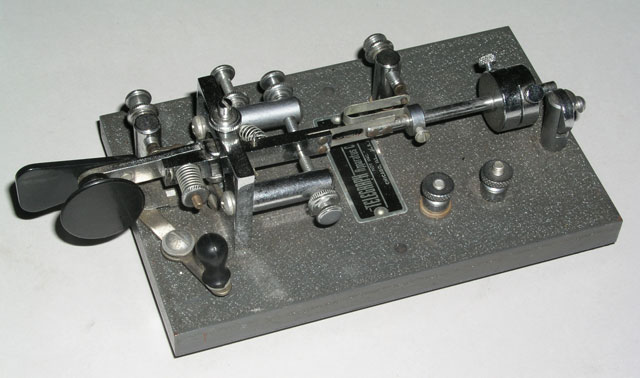
7754a Right Side view of the
GRAY BASED TELEGRAPH APPARATUS CO. BUG:(27KB)
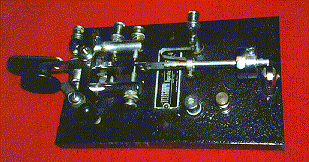
7760 * TELEGRAPH APPARATUS CO. BUG:(25KB)
Same as above with black wrinkle-finish base.
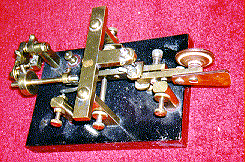
7795 * HAND-MADE MODEL OF McElroy MODEL 500 KEY:(30KB)
All brass hardware on a black base. May have been a prototype for
the final design.
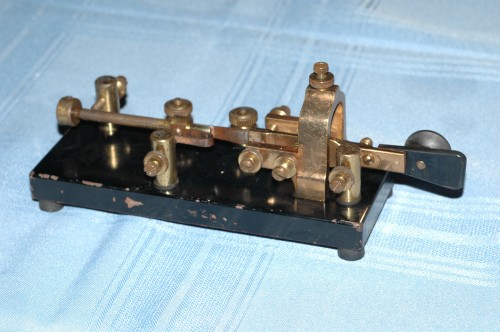
7805a EXTREMELY RARE BRIDGEPORT BUG:
This is a very nicely made bug that carries the name: BRIDGEPORT BUG stamped
on the vibrating lever. The bug is exceptionally heavy, nicely made, and
most of the original plating is intact. It shows some similarities to bug
7808 which is known to have come from England. We are looking for more
information about this bug.
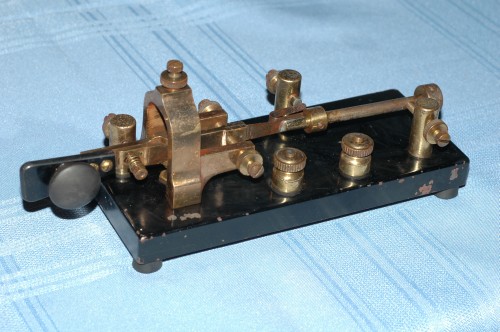
7805b A Right Side view of the Bridgeport Bug:
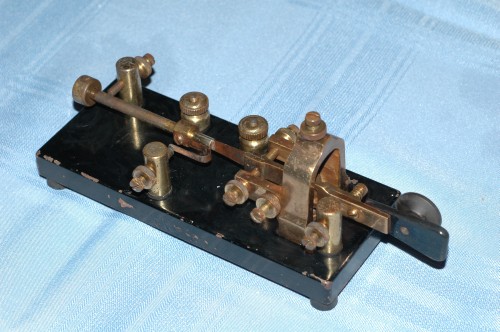
7805c Another Left Side view of the Bridgeport Bug:
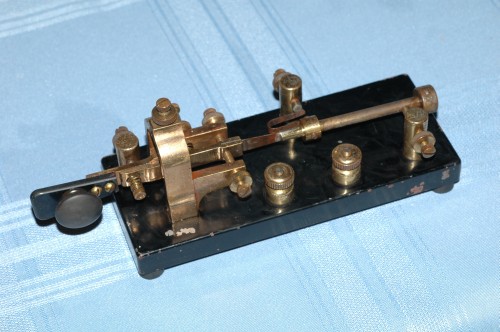
7805d Another Right Side view of the Bridgeport Bug:
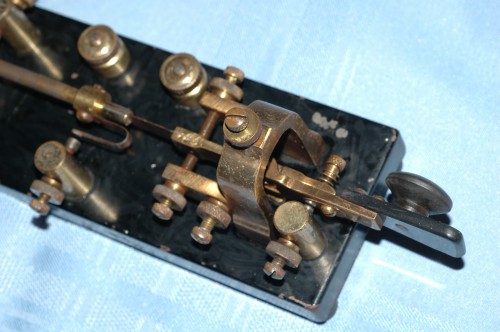
7805e A closer Left Side view of the Bridgeport Bug:
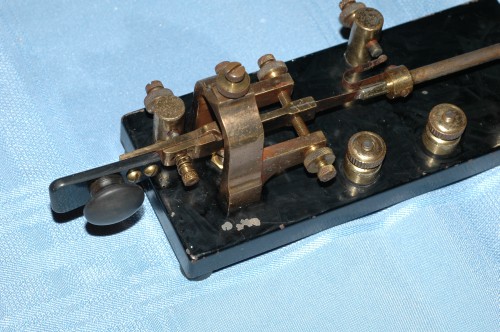
7805f A closer Right Side view of the Bridgeport Bug:
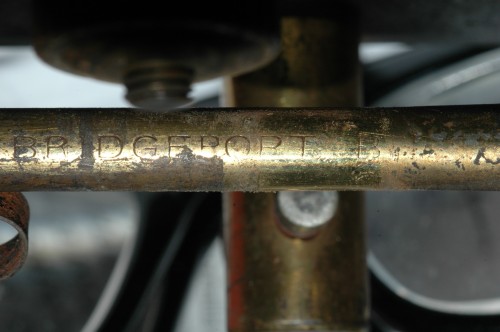
7805g A view of the label on the Bridgeport Bug:
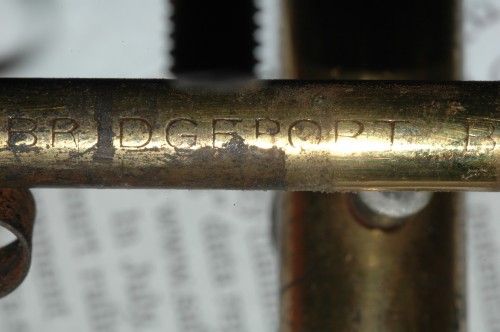
7805h Another view of the label on the Bridgeport Bug:
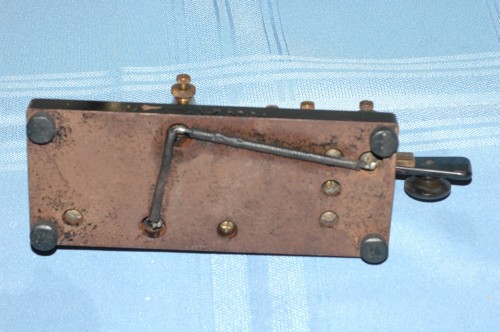
7805i A view of the bottom of the base of the Bridgeport
Bug:
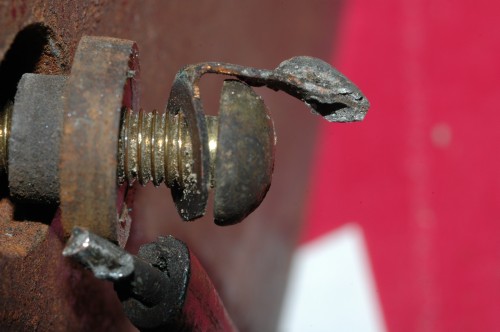
7805j A close view of the feed-through insulation of the
Bridgeport Bug:
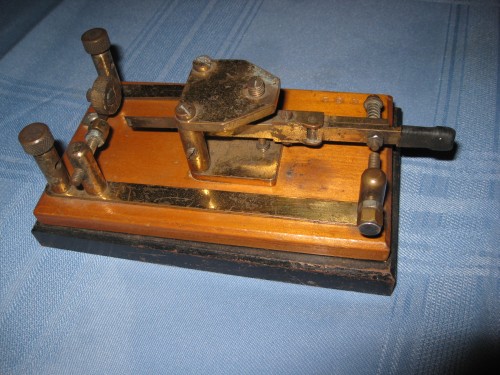
7808a UNUSUAL BRITISH BUG:
Very little is known about this unlabeled bug other that it came from England
and it has some similarities to the preceding bug number 7805. Some parts are
missing and there is no manufacturer's name or label.
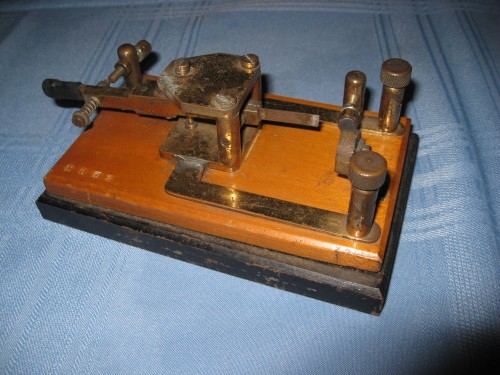
7808b
Another view of the British Bug:
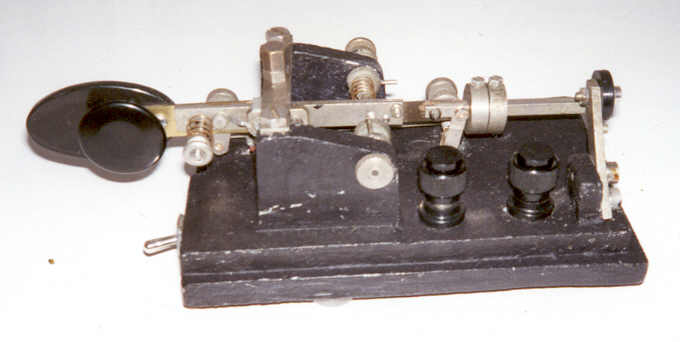
7810 ** EXTREMELY RARE BRITISH NORTHAMPTON
PLATING COMPANY BUG:(21KB)This is an unusual bug made by
the Northampton Plating Company in England. They also made a
straight key which was mounted on the same base.
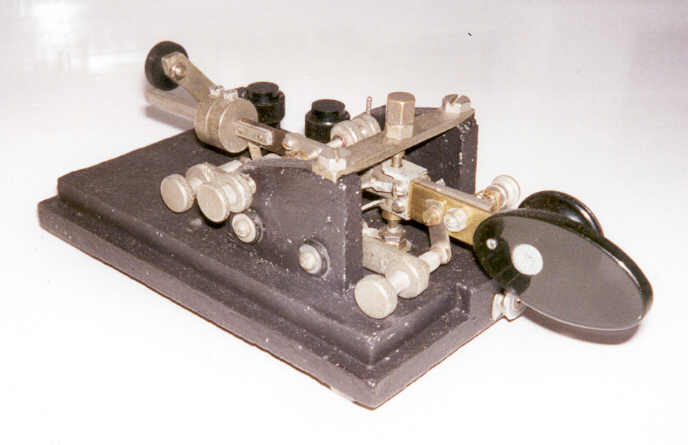
7810a Another view of the Northampton Plating
Co. Bug:(25KB)
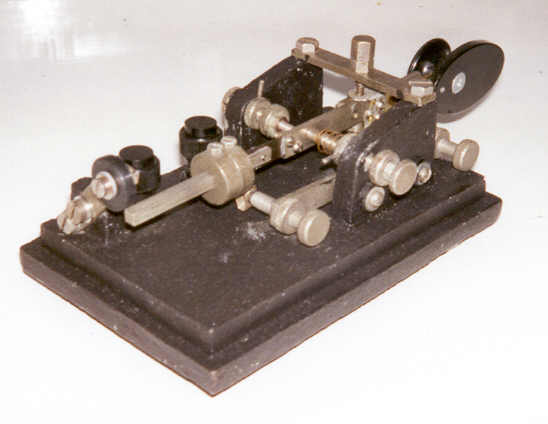
7810b Another view of the Northampton Plating
Co. Bug:(20KB)
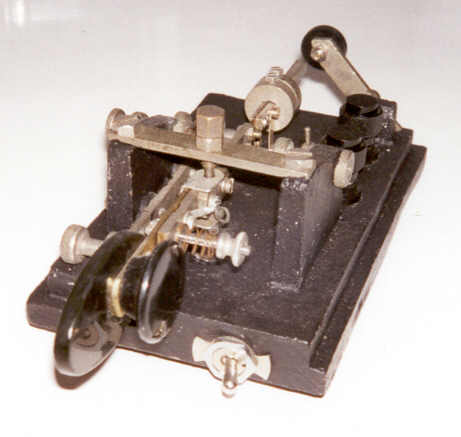
7810c Another view of the Northampton Plating
Co. Bug:(19KB)
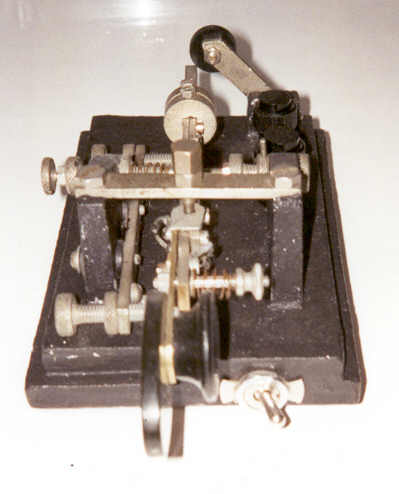
7810d Another view of the Northampton Plating
Co. Bug:(19KB)
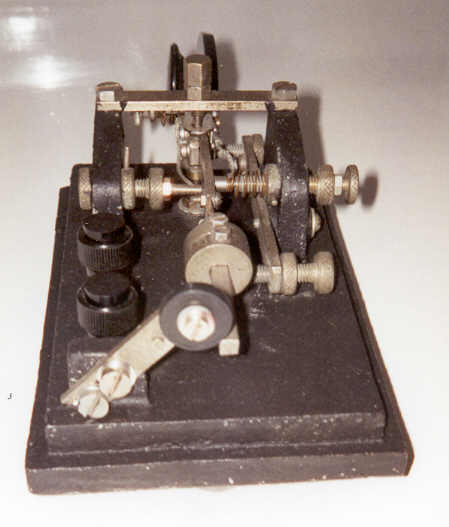
7810e Another view of the Northampton Plating
Co. Bug:(23KB)
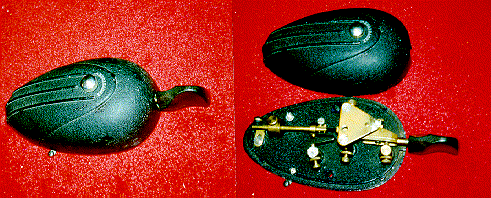
7820 BRITISH EDDYSTONE BUG:(50KB)
Nice bug enclosed in Beetle or turtle-like rounded cover.
Nicely moulded paddle. Less than 500 were reportedly made
however, they show up quite frequently. Perhaps it is because
their unique shape is attractive and people do not discard
them as they do with some of the other bugs.
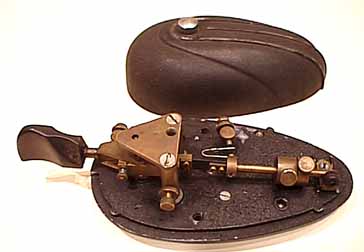
7821 * BRITISH EDDYSTONE BUG:(15KB)
Nice bug enclosed in Beetle or turtle-like rounded cover.
Nicely moulded paddle. Less than 500 were reportedly made.
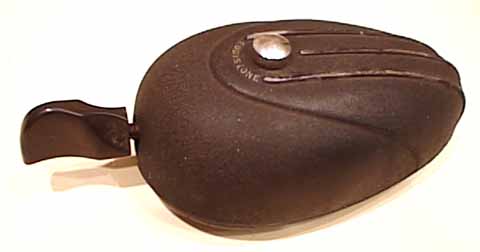
7821a Another view of the BRITISH
EDDYSTONE BUG:(11KB)
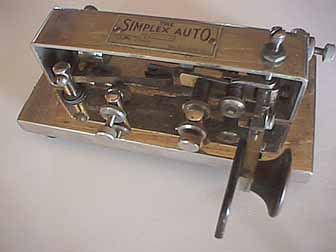
7830 * AUSTRALIAN SIMPLEX AUTO BUG:(13KB)
This is a right-angle bug which is quite hard to find in the
United States.
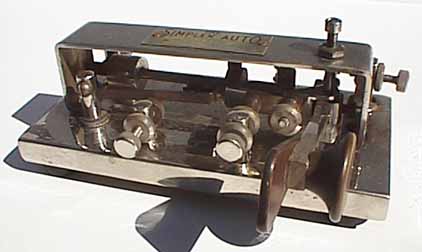
7830a Another view of the Australian Simplex Auto
Bug:(17KB)
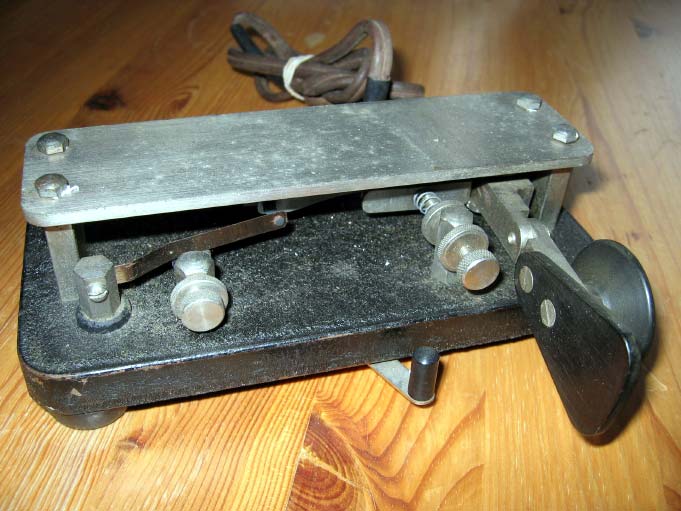
7831 * AUSTRALIAN BMR "CODEMASTER" BUG Owned by Collector Jan Skoldin,
SM5LNE:
This is a right-angle bug that is quite similar to the Simplex Auto Bug.
The label on the top is missing and reads: "CODEMASTER".
The label on the bottom reads: BMR Products, 69 Pacific Hwy, Waitara, NSW.
It carries serial number 484. Collector Jan Skoldin, SM5LNE has been kind
enough to allow me to display his photographs of his key.
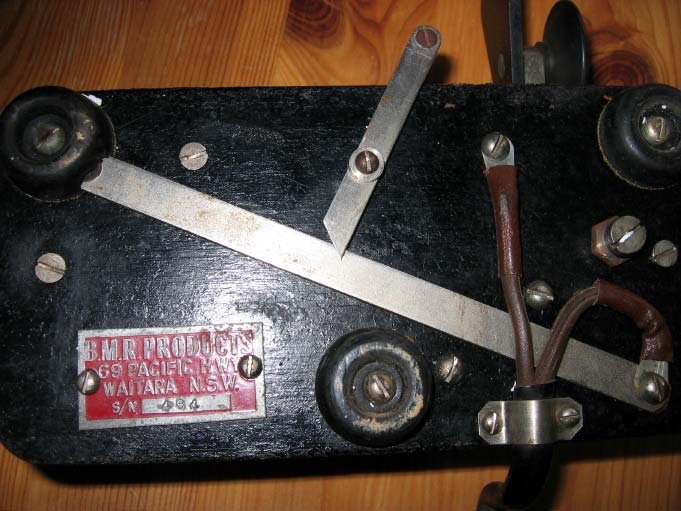
7831a A close view of the label on the bottom of the
bug:
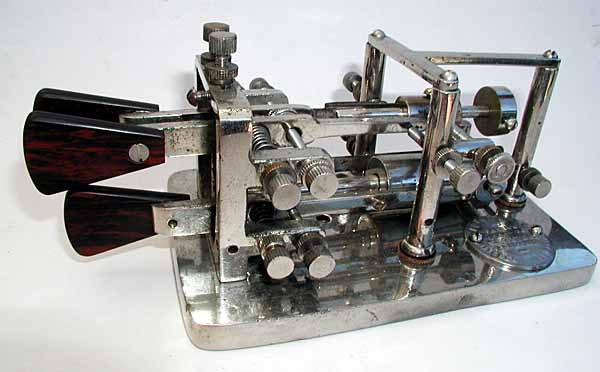
7833 * AUSTRALIAN AUTOMORSE AUTOMATIC BUG:(33KB)
This fascinating and intricate bug has three levers which allow it to be used
as a full-automatic, semi-automatic, and sideswiper key. It is
exhibited with the permission of its owner, Gil Schlehman, K9WDY.
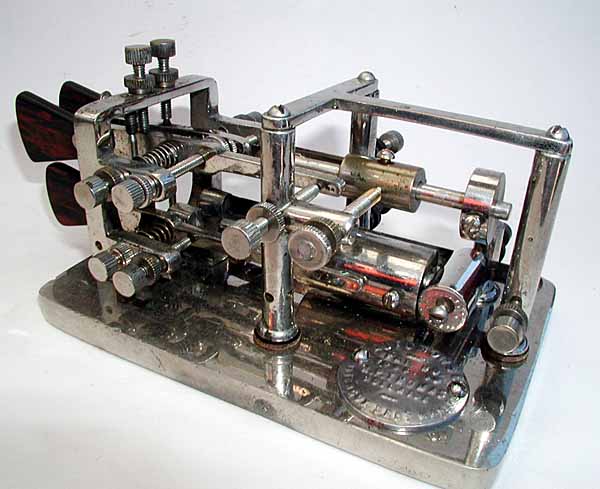
7833a * Another Right Side View of the
Automorse Bug:(44KB)
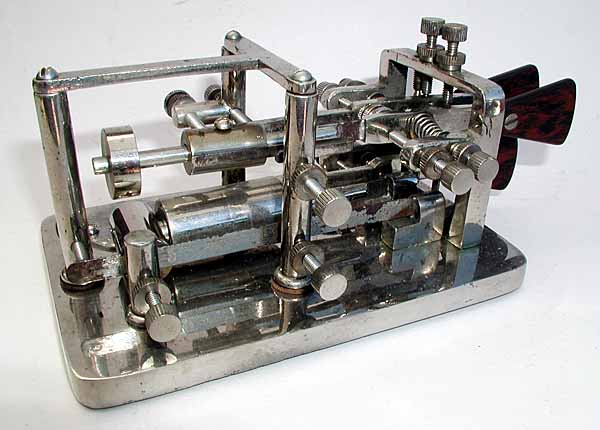
7833b * A Left Side View of the Australian Automorse
Bug:(40KB)
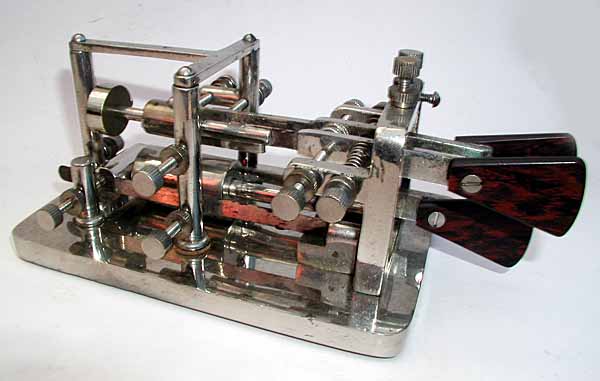
7833c * Another Left Side View of the Australian
Automorse Bug:(30KB)
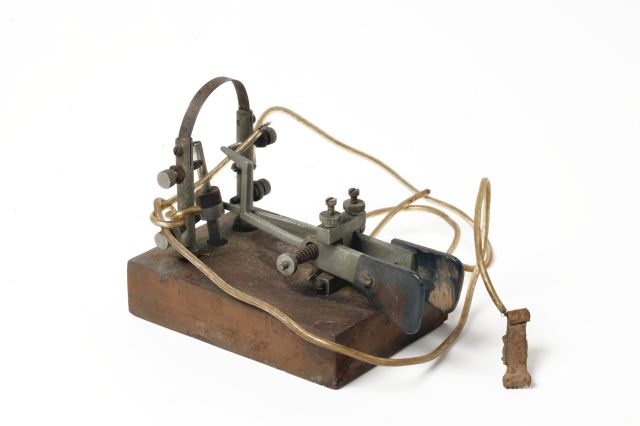
7835 * AUSTRALIAN PENDOGRAPH BUG:
This is a very interesting dual-lever upright bug made in Australia.
Picture compliments of Dr. Ben Wellings of the National Museum of
Australia in Canberra, Australia.
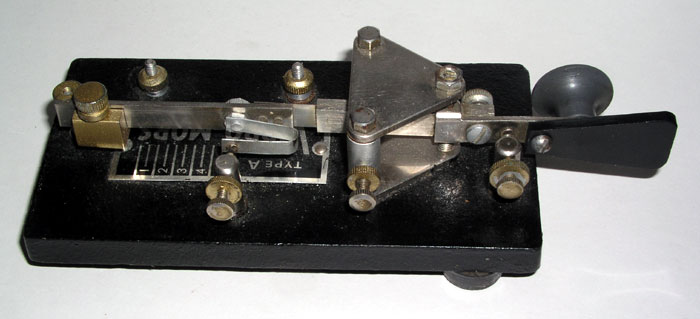
7838 FRENCH VIBRO-MORS BUG:
This is the well-known and popular French Vibro-Mors bug.
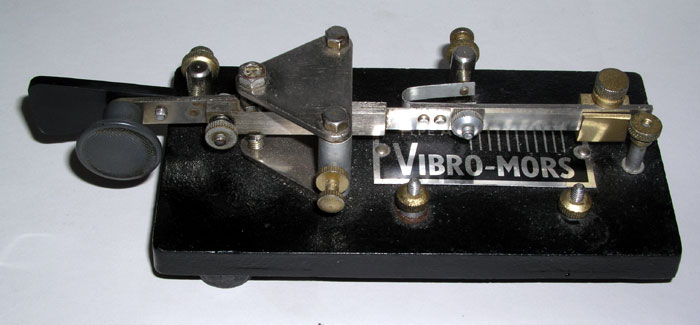
7838a The other side of the French Vibro Mors
Bug:

7840 MINIATURE GERMAN BUG:(10KB)
Unusual and tiny 4-1/2" X 2-3/8" based aluminum bug.
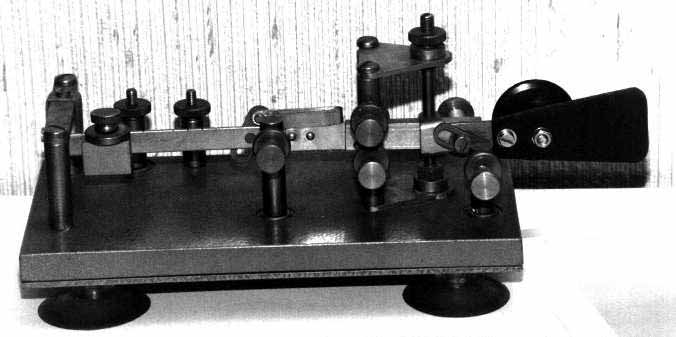
7850 * EXTREMELY RARE GERMAN JUNKER BUG:(25KB)
This is a very hard to find bug made in Germany by JUNKER. The bug
was made in very very limited quantities for use with a special
radio transmitter used by the West German police.
The few existing bugs were thrown into the trash. Collector
Matin Odenbach, DK4XL was kind enough to provide me with this
picture and to allow me to use it in my museum.
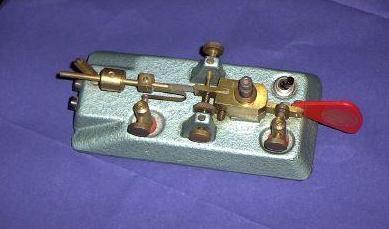
7860 EXTREMELY RARE GERMAN HANNES BAUER BUG:(15KB)
This is a very hard to find bug made in Germany by Hannes Bauer. The
construction is very similar to that of the Hannes Bauer paddles and
uses stacked brass blocks separated by races of ball-bearings. Take
a look at the paddles in the keyers and paddles section of the museum.
This rare bug is the property of collector Martin Odenbach, DK4XL who
has kindly provided the picture and allowed me to include it in my
museum. The bug was originally obtained from a retired police officer
who was involved with operating police radio stations in the most northern part of Germany in the 60's and 70's. These bugs were produced only for the german police. That's why the bug has no label or anything which could be helpful to identify it. Only a handful were made, roundabout 15, not more, in the 1950's.
When switching the German police from CW to the modern communications they
stored these bugs somewhere. Within a general scrapping period they were
found in the year 2001 and, as usual in Germany, they were scrapped without
asking a collector ... Only two of these bugs survived this disaster.
The one on the picture is in really perfect shape. It is very similar in
general design to the

Museum number 5920 Hannes Bauer
paddle:(20KB)
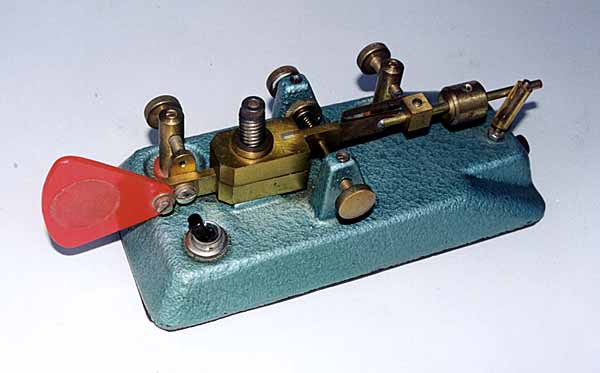
7860a Another view of the GERMAN HANNES BAUER
BUG:(26KB)
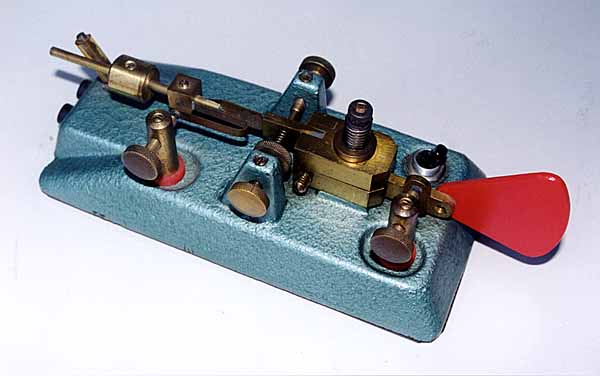
7860b Another view of the GERMAN HANNES BAUER
BUG:(27KB)
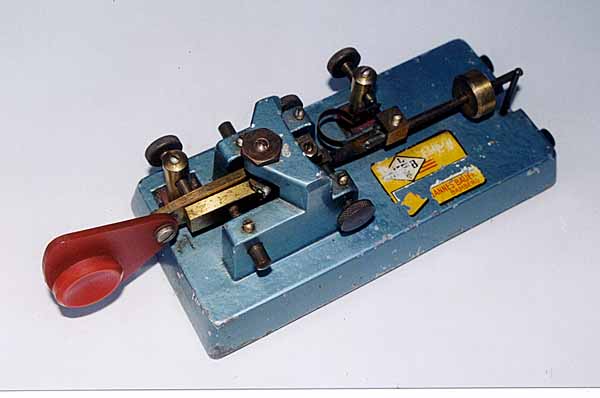
7865 A SECOND MODEL OF THE
EXTREMELY RARE GERMAN HANNES BAUER BUG:(25KB)
This is a very different key from the one shown above. It is a very
hard to find bug made in Bamberg Germany by Hannes Bauer. It was
purchased in Germany in 2001.
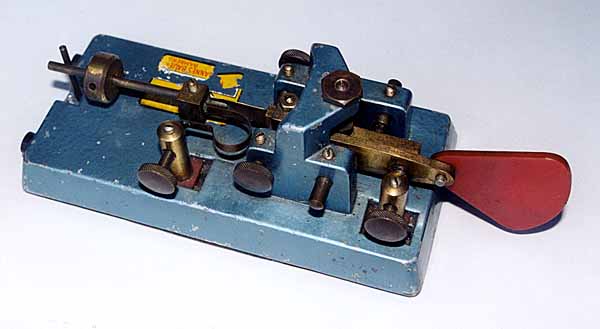
7865a Another view of the second model of the
extremely rare German Hannes Bauer BUG:(24KB)
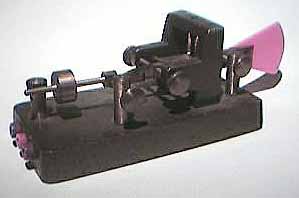
7867 A THIRD MODEL OF THE
EXTREMELY RARE GERMAN HANNES BAUER BUG:(10)
This bug has many of the same features as the two bugs
shown above and the Hannes Bauer Paddle. These include the heavy
cast base and the unique red triangular paddle. Nevertheless, this key
is quite different in overall design from the others. It is probably
an earlier version of the keys shown above. It was made
in Bamberg Germany by Hannes Bauer. It was found in Germany in
2001.
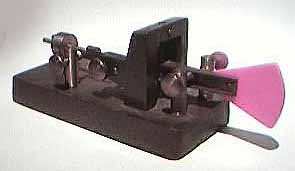
7867a Another view of third Hannes Bauer
Bug:(9KB)
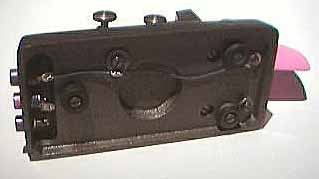
7867b Another view of third Hannes Bauer
Bug:(9KB)
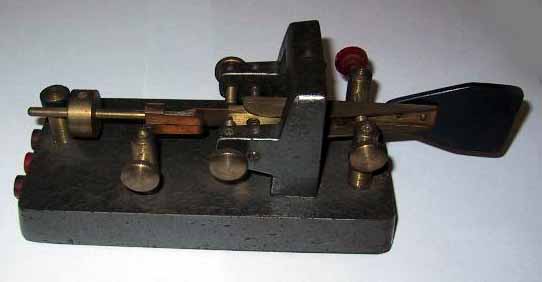
7867c Another view of third Hannes Bauer Bug:(14KB)
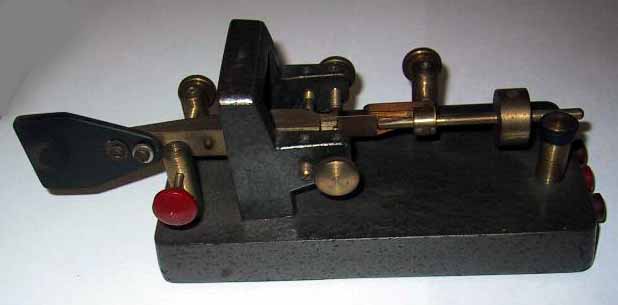
7867d Another view of third Hannes Bauer Bug:(16KB)
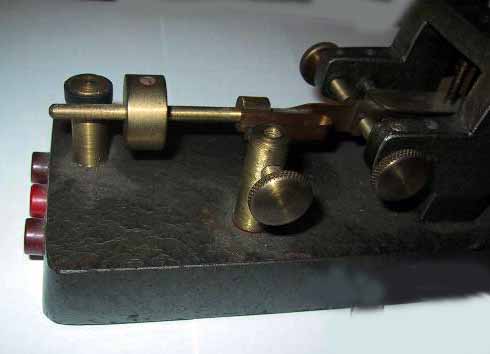
7867e Another view of third Hannes Bauer Bug:(16KB)
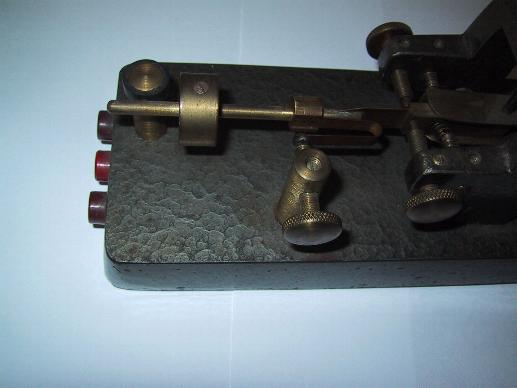
7867f Another view of third Hannes Bauer Bug:(21KB)
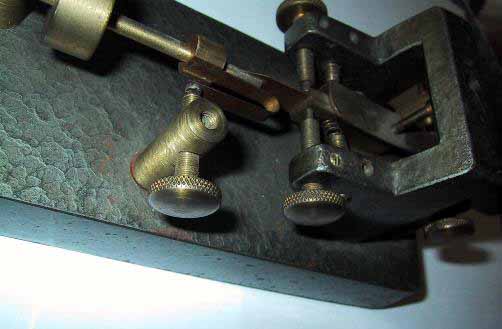
7867g Another view of third Hannes Bauer Bug:(23KB)
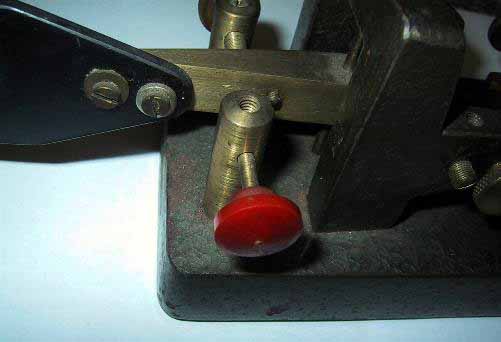
7867h Another view of third Hannes Bauer Bug:(18KB)
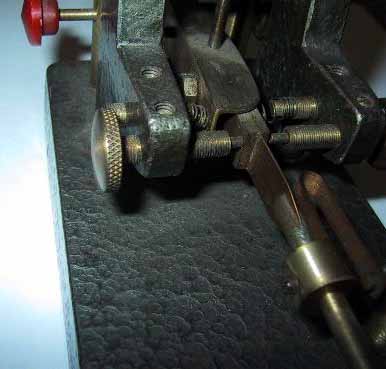
7867i Another view of third Hannes Bauer Bug:(21KB)
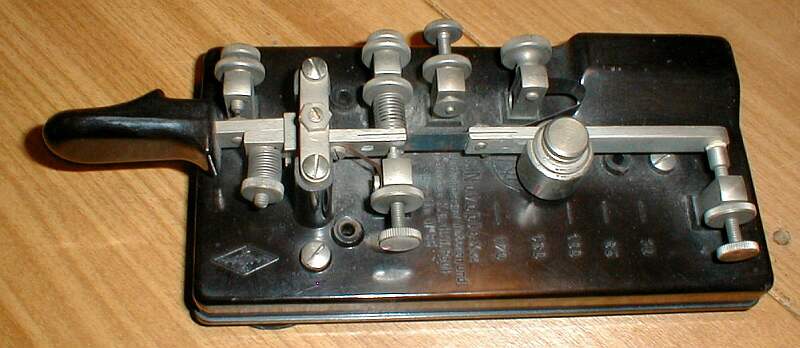
7870 * GERMAN NOVOPLEX BUG:(23KB)This is the more common
full size version of this bug. Notice the distinctive finger piece.
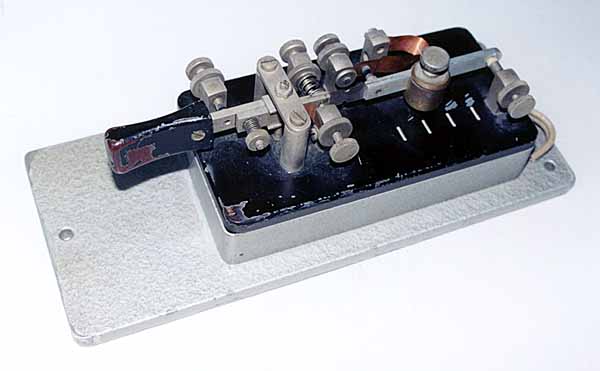
7875 * A MINIATURE GERMAN NOVOPLEX BUG:(23KB)This is
a miniature model of the German Novoplex Bug. It was located in Germany
in 2001.
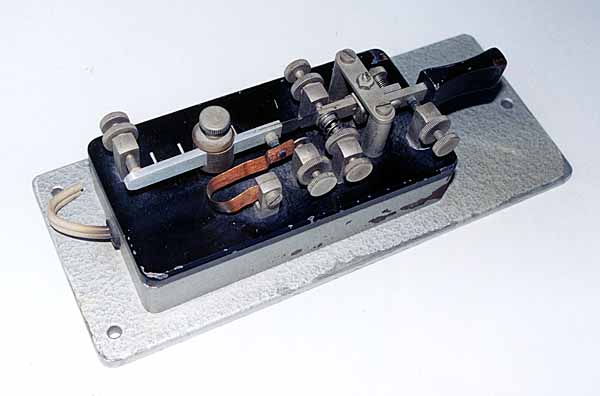
7875a Another view of the Miniature Novoplex Bug:(26KB)
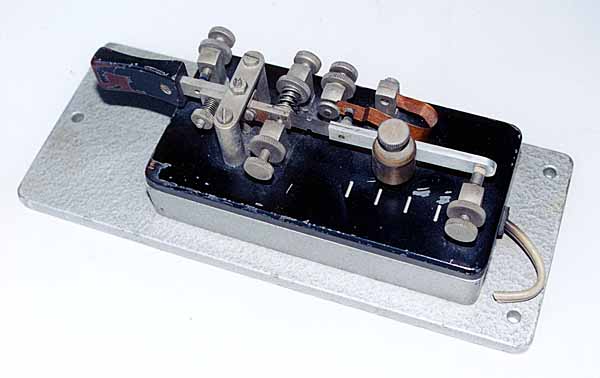
7875b Another view of the Miniature Novoplex Bug:(26KB)
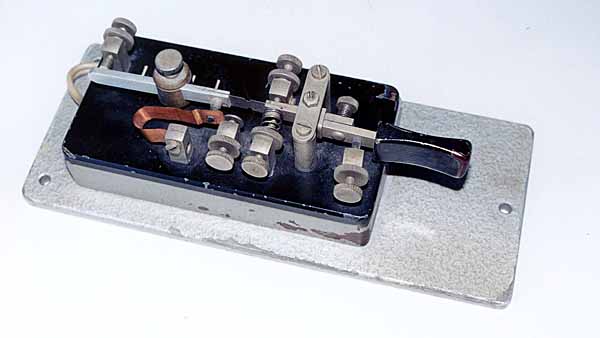
7875c Another view of the Miniature Novoplex Bug:(23KB)
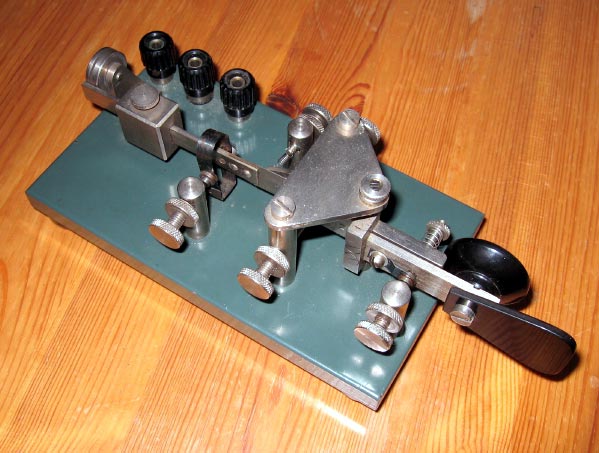
7878a * EXCEPTIONALLY RARE SWISS BECH BUG Owned by
collector Jan Skoldin SM5LNE:(57KB)This is the only known example of the
Swiss Bech Bug. Only 10 of these bugs were made during the period 1942-1943
in the workshop in the small Swiss villiage of Schwarzenburg. This bug was
purchased by a Swiss Amateur Radio Operator who did his military service on
board the ship: "Chasseral". The bug was in his radio room when, on April 22,
1944, the ship was heavily damaged by aircraft. The German Navy saved the
people on board and towed the ship into the nearest harbor. The owner took
his key with him when he left the ship. Collector Jan Skoldin, SM5LNE was
kind enough to allow me to tell the story of this key and show his photos of
it.
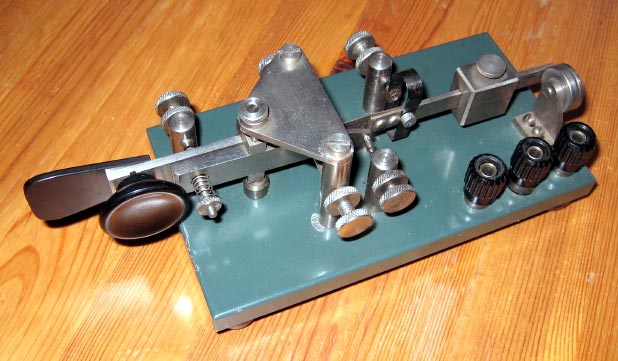
7878b * Right side view of the Swiss Bech Bug:(49KB)
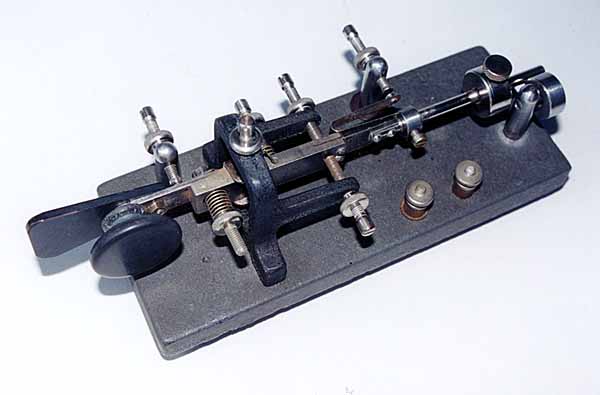
7887 TELFUNKEN MODEL 401 BUG:(25KB)This is
a German bug that was manufactured by Telfunken. It is their model
number 401. It was purchased in Germany in 2001.

7887a Another view of the Telfunken 401 bug:(28KB)
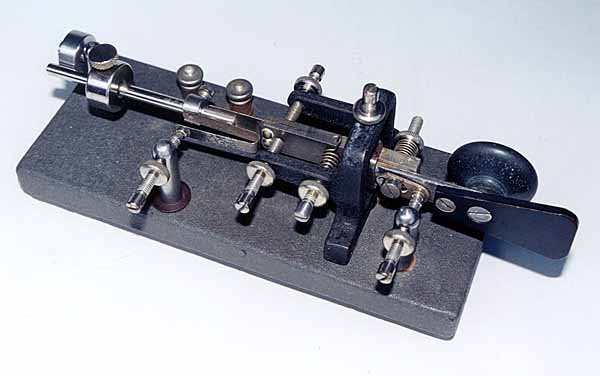
7887b Another view of the Telfunken 401 bug:(27B)
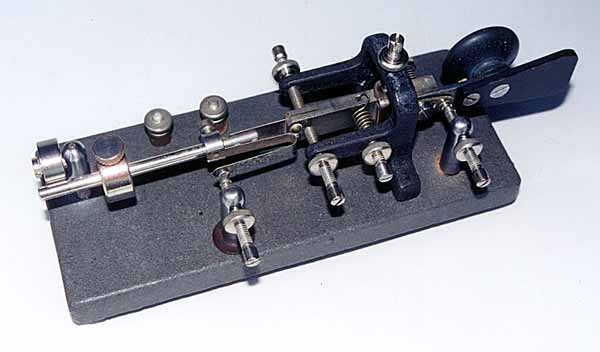
7887c Another view of the Telfunken 401 bug:(25B)
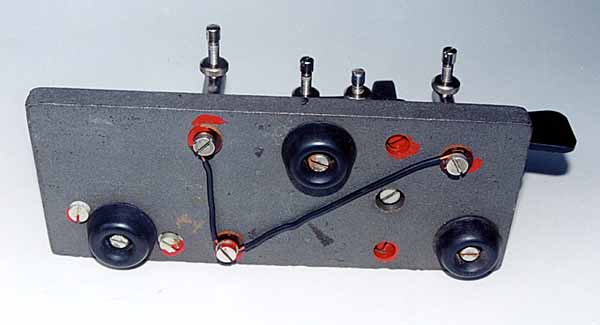
7887d A view of the underside of the base of
the Telfunken 401 bug:(20KB)
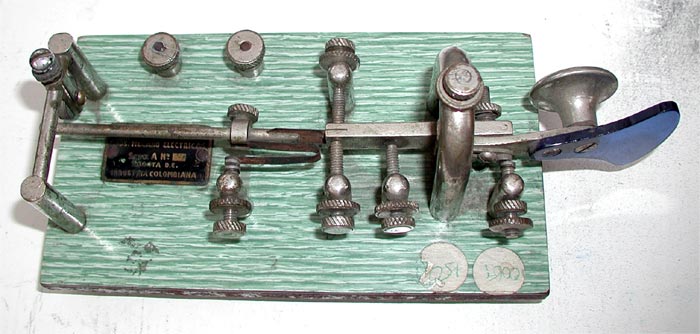
7896 RAGAR LTDA. BUG:
This bug is labeled: RARAR LTDA. INDS MECHANO ELECTRICAS. Serie A No. (blank)
BOGOTA, DE. Industria Columbiana. It was apparently made in Bogota
Columbia.
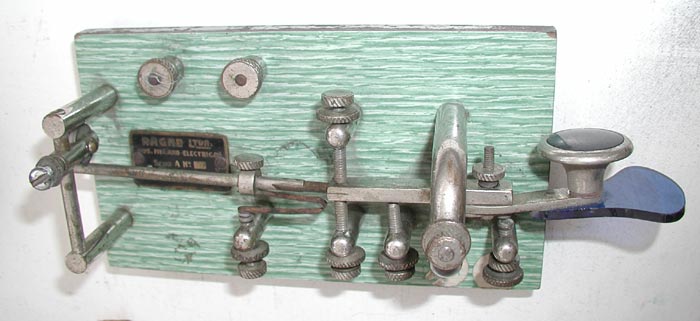
7896a Another view of the RAGAR Bug:
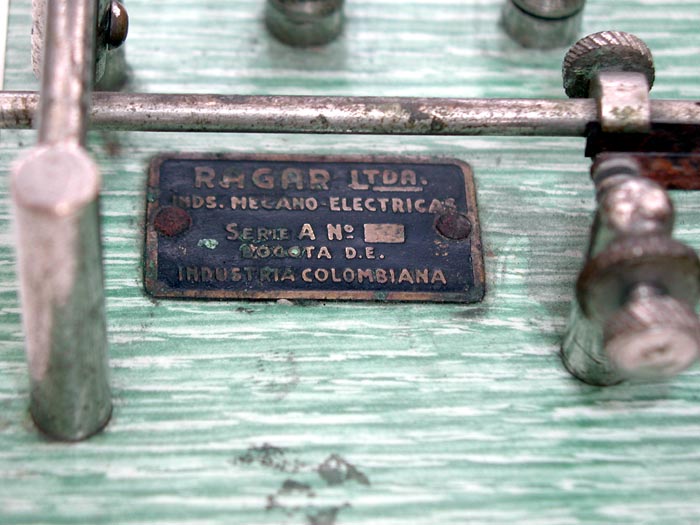
7896b A Close view of the RAGAR Label:
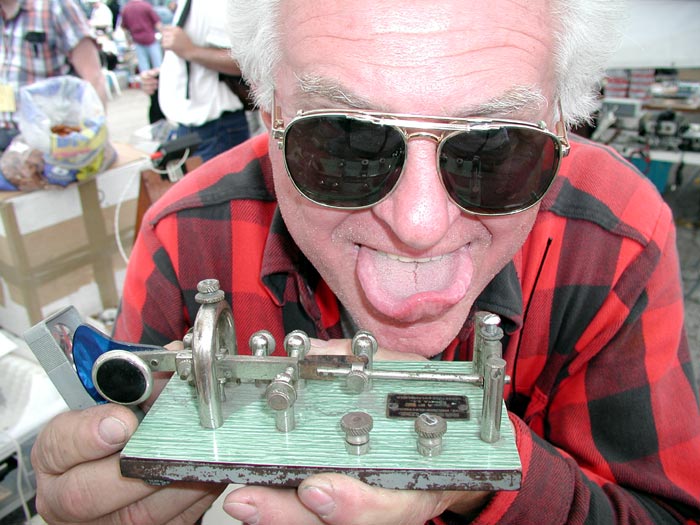
7896c A well-known collector salivating over the
RAGAR Bug:
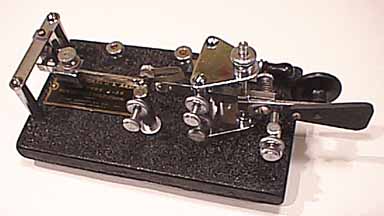
7900 VIBROPLEX J-36 BUG:(18KB)
This is the WWII Military version of the Lightning bug.
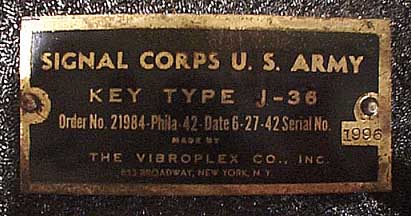
7900a Brass Label:(28KB)
reads: Signal Corps, U.S.Army. Key Type J-36.Order # 21984-Phila-42.
Date 6-27-42. Serial No. 1996. The Vibroplex Co.Inc. 833
Broadway. New York, N.Y.
7906: (Please see number 7930 for an interesting and unusual
Lionel-Vibroplex Hybrid J-36 Bug.)
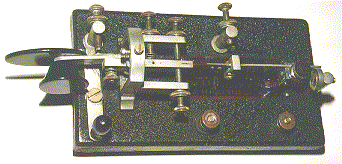
7910 BUNNELL J-36: (20KB)
This is the J-36 bug which Bunnell manufactured during WWII.
The label reads: Signal Corps, U. S. Army, Key, J-36,
Order No 6001, Phila, 43. Date 8-4-42. Serial Number 1657.
Made by J. H. Bunnell & Co.
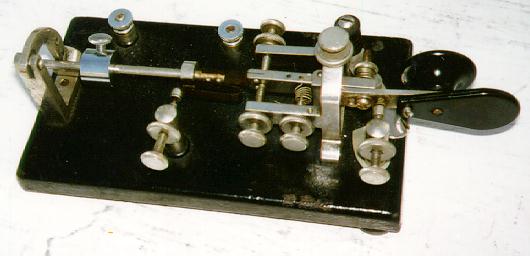
7915 * BUNNELL/BUREAU OF STEAM ENGINEERING
NAVY J-36 BUG: (23KB)
This bug was made in very limited (<300) quantities during WWII.
It looks similar to a Bunnell J-36 but has a Vibroplex-style pendulum
damper and 2-56 holes drilled and tapped into the top of the frame
and lever to accept screws that connected the lever to both sides of
the frame with silver plated copper braid wires. The pendulum is drilled
and tapped at the far end to accept an extension arm to slow the speed.
Neal McEwen (K5RW) tells me that the key carried a CJBxxxx Navy number.-
>TR
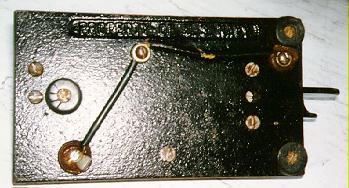
7915a The words "PROPERTY OF THE U.S.
NAVY" are cast into the bottom of the key: (22KB)
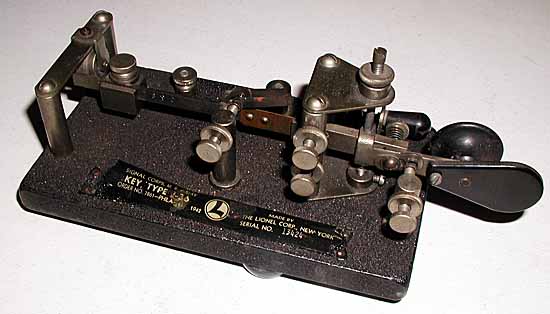
7920 LIONEL CORPORATION J-36 MILITARY BUG:(29KB)
This is the Vibroplex ''Lightning Bug'' design but it was
manufactured by the Lionel Corp during WWII since Vibroplex was
unable to produce enough Lightning Bugs to meet the demands of the
war effort. It is Labeled: Signal Corps, U.S.Army, Key type J-36,
Order No 7861-Phila-43,1942, Made by The Lionel Corp, NewYork,
Serial No. 13424. (NOTE: The black plastic labels tend to curl up
in the sun and even warm temperatures and few of these labels
have survived. This label shows the typical shrinking and curling
which takes place.)
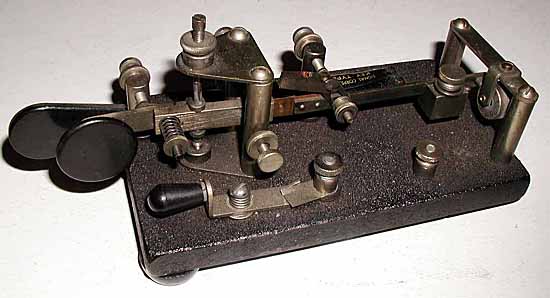
7920a A Right side view of the Lionel J-36
Bug:(29KB)
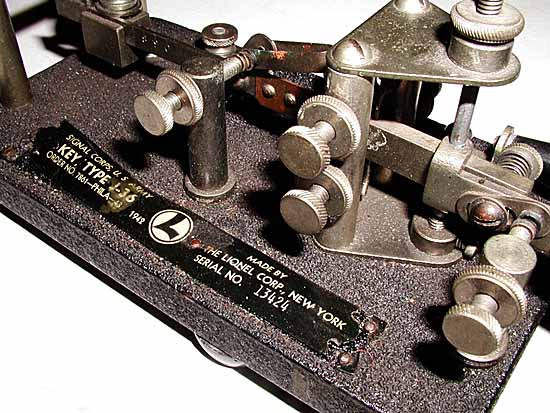
7920b A Close-up view of the curled up label on
the Lionel J-36 Bug:(67KB)
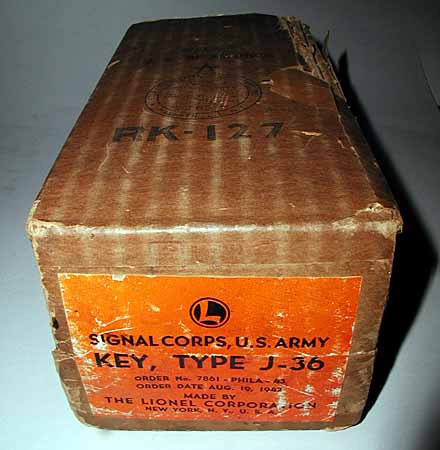
7921 ORIGINAL LIONEL CORPORATION SHIPPING
BOX AND LABELS FOR LIONEL J-36 MILITARY BUG:(31KB)This is
a hard-to-find original box for the Lionel J-36 military bug.
The label reads: SIGNAL CORPS, U.S.ARMY KEY, TYPE J-36.
Order Number 7861-PHILA-43. Order Date Aug 19, 1942.
Made by THE LIONEL CORPORATION, NEW YORK, N.Y. U.S.A.
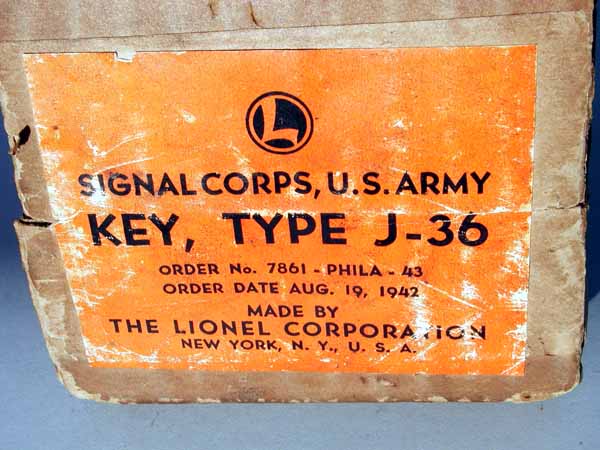
7921a A Close-up of the label:(48KB)
The box is stamped: MADE IN U. S. OF AMERICA. R-127.
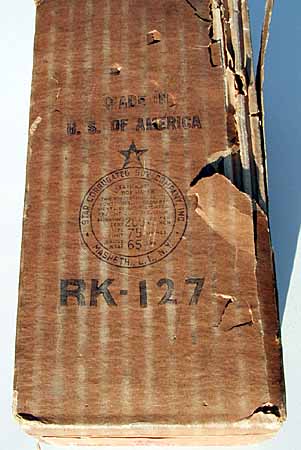
7921b A Close-up of the box markings:(27KB)
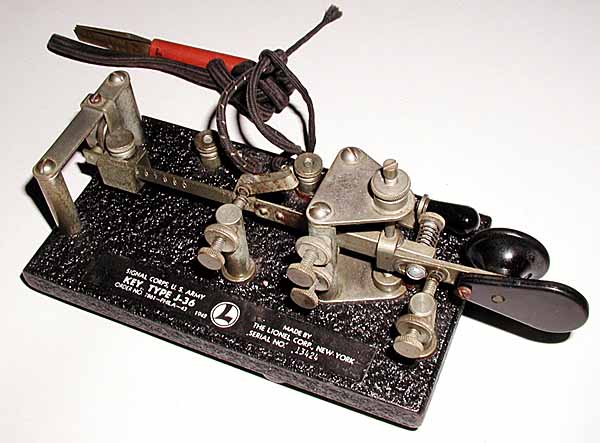
7923 LIONEL CORPORATION J-36 MILITARY BUG:(51KB)
Same as above but entire LIONEL label is reproduction.
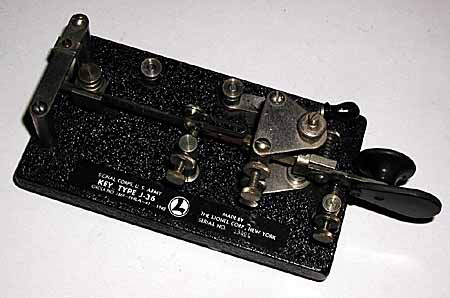
7926 LIONEL CORPORATION J-36 MILITARY BUG:(26KB)
Same as above but entire LIONEL label is reproduction.
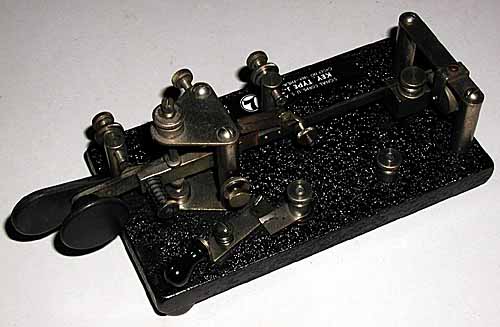
7926a Another view of the LIONEL J-36 BUG:(30KB)
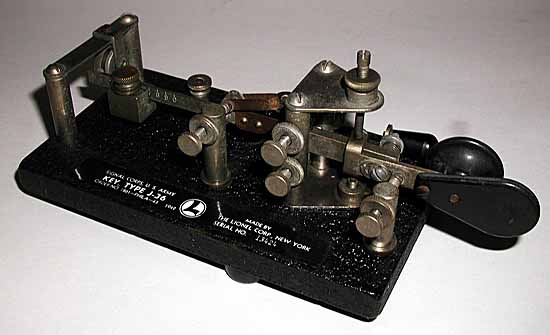
7927 Another LIONEL J-36 BUG (As above):(26KB)
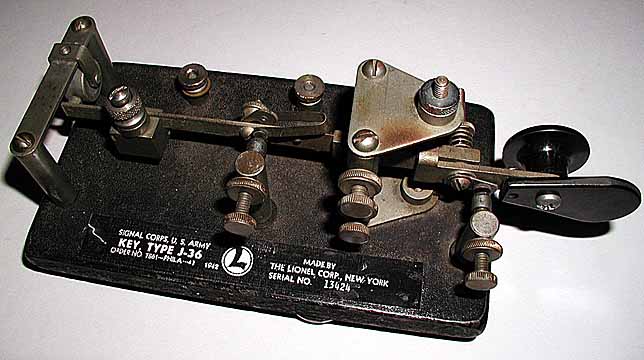
7928 Another LIONEL J-36 BUG (As above):(44KB)
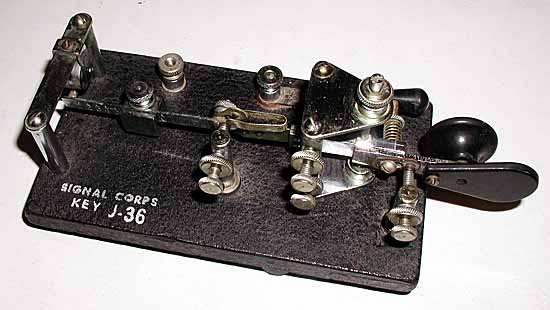
7930 UNUSUAL SPECIAL LIONEL - VIBROPLEX HYBRID
J-36 BUG:(33KB)
This is a very unusual J-36 bug which has a partly Lionel J-36 mechanism
and a partly Vibroplex J-36 mechanism mounted
on an unlabeled Vibroplex J-36 base. Instead of a Vibroplex label,
the Base carries the stamped words: SIGNAL CORPS
KEY J-36. The only other unusual markings are the red letters MFP
stamped on the end of the key. MFP stands for ''Moisture and
Fungus Proofed'' and indicates that the key had received a special
coating to reduce corrosion and deterioration. The Lionel J-36 bug
was a licensed copy of the Vibroplex Lightning bug which was made
during WW-II by Lionel because Vibroplex could not produce them in
adequate quantities to fill the needs of the military. This bug
was probably one of the very early Lionel J-36 models which was
produced before Lionel developed its own Label and some of its
own parts. Vibroplex most likely supplied the base without the label
and some parts and Lionel added the other parts of the
mechanism. This key clearly never had the vibroplex label and
one of the two holes designed to mount the label is still filled
with the wrinkle-finish paint. At least one other similar
Lionel-Vibroplex hybrid J-36 is known to exist.
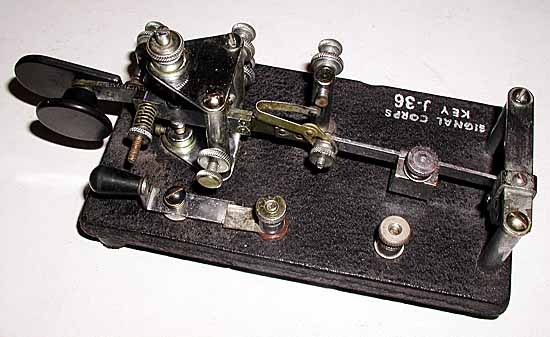
7930a A view of the Right side of the unusual
Lionel-Vibroplex J-36 bug:(38KB)
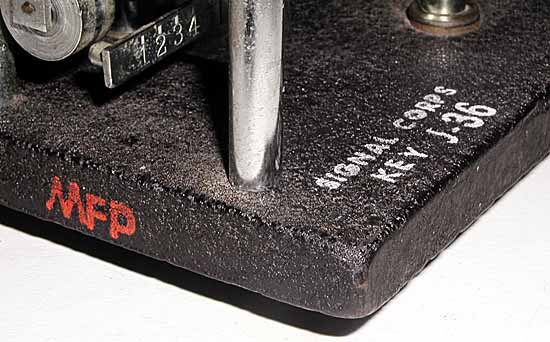
7930b A close-up view of the markings on
the bug and the empty hole for mounting the usual Vibroplex
label:(44KB)
GENUINE PADDLES For LIONEL J-36s ARE AVAILABLE from http://Artifaxbooks.com
Please enquire via email.
REPRODUCTION LABELS like this:

...may be made easily by downloading and printing the following files that
contain copies of a good clean label.
Once you have one of these files in your computer, you
can resize it to exactly 4-1/4 inches long by 5/8-inch high. Then,
print it out, seal it in plastic, and attach it to your key...
7935.gif GIF file of Lionel J-36 Label: (42KB)
7935.pcx PCX file of Lionel J-36 Label: (82KB)
mj36lbl.htm - Suggestions for printing/making the label:
(4KB)
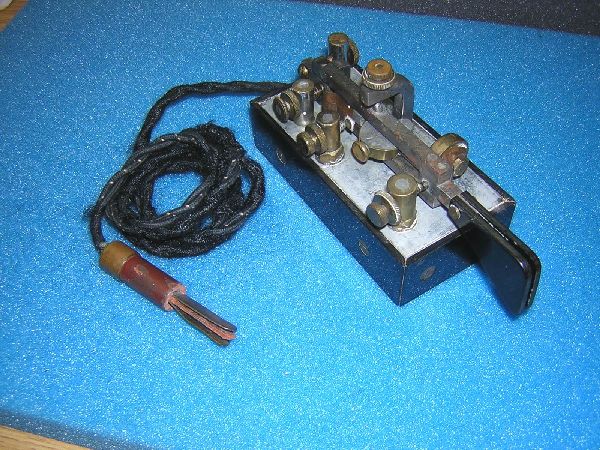
7937 EXCEPTIONALLY RARE AND INTERESTING "JOHN PINELLI
""J-36"" BUG:
This is the only known example of the fascinating John Pinelli Bug. It is
owned by his family and shows an exceptional degree of innovation in it's
reversed vibrating lever. It was designed as a bug for the military to use in
WW-II and was submitted by it's inventor for Signal Corps Approval as a J-36.
I am awaiting further information about whether it was accepted or even given
a trial by the military and for more information about John Pinelli's life and
work as an inventor.
For now, I can only display the key and the original patent drawing as I hope
to receive more information.
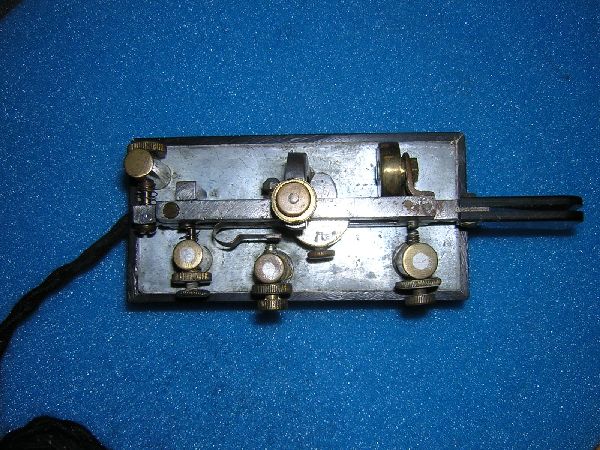
7937a Another view of the John Pinelli ""J-36""
Bug:
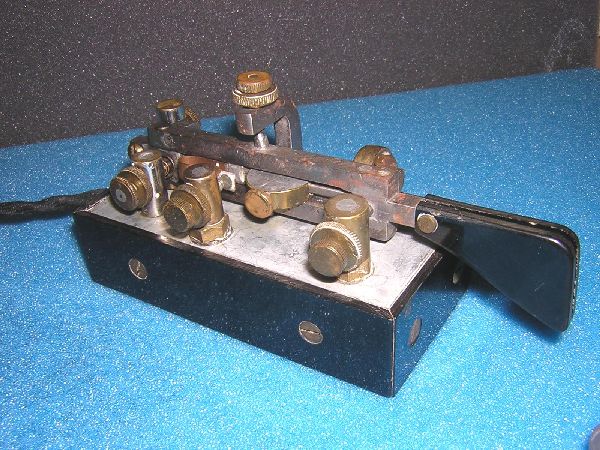
7937b Another view of the John Pinelli ""J-36""
Bug:
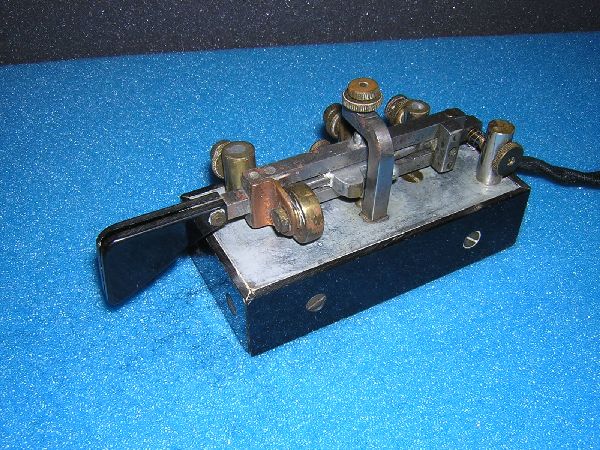
7937c Another view of the John Pinelli ""J-36""
Bug:
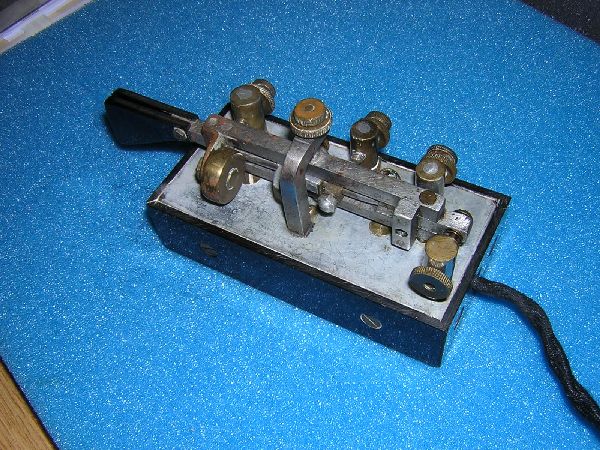
7937d Another view of the John Pinelli ""J-36""
Bug:
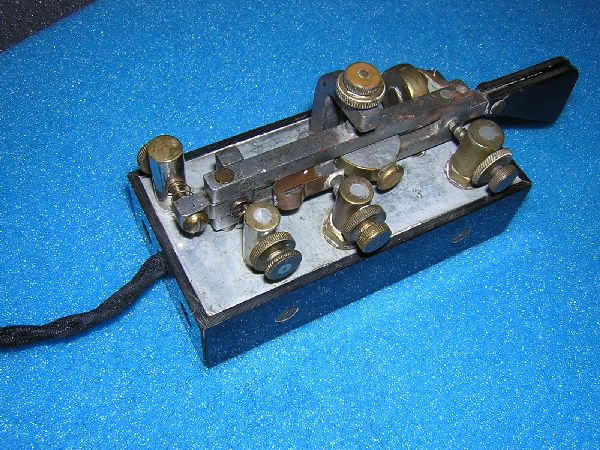
7937e Another view of the John Pinelli ""J-36""
Bug:
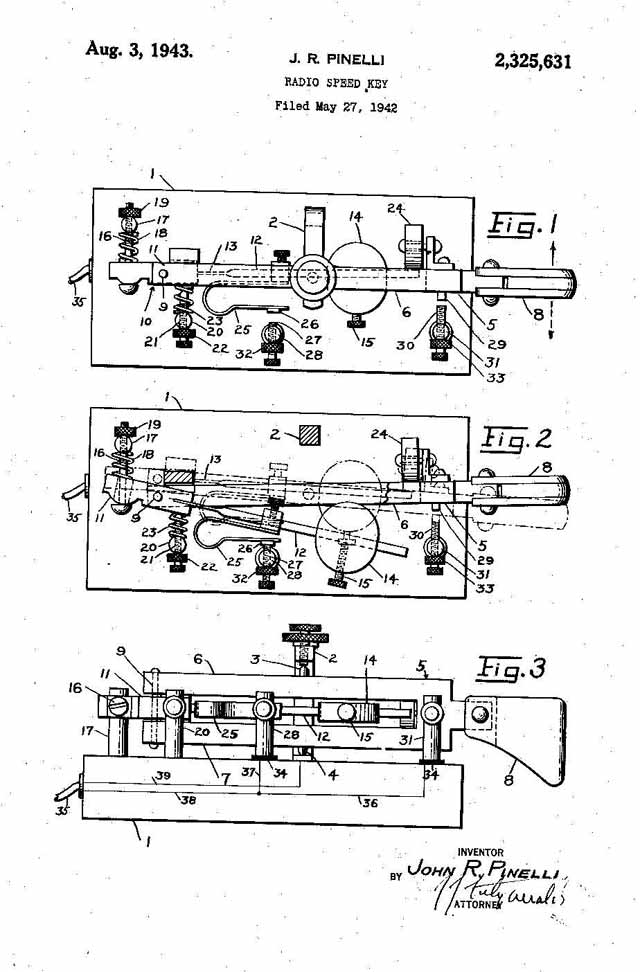
7937f The original patent drawing for the John Pinelli
""J-36"" Bug:
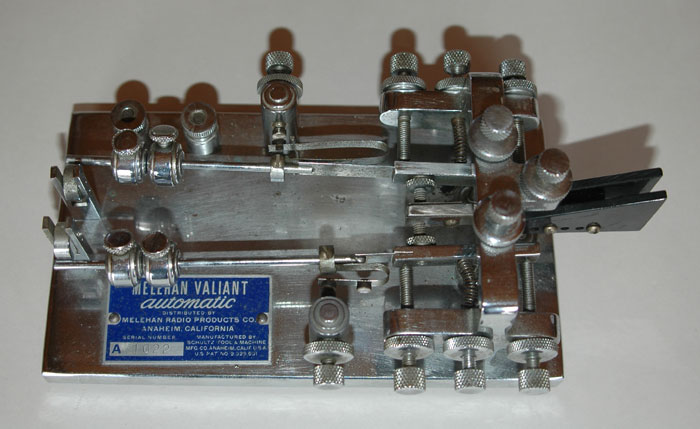
7940 RARE MELEHAN VALIANT FULL-AUTOMATIC
KEY (ANAHEIM, CALIFORNIA MODEL):(20KB)
A very few of these rare keys were made by Mel Hanson from 1939 to 1959.
It uses two vibrating levers to allow it to make both dots and dashes
automatically. These keys are very hard to find. There is a nice article on
the Melehan in the March, 1942 Issue of QST Magazine.
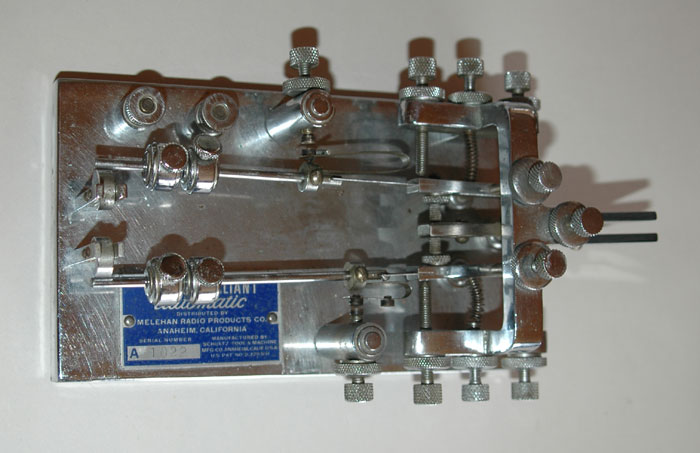
7940a Another view of the Melehan Valiant:
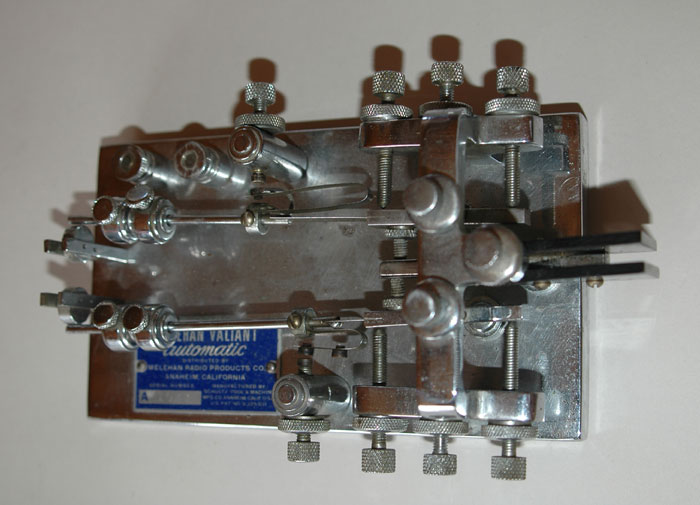
7940b Another view of the Melehan Valiant:
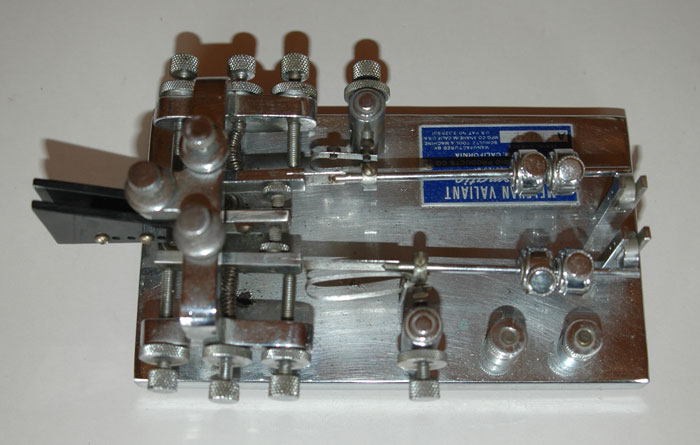
7940c Another view of the Melehan Valiant:
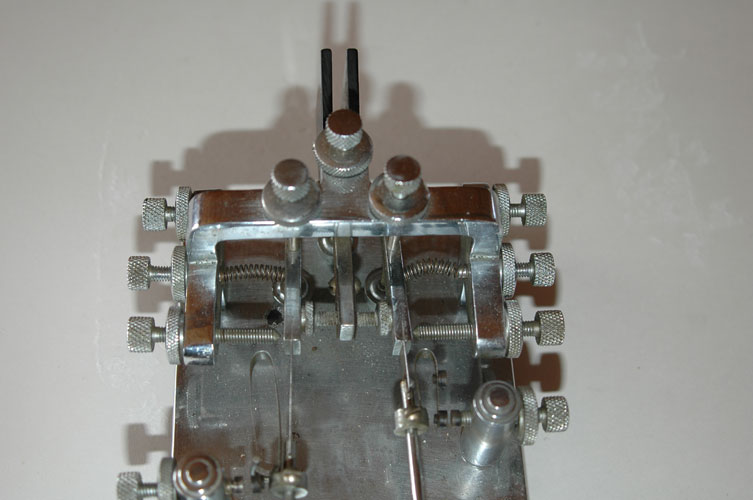
7940d Another view of the Melehan Valiant:
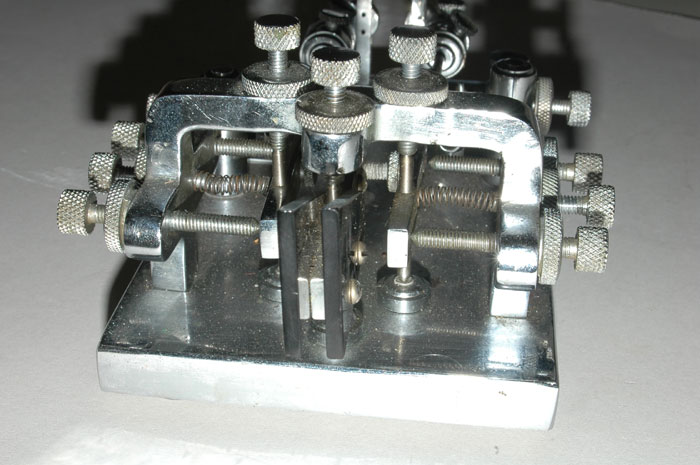
7940e Another view of the Melehan Valiant:
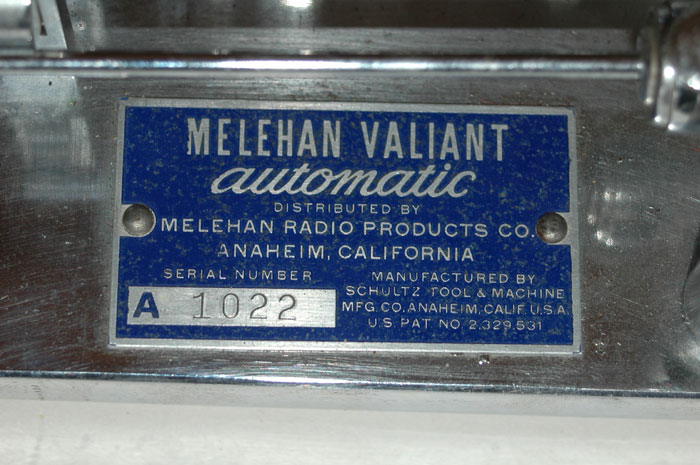
7940f The Label on the Melehan Valiant:
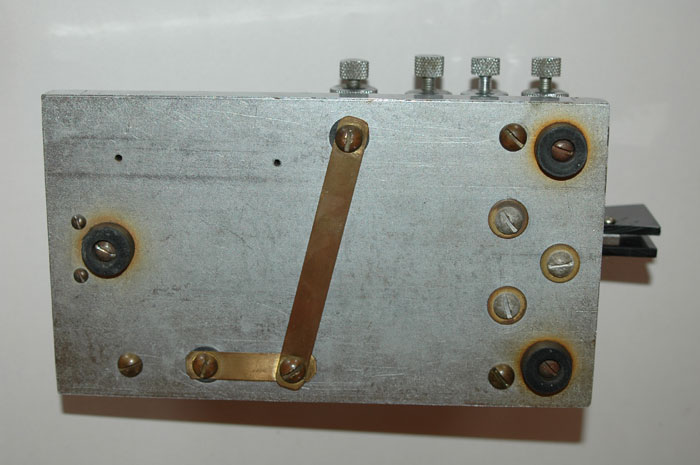
7940g The bottom of the base of the Melehan
Valiant:
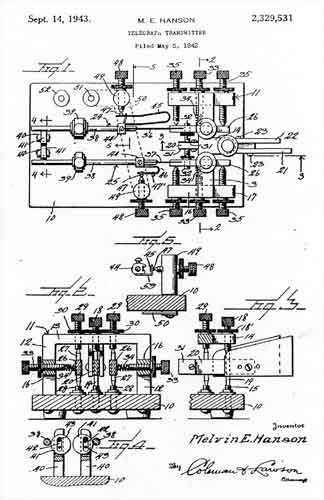
7941 ORIGINAL PATENT DRAWING FOR THE
MELEHAN VALIANT FULL-AUTOMATIC KEY:(20KB)
A very few of these keys were made by Mel Hanson from 1939 to 1959.
This is his original patent drawing.
NOTE: For views of two exceptional homemade sub-miniature
1/2-scale Melehan Valiant bugs, please go to the homemade
keys section of this museum and look for number 9841.
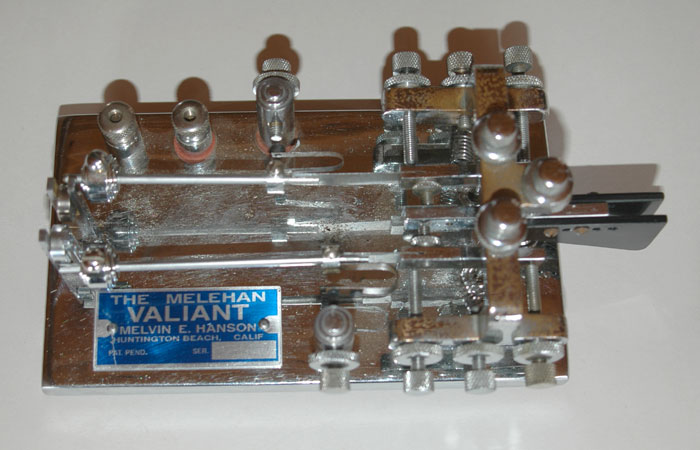
7942 RARE MELEHAN VALIANT FULL-AUTOMATIC KEY (HUNTINGTON
BEACH CALIFORNIA MODEL):(20KB)
A very few of these rare keys were made by Mel Hanson from 1939 to 1959.
It uses two vibrating levers to allow it to make both dots and dashes
automatically. These keys are very hard to find. There is a nice article on
the Melehan in the March, 1942 Issue of QST Magazine.
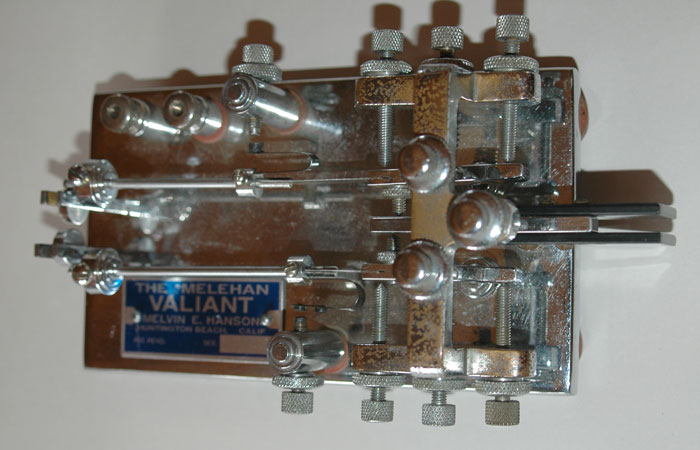
7942a Another view of the Melehan Valiant:
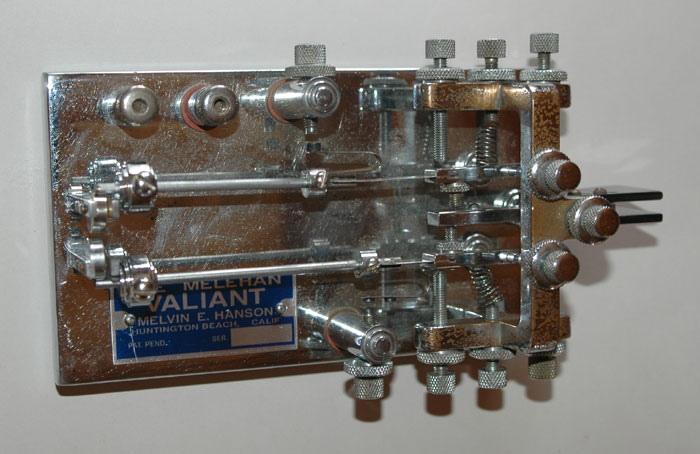
7942b Another view of the Melehan Valiant:
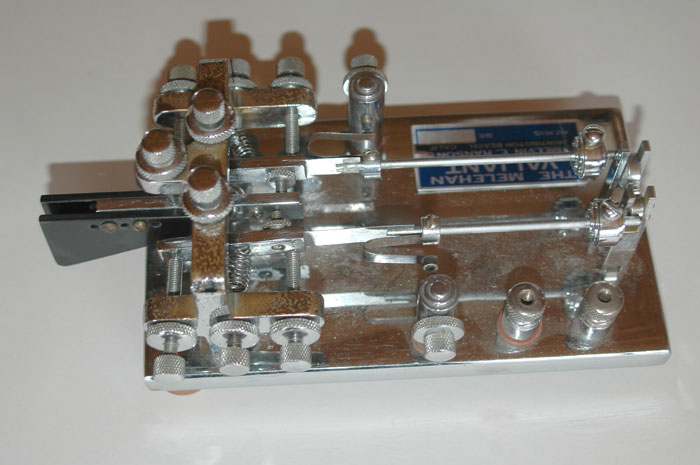
7942c Another view of the Melehan Valiant:
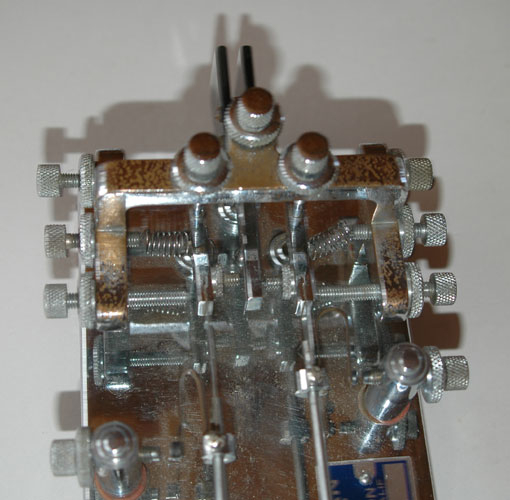
7942d Another view of the Melehan Valiant:
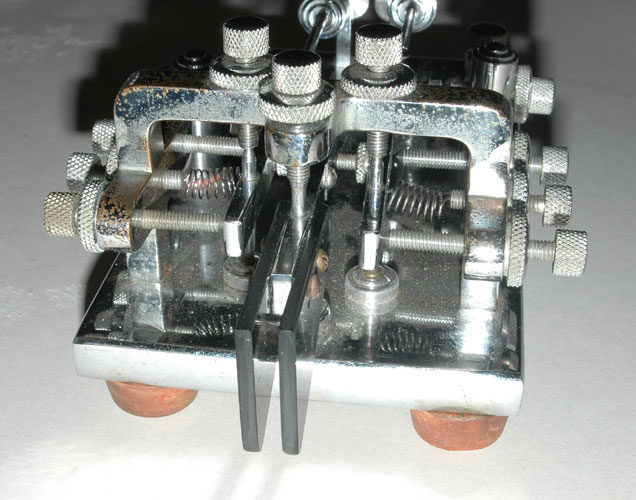
7942e Another view of the Melehan Valiant:
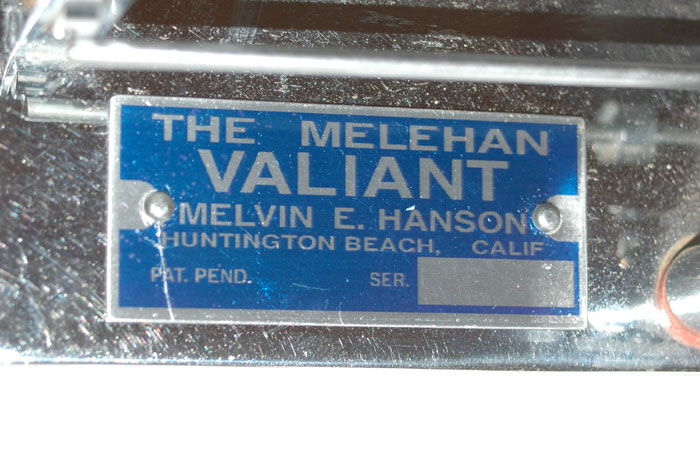
7942f The Label on the Melehan Valiant:
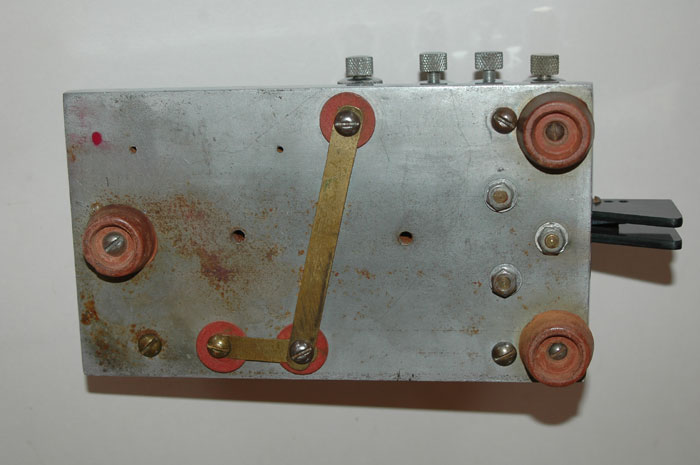
7942g The bottom of the base of the Melehan
Valiant:
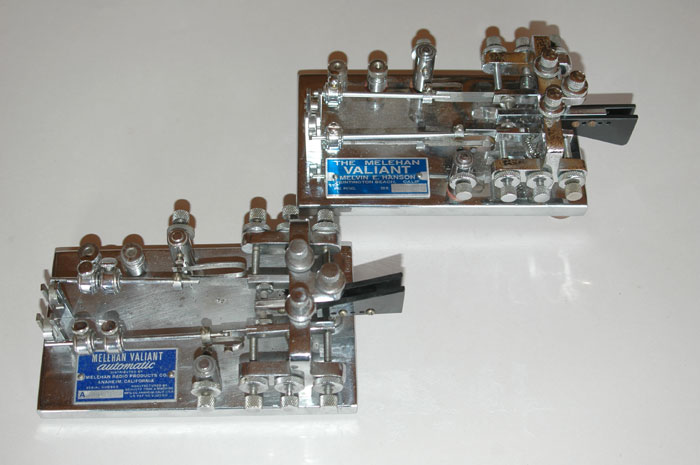
7943 SIDE-BY-SIDE VIEWS OF THE TWO MELEHANS DESCRIBED
ABOVE:
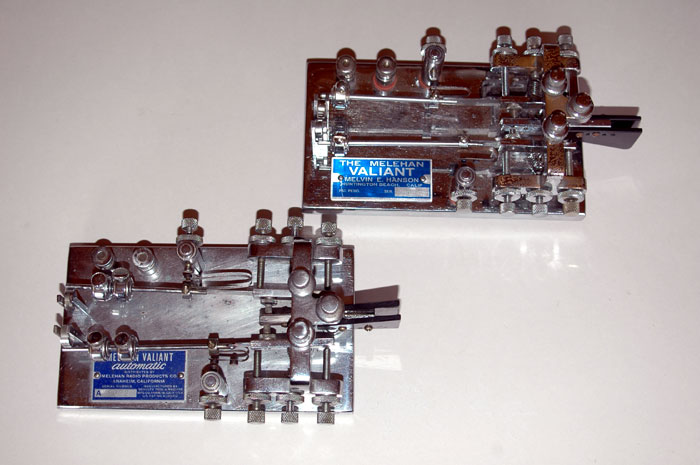
7943a Another Side-by-side Melehan Photo:
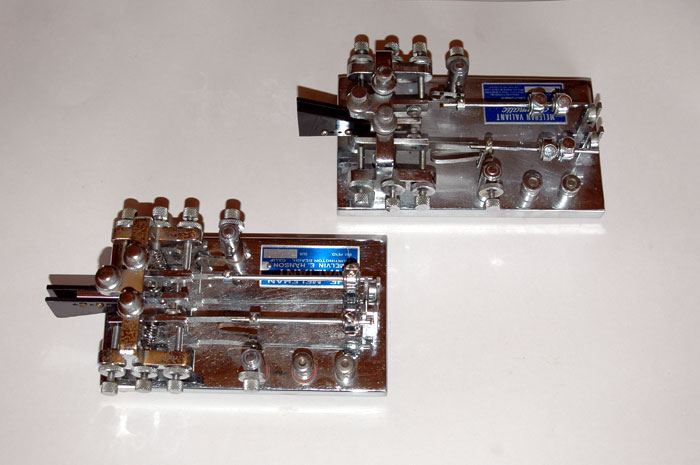
7943b Another Side-by-side Melehan Photo:
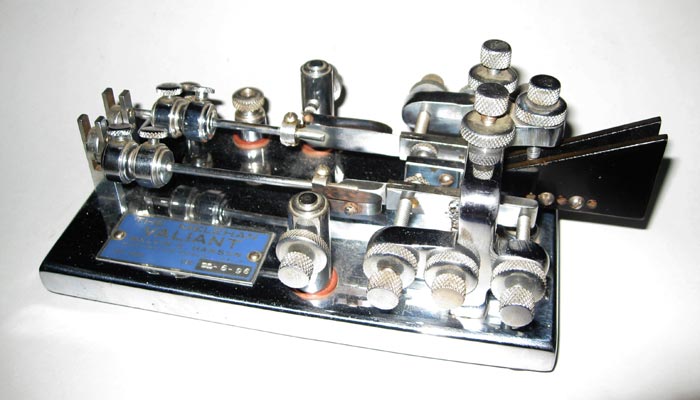
7944 ANOTHER RARE MELEHAN VALIANT FULL-AUTOMATIC KEY (HUNTINGTON
BEACH CALIFORNIA MODEL):(20KB)
A very few of these rare keys were made by Mel Hanson from 1939 to 1959.
It uses two vibrating levers to allow it to make both dots and dashes
automatically. These keys are very hard to find. There is a nice article on
the Melehan in the March, 1942 Issue of QST Magazine.
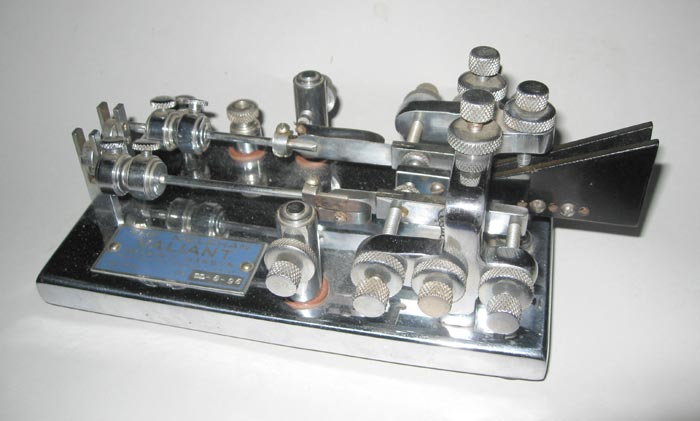
7944a Another view of the Melehan Valiant:
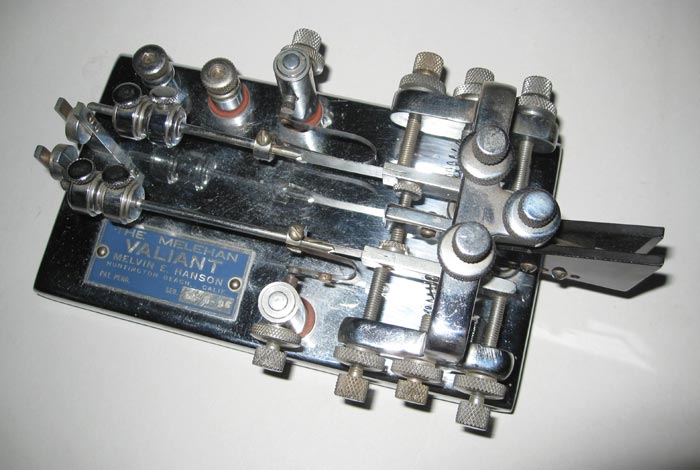
7944b Another view of the Melehan Valiant:
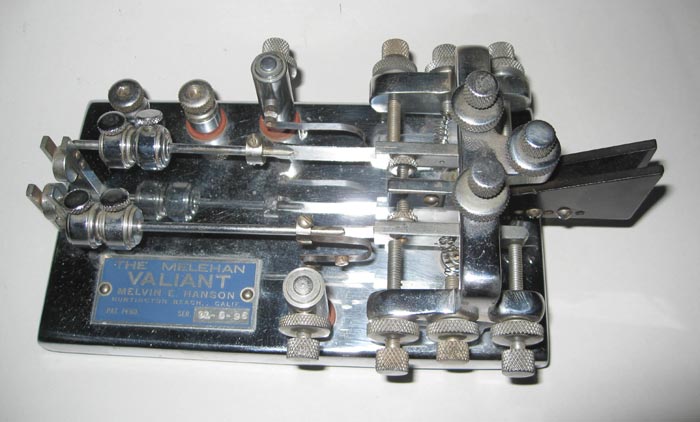
7944c Another view of the Melehan Valiant:
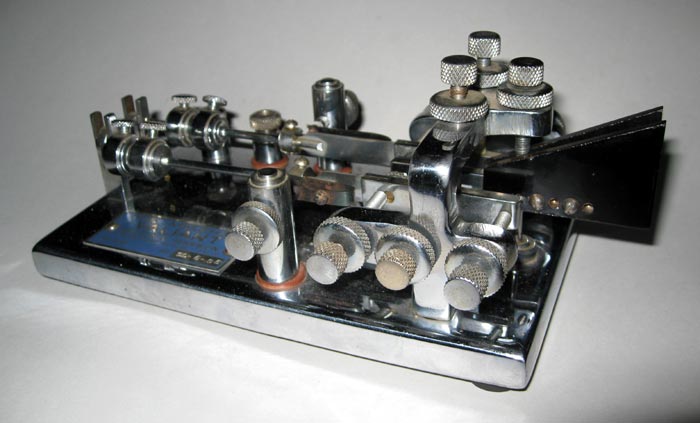
7944d Another view of the Melehan Valiant:
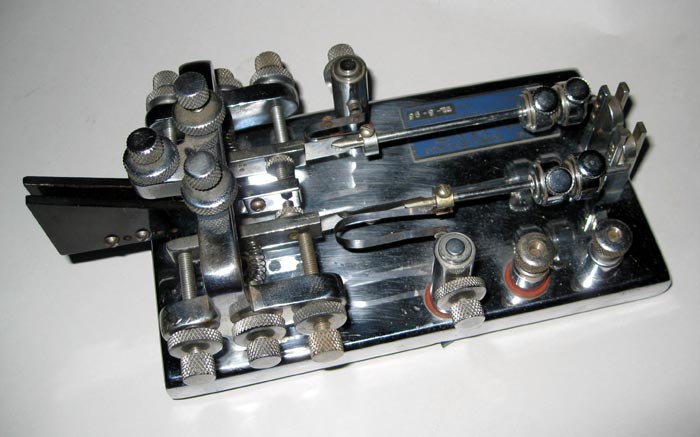
7944e Another view of the Melehan Valiant:
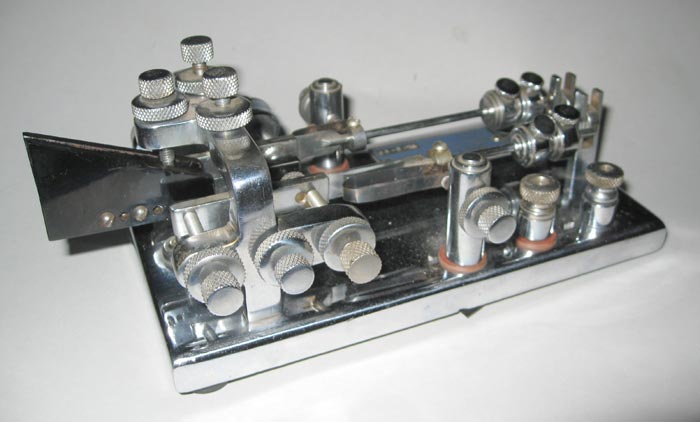
7944f Another view of the Melehan Valiant:
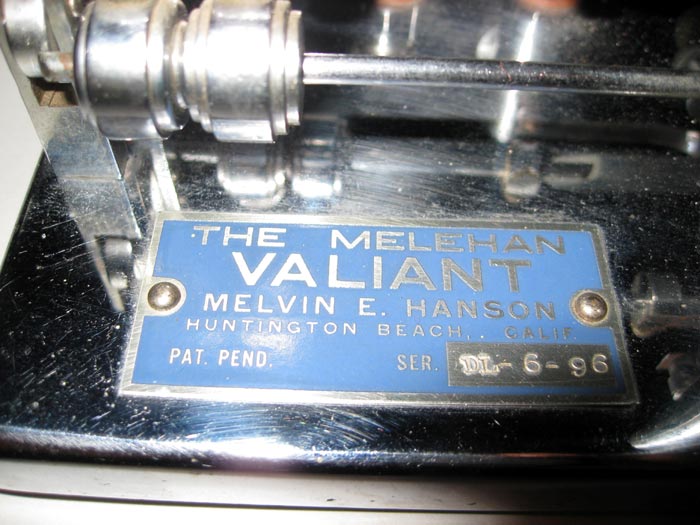
7944g Another view of the Melehan Valiant:
NOTE: For views of two exceptional homemade sub-miniature
1/2-scale Melehan Valiant bugs, please go to the homemade
keys section of this museum and look for number 9841.
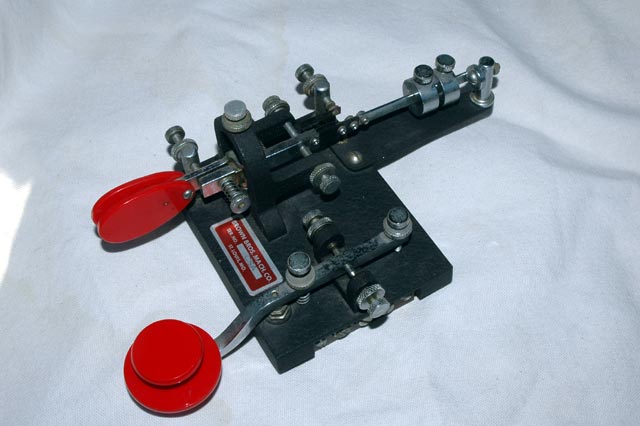
7947 * W1IMQ's EXCEPTIONALLY RARE BROWN BROTHERS
COMBINATION BUG AND STRAIGHT KEY: This is one of the rarest of the
relatively modern bugs. It is not known how many were made but they
are so rare that most collectors have never seen one.
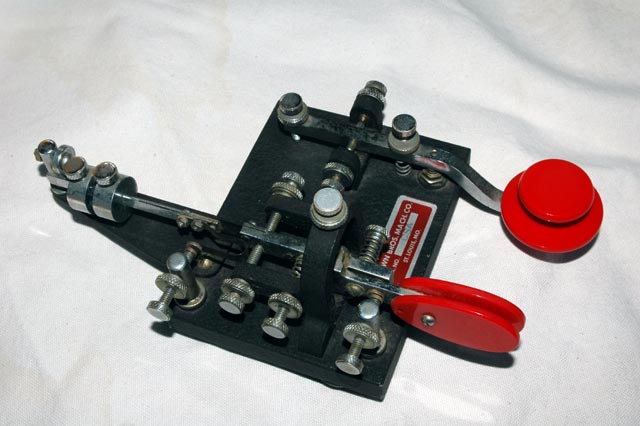
7947a * Another View of the Brown Brothers bug:
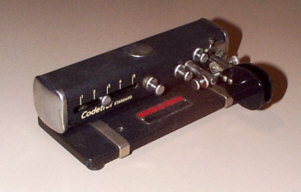
7950 K8DV's CODETROL STANDARD BUG:(12KB)
This very hard to find bug was designed and manufactured by
Bearnard H. Breedlove in Atlanta, Georgia. David Vest, K8DV
has allowed me to include several photographs of his
Codetrol bug in my museum.
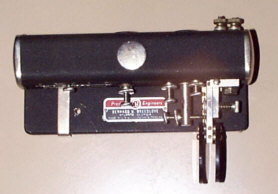
7950a K8DV's CODETROL BUG:(13KB)
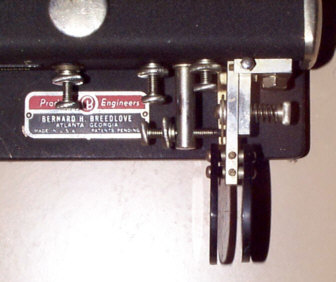
7950b K8DV's CODETROL BUG:(24KB)
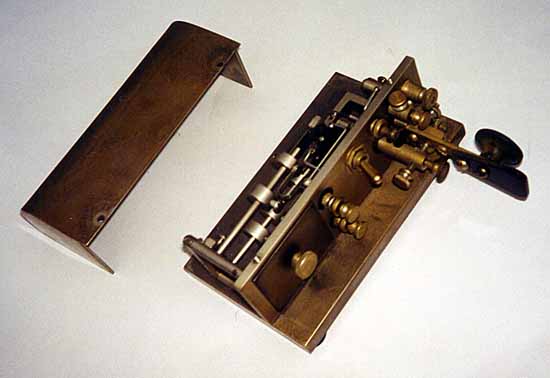
7955 * EXCEPTIONALLY RARE CODETROL DELUXE BUG:(23KB)
This is an exceptionally rare deluxe version of the Codetrol bug.
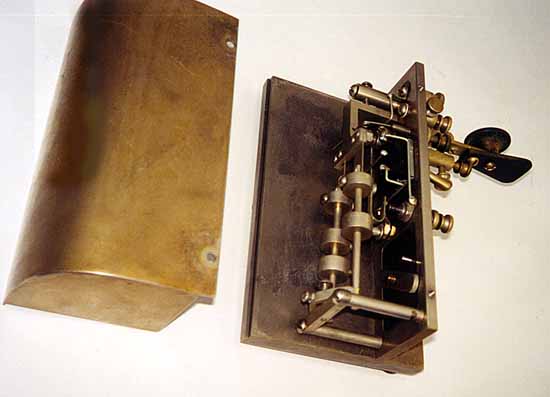
7955a * Another view of the CODETROL DELUXE BUG:(22KB)
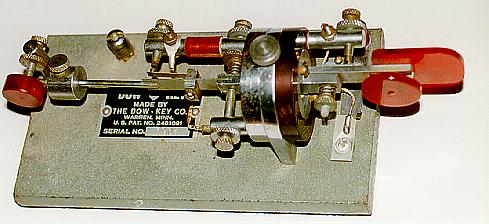
7960 DOW KEY ''UNIVERSAL'' MODEL ROTATABLE BUG:(31KB)
This Grey wrinkle-finish bug with bright red plastic knob and rotating
mechanism can be rotated for right or left handed operation or for use
as a straight key. It is called the ''universal model and it
was manufactured in Warren, MN. This one carries serial number 1904.
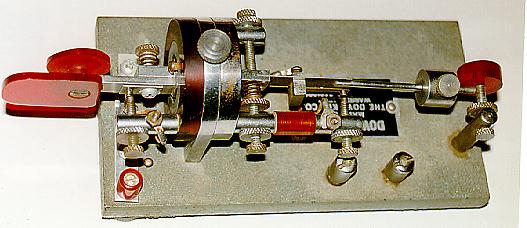
7960a Another view:(32KB)
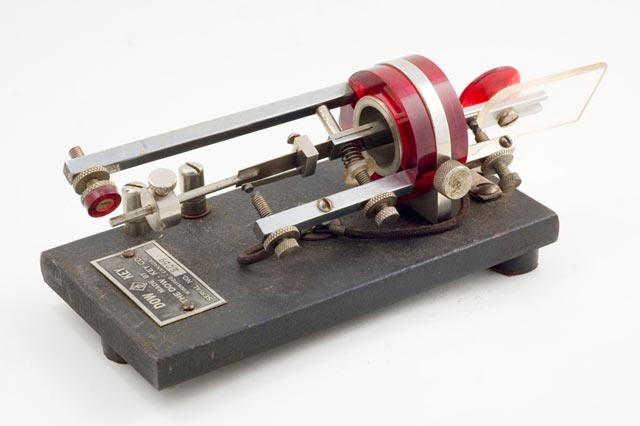
7961 * EARLY FIRST VERSION OF THE DOW KEY ''UNIVERSAL''
MODEL ROTATABLE BUG:
This extremely rare version of the Dow 'Universal' was found by collector
Martin Odenbach who kindly allowed me to display it in this museum. This Grey
wrinkle-finish bug with bright red plastic knob and rotating mechanism can be
rotated for right or left handed operation or for use as a straight key or
angled bug. It was manufactured in Winnepeg, Canada. This one carries serial
number 2059.
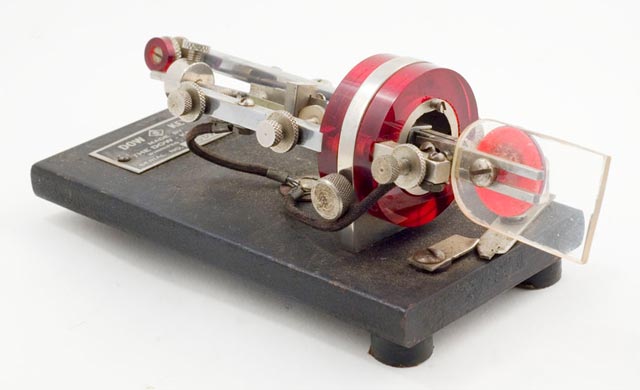
7961a * Another view:
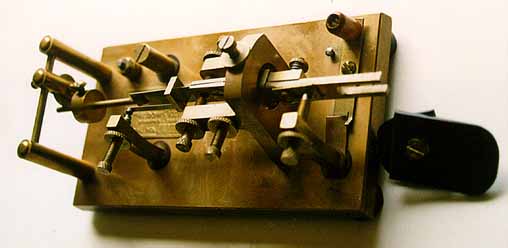
7962 DOW KEY "BENT" BUG:(20KB)
This all brass bug has the frame, lever, pendulum, and posts all
inclined to the right by about 30 degrees. It was manufactured in
Winnipeg, Canada and carries serial number 6022.
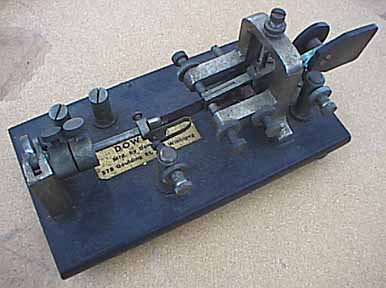
7964 * EARLY VERSION OF THE DOW KEY STANDARD BUG:(20KB)
This is an early version of the Dow Key straight key. It was
found by collector Roger Buttignol at the Rochester, NH hamfest
and he was kind enough to allow me to photograph it.
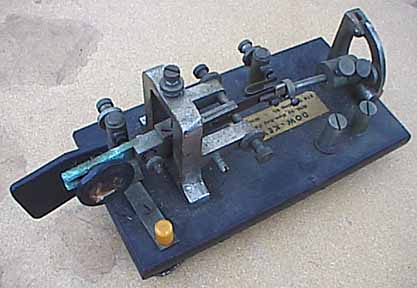
7964a * Another view of the EARLY DOW KEY
BUG:(21KB)
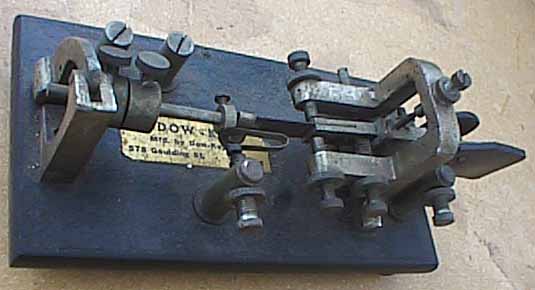
7964b * Another view of the EARLY DOW KEY
BUG:(21KB)
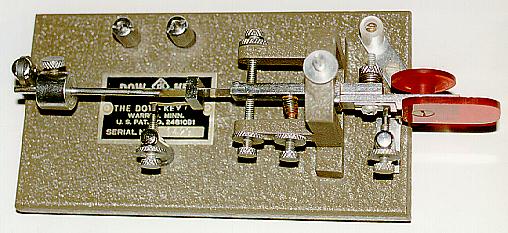
7965 * DOW KEY STANDARD BUG:(38KB)
This Grey wrinkle-finished bug appears to be very similar to a
Vibroplex Original. ->K9WDY.
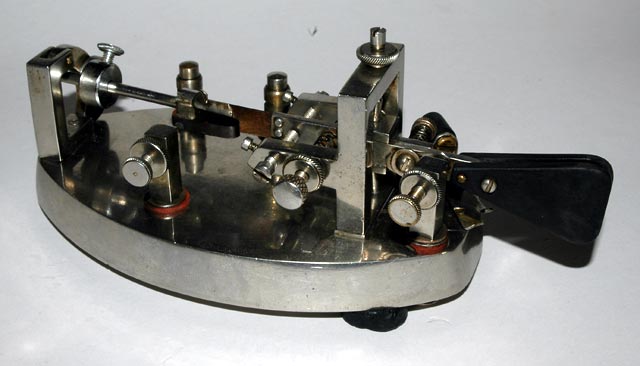
7967a EARLY AND UNUSUAL CANADIAN WILCOX TEARDROP-SHAPED
BUG: This is a very beautiful, well made and unusual bug with a very heavy
teardrop shaped base and very well machined hardware. It is labeled "WILCOX"
on part of the main lever and carries serial number 1223 on both the damper
and one of the contact strips below the base. Since very few of these bugs
have shown up it is virtually certain that they started their serial
numbering at 1200.
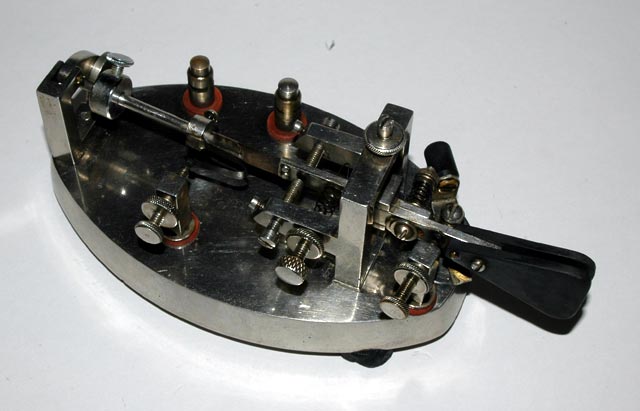
7967b Another perspective of the Wilcox Bug:
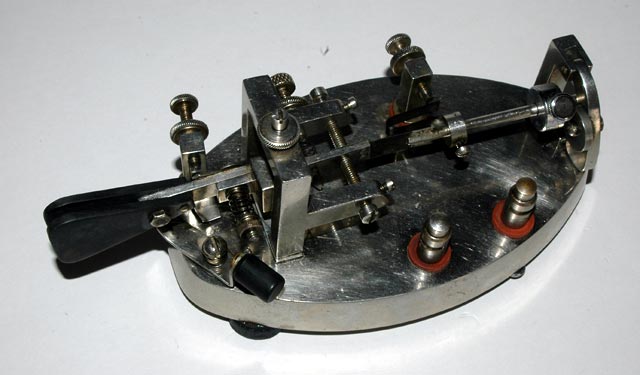
7967c Another perspective of the Wilcox Bug:
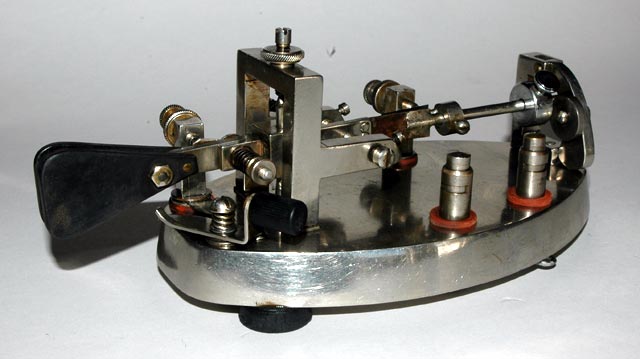
7967d Another perspective of the Wilcox Bug:
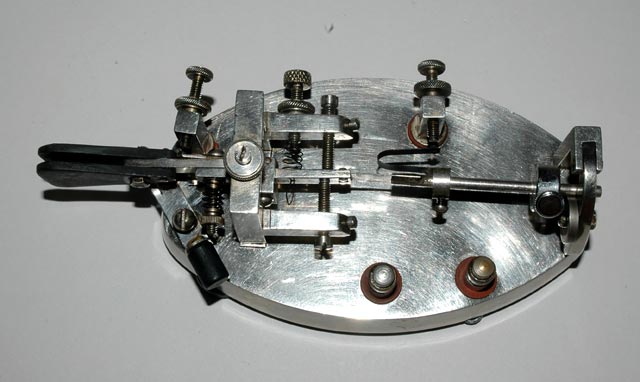
7967e Overhead perspective of the Wilcox Bug:
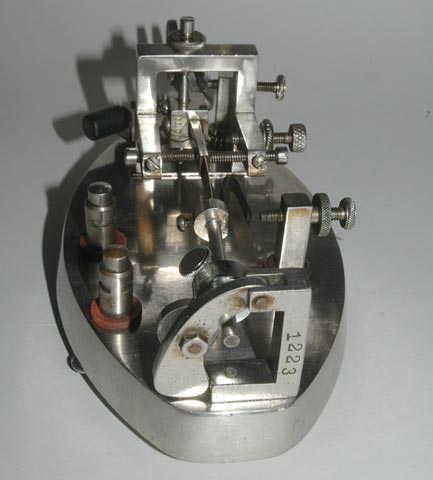
7967f A view of the Wilcox Bug showing the serial number
on the damper and the Wilcox name on the lever:
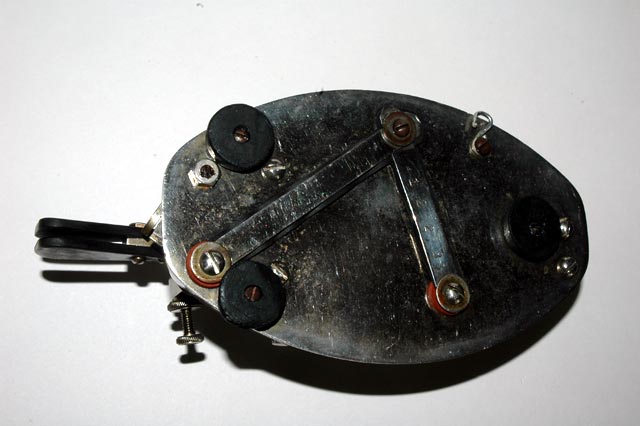
7967g A view of the bottom of the base of the Wilcox Bug
showing the serial number on a contact strip:
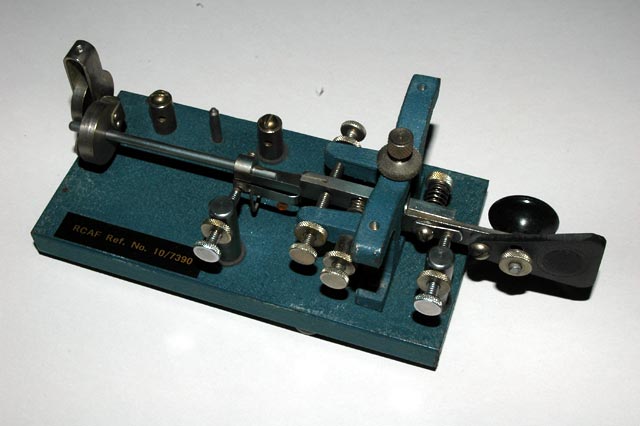
7968 CANADIAN WILSON REVERSIBLE BUG MADE FOR THE RCAF:
This is a very interesting bug made by Wilson in Canada. When thick rubber
feet are mounted over the three holes on top of the frame and damper, the key
may be turned upside down and used as a left-handed bug. The label indicates
that this bug was made for the RCAF and that its RCAF Reference Number is
10/7390.
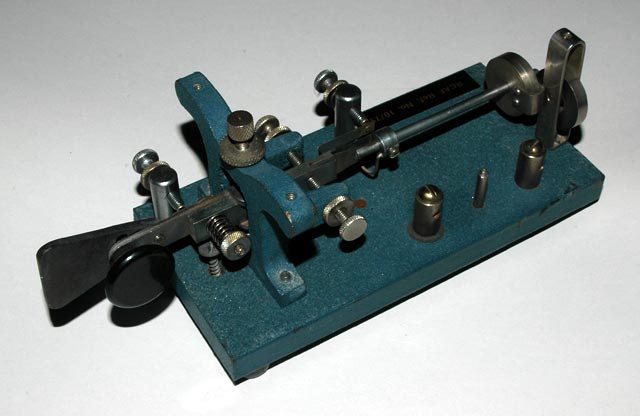
7968a Another Perspective view of the Wilson Reversible
Bug:
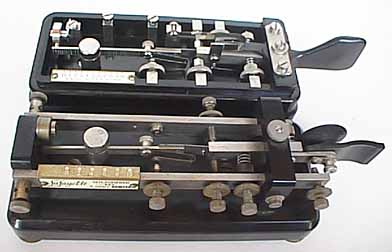
7970 * EARLY AND LATE MODEL JAPANESE SKILLMAN BUGS:(20KB)
See 7980 for description.
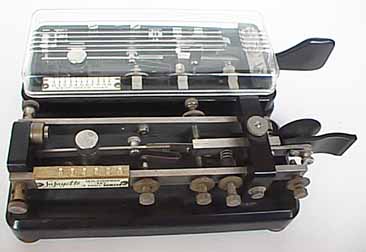
7970a EARLY AND LATE MODEL JAPANESE SKILLMAN BUGS
WITH COVER IN PLACE OVER MORE RECENT BUG:(17KB)
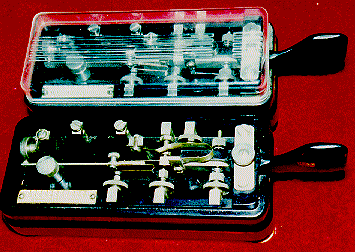
7980 * JAPANESE SKILLMAN BUG:(32KB)
This bug was marketed widely by Lafayette Radio and Radio Shack
in the 1960s. It was manufactured from 1953 to 1968 by
Dentsuseiki which then became Hi-Mound. The word ''Japan''
is usually found moulded into the bottom.
The clear plastic cover is often missing or broken.
It has an excellent ''crisp'' feel when properly adjusted.
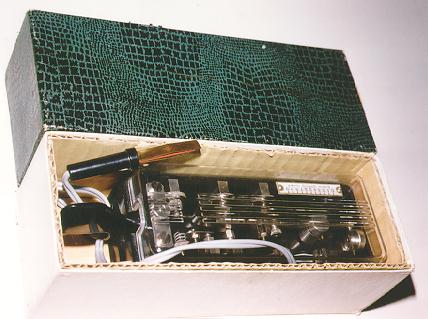
7980a Another view in the original box:(32KB)
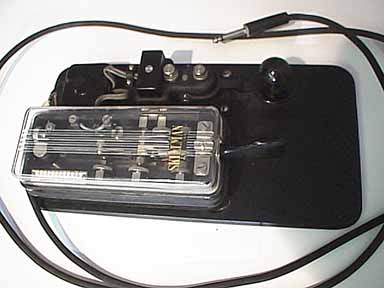
7985 * COMBINATION JAPANESE SKILLMAN BUG
AND AMERICAN NAVY KEY:(20KB)
This set consists of a World War Two Navy straight key mounted
on the same base with a Japanese Skillman Bug and a small
spark suppression resistor/capacitor network. The straight key is
the standard Navy key used throughout WW-2 and the Skillman
bug was marketed widely by Lafayette Radio and Radio Shack
in the 1960s. The word ''Japan'' is usually found moulded into
the bottom. The clear plastic cover is often missing or broken.
It has an excellent ''crisp'' feel when properly adjusted.
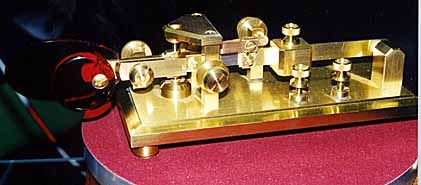
7987 * MODERN AND MAGNIFICENT SCHURR BUG:(18KB)
This magnificent bug is made by Schurr in Germany. The first ones
were introduced in 2000 and the production run is very limited.
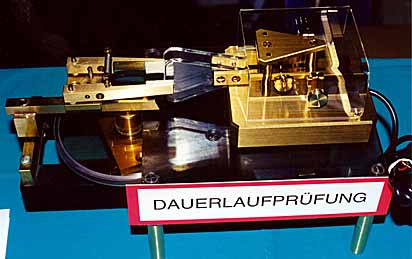
7987a * Special TESTING MACHINE for the Schurr
Paddles and Bugs:(24KB) This machine was designed to allow testing of the
Schurr bug and paddles. It is an electric motor-driven robot telegraph
operator which cycles the key through dots and dashes continually.
</a><br>
<!img src=)
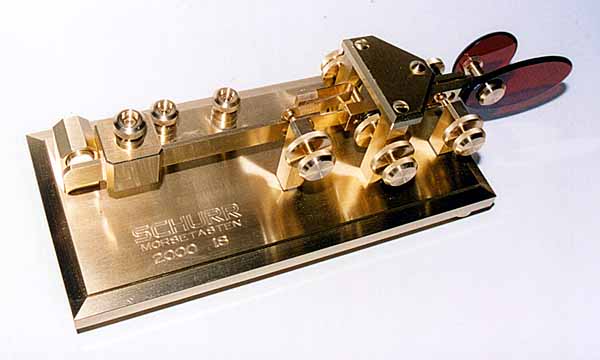
7988 * MODERN AND MAGNIFICENT SCHURR BUG:(27KB)
This is serial number 18 purchased in 2001 at Friedrichshafen, Germany.
It has an amazingly light touch and the main spring allows it to be
adjusted for very low speeds.
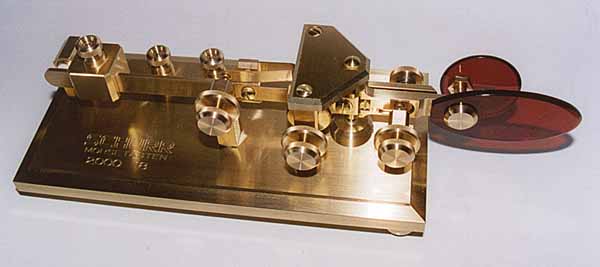
7988a * Another view of Schurr Bug number
18:(19KB)
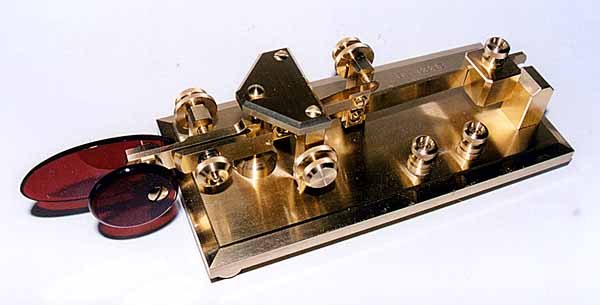
7988b * Another view of Schurr Bug number
18:(25KB)
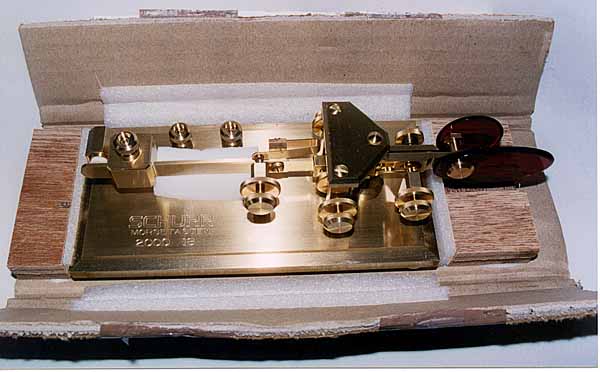
7988c * A view of Schurr Bug number
18 in its original packing:(34KB)
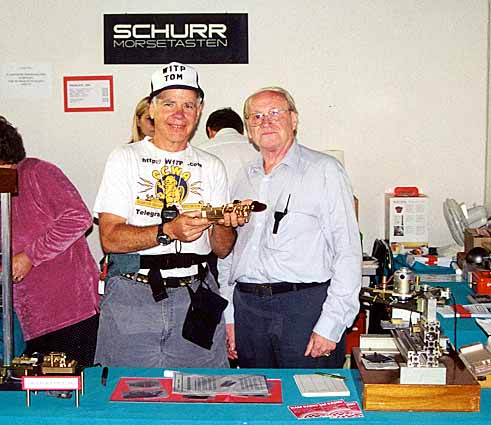
7988d * Tom Perera buying the Schurr bug
directly from its designer/maker, Mr. Schurr at the 2001
Friedrichshafen hamfest in Germany:(42KB)
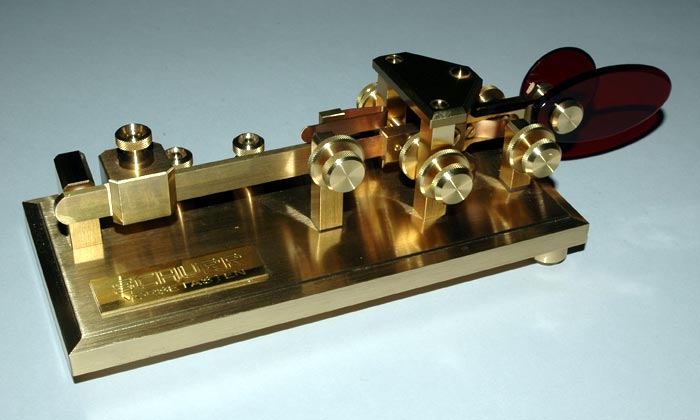
7989 THE MAGNIFICENT 2005 SCHURR BUG:(27KB)
This is a Schurr Bug made in 2005. Like his other bugs, it has an amazingly
light touch and the main spring allows it to be adjusted for very low
speeds.
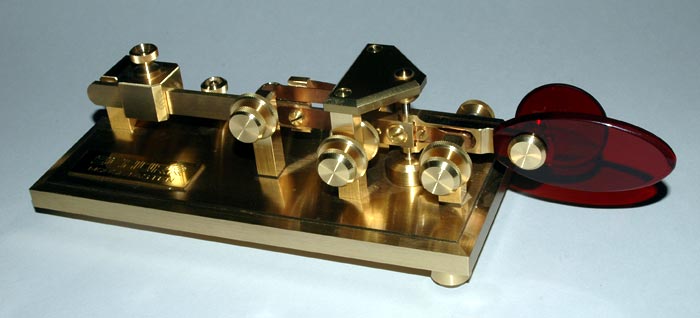
7989a Another View of the Left Side of the
2005 Schurr Bug:
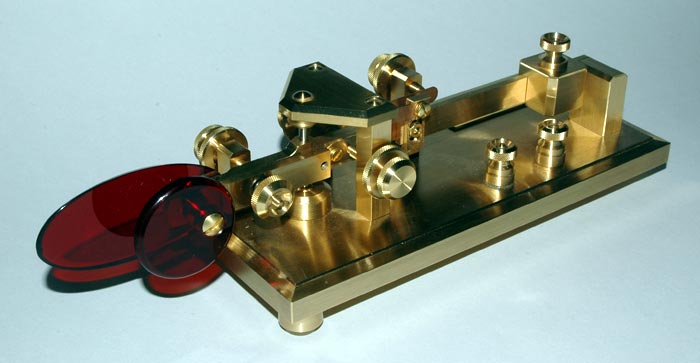
7989f Right Side view of the 2005 Schurr Bug:
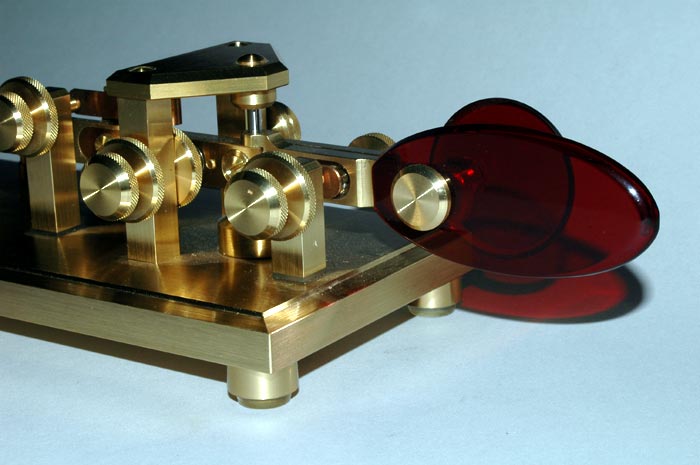
7989h Closer view of the mechanism of the 2005
Schurr Bug:
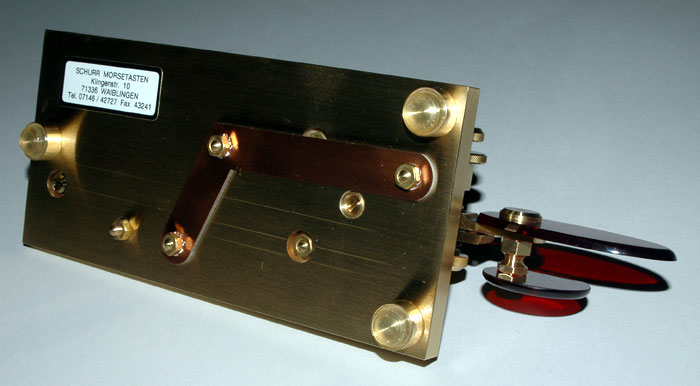
7989j The underside of the base of the 2005
Schurr Bug:
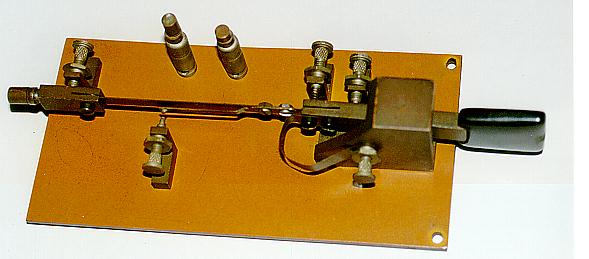
7990 * UNKNOWN BUG:(27KB)
A simple mechanism mounted on a thin bakelite base.
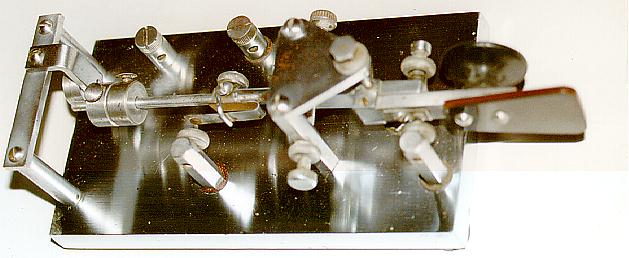
7991 * UNKNOWN BUG:(36KB)
This key looks similar to a chromed Vibroplex Lightning bug.
It is quite similar to the earliest unlabeled Speed-X bugs
which appear to be patterned after Vibroplex bugs.
You may see the similarity of design if you look at this
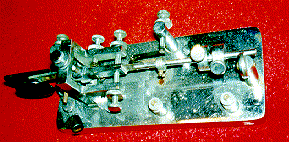
7310 Early Speed-X bug:(23KB)
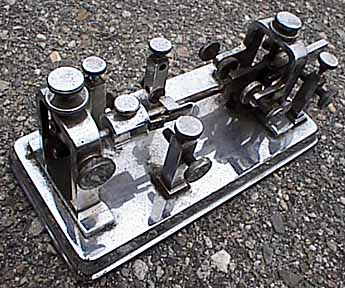
7992 * VERY UNUSUAL UNKNOWN BUG:(38KB)
This extremely unusual bug was found by collector Roger
Buttignol who was kind enough to allow me to photograph it. It
has a very unusual and large damper mechanism.
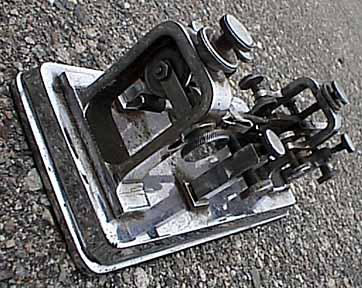
7992a * Another view of the UNKNOWN
BUG:(36KB)
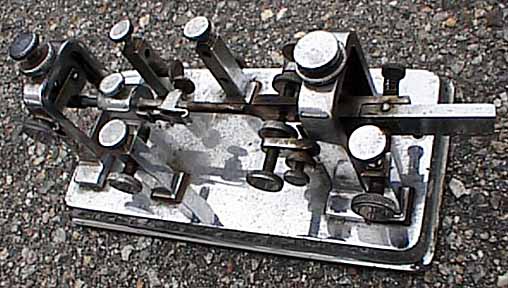
7992b * Another view of the UNKNOWN
BUG:(41KB)
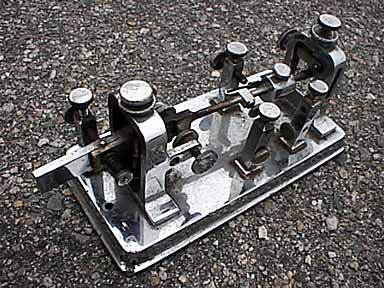
7992c * Another view of the UNKNOWN
BUG:(41KB)
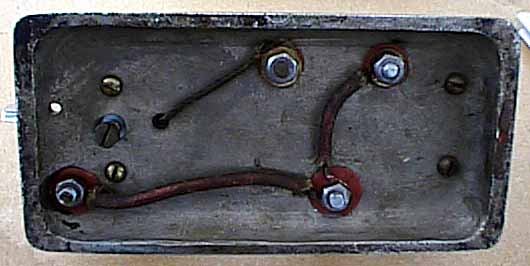
7992d * A view of the Base of the UNKNOWN
BUG:(22KB)
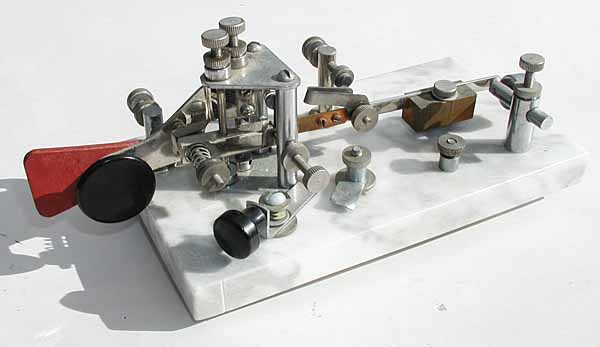
7993 AUSTRALIAN BUZZA BK-100 BUG REBASED ON WHITE
BASE:(27KB)
This is the well known Australian Buzza Model BK-100 bug that has been
mounted on a marble base.
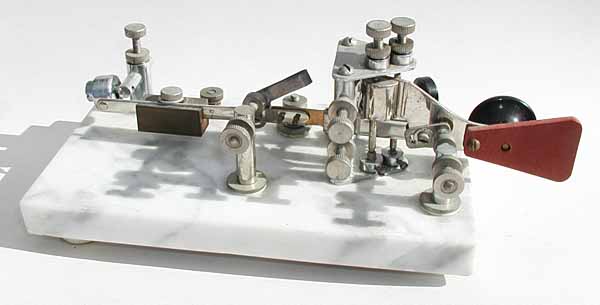
7993a Another view of the Rebased Buzza bug:(28KB)
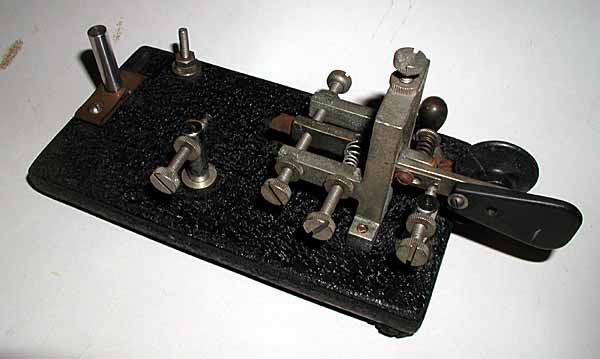
7994 UNKNOWN BUG WITH VERY UNUSUAL KNOB:(28KB)
This unknown bug looks very much like a Vibroplex Original from the
1920's. The hardware, however, is very different from Vibroplex
hardware and, the most unusual aspect of the bug is the round
knob which carries a symbol of a clenched fist with lightning
radiating from its fingers. The cuff of the fist carries the
letters: J. H. I. You can see this symbol in the following
pictures:
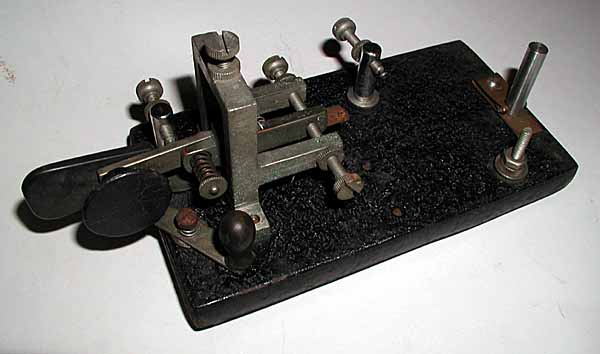
7994a Right-Side View of the Unknown Bug:(27KB)
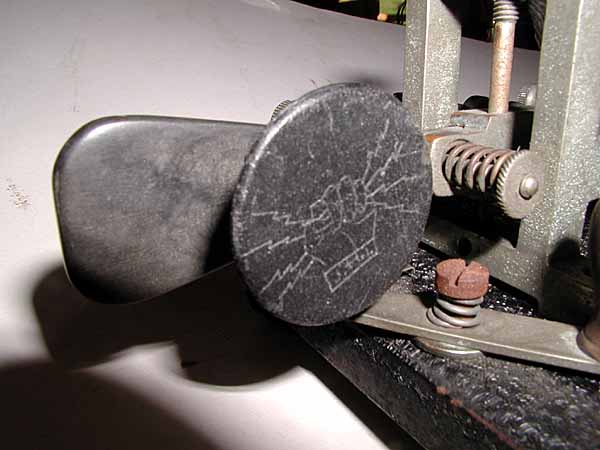
7994b A Closeup view of the unusual knob:(34KB)
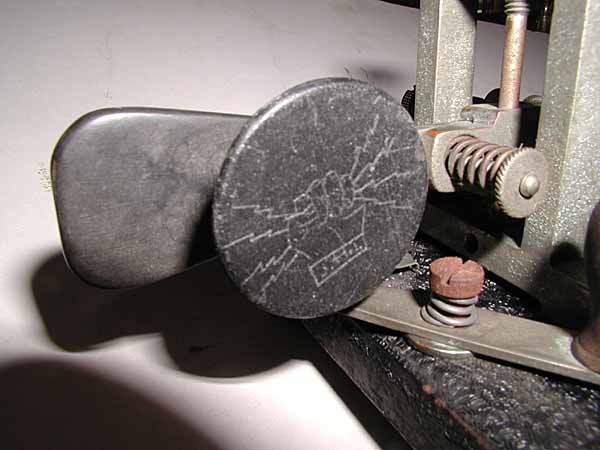
7994c Another view of the unusual knob:(33KB)
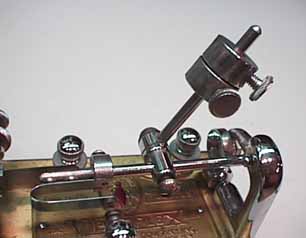
7998 HILLS "VARI-SPEED" SPEED ADJUSTER:(14KB)
These hard to find accessories were manufactured by A. Hills of Dayton,
Ohio. They allowed the speed of a Vibroplex to be changed instantly
without the need to loosen, move, and re-tighten the weights.
Internet ENIGMA Museum:
https://EnigmaMuseum.com
COPYRIGHT NOTICE: (Copyright (c) 2023: Prof. Tom Perera Ph. D.)
Although all the pictures and text are copyrighted, you may use any of them
for your own personal applications including public lectures and
demonstrations, publications and websites as long as you mention the
w1tp.com Museum. If you plan to offer them for sale to the public
in any form, please email me for permission which I will generally grant as
long as you mention my museum: http://w1tp.com or https://EnigmaMuseum.com My email address is
given at the bottom of this page. Some of the material may require contacting
other copyright owners for commercial use and I will inform you by email.
Please also see the Disclaimer of Warranty.
(The instruments are in approximate chronological order: Oldest first.)
* = (Items no longer owned.) ** = (Items in other collections.)
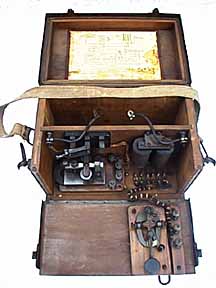
8010 * U. S. ARMY WWI FIELD INDUCTION
TELEGRAPH:(16KB) In a very
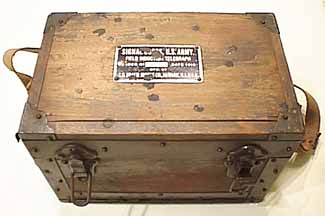
Worn Case(15KB)
labeled: Signal Corps, U.S.Army. Field Induction Telegraph,
Order No. 80191, Date 1918. Mfd. By L.S.Brach Supply Co. Newark, N.J.U.S.A.
This set contains a polarized sounder and induction coil and apparently
detects the very small voltages induced into the ground by the high voltage
transients from the induction coil.
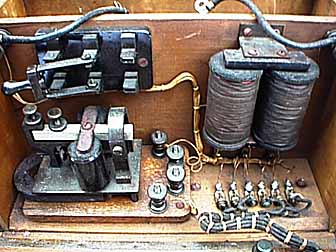
8010b A closer view of the
components:(30KB)
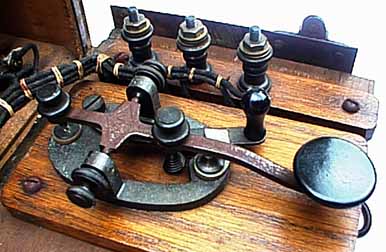
8010c A closer view of the telegraph
key:(29KB)
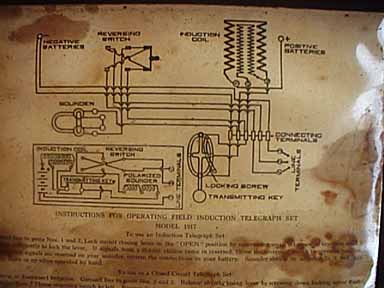
8010d A closer view of the schematic
diagram:(22KB)
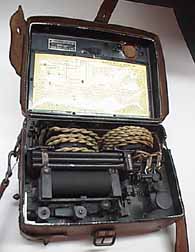
8020 U. S. ARMY WWI FIELD TELEGRAPH SET: (16KB)
In well worn brown leather case marked "SERVICE BUZZER, SIGNAL
CORPS U. S. ARMY, MODEL 1914. Manufactured by Stromberg Carlson
Tel Mfg Co., Rochester, NY IN 1917. A tiny Telegraph key is integrated
into the unit and can be pressed with the cover closed in mud and rain
through a thin leather area on the cover. Includes the original
headphones and hard-to-find adjusting tools.
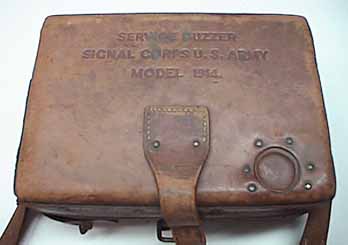
8020a CLOSE-UP OF COVER IN CLOSED POSITION:(12KB)
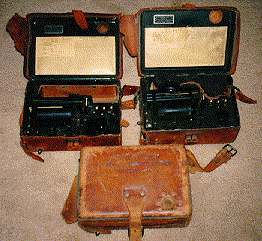
8021, a, b, * Same as above but mfg in 1918:(35KB)
Less headphones & adjusting tools.
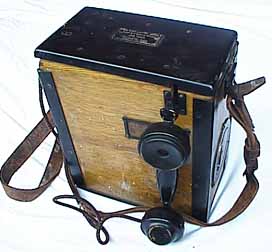
8040 * WWI FIELD TELEGRAPH/TELEPHONE SET: (18KB)
Enclosed in a nicely finished wooden box, this set contains the
same style of key that is found in the WWI 1914 service buzzer set.
The handset hangs on a hook which folds out of the case and there
is a ringing magneto with folding crank handle and battery
compartment for "D" cells. Manufactured by KELLOGG SWITCHBOARD
SUPPLY CO., Chicago, U.S.A.
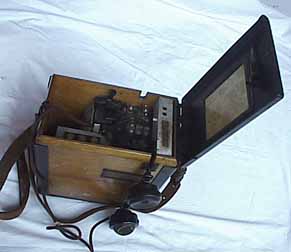
8040a A view with the cover open: (13KB)
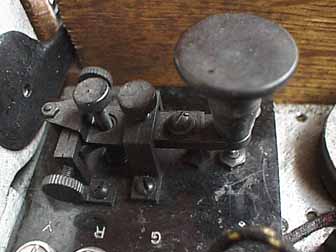
8040b A closer view of the telegraph key: (17KB)
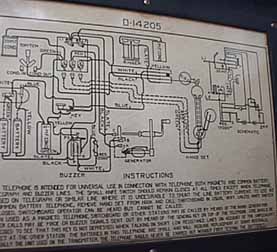
8040c A view of the schematic wiring diagram: (22KB)
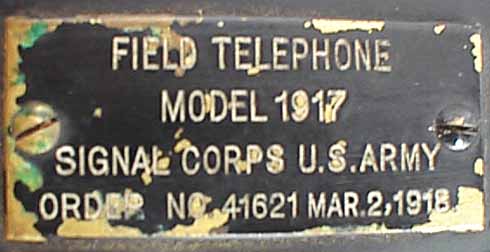
8040d A close view of the label: (17KB)
8042 * Same as above.
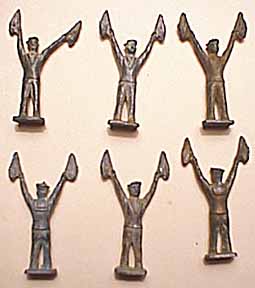
8090 * LEAD MINIATURE NAVAL
TELEGRAPH SIGNALERS:(16KB)This set of miniature sailors holding
telegraph semaphore signal flags was probably used for training purposes.
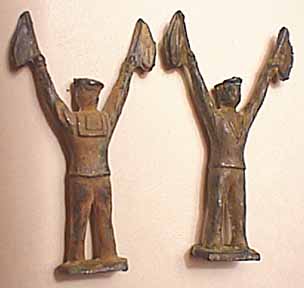
8090a A closeer view of a miniature
sailor:(13KB)
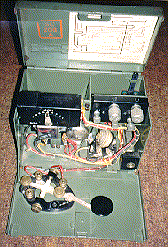
8120 U.S. ARMY WWII TG5A FIELD TELEGRAPH SET:(16KB)
J41A Olive drab metal box with electronic components, swing-down
front with special J-41 key which is similar to a J-37 but with
extra contacts.
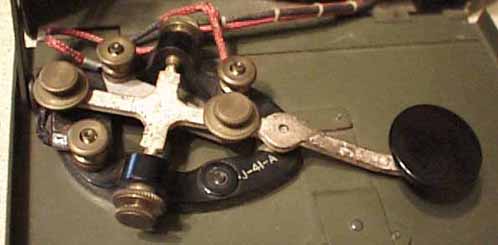
8120a J-41 KEY:(17KB)This key is identical
to a J-37 but it has an extra set of normally-closed contacts at
the far end for use in the TG5A field sets.
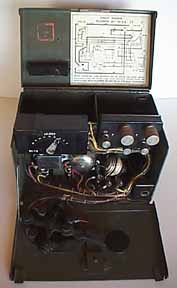
8121 * U.S. ARMY WWII TG5A FIELD TELEGRAPH SET:(12KB)
Similar to 8120.
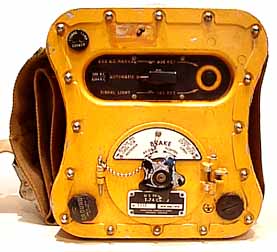
8130 * SCR-578 'GIBSON GIRL' EMERGENCY TRANSMITTER / SOS
KEYER:(20KB)This is the standard emergency transmitter used
throughout WW-2 for sending out distress signals from lifeboats.
It consists of a hand cranked transmitter which sends out automatic
SOS signals or hand-sent code messages with a built-in key. The
transmitter is a nearly exact copy of the earlier German NG-2 NOTSENDER.
It is shaped to fit between the operator's legs and to be strapped
in that position as the operator turns the crank. The box is shaped
somewhat like the female figure and this is apparently where it got its
name.
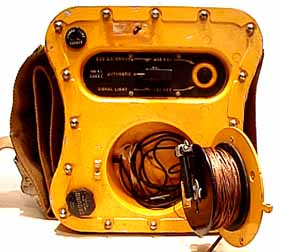
These devices were supplied with a long-wire antenna on a
built-in reel:(20KB)
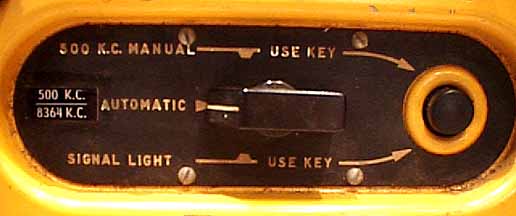
The Front Panel contains a very simple push-button telegraph key
for manual signaling:(20KB)
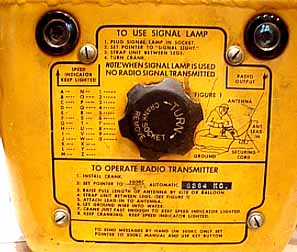
There are detailed Instructions on the operation of the unit:(20KB) printed
on the top.
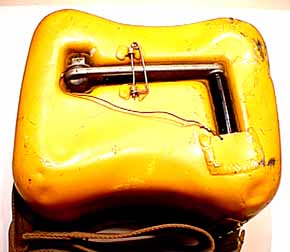
The hand crank is stored in a recess
on the rear of the unit:(20KB)
When I was a young ham radio operator, these radio sets could be bought for
$ 5.00 on Radio Row in downtown New York. They came with a wonderful
kite as well as a number of large balloons and hydrogen generators for
filling the balloons which were used to raise the long wire antenna
several hundred feet into the aid. We used to fill the balloons with
hydrogen by immersing the generators in water. We would then send the
balloons up with a postcard asking the finder to mail the card and tell
us where the balloon came to rest. We sent up a total of 8 balloons
but no postcards were ever returned... This was a big disappointment
for a young boy...
8140 * RT-6 SPY TRANSMITTER WITH TINY BUILT-IN SWING OUT KEY.Tiny
transmitter part of a complete clandestine radio set.
2E26 pwr amp & VY tiny telegraph key which folds out from
case.Traded to Joel Kosoff, W3ZT
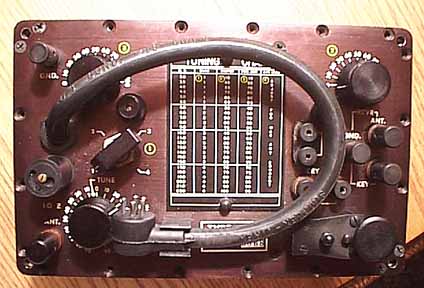
8150 * RS-3 SPY TRANSMITTER WITH TINY BUILT-IN
TELEGRAPH KEY:(35KB) This transmitter is part of a complete clandestine
radio set and the tiny telegraph key is so nicely designed that it is
sometimes removed from the transmitter and mounted on a base of its
own.
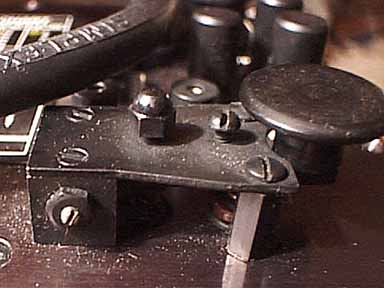
8150a * Close-up view of the tiny Spy key:(20KB)

8160 VERY UNUSUAL AIRCRAFT KEY:(9KB)
Tiny key on 2-1/8 x 1-3/16" parallelogram base Pivoted knob. Removed
from WWII bomber. Extremely unusual. Unknown function.
Looking for more information.
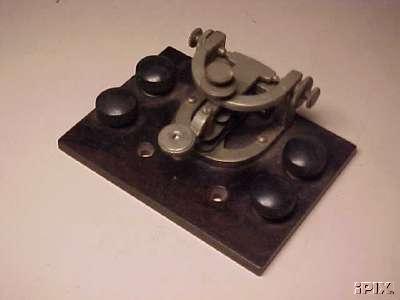
8180 THE MOST UNUSUAL MILITARY KEY
I HAVE EVER SEEN!!:(13KB)
This is an exceptionally unusual key with what would have been
the back portion of the frame mounted above the front portion
of the frame. I suspect that this was done to allow the key
to be mounted against a vertical panel such as you would find
on a radio set. The fact that the key has no shorting switch
is further evidence that it is a radio key and not a land-line
key. I am looking for more information on this weird key.
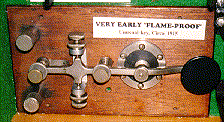
8200 VERY EARLY EXPLOSION-PROOF KEY: (19KB)
This very unusual all plated key integrated onto a wooden base has
its contacts sealed by a rubber diaphram in a 1-1/2 inch diameter
metal cylinder to prevent sparking in explosive atmospheres.
It was typically mounted on the front of the BC-9 Transmitter.
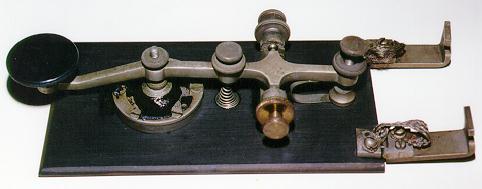
8201 * EARLY EXPLOSION-PROOF KEY FROM BC-9:(16KB)
This example of the key shows the mounting hinges for the BC-9 panel.->W2PM
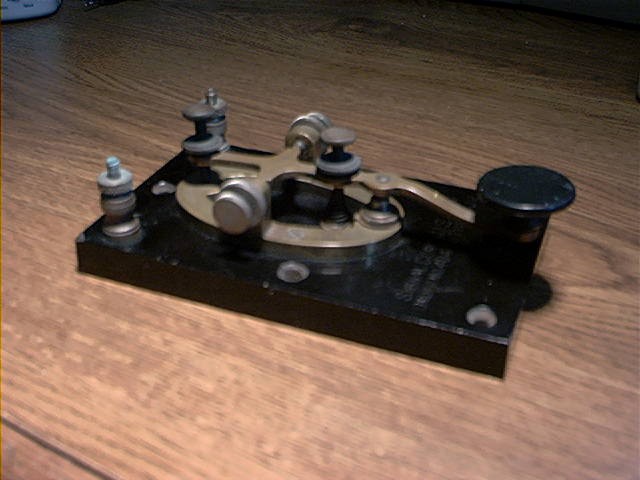
8211 ** J-2 WORLD WAR I MILITARY KEY:
This WW-I Spark key has the familiar oval nickel plated frame
with coil spring running into hole in frame near the HEAVY
DUTY 1/4" unscrewable contacts. No Shorting lever. Key mounted on a
1/2" thick 5-1/2 X 3-1/4" bakelite base with all wires totally sealed in
base. Marked: "SIGNAL CORPS, US ARMY Order No. 40416, Type No. J-2"
on top of bakelite base and stamped SC105A in red ink on
side of base. It was made by MESCO (Manhattan Electric Supply Co.) as
indicated by the stamped 'MESCO' on the oval frame. Photos courtesy of
Collector K8OMO.
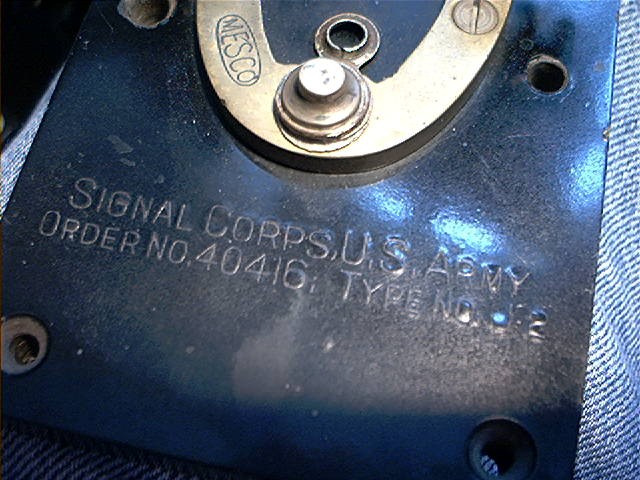
8211a ** A closer view of the lettering on top of the
base:
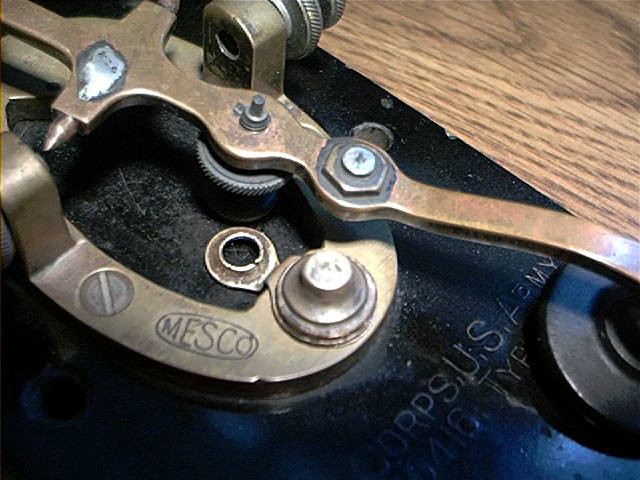
8211b ** A closer view of the MESCO label on top of the
oval frame:
8211c ** The bottom of the base of the J-2
Key:
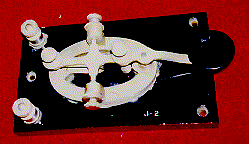
8210.gif Another J-2 World War I Military
Key:(15KB)
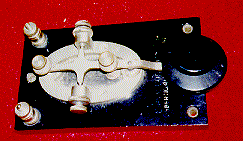
8212 * J-2 MILITARY KEY:(12KB)
Similar to 8210 but made by Signal Electric Company with
company name stamped into base.
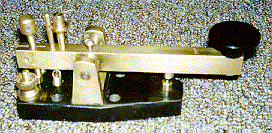
8220 J-6 L.S.BRACH MILITARY KEY: (25KB)
Incorrectly advertised and sold widely as a J-3, this key has a
straight, heavy 1/2 X 3/8 X 5-1/4" brass lever with typically-
British design pull-down spring at far end of pivot. The base is
1/2" thick, 4" long, and 1-3/4" wide and tapers down to 5/8" wide
from pivot toward knob.
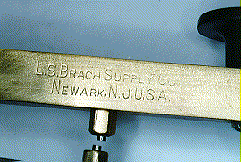
The lever is stamped(20KB):
L.S.BRACH SUPPLY CO. Newark, N.J. U.S.A. The Bottom of the base
has a 1 X 1" painted square with A-12 and an upward-pinting arrow
inside. The wires are sealed inside the base.
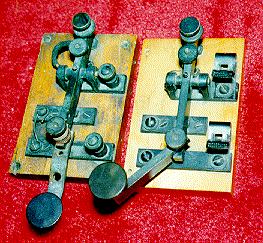
8230 * J-3 WORLD WAR I MILITARY FOLDING KEYS:(42KB)
These keys are often found with either Fahnstock clips or screw-in
terminals. They have a lever that swings to the side. The keys were
used inside a field set that I am still trying to locate and identify.
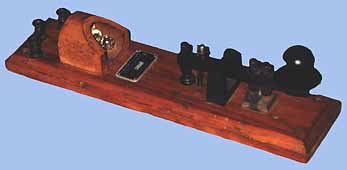
8235 ** J-4 SILENCED INSTRUMENT KEY / SET:(9KB)
This unusual key is silenced by placing rubber bunpers on its contacts
and adjusting screws. It was probably used as a practice key and the
clicks were eliminated to avoid bothering nearby students in a large
classroom. An alternative explanation comes to mind since this one is
mounted on a board with a light. It may have been used to train
operators to copy light signals and the silenced contacts prevented them
from copying the sounds, forcing them to concentrate entirely on the
light signals. (This key is in the Pete Malvasi - W2PM collection.)
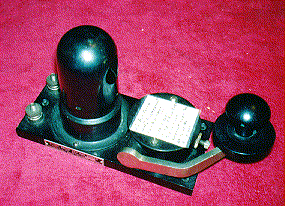
8240 J-7 FLAME PROOF KEY AND WINKER: (34KB)
Type C.Q.1140 Serial No. (blank) mfg by INTERNATIONAL RADIO
TELEGRAPH COMPANY. This set consists of a flameproof key similar
to the J-5-A mounted on a black bakelite base along with a metal-
enclosed light socket. Peter, G4TFH has found a description of this set in
Radio Communications Pamphlet No.13 from 1918 for the SCR-73 using the
RT-4 transmitter.
It reads: "SENDING KEYS AND WINKER LAMPS.- The three sending keys are the special flameproof
type embodying a heavy construction and having an adjustable gap. A bayonet type socket
for a winker lamp Is mounted on the base of each key and a spun metal cap provided to protect it.
The lamps used are special 130-vo1t Mazda type and they are connected in parallel with the key.
A lamp is then on when the key is open and off when the key is closed. It thus serves simultaneously,
the purposes of giving an indication by the brilliancy of the filament as to the voltage being delivered by the
generator, of notifying either pilot or observer when the other is sending signals so that he will not use his
key and interrupt, and perhaps of assisting the operator in properly sending code by providing him with a
visual Indication of the spacing of dots and dashes."
"Elsewhere in the text was mention that the pilot had two keys, one on either side of the cockpit,
the observer in the back seat only had one." It is unclear why the pilot would need two keys and the
observer only one.
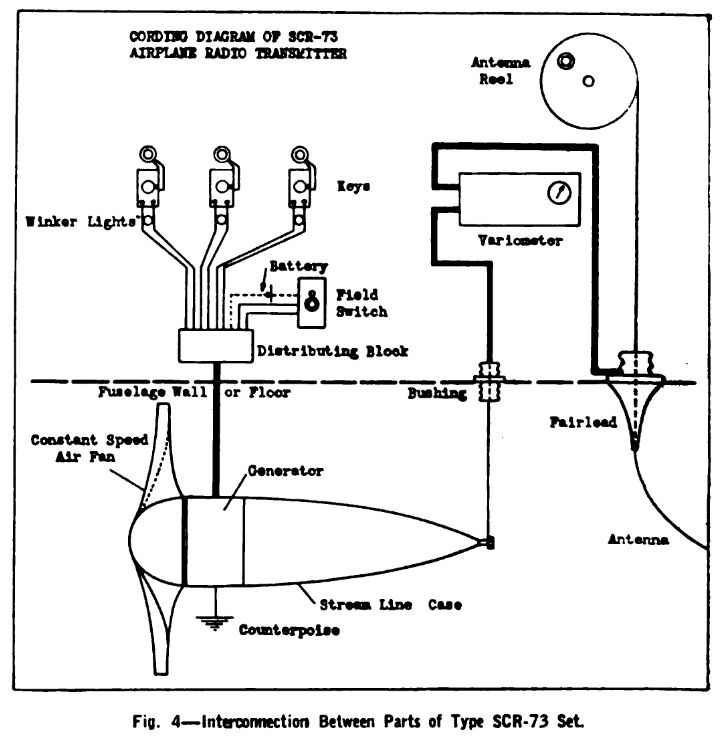
The booklet also included a wiring diagram of the transmitter installation showing the three keys and the wind-driven generator...
8244 FLAME PROOF KEY AND WINKER: As above with J-5 key Manufacturedd
by General Radio. 8248 FLAME PROOF KEY AND WINKER: Slightly
smaller version of #8240.
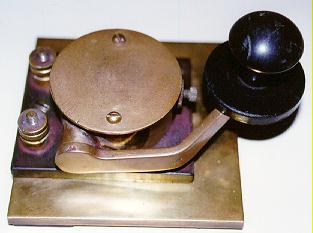
8250 AIRPLANE FLAME PROOF RADIO KEY:(14KB)
Similar to J5A below but all brass with cover labeled:
Airplane Flame Proof Radio Key Type CAG 1169. Made for Navy
Department BU of SE. General Radio Co. Cambridge Mass.
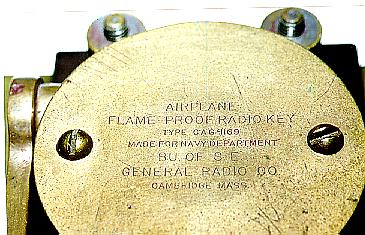
8250a A closer view of the nameplate/cover:(31KB)
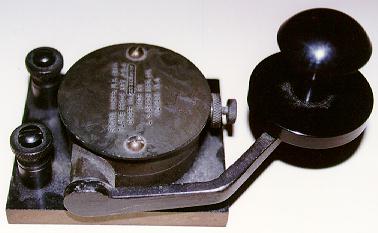
8260 FLAMEPROOF KEY J-5-A:(17KB)
Round cylindrical sealed key with large doorknob style knob.
Cover marked: SIGNAL CORPS. U. S. ARMY. FLAME PROOF KEY J-5-A.
Order No. 583-Phila-42. Made by L. S. Branch Mfg. Co. Newark, N.J.
8262, 8264 * Same as above. Order Number 2670 NY 41.
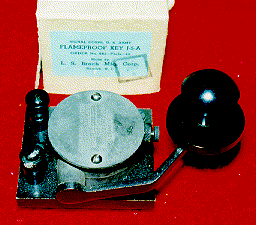
8266 * FLAMEPROOF KEY J-5-A:(20KB
Same as 8262 above IN ORIGINAL BOX.
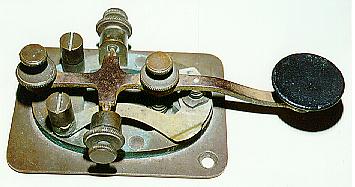
8270 U.S. ARMY J-12 KEY:(18KB) This brass key is
riveted to a rectangular metal base and stamped J-12.
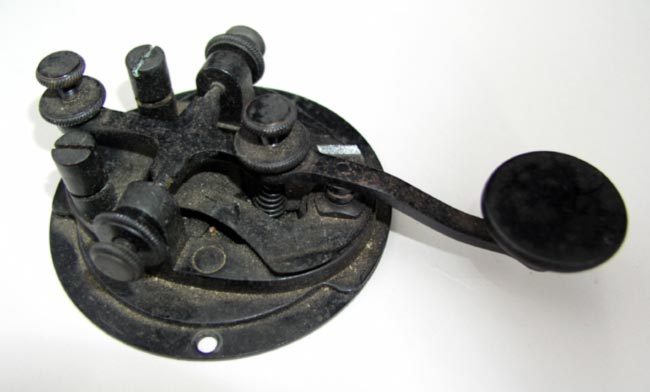
8272 * U.S. ARMY J-12 KEY ON ROUND BASE: This brass key is
mounted on a round metal base that allows it to rotate. The key is stamped
"TELEGRAPH KEY J-12". These photographs were sent to me by another
collector.
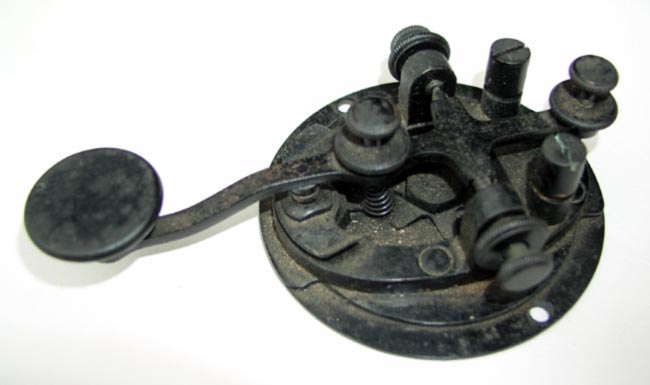
8272a * Another view of the round-based J-12 key
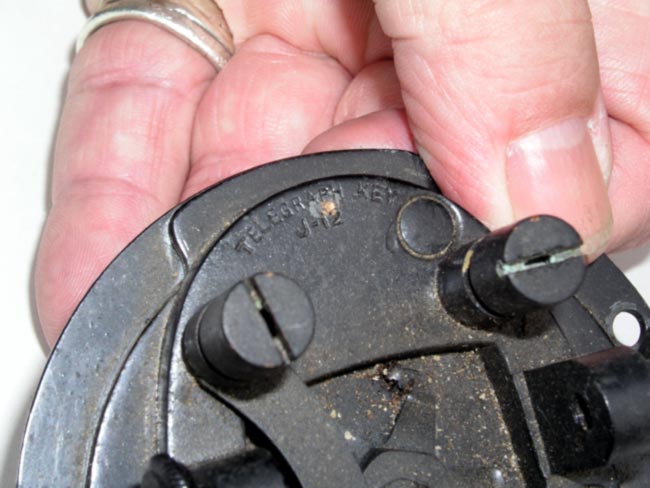
8272b * A close view of the stamped lettering on the
round-based J-12 key
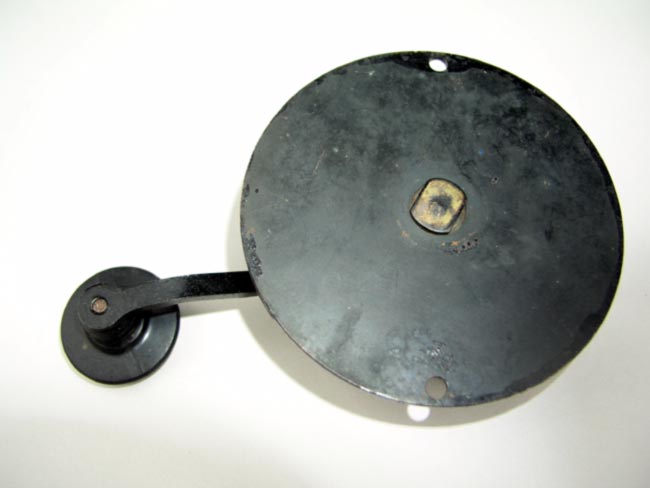
8272c * A view of the bottom of the base of the
round-based J-12 key
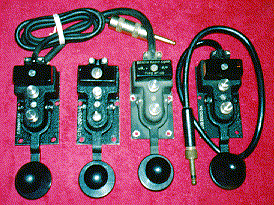
8280 U.S. NAVY FLAMEPROOF GENERAL PURPOSE KEY
XXX-26003A:(38KB)
This is the widely used navy key with the "Navy Knob", a doorknob
style knob with flat base under it. Made for the navy by several
manufacturers whose code letters precede the model number.
For instance, CJB-26003A was made by J. H. Bunnell. CTE-26003A was made
by Telephonics. CMK-26003A was amde by McElroy, etc. It was apparently
copied from the German Luftwaffe Key of very similar design
(See German Keys.).
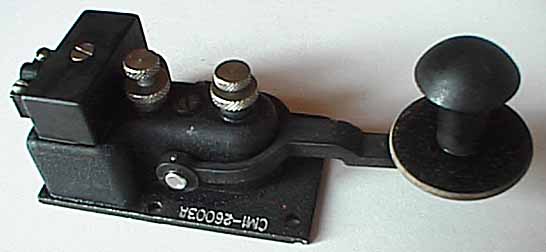
8280 Another view of a CMI-26003A Navy key:(16KB)
The CMI indicates that it was made by the Moulded Insulator Co.
8282,8284 * Same as above CTE-26003A.
8286, 8288 * As above - not labeled.
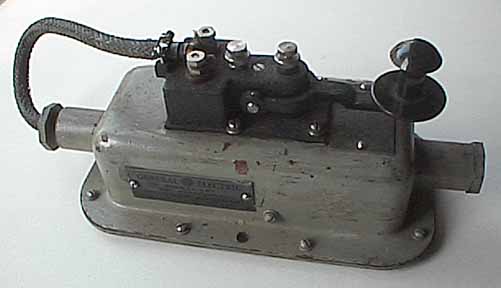
8290 * SWITCHBOX MOUNTED NAVY FLAMEPROOF KEY:(16KB)
Same as 8280 above but mounted on large shipboard style grey box with
label: GENERAL ELECTRIC SIGNAL KEY Cat 8259229G2 Type CMI-26003A with
capacitor.
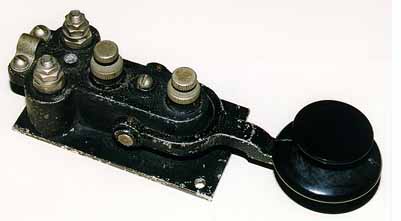
8295 UNUSUAL VARIANT OF THE NAVY FLAMEPROOF GENERAL
PURPOSE KEY:(15KB)This key carries no identifying marks of any
kind. It is very similar to the American and German keys of similar
design but the rounded protrusions on either side are different.
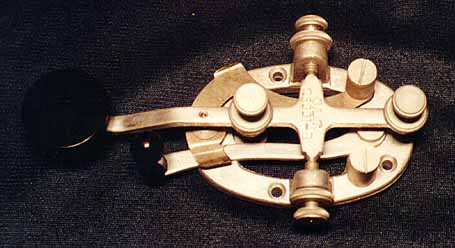
8298 NAVY CLT-26001B GENERAL PURPOSE KEY:(23KB)
This key was made by the Lundquist Tool and Manufacturing Co. of
Worcester, Mass in 1942 as shown by:

The Label on the original box:(8KB)
8310 "LIONEL" MILITARY BUG (Semi-automatic key) J-36. (See # 7920)
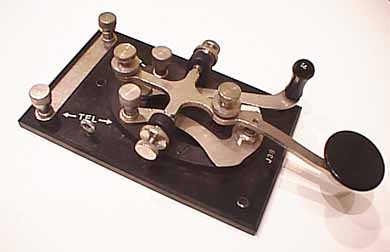
8315 RARE McELROY MILITARY J-38 STRAIGHT KEY:(16KB)
This is the key that McElroy Electronics Co. built for the
U.S. Military. The only known example was in the McElroy collection
until a small number of them showed up at the 1999 Dayton hamfest.
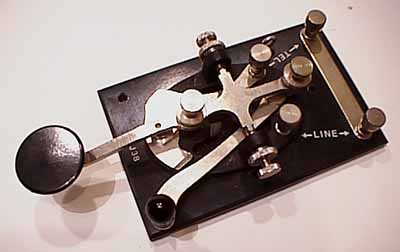
This is another view of the key:(16KB)
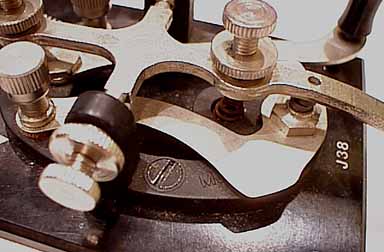
This is a close-up view of the M in the work
McElroy as it appears under the hot contact strip:(23KB)
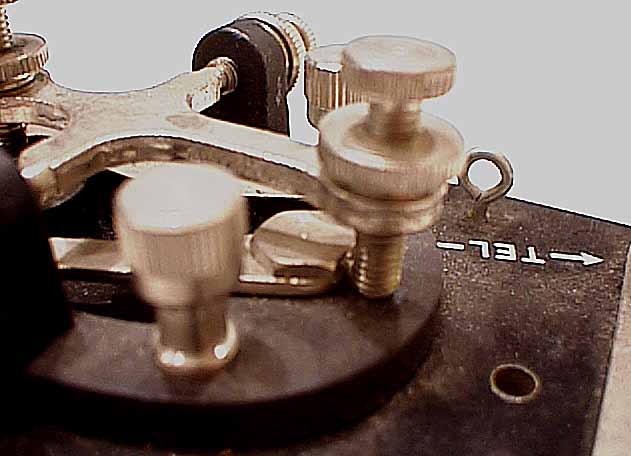
This is a close-up view of the narrow clearance
between the shorting lever screw and the gap adjusting screw:(35KB)
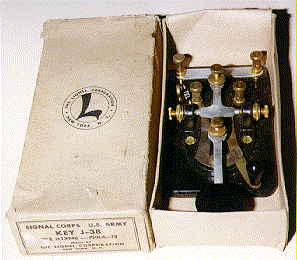
8320 "LIONEL" MILITARY GENERAL PURPOSE KEY J-38:(12KB)
This is the straight key which was manufactured for the military by
the Lionel Toy Company during WWII. It has a solid black cast metal
base which carries the (L) symbol and is marked "The Lionel
Corporation, New York, N.Y. in the center of the top. Most examples
have brass hardware and shorting levers and a steel lever and are
mounted on a black bakelite base which is inscribed J-38 and
includes "Line" and "Tel" terminals. The bottom of the base usually
has
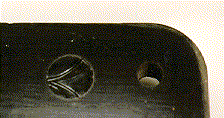
a large letter "L" cast into it.(13KB)
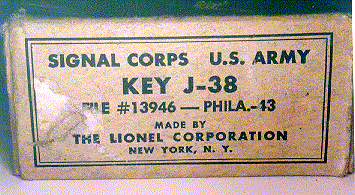
This is the label on the end of the Lionel J-38
box:(42KB)
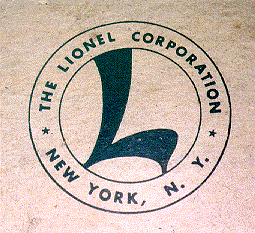
This is the logo on top of the Lionel J-38
box:(30KB)
8322, 8324, 8326. * Same as above in varying conditions. 1 with base missing.
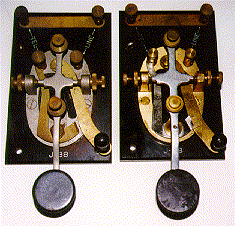
8340 MILITARY GENERAL PURPOSE KEY J-38:(23KB)
This is a widely used WWII military key. Nickel plated key with
shorting lever mounted on a black bakelite base with squared
corners inscribed J-38, & with "Line" and "Tel" terminals.
8342, 8344, * As above with brass shorting lever & screws. Some w/o base.
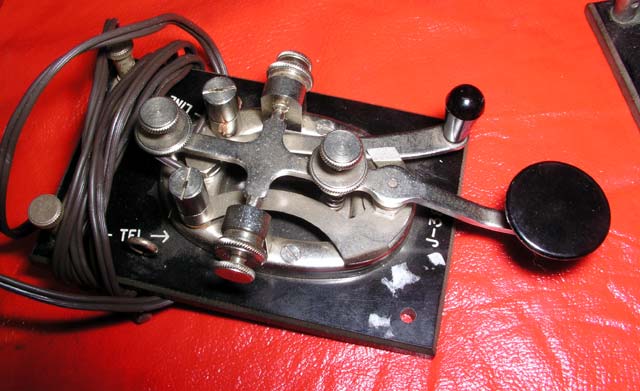
8350 UNUSUAL VERSION OF THE MILITARY GENERAL
PURPOSE KEY J-38:(23KB)
This key appears to be made of Stainless Steel. Unfortunately, it is
not possible to identify who made it or why they used a hollow base and
stainless steel.
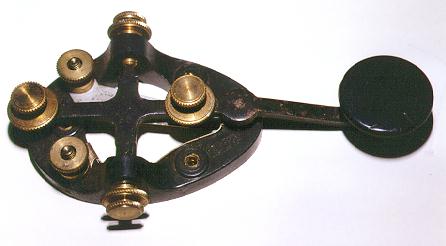
8360 MILITARY GENERAL PURPOSE KEY J-37:(16KB)
This is probably the most widely used of the WWII military keys.
The key has a black ovoid plastic base inscribed J-37 & either brass
or plated screws. The levers are plain laquered, nickel plated or
black anodized steel & the keys are either unmounted or mounted on
black bakelite bases.
8362, 8364, 8366. * Same as above with no base plate.
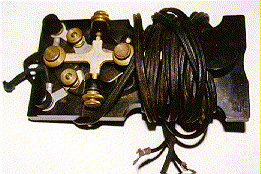
8368 J-37 KEY ON CODE PRACTICE SET BASE:(18KB)
This key was used with a military code practice set and its base
allowed the wire to be wrapped around the center of the base for storage.
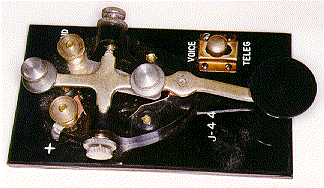
8370 J-44 KEY SET:(16KB)
This set consists of a J-37 key mounted on a J-44 base
with a switch for "voice" or "telegraph" modes.
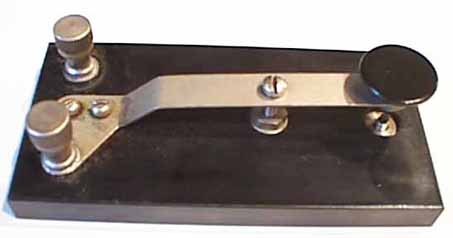
8380 MILITARY LIGHT SIGNALLING KEY J-46: (14KB)
Very unusual small rectangular based strap type key in original
1942 box. Used for light signalling. Mfg by Winslow.
NOTE: The Navy Code designation for the Winslow Company is CAKU.
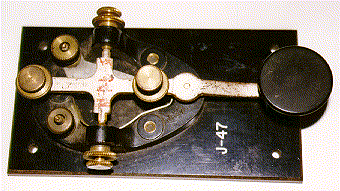
8390 MILITARY GENERAL PURPOSE KEY J-47:(33KB)
This is a J-37 on a black base marked J-47.
8392, 8394. * Same as above.
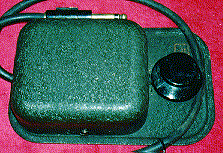
8420 J-48 SIGNAL CORPS FIELD RADIO KEY: (24KB)
This is an oval-based metal key mounted on an olive drab wrinkle finished base
w/matching cover.The cover has a clip for the PL-55 1/4 inch phone
plug. This key was used with many of the field sets such as BC-654.
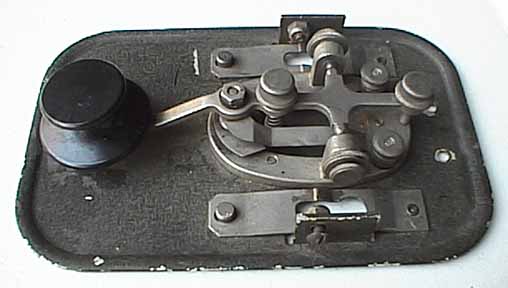
8420a A view of the J-48 key with
cover removed:(21KB)
8460 WW-2 MILITARY STRAP-ON-THE-LEG KEY: This is a special J-37 key with
profile narrowed by placing pivot adjustment screws locking collars on
the inside of the support posts. The key is enclosed in a steel box with
galvanized base and black painted cover. Two leg straps are attached to
the bottom of the box and used to attach the key to the leg of the
aircraft or tank radio operator. Cotton covered electrical cable with
PL55 at the end.
8462 * Same as above.
8464 * Same as above with leg straps and wire missing.
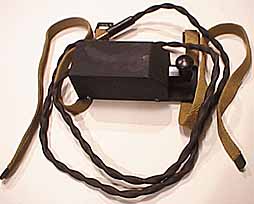
8470 BUNNELL WW-2 MILITARY STRAP-ON-THE-LEG KEY:(25KB)
This is an unusual variation of the above key. The metal box is
somewhat larger but the key is entirely different. It has a doorknob
style knob and looks like a very large version of the British 8 Amp key.
It is all brass integrated onto the black plastic base which is
marked "J.H.Bunnell & Co. New York, USA". The knob is marked:
KEY AND PLUG ASSEMBLY NO. 9.
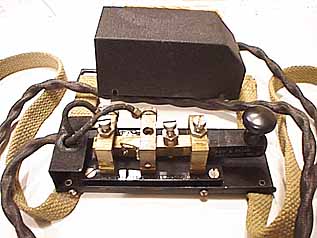
8470a View of the key with the cover removed:(23KB)
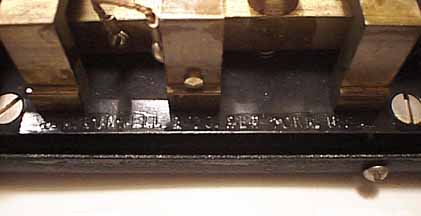
8470b Close-up view of the Bunnell Label:(14KB)
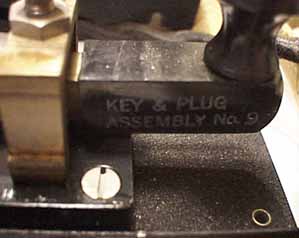
8470c Close-up view of the knob showing the
ID marking:(14KB)
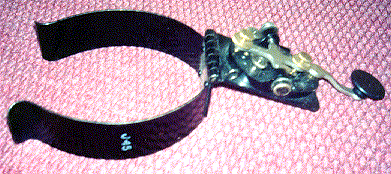
8520.gif MILITARY CLIP-ON-THE-LEG KEY TYPE J-45:(40KB)
This is a standard J-37 key screwed to a black painted steel plate
which is hinged to a large clip which is clipped to the leg of the
WWII aircraft/tank radio operator.
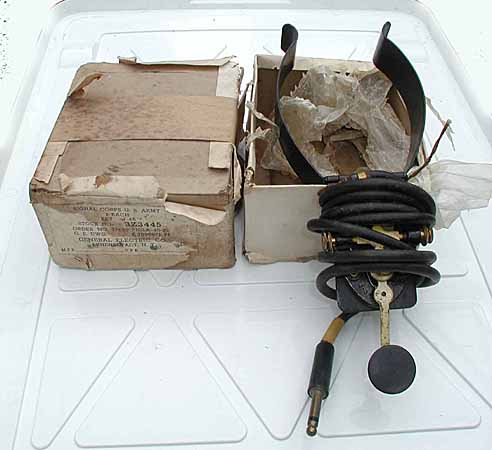
8520a MILITARY CLIP-ON-THE-LEG KEY TYPE J-45 IN ORIGINAL
BOX:(28KB)
This is a standard J-37 key screwed to a black painted steel plate
which is hinged to a large clip which is clipped to the leg of the
WWII aircraft/tank radio operator. As you can see, the box label
indicates that it was made by General Electric in Schenectady, NY.

8520b Closeup of Label on Box for J-45 KEY:(32KB)
8522, 8524, 8526. * Same as above.
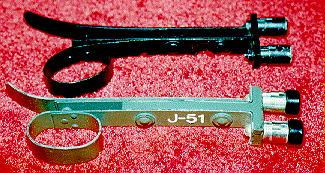
8540 MILITARY SIGNAL LIGHT KEY J-51:(34KB)
This is a hard-to-find key which consists of two strips of metal
which are held in the hand like a gun or scissors, and brought
together to make contact and send a light signal with an external
light gun. The key and light gun and tripod and other accessories
and carrying cases constitute the SE-11 Signalling set.
The key is supplied with a long wire cord so that the
operator can stand FAR away from the light gun while sending
signals. The light gun is obviously a tempting target for any
enemy and therefore the long cord was literally a life-saver.
Most of these keys are painted olive drab and engraved J-51. Other
models are painted black.
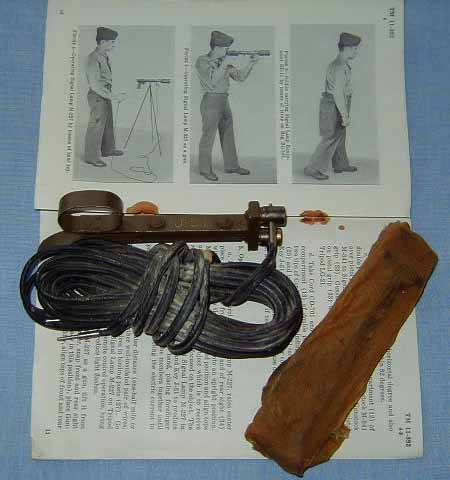
8540a The J-51 Key with Original Packing and
long cord and pictures of complete SE-11 setup:(30KB)
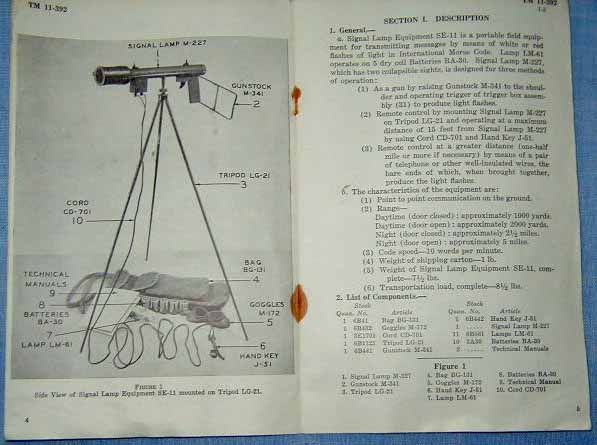
8540b The technical manual illustrations
of the complete SE-11 set:(38KB)
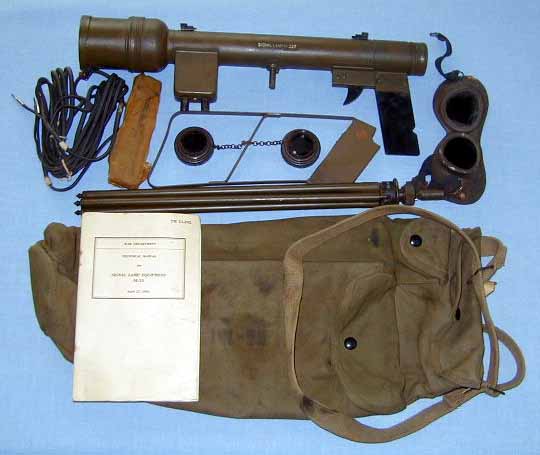
8540c All of the individual parts of the
SE-11 Light Signalling kit laid out on a table:(31KB)
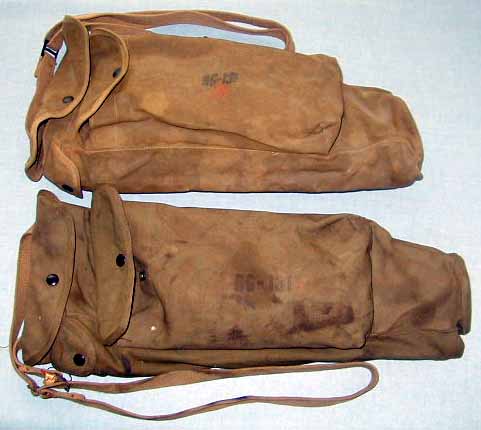
8540d Two of the carrying bags for
SE-11 Light Signalling kits laid out on a table:(27KB)
8542, 8544, 8546. * Same as above.
8550, 8552. * Same as above but black.
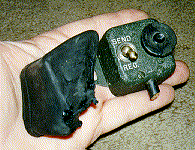
8620 TINY WEATHERPROOFED MILITARY FIELD KEY:(19KB)
1-1/2 inch cube with key and send receive toggle switch enclosed in
a slightly disintegrating rubber cover. Olive-drab wrinkle finish.
Bottom of cube stamped CAY-26013.
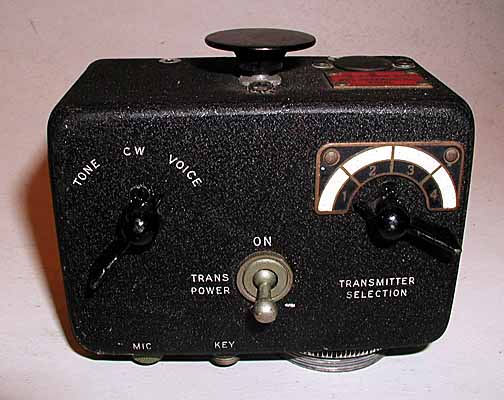
8630 * TINY UNUSUAL TELEGRAPH KEY IN BOX FOR
WW-II BC-451 RADIO SET:(39KB)
This tiny key is constructed in a very unusual way. Its knob is at
one end of its lever which is totally enclosed inside a spring. The other
end of the lever has the electrical contacts. The key is integrated
into the control box for the BC-451A radio set. It is in a parallel
circuit with the external key jack so either an external key or this
internal key may be used. The label indicates that it was made by
Western Electric in New York and it carries serial number 1821.
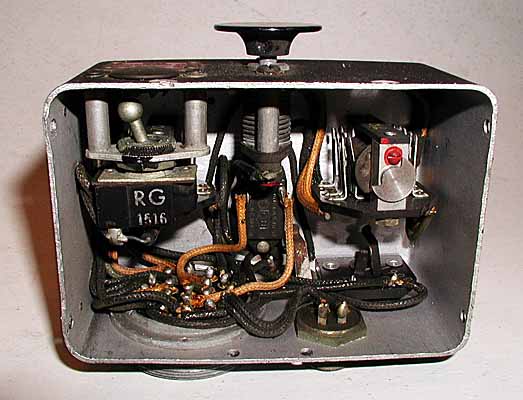
8630a * A view of the back of the box showing
the key mechanism:(40KB)
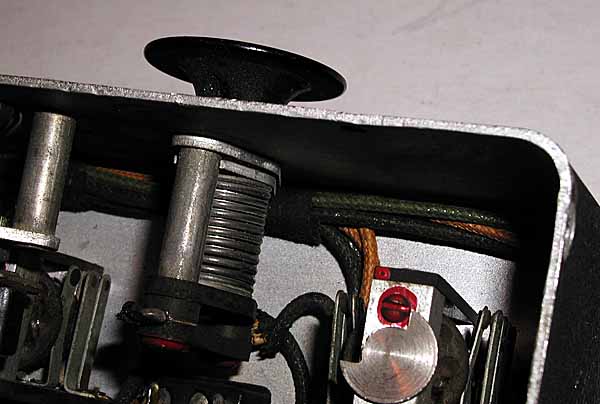
8630b * A closer view of the unique mechanism
of the tiny telegraph key:(35KB)
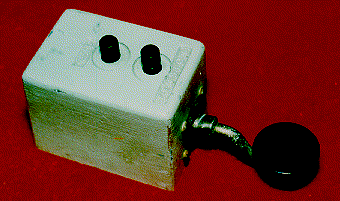
8640 LIGHT SIGNALLING KEY IN CAST ALUMINUM BOX:(17KB)
This key was used for blinking the ship's lights from the bridge.
It has a round lever sticking out of a cast aluminum case which is
painted grey. Two metal knurled adjusting knobs on top of the case are
labeled "GAP" and "TENSION". The key was used on the SB-315 B/U Control
Panel in Essex Class Carriers. They were made for the Navy Department by
Dittmore - Freimuth Corp in Milwaukee, Wisconsin under contract number
N126-03948A. A later model was made for use on the Triton Atomic
Submarines. Its Federal Stock Number is FSN 5805 608 0129.
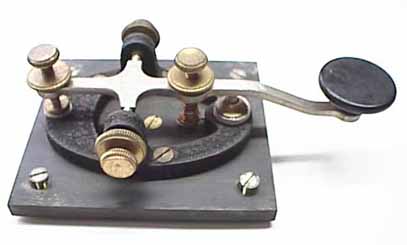
8680 MILITARY KEY:(14KB)
This key is mounted on a bakelite base that carries the number
D165581 on the bottom. Often mistaken for a Navy key, the key was
mounted and used on a large and heavy Telegraph/Teletype terminal set.
Since most keys were removed from the rather useless sets, it was
only recently that I was able to purchase a complete set. (See 8680a).
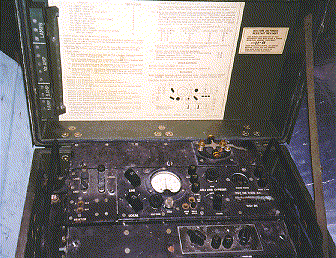
8680a MILITARY TELEGRAPH/TELETYPE SET:(43KB)
Contains key number 8680 above.
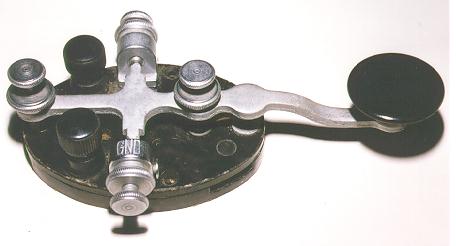
8700 XXX-26012A MILITARY KEY:(15KB)
This key is mounted on an oval bakelite base with a slot in
the left side for the insertion of a wedge connector for a bug.
Its left trunnion support is labeled "GND".
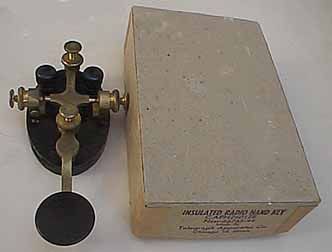
8705 * McELROY CAPH 26012B MILITARY KEY:(10KB)
This must have been one of the very few model CAPH 26012B keys which
were made by Ted McElroy's company: TELEGRAPH APPARATUS CORP in Chicago.
McElroy CAPH 26012B keys are VERY hard to find. The code CAPH is the Navy
code for keys manufactured by McElroy: The key is in new condition
and is complete with it's original box which shows the manufacture
date of 1944. The all brass key is mounted on an oval bakelite base
with a slot in the left side for the insertion of a wedge connector
for a bug. Its left trunnion support is labeled "GND" in very
light stamping.(Traded to: Tom French W1IMQ ''The McElroy Collector''.)
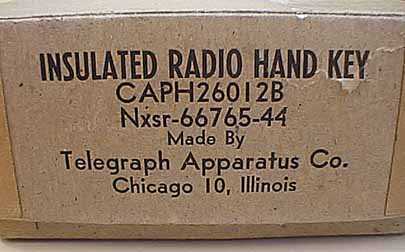
8705a The label on the original CAPH 26012B
box:(21KB)
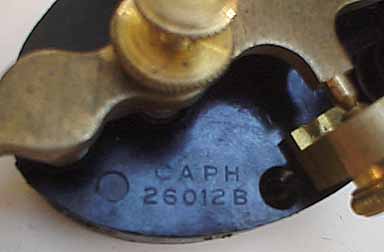
8705b The CAPH label on the base of the key:(12KB)

8705c A Left side view of the CAPH 26012B key:(11KB)
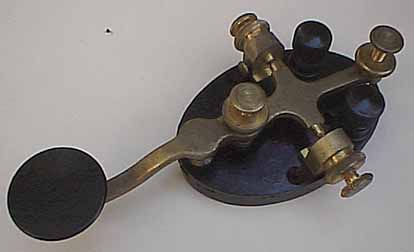
8705d A Right side view of the CAPH 26012B key:(11KB)
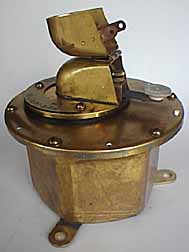
8810 * LARGE NAVY FLAMEPROOF LIGHT SIGNALING KEY:(10KB)
This huge key was used for keying the external lights on a Navy ship. Its
contacts are enclosed in a large metal drum both to protect them from salt
water and to ensure that any sparks made by the contacts will not cause an
explosion. The label reads: MIL-C-24174/3-001 SIB. Date of Manufacture,
1977. Further down the line, there was typically another switch that
prevented accidental 'showing of a light' during night operations.
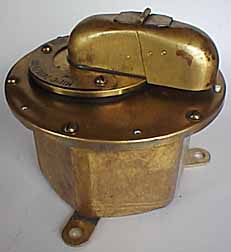
8810a Another view of the flameproof key:(11KB)
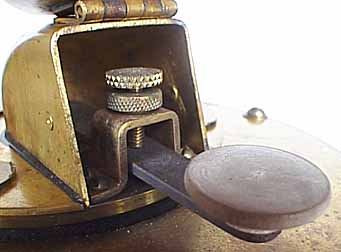
8810b A close view of the telegraph key
lever:(15KB)
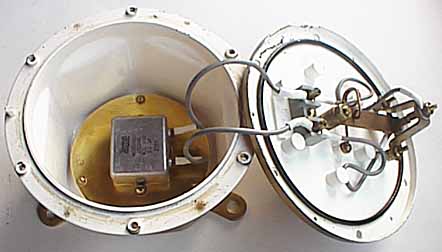
8810c A view of the spark suppressing network inside the
key:(21KB)
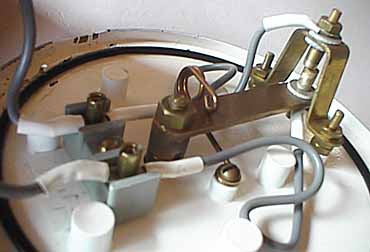
8810d Another view inside the key showing the
contacts:(17KB)
8840, 8842 MILITARY CLIP-ON-THE-LEG KEY TYPE KY-116/U: This is a much
more recent version of the J-45 set with a modern J-37 key.
8860 RECENT MILITARY GENERAL PURPOSE KEY: An all nickel plated key
patterned after the Bunnell "Triumph" design. Lever is inscribed WINSLOW
TELE-TRONICS INC. 66150. The Plated cast base is inscribed 26001-C and
66150.
NOTE: The Navy Code designation for the Winslow Company is CAKU.
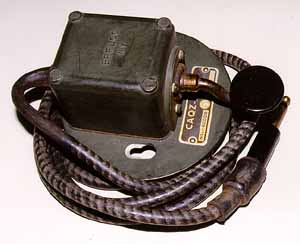
8870 MILITARY "BRELCO" KEY:(14KB)
This recent key was mounted on a leg clamp or directly on a
transceiver. It carries a label which reads: CAQZ-26026.
Nxsr-60008. 9471.
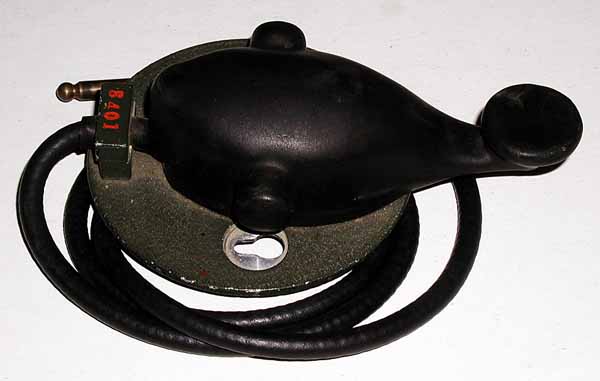
8875 RUBBER ENCLOSED AND SEALED MILITARY KEY:(23KB)
This recent key was mounted on a leg clamp or directly on a
transceiver using exactly the same base as number 8870. The
entire key is enclosed in a soft rubber boot.
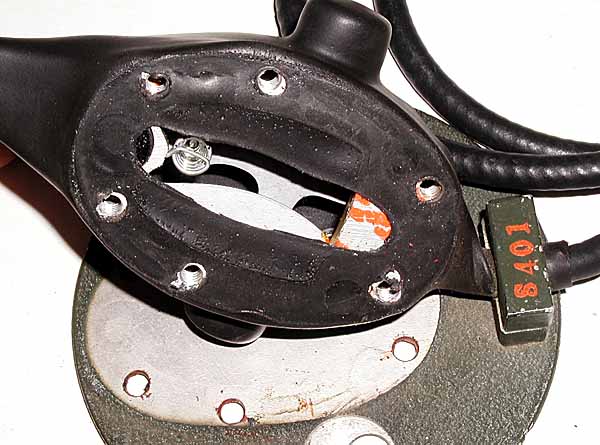
8875a Disassembling the key:(56KB)
reveals a classic bunnell-style triumph design key complete with
contact strip for wedge connector to a bug. Since the key is
entirely sealed, this connection could not have been used.
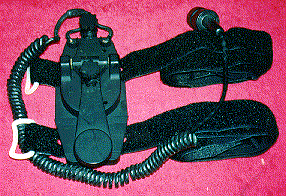
8880 VERY LIGHT STRAP-ON-THE-LEG KEY:(34KB)
This all Nylon? key is very light and has two velcro straps to hold
it to operator's leg. 5 pin plug on coil-cord. Base marked KEY
KY-605U, ELECTRO VOICE, INC CONTR DAAB07-76-C- 0363. As contract
number shows, it was manufactured in 1976. Very unusual.
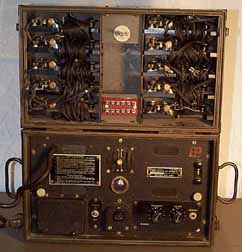
8900 ** AN / GSC-T1 CODE TRAINING SET:(19KB)
This set was designed to provide audio code practice tones sent by
an instructor and to allow up to 10 students to send code. It consists
of a tube-type audio oscillator and amplifier contained in a
heavy metal and wood case. The cover swings upward and stores a
total of 10 J-37 telegraph keys mounted on special plastic bases which
are notched to allow the connecting wire to be wrapped around the
key and base for storage (See 
Key number 8368.)
(Pictures are from the Derek Cohn - WB0TUA Collection.)
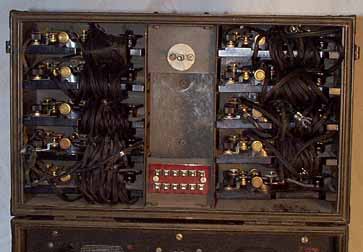
8900a Close-up view of cover showing keys:(21KB)
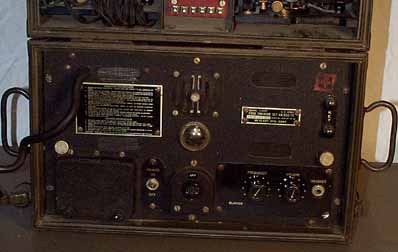
8900b Close-up view of oscillator/amplifier:(18KB)
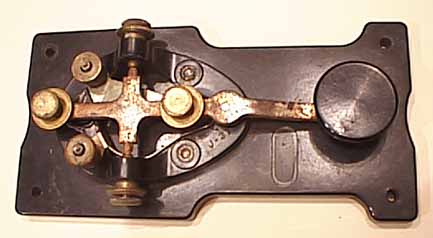
8905 SPECIAL J-37 KEY ON PLASTIC WIREHOLDER BASE:(19KB)
These keys were mounted on these special bases to allow the wires
to be wrapped around the key and base for storage inside the cover
of the (number 8900) GSC-T1 code practice set above.
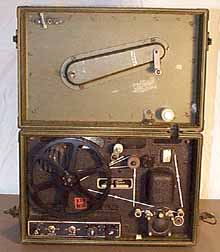
8920 ** TG-34A TELEGRAPH TRAINING MACHINE:(16KB)
This set was designed to automatically send audio tone dot and dash signals
at varying speeds for students to practice copying by hand or on a
typewriter. A variable speed motor pulled a paper tape past a
photoelectric tube. A light on one side of the tape shined through
the tape unless it was blocked by black ink marks on the tape. The ink
marks determined when the oscillator would be keyed to make the tones.
(These pictures are from the Derek Cohn - WB0TUA Collection.)
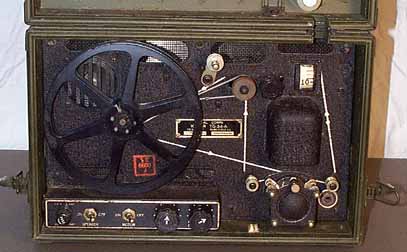
8920a Close-up view of the motor and
audio panel:(23KB)
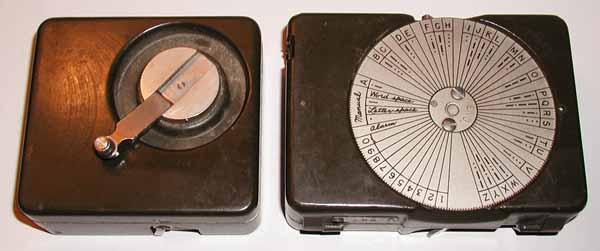
8980 U.S.ARMY M-108 POCKET-SIZED BURST CODE KEYER:(25KB)
This is a very small telegraph burst encoder set which can easily be concealed
in a pocket. It is used to send extremely high speed bursts of ciphertext
messages in the international Morse Code. These extremely short and fast
messages are difficult for an enemy to receive since they are only on the air
for a very short time. The short duration of the message burst also makes it
difficult for the enemy to use direction finding radios to pinpoint the
location of the transmitter. The coding unit (on the right) punches morse
coded holes in a tape which is then sent in a short, high speed burst, by the
spring driven sending unit (on the left).
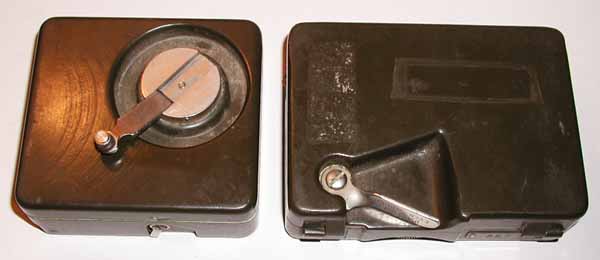
8980a A view of the other side of the coding
unit:(17KB)
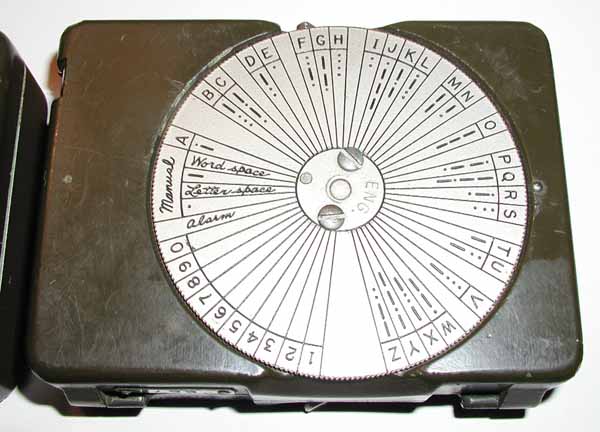
8980b A view of the Alpha code wheel:(46KB)
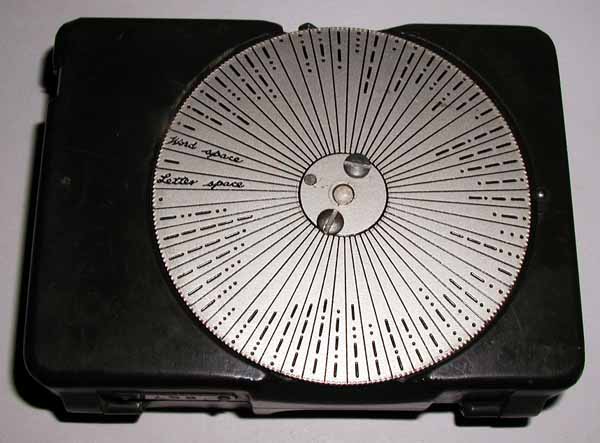
8980c A view of the Morse code wheel:(45KB)
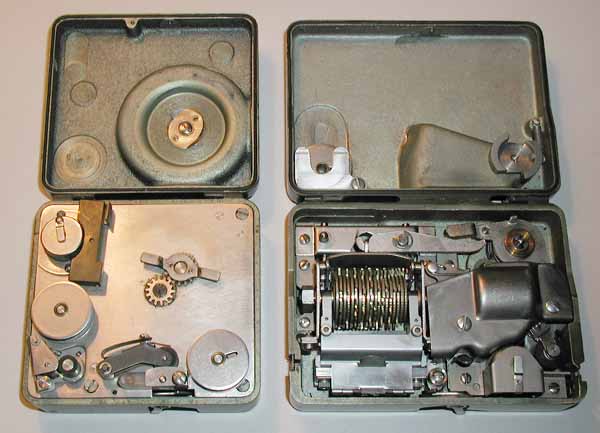
8980d A view of both units with covers open:(38KB)
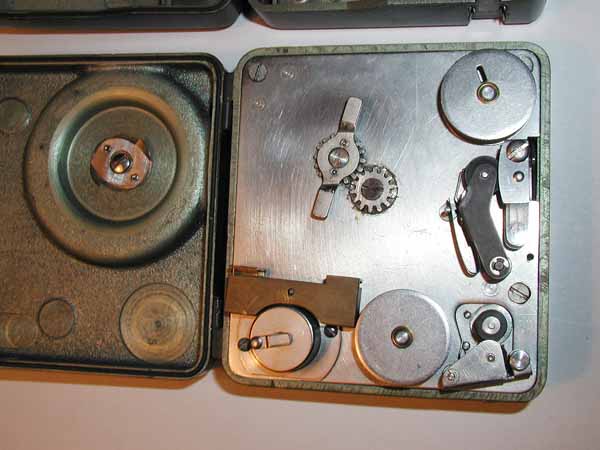
8980e A closer view of the spring wound burst sending
unit:(36KB)
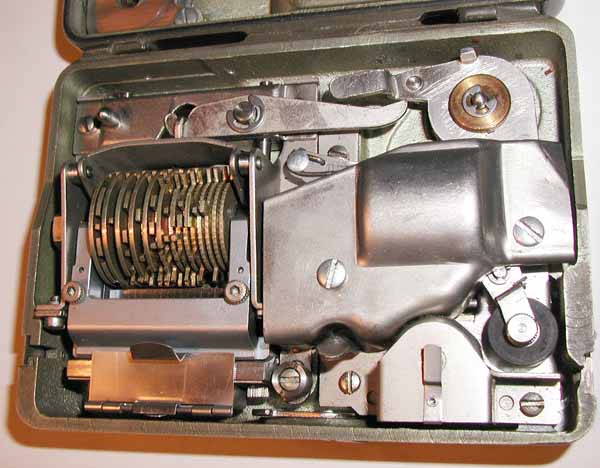
8980f A closer view of the Morse coding unit with cover
open:(45KB)
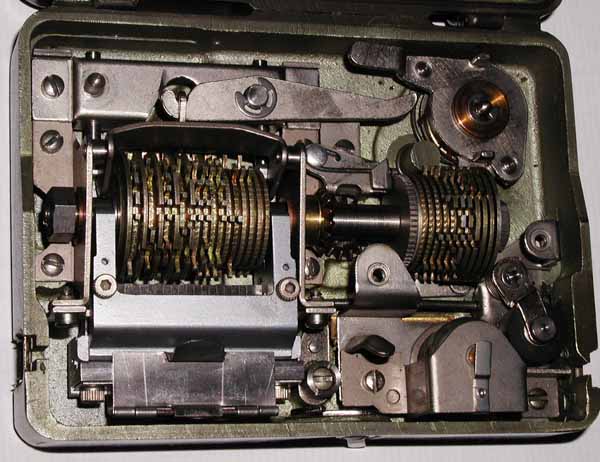
8980g A closer view of the Morse coding unit with cover
open and sub-cover removed:(51KB)
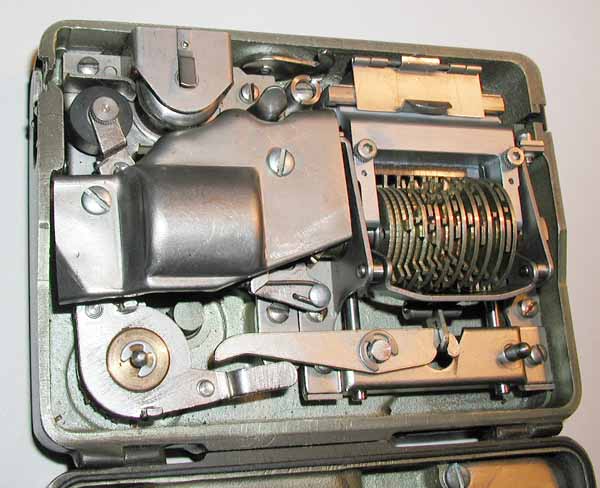
8980h A different perspective view of the Morse
coding unit:(48KB)
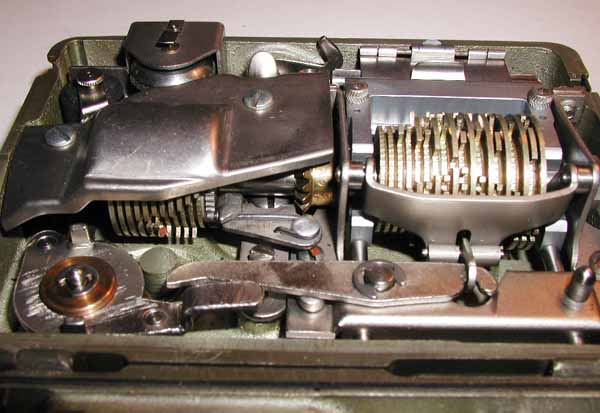
8980i Another different perspective view of the
Morse coding unit showing both coding wheels:(38KB)
Internet ENIGMA Museum:
https://EnigmaMuseum.com
COPYRIGHT NOTICE: (Copyright (c) 2023: Prof. Tom Perera Ph. D.)
Although all the pictures and text are copyrighted, you may use any of them
for your own personal applications including public lectures and
demonstrations, publications and websites as long as you mention the
w1tp.com Museum. If you plan to offer them for sale to the public
in any form, please email me for permission which I will generally grant as
long as you mention my museum: http://w1tp.com or https://EnigmaMuseum.com My email address is
given at the bottom of this page. Some of the material may require contacting
other copyright owners for commercial use and I will inform you by email.
Please also see the Disclaimer of Warranty.
(The instruments are in approximate chronological order: Oldest first.)
* = (Items no longer owned.) ** = (Items in other collections.)
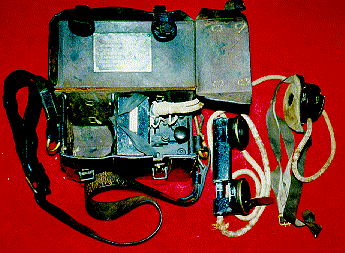
9010 * BRITISH WW-I D MK III FIELD
TELEGRAPH/TELEPHONE SET:(39KB)
This early set has a small telegraph key as well as a head-size-
adjustable handset AND an early style leather encased single headset.
It has been suggested that this set was used by the artillery or the
baloon corps since the leather encased earpiece seems to be an early
attempt at sound reduction. The leather case is stamped: "R.STAFFORD,
1916". The inner brass case is stamped STERLING 47486 L III XX 1916.
The set was phonetically nicknamed the "Don three star".
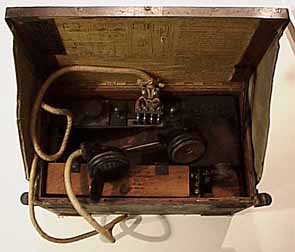
9020 * FULLERPHONE WW-I FIELD
TELEGRAPH/TELEPHONE SET: (17KB)
This interesting British WW-1 Field Telegraph set is labeled:
W.D.S.F.-K FULLERPHONE, MARK III No. 11077. 1918.
It is based on the design originated in 1915 by A.C. Fuller.
This design used Direct Current telegraph signals which were
impossible for the enemy to intercept and decode. The design
allowed much better security than the American and other 'buzzer sets'
which sent code signals in the form of AC buzzing voltages.
The fullerphone decodes the D.C. voltages by using an
interrupter and handset or earphones.
The set is contained in a canvas covered wooden box with brass trim. The
telegraph key folds out and the telephone handset is adjustable from 6 to 9
inches (to accommodate different size heads of British soldiers?).
It also contains a brass plate with a very early and FUNNY phonetic alphabet.
For example: A=AC, B=BEER, F=FREDDIE, I=INK, M=MONKEY, N=NUTS, P=PIP, T=TOC,
and Y=YORKER, etc. There is also a wiring diagram inside the cover.
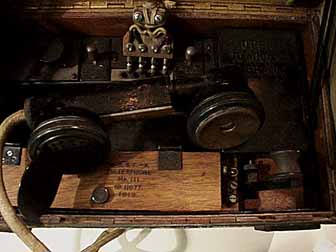
9020a A closer view showing the adjustable
handset:(18KB)
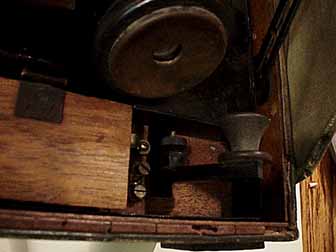
9020b A much closer view showing the folding telegraph
key:(14KB)
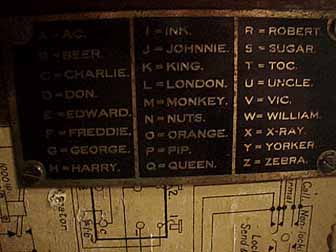
9020c A view of the phonetic alphabet plate:(18KB)
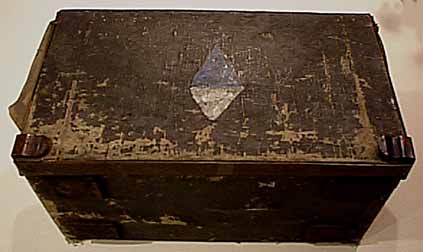
9020d A view of the set with the cover closed:(19KB)
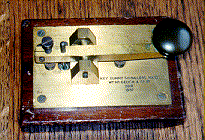
9040 1938 BRITISH ''DUMMY SIGNALLER'S KEY'':(20KB)
This small key is inscribed with the amusing words: ''Key,
Dummy Signaller's, MK II, 1938''
as though it was meant for use by signallers who were ''Dummies''. It
has no electrical contacts whatsoever. It was actually designed to
make the clicking sounds that are usually made by a sounder. It was
used in training British soldiers to copy code by ear without the need
for any electrical apparatus.
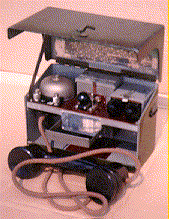
9060 * WW-II FIELD / TRAINING SET:(14KB)
This set consisted of a key, battery, and buzzer. It was used for
training soldiers in the code.
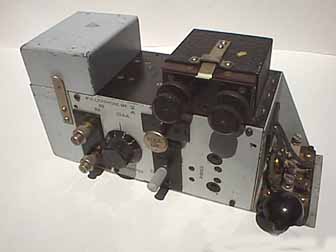
9080 * WW-II FULLERPHONE MK-V FIELD TELEGRAPH SET:(12KB)
This set consisted of a key, battery, and buzzer. It was used for
field communication over wires. This one is in a grey case.
It is based on the design originated in 1915 by A.C. Fuller.
This design used Direct Current telegraph signals which were
impossible for the enemy to intercept and decode. The design
allowed much better security than the American and other 'buzzer sets'
which sent code signals in the form of AC buzzing voltages.
The fullerphone decodes the D.C. voltages by using an
interrupter and handset or earphones.
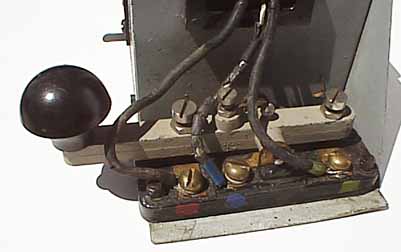
9080a A close view of the WT-8A key in the
Fullerphone:(16KB)
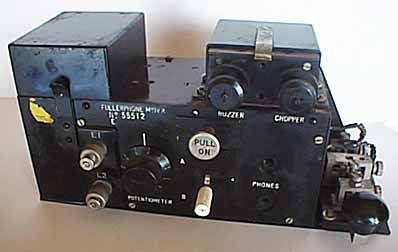
9081 * WW-II FULLERPHONE MK-V FIELD TELEGRAPH SET:(16KB)
Similar to number 9080 above but mounted in a black case.
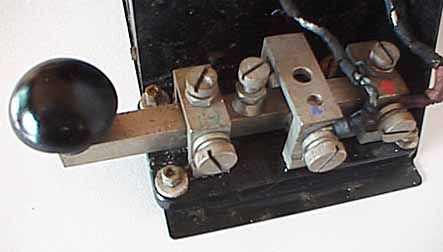
9081a A close view of the WT-8A key in the
Fullerphone:(16KB)
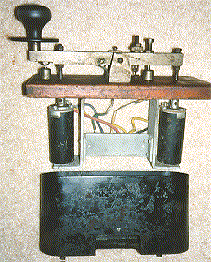
9100 INTERESTING BRITISH ELECTRICALLY-
ACTIVATED TRAINING KEY:This key functions like a typical telegraph key but
it also has two electromagnets that activate the key by pulling down on the
lever. It is not clear how and where this key was used.
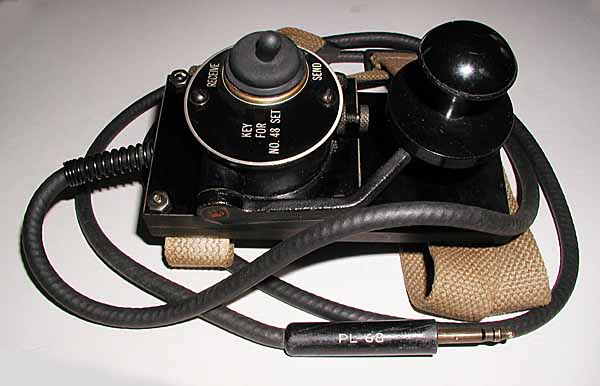
9110 BRITISH STRAP-ON-THE-LEG TELEGRAPH KEY
FOR 48 RADIO SET:(37KB)This is a very nicely made flameproof
military key designed for use in hazardous environments.
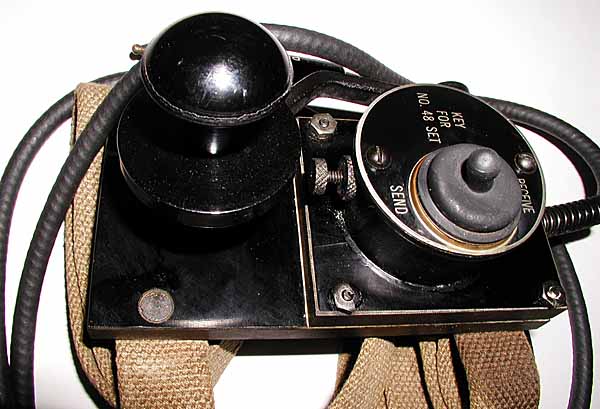
9110a Another view of the British Key:(47KB)
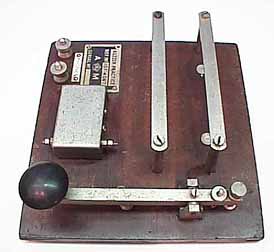
9112 BRITISH AIR MINISTRY KEY AND BUZZER
TRAINING SET: This is a complete training set with telegraph key, buzzer,
and battery holder all mounted on a board.
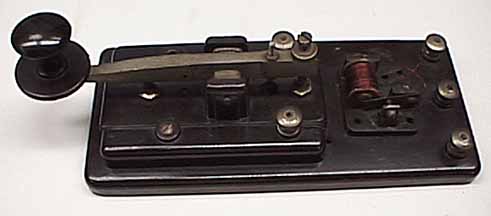
9114 * AUSTRALIAN BLUE POINT TELEGRAPH PRACTICE /
TRAINING SET:(14KB)
This set consisted of a key, battery, and buzzer. It was used for training
potential radio operators in the Morse code. It was manufactured by Blue
Point in the 1950's. Historian Herman Willemsen has provided the following
information about Blue Point. The company was founded in the Sydney Australia
suburb of Erksville in 1936 by a German immigrant, Frederick Boyd Dirks who
named his company F. Dirks. The company produced bakelite products such as
ashtrays, single strip heaters, and Morse key components. In 1946, the
company name was changed to Blue Point products P/L. The name was inspired by
the name "Blau Punkt", a German electrical supplier. In 1973, the company was
purchased by Gerard Industries P/L (which was known for its line of Clipsal
products). Blue Point keys were Identified by the words Blue and Point with a
blue dot between them. Models X10B, XX20, XX20A, and XX20B are owned by
Herman Willemsen.
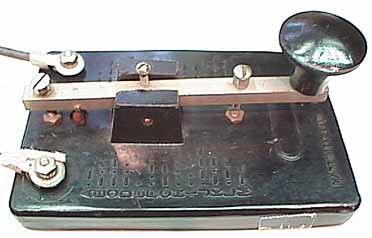
9116 * BRITISH TELEGRAPH PRACTICE / KEY:(14KB)
This key was used in conjunction with a buzzer and battery for training
soldiers in the code.
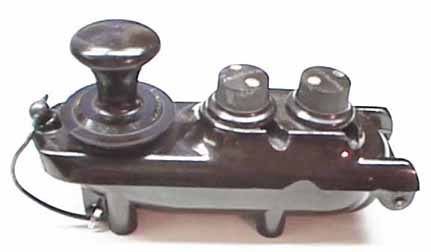
9120 WW-II RAF BROWN ''BATHTUB KEY'': (13KB)
This British Aircraft key was used on most of the RAF
aircraft during WW-II. It is a BROWN bakelite bathtub-shaped key
with a doorknob style knob. This is a flameproof design with a
leather diaphram around the base of the knob. This key
can instantly be set to send a constant transmitted carrier if
the aircraft is going down by flipping a spring clip over the knob base.
This freed the radio operator to try to escape.
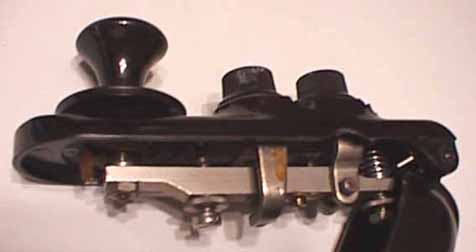
9120a Inside view of the key with top open:(17KB)
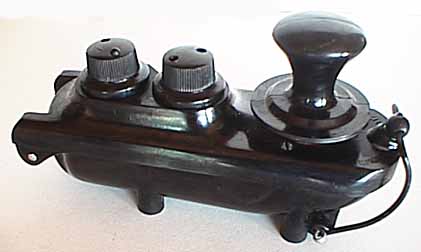
9122 WW-II RCAF BLACK ''BATHTUB KEY'':(14KB)
Same as above in black. (Black bathtub keys were made in Canada.)
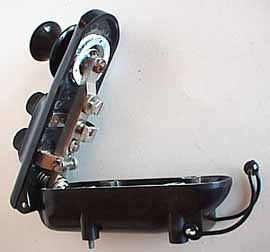
9122a Inside view of the key with top open:(12KB)
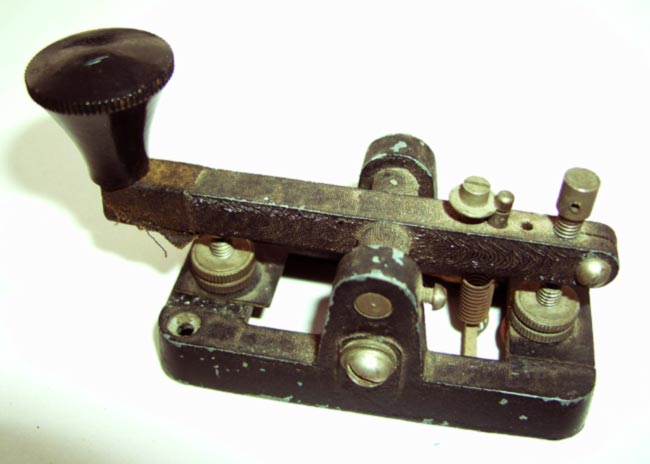
9125 SMALL BRITISH MILITARY TELEGRAPH KEY:
It is not known what radios this small open frame military key was used with.
It is not even certain that it is British but the knob looks like many other
British key knobs.
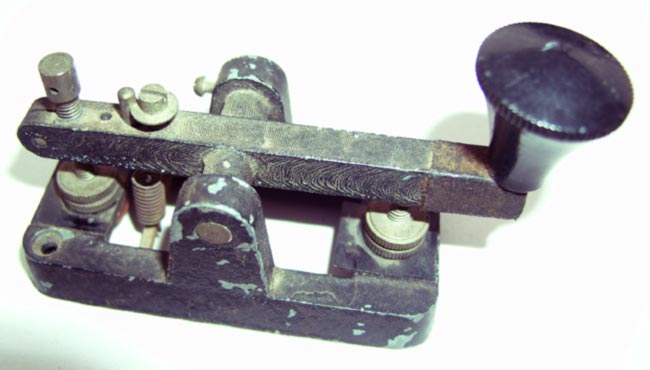
9125a Left side view of the Small British key:

9130 TINY SPECIAL FORCES NATO TELEGRAPH KEY:(5KB)
This tiny 2-1/2" long, all-enclosed key with round knob was used by the
special forces and carries a NATO codification number or stores number.
It is labeled: KEY TELEGRAPH 5805-99-949-9618
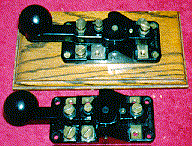
9140 BRITISH "KEY. WT. 8 AMP" MILITARY KEYS: (20KB)
This key (sometimes called the WT 8-Amp Key) was made in over 100
variations and used widely throughout WW-II. Some of the many variations
are shown in the items below. This one is a small brass and black plastic
integrated key with a small doorknob style knob. It is marked:
KEY. WT. 8 AMP. No.2. MK III.
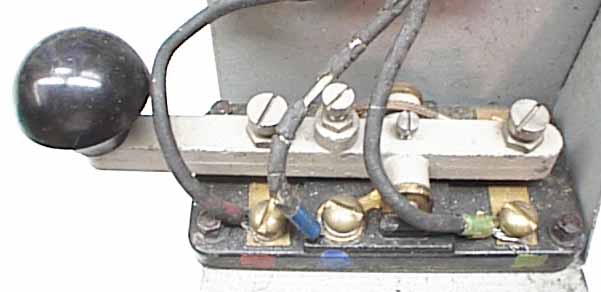
9141 Variation of the KEY WT 8 AMP Design:(22KB)
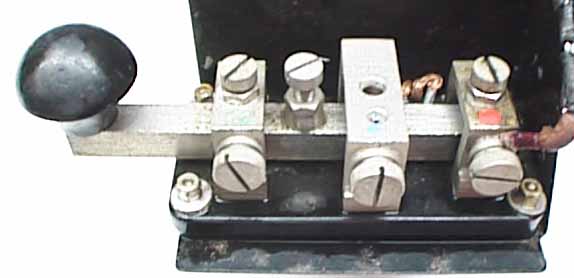
9142 Variation of the KEY WT 8 AMP Design:(20KB)
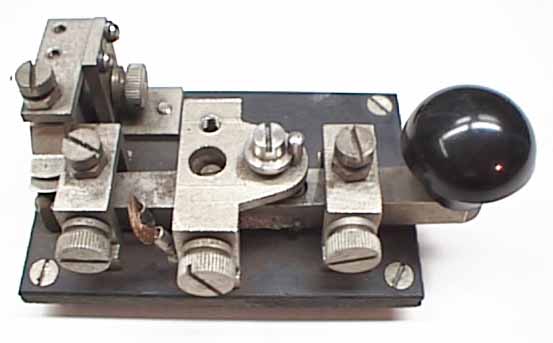
9143 Variation of the KEY WT 8 AMP Design:(21KB)
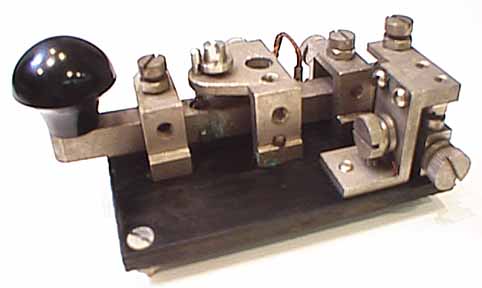
9143a Another view of number 9143:(16KB)
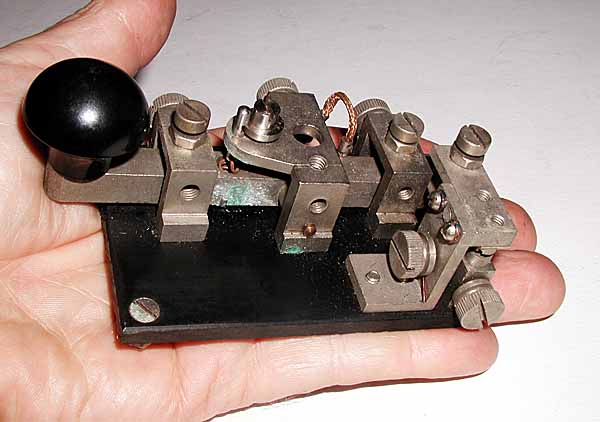
9143b Another view of number 9143 in a hand:
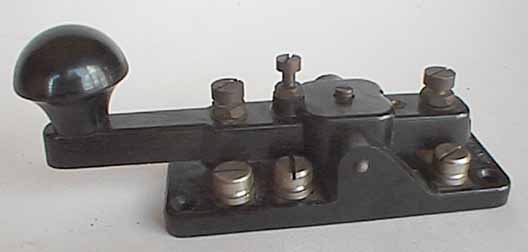
9145 Plastic variation of the KEY WT 8 AMP Design:(11KB)
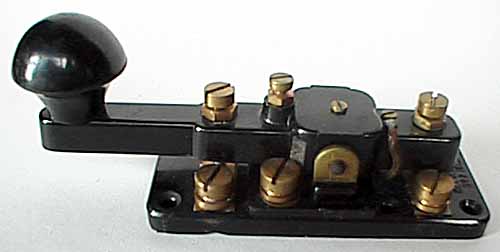
9145a Another view of number 9145:(14KB)
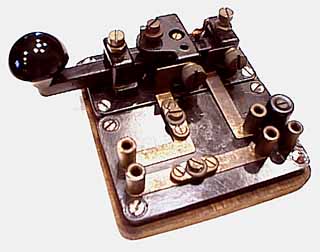
9144 Variation of the KEY WT 8 AMP mounted alongside
a terminal strip base:(20KB)
This variation was used with 'Lamp, Signalling, Daylight,
Short Range,' WW-2 version.
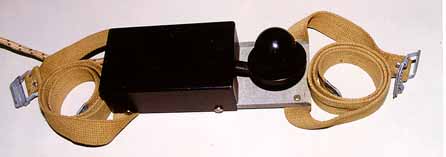
9155 * STRAP-ON-THE-LEG VERSION OF THE KEY WT 8 AMP
KEY:(12KB)This is a KEY WT 8 AMP Key enclosed in a sheet metal
case with two canvas leg straps to secure it to the leg of the
radio operator. It was widely used in vehicles during WW-II.
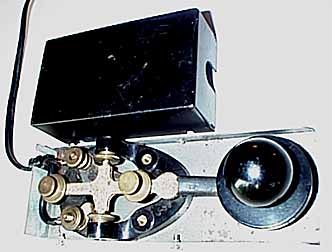
9155a Another view of the strap-on-the-leg
key with cover removed:(20KB)
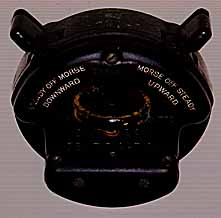
9157 BRITISH ROYAL AIR FORCE (RAF)
AIRCRAFT LIGHT SIGNALLING KEY:(12KB)
This vertically-mounted key was used for flashing the upper
and lower lights on British fighter aircraft during WW-II to allow
communications between aircraft during periods of radio silence so that
the enemy could not listen in to the radio communications. (It is similar
to the Canadian Air Force key shown as item 9300.)
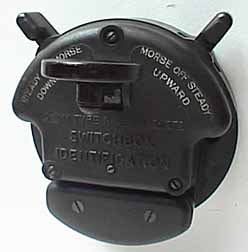
9157a Another view of the light signalling
key:(12KB)
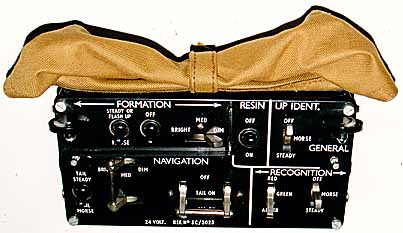
9158 * BRITISH ROYAL AIR FORCE (RAF) DUAL AIRCRAFT
LIGHT SIGNALLING KEYS:(27KB)
This vertically-mounted Panel contains two keys which could be
switched into the aircraft lighting circuits of British WW-II bombers.
The keys were used for flashing the upper and lower lights during
periods of radio silence so that the enemy could not listen in to
the radio communications.
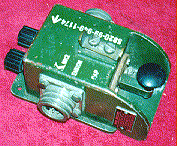
9160 SOUTH AFRICAN KMK-2 MILITARY KEY:(19KB)
Tiny straight key with tiny doorknob style knob enclosed in a
flameproof olive-drab enclosure with round connectors on each
side and two screw terminals on the back.
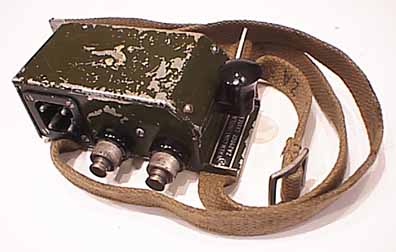
9164 REMOTE CONTROL UNIT L NO. 2 ZA 29007:(19KB)
Tiny straight key with tiny doorknob style knob enclosed in a
flameproof olive-drab enclosure with rectangular connectors on each
side and two screw terminals on the left side. The canvas straps
allowed it to be attached to the operator's leg. It was used with
Wireless Sets number 62 and C12 from the 1940's through the
1960's.
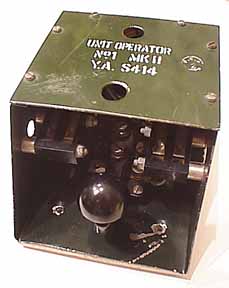
9170 REMOTE CONTROL UNIT YA S414:(14KB)
This is the familiar plastic version of the KEY, WT-8 AMP enclosed
in a metal housing for use with a field radio. The housing is marked:
UNIT OPERATOR, No. 1, MK II, YA S414.
9180 SPY KEYS: These are tiny 2 contact keys made to be built into spy
radio sets. The knobs are similar to the 8Amp British keys-so origin is
probably British. (See further descriptions under "Radio Keys".)
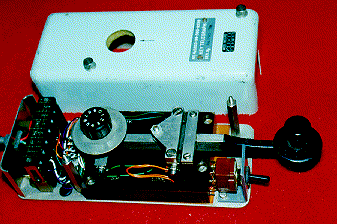
9185 * NATO KEY:(28KB)
7" Long lever key patterned after Ericsson design in 8x3x2-1/2" grey
box. Labeled: NO No5803-99-580-8558, KEY TELEGRAPH. Ser. No. Pes1785 78.
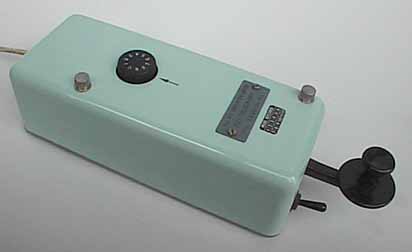
9186 * NATO KEY:(8KB) Similar to 9195 above.
7" Long lever key patterned after Ericsson design in 8x3x2-1/2" grey
box. Labeled: NS No5805-99-580-8888, KEY TELEGRAPH. FIL ZH Ser. No. 475.
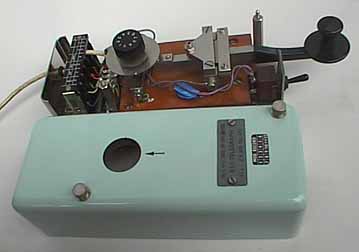
9186a A view of the NATO KEY with cover open:(12KB)
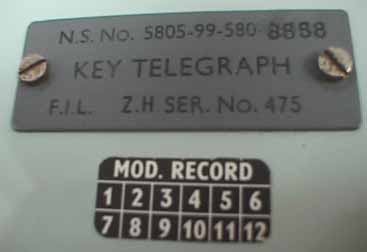
9186b A view of the NATO KEY labels:(10KB)
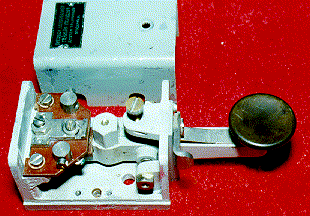
9187 SWEDISH NATO KEY:(30KB)
Small metal enclosed key with label that reads: Svenska
Aktiebolaget Tradlos Telegrafi (Translated: Swedish Company Wireless
Telegraphy). System Telefunken, Stockholm.
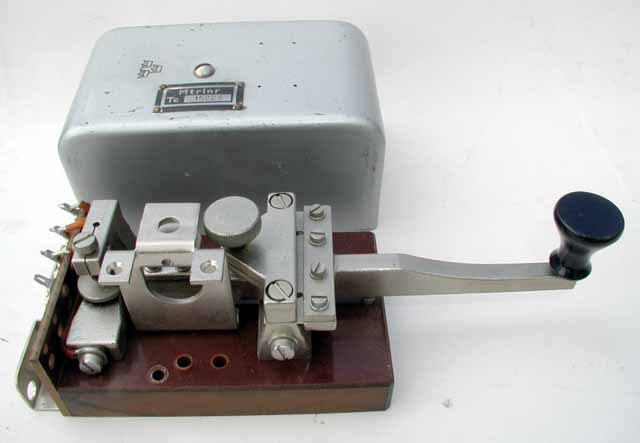
9188 SWEDISH NATO MILITARY KEY:(20KB)
This is a moderately large Swedish Military Key with the
bearingless design pioneered by the 19th Century Steiner
key designs. The pivotless key uses just a flexible strip
of metal to support and stabilize the lever and this eliminates
any side-to-side movement of the lever.
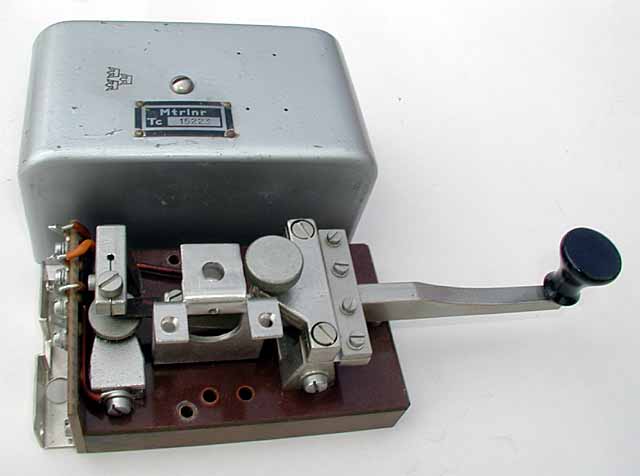
9188a Aother view of the Swedish key:(23KB)

9190 * AUSTRALIAN CLIPSAL KEY:(55KB)
This key was manufactured during and after WW-II by Gerard Industries.
Collector John Kaesehagen of Adelaide, Australia was kind enough to
send me this
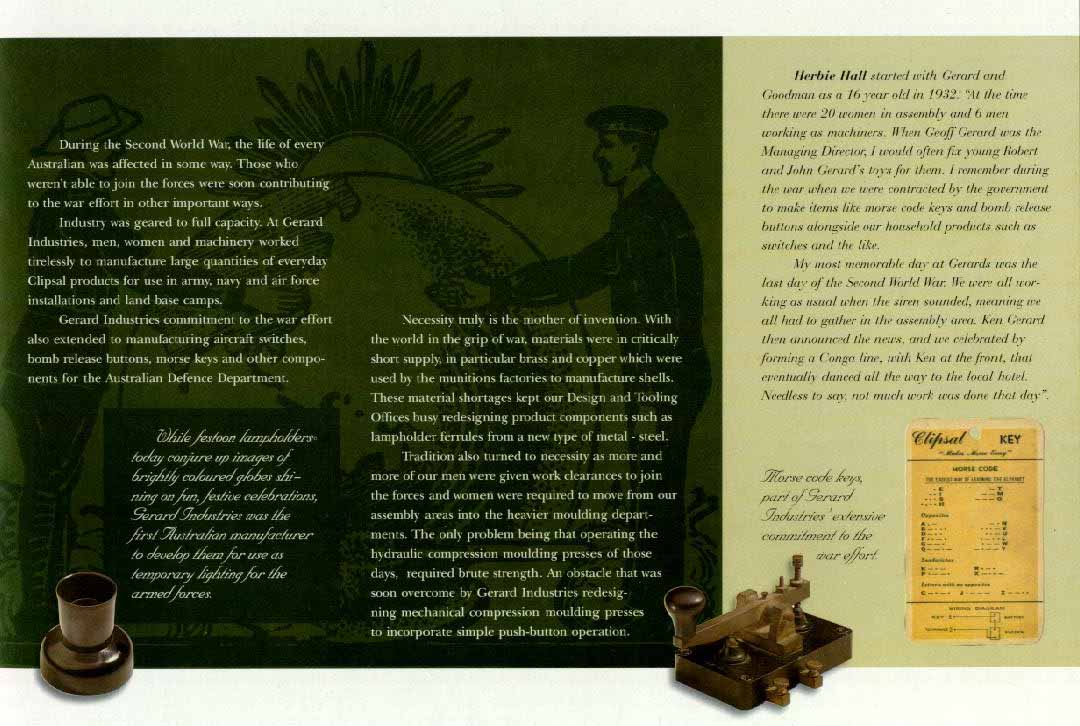
9190a description of the company and
some of its activities:(125KB) It is a LARGE file but interesting
to read. John says that the name "Clipsal" was derived from:
"Clips-all" which was a term used to describe the range of
adjustable fittings for conduits that were manufactured by the company.
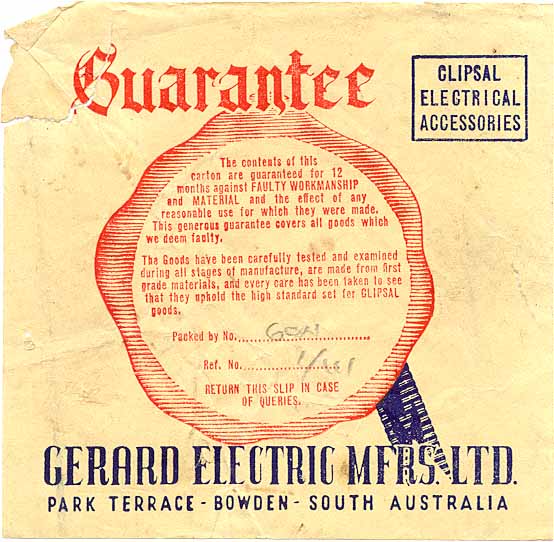
9190b The original guarantee supplied with the
key:(65KB)
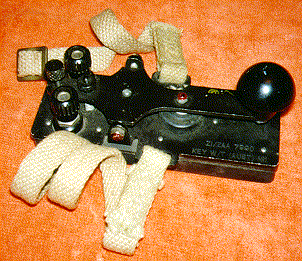
9195 * AUSTRALIAN Z1 STRAP-ON-THE-LEG
"FLAMEPROOF" KEY:(44KB)
This fairly recent military key has a very unusually shaped lever
and the contacts are sealed inside a rubber boot to make it safer to
use in explosive environments. Marked Z1/ZAA 7990 Key W/T
(AUST) No.1 (Traded to W2PM).
NOTE: I AM ALWAYS LOOKING TO BUY OR TRADE TELEGRAPH KEYS !
Internet ENIGMA Museum:
https://EnigmaMuseum.com
COPYRIGHT NOTICE: (Copyright (c) 2023: Prof. Tom Perera Ph. D.)
Although all the pictures and text are copyrighted, you may use any of them
for your own personal applications including public lectures and
demonstrations, publications and websites as long as you mention the
w1tp.com Museum. If you plan to offer them for sale to the public
in any form, please email me for permission which I will generally grant as
long as you mention my museum: http://w1tp.com or https://EnigmaMuseum.com My email address is
given at the bottom of this page. Some of the material may require contacting
other copyright owners for commercial use and I will inform you by email.
Please also see the Disclaimer of Warranty.
(The instruments are in approximate chronological order: Oldest first.)
* = (Items no longer owned.) ** = (Items in other collections.)
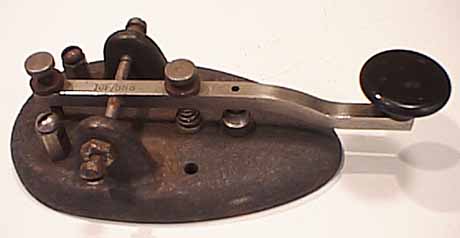
9220 * GRIMMER WILSON KEY:(14KB)
Made in Canada, Suspiciously similar to McElroy Stream Key. A chromed
mechanism key and a grey wrinkle-finished tear-drop cast base with
the words GRIMMER WILSON cast into the bottom of the base.
Lever stamped 10B/556.
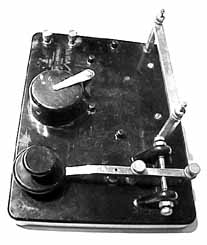
9230 * GRIMMER WILSON PRACTICE SET:(13KB)
This set consists of a telegraph key with the same style of
lever used in the Grimmer-Wilson Key described above. The
key is mounted on a black plastic base along with a buzzer and
a battery holder bracket. The base is marked: No. 10A/726.
Made by Grimmer Wilson, Toronto, Ontario, Canada.
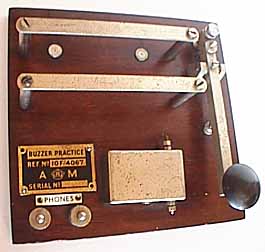
9235 * BRITISH AIR MINISTRY PRACTICE SET:(13KB)
This set consists of a telegraph key with a classic British style
straight lever. The key is mounted on a wooden base along with
a buzzer and a battery holder bracket. The label reads:
Buzzer, Practice and carries the Air Ministry logo.

9240 * CANADIAN WESTCLOX KEY AND ORIGINAL BOX:(11KB)
This key looks a bit like the British 8 Amp key.
In original box marked Z1 ZA/CAN 0977 KEYS Qty 1.
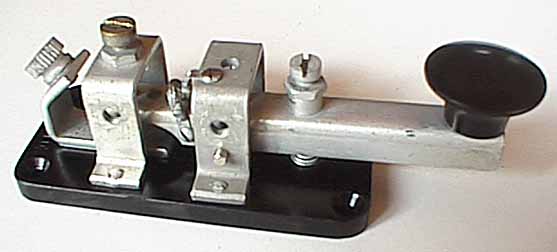
9240a A closer view of the CANADIAN
WESTCLOX KEY:(17KB)
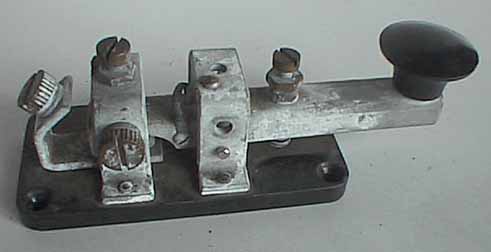
9241 * CANADIAN WESTCLOX KEY:(13KB)
Similar to number 9240.
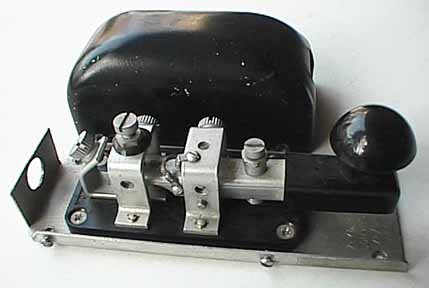
9250 CANADIAN LEG-MOUNTED WESTCLOX KEY:(16KB)
This Canadian Westclox key is similar to number 9240 but it
is mounted inside a metal cover and supplied with canvas
straps that allow it to be strapped to a radio operator's
leg.
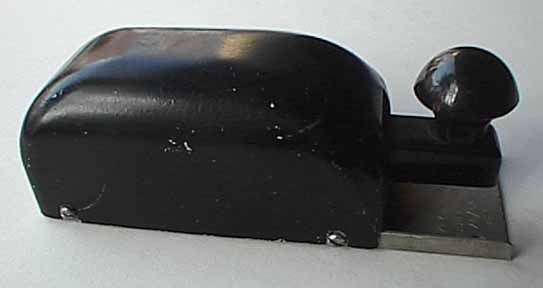
9250a A view with the cover in place
over the key:(11KB)
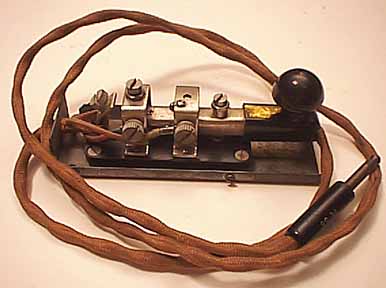
9251 * CANADIAN LEG-MOUNTED WESTCLOX KEY:(22KB)
Similar to number 9250 but the cover is missing.
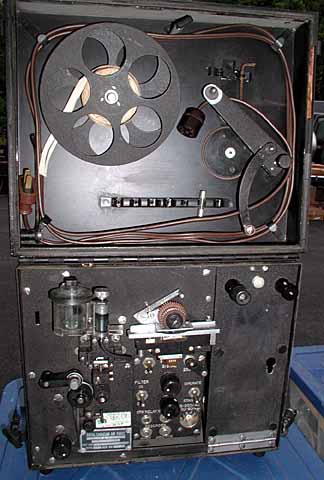
9280 ** CANADIAN MILITARY TELEGRAPH RECORDER-
PLAYER:(33KB)This unusual set records dots and dashes on a
moving paper tape and plays them back. I do not have any
further information about it. It was shown to me by a
collector at the Antique Wireless Association 2002 conference.
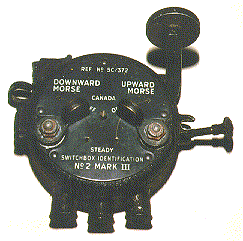
9300 * CANADIAN AIRCRAFT LIGHT BLINKER KEY:(17KB)
This round, wall-mounted key was used to blink the upper and lower
lights on Canadian and British aircraft. This allowed the planes
to communicate visually during periods of radio silence so the
enemy could not intercept their communications. The blinking lights were
also used to communicate with the landing field. All Spitfire pilots had to
learn Morse Code to a speed of 15 words per minute to allow them to
communicate.
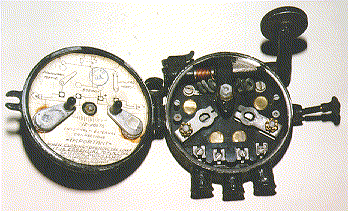
9300a This inside view shows the
schematic diagram:(35KB)
Internet ENIGMA Museum:
https://EnigmaMuseum.com
COPYRIGHT NOTICE: (Copyright (c) 2023: Prof. Tom Perera Ph. D.)
Although all the pictures and text are copyrighted, you may use any of them
for your own personal applications including public lectures and
demonstrations, publications and websites as long as you mention the
w1tp.com Museum. If you plan to offer them for sale to the public
in any form, please email me for permission which I will generally grant as
long as you mention my museum: http://w1tp.com or https://EnigmaMuseum.com My email address is
given at the bottom of this page. Some of the material may require contacting
other copyright owners for commercial use and I will inform you by email.
Please also see the Disclaimer of Warranty.
(The instruments are in approximate chronological order: Oldest first.)
* = (Items no longer owned.) ** = (Items in other collections.)
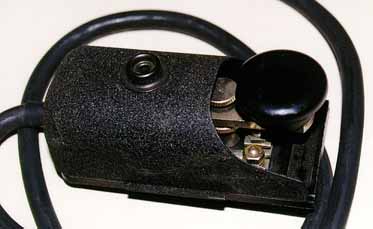
9325 MINIATURE FRENCH MILITARY KEY:(17KB)
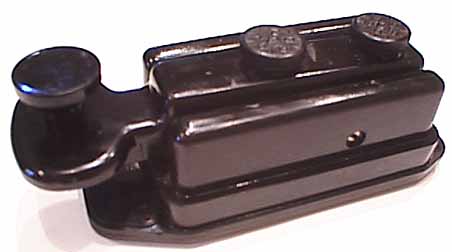
9335 FRENCH MANITONE DYNA KEY:(20KB)
This key has a very simple design with adjustments for both the
contact spacing and the spring tension.
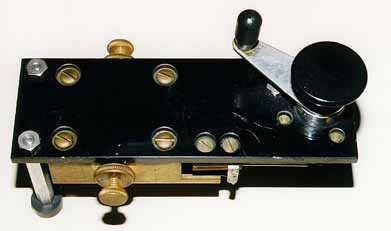
9375 ITALIAN PANEL-MOUNTED RADIO KEY:(15KB)
This key mounts on the front panel of a military radio set.
The lever shorts out the key contacts for tune-up or direction
finding.
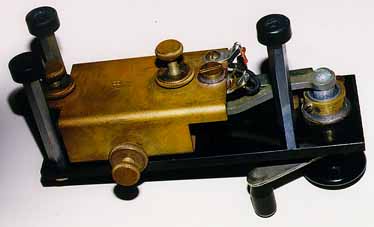
9375a REAR VIEW OF ITALIAN PANEL-MOUNTED
RADIO KEY:(15KB)
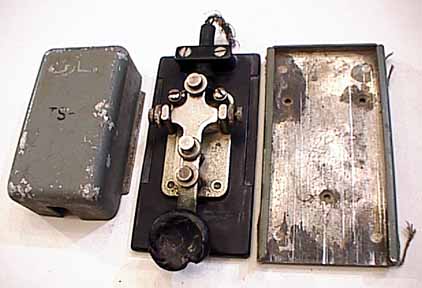
9747 ITALIAN TELEGRAPH KEY FOUND IN EGYPT:(23KB)
I purchased this key in Cairo in 2000. It is the first key that I have been
able to find in Egypt. It consists of a telegraph key mounted on a bakelite
base, a metal cover, and a metal sub-base which has the remains of canvas
straps which were used to strap it to the operator's leg. The mechanism of
the key is very well made and quite unusual. An operator has scratched his
name in the cover in Arabic letters. In 2001 I was informed that this is a
Yugoslavian Army telegraph key and not Egyptian, that the letters ''TS'' stand
for ''taster'' or push button switch, and that it is model TS- In 2006, I was
informed that it is an Italian Military telegraph key made for the Army by an
Italian company named Iret which is no longer in business.
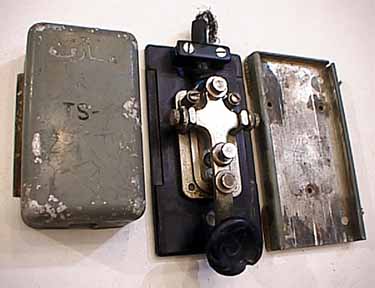
9747a Another view of the key:(20KB)
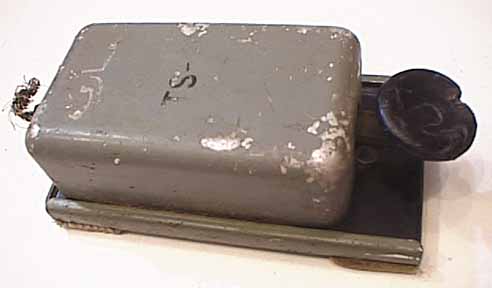
9747b A view with the cover closed:(13KB)
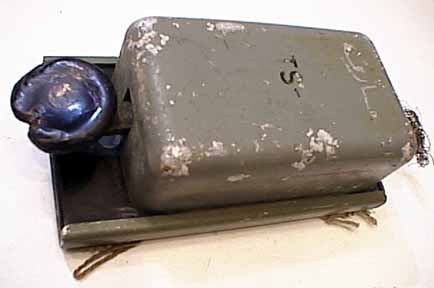
9747c Another view with the cover closed:(14KB)
Internet ENIGMA Museum:
https://EnigmaMuseum.com
COPYRIGHT NOTICE: (Copyright (c) 2023: Prof. Tom Perera Ph. D.)
Although all the pictures and text are copyrighted, you may use any of them
for your own personal applications including public lectures and
demonstrations, publications and websites as long as you mention the
w1tp.com Museum. If you plan to offer them for sale to the public
in any form, please email me for permission which I will generally grant as
long as you mention my museum: http://w1tp.com or https://EnigmaMuseum.com My email address is
given at the bottom of this page. Some of the material may require contacting
other copyright owners for commercial use and I will inform you by email.
Please also see the Disclaimer of Warranty.
VERY EARLY GERMAN KEYS WHICH MAY HAVE BEEN USED BY THE MILITARY:
9411 VERY EARLY GERMAN BRASS LEVER CAMELBACK KEY: (See # 181)
9413 VERY EARLY GERMAN CAST LEVER CAMELBACK KEY: (See # 183)
9415 VERY EARLY GERMAN STEEL LEVER CAMELBACK KEY: (See # 185)
(The instruments are in approximate chronological order: Oldest first.)
* = (Items no longer owned.) ** = (Items in other collections.)
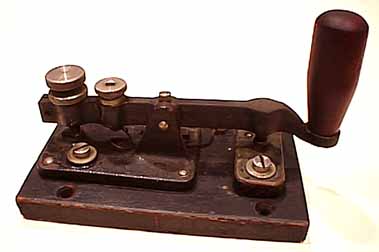
9410 UNUSUAL GERMAN WW-1 LUFTWAFFE
AIRCRAFT SPARK KEY:(13KB)
This interesting key was used by the German Luftwaffe during
WW-1. It is likely that it was used on lighter-than-air craft.
Notice the interesting similarity of the lever of this key
to the lever of the preceding German Spark Key (Number 9405).
The reason for the high wooden knob is not known. They appear
on several German keys. One possibility is that the high
knob allowed the operator to use the key while wearing the
heavy gloves required during high altitude flight in open
cockpit aircraft.
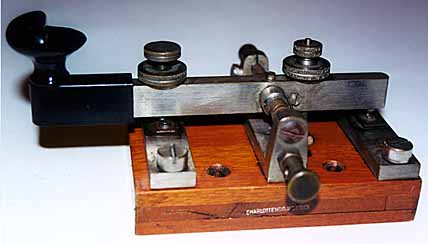
9415 EARLY GERMAN LUFTWAFFE WIRELESS KEY: (17KB)
This key has a most unusual knob. It is thought that it may have
been notched in this way to make it easier for the wireless operator
to hold it as the aircraft bounced in turbulence. It is clearly
marked on both the top and bottom with the BAL Bau Amt Luftwaffe
symbol. It has the spring-mounted lower contacts which are characteristic
of most of the German keys. The right side of the key is stamped
CHARLOTTENB.MOT.GES.
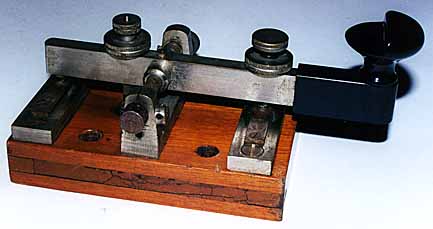
9415a Another view of the Luftwaffe key: (17KB)
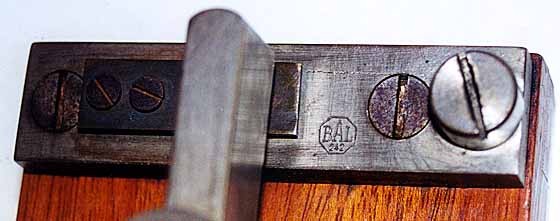
9415b A view showing the BAL marking on the top of the
key: (22KB)
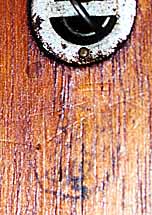
9415c A view showing the BAL marking on the bottom
of the key: (19KB)
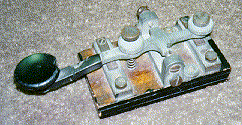
9420 * EARLY GERMAN SPARK or RADIO KEY: (18KB)
Early design steel lever key on black wooden base with Make and Break
contacts mounted on flat springs (An unique characteristic of German keys).
Same design as one recovered by divers from radio room of German
battleship sunk in Scapa Flow during WWI. Circa 1915.
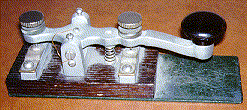
9423 EARLY GERMAN SPARK or RADIO KEY:(18KB)
Similar to above with cast lever.
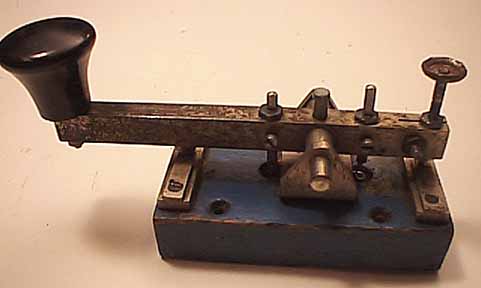
9440 GERMAN WIRELESS KEY WITH TWO SPRINGS:(14KB)
This is a very unusual German telegraph key which has two tension
springs. The spring-mounted lower contacts identify it as being a
German key but the two two tension springs are absolutely unique.
It is unclear why a key would need a spring in front of the trunnion
and a spring in back of the trunnion.
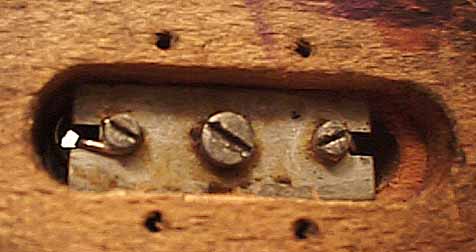
9440a A bottom view of the 2-spring key showing the
two spring mounting screws:(19KB)
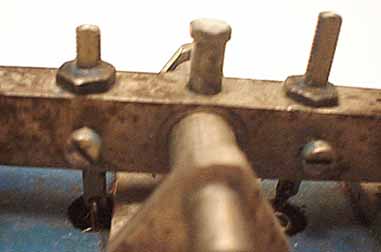
9440b A close-up view of the two tension
springs:(12KB)
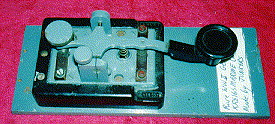
9460 GERMAN JUNKER WWII NAVAL KRIEGSMARINE (Navy) KEY: (22KB)
Metal key integrated into brown bakelite base and mounted on a grey steel
base. Labeled D.R.P. Junker. ENTSTOR. These keys were made by the
Junker company of Bonn, Germany. (Not to be confused with the
Junkers company which made aircraft.) Their keys have an absolutely
wonderful "feel" and impressive micrometer-like adjustments.
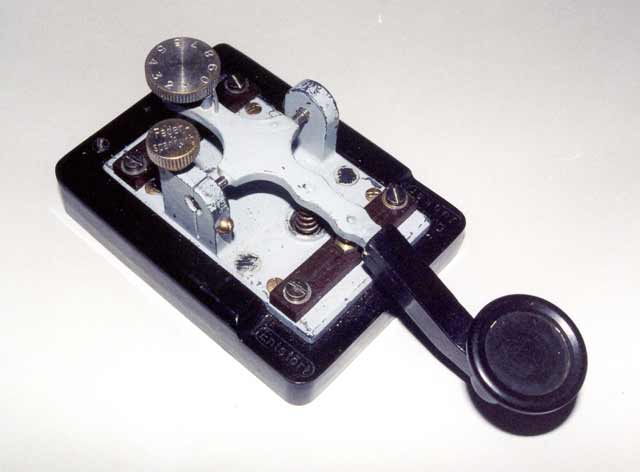
9462 GERMAN JUNKER WWII NAVAL KEY:(20KB)
This is another Junker key with the D.R.P. (Deutches Reiches Patent)
label indicating that it was made prior to the end of WW-2. These early
Junker keys have wonderful micrometer-feel adjustments and an exceptionally
crisp and light action making them among my all-time favorite operating
keys. The postwar Junker keys do not have quite the same 'feel'.
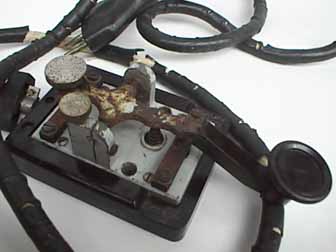
9463 GERMAN JUNKER KEY:(15KB)
Similar to number 9460 above.
9464 * GERMAN JUNKER KEY: As above on lighter grey/creme base.
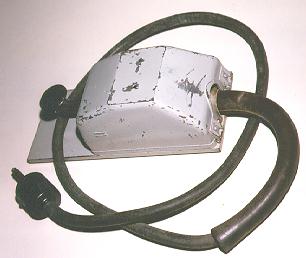
9465 GERMAN JUNKER KEY:(15KB)
As above with original heavy cable.
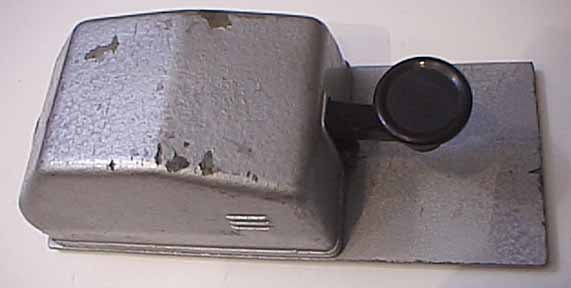
9466 GERMAN JUNKER KEY:(15KB)
As above with clamshell cover. Silver Color JUNKER Honnef/Rh
Versorg Nr 12-120-5906 on label inside cover. (This is one
of the modern versions of the Junker keys which are still
being manufactured. They are made in olive-drab and silver colors.)
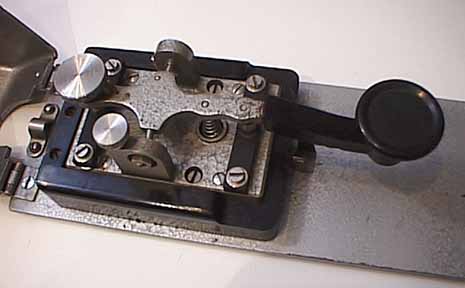
9466a A view of 9466 with cover open:(18KB)
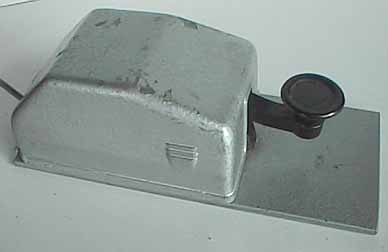
9467 GERMAN JUNKER KEY:(15KB)
As above with silver cover and olive-drab key.
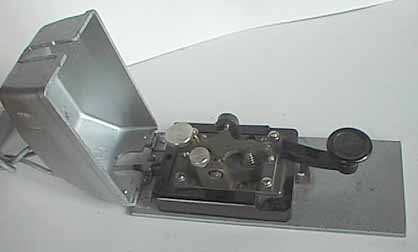
9467a A view with cover open:(18KB)
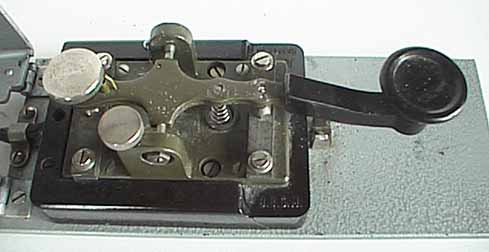
9467b A closer view of the key:(18KB)
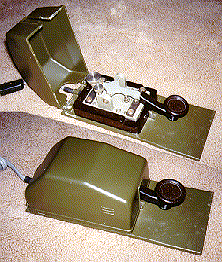
9468 GERMAN JUNKER KEY:(37KB)
As above with olive-drab color cover and silver key marked: JUNKER Honnef/Rh
Versorg Nr 12-120-5906 on label inside cover. (This is one
of the modern versions of the Junker keys which are still
being manufactured. They are made in olive-drab and silver colors.)
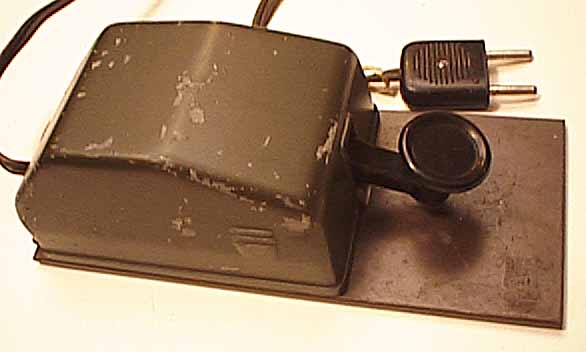
9468a A view with cover closed:(20KB)
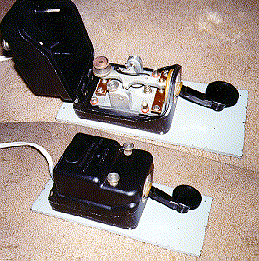
9469 GERMAN FLAMEPROOF KEY:(40KB)
Similar to above but entire mechanism is enclosed in a sealed black
plastic flameproof cover marked: Spannung an der tastkontackten
200V max.ENTSTORT (Maximum voltage on the key contacts 200V.
Spark suppressed). Reported to be an E.German copy of the W.German key.
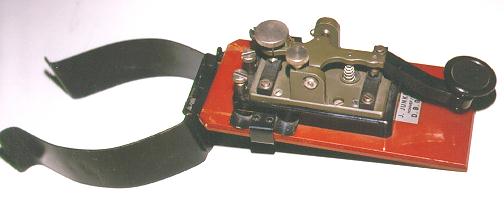
9470 GERMAN JUNKER CLIP-ON-THE-LEG KEY:(15KB)
This key, which was manufacutred by the Junker Company of Bonn,
Germany, slides into a clamp that can be clipped to the
operator's leg. It was used in many kinds of vehicles AND:
The clip-on feature was COPIED in
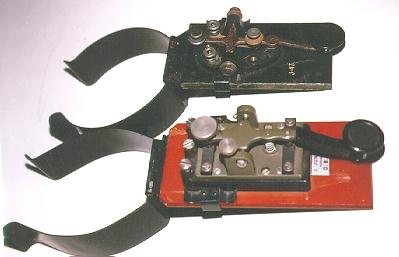
THIS version made in America for the
U.S. Army which mounted a J-37 key on a J-47 base
in a similar manner. (See upper part of this photo):(16KB)
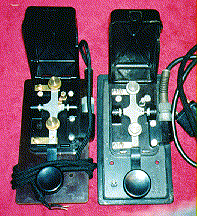
9480 GERMAN T-1 TELEGRAPH KEY: (29KB)
All plated key integrated into brown bakelite base with clamshell
cover which snaps over entire key. Cover engraved "Vor dem Offnen
Stecker Herausziehen" (Unplug before opening).
Black steel base stamped:Baumuster:
T1. Anf.Z.Ln26902. Nazi Swastika and Eagle emblem are stamped into base.
(The Anf.Z.etc. hints at this key being used by the
Luftnachrichtentruppen (Ln) (the Airforce Signal Troops.)
9481 GERMAN TELEGRAPH KEY: Same as 9480 but without Swastika stamp.
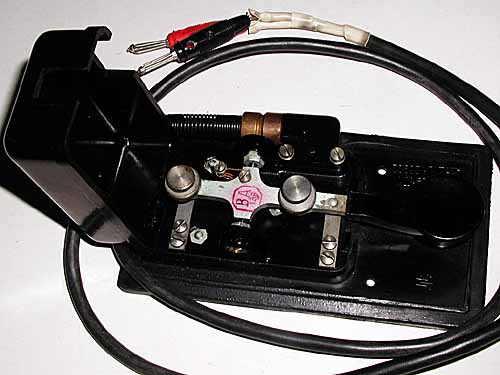
9484 GERMAN LUFTWAFFE T-1 TELEGRAPH KEY: (33KB)
Same as above T-1 keys except that the lever carries the ''BAL''
(Bau Amt Luftwaffe)(Amt=Office) stamp of the Luftwaffe.
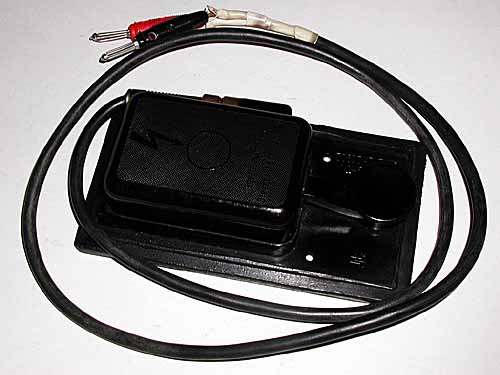
9484a LUFTWAFFE T-1 TELEGRAPH KEY with cover closed:
(30KB)
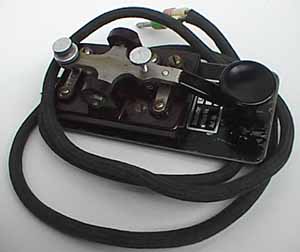
9490 GERMAN MILITARY T-2 TELEGRAPH KEY:(42KB)
Brown key mounted on black metal base. Label reads: Baumuster L. T. 2
Werk No. 8992. Anf. Z. FL.127000. BAI 30 (Anf=Order Number, FL=Flieg;
fly)(Any equipment with an FL Anf. Z was used by the Luftwaffe).(Special
Note: The L.T. stands for 'LehrTaste' which means 'training key'...
so this key was used as a Luftwaffe training key.)
)
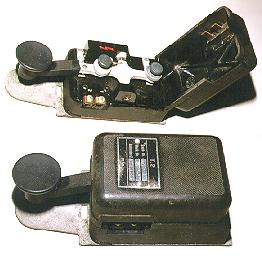
9491 Another version of the German T-2 key:(16KB)
Closing the cover shorts the contacts on the key. The zig-zag red symbol
warns of high voltage. The label reads: T2, Lieferer (supplier) Telefunken,
Gerat Nr. (Device Number) 124-4D2A-1, Werk Nr. (plant Number) 41398-40,
Anforden Z (destination) la 26906, Bauart: (type) Lorenz. In the lower
right corner is the Lorenz logo.
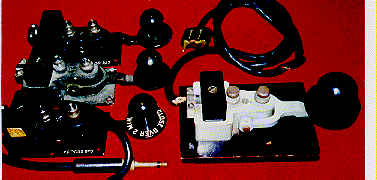
9500 IMPORTANT AND RARE GERMAN LUFTWAFFE KEY:(19KB)
This key carries the "BAL" (Bau Amt Luftwaffe)(amt=office) stamp of the
Luftwaffe. The key is particularly noteworthy because its design
is EXACTLY like the US military 26003A keys shown on the left for
comparison. It has been suggested that the US military copied
this early German design.
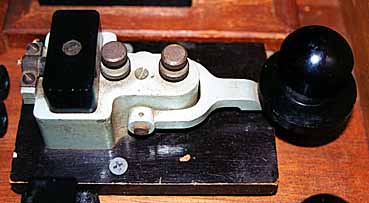
9500a A closer view of the BAL key:(18KB)
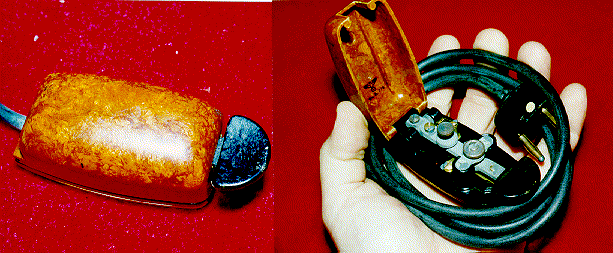
9520 TINY NAZI CLAMSHELL "TURTLE/MAUS" KEY:(57KB)
Measures: 1-1/4 X 3 inches. Snap on bottom.Nazi Swastika & Eagle
Emblem & Wa.A770 printed inside cover.1944 & TKP stamped into base.
Key knob is cut off so that only the front 2/3 is present.Brown.->W2PM
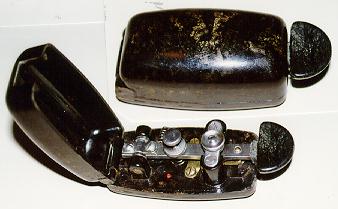
9522 TINY NAZI CLAMSHELL "TURTLE/MAUS" KEY:(17KB)
Same as 9520 but black in color.
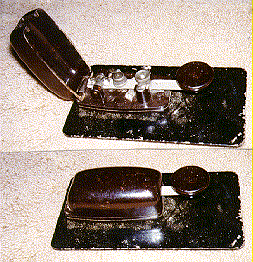
9525 TINY NAZI CLAMSHELL "TURTLE/MAUS" KEY:(38KB)
Another version of the TURTLE/MAUS key. Same size case as 9520 above
but lever extends farther out of clamshell case so that entire round
knob is present. "dbf" and "1942 BA 3814" are moulded into plastic
cover & base.
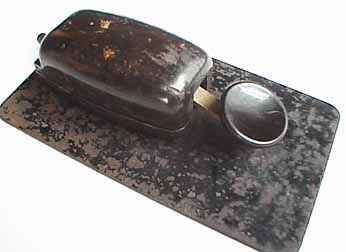
9526 TINY NAZI CLAMSHELL "TURTLE/MAUS" KEY:(13KB)
Similar to number 9525 above.
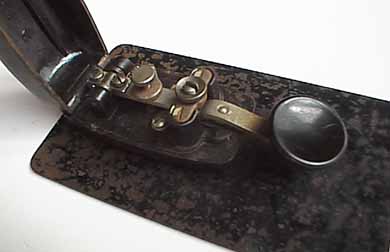
9526a Another view of the Turtle/Maus key:(13KB)
9540 * GERMAN TELEGRAPH KEY: Model K-34. All plated key integrated into
black bakelite base with clamshell cover which snaps over key mechanism.
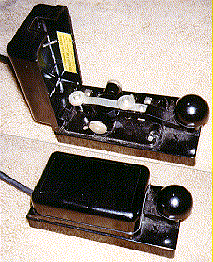
9542 * GERMAN TELEGRAPH KEY:(32KB)
Model K-64. Plastic lever key integrated into black plastic base with
clamshell cover which snaps over key mechanism. Label reads: veb
fahrzeugelektrik leipzig. 7031 leipzig. morsetaste k 64.
mit anschlussschnur. Hergestellt in der ddr. 0.1A bei max. 65V.
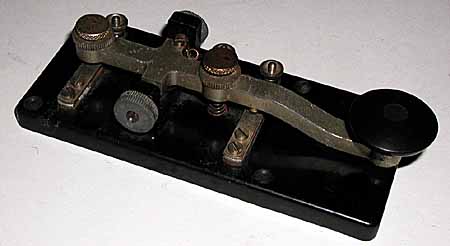
9550 * UNUSUAL CAST ALUMINUM LEVER GERMAN
TELEGRAPH KEY:(15KB)This is an unusual German key which has
a cast aluminum lever and the classic German spring-mounted
lower contacts. It was probably used as a wireless/radio
key.
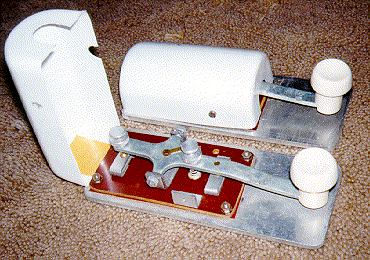
9560 * RECENT GERMAN TELEGRAPH KEY:(55KB)
Very recent design with flat stamped steel lever mounted on a brown
bakelite base with the classical flat-spring mounted make-and-break
contacts that are typical of German keys. Contacts are gold plated.
White knob. Mounted on an aluminum base & covered with a white
plastic cover. Base & cover probably not original.
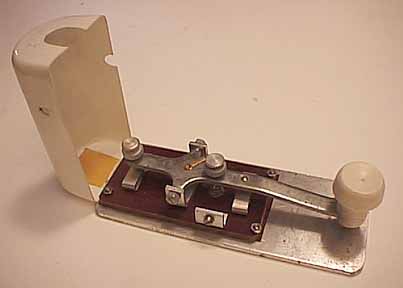
9560a Another view of the
GERMAN TELEGRAPH KEY:(11KB)
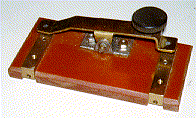
9565 * GERMAN TELEGRAPH KEY:(12KB)
Recent small rocker-arm key with Make-and-break contacts mounted
on a brown bakelite base.. Probably from radio set.
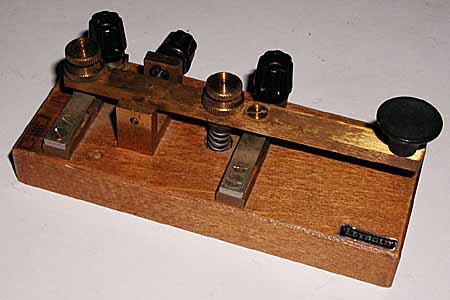
9570 * RECENT "LEYBOLD" GERMAN TELEGRAPH KEY:(21KB)
This is an inexpensively manufactured key which carries the 'LEYBOLD'
label. It has a stamped brass-annodized (probably) aluminum alloy
lever and the classic German spring-mounted lower contacts.
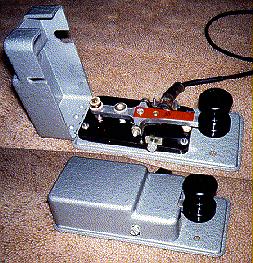
9590 MANY EAST GERMAN/RUSSIAN TELEGRAPH KEYS:(30KB)
For many years various models of telegraph keys such as this one
were used by both the East German and the Russian Military Forces.
Rather than duplicate all of the pictures of all of the models
in both the German and Russian telegraph keys sections of this
museum, I have put them in the latter part of the Russian
telegraph keys section. Please go to that section to view
these keys.
Internet ENIGMA Museum:
https://EnigmaMuseum.com
COPYRIGHT NOTICE: (Copyright (c) 2023: Prof. Tom Perera Ph. D.)
Although all the pictures and text are copyrighted, you may use any of them
for your own personal applications including public lectures and
demonstrations, publications and websites as long as you mention the
w1tp.com Museum. If you plan to offer them for sale to the public
in any form, please email me for permission which I will generally grant as
long as you mention my museum: http://w1tp.com or https://EnigmaMuseum.com My email address is
given at the bottom of this page. Some of the material may require contacting
other copyright owners for commercial use and I will inform you by email.
Please also see the Disclaimer of Warranty.
SPECIAL NOTE ABOUT LABELS AND DATING:
The dates on Japanese key labels give the date in the reign of a specific
emperor. For instance, 9640a shows the date as "Showa 19 years, 9 months".
This is the 19th. year and the 9th. month of the reign of the Showa Emperor.
Showa was the formal regnant title of the Emperor we know as Hirohito which
was his personal name. (Thanks to Edwin Lowe, VK2VEL for this information.)
(The instruments are in approximate chronological order: Oldest first.)
* = (Items no longer owned.) ** = (Items in other collections.)
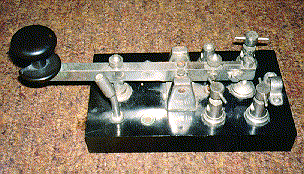
9620 JAPANESE SPARK KEY: (36KB)
(See description under "SPARK KEYS".)
Very large heavy contacts to handle the high currents.
Very similar in design to current JRC key number 9689.
(Traded to W2PM, 1995.)
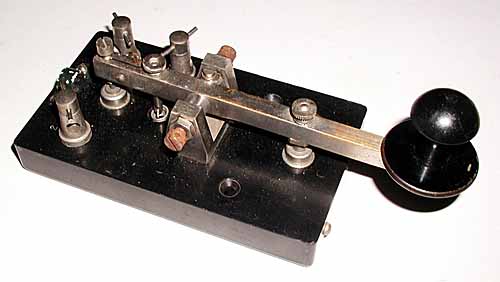
9625 JAPANESE SPARK KEY: (24KB)
Very Similar to key number 9620 above.
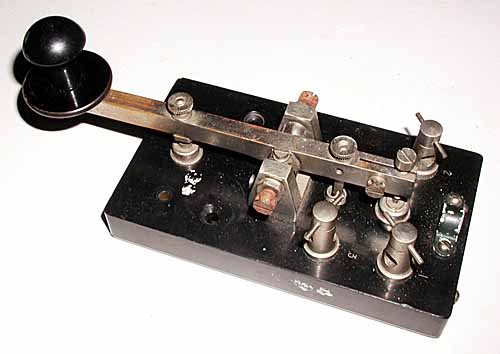
9625a Another view of the Japanese Spark
Key: (20KB)
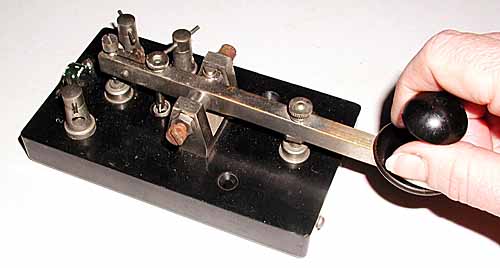
9625b A third view of the Japanese Spark
Key: (21KB)
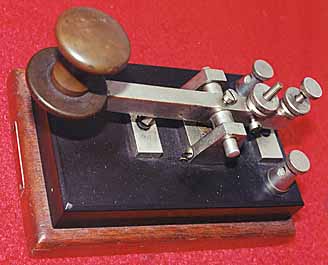
9630 JAPANESE MILITARY KEY FROM WW-2:(17KB)
This is a Japanese Military Radio key from WW-2. It has the
classic straight lever design.
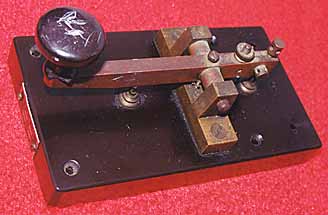
JAPANESE TELEGRAPH KEY FROM THE LATE 1930's:(15KB)
This is another straight-lever Japanese radio key.
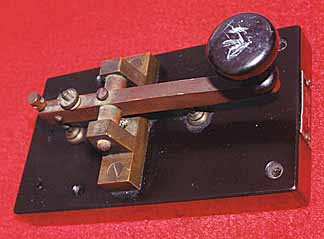
another view of the Japanese key:(15KB)
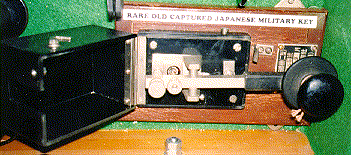
9640 EARLY JAPANESE MILITARY KEY: (35KB)
All plated key with doorknob style knob integrated into a black bakelite box
which completely covers the key. It is mounted on a wooden base which carries
a label in Japanese which shows the date as "Showa 19 years, 9 months". This
is the 19th. year and the 9th. month of the reign of the Showa Emperor. Showa
was the formal regnant title of the Emperor we know as Hirohito which was his
personal name. (Thanks to Edwin Lowe, VK2VEL for this information.)
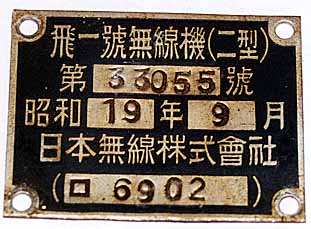
9640a Close-up view of the label:
(28KB)
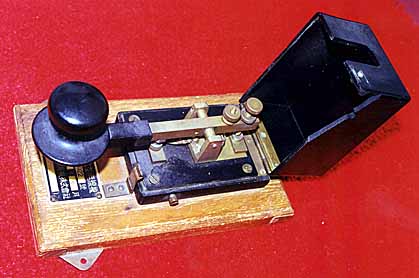
EARLY JAPANESE MILITARY KEY:(23KB)
This key is very similar to number 9640 above.
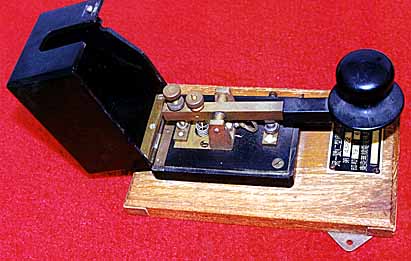
Here is another view of the key:(24KB)
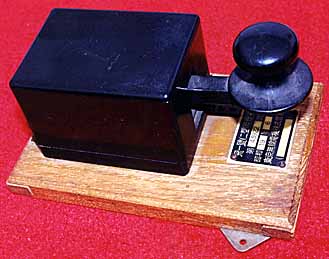
And here is a view of the key with the
cover closed:(20KB)
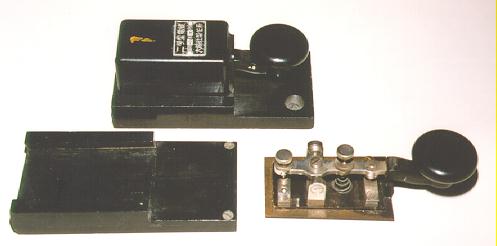
9650 CAPTURED MINIATURE JAPANESE KEYS:(14KB)
This small key was brought back by a 24th Division Signal Company
officer, Ed Shakalis (KD1BJ), who removed it from a captured Japanese
command car in which it was being used on the Philippine island of
Mindanao during WWII. The key is enclosed in a black plastic cover
and slides into a lead-weighted base that was screwed to a shelf on
the back of the front seat of the command car. Another similar key is
shown in the background with the elaborate Japanese label on top of the
case.
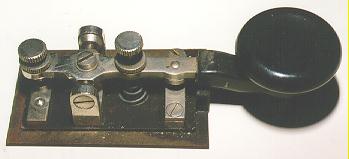
9650a This closeup view shows more of the details:(23KB)
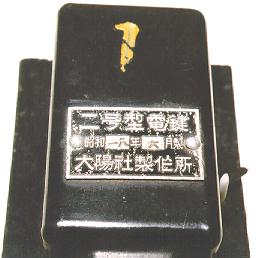
9651 CAPTURED MINIATURE JAPANESE KEY:(13KB)
This view shows the elaborate identification label on top of the case.
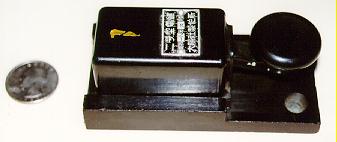
9651a A size comparison view of #9651:(13KB)
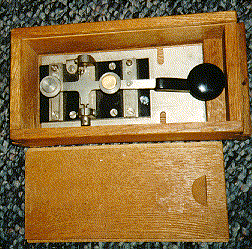
9660 CAPTURED JAPANESE WWII NAVY KEY: (39KB)
Brought back from the Pacific Theatre after WWII. This key has both
open and closed circuits. It is plated brass on a black base mounted
on a metal bracket. It is enclosed in the original wooden box with
a sliding wooden cover which was apparently mounted to a radio or
table by metal brackets which are part of the box. The writing on
the bottom of the box says "electric button" in Japanese.
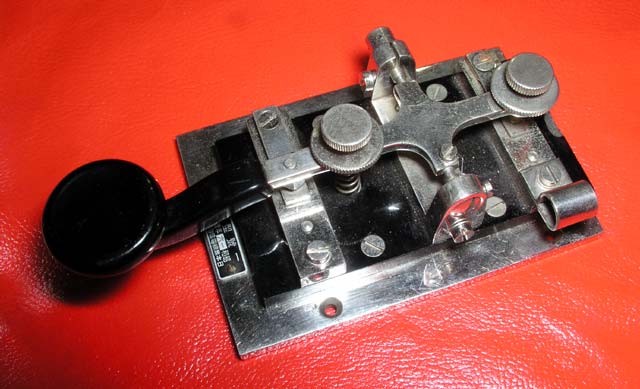
9665 JAPANESE WWII NAVY KEY:
This key is very similar to the boxed key shown above. The difference,
however is that this key carries a label written in Japanese and mounted
on the metal base directly under the lever.
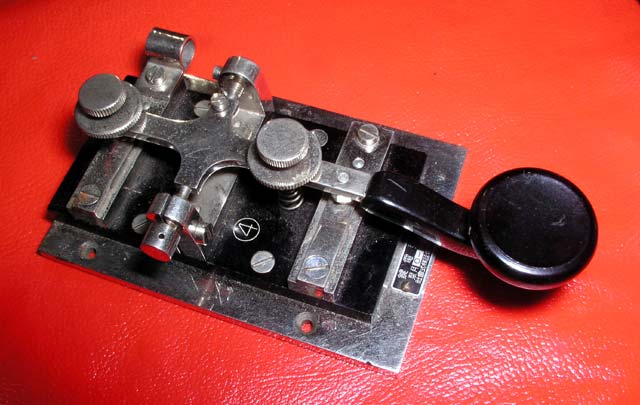
9665a A different view of this key:
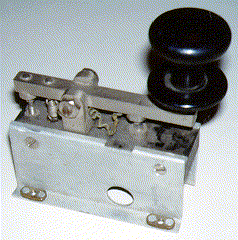
9670 JAPANESE AIRCRAFT KEY:(26KB)
This small key was mounted on the side of the cockpit of Japanese
"Zero" fighters used during World War II. It is enclosed in its
metal mounting bracket.
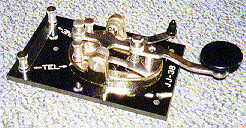
9672 * JJ-38 JAPANESE COPY OF A J-38 WORLD WAR II UNITED
STATES MILITARY KEY:(21KB)
At first glance, this key appears to be a standard World War II vintage J-38
United States Military Key. However, it is marked JJ-38 and the key mechanism
is the familiar imported Japanese design with the ball-bearings at the end of
the trunnion that has been widely distributed in this country since the
1960's.
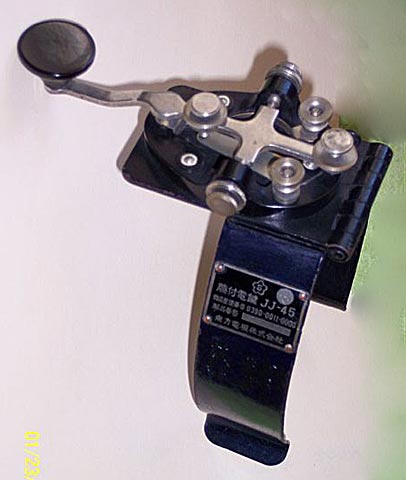
9674 JJ-45 JAPANESE COPY OF A J-45 WORLD WAR II
UNITED STATES MILITARY CLIP-ON-THE-LEG KEY:(21KB)
At first glance, this key appears to be a standard World War II vintage J-45
United States Military Clip-on-the-leg Key that was widely used in mobile
communications applications. However, it is marked JJ-45 and it carries a
complex metal label written in Japanese where the American J-45 simply carries
the 'J-45' stamped into the metal leg clip. Scott Hill, K6IX has the only
other known example of this key but it simply has a large 'JJ-45' stamped on
the side of the leg clip and no label. Tetsuo Yamamoto, JA3PYC, has
translated the label as follows:
Leg Clip Key JJ-45
Parts Number 0390-0011-0000
Serial Number (Blank)
TOHO DENKI KABUSHIKIGAISHA (TOHO Electric Company Ltd.)
(Toho Electric Co. is now Panasonic Communications Co. Ltd. Toho was a
facsimile maker and joined the Matsushita Group ((Panasonic)) in 1962.)
Tetsuo also tells me that the Cherry Blossom mark at the top of the label is
used by the Japanese 'Self-Defense Force' (Army) and it shows that the key was
made after WW-2 with license from the Signal Corps. He does not know what the
letter 'S' inside the Cherry Blossom stands for but he has seen the letters
'Q' and 'W' inside the Cherry Blossom and sent me an example of the Cherry
Blossom 'W' mark stamped on the side of a pistol.
In addition, the actual key itself is marked JJ-37 in raised characters cast
into the base in exactly the same place as the common American J-37 key.
Another example of the JJ-37 key owned by Scott Hill, K6IX, has the words
'Soling Japan' moulded into the bottom of the base but this one does not carry
that mark. It is unclear when this key was made. This key was origianlly
found by Bill Gallier, W4WX who took these photos before I bought the key.
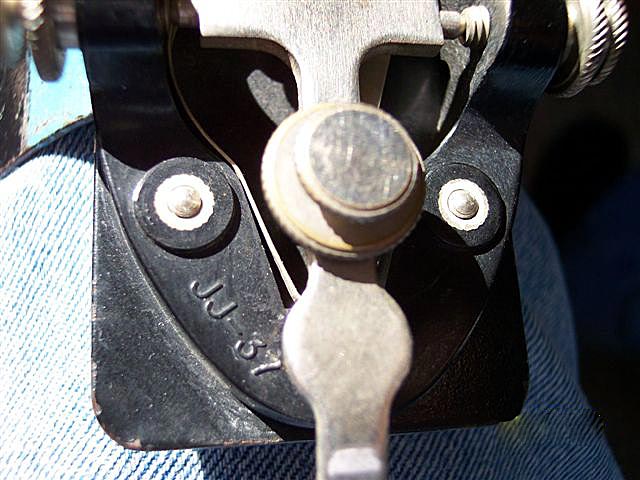
9674a A close view of the JJ-37 characters cast into
the base of the key:
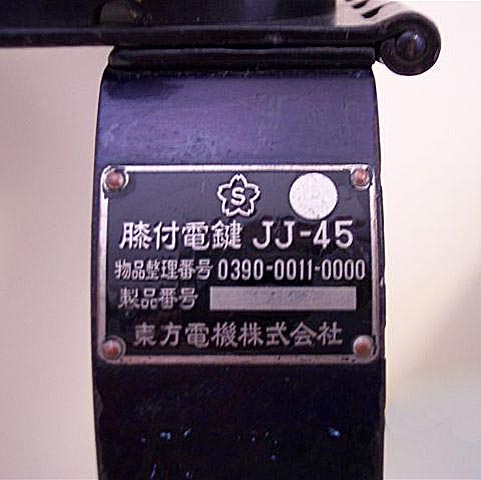
9674b A close view of the special Nameplate mounted on
the side of the leg clip:
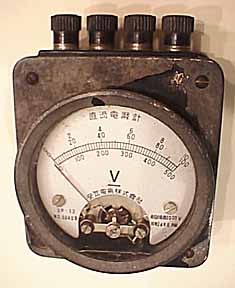
9679 * JAPANESE MULTIMETER FOR TELEGRAPH AND
RADIO:(18KB)
This meter has a number of scales for measuring voltage and current in the
field.
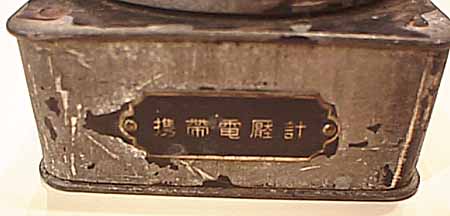
9679a Close-up of the label on the meter:(18KB)
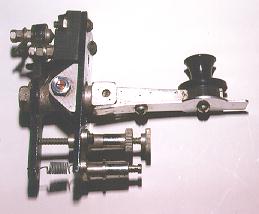
9680 JAPANESE RADIO KEY:(10KB)
This tiny key was apparently mounted on the front of a radio set.
It was pulled down into this position to allow operation.
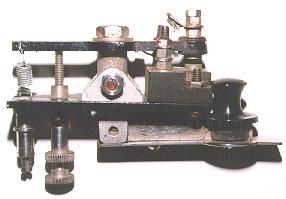
9680a This photo shows it in the closed position:(11KB)
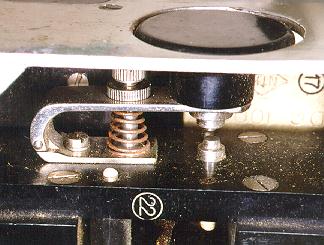
9685 * MINIATURE JAPANESE RADIO KEY:(22KB)
This tiny key was mounted inside a
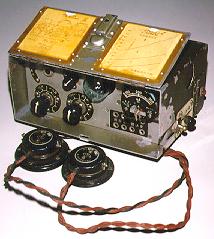
tiny 1 tube portable
radio set:(16KB)That was brought back from the island of Mindanao
in the Philippine Islands by a 24th Division Signal Company officer,
Ed Shakalis, KD1BJ.
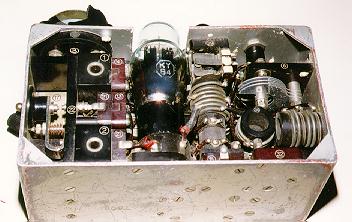
9685b This view shows the inside of the set:(22KB)

9687 * JAPANESE MINIATURE FOLDING KEY IN RADIO CONTROL
BOX:(14KB)
This tiny key folds into the control box for storage.
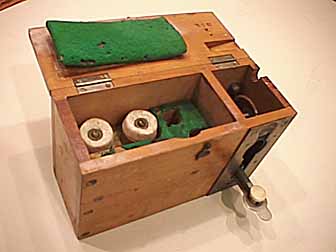
9687a VIEW OF FOLDING KEY WITH RADIO CONTROL BOX
OPEN:(15KB)
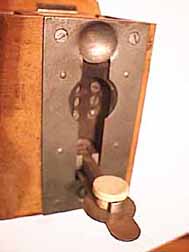
9687b CLOSE-UP VIEW OF FOLDING KEY IN OPEN POSITION:(12KB)
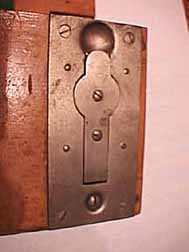
9687c CLOSE-UP VIEW OF FOLDING KEY IN CLOSED POSITION:(12KB)
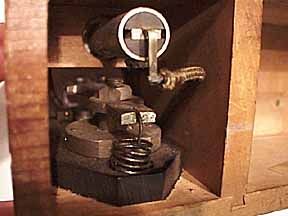
9687d CLOSE-UP VIEW OF INSIDE OF FOLDING KEY:(15KB)
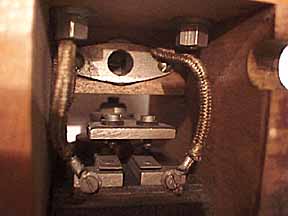
9687e CLOSE-UP VIEW OF INSIDE OF OTHER END OF FOLDING KEY:(15KB)
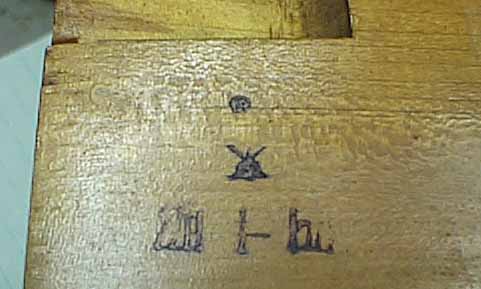
9687f CLOSE-UP VIEW MARKINGS INSIDE BOX:(22KB)
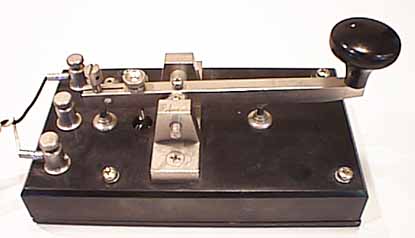
9689 * CURRENT JRC (JAPANESE RADIO CORP) RADIO KEY:(15KB)
This key is very similar in design to the earliest Japanese Spark and
wireless keys.
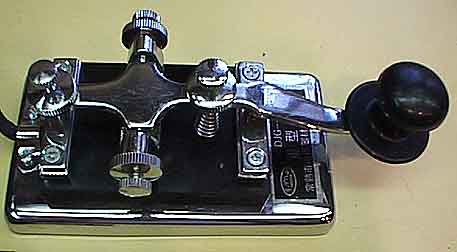
9690 CHINESE YUSHAN DJG-4 KEY:(21KB)
This is a Chinese Radio Key produced in 1995.
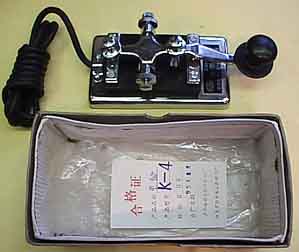
9690a View of key with original box:(23KB)
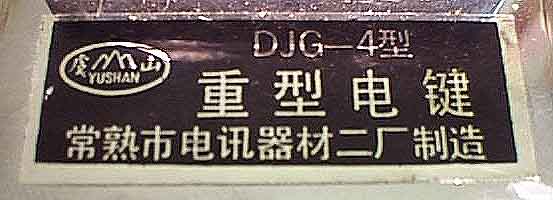
9690b Close-up view of label:(16KB)
Internet ENIGMA Museum:
https://EnigmaMuseum.com
COPYRIGHT NOTICE: (Copyright (c) 2023: Prof. Tom Perera Ph. D.)
Although all the pictures and text are copyrighted, you may use any of them
for your own personal applications including public lectures and
demonstrations, publications and websites as long as you mention the
w1tp.com Museum. If you plan to offer them for sale to the public
in any form, please email me for permission which I will generally grant as
long as you mention my museum: http://w1tp.com or https://EnigmaMuseum.com My email address is
given at the bottom of this page. Some of the material may require contacting
other copyright owners for commercial use and I will inform you by email.
Please also see the Disclaimer of Warranty.
(The instruments are in approximate chronological order: Oldest first.)
* = (Items no longer owned.) ** = (Items in other collections.)
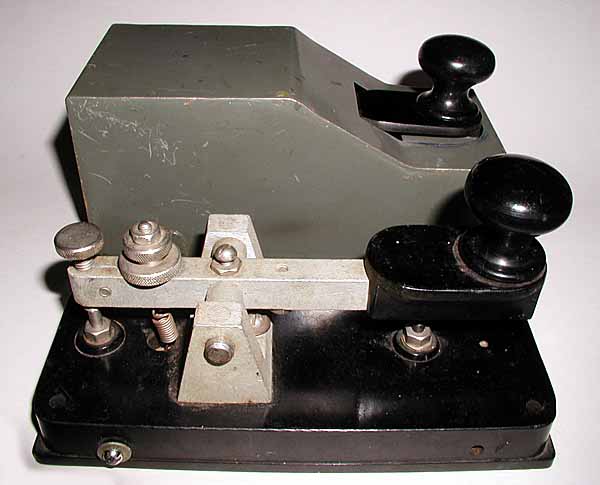
9707 RUSSIAN MILITARY WIRELESS KEY:(37KB)
This key has heavy-duty contacts to allow it to key high current
transmitter circuits. The key is enclosed within a metal box.
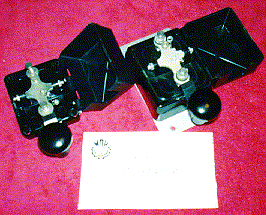
9710 * CLASSIC KM or KM-F RUSSIAN MILITARY KEY: (27KB)
All plated metal key with large doorknob shaped knob integrated onto
hollow plastic base with plastic cover which snaps over the key.
Base contains Russian capacitor/filter & is screwed to grey crinkle
finish plate. It was made in Ukranian Telegraphy Equipment Plant
ZTA in Cherkassy. Some of its features were taken from the
German Junker DRP key design.
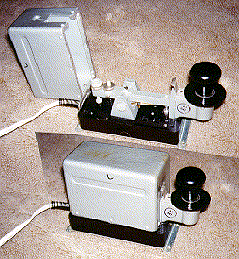
9714 * RUSSIAN MILITARY KEY:(37KB)
5-1/2" lever mounted on a black plastic base. Mechanism is enclosed
in a high grey metal box measuring 2"Wx3"Hx4"D. From the knob down,
the lever is entirely enclosed in a metal shroud. It was used with
the high powered R-102M radio sets. Earlier versions
of this key were used with airbourne RSB-5/R-801/R-807/Danube/RSB-70
(Russian replicas of SCR-274, ART-13, and ATC/ATD) radio sets.
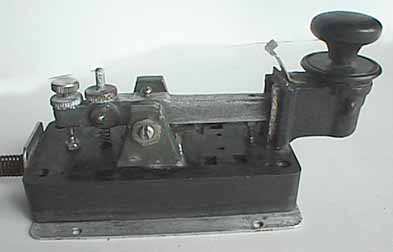
9714a Another well-used example of this key:(11KB)
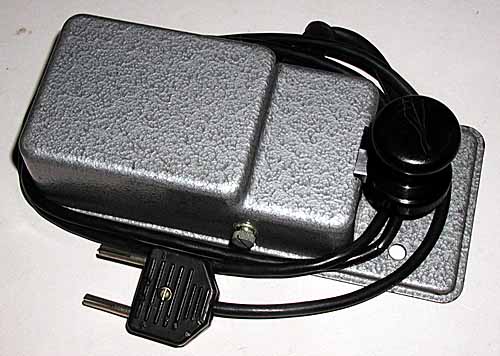
9716 * HUNGARIAN MILITARY TELEGRAPH KEY:(40KB)
This key was manufactured by the Mechlabor (Mechanical Laboratory) in Budapest
during the Cold War (1946-1985). These keys were used in Hungary and other
former Eastern-Block countries. The key has a heavy metal 5-1/4" lever mounted
on a black plastic base. The mechanism is covered by grey stamped steel step-
down swing-over cover. The key is mounted on a grey stamped steel base. the
label reads Mry 597 1985, Jan. The key was used with the M104 radio set. A
Russian collector suggests that this rado may be a German NVA (National
VolksArmee (National Army of the People)) version of the R-104.
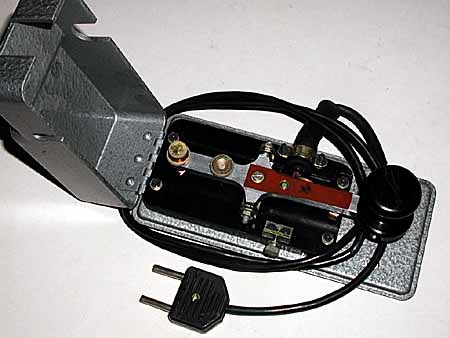
9716a Russian key with cover opened:(27KB)
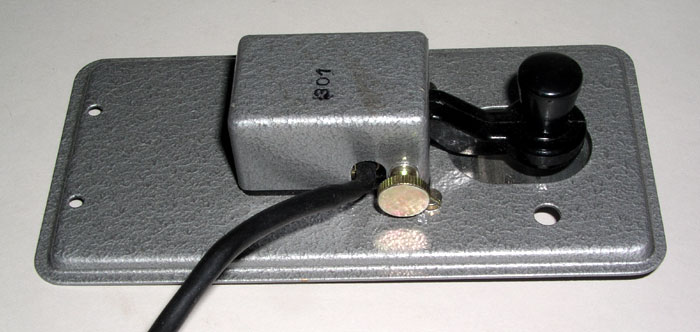
9717 * RUSSIAN MINIATURE MILITARY KEY:
Tiny metal 3" lever mounted on a black plastic base. Mechanism covered by
1"x1"x1-3/4" grey metal cover. All mounted on a grey stamped steel base.
These keys were used with R-143, R-159, Angara and some spy radios and
some special radios. The key is also supplied in a small green case.
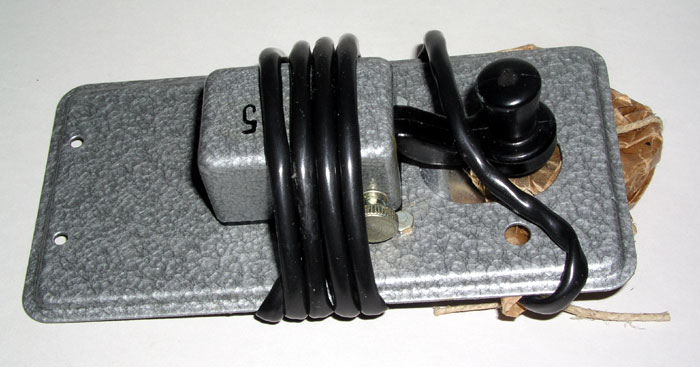
9717a * The Miniature Russian Key with connecting cable:
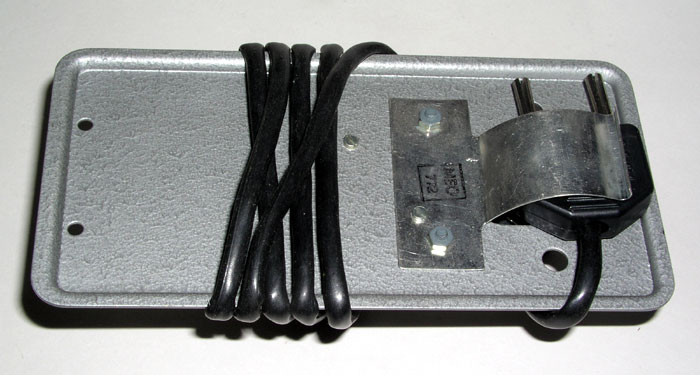
9717b * The Bottom of the Miniature Russian Key showing
the clip that holds the connector when not in use:
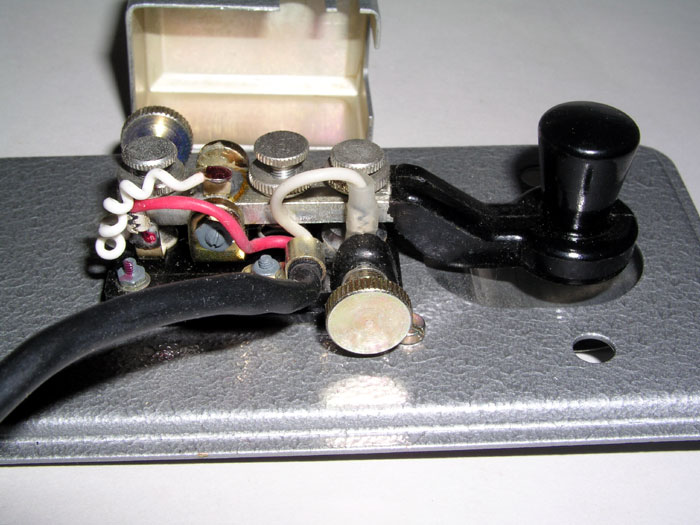
9717c * The Miniature Russian Key with cover removed
showing the left side of the mechanism:
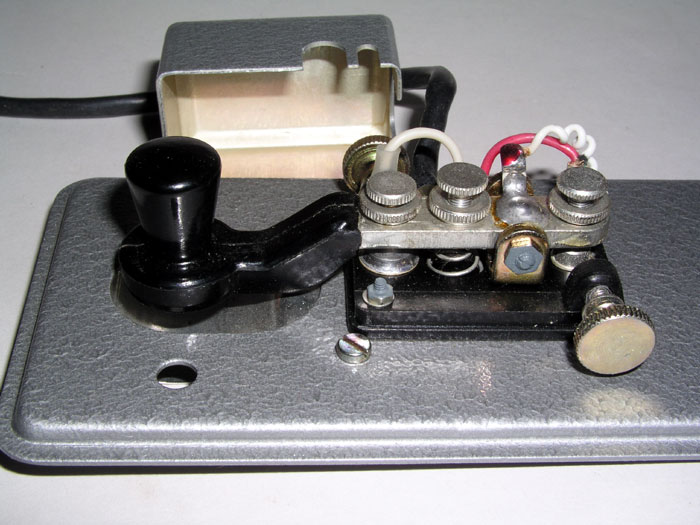
9717d * The Miniature Russian Key with cover removed
showing the right side of the mechanism:
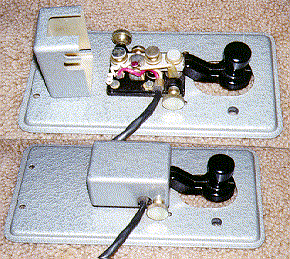
9717.gif * Another example of the Miniature Russian Key:
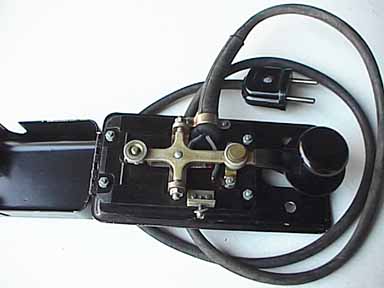
9719 * RUSSIAN RB/RB-M/R-104/R104M MILITARY KEY:(18KB)
Light metal 4-1/2" lever mounted on a black plastic base. Mechanism
covered by black metal swing over cover. All mounted on a black
stamped steel base. This key was first produced before WW-2 in 1938.
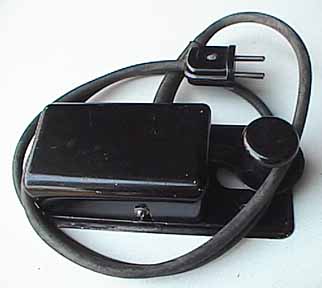
9719a Another view with cover closed:(15KB)
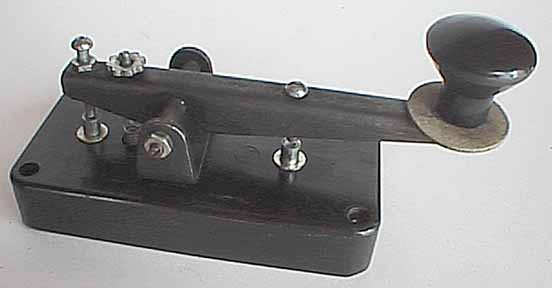
9720 * RUSSIAN TRAINING KEY:(14KB)
Black painted stamped metal parts with doorknob style knob integrated
onto a narrow black plastic base. Many of these keys were made for
use in training DOSAAF (MARS) and school children in the use of the code.
Greg Ulsamer reports that DOSAAF represents abbreviations of the Russian
words: Dobrovol'noye Obshchestvo Sodeystviya Armii Aviacii i Flota which means
in German: Freiwillige Gesellschaft zur Forderung von Heer, Luftwaffe, und
Marine. In English, it is: Voluntary Organization for the promotion of Army,
Air Force and Navy, a pre-military organization to train children in these
fields.
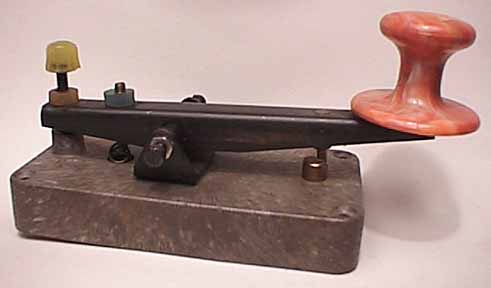
9721 * RUSSIAN TRAINING KEY:(12KB)
Similar to number 9720 with grey base and red knob.
(See description for 9720 above.)
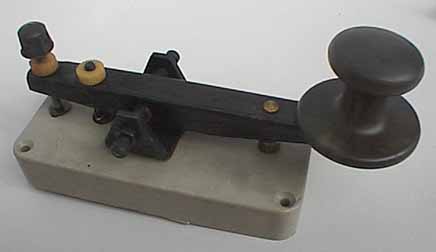
9722 * RUSSIAN TRAINING KEY:(9KB)
Similar to number 9720 with light grey base and black knob.
(See description for 9720 above.)
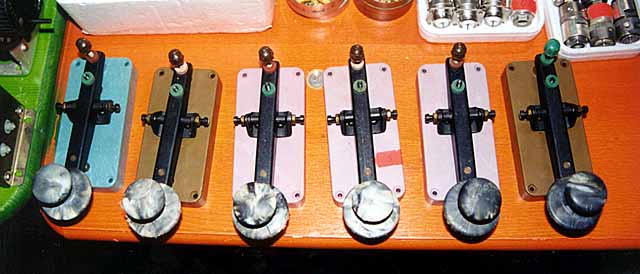
9723 * A COLORFUL SET OF RUSSIAN TRAINING
KEYS:(35KB)
These keys were made in many colors as indicated by this picture.
(See description for 9720 above.)
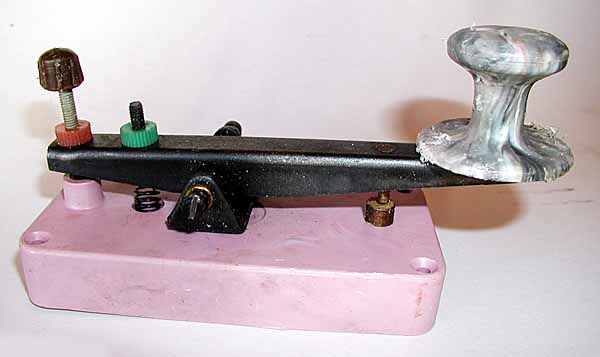
9723a This is the most colorful of the Russian
Training Keys in the picture above. It is shown in high detail:(21KB)
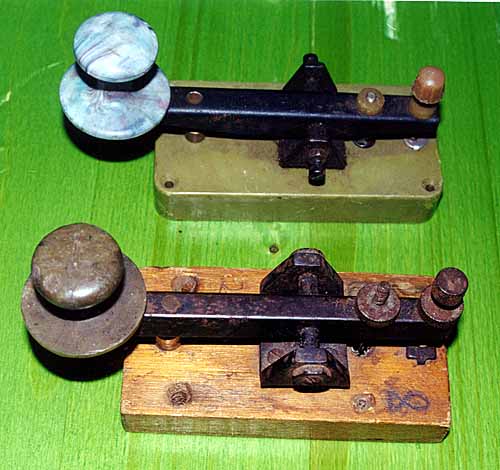
9724 * THE WOODEN-BASED RUSSIAN KEY WHICH
WAS USED AS A MODEL FOR ALL OF THE PLASTIC KEYS SHOWN ABOVE:(35KB)This
is the original model of Russian key which was used as a design model
for the training keys shown above as items 9720-9724.
(See description for 9720 above.)
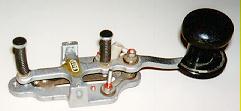
9726 * RUSSIAN MILITARY KEY: (6KB)
Originally mounted inside a metal case. The decal on top reads: P405. It is
likely that this key is similar to the ones that follow. However, a Russian
collector suggests that this key may have been used in ground stations of the
Russian Air Force.
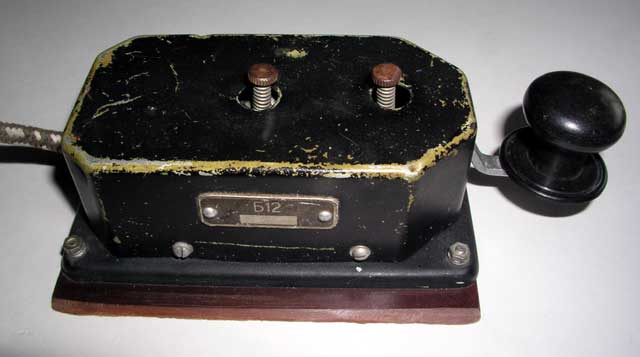
9727 RUSSIAN AIR FORCE AIRCRAFT KEY: (25KB)
I have been told that this key was used in Russian Helicopters or other
aircraft.
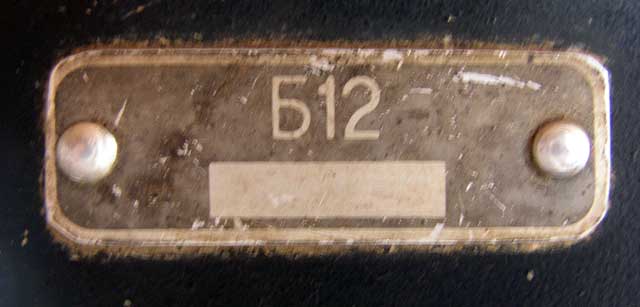
9727a A closeup of the label on the key: (23KB)
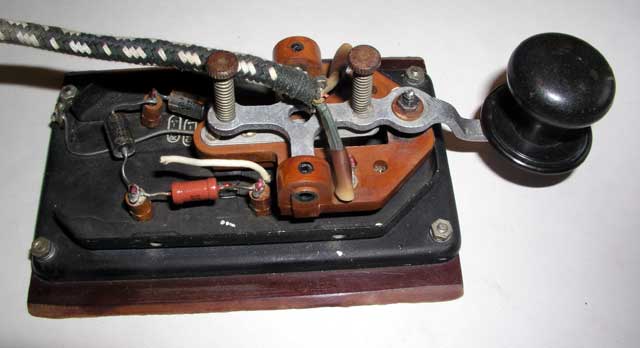
9727b The inside of the Russian Key: (27KB)
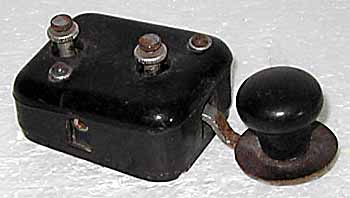
9728 * RUSSIAN MILITARY KEY: (13KB)
The mechanism of this key is similar to that of number 9726 but
the key is enclosed in a protective cover with the spacing and
spring force adjustments protruding through the top of the cover.
A russian collector suggests that this key may have been used
in ground stations of the Russian Air Force.

9728a * The key with cover open: (16KB)
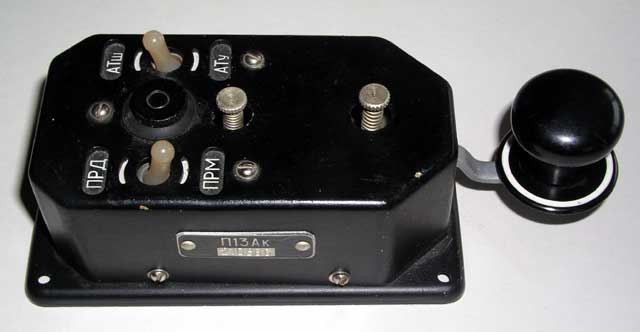
9729 RUSSIAN SPACE CRAFT KEY: (21KB)
I have been told that this key was used in Russian spacecraft and/or
space capsules. More specific information would be appreciated.
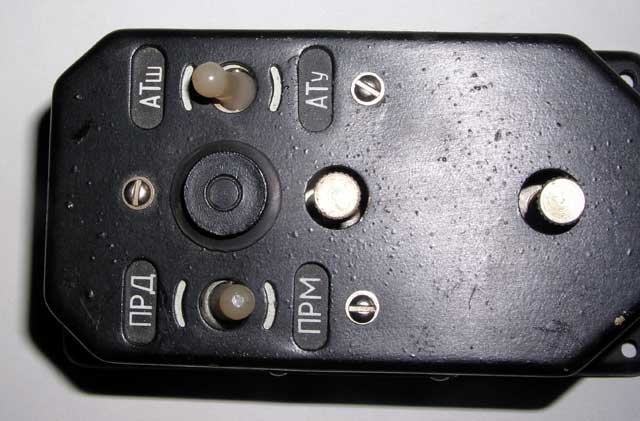
9729a A closer view of the switches on top of the Russian
key: (40KB)
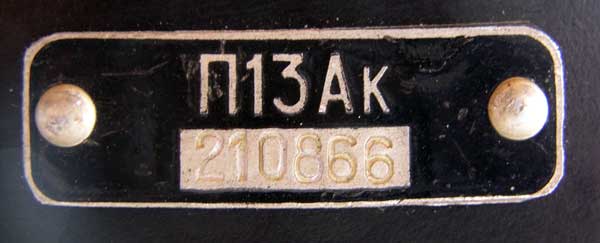
9729b A closeup of the label which reads: P13AK with
serial number: 210866. (21KB)
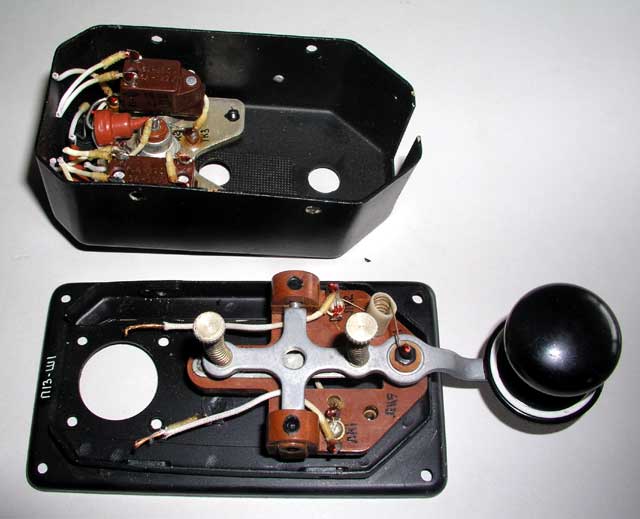
9729c A view of the key with the cover removed. The
connector on the bottom of the key is missing. (38KB)
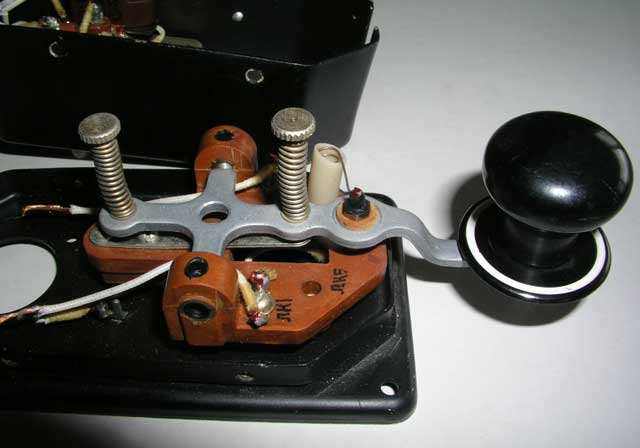
9729d A closer view of the unusual key mechanism:
(28KB)
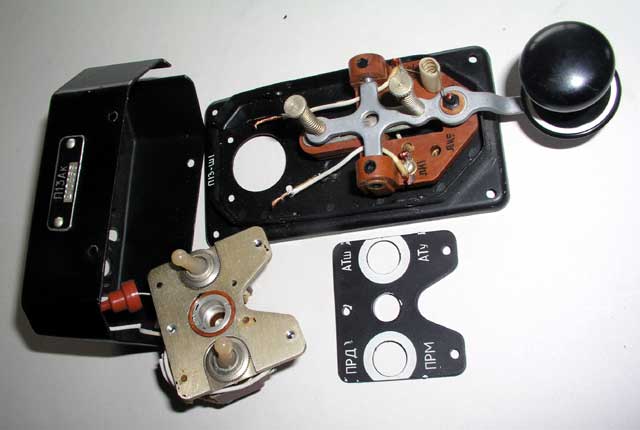
9729e A further disassembly of the switch mechanism and
the transparent panel which lights up at night: (30KB)
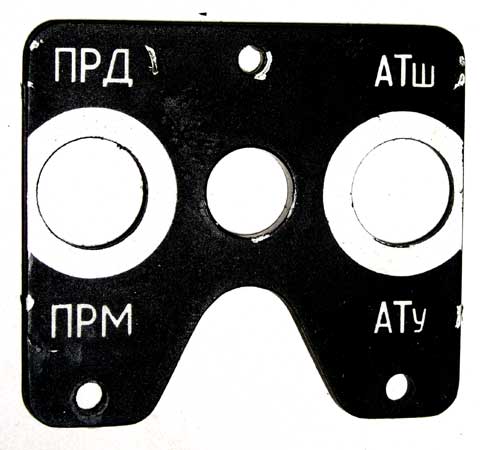
9729f A closeup of the transparent lighted panel. You may
use this photo to print a replacement panel if yours is missing:
(30KB)
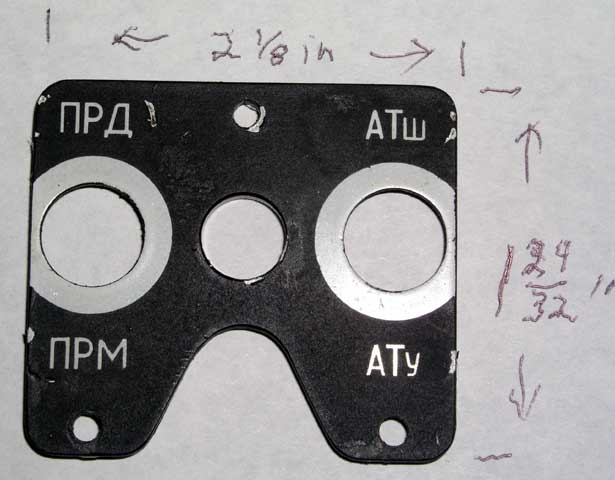
9729g A closeup of the transparent lighted
panel with dimensions. (33KB)
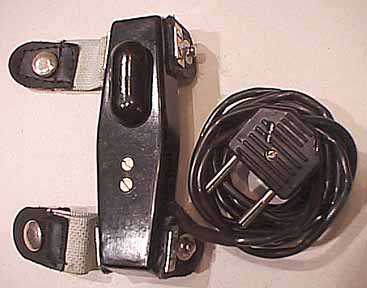
9730 * RUSSIAN MILITARY BELT RADIO KEY:(20KB)
This Russian telegraph key was apparently designed to snap
onto a military belt for use while in action. It consists
of a long plastic case with an oval key knob. There are
two snap-fastened stretch bands which are used to attach
the key to the uniform or radio belt straps. The key
comes with a cord and the typical 2-prong plug found on
most Russian and German radio sets. The key was found attached
to a very small belt-worn Russian two-way radio but it is not clear
whether it was for keying CW signals or for push-to-talk operation.
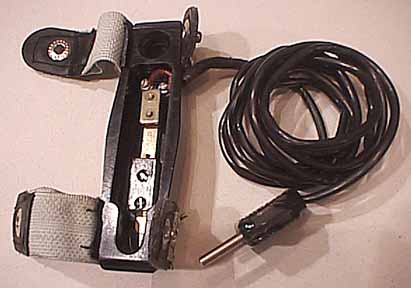
9730a A view of the underside of the belt
key:(21KB)
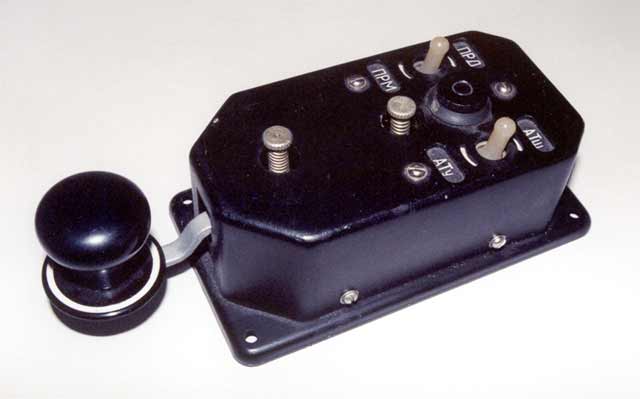
9735 RUSSIAN AIRCRAFT (?HELICOPTER?) TELEGRAPH KEY:(16KB)
This interesting key is part of a series of similar keys such as
number 9736 that differ only in the number and labeling of the
control switches on top of the key case. I am still looking for
more information about where these keys were used. Several people have told
me that they were used in aircraft and, since they are made with very light
metal materials, this sounds reasonable. Others have told me that they
were used in Russian spacecraft.
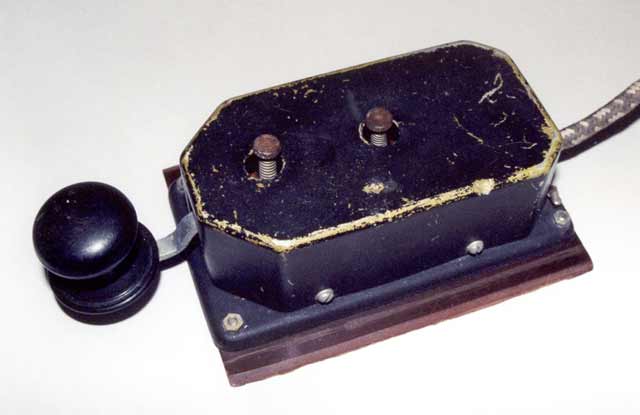
9736 RUSSIAN AIRCRAFT (?HELICOPTER?) TELEGRAPH KEY:(20KB)
This key is similar to 9735 above but it has no control switches on top of
the metal cover.
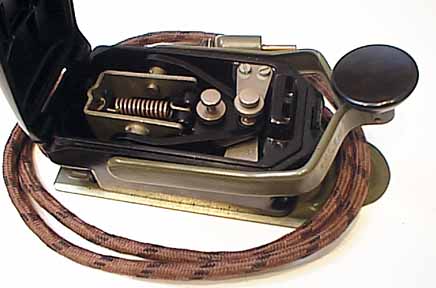
9740 WW-II CZECHOSLOVAKIAN MILITARY KEY:(13KB)
This interesting and unusual key has a clamshell cover with
a disconnect which opens the circuit when the cover is open.
Lifting the knob of the key up acts as shorting switch and
can switch a radio set into the receive condition.
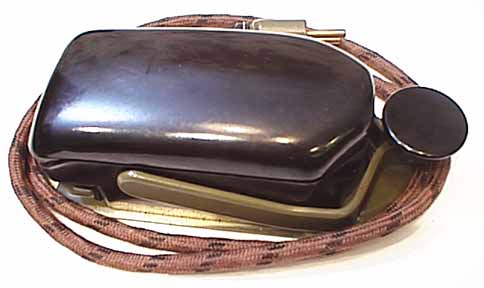
9740a A view of the key with cover closed:(13KB)
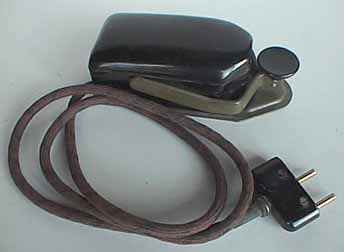
9740b A view of the key and cable assembly:(13KB)
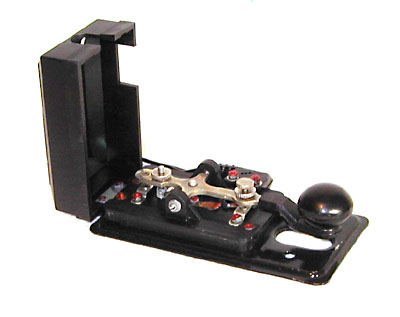
9743 * BULGARIAN TELEGRAPH KEY:(24KB)
This Bulgarian key is marked on the top of the cover 'G. Damjanov'
and 'Razgrad'. G. Damjanov was the name of the factory and Razgrad
is the city in which it was located. George Parvanov Damjanov,
1892-1958 was a hero of socialistic work. In 1992 the name of
the factory was changed to han Krum (han=king).
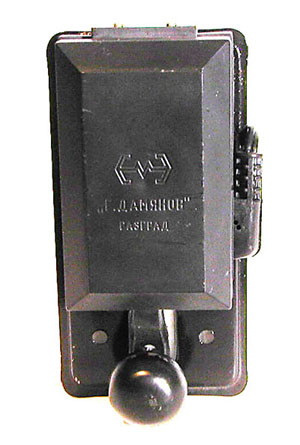
9743a Another view of the Bulgarian key:(35KB)
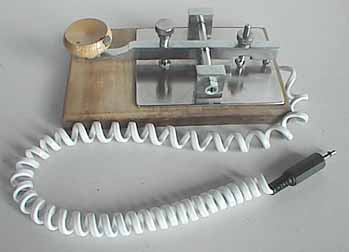
9745 * ROUMANIAN TELEGRAPH KEY:(12KB)
This recent key was produced in large numbers in Roumania.

9747 YUGOSLAVIAN TS- TELEGRAPH KEY FOUND IN EGYPT:(23KB)
I purchased this key in Cairo in 2000. It is the first key that I have been
able to find in Egypt. It consists of a telegraph key mounted on a bakelite
base, a metal cover, and a metal sub-base which has the remains of canvas
straps which were used to strap it to the operator's leg. The mechanism of
the key is very well made and quite unusual. An operator has scratched his
name in the cover in Arabic letters. In 2001 I was informed that this is a
Yugoslavian Army telegraph key and not Egyptian, that the letters ''TS'' stand
for "Taster" (or push-button) "Switch", and that it is model TS-1. In 2006, I was
informed that it is an Italian Military telegraph key made for the Army by an
Italian company named IRET in Trieste which is no longer in business. In 2013
I was informed that IRET sold equipment to the former Yugoslavia so the TS-1
could be a copy of some Italian key. Egypt had close ties with the former
Yugoslavia and was supplied with Yugoslavian-made Army equipment especially in
the 1960s - 1970s. This is presumably how it came to Egypt where I found it.

9747a Another view of the key:(20KB)

9747b A view with the cover closed:(13KB)

9747c Another view with the cover closed:(14KB)
Internet ENIGMA Museum:
https://EnigmaMuseum.com
COPYRIGHT NOTICE: (Copyright (c) 2023: Prof. Tom Perera Ph. D.)
Although all the pictures and text are copyrighted, you may use any of them
for your own personal applications including public lectures and
demonstrations, publications and websites as long as you mention the
w1tp.com Museum. If you plan to offer them for sale to the public
in any form, please email me for permission which I will generally grant as
long as you mention my museum: http://w1tp.com or https://EnigmaMuseum.com My email address is
given at the bottom of this page. Some of the material may require contacting
other copyright owners for commercial use and I will inform you by email.
Please also see the Disclaimer of Warranty.
(The instruments are in approximate chronological order: Oldest first.)
* = (Items no longer owned.) ** = (Items in other collections.)

4090 * {Duplicated from the Spark and Wireless Keys Page.}
LARGE BRITISH WIRELESS & LIGHT KEY: (44KB)
This key was used for blinking the lights on Navy vessels and
frequently as a wireless key. It has heavy brass parts and an

4090a * the unusual cam operated shorting
switch.(45KB)

4090b * The same type and model of key recovered from a
SHIPWRECK. Picture sent to me by another collector.
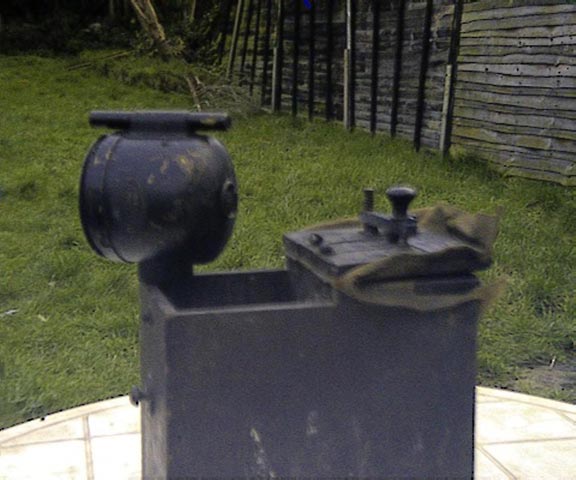
9762 * EARLY WW-I LIGHT SIGNALING SET:
This highly portable set consists of a battery box, a telegraph key, and a
signal light. It was designed for operation in hostile environments.
The photograph was sent to me by another collector.
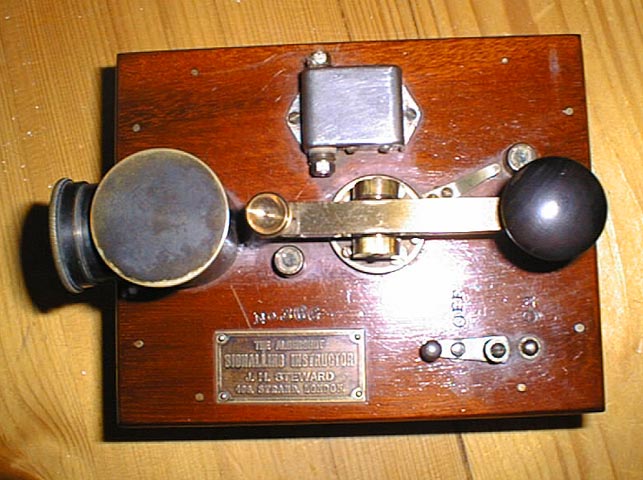
9770 * EARLY BRITISH "ALDERSHOT" LIGHT AND BUZZER SET:
This set was designed to send a light signal and/or operate a buzzer when the
telegraph key was pressed. It is labeled: THE ALDERSHOT SIGNALLING
INSTRUCTOR. J.H.Steward, 403 Strand, London. These photographs were sent to
me by another collector.
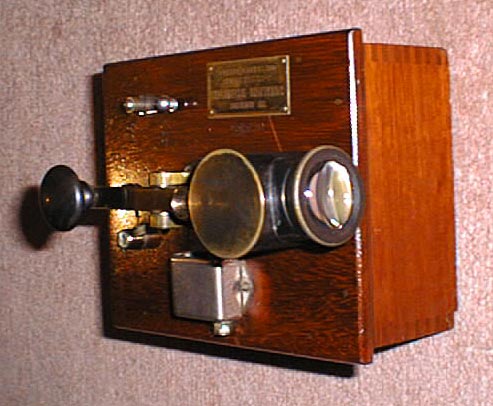
9770a Another view of the Aldershot set:
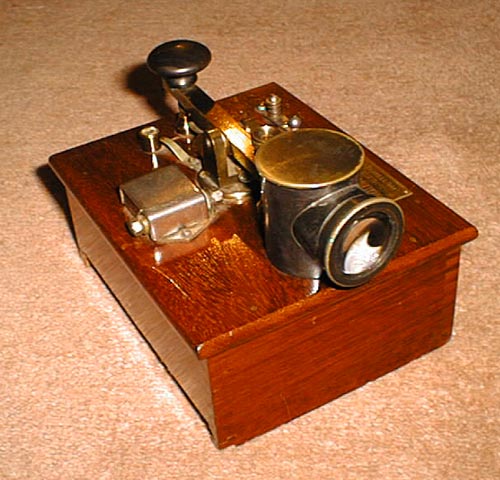
9770b Another view of the Aldershot set:
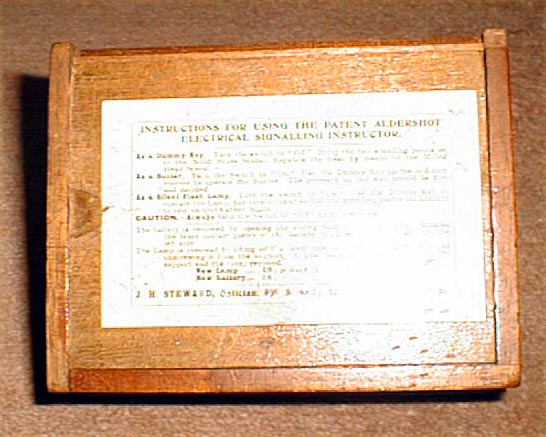
9770c The Instructions on the base of the
Aldershot set:

3320 * {Duplicated from the Code Practice Sets section.}
EARLY METAL TOY "FLERON" TELEGRAPH PRACTICE SET:(43KB)
This is the hard-to-find early metal version of the popular plastic Fleron
telegraph practice sets which were widely distributed for help in learning the
Morse code and which are shown in number 3322 below. The key lever shape and
spring on this device are quite unique. The spring is the small flat strap on
top of the lever and the spring tension is adjusted by changing the tension on
the strap by turning the screw which passes through it. The label carries the
International Morse Code and indicates that it was manufactured by: M. M.
Fleron and Son, Inc. of Trenton, NJ. USA.

3322 * {Duplicated from the Code Practice Sets section.}
PLASTIC TOY BOXED "FLERON SIGNALER":(19KB)
These code practice sets were widely used by many groups teaching
the morse code including the ''Boy Scouts''. They were also sold as
toys. This one is new in its original box. It is made of brown
plastic and includes a simple strap key, buzzer, light, and listing
of the International Morse Code. It uses 2 "D" cells. The original
instruction booklet was also found in the box.

3332 * {Duplicated from the Code Practice Sets section.}
TOY "WESTERN ELECTRIC STANDARD RADIO
TELEGRAPH SIGNAL SET":(19KB) This blue painted toy set has
the morse code on the front and a simple strap key, light, and
internal buzzer. It uses 2 standard "D" batteries.

3475 * {Duplicated from the Code Practice Sets section.}
TOY "TWIN NAVY BLINKER CODE LITE":(28KB)
Two signal lights are included in this original-boxed set made by Hasbro.
Each lite is a plastic "gun" which has a compass in its handle and accepts
one "D" cell to flash its 1-1/2 volt bulb. When the trigger is pressed
triple shutters in front of the bulb open at the same time that the bulb
goes on. Traded to Wyn Davies.

3475b A view inside the original box:(24KB)

3475b A view of the two signal lights:(15KB)

8240 *
{Duplicated from the American Military Keys section.}
FLAME PROOF KEY AND WINKER: (34KB)
Type C.Q.1140 Serial No. (blank) mfg by INTERNATIONAL RADIO
TELEGRAPH COMPANY. This set consists of a flameproof key similar
to the J-5-A mounted on a black bakelite base along with a metal-
enclosed light socket. I have been told that this set was used in
aircraft to give the radio operator visual feedback when he pressed
the key to overcome the high noise levels in early aircraft. Socket
missing.

8380
{Duplicated from the American Military Keys section.}
MILITARY LIGHT SIGNALLING KEY J-46: (14KB)
Very unusual small rectangular based strap type key in original
1942 box. Used for light signalling. Mfg by Winslow.
NOTE: The Navy Code designation for the Winslow Company is CAKU.

8540
{Duplicated from the American Military Keys section.}
MILITARY SIGNAL LIGHT KEY J-51:(34KB)
This is a hard-to-find key which consists of two strips of metal
which are held in the hand like a gun or scissors, and brought
together to make contact and send a light signal with an external
light gun. The key and light gun and tripod and other accessories
and carrying cases constitute the SE-11 Signalling set.
The key is supplied with a long wire cord so that the
operator can stand FAR away from the light gun while sending
signals. The light gun is obviously a tempting target for any
enemy and therefore the long cord was literally a life-saver.
Most of these keys are painted olive drab and engraved J-51. Other
models are painted black.

8540a The J-51 Key with Original Packing and
long cord and pictures of complete SE-11 setup:(30KB)

8540b The technical manual illustrations
of the complete SE-11 set:(38KB)

8540c All of the individual parts of the
SE-11 Light Signalling kit laid out on a table:(31KB)

8540d Two of the carrying bags for
SE-11 Light Signalling kits laid out on a table:(27KB)
8542, 8544, 8546. * Same as above.
8550, 8552. * Same as above but black.

8810 *
{Duplicated from the American Military Keys section.}
LARGE NAVY FLAMEPROOF LIGHT SIGNALING KEY:(10KB)
This huge key was used for keying the external lights on a Navy ship. Its
contacts that are enclosed in a large metal drum to ensure that any sparks
made by the contacts will not cause an explosion. The label reads: MIL-C-
24174/3-001 SIB. Date of Manufacture, 1977.

8810a Another view of the flameproof key:(11KB)

8810b A close view of the telegraph key
lever:(15KB)

8810c A view of the spark suppressing network inside the
key:(21KB)

8810d Another view inside the key showing the
contacts:(17KB)

9157
{Duplicated from the British etc. Military Keys section.}
BRITISH ROYAL AIR FORCE (RAF) AIRCRAFT LIGHT SIGNALLING KEY:(12KB)
This vertically-mounted key was used for flashing the upper
and lower lights on British fighter aircraft during WW-II to allow
communications between aircraft during periods of radio silence so that
the enemy could not listen in to the radio communications. (It is similar
to the Canadian Air Force key shown as item 9300.)

9157a Another view of the light signalling
key:(12KB)

9158 *
{Duplicated from the British etc. Military Keys section.}
BRITISH ROYAL AIR FORCE (RAF) DUAL AIRCRAFT LIGHT SIGNALLING KEYS:(27KB)
This vertically-mounted Panel contains two keys which could be
switched into the aircraft lighting circuits of British WW-II bombers.
The keys were used for flashing the upper and lower lights during
periods of radio silence so that the enemy could not listen in to
the radio communications.

9300 *
{Duplicated from the Canadian etc. Military Keys section.}
This round, wall-mounted key was used to blink the upper and lower
lights on Canadian and British aircraft. This allowed the planes
to communicate visually during periods of radio silence so the
enemy could not intercept their communications. The blinking lights were
also used to communicate with the landing field. All Spitfire pilots had to
learn Morse Code to a speed of 15 words per minute to allow them to
communicate.

9300a This inside view shows the
schematic diagram:(35KB)
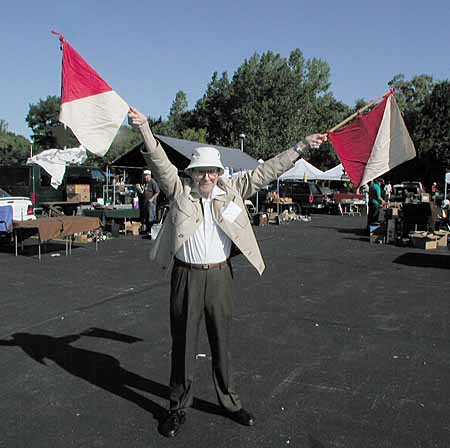
9970 **
{Duplicated from the Miscelaneous Telegraph Items section.}
MURRAY WILLER, VE3FRX DEMONSTRATES THE USE OF 'TELEGRAPH FLAG SIGNALS'
AT THE 2001 AWA ANNUAL CONFERENCE:(33KB)
Murray Willer has been collecting and studying light signalling devices
for many years and here he demonstrates the proper use of signal flags.
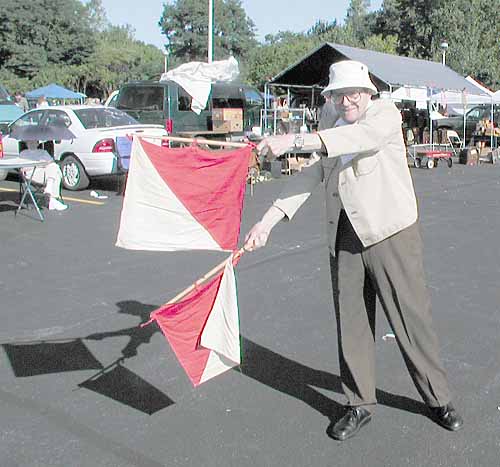
9970a ** MURRAY WILLER, VE3FRX DEMONSTRATES ANOTHER FLAG
SIGNAL:(40KB)
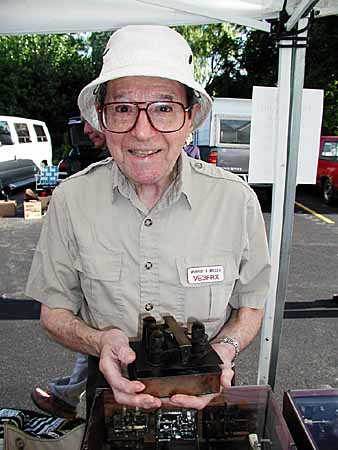
9975 **
{Duplicated from the Miscelaneous Telegraph Items section.}
MURRAY WILLER, VE3FRX DEMONSTRATES A VERY EARLY OIL-BURNING SIGNAL LAMP
AT THE 2001 AWA ANNUAL CONFERENCE:(34KB)
Murray Willer specializes in light signalling devices and here he
shows a very early signal light. As you can see in the next picture,
moving the lever causes the cylinders around the wicks to move up and
down and exposes more or less of the wick to oxygen, thus controlling
the intensity of the light.
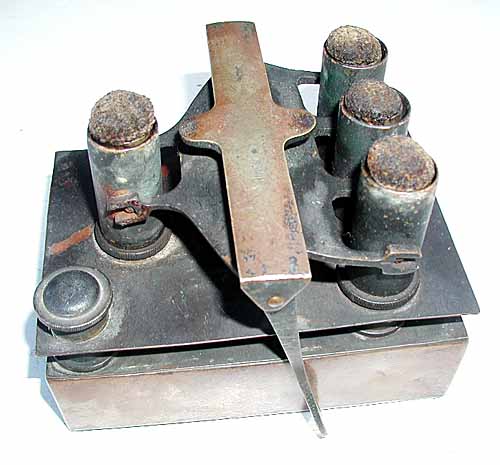
9975a ** A Close-up view of the signal light:(35KB)
Internet ENIGMA Museum:
https://EnigmaMuseum.com
COPYRIGHT NOTICE: (Copyright (c) 2023: Prof. Tom Perera Ph. D.)
Although all the pictures and text are copyrighted, you may use any of them
for your own personal applications including public lectures and
demonstrations, publications and websites as long as you mention the
w1tp.com Museum. If you plan to offer them for sale to the public
in any form, please email me for permission which I will generally grant as
long as you mention my museum: http://w1tp.com or https://EnigmaMuseum.com My email address is
given at the bottom of this page. Some of the material may require contacting
other copyright owners for commercial use and I will inform you by email.
Please also see the Disclaimer of Warranty.
(The instruments are in approximate chronological order: Oldest first.)
* = (Items no longer owned.) ** = (Items in other collections.)
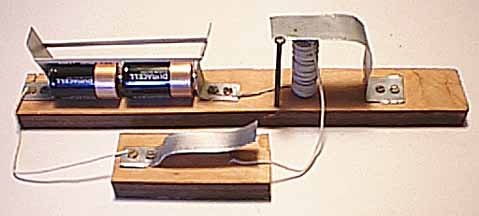
9805 SIMPLE HOMEMADE KEY AND SOUNDER PROJECT:(17KB)
This project is designed to introduce children to the principles of
the electric telegraph.
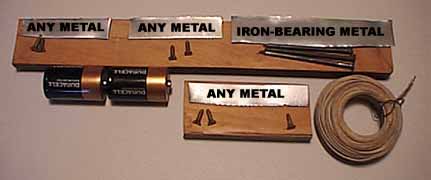
It uses readily available parts:(12KB)
2 Pieces of wood.
8 small screws.
2 large nails.
4 flat strips of metal. (One MUST be iron-bearing or "ferrous" metal).
20 feet of INSULATED wire from 18-28 guage (around 1/32 inch diameter).
2 flashlight batteries.
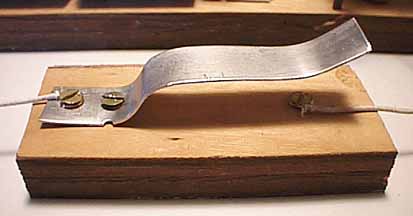
The Key:(14KB) consists of a strip of metal
which can be pressed down to make contact with a screw.
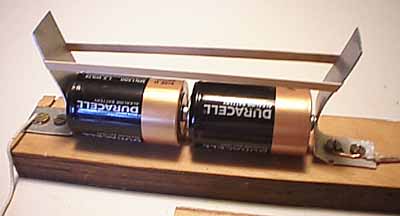
The battery holder:(14KB) holds the flashlight
batteries and makes electrical connection with each battery.
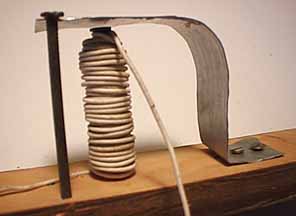
The Sounder:(12KB) consists of about 100 turns
of wire wrapped around a nail which attracts the iron-bearing strip
of metal and makes a clicking sound. When the sounder is deactivated,
the metal springs upward, striking another nail and making a second clicking
sound. Dots and dashes can be distinguished from each other by
learning to tell the difference between the pull-in click, and the
release-click.
For more details see:
How to
build a simple telegraph set. which is in the "general
information" part of this museum.

9806 ANOTHER VERSION OF THE ABOVE PRACTICE SET:(24KB)
This set was built by 13 year-old Claire Berry in KwaZulu, Natal, South Africa.
It earned a high grade in a science project.
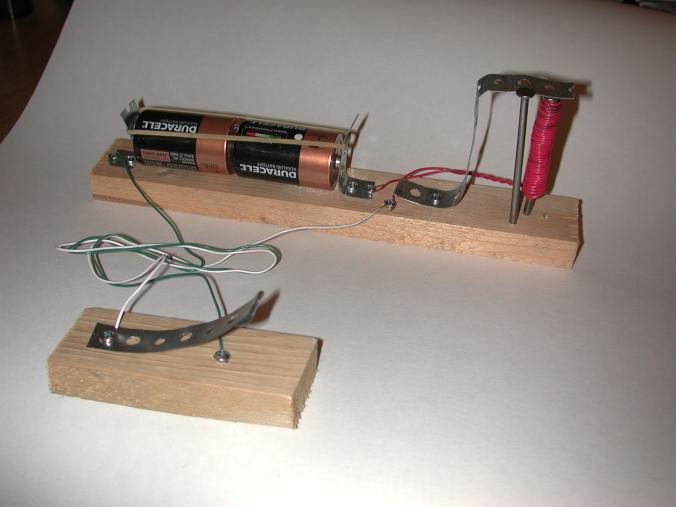
9806a ANOTHER VERSION OF THE ABOVE PRACTICE
SET:(29KB)
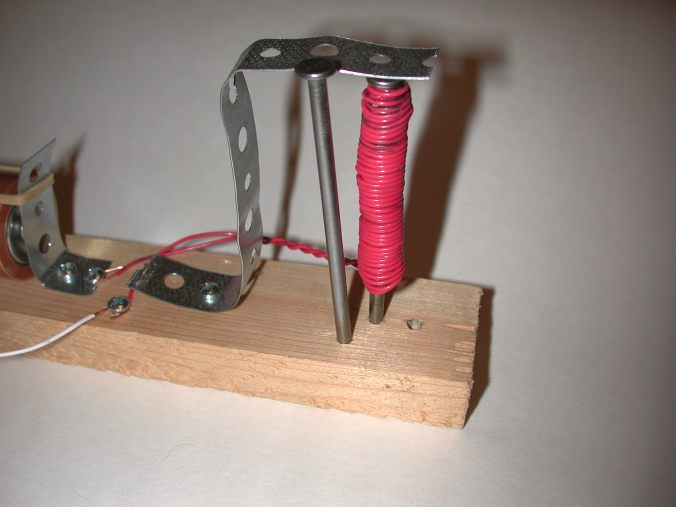
9806b CLOSEUP VIEW OF SOUNDER ON ABOVE SET:(34KB)
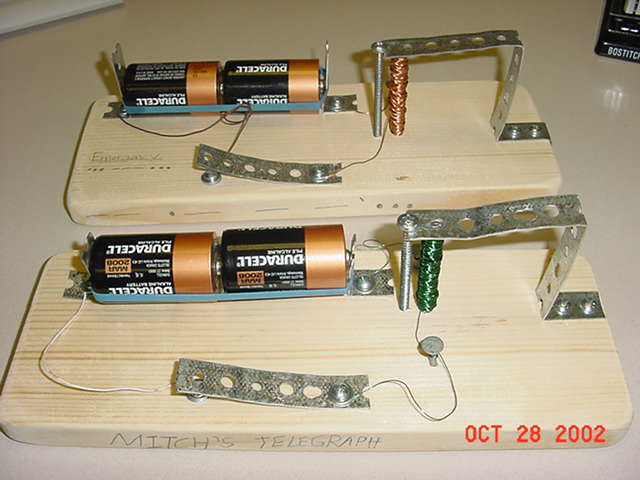
9806c Here is a third version of the above
set:(37KB)
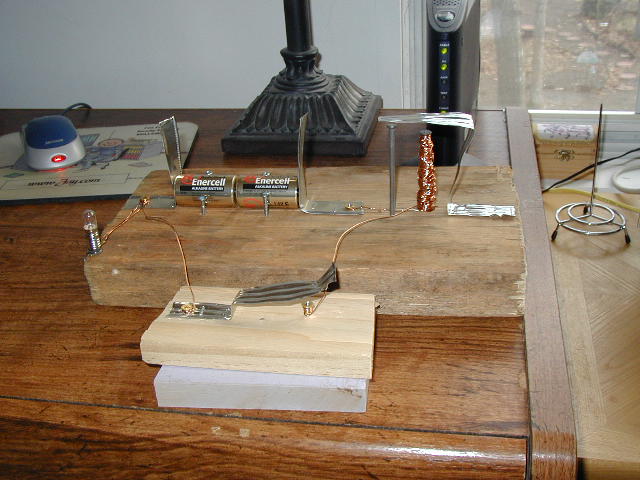
9806d ***DO NOT MAKE A TELEGRAPH SET LIKE THIS ONE !!!
This young builder has made the set with wire that has NO INSULATION on
it.
Each turn of the coil short-circuits to every other turn on
the coil so the magnet does not work at all.
Please use WELL INSULATED WIRE when you wind the coil.

9807 A Telegraph Science Project by 5th
Grader Katie:(50KB)
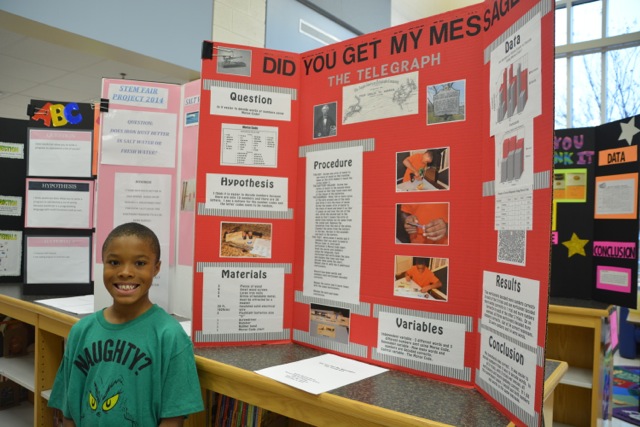
9808 Here is an American 5th. grade student named Jasiah and the science fair
project that won him first place in his school's Science Fair. He will be
entering it in the County Science Fair in the Spring of 2015:
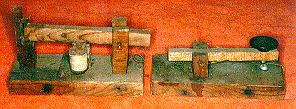
9810 EARLY HAND MADE WOODEN KEY AND SOUNDER:(24KB)
This early key and sounder were probably built from one of the many
sets of plans in children's books and magazines in the early 1900s.
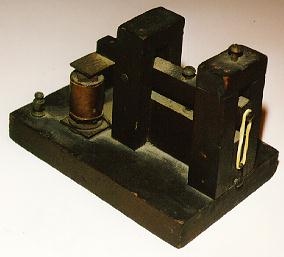
9811 EARLY HAND MADE WOODEN SOUNDER:(12KB)
A nicely constructed wooden sounder probably made from plans
that were included in many magazines in the early 1900's.
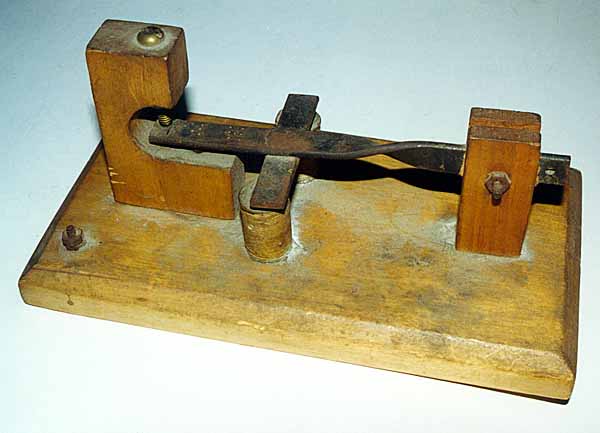
9812 HAND MADE WOODEN SOUNDER:(28KB)
A very simply constructed wooden sounder probably made from plans
that were included in many magazines in the early 1900's.
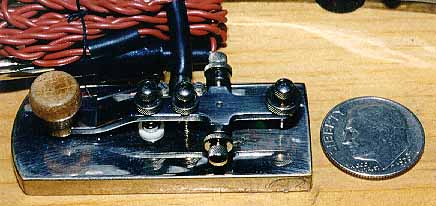
9818 SUB-MINIATURE KEY MADE IN ROUMANIA:(27KB)
This tiny key was found at the huge hamfest at Friedrichshaven,
Germany in 1996. It was made by a roumanian student.
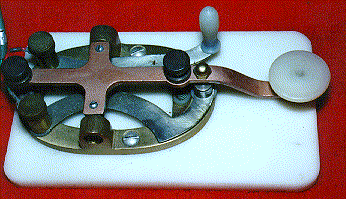
9820 * HOMEMADE STRAIGHT KEY:(35KB)
This beautifully designed and machined straight key was obviously
made by an expert machinist. It has a brass base with polished
steel and brass hardware, ball bearings, and machined white
plastic knobs.
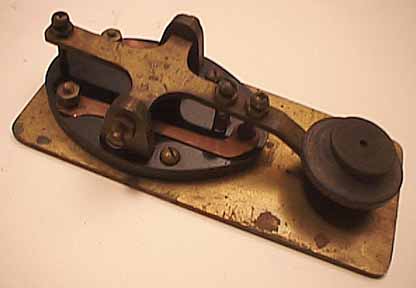
9821 * HOMEMADE STRAIGHT KEY:(14KB)
This key is not very well made but it has a nice ''feel''.
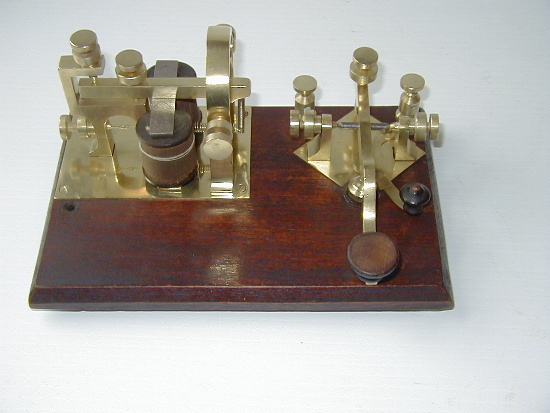
9823d INTERESTING OLD HOMEMADE CAMELBACK KEY AND SOUNDER
ON BASE:(88KB)This camelback key and sounder set has been polished
so that it looks new. The other pictures show it in the as-found
condition. The key and sounder look very similar to those on the
well-known Bunnell camelback KOB sets. The total lack
of knurling on all of the adjusting screw heads and the rather sharp
edges on the machined parts suggest strongly that the set was homemade.
When you look at the bottom of the base you see that none of the
screws that hold the set to the wood were tapped and that a very
unusual technique has been used to hold the key and sounder to the base.
The set was found by Civil War Insulator Collector Phil Hill who
has allowed me to display his photographs of it.
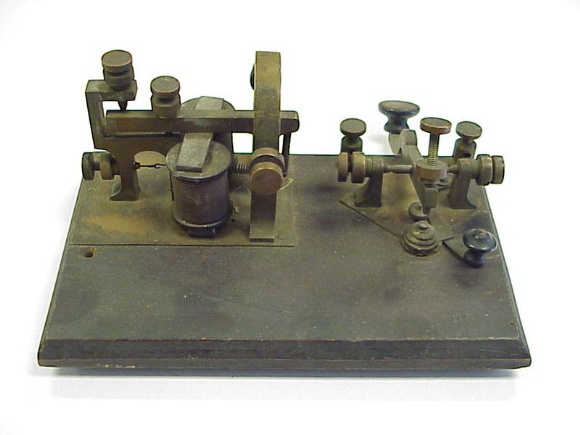
9823 The KOB in the as-found state:(63KB)
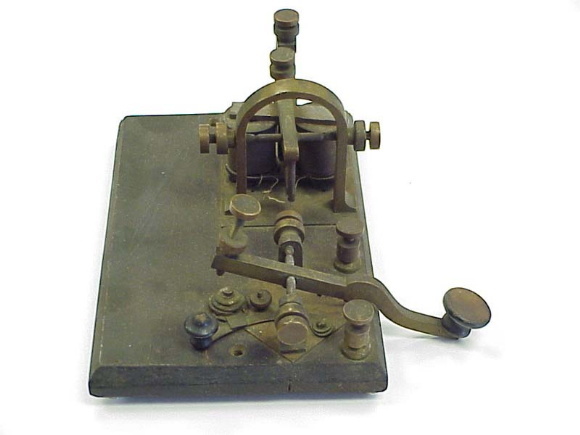
9823a A different perspective view of the KOB:(49KB)
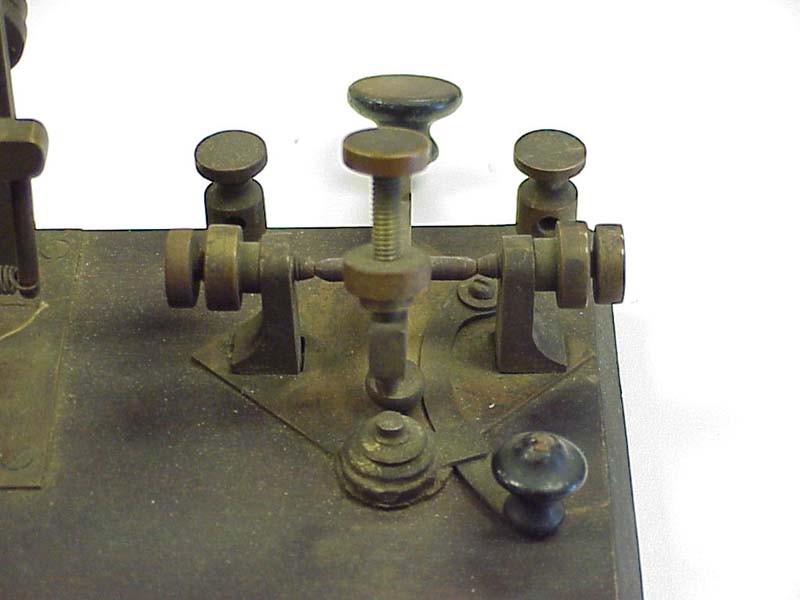
9823b A close-up view of the key:(41KB)
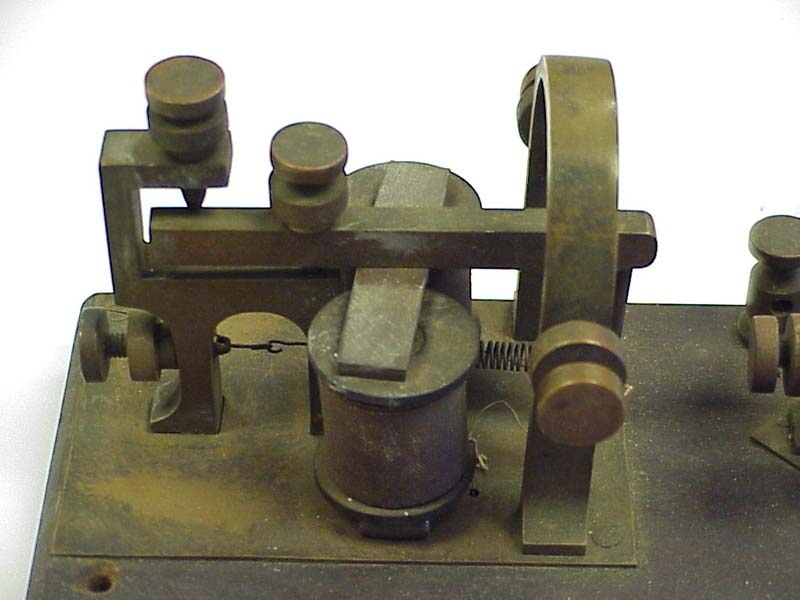
9823c A close-up view of the sounder:(98KB)
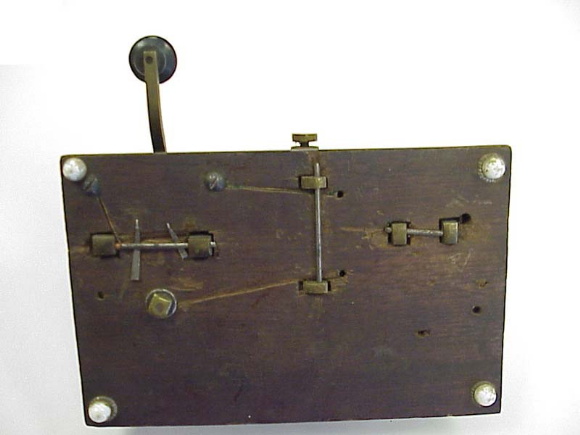
9823e A view of the bottom of the base showing
the unusual method of holding the key and sounder on the base:(56KB)
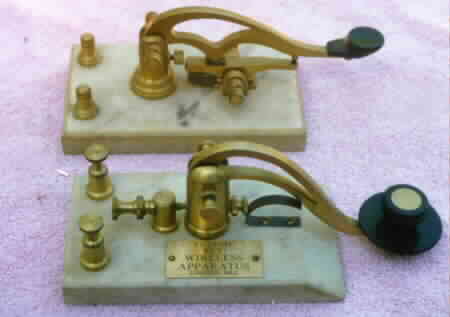
9824 EXTRAORDINARY ELABORATE HOMEMADE CAMELBACK
KEYS:(10KB)These two keys look elaborate enough to belong in the
1840's era.
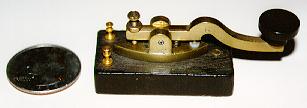
9825 MINIATURE HOMEMADE CAMELBACK KEY:(8KB)
This tiny and lovely 2" long brass camelback key was made
by a very well known key collector.
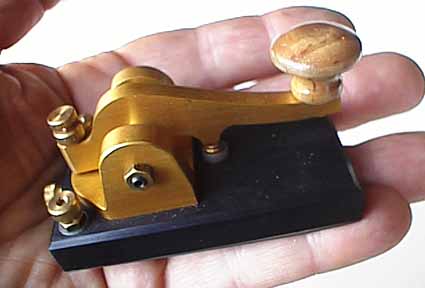
9826 * GERMAN-MADE MINIATURE CAMELBACK KEY:(16KB)
This tiny and lovely brass camelback key was made in Germany in 1998.
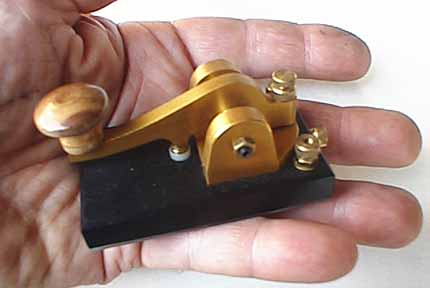
9826a Another view of the GERMAN MINIATURE KEY:(15KB)
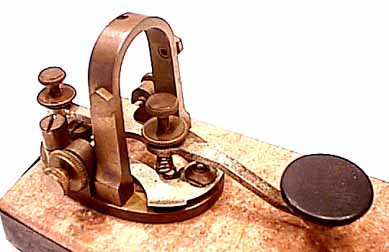
9828 * ODD BUNNELL TRIUMPH KEY MODIFIED BY THE
ADDITION OF A SOUNDER FRAME:(20KB) It is unclear why the owner
of this key decided to add a sounder frame to the top of the
key.
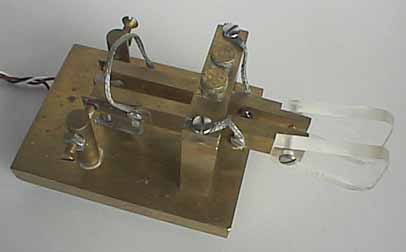
9829 * HOMEMADE BRASS IAMBIC PADDLE:(10KB)
This is a carefully designed brass iambic paddle pehaps patterned
after a Brown Brothers design. It has a fairly crisp
action.
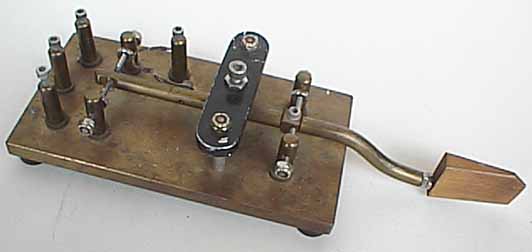
9830 * HOMEMADE PADDLE:(14KB)
This is a carefully made but poorly designed brass paddle with some
polished steel hardware. Interesting design. Does not work very well.
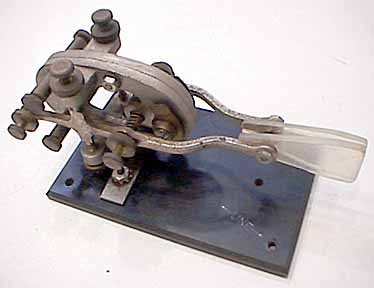
9831 THE FAMOUS QST J-38 PADDLE:(15KB)
Many hundreds of these iambic paddles were made by hams after
an article in the July, 1952 issue of
QST described the basic design. The paddle is made
by simply screwing together two J-38 straight keys and mounting
the resulting mechanism vertically. This ugly paddle has
a surprisingly good, crisp, light, ''feel'' and compares
very favorably to a well adjusted Bencher paddle.
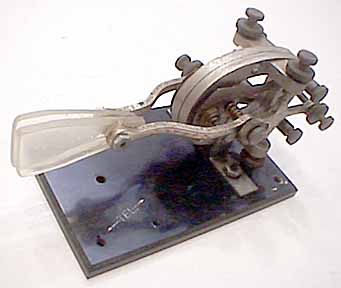
9831a Another view of the J-38 Paddle:(15KB)
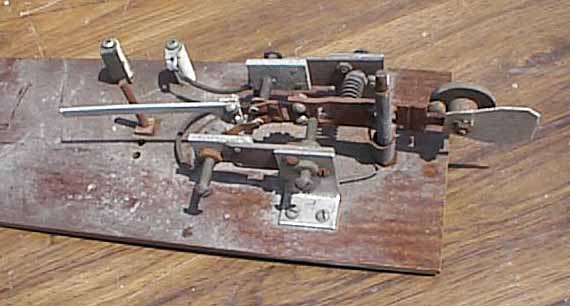
9832 * UGLY UGLY UGLY HOMEMADE BUG:(16KB)
This is one of the ugliest homemade keys that I have seen
but it does function....sort-of.
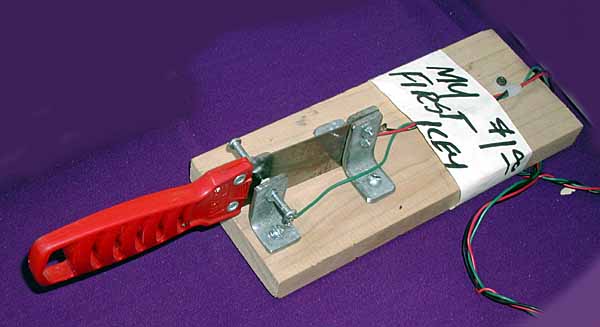
9833 * UGLY UGLY UGLY HOMEMADE PADDLE MADE FROM
A SAW BLADE:(16KB)This key was spotted but not acquired at
the Rochester Hamfest in 2002.
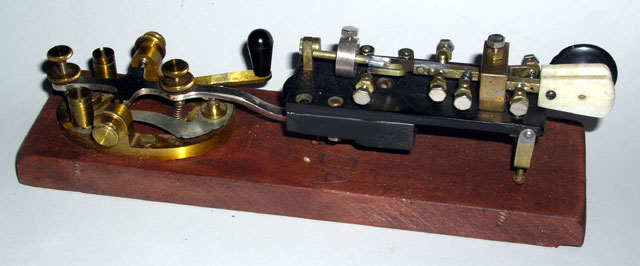
9835 UNIQUE MINIATURE ADD-ON BUG FOR STRAIGHT KEY:(36KB)
This tiny bug measures just 1-1/2x3-7/8 inches. It was designed to
slip over the knob of a straight key and pivot on its bracket.
It can also be moved up and down to act as the straight key's knob as you can
see in the following pictures. The bug has a very crisp and smooth action
which is unusual in a bug as small as this.
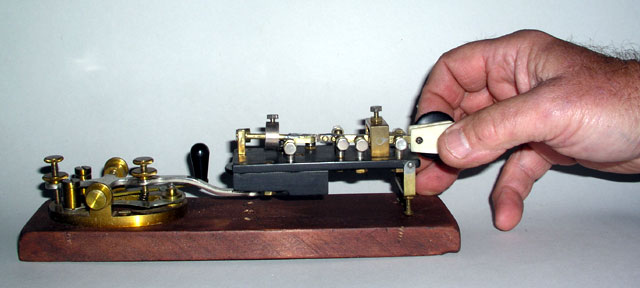
9835a Bug operating position:(36KB)
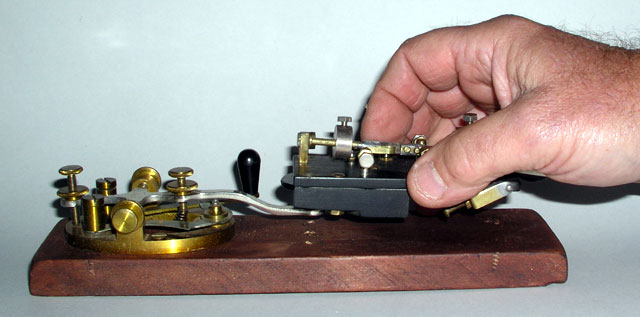
9835b Straight Key operating position (Notice legs folded
out of the way:(36KB)
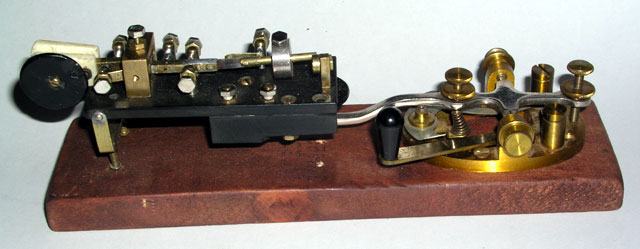
9835c Right side view:(36KB)
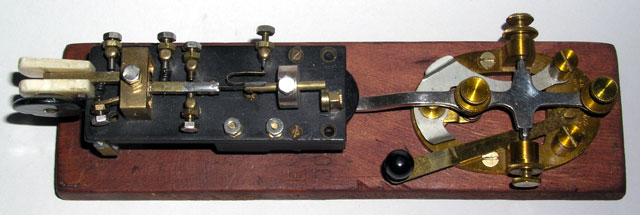
9835d Top View:(36KB)
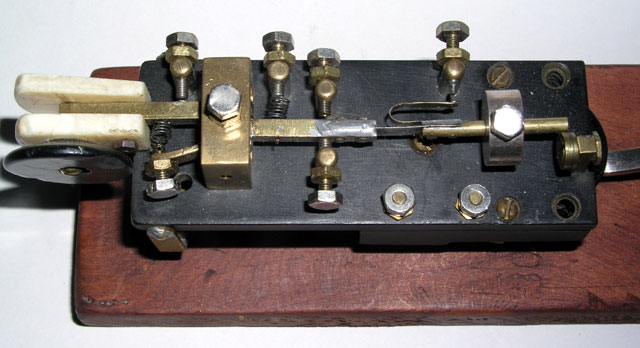
9835e Closeup of miniature bug:(36KB)
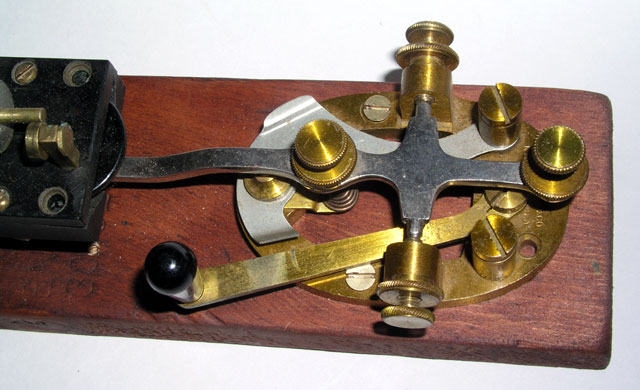
9835f Closeup of Bunnell Straight Key:(36KB)
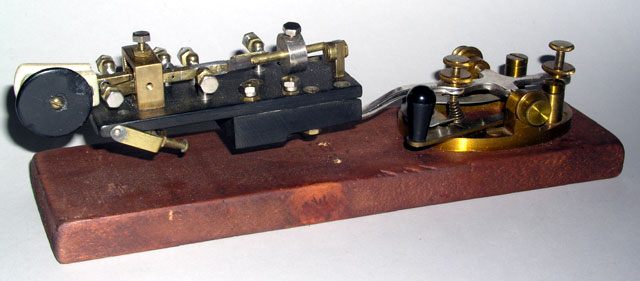
9835g Right side view with bug legs folded for use as
straight key knob:(36KB)
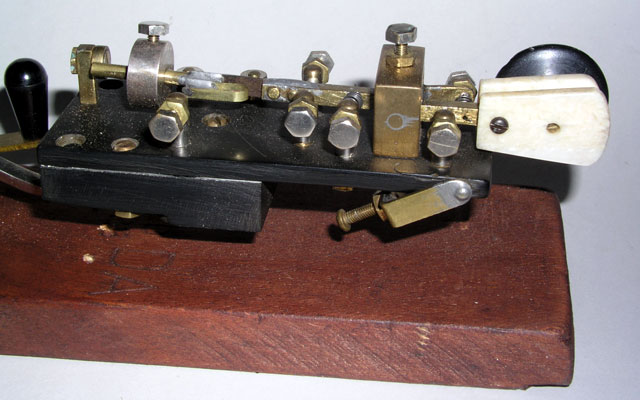
9835h Left Side Closeup of bug with legs folded for use
as straight key knob:(36KB)
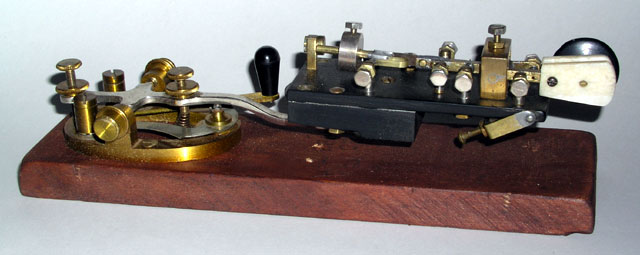
9835i Left Side view with bug legs folded for use as
straight key knob:(36KB)
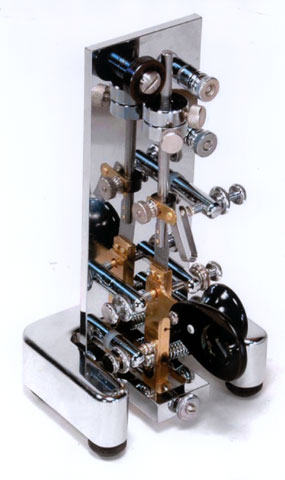
9836 ** THE 'MONOVERT' SEMIAUTOMATIC TELEGRAPH SPEED
KEY Designed and built by W. R. Smith (W4PAL), 2004 The Monovert speed
key stands 7-1/2" tall, weighs 3-1/8 pounds, has a speed range of 13 to 38 WPM
and has one arbor. The base is of 3/16" chrome plated brass and the foot is 1"
thick chrome plated brass. The height was shortened by folding the dash bar
above the arbor. This was made possible by passing the dot bar stop screw
through a hole in the dash bar. I appear to be the first designer to do this.
The key has a very smooth action. This is likely the first new vertical speed
key design in about 80 years.
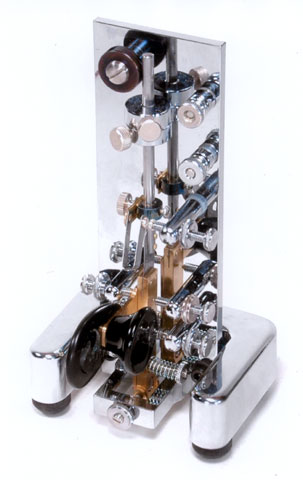
9836a Right side view of the MONOVERT Speed Key:
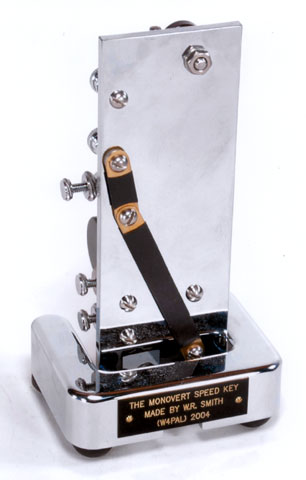
9836b Rear view of the MONOVERT Speed Key:
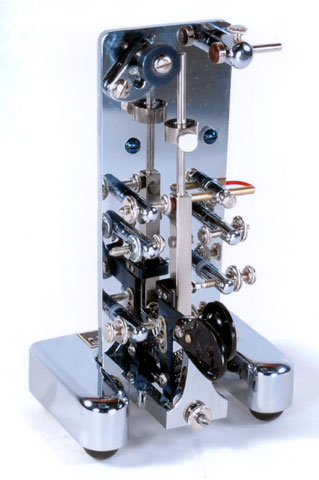
9836g ** THE 'MAGNEVERT' SEMIAUTOMATIC TELEGRAPH SPEED
KEY/PADDLE Designed and built by W. R. Smith (W4PAL), 2005 The Magnevert
speed key stands 7-3/4" tall, weighs 4-1/2 pounds, has a speed range of 15 to
35 WPM and has two arbors. The pendulum is supported on two 3/16" OD ball
bearings, contains no mainspring and depends on the repulsive force of four
rare earth magnets for its vibrations. Dashes are made in the conventional way
but dots are made by a fifth rare earth magnet under the pendulum passing over
a reed switch mounted in a small brass tube. The damper rotates outward to
allow weight changes. By locking the pendulum with the stop opposite the
damper, the key becomes a paddle for keying an electronic keyer. This is
likely the first vertical speed key to use permanent magnets instead of a
mainspring.
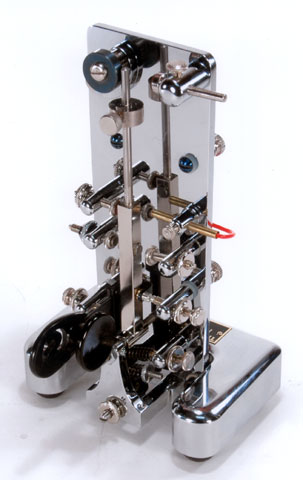
9836h Right side view of the MONOVERT Speed Key:
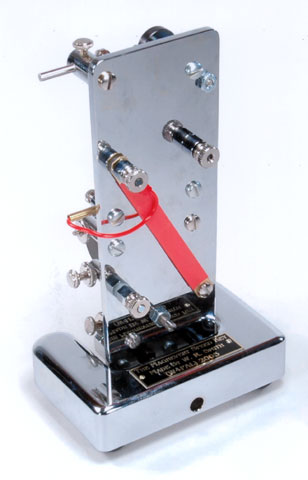
9836i Rear view of the MONOVERT Speed Key:
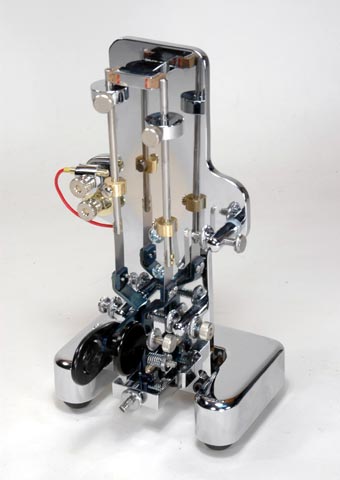
9837 ** THE 'DUOVERT' KEY: THE FIRST FULLY-AUTOMATIC
VERTICAL BUG:(22KB) The Duovert key was designed and built by William R.
Smith W4PAL in 2004. It is the world's first fully-automatic (both dots and
dashes are made automatically) mechanical single-arbor speed key. It is 8
inches high and has a speed range from 15 to 35 WPM. The short height and
single arbor are made possible by a through-the-dash-bar stop for the dot bar
which has never been used in keys before. A magnet and reed switch operated
by the dash lever can make up to 40 dashes. Speed adjustment is by moving
weights only.
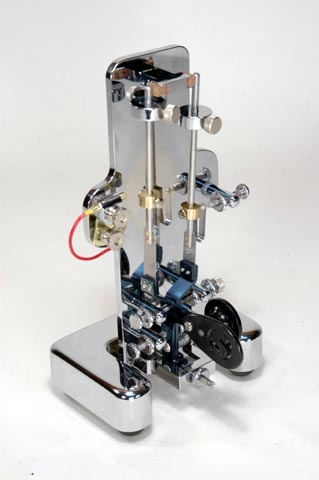
9837a Another view of the Duovert Bug:
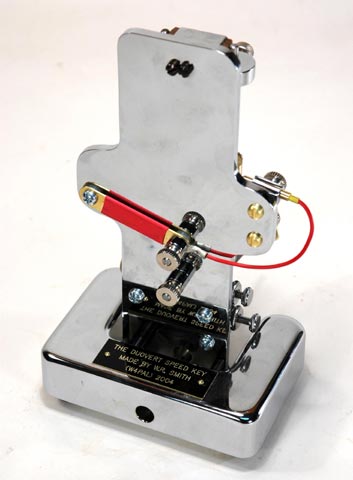
9837b Another view of the Duovert Bug:
9838 ** THE WONDERFUL RICHARD MEISS - WB9LPU HOMEMADE
KEYS:(3KB) These 17 keys demonstrate excellent machining and
unique design characteristics.
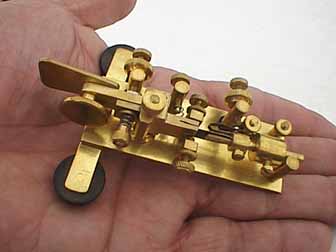
9840 ** TINY HAND-MADE MODEL OF VIBROPLEX MIDGET:(12KB)
This tiny key was made by David Hale who took all the measurements from
a full size Midget and dupicated it in miniature in virtually every detail.
The following pictures show different views of the key and a picture of
David Hale.
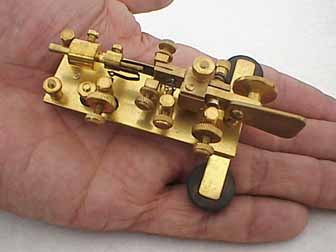
9840a Left side view of miniature Vibroplex
Midget:(12KB)
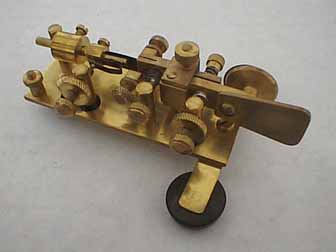
9840b Left side view of miniature Vibroplex
Midget:(10KB)
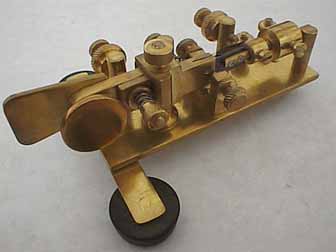
9840c Right side view of miniature Vibroplex
Midget:(12KB)
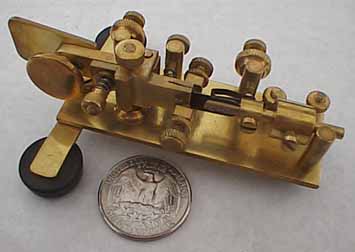
9840d Right side size comparison view of
miniature Vibroplex Midget:(14KB)
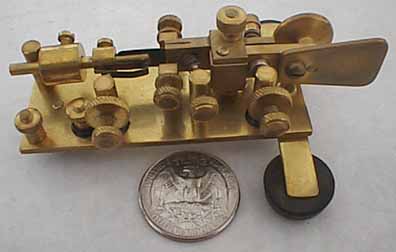
9840e Left side size comparison view of
miniature Vibroplex Midget:(14KB)
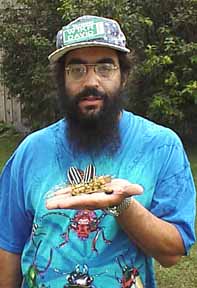
9840f A photograph of David Hale and his
miniature Vibroplex Midget:(17KB)
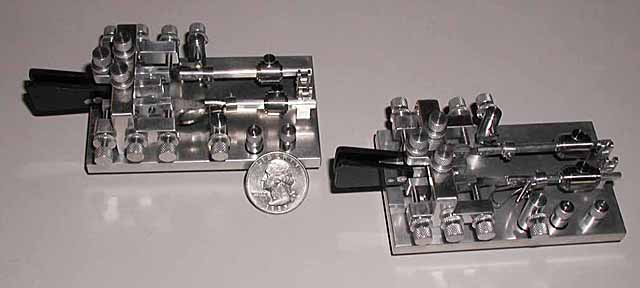
9841 ** TINY HAND-MADE 1/2 Scale WORKING MINIATURE
MELEHAN VALIANT FULLY AUTOMATIC BUGS:(24KB) This is the most
complex and ambitious project that I can imagine. Master machinist
David Hale, W1KR obtained the original patent drawings for the
magnificent Melehan Valiant full-automatic telegraph key from
Randy Cole. In addition, he personally measured every dimension
of my Melehan Valiant so that his 1/2 scale miniatures would be
correct in every detail. The pictures listed under 9842 show the
stages of construction of the bugs and the following pictures
display the final product.
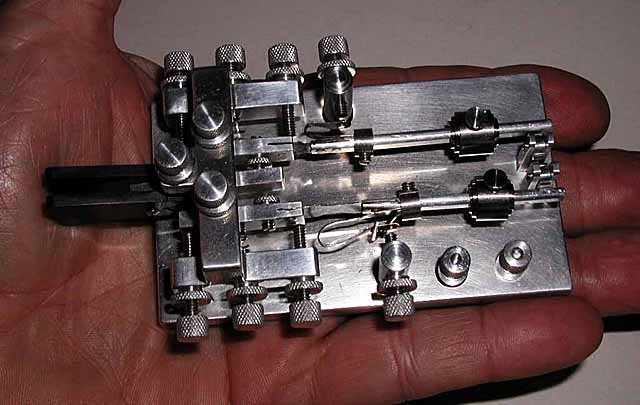
9841a ** Right-side view of a Miniature Melehan
on a hand for size comparison:(41KB)
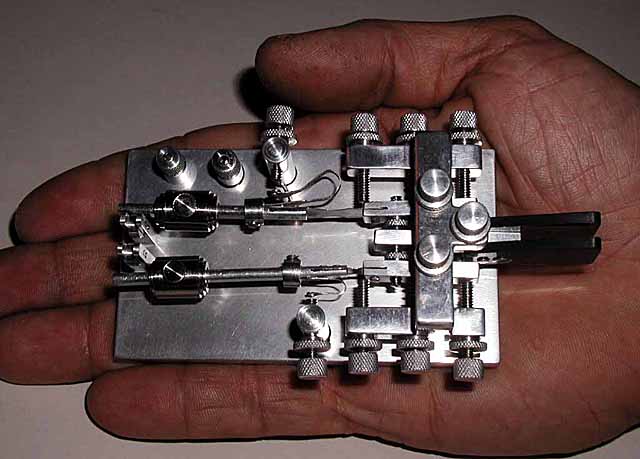
9841b ** Left-side view of a Miniature Melehan
on a hand for size comparison:(41KB)
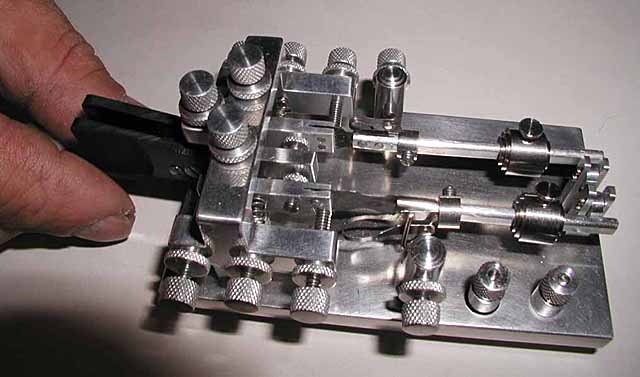
9841c ** Right-side view of a Miniature Melehan
being operated:(35KB)
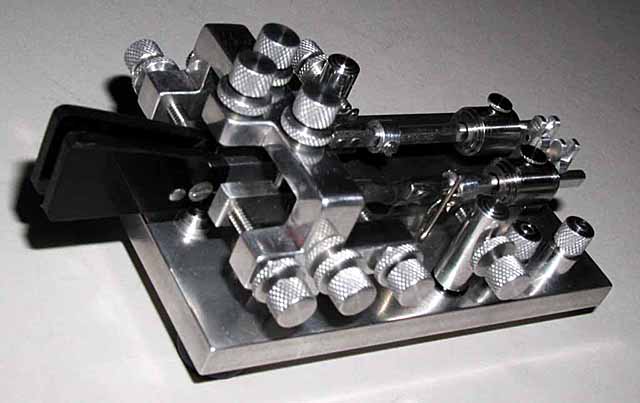
9841d ** Right-side close-up view of a Miniature
Melehan:(31KB)
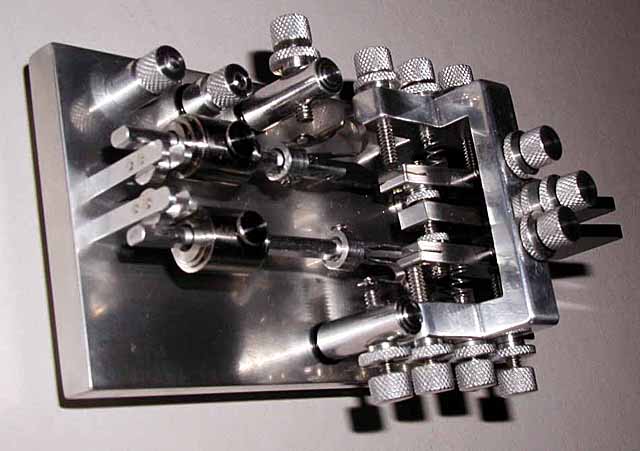
9841e ** Left-side close-up end view of a Miniature
Melehan:(40KB)
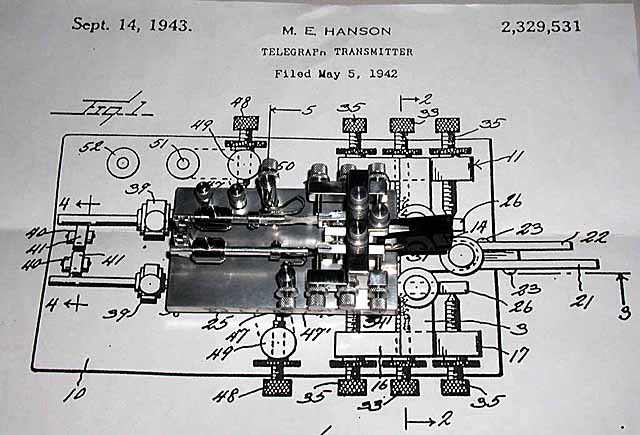
9841f ** Left-side view of a Miniature Melehan
on the original patent drawing:(60KB)
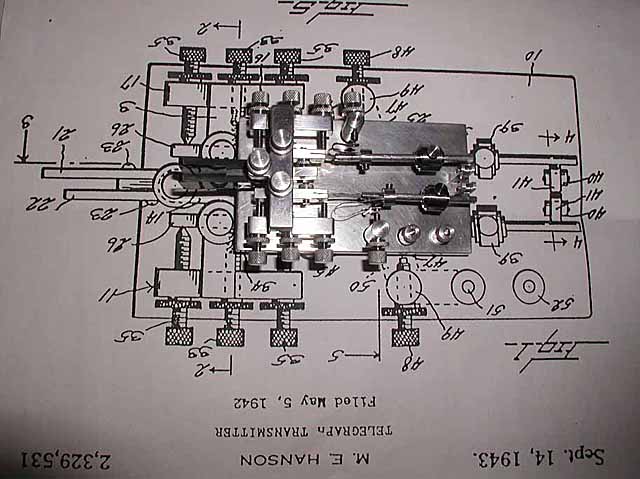
9841g ** Right-side view of a Miniature Melehan
on the original patent drawing:(55KB)
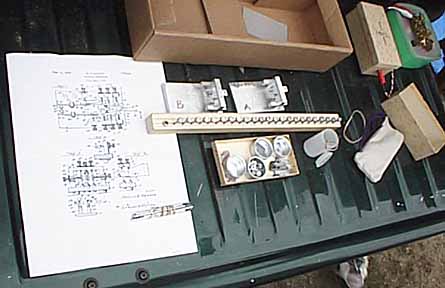
9842c ** EARLY LOOKS AT THE UNFINISHED PAIR OF
MINIATURE MELEHAN VALIANT BUGS:(24KB) This is the most complex and
ambitious project that I can imagine. David Hale, W1KR obtained
the original patent drawings for the magnificent Melehan Valiant
full-automatic telegraph key from Randy Cole. In addition, he
measured every detail of my Melehan
so that his 1/2 scale miniatures would be correct in every
detail. This view shows the two completed base assemblies
placed behind boxes of the tiny screws and parts. He has
even precisely duplicated the knurling on each screw.
Here is 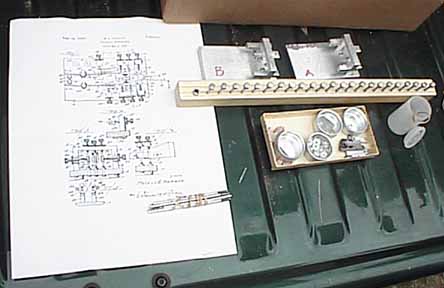
9842d another, slightly closer view
of the unfinished miniatures:(21KB) which he placed on
display at the 3000 Rochester NH hamfest.
David also demonstrated a
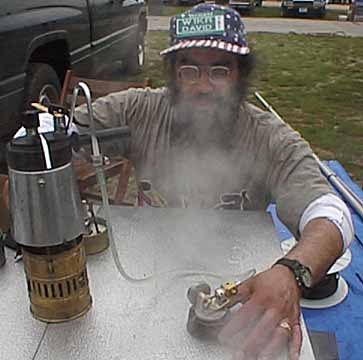
9842b tiny miniature steam engine:(22KB)
which he powered from a cappucino maker heated over a
portable stove.
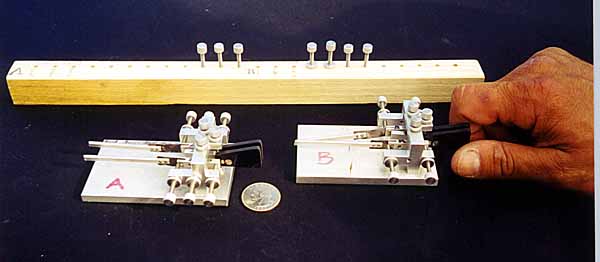
9842e The Unfinished Melehan Valiants
in Spring, 2000:(20KB)
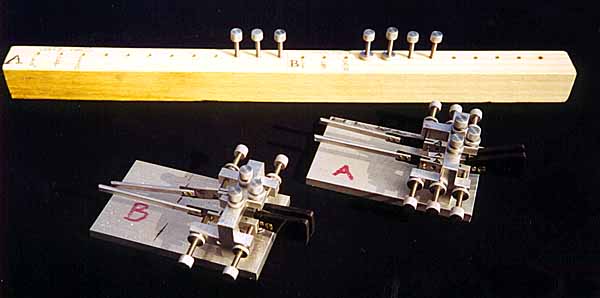
9842f Another view of the Unfinished Melehan Valiants
in Spring, 2000:(21KB)
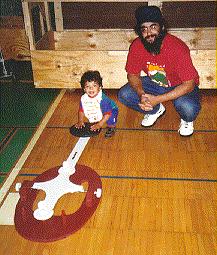
9843 ** A KEY-BUILDING FATHER AND SON
AND A 'BIG' KEY:(18KB)
David Hale, W1KR, made this oversize key for his son Max to play with...
perhaps in hopes that it would stimulate his interest in CW.
It was used in the "Left Foot Contest" in 1994. He built the key
as a scaled-up version of a J-38. It is made of 3/4" plywood.
The adjustable parts are carriage bolts and t-nuts with plywood knobs
made with a hole saw. The contacts are made of copper pennies. The
key now hangs on the wall of the Barre (VT) Town Elementary School.
If anyone would like more information on how to build a key like this
you may contact David Hale at DAVIDH@earth.goddard.edu
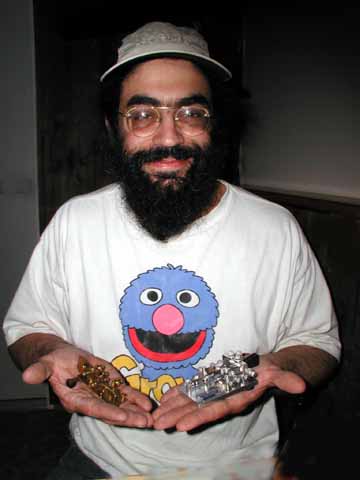
9843a ** A PHOTOGRAPH OF DAVID HALE - W1KR
HOLDING HIS MINIATURE VIBROPLEX MIDGET AND MELEHAN VALIANT BUGS:(20KB)
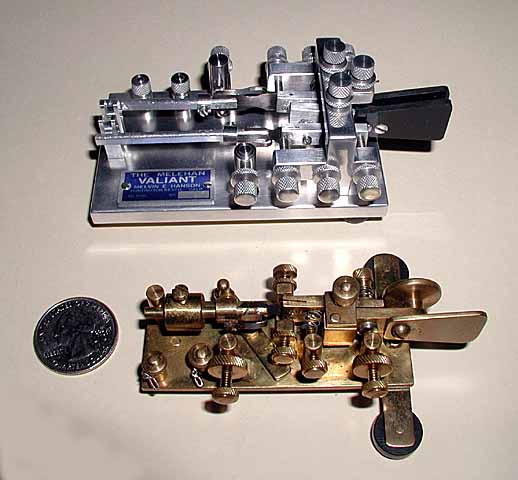
9843b ** A PHOTOGRAPH OF DAVID HALE - W1KR'S
MINIATURE VIBROPLEX MIDGET AND MELEHAN VALIANT BUGS:(38KB)
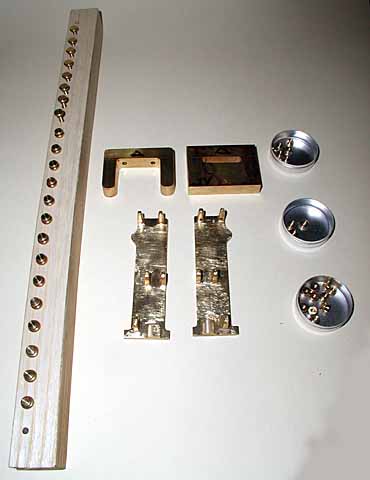
9844 ** EARLY LOOKS AT THE UNFINISHED PAIR OF
MINIATURE VIBROPLEX VERTICAL BUGS:(20KB) The Vibroplex
vertical or 'upright' key is one of the most sought-after
collectible keys. David Hale - W1KR is currently working
on building miniature versions of two of these complex keys.
The following pictures
show some of the parts and some of the machine tools which
he made to facilitate his project.
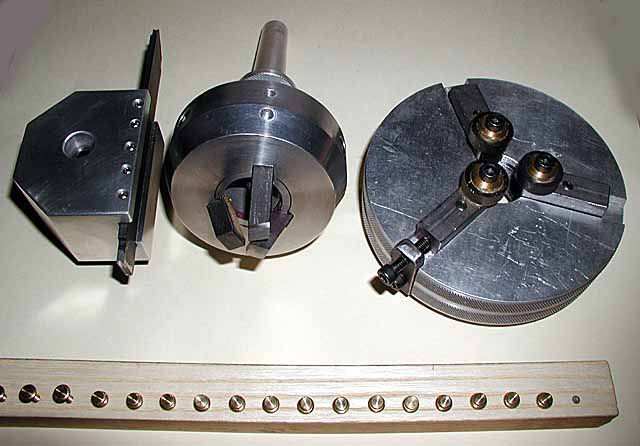
9844a ** The special knurling chucks
which David made for the project:(40KB)
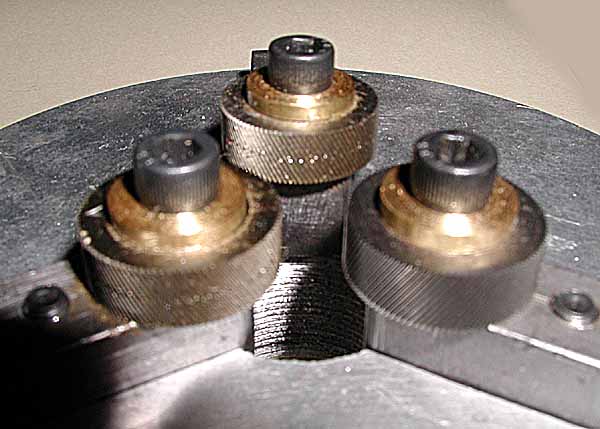
9844b ** Closeup of the special knurling
wheels which David made for the project:(39KB)
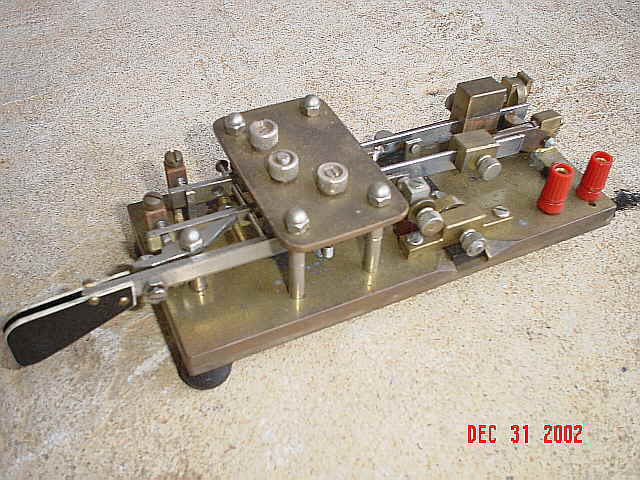
9847 ** HOMEMADE MELEHAN VALIANT WORK-ALIKE KEY:(53KB)
This key was built by an unknown person and designed to make automatic
dots AND dashes in a manner similar to that used by the Melehan Valiant.
I am including many views of the key to help clarify its design.
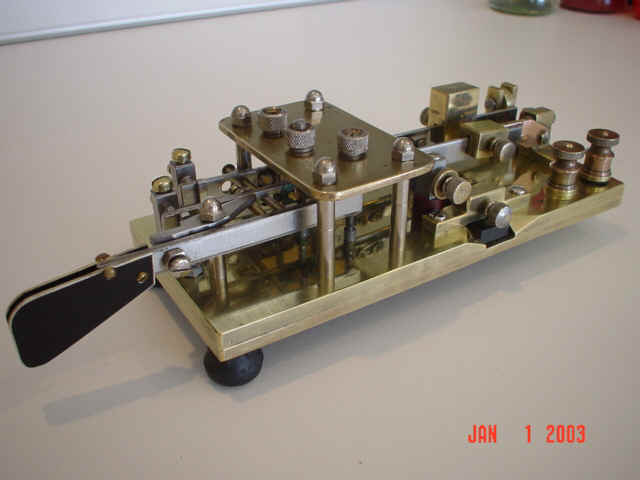
9847a ** Another view of the homemade automatic
key:(23KB)
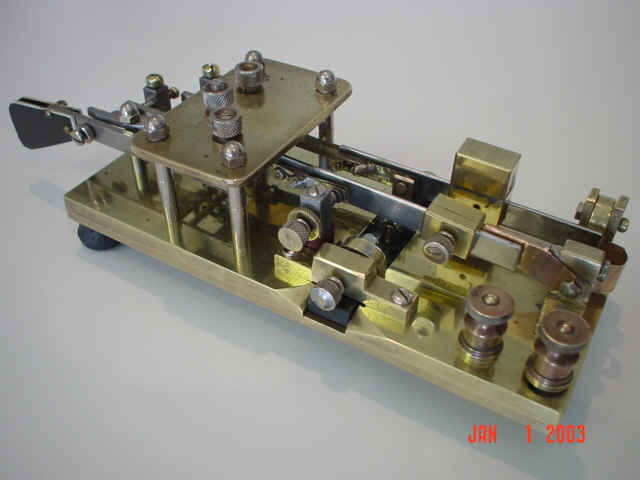
9847b ** Another view of the homemade automatic
key:(23KB)
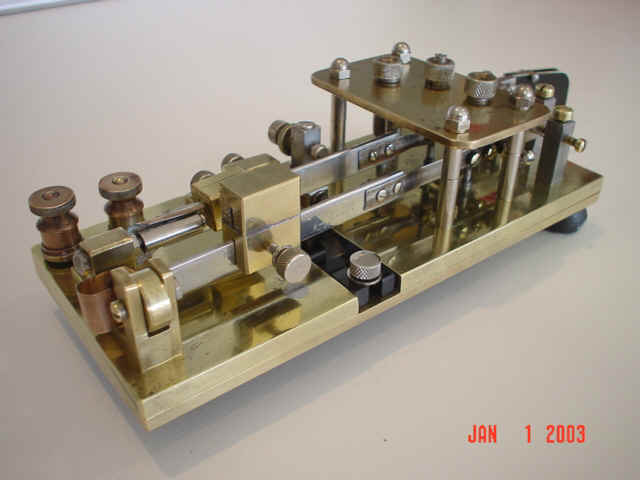
9847c ** Another view of the homemade automatic
key:(23KB)
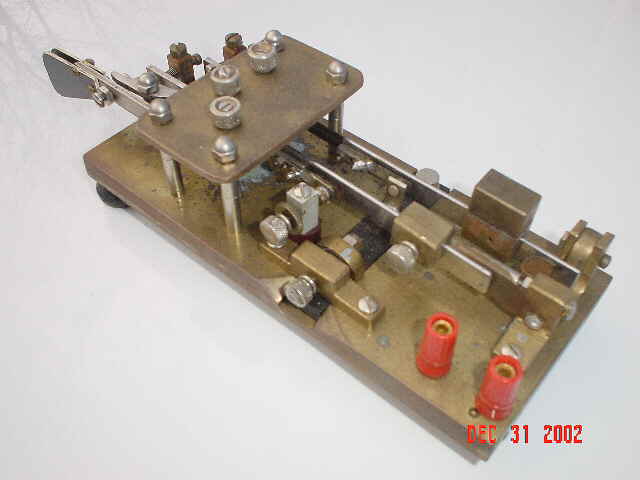
9847d ** Another view of the homemade automatic
key:(20KB)
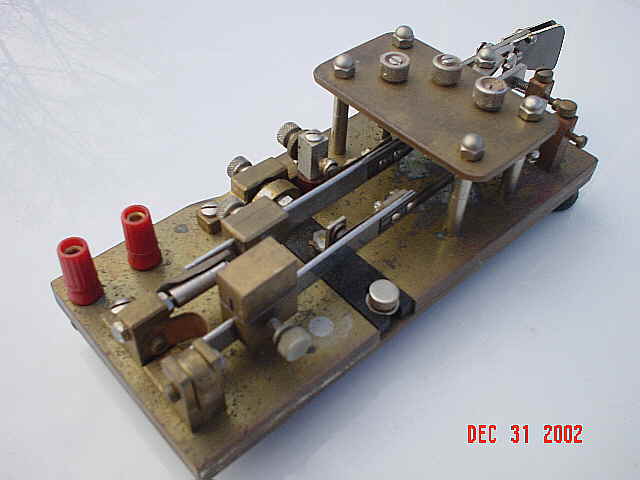
9847e ** Another view of the homemade automatic
key:(23KB)
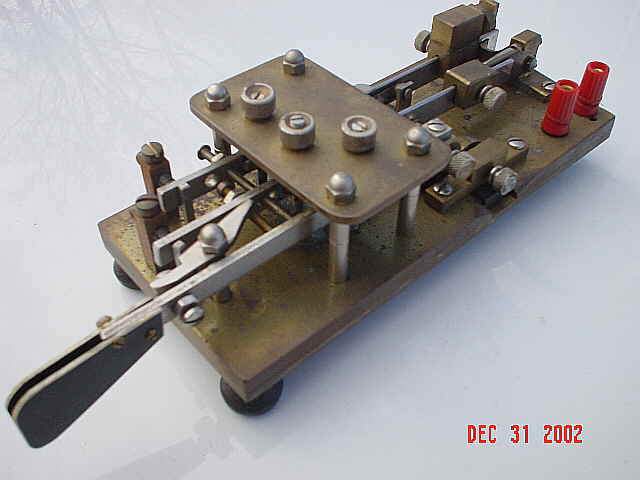
9847f ** Another view of the homemade automatic
key:(23KB)
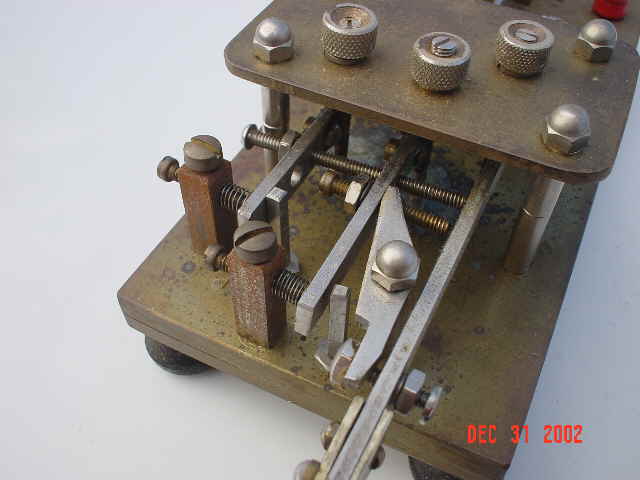
9847g ** Another view of the homemade automatic
key:(23KB)
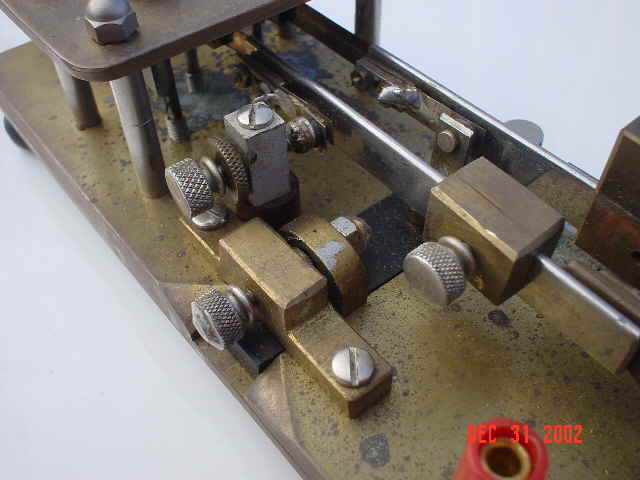
9847h ** Another view of the homemade automatic
key:(26KB)
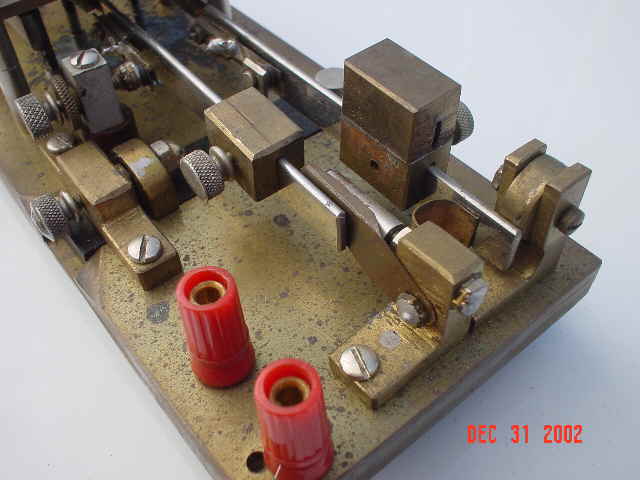
9847i ** Another view of the homemade automatic
key:(28KB)
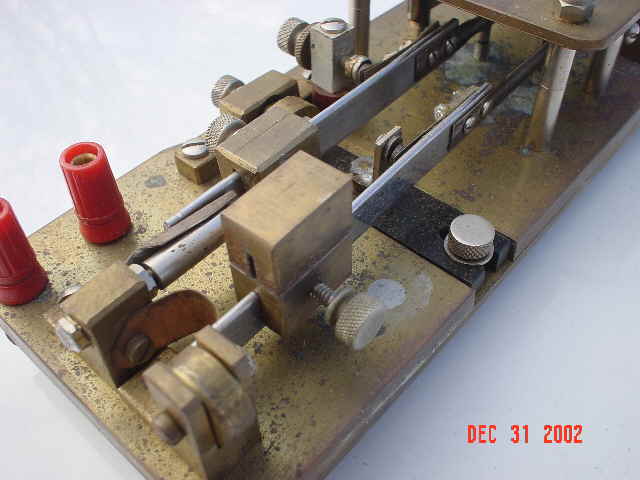
9847j ** Another view of the homemade automatic
key:(27KB)
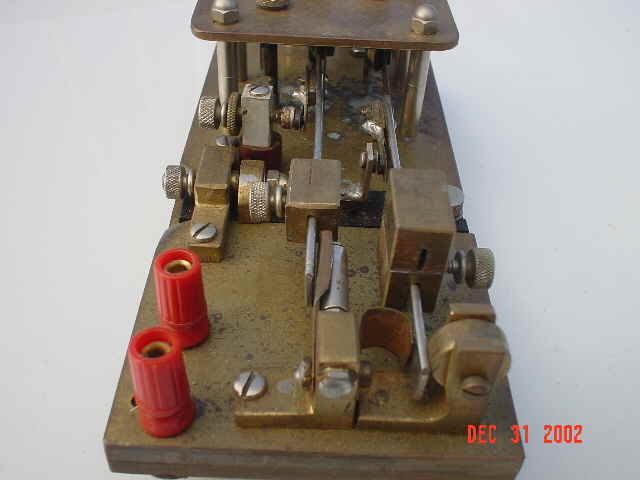
9847k ** Another view of the homemade automatic
key:(20KB)
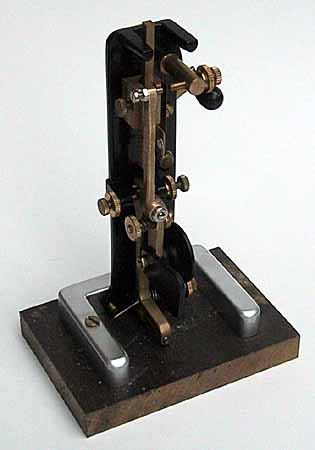
9849 * HAND MADE COPIES OF FAMOUS VIBROPLEX KEYS
BY MARTIN ODENBACH - DK4XL: THE VIBROPLEX VERTICAL:(16KB)
Martin Odenbach - DK4XL is an expert machinist and he has made some
very accurate reproductions of the rarest Vibroplex keys. As
you can see below, his workmanship is superb. He travelled
widely to visit major key collectors and made accurate
measurements and drawings of their keys before beginning
work on his keys.
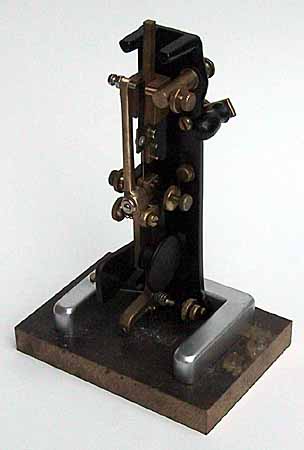
9849a * Another view of the Vibroplex
Vertical:(16KB)
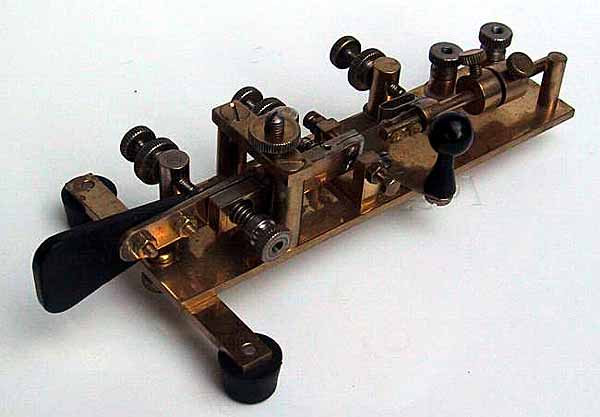
9849b * Martin Odenbach's reproduction of
the Vibroplex Midget:(28KB)
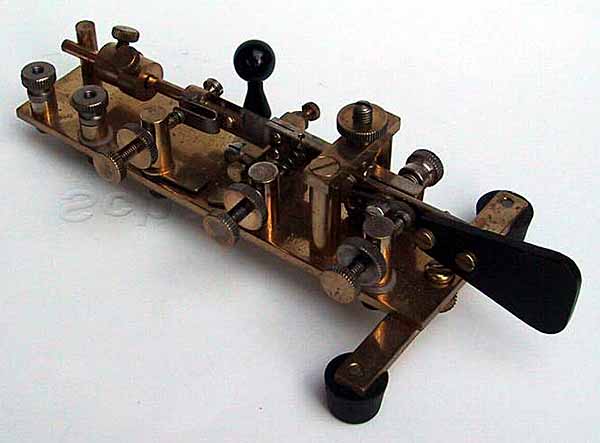
9849c * Another view of the Vibroplex
Midget:(27KB)
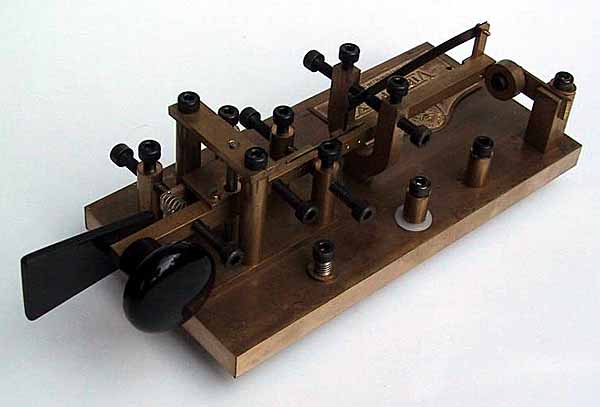
9849d * Martin Odenbach's reproduction of
the Vibroplex 'U' contact key:(24KB)
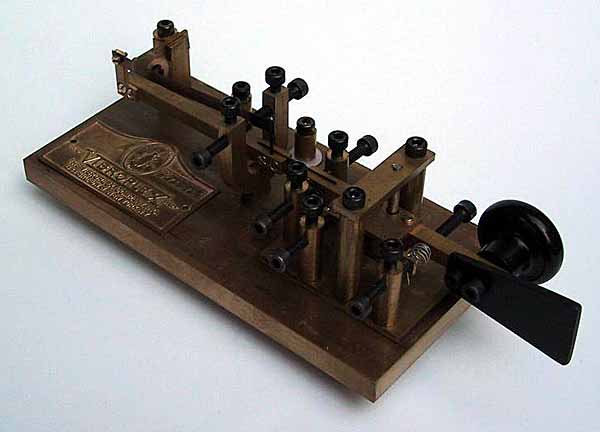
9849e * Another view of the Vibroplex
'U' contact key:(24KB)
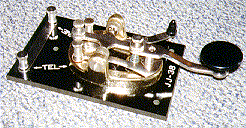
9850 * JJ-38 JAPANESE COPY OF A J-38
WORLD WAR II UNITED STATES MILITARY KEY:(21KB)
At first glance, this key appears to be a standard World War II
vintage J-38 United States Military Key. However, it is marked
JJ-38 and the key mechanism is the familiar imported Japanese design with
the ball-bearings at the end of the trunnion that has been
widely distributed in this country since the 1960's.
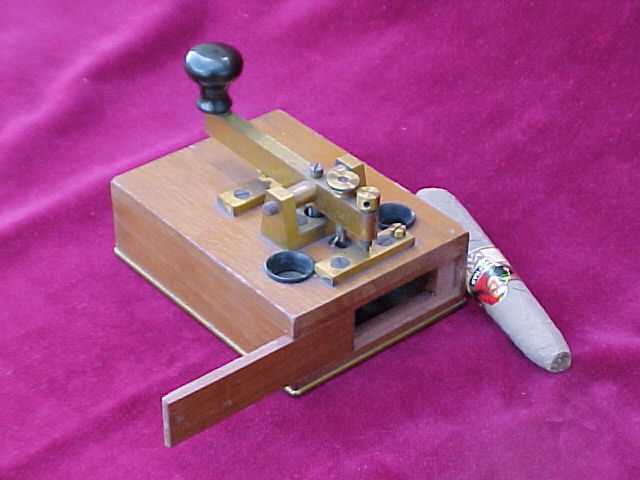
9855 GERMAN 'LORENZ' CIGAR CUTTER TELEGRAPH KEY:(20KB)
This extremely unusual Telegraph Key is actually a cigar cutter
set up to trim two cigars simultaneously.
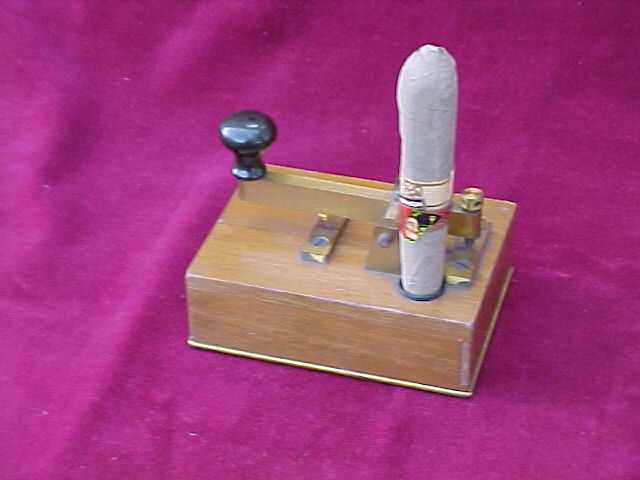
9855a A view of the Cigar Cutter Telegraph Key 'in
action':20KB)
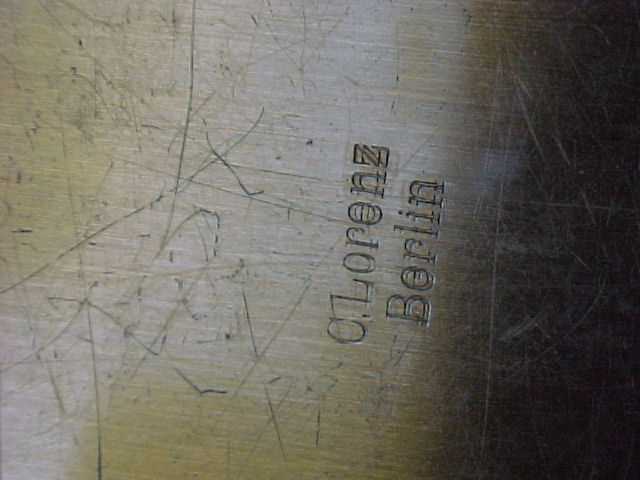
9855b A view of the base of the key showing the maker's
name:(20KB)
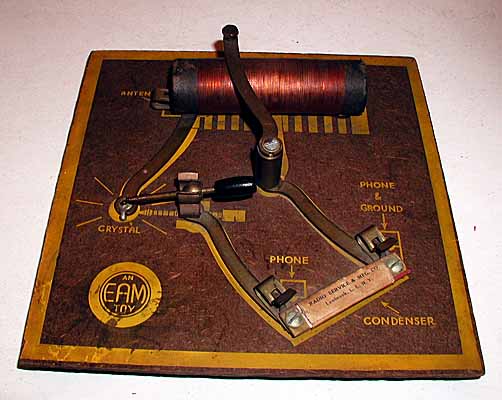
9857 CRYSTAL RADIO RECEIVER MADE FROM SIGNAL ELECTRIC
COMPANY TELEGRAPH KEY PARTS:(36KB)This unusual crystal radio
receiver was made using signal electric telegraph company
shorting switch levers for all of its conductors. It uses the
classic ''cat's whiskers'' detector with a small crystal acting
as a diode to detect the AM broadcast signals. The crystal is
adjusted by moving the copper cat's whisker wire to a 'hot'
place on the surface of the crystal. The label says that
it is an EAM Toy.
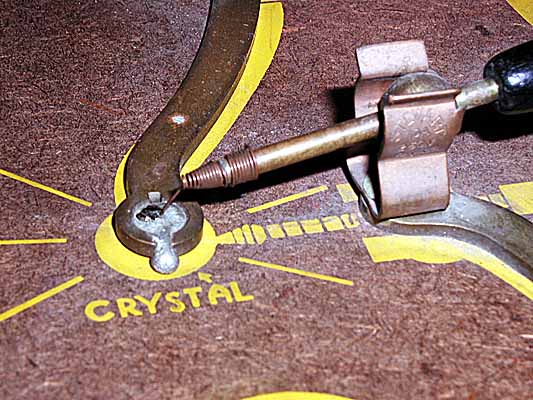
9857a A close-up view of the 'cat's whisker'
crystal detector mounted in a hole in a Signal Electric Co.
telegraph shorting bar:(58KB)
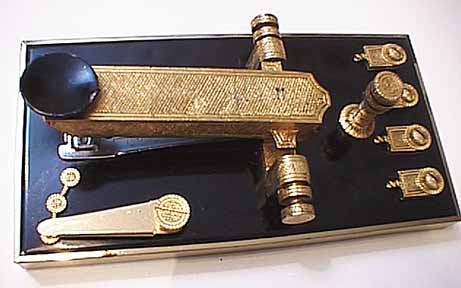
9860 NOVELTY KEY / DESK STAPLER: (24KB)
Nicely gold-plated stapler made into a surprisingly accurate copy of a
pole-changer key right down to the wire connections. Pole changing
switch becomes a staple remover. Stamped "Ted Arnold Ltd."
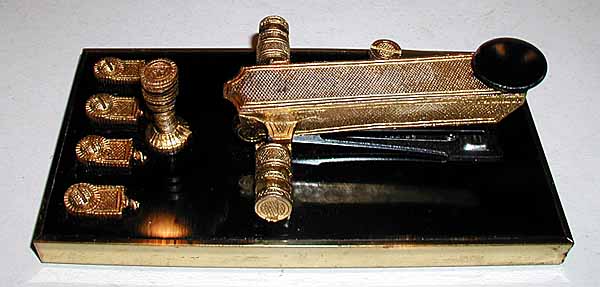
9860a Left side view of the NOVELTY KEY /
DESK STAPLER: (33KB)
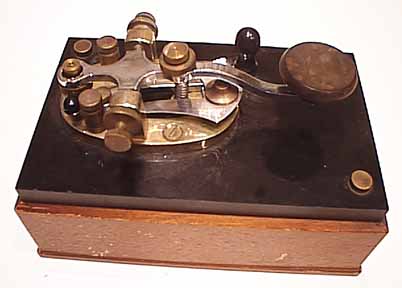
9870 "MORSEFLAME" TELEGRAPH KEY LIGHTER:(17KB)
Nicely made Brass key on wooden base. Pressing key makes tone and
activates butane cigarette lighter. w/book.
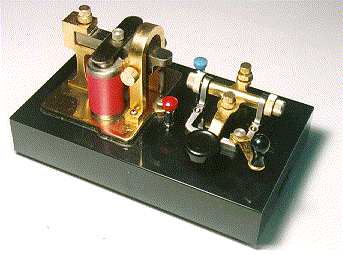
9880 WACO model 611 KOB / AM RADIO: (38KB)
Very unusual full-sized massive Key and Sounder with brass hardware
mounted on a black plastic base that contains an AM Radio!
Key activates a code practice tone with radio on or off.
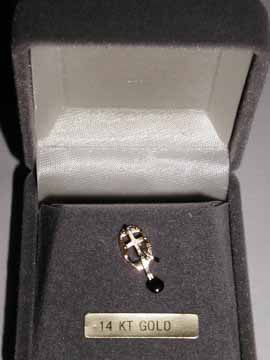
9882 TINY SUB-SUB-MINIATURE TUTTRUP GOLD
KEY / PIN:(12KB)
Terry Tuttrup (KD0QS) and his son Matt made these wonderful and
tiny gold and white-gold individually hand-crafted
''operating'' telegraph keys.
They measure just 5/8-inches long and can be pinned on a hat or lapel.
The frame and pin is 14 Karat Yellow Gold.
The lever is 14 Karat White Gold.
The only parts which are not gold are the incredibly tiny spring and
adjusting screw. The workmanship is excellent.
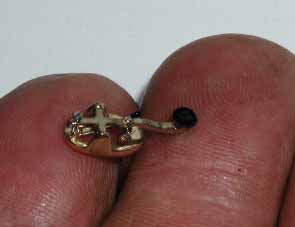
9882a A closer view of the tiny key:(8KB)
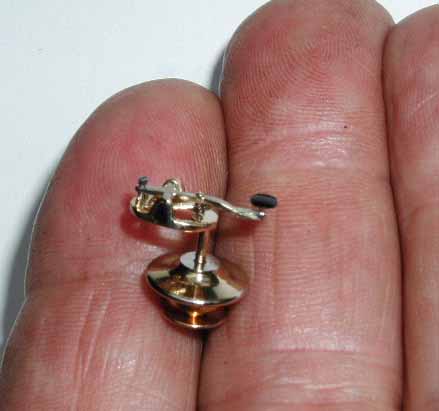
9882b A closer view of the tiny key showing
the backing ''clutch'':(16KB)
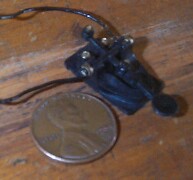
9885 ** SUB-MINIATURE ''GI-JOE'' TOY TELEGRAPH KEY: (10KB)
This tiny key was sold as a part of a GI-JOE toy military
field radio set. It is in the Pete Malvasi, W2PM collection.
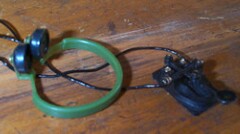
9885a * Another view showing the key and
mini-headset: (10KB)
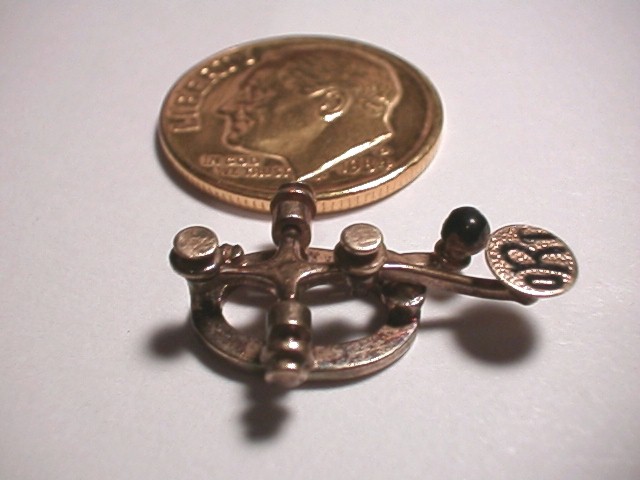
9887 ** SUB-MINIATURE ORT KEY PIN: (16KB)
This tiny key was used as a lapel pin by members of ORT.
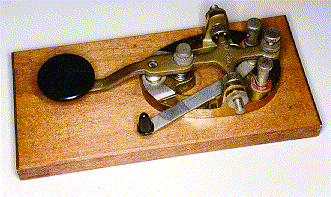
9890 * COMMERCIAL ADVERTISING GIFT AMBASSADOR KEY:(34KB)
This typical inexpensive Japanese key with lever stamped "Ambassador",
was mounted on a wooden board and given away to customers as an
advertising gift.
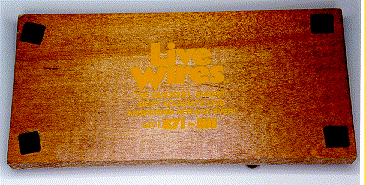
9890a It has the company logo: "LIVE WIRES"
painted on the bottom:(35KB)
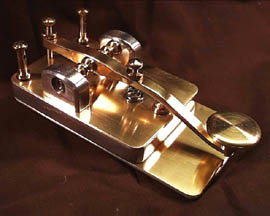
9892 ** KA9TRQ HAND-MADE TELEGRAPH KEY:(18KB)
These extremely attractive keys are hand-made by KA9TRQ. They measure
6"Long by 3" Wide and stand 1.5" high. They are made of satin
finished brass and aluminum. Although it looks as though it has
conventional contacts, it actually uses an embedded microswitch.
If you are interested in obtaining one, contact George Glavas,
KA9TRQ, 1126 Windcrest Acres, Galesburg, IL 61401. (309) 342-8409.
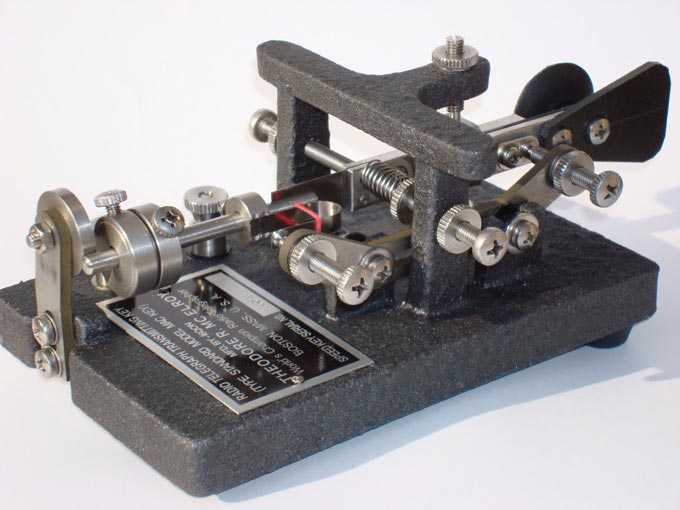
9893 ** EXTRAORDINARY HOME MADE MAC KEY BY Maurizio Melappioni, I6QON:
This one of the two absolutely perfect hand made reproductions of the famous
McElroy Standard 1938 bug made by Maurizio. The workmanship and attention to
detail are wonderful.
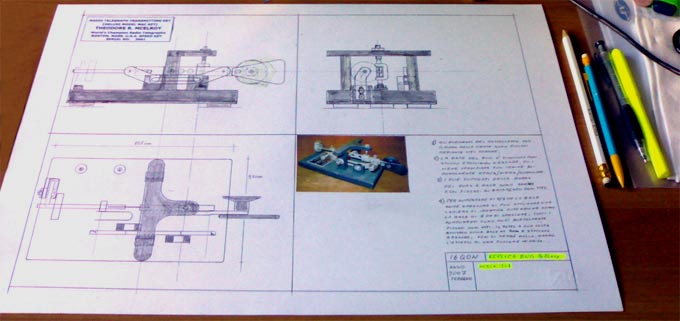
9893a The technical drawings for the Mac Key:
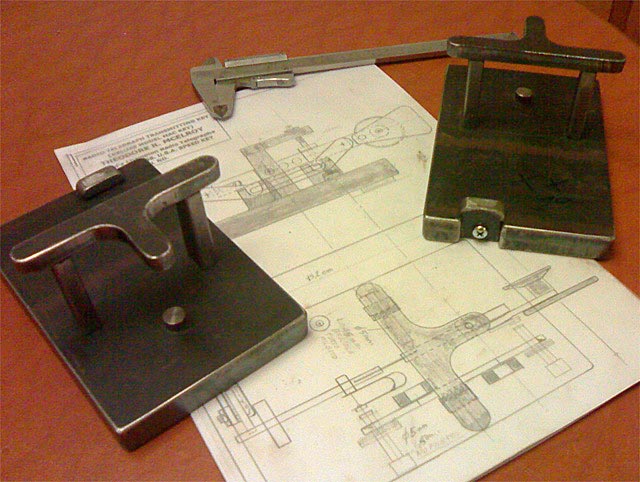
9893b The two casings resting on technical drawings:
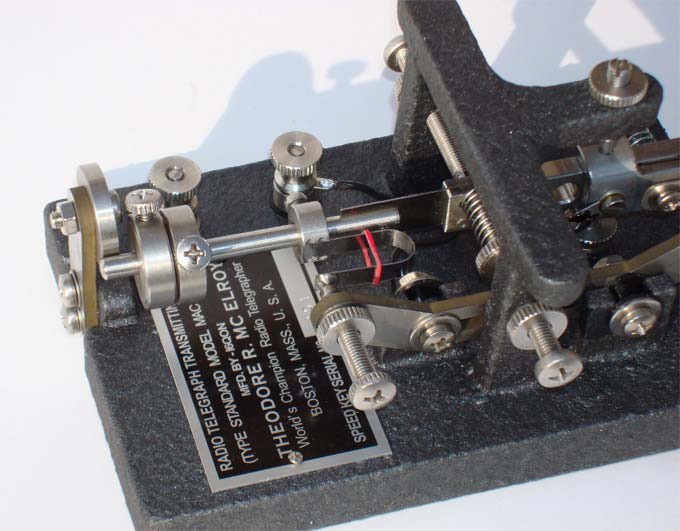
9893c A closer view of the mechanism and the label:
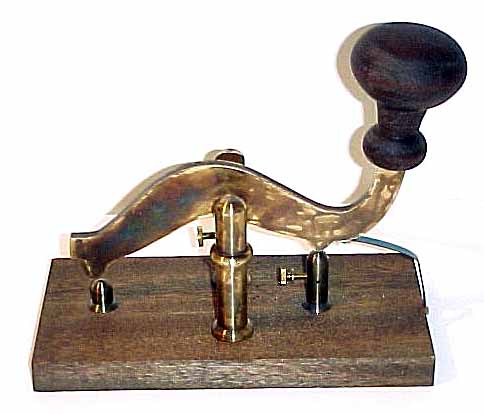
9895 ** VERY UNUSUAL HOMEMADE
EARLY CAMELBACK TELEGRAPH KEY:(26KB)
This magnificent very early camelback key was made by
Bob Fuschetto using a design shown in a very early picture.
Overall and close-up views of the original picture are shown below.
It is impossible to determine whether the artist created this
telegraph key from an existing design or whether it was
a stylized impression of what a telegraph key might be.
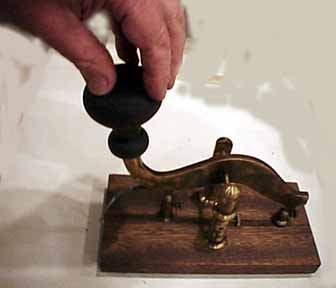
9895a A view of the key showing it's size:(11KB)
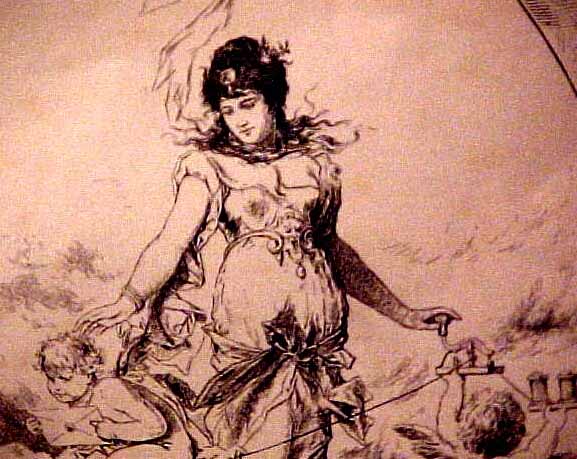
9895b An overall view of the original picture:(51KB)
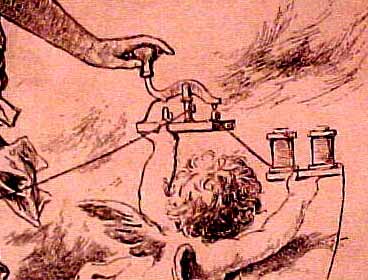
9895c A detailed closeup view of the original
picture:(31KB)

9898 ** NS3E's HOMEMADE KEY KEY:(18KB)
This attractive and humorous key was made by Ed Biter, NS3E who owns it.
Internet ENIGMA Museum:
https://EnigmaMuseum.com
COPYRIGHT NOTICE: (Copyright (c) 2023: Prof. Tom Perera Ph. D.)
Although all the pictures and text are copyrighted, you may use any of them
for your own personal applications including public lectures and
demonstrations, publications and websites as long as you mention the
w1tp.com Museum. If you plan to offer them for sale to the public
in any form, please email me for permission which I will generally grant as
long as you mention my museum: http://w1tp.com or https://EnigmaMuseum.com My email address is
given at the bottom of this page. Some of the material may require contacting
other copyright owners for commercial use and I will inform you by email.
Please also see the Disclaimer of Warranty.
(The instruments are in approximate chronological order: Oldest first.)
* = (Items no longer owned.) ** = (Items in other collections.)
9905 BOXED SET OF SAMUEL F.B. MORSE MEMORABILIA: 11 Pictures, articles,
patents, and letters. All are excellent copies.
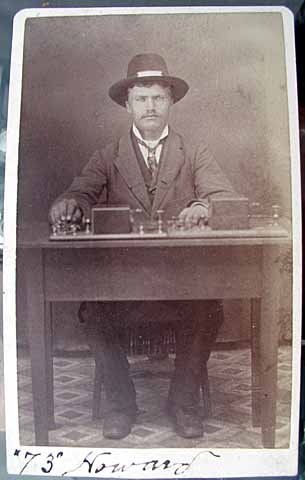
9910 EARLY VISITING CARD SHOWING 19th CENTURY
TELEGRAPHER AND TELEGRAPH EQUIPMENT:(19KB)This is an
interesting view of an early telegrapher with two box relays
in position on the table in front of him.
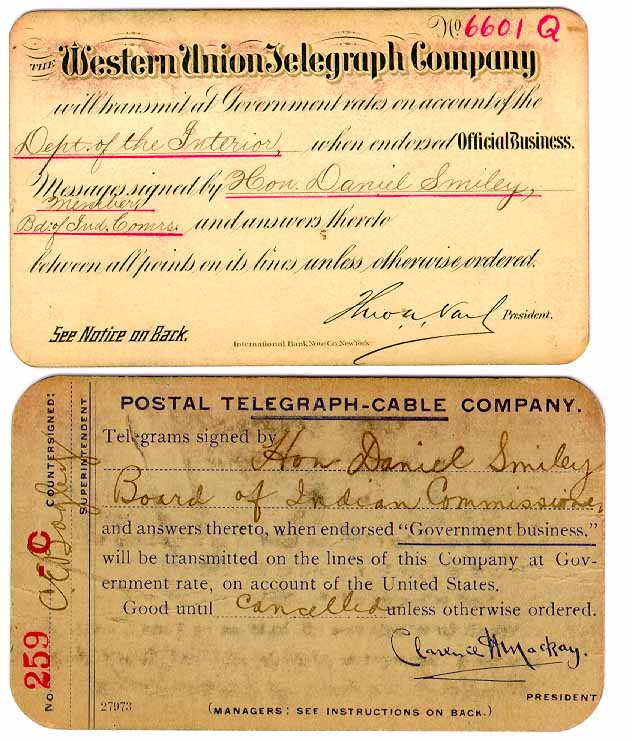
9912 EARLY WESTERN UNION & POSTAL TELEGRAPH CREDIT CARDS:(BIG File)(91KB)
These early cards were issued to The Honorable Daniel Smiley of the Board
of Indian Commissioners to allow him to use the services of Western Union
and Postal Telegraph-Cable Companies without paying for the telegrams and
to have the telegrams billed to the government at the special government
rates. The Western Union card is signed by Thomas Vail, President of
Western Union and the Postal Telegraph-Cable Company card is signed by
Clarence H. McKay, President of the company.
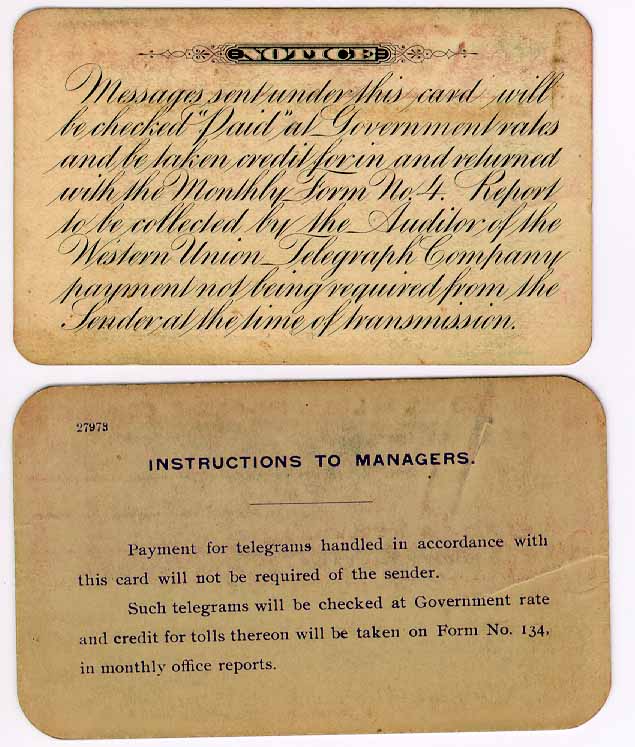
9912a THE BACK OF EACH CARD:(84KB)
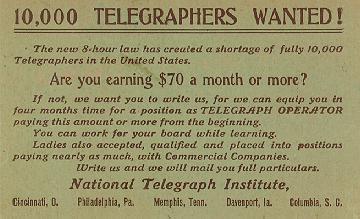
9915 ADVERTISING CARD FOR NATIONAL TELEGRAPH INSTITUTE:(24KB)
This card promises wonderful salaries of $70 per month or more.
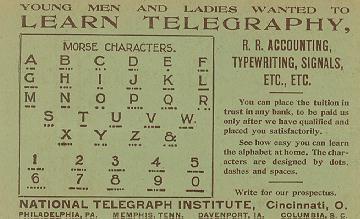
9915a The reverse side shows the morse characters:(22KB
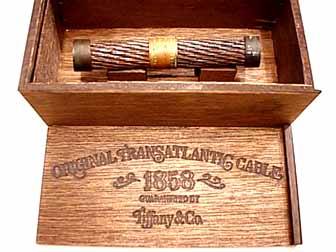
9925 * BOXED PIECE OF THE 1858 TRANSATLANTIC CABLE:(20KB)
This is a 4-1/2 inch section of
cable with brass label reading "ATLANTIC TELEGRAPH CABLE Guaranteed by
Tiffany & Co. Broadway, New York. 1858". In wooden box stamped Original
Transatlantic Cable. 1858. Guaranteed by Tiffany & Co.
(This cable is now in the Samuel F. B. Morse Museum, Poughkeepsie, NY.)
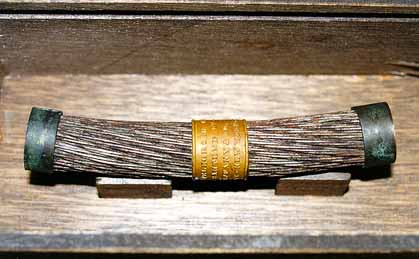
9925a Closer view of the cable section:(23KB)
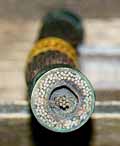
9925b Close-up view of end of cable showing
layers:(8KB)
Tiffany sold the cable sections in the box accompanied by a certificate
of authenticity in the form of a letter
dated: New York. Aug. 21st, 1858. "This is to certify that I have sold
the balance of the Atlantic Telegraph Cable now on board of the USS
"Niagra" to Tiffany & Co. Jewelers of 550 Broadway of this city and that
the piece which accompanies this is a genuine section thereof." Cyrus W.
Fields." "Entered According to Act of Congress AD 1858 by Tiffany &
Co. in the Clk's office of the dist Ct of the S dist of N.Y."
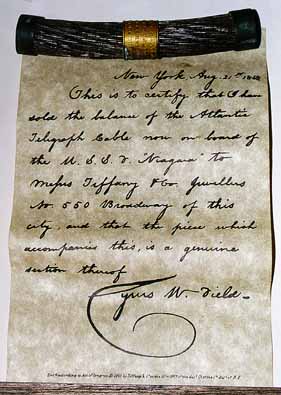
9925c The letter which accompanied the cable:(29KB)
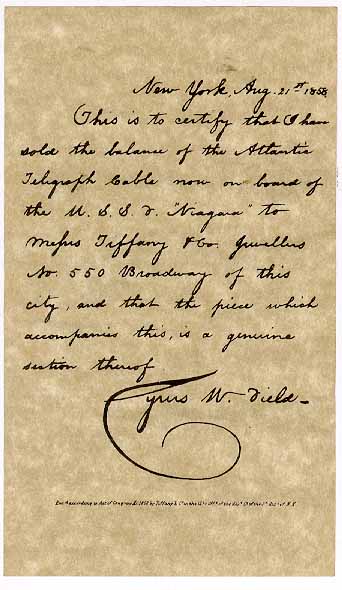
9925d A 75dpi scan of the letter / certificate:(41KB)
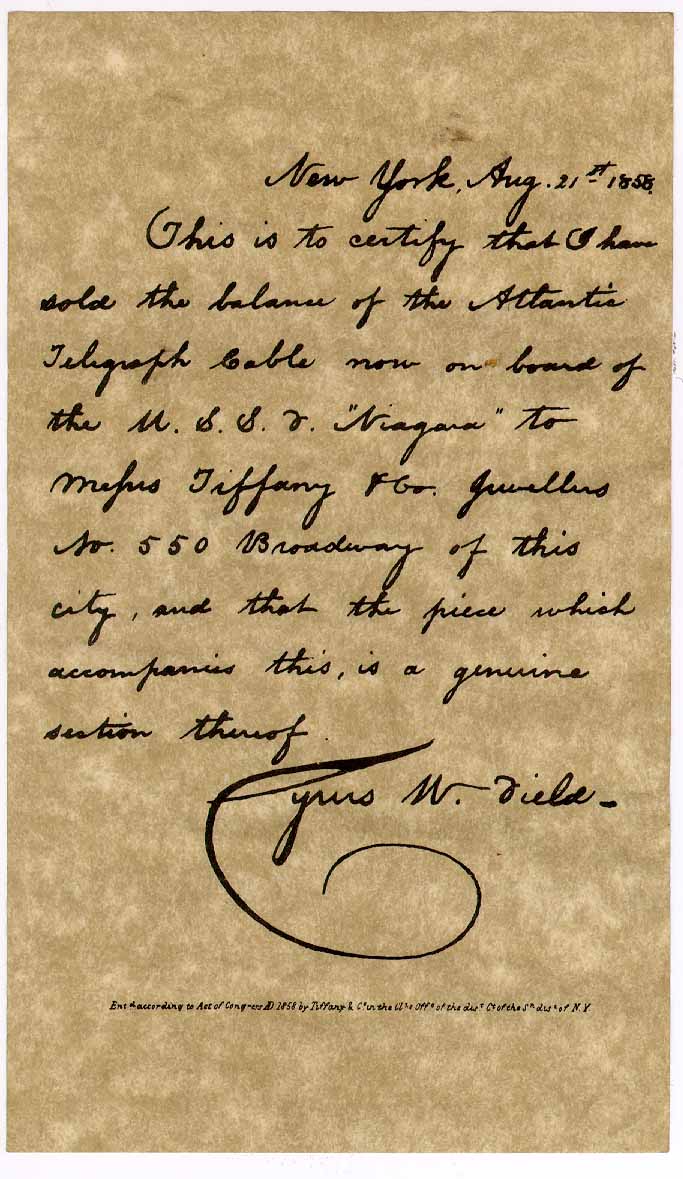
9925e A BIG, slow loading 300dpi scan of the letter:(116KB)
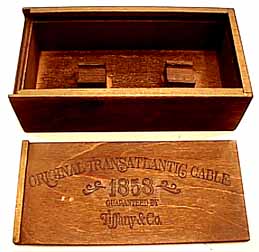
9925f The box and cover shown alone:(23KB)
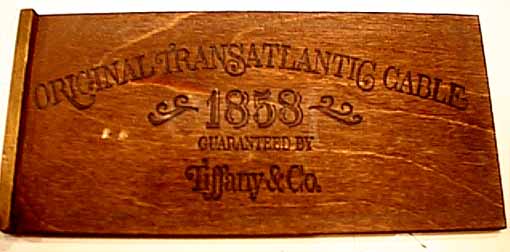
9925g A closer view of the cover of the box:(23KB)
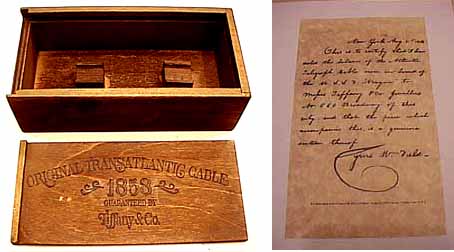
9925h The box alongside a copy of the letter:(23B)
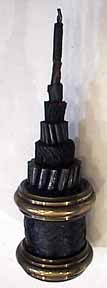
9935 EARLY FRENCH SUBMARINE TELEGRAPH CABLE:(7KB)
It was customary to preserve several lengths of each submarine
telegraph cable in a way that would allow the cable to be displayed.
This usually involved wrapping the cable with brass bands to keep it from
unraveling and stripping it so that the individual layers could
be seen. This cable was laid from France to England in the 1870's
and is an interesting example of early telegraph cable design.
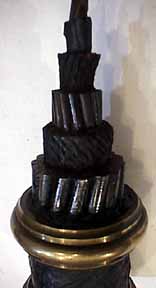
9935a A closeup view of the layers of the
cable:(8KB)
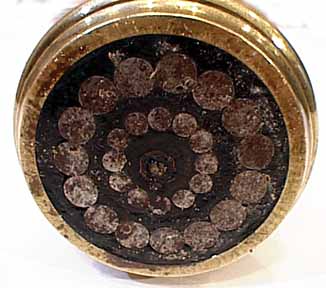
9935b A closeup view of the base of the
cable:(24KB)

9940 EARLY COMMEMORATIVE SIEMENS-HALSKE SUBMARINE
TELEGRAPH CABLE:(13KB)
When a submarine telegraph cable was laid to connect two countries, it was
generally a momentous occasion. Several pieces of this cable were generally
saved and made into museum and display pieces to commemorate the laying of the
cable. This process usually involved applying a metal band to one end of the
cable, peeling back the other end to display the internal layers and
construction, and signing the metal band with the maker's name.
This is a commemorative piece of a submarine telegraph cable which was laid
over 120 years ago to connect France and England. It was manufactured by
Siemens and Halske whose name appears on the metal band. They were makers of
many kinds of telegraph apparatus. It has a heavy protective outer wrapping
of 12 thick steel cables to protect it from damage from rocks on the bottom.
This outer wrapping is covered with a light protective winding of tar-
impregnated hemp and another layer of hemp protects the three conductors in
the center of the cable and their insulation which consists of Gutta Percha, a
sap found in certain trees. This is a very early cable which does not have
the protective layer of copper sheeting used to protect the gutta percha
insulation from the torado worms on the ocean floor. These worms tunnel into
the gutta percha and rapidly short out the insulation and virtually all cables
laid after the 1870's had this additional protection.
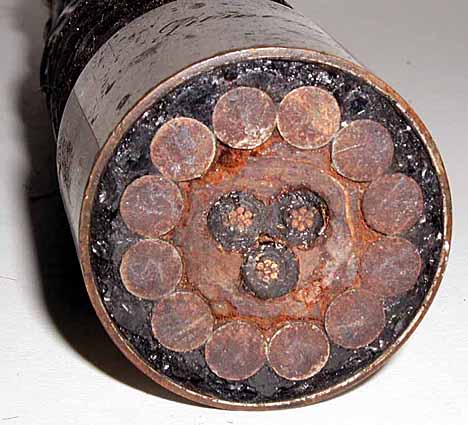
9940a A close-up view of the bottom of the cable
showing the construction and layers:(42KB)
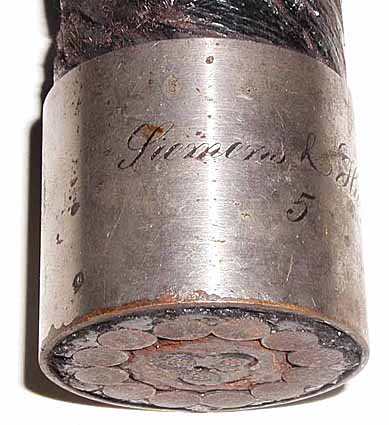
9940b A close-up view of the manufacturer's name
engraved into the metal band at the end of the cable:(33KB)
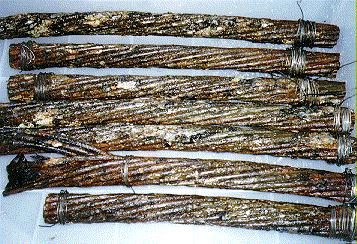
9950 RECOVERED PIECES OF AN EARLY SUBMARINE
TELEGRAPH CABLE:(46KB)
This early cable was laid between Florida and Cuba and recovered by
Tom Perera in 1997 on a diving expedition. (See story and other pictures
and cables referenced in main museum pages as follows:)
1998 DIVING EXPEDITION AND
CABLES:(4KB)
1997 DIVING EXPEDITION AND CABLES:(2KB)

9970 ** MURRAY WILLER, VE3FRX DEMONSTRATES THE USE
OF 'TELEGRAPH FLAG SIGNALS' AT THE 2001 AWA ANNUAL CONFERENCE:(33KB)
Murray Willer has been collecting and studying light signalling devices
for many years and here he demonstrates the proper use of signal flags.

9970a ** MURRAY WILLER, VE3FRX DEMONSTRATES ANOTHER FLAG
SIGNAL:(40KB)

9975 ** MURRAY WILLER, VE3FRX DEMONSTRATES A VERY
EARLY OIL-BURNING SIGNAL LAMP AT THE 2001 AWA ANNUAL CONFERENCE:(34KB)
Murray Willer specializes in light signalling devices and here he
shows a very early signal light. As you can see in the next picture,
moving the lever causes the cylinders around the wicks to move up and
down and exposes more or less of the wick to oxygen, thus controlling
the intensity of the light.

9975a ** A Close-up view of the signal light:(35KB)
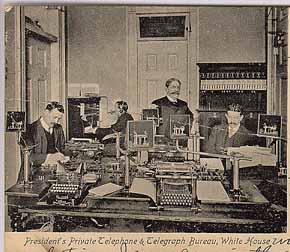
9980 THE PRESIDENT'S PRIVATE TELEPHONE & TELEGRAPH
BUREAU AT THE WHITE HOUSE - 1906 POSTCARD:(27KB)
This postcard postmarked Dec 1, 1906 was sent from a New York
address. It has a photograph of the 'President's Private
Telephone & Telegraph Bureau, White House, Washington, D. C.
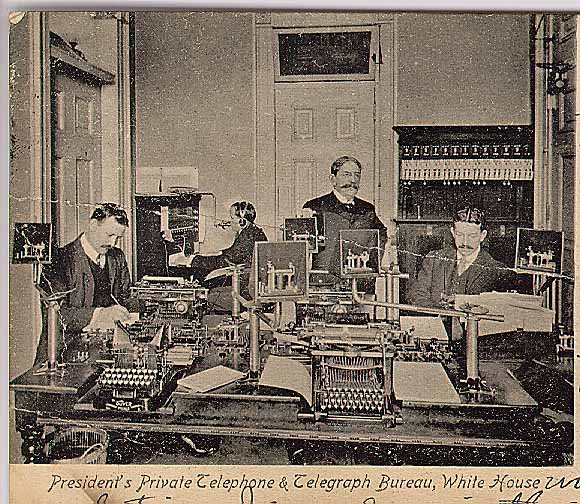
9980a A higher-resolution view of the photo:(113KB)
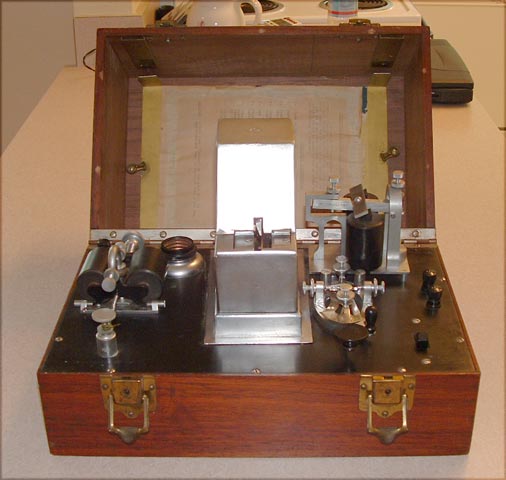
9985 * EXTREMELY UNUSUAL WESTERN UNION CEREMONIAL TELEGRAPH
SET:This unsusual set was built by Western Union and used at major
ceremonies such as the opening of a bridge or tunnel or roadway or building
where a ribbon was to be cut. When the set received the appropriate signal,
it activated the large metal 'Ribbon Cutter' in the center of the set and
simultaneously flashed a very large Press-sized flashbulb. The remote signal
was presumably sent by an important person such as the president of the United
States who may have been unable to attend the ceremony in person. The device
was excellent advertising for Western Union because it used the Western Union
Telegraph Lines and therefore a large Western Union sign was prominently
displayed along with the unit.
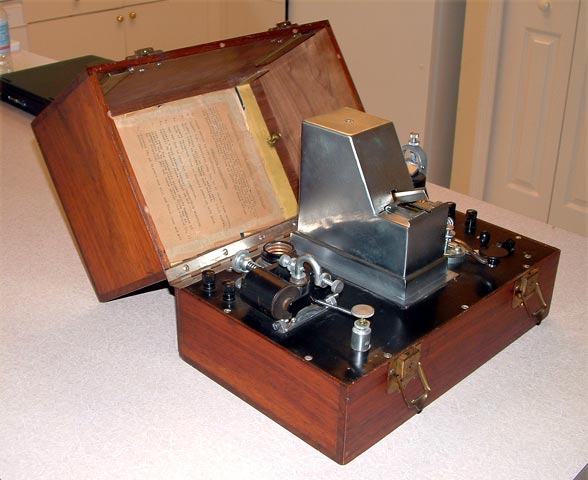
9985a Another View of the WESTERN UNION CEREMONIAL
SET:
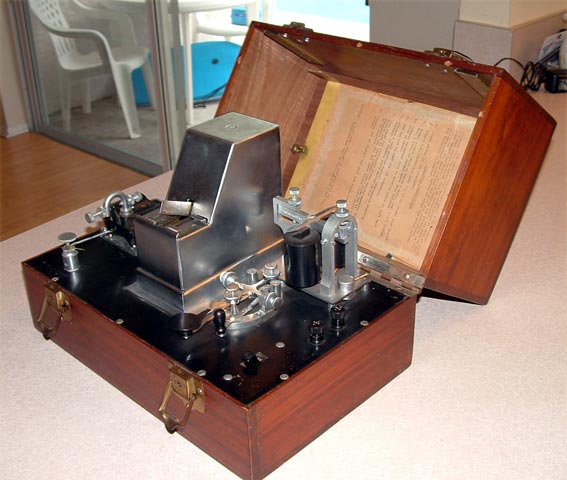
9985b Another View of the WESTERN UNION CEREMONIAL
SET:
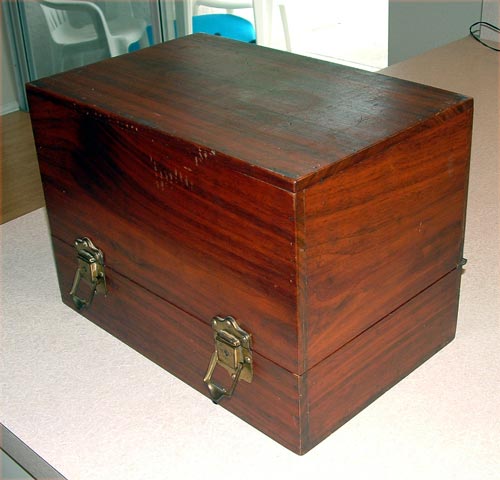
9985c The outside of the box of the WESTERN UNION
CEREMONIAL SET:
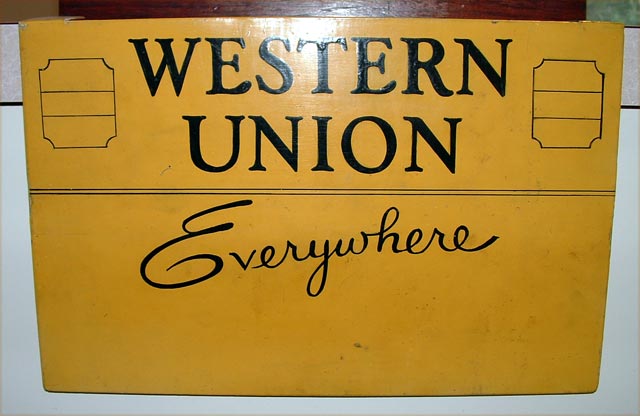
9985d The Sign that accompanied the WESTERN UNION
CEREMONIAL SET:
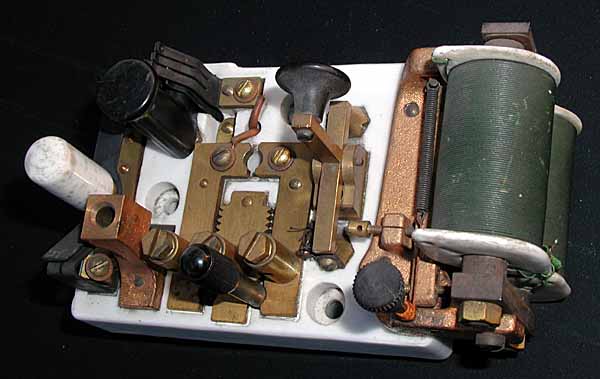
9990 FIRE ALARM KEY AND RELAY AND LIGHTNING
ARRESTOR:(32KB)Fire Alarm keys and apparatus are often mistaken
for telegraph instruments. This is an example of a fire alarm key,
relay, and lightning arrestor. Many Fire Alarm devices were manufactured
by Gamewell and this helps to identify them and differentiate them
from telegraph instruments.
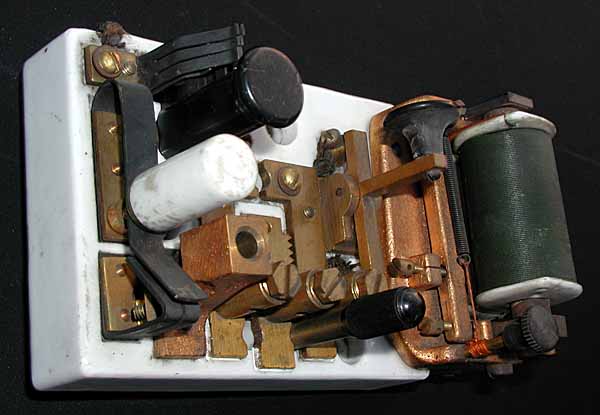
9990a Another view of the Fire Alarm
Instrument:(31KB)
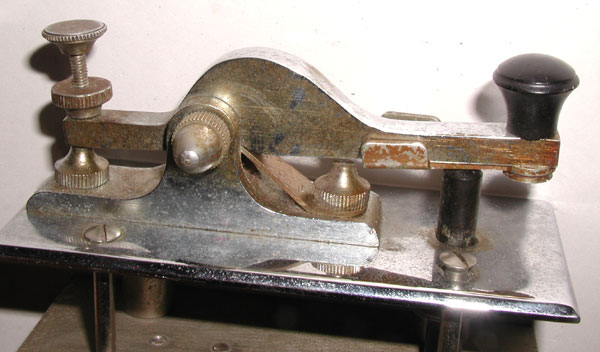
9991 FIRE ALARM KEY OR 'TAPPER' WITH CAMELBACK LEVER:
(47KB)
Fire Alarm keys and apparatus are often mistaken for telegraph instruments.
Since they were made as early as the very early telegraph keys, they often
look and are very old. This is an example of a fire alarm key that has the
camelback or 'humpback' design of some of the earliest telegraph keys but
it was not used to send Morse Code signals. These keys are also
called 'Tappers' because they were used to 'tap' out the code which identified
the location of a fire. Fire alarm codes were numeric and 3-taps,
followed by 5-taps, followed by 2-taps: xxx xxxxx xx signalled that the
fire was at location 352. Keys such as this often have a device which makes
it impossible to activate the key accidentally and you can see this mechanism
under the lever. Pressing the mechanism to one side locks the key and
pressing it to the other side unlocks the key.
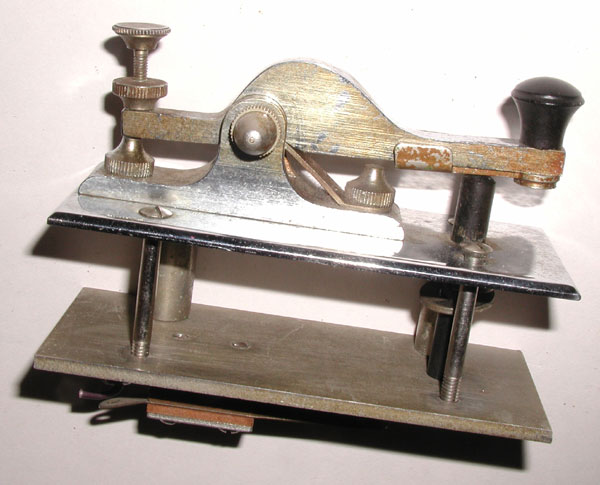
9991a Another view of the Fire Alarm Key or 'Tapper'
showing the complete mechanism.:(55KB)
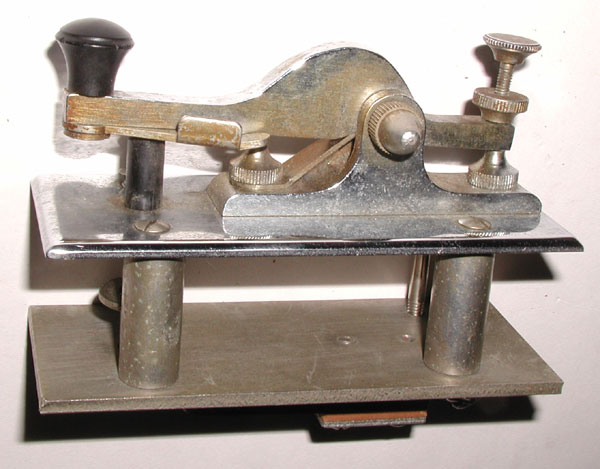
9991b A right-side view of the Fire Alarm Key or 'Tapper'
showing the complete mechanism.:(54KB)
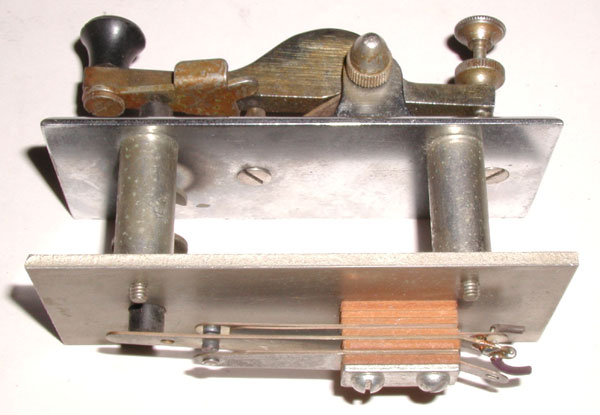
9991c A view of the Fire Alarm Key showing the
set of contacts under the base.:(46KB)
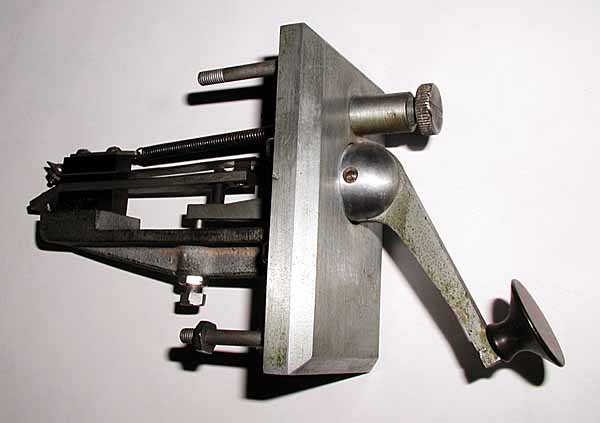
9993 FIRE ALARM KEY WITH UNUSUAL ANGLED LEVER:
This Chrome Plated camelback key was used to send fire alarm signals on local
and city-wide fire alarm circuits. This one was designed to be mounted on a
vertical wall thus explaining the angular lever. Often mistaken for land-line
telegraph keys, these fire alarm keys (sometimes called 'tappers') were widely
used in fire stations as early as the 1860's (This key is much more recent).
The coded location of the fire was sent by the key and received in the form of
bell signals at the remote stations.
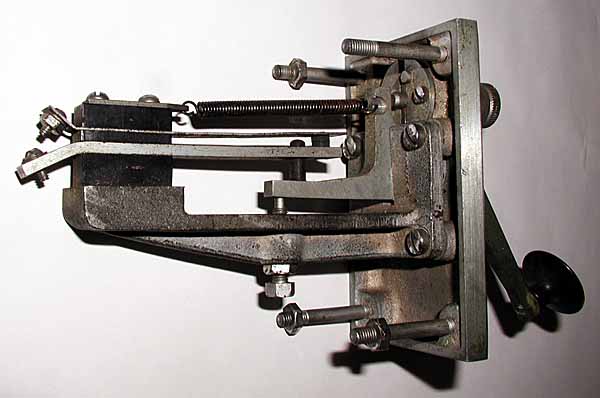
9993a The contacts on the angled fire alarm key:
Internet ENIGMA Museum:
https://EnigmaMuseum.com
COPYRIGHT NOTICE: (Copyright (c) 2023: Prof. Tom Perera Ph. D.)
Although all the pictures and text are copyrighted, you may use any of them
for your own personal applications including public lectures and
demonstrations, publications and websites as long as you mention the
w1tp.com Museum. If you plan to offer them for sale to the public
in any form, please email me for permission which I will generally grant as
long as you mention my museum: http://w1tp.com or https://EnigmaMuseum.com My email address is
given at the bottom of this page. Some of the material may require contacting
other copyright owners for commercial use and I will inform you by email.
Please also see the Disclaimer of Warranty.